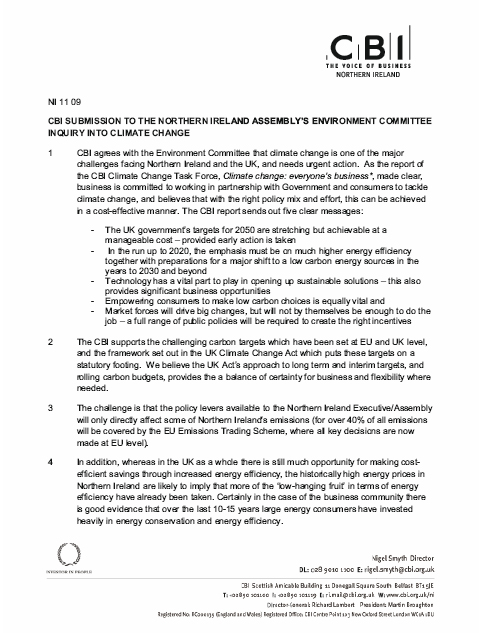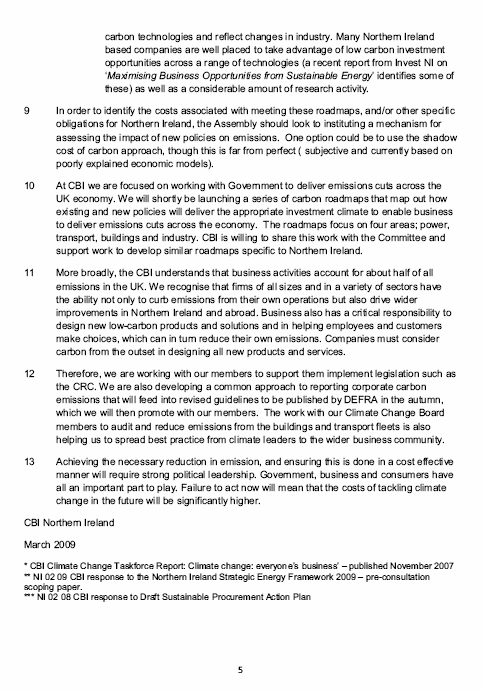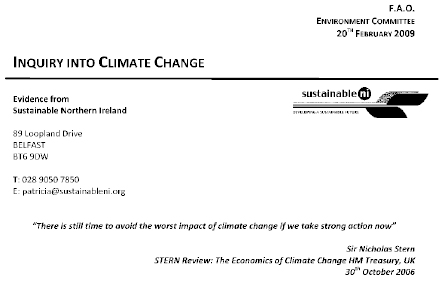Session 2009/2010
Second Report
Committee For The Environment
Inquiry into Climate Change
Volume Two
TOGETHER WITH THE MINUTES OF PROCEEDINGS, MINUTES OF EVIDENCE
AND WRITTEN SUBMISSIONS RELATING TO THE REPORT
Ordered by the Committee for the Environment to be printed 23 November 2009
Report: NIA 24/09/10R (Committee for the Environment)
This document is available in a range of alternative formats.
For more information please contact the
Northern Ireland Assembly, Printed Paper Office,
Parliament Buildings, Stormont, Belfast, BT4 3XX
Tel: 028 9052 1078
Membership and Powers
The Committee for the Environment is a Statutory Departmental Committee established in accordance with paragraphs 8 and 9 of the Belfast Agreement, section 29 of the Northern Ireland Act 1998 and under Standing Order 46.
The Committee has power to:
- Consider and advise on Departmental budgets and annual plans in the context of the overall budget allocation;
- Consider relevant secondary legislation and take the Committee stage of primary legislation;
- Call for persons and papers;
- Initiate inquires and make reports; and
- Consider and advise on any matters brought to the Committee by the Minister of the Environment
The Committee has 11 members including a Chairperson and Deputy Chairperson and a quorum of 5.
The membership of the Committee since 9 May 2007 has been as follows:
Mrs Dolores Kelly (Chairperson) 6
Mr Cathal Boylan (Deputy Chairperson)
Mr David Ford Mr Adrian McQuillan 7
Mr Ian McCrea Mr Alastair Ross 1
Mr Peter Weir Mr Daithi McKay
Mr John Dallat 5 Mr Danny Kinahan 3,4
Mr Roy Beggs 2
1 From January 21 2008, Mr Alastair Ross replaced Mr Alex Maskey on the
Committee for the Environment.
2 With effect from 15 September 2008 Mr Roy Beggs replaced Mr Sam Gardiner.
3 With effect from 29 September 2008 Mr David McClarty replaced Mr Billy Armstrong
4 With effect from 22 June 2009 Mr Danny Kinahan replaced Mr David McClarty
5 With effect from 29 June 2009 Mr John Dallat replaced Mr Tommy Gallagher
6 With effect from 3 July 2009 Mrs Dolores Kelly replaced Mr Patsy McGlone
7 With effect from 17 September 2009 Mr Adrian McQuillan replaced Mr Trevor Clarke
Table of Contents
Executive summary
Summary of Recommendations
2. Approach and focus of report
3. Current policy position on climate change in Northern Ireland
• Policy development
• Legislation
• Co-ordination of legislation
• Climate / carbon impact assessments
• Northern Ireland Targets
• Sector specific targets
• Role of the Committee on Climate Change
• Role of the MET Office
• Reporting mechanisms
6. Structures and Accountability
• Government structures
• Role of Government
• Role of DOE Climate Change Unit
• Delivery mechanisms including delivery of carbon commitments
• Public procurement
• Role of the Planning System
• Role and responsibilities of Local Government
• Investment and innovation
Cost of delivering climate change obligations
8. Sectoral targets and Action
• Energy
• Transport
• Waste
• Land use
Appendix 1
Appendix 2
Appendix 3
Appendix 4
Other Papers Submitted to the Committee
Appendix 5
Appendix 6
Appendix 3
Written Submissions
Airtricity

20th February 2009
The Committee Clerk
Environment Committee Office
Room 245
Parliament Buildings
Stormont
BT4 3XX
Dear Mr McGarel
Thank you for the opportunity to contribute to the Northern Ireland Assembly Environment Committee Enquiry into Climate Change. We have attached 2 documents. The first sets out Airtricity’s views on the threats and the opportunities arising from the challenge of climate change. The second attachment sets out what we believe to be the targets Northern Ireland should meet in terms of renewable energy and the barriers that need to be overcome to achieve them.
In either instance, I would be more than happy to give evidence to the committee in person and explain further the content of our presentations.
Yours sincerely

Mark Ennis
Director of Communications & Strategy

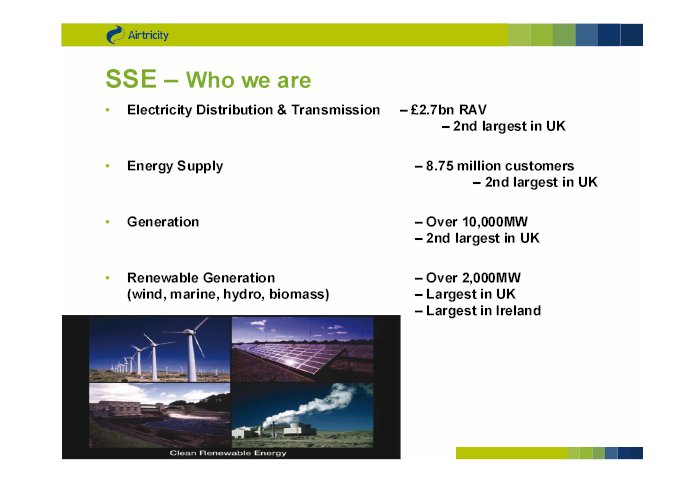
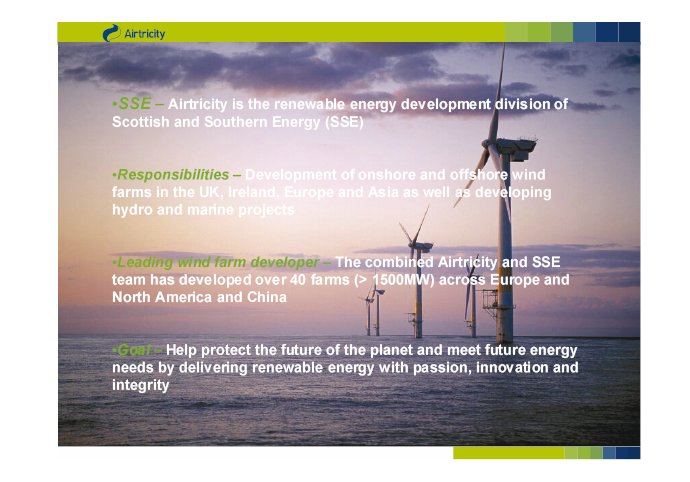




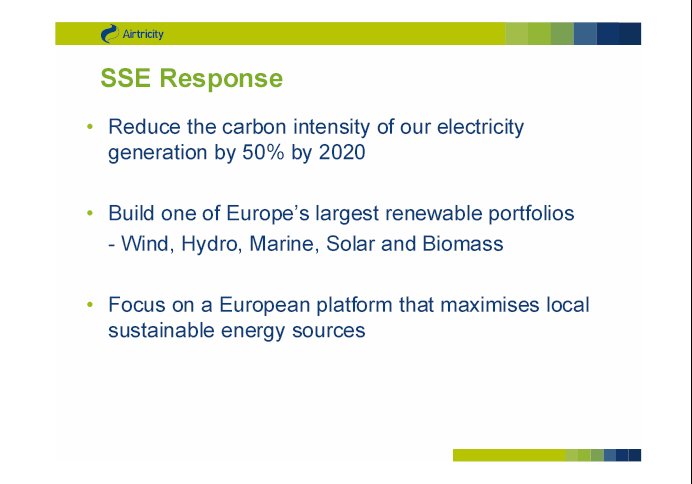
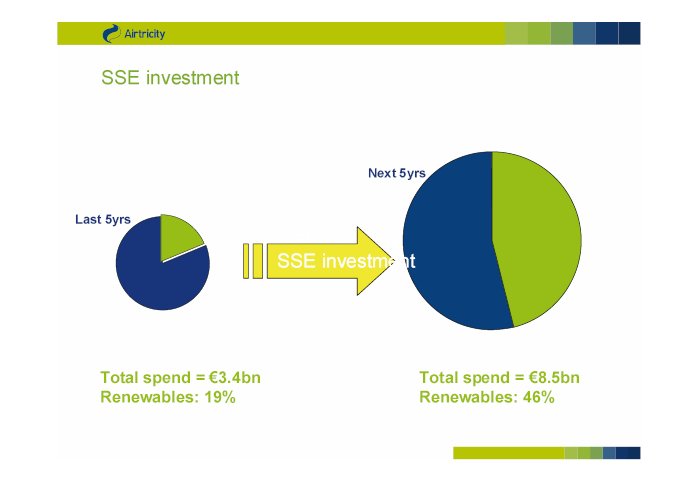
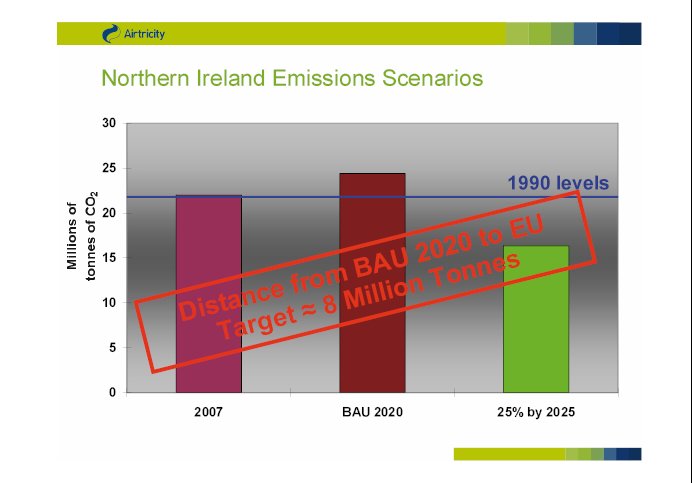
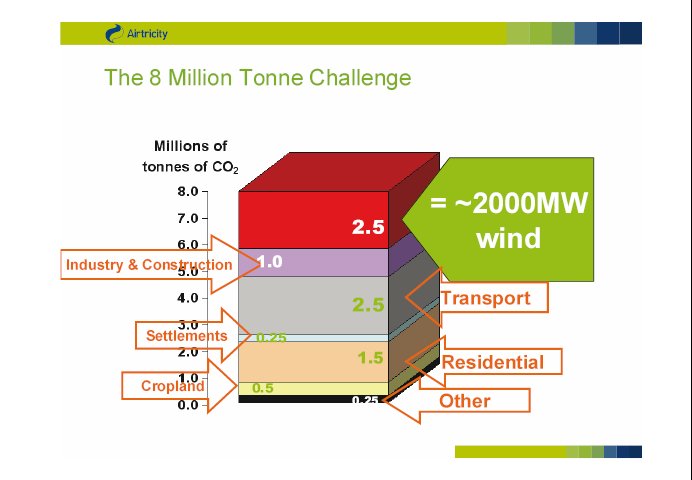
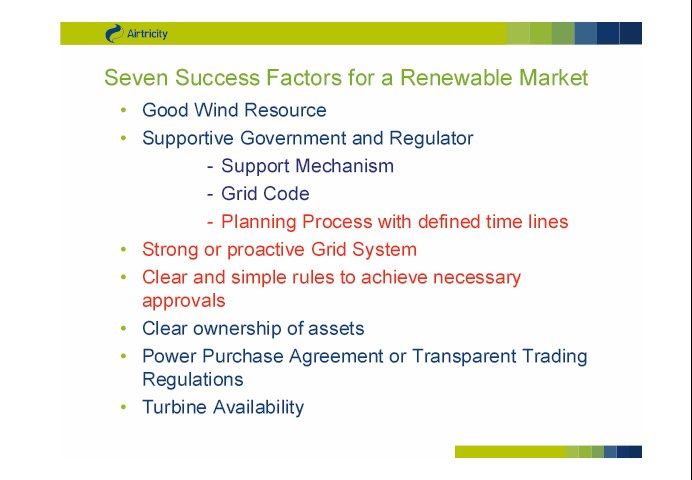
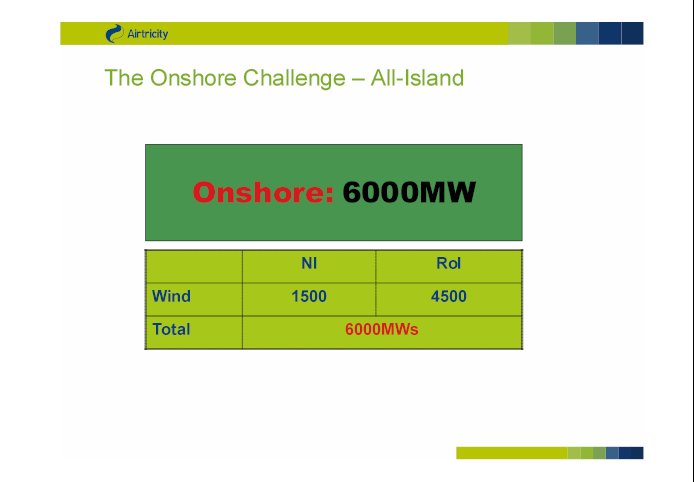
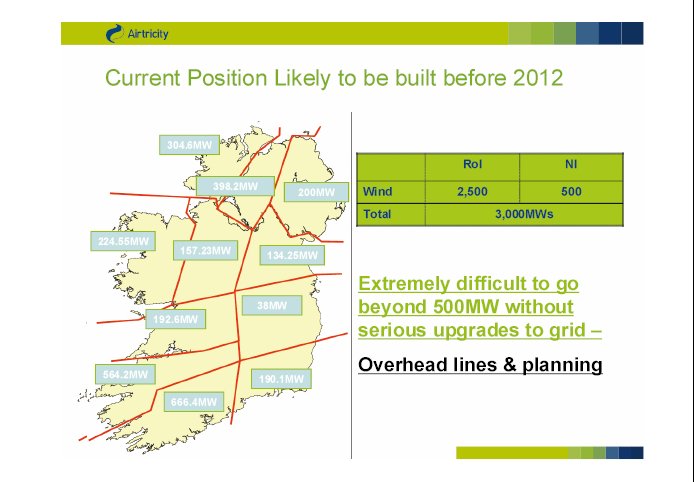

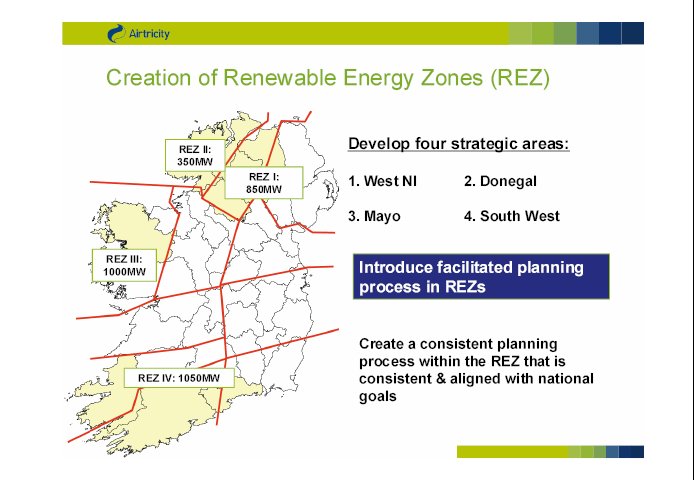


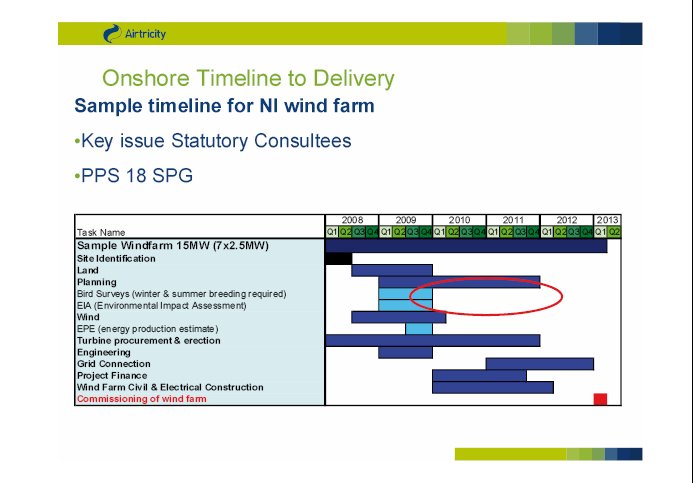
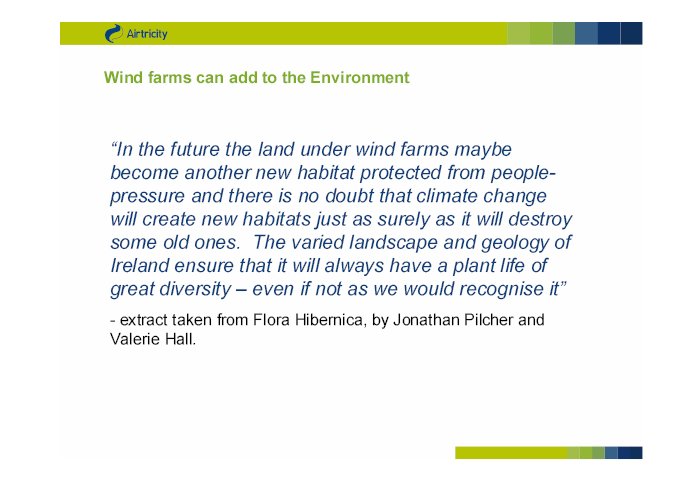

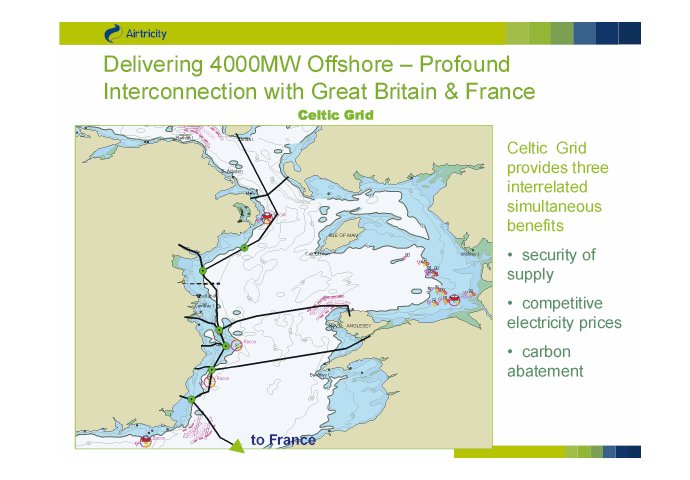


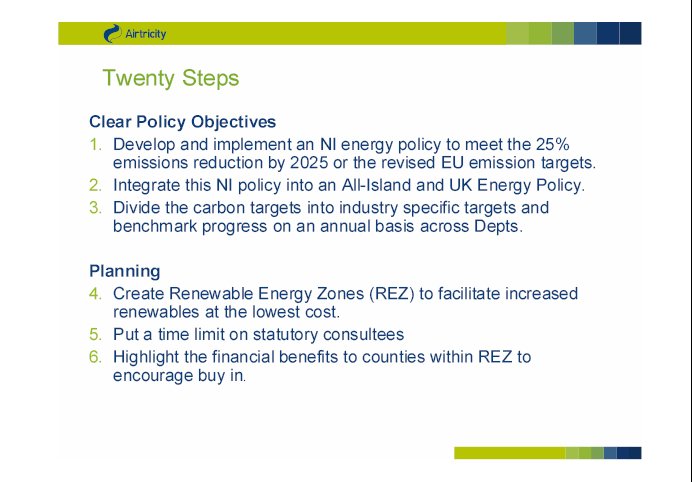
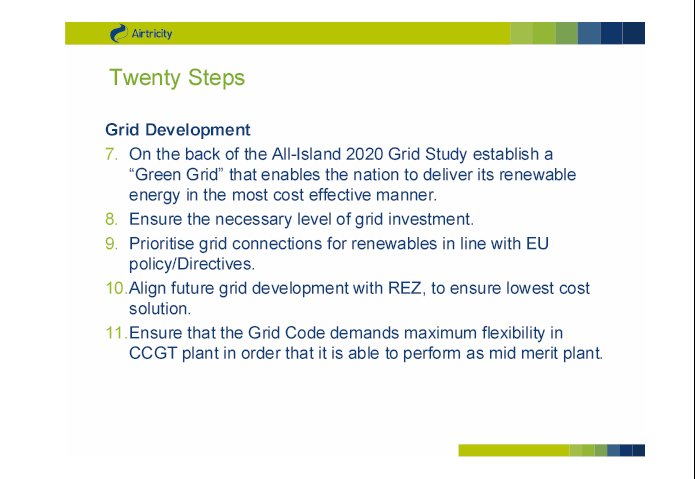
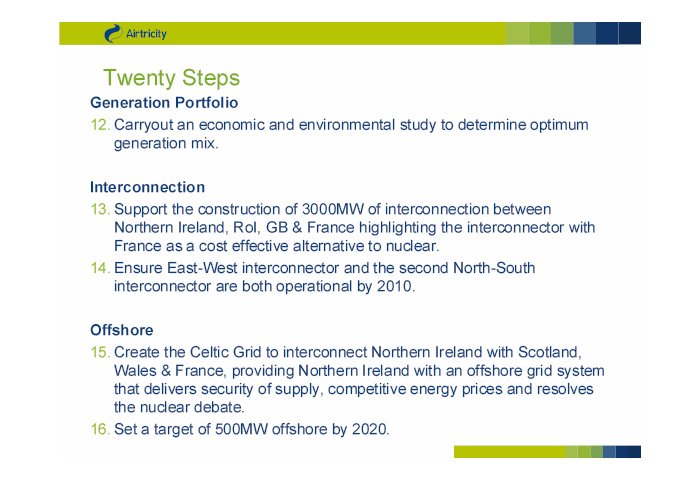

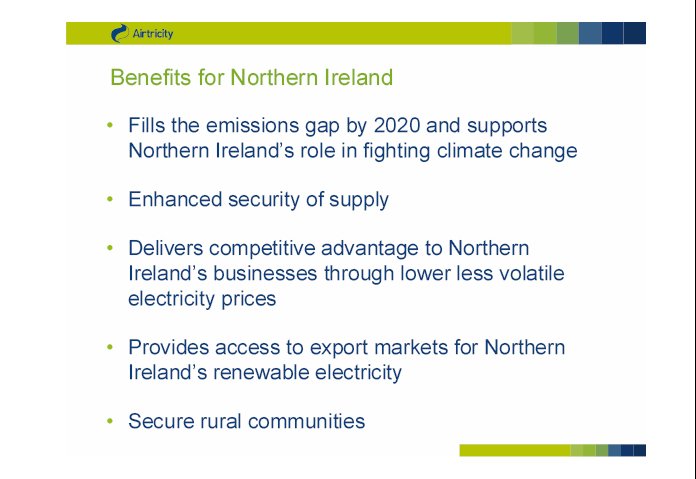
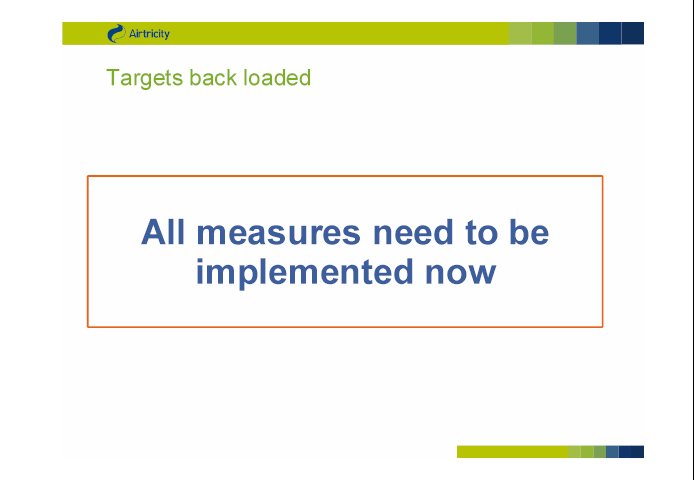
Airtricity is the renewable energy development division of Scottish and Southern Energy (SSE). We are the UK and Irelands second largest utility with over 9 million customers and 10,000 MWs of generation capacity Importantly we are the UK and Irelands leading renewable generator with over 2000MWs of renewable generation (both wind and hydro) in operation and a further 1500MWs in the course of construction. We take climate change and the need to develop a sustainable future seriously. As proof of this we have made a public commitment to reduce the carbon emissions from our electricity generation fleet by 50% by 2020.
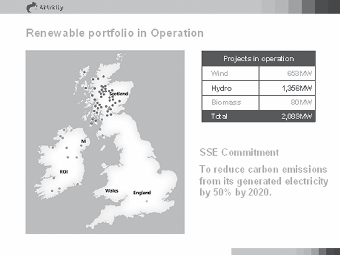
Addressing climate change while at the same time securing our energy supplies represents a huge challenge, and also a huge opportunity for businesses and countries that recognise the issue and are prepared to be part of the solution. Security of energy supply issues are something that all businesses will have to address. Even allowing for the current recession the world energy needs will increase by 45% by 2030 (IEA) While world demand grows Europe’s exposure to fossil fuel shortages will increase Within 20 years Europe will be importing 94% of its oil, 84% of its gas and 59% of its coal. The International Energy Agency has just carried out the most comprehensive study of 700 of the world’s oil fields (the vast majority) and found that they are depleting at a rate of 8% per annum. This means we will have to find the equivalent of 4 Saudi Arabia’s if we are to meet world demand by the middle of the century. The increasing exposure to diminishing fossil fuel supplies will lead to increasingly volatile global prices.
Northern Ireland being on the peripheral of Europe with no natural fossil fuel resources and at the end of a 4000 mile pipeline from Russia the nearest source of gas or oil is particularly exposed. We have only to witness the recent events between Russia and the Ukraine to understand how serious that exposure is. If Russia turned the gas tap off completely it is likely that Northern Ireland would suffer rolling blackouts within 72 hours. No politicians should allow their country to be that exposed.
Climate change represents the biggest threat to humanity today. If the world carries on with business as usual with energy demand fed by fossil fuels it will result in atmospheric CO2 of 1000 ppm which will lead to a 6oC temperature increase by the end of the century.
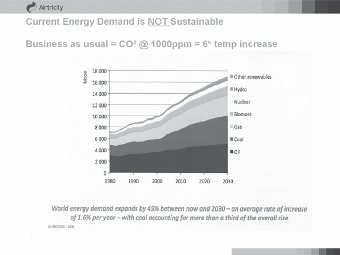
This would have catastrophic implications for our grandchildren as they would be confronted with a world in which there would be mass migration in search of food. There would be upheaval and anarchy as those faced with starvation, drought, and disease fight with those who still had resources. This is not Africa we are talking about; this will be the western world, as we know it particularly central USA and the Mediterranean regions.
The results of the UN’s Intergovernmental Panel on Climate Change (IPCC) suggest a 450 ppm scenario is necessary to prevent any major tipping points being reached. This would have a corresponding 2 oC temperature increase but would require political leadership, a global approach and rapid deployment of low-carbon technologies. 2 oC could not be achieved by OECD countries alone; it needs to include developing countries especially China and India. The IPCC have produced 2 scenarios, the optimum 2 oC or 450 ppm scenario or the most likely 3 oC or 550 ppm.
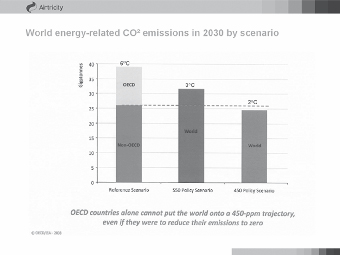
To put these climate change scenarios into perspective, the 550 ppm scenario will result in a 3 oC temperature increase which will lead to 4 billion people suffering water shortages, 500 million going hungry and 170 million impacted upon by coastal flooding, including many in Belfast and Dublin. All leaders across the globe be they in business, politics, science, whatever their field must unite to stop this. Northern Ireland must play its part.
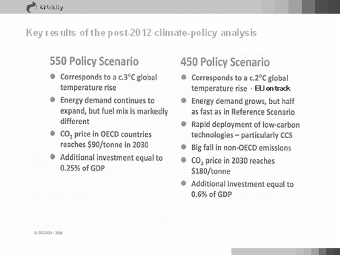
Both scenarios require significant investment in renewable energy and energy efficiency technologies

Those countries that respond to these challenges quickly will not only contribute to resolving the worlds climate change and security of energy supply problems but they will create positions of technological leadership that will create new businesses and wealth which will create employment and improved living standards.
At Airtricity, we see climate change as a business opportunity not a business hindrance! Opportunities will be created in many sectors including energy procurement, waste management, efficient building and insulation technologies, and innovations in transport and engine efficiencies.
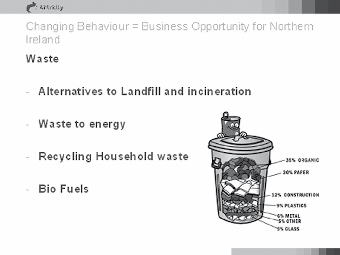
Northern Ireland needs to embrace a sustainable future by utilising the skill sets of our bright young people, having industry led research in our universities and exploiting our natural resources for a competitive advantage, i.e.: wind and tidal power. By taking a leadership role we can also benefit from the financial support available from Europe for such activities.
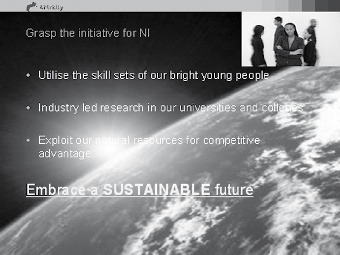
Baglady Productions
28 February 2009
66 Grange Road
Ballymena BT 42 2DU
www.bagladyproductions.org
[028] 25 639609
I, Shirley Lewis, am director of Baglady Productions, a not-for-profit company working to inspire individuals and community to take responsibility for our place on this planet. We have no formal membership, but our message gets out; our website indicates wide support across Northern Ireland, the UK and globally.
I am a member of the Climate Change Coalition [CCC] and have played my part in the discussions about our collective response. My own experience as an environmental campaigner makes enables me fully to endorse the Climate Change Coalition response.
My role is:
(i) to communicate the urgency of action
(ii) to point to the good developments that will accompany this action
(iii) to inspire people in Northern Ireland and around the world to look after this, our beautiful place..
My focus here is, as always, on doing rather than talking. I am always calling for action. We have no time to lose. Not currently employed by government at any level, I am free to say exactly what I think and feel. I continually strive to do so with respect for everyone and everything,
Since my return home to Northern Ireland from Australia in 2002, I’ve been funded 6 times by government*.
In total I’ve managed over £100,000 in cash and a lot more in kind, keeping waste of all kinds to a minimum. I have taken great pleasure in doing much more than was expected at most stages of the 5 years of funding. I knew there was no time to lose.
I’ve visited over 150 schools in Northern Ireland and met hundreds of teachers and thousands of schoolchildren who are bursting with enthusiasm to do something urgent about climate change and other environment issues . They often know, and are prepared to do, much more than their parents.
Their Positive Pester Power [PPP]** skills can get us adults off our proverbials ; through internet and other media they can reach out to other children, and their parents, right around the world. And they can help us make it fun.
I have 7 years experience in living ASAP [As Sustainably as Possible] which means no car, no garage, no oiltank, and much attention to domestic energy saving of all kinds, and means I can make a very strong contribution on all aspects of the spectrum from waste to sustainability. I am writing a play about this.
Response to the terms of reference
(a) To identify initial commitments for Northern Ireland that will ensure it plays a fair and proportionate role as part of the UK in meeting climate change targets.
Baglady comment:
At approx 1.7million people, we in Northern Ireland make up 1/4000th of the world’s population.
Sadly, we use much, much more than our fair share of resources, guzzling up 1000th of what’s available. North and South of the border, our global footprint is about 4 times what it should be [wwf]
[Climate Change Coalition: ‘Northern Ireland’s per capita emissions of 12.83 tonnes compares badly with the UK average of 10.48 tonnes, the global average of 4 tonnes and the global fair share of 1.65 tonnes’]
People somewhere else in the world don’t have enough because of what we’re using and wasting..
This is the true story of climate change - Earth responding negatively to our greed, excess and laziness. Human beings have developed problems of attitude and behaviour which threaten our very existence.
We know we are doing this. Yet we continue to do so, giving all sorts of reasons to justify our failure to change even the most basic of wasteful habits - eg plastic bags, water, energy in all forms, food, paper.... the list is massive and it needs decisive action from the Environment Committee and the NI Assembly.
We can change; we are already changing. It just needs to happen on a broader scale, faster, more efficiently and ideally with a great deal of our fabled Irish creativity and humour. The very smallness of our community, its friendliness and sense of humour all suggest to me that we can quite easily take the lead here. Our children need our support.
I agree with the Climate Change Coalition that:
‘The Assembly should ensure that its voice is heard at the national and international level. It should categorically state its support for an international climate change agreement to limit global warming to no more than 2° Celsius above pre-industrial temperatures (most scientists accept that ‘dangerous climate change’ is much more likely above this temperature increase).
‘The Assembly has accepted that the provisions of the UK Climate Act will be extended to Northern Ireland. [Next, we need] ‘a Northern Ireland Climate Change Act with a legally binding regional target to reduce our carbon dioxide emissions by 80% from 1990 levels by 2050. This is the minimum requirement that will be necessary to play our part in the global attempt to avoid dangerous climate change.’
‘The Executive should set an “intermediate" target for emissions in 2020, a series of legally binding 5 year “carbon budgets" and an annual carbon reduction target at an average of at least 3% per annum. ‘
(b) To consider the necessary actions and a route map for each significant sector in Northern Ireland (energy, transport, agriculture and land use, business, domestic, public sector etc)
Baglady comment:
Action is my forte. It is, oddly enough, the most difficult thing for humans to do - especially in the climate change context.
We now broadly agree: to do nothing is NOT an option. But what to do? and how? how long can we put it off?
We need immediate leadership from our politicians and people at all levels, top to bottom, in government departments.
In my experience, people in political positions and in related government departments often take up their post knowing very little about environment, climate change etc. The knowledge is new, rapidly changing, and highly confronting, eg if you get driven to work in a fuel-inefficient car, like Arlene Foster.
Often by the time these people are fully equipped for the task in hand, they’re moved to a different department. It would be most helpful to ask these people for their insight into how to deal with this information gap.
The people I’ve met with the best skills and least conflict of interest are the scientific community [eg QUB and UU], charities and environment NGOs. They should be trusted more and consulted in greater depth - as you’re doing now.
I personally have access to a wealth of comment on energy, transport etc - and direct experience of living it - it would take weeks or months to tabulate them. Instead, I am finding ways to express what I’ve learned - eg in installing PV cells and thus generating my own electricity to sell back to the grid [!!] - in a way that sucks people in....
(c) To identify the costs associated with meeting these obligations and compare them with the costs that will be incurred if they are not achieved.
Baglady comment: A 12 yr-old boy sees the solar panels on my roof. For weeks, he and his friends plague me with questions about why I have it, what it costs, how it works etc... I tell them all I can; and I add that installing solar panels could be a good, worthwhile and interesting job... this keeps them going for even longer.
Action Renewables: ‘almost 6,000 short term and 400 long term jobs could be sustained in Northern Ireland, exclusively by developing renewable energy within the region.’
Baglady: Our children are almost not needed in a world where machines do most things better, quicker and cheaper than they ever could. Our kids have nothing to do, nothing to look forward to. They become angry, or despairing.
This is costing us huge sums of money in violence, vandalism, medical bills for depression, obesity, prison sentences, the list goes on.
The Climate Change Coalition quotes Northern Ireland’s Chief Medical Officer Michael McBride:
“Current predictions on climate change suggest greater long-term impacts on health than any current public health priority. To preserve health in a changing climate, we need to modify and strengthen the systems we have to adapt to the likely future impacts of global warming. We must tackle this issue on all fronts, reducing our contribution to the problem and responding to the effects of climate change is a shared international responsibility." ‘
Baglady: Meanwhile, my travels around NI show me that it’s in a shocking state of rubbish and waste. We will never have the money to clean it up. But we do have the people. Taking responsibility for our daily life in terms of the basics: shelter, food, water, warmth.... will make a huge difference; and we can measure it.
Further relevant - and encouraging - extracts from the Climate Change Coalition response:
‘The central message [of the Stern Review] is that reducing emissions today will make us better off in the future: one model predicts benefits of up to $2.5 trillion each year if the world shifts to a low carbon path.
‘The renewable sector in Germany supports 170,000 people and existing German government support measures promoting renewable energy could create 130,000 new jobs by 2020 [German environment ministry]
‘Greater than 70,000 jobs could be created in the UK by investing in and developing offshore wind technology. [Carbon Trust]
‘The overall added value of the low carbon energy sector by 2050 could be as high as $3 trillion per year worldwide and... could employ more than 25 million people.’ [Gordon Brown]
‘The Coalition believes that there are strong moral imperatives for Northern Ireland to contribute its fair share of global emissions cuts in order to combat global climate change. Hundreds of millions of people across the globe could lose their lives and livelihoods, up to a third of land-based species may become extinct, immense political instability will occur as people migrate to avoid droughts and floods and compete for scarce resources, and great economic damage will be caused by increasingly extreme weather.
The SNIFFER report on the impacts of climate change on Northern Ireland identified a number of direct effects, mostly negative, on human health, the economy, natural habitats and water resources, for example, the extent of flood risk to existing settlements remains unquantified compared with the situation in Great Britain.
(f) To make recommendations on a public service agreement for the DOE Climate Change Unit’s commitments in the second Programme for Government that will ensure Northern Ireland will meet its climate change obligations.
‘The legal responsibility to deliver the targets set in a Northern Ireland Climate Change Act and through the carbon budgets should fall collectively on the Executive.
Specific responsibilities to deliver the targets set in the Climate Act and in the carbon budgets should be identified in public service agreements for each Northern Ireland department.
A public service agreement should be drafted for the Department of the Environment which would include a commitment to provide information and support to the other departments to help deliver the targets set in a Northern Ireland Climate Change Act and in the carbon budgets. ‘
Baglady comment: The public need to see all government staff, particularly those in the Department of Environment, showing full awareness of their own role and responsibility, in forestalling climate change. Getting rid of the take-away packaged lunches, the heat and light wastage in offices - all these things can be used to build awareness and staff morale.
Individual and group actions in any of these areas needs to be praised and publicised both interdepartmentally and community-wide, so people can learn by example.
Preaching and stats don’t work, how-tos, targets, responses, tables etc do. And always remember: make it fun.
There is huge frustration in the Education Department over Education for Sustainable Development [ESD] Progress there is slowed by steady withdrawal of funding from various bodies specialising in school visits eg Sustainable NI, Action Renewables. Curriculum material appears brilliantly envisaged and practical - but the subject is not examinable. The Sustainable champion in Education has too many other commitments to find sufficent time and energy for this huge job.
I have found that environment in general, and dealing with Climate Change in particular, are very popular subjects with schoolchildren of all ages. Much of the alienation experienced by the less academically promising children vanishes, in the rush to show and share skills acquired in this new and challenging field. Again, it’s fun.
The Climate Change Coalition:
‘The people of Northern Ireland are asking for leadership from the Assembly.
There is a lot of expertise on climate change available in Northern Ireland and many groups are looking to play their part in facilitating moves towards a low carbon economy. The Committee should engage widely and openly.’
Conclusion
September 2009 is a long way away if you consider that we need to reduce our carbon output by 3% per annum. And it’s cumulative; the longer we postpone, the harder it will be to make it up.
Baglady Productions congratulates the Environment Committee on its initiative ini launching this enquiry, and would welcome the opportunity to make a presentation to the Committee if invited.
footnotes:
* first a costs-only Millenium Award, then 2X Ballymena Borough Counci [Environment Weeks 2003,2004] , which led to 2X DoE funding for NEEDabag? campaign with 10 councils [2005] and with 23 councils, 100+ schools and thousands of supermarkets and convenience stores and solid press, radio and TV support. The last funded project, in partnership with jollytv, had us travelling ASAP[ [bus and train where possible] all over N Ireland to film baglady in 16 places. see www.bagladyproductions.org
** Baglady apparently discovered Positive Pester Power in 2006. It was immediately adopted by Down District Council’s Janet McIlvenna and featured on BBC Politics Show. Subsequently praised by Eamon Holmes on BBC Summer Special show 2007
CCC (NI) members:
- ARENA Network
- Baglady Productions
- British Council (Northern Ireland)
- Centre for Global Education
- Chartered Institute of Environmental Health
- Christian Aid
- Concern
- Conservation Volunteers Northern Ireland
- Friends of the Earth
- Green Action
- NICVA
- Northern Ireland Environment Link
- Oxfam Ireland
- RSPB
- Sustainable NI
- Sustrans
- Tearfund
- The National Trust
- TIDY NI
- Tools for Solidarity
- Trocaire
- Ulster Wildlife Trust
- WWF Northern Ireland
Barbre de Brun MEP

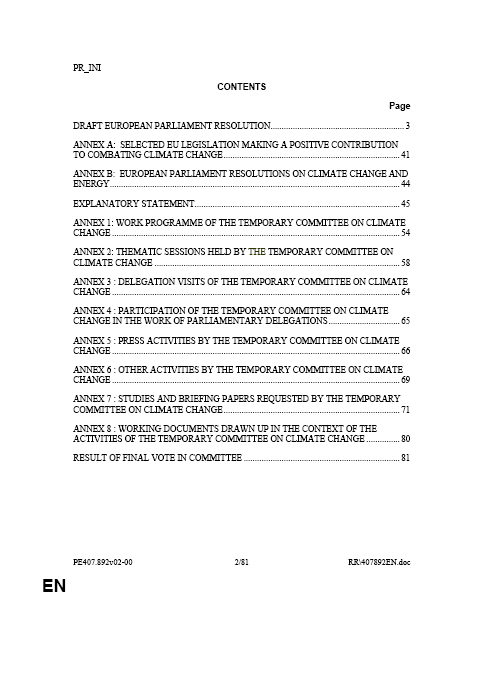
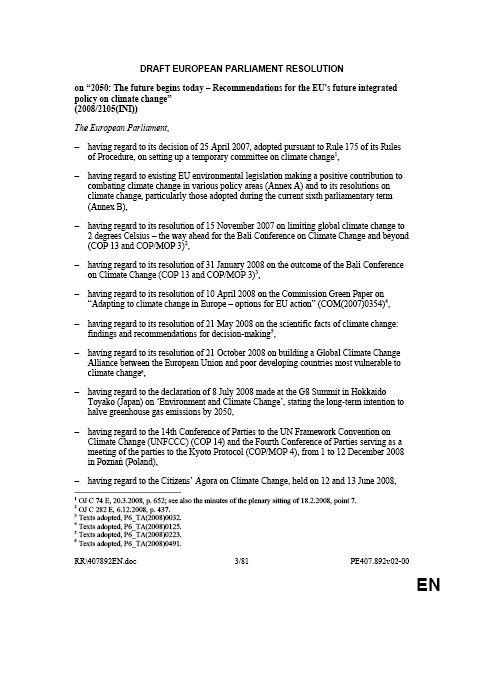




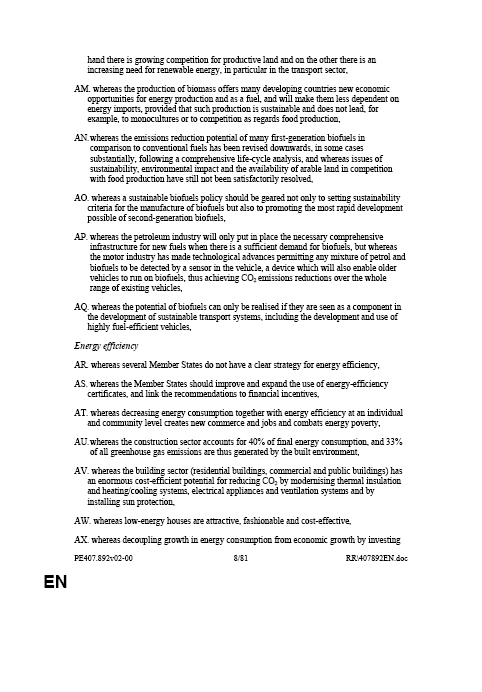
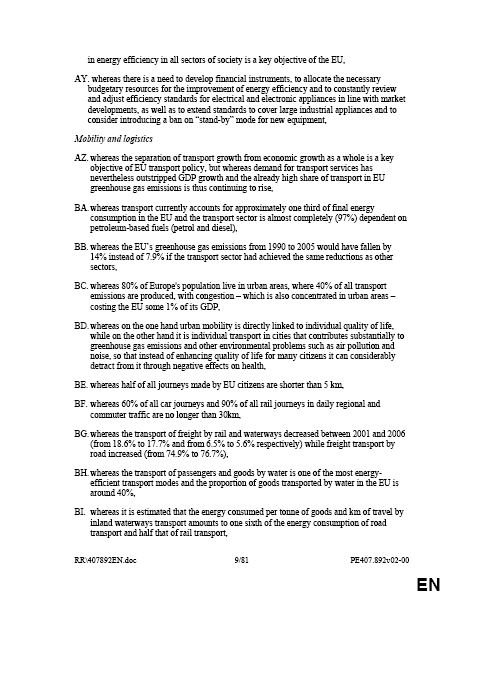

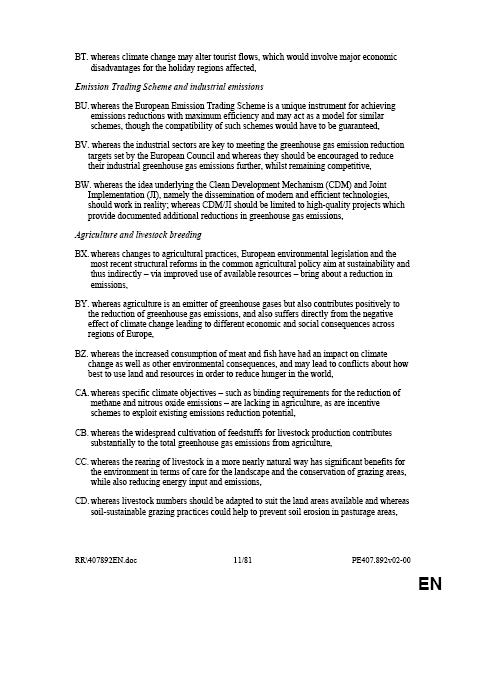


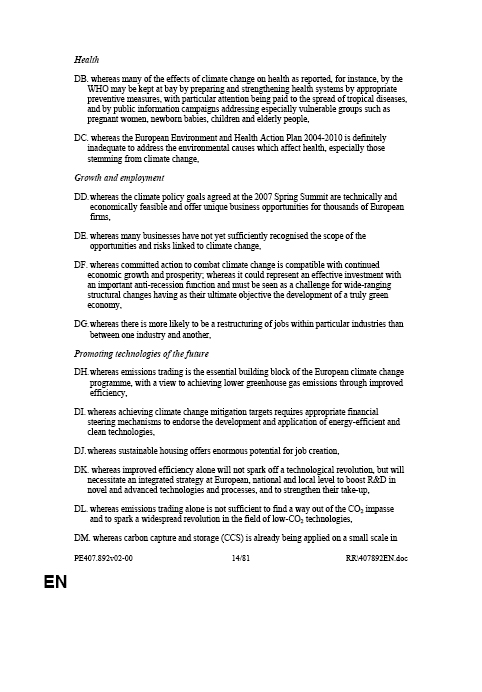
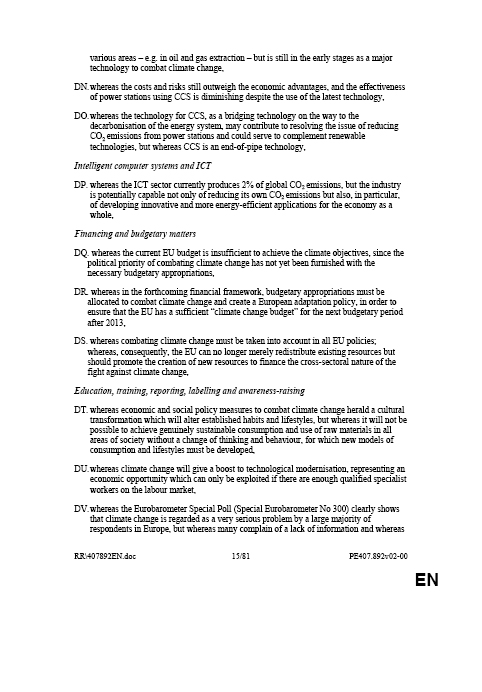
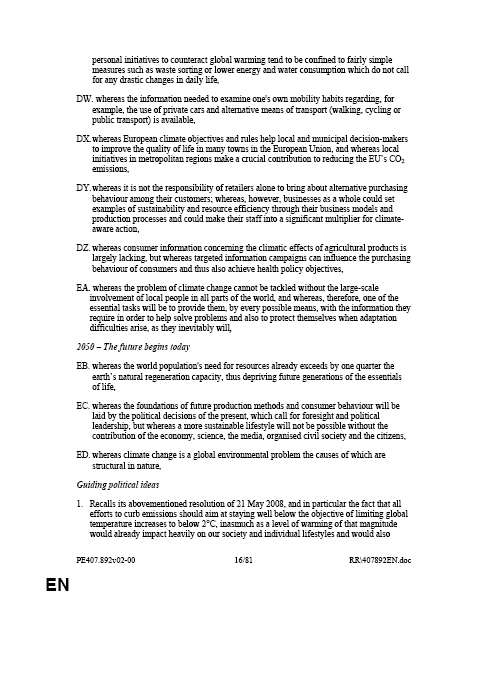
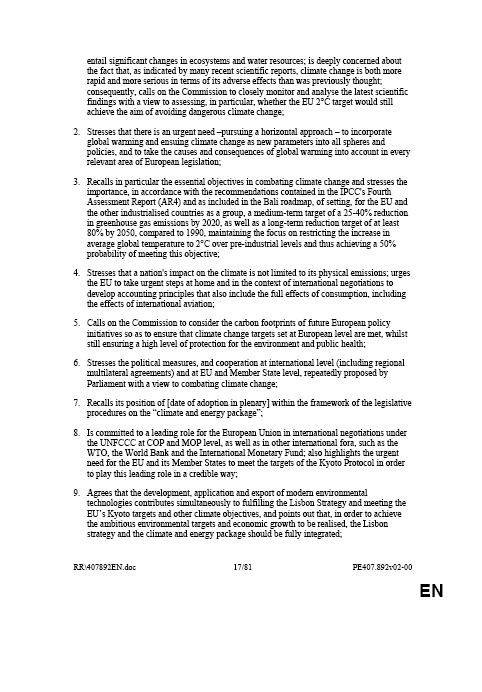
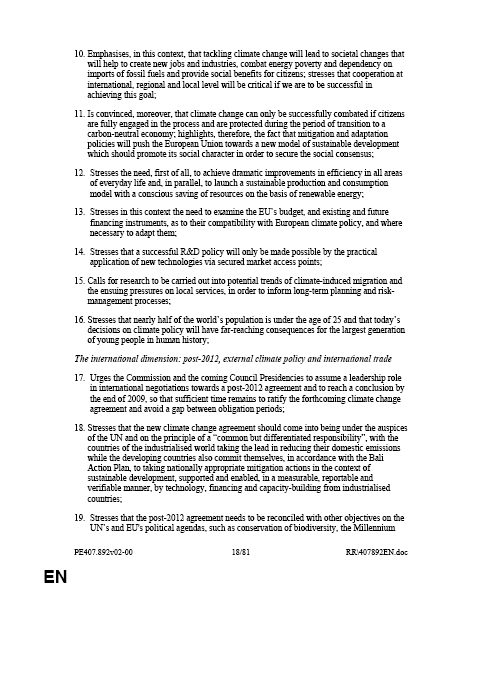
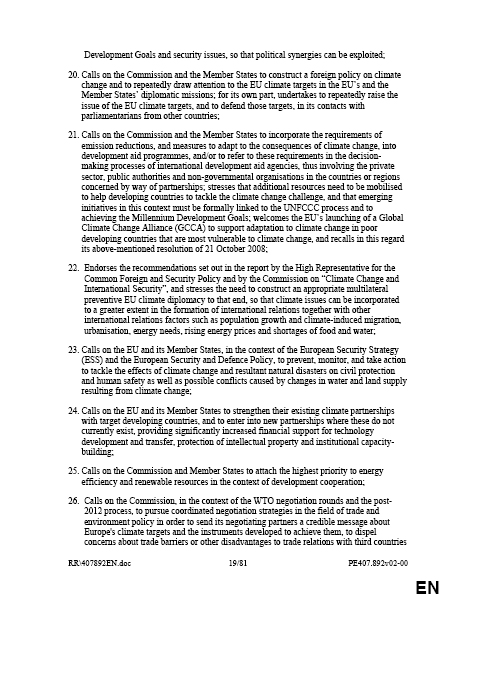
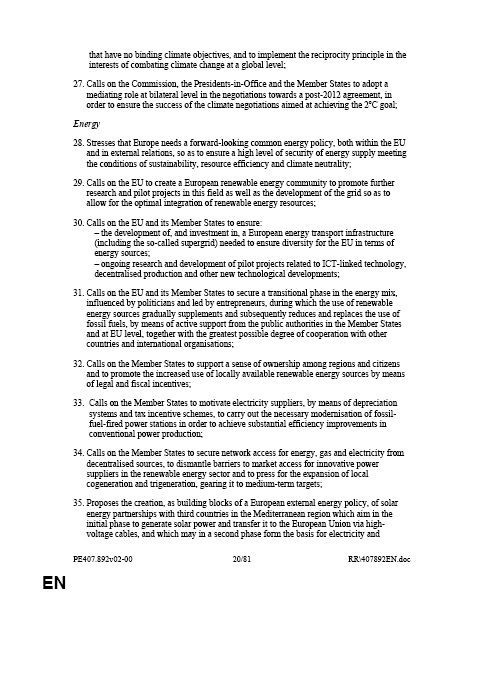
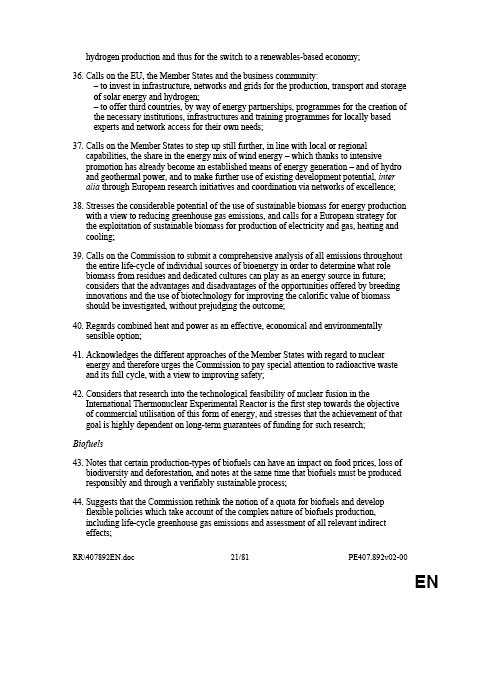
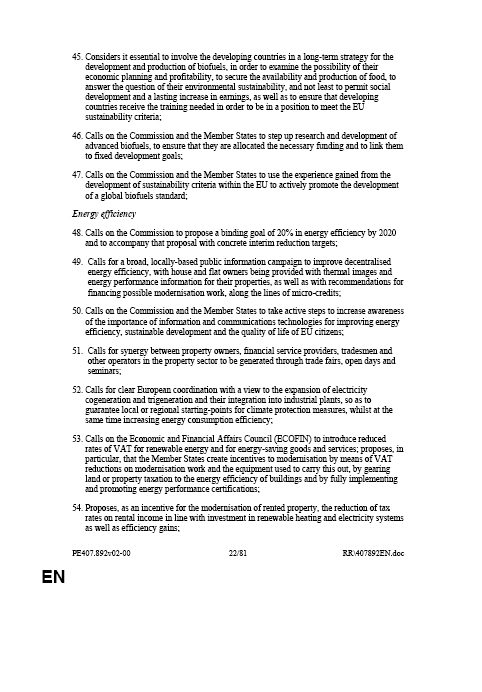
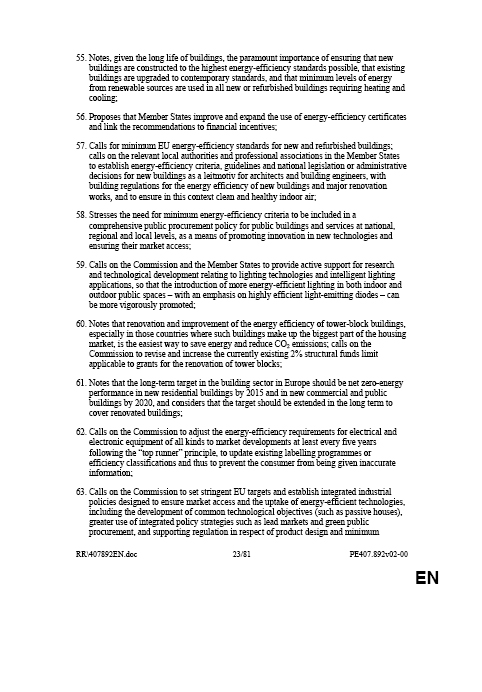
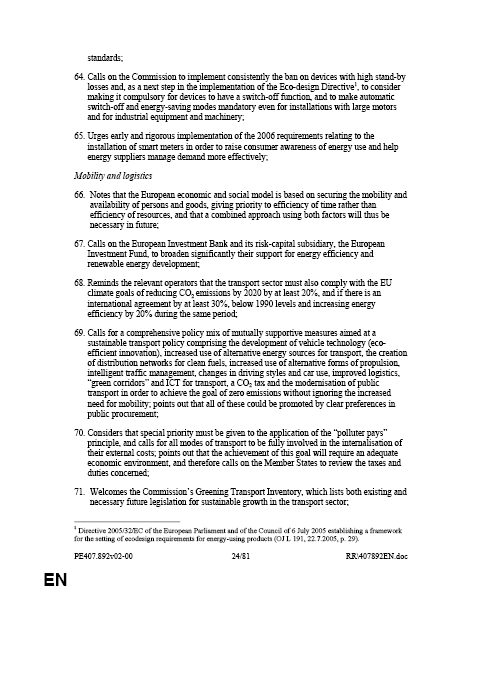
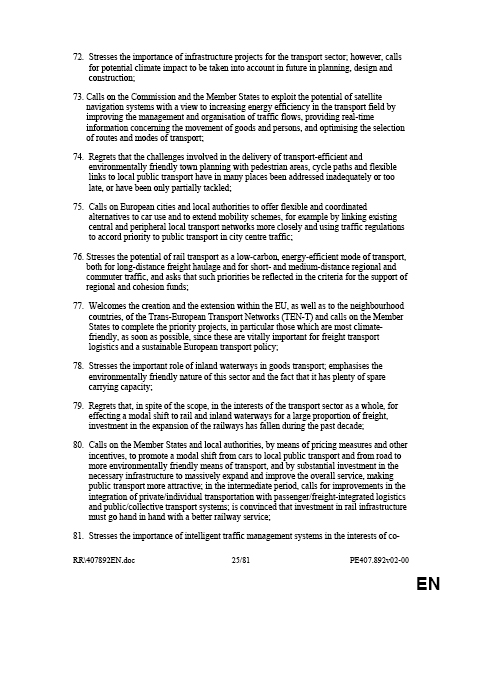
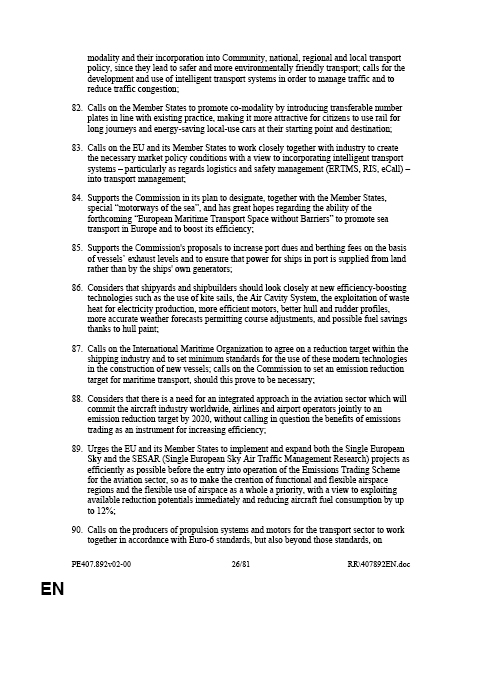
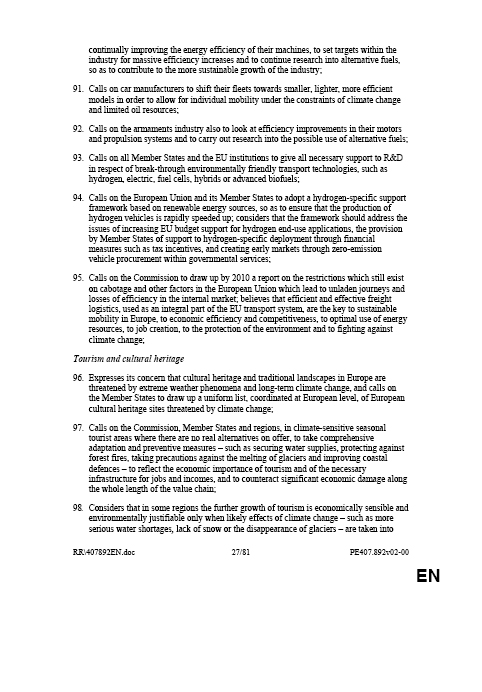
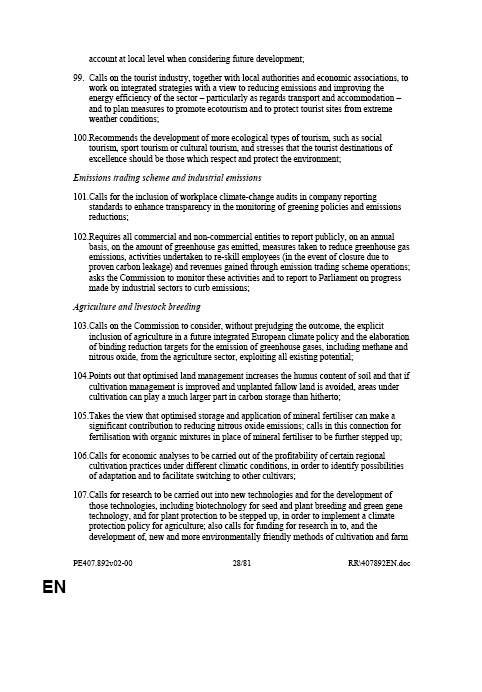
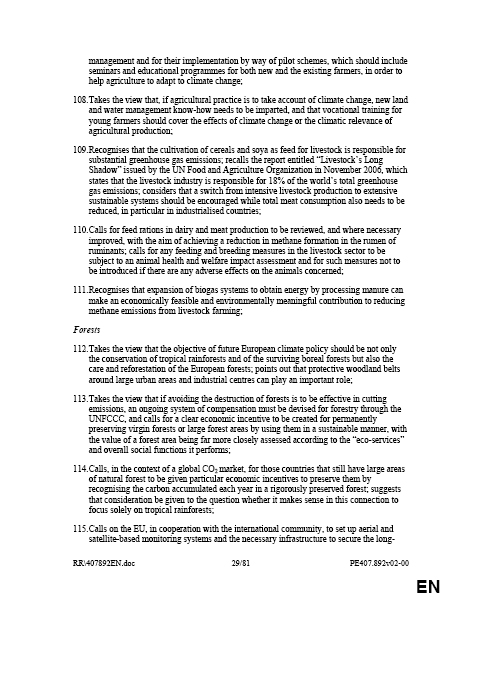
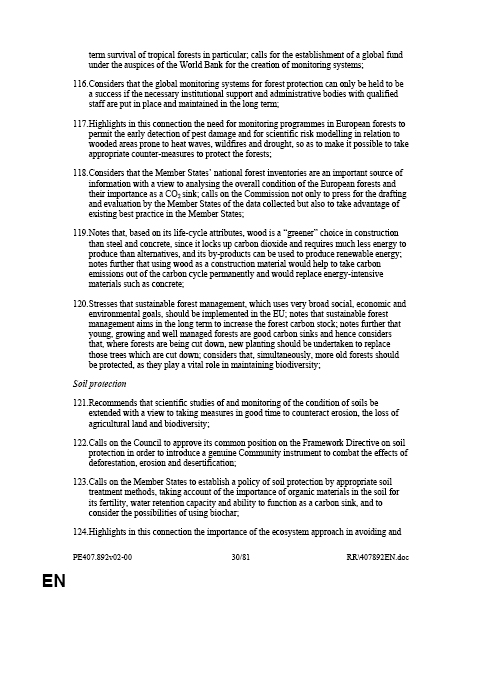
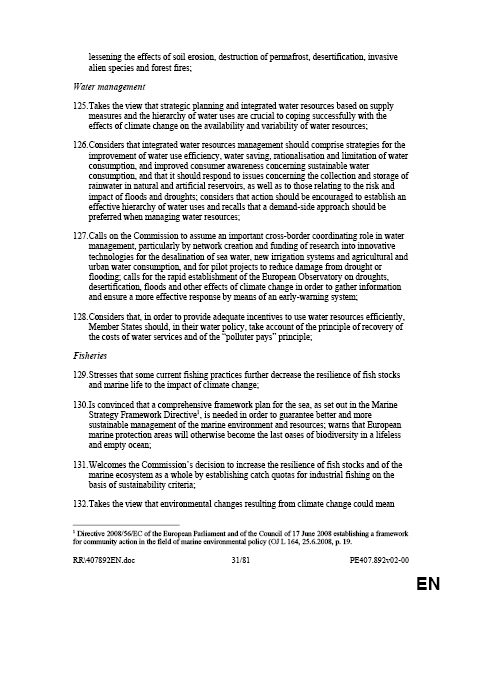
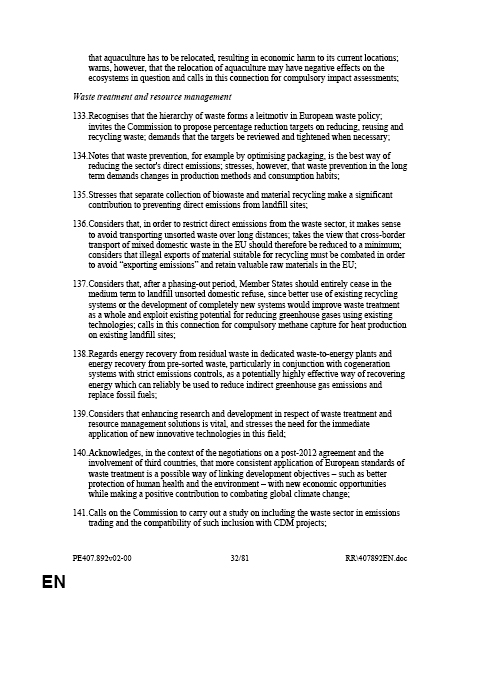

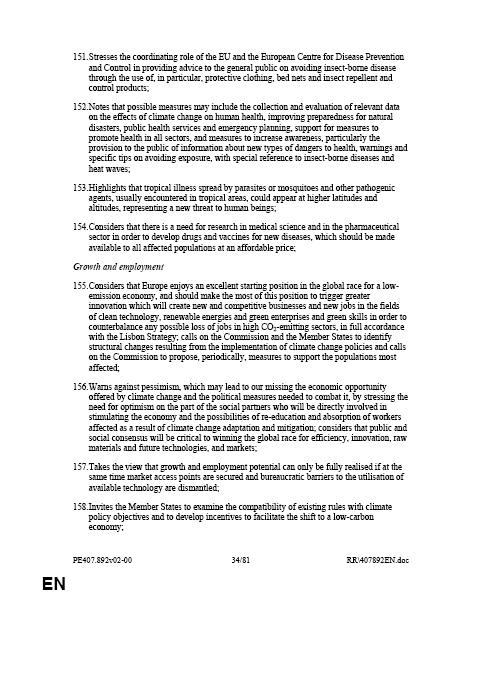

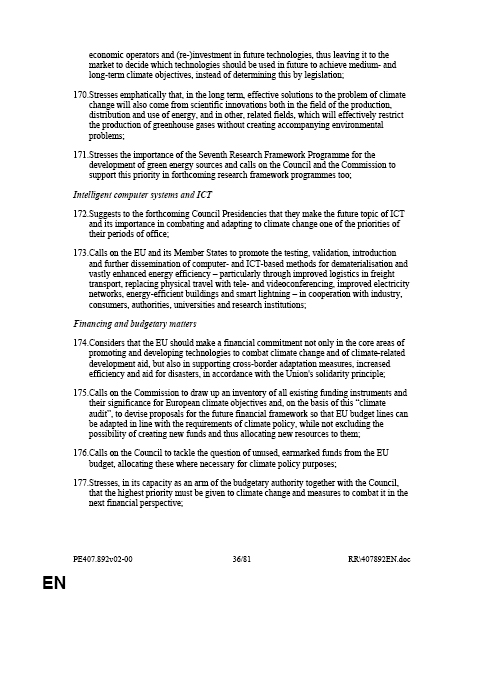
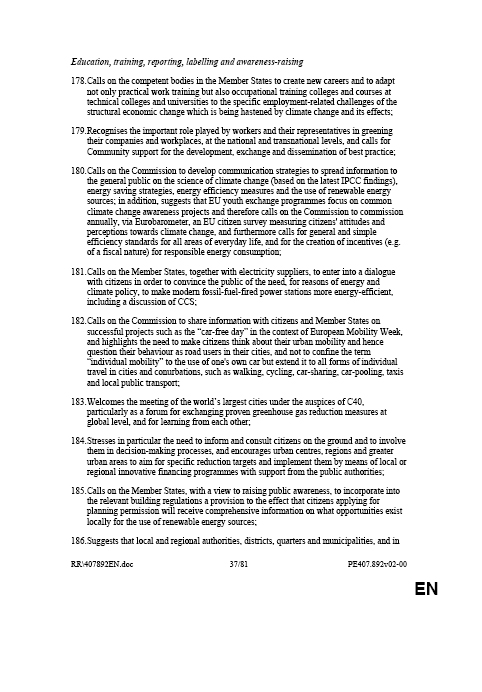

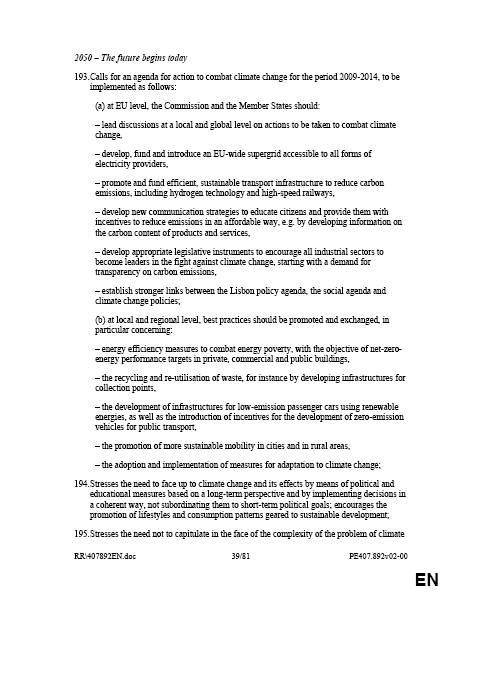


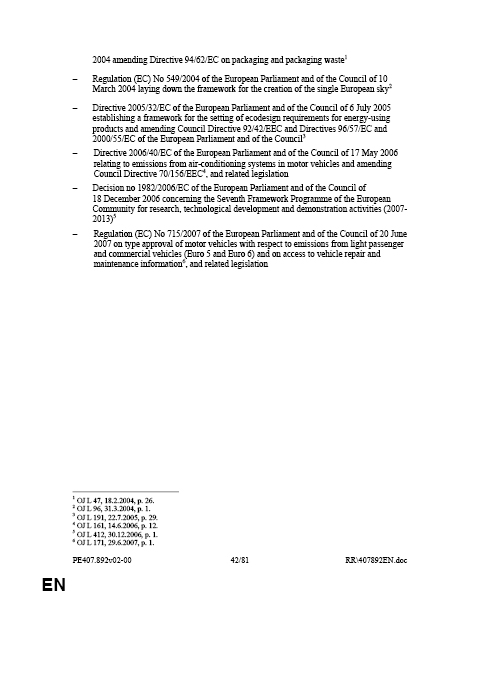
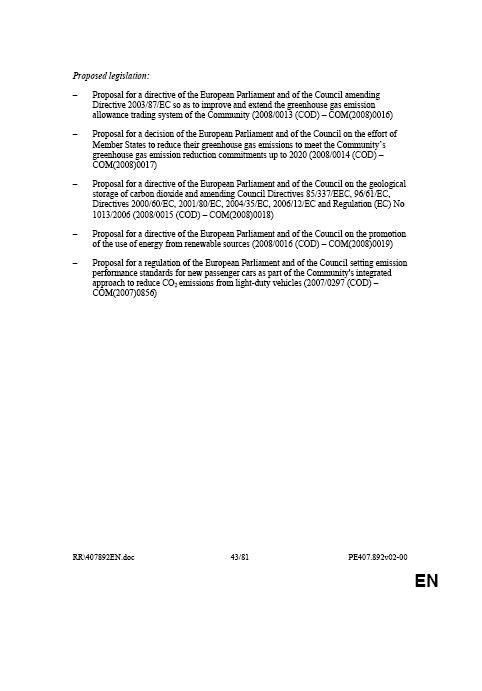

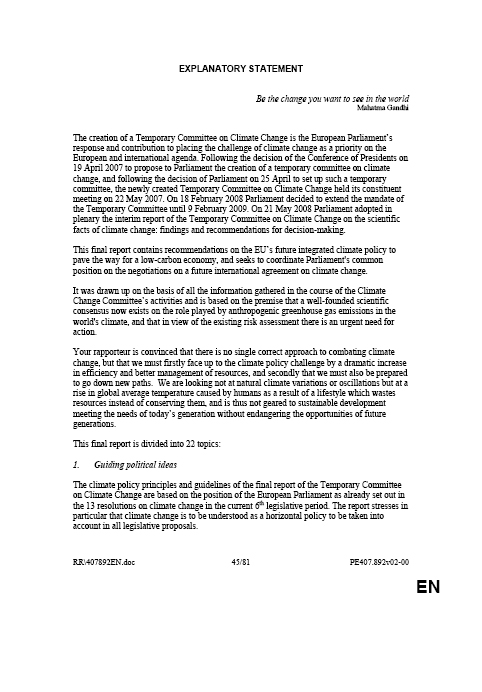
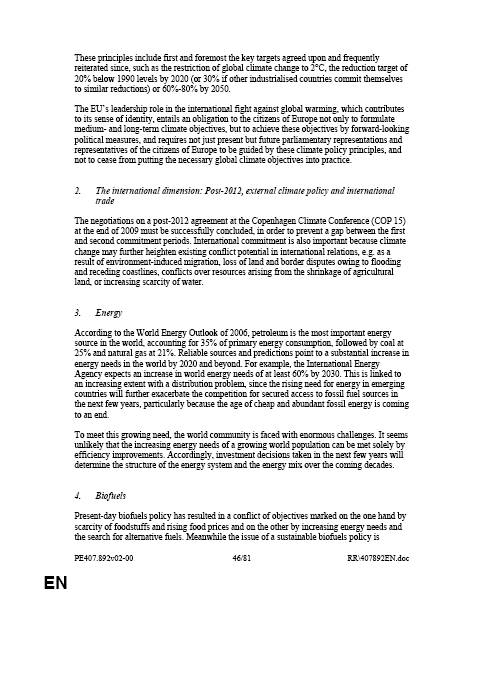

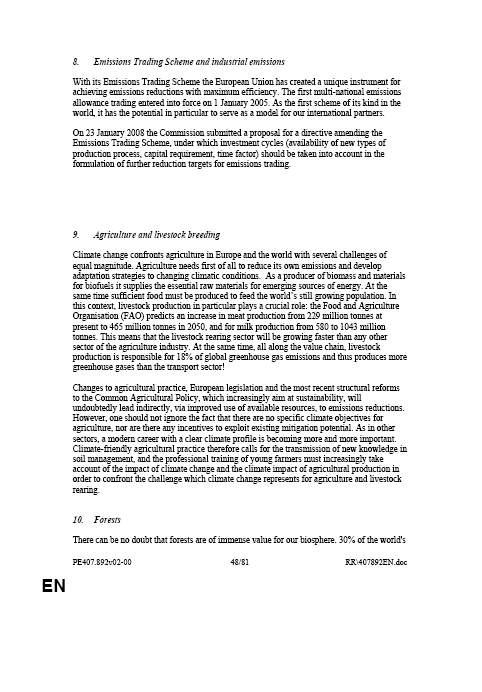
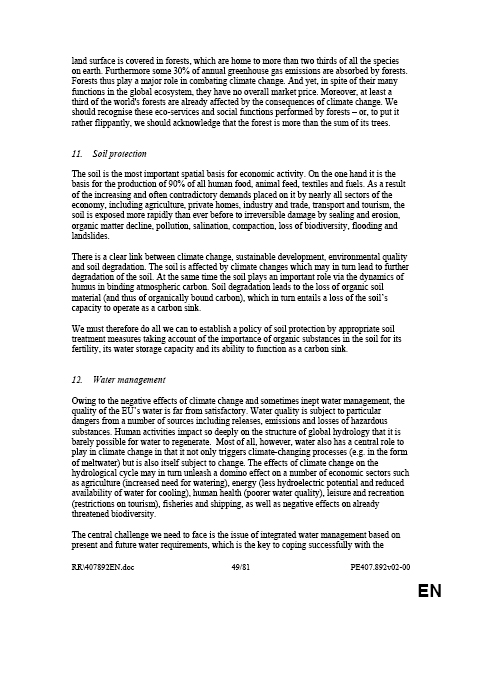


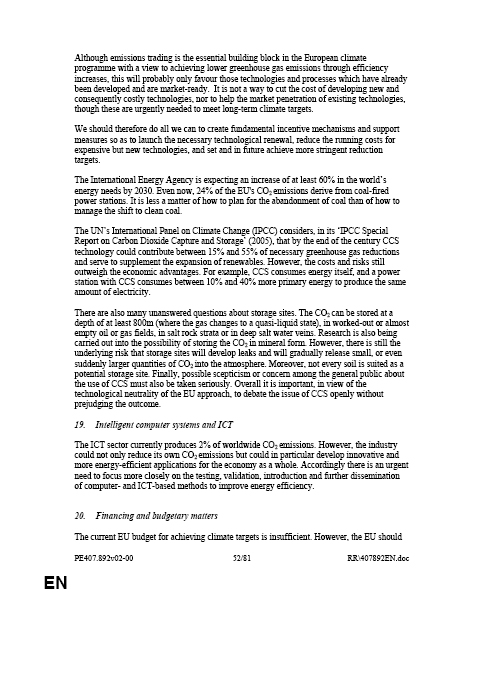

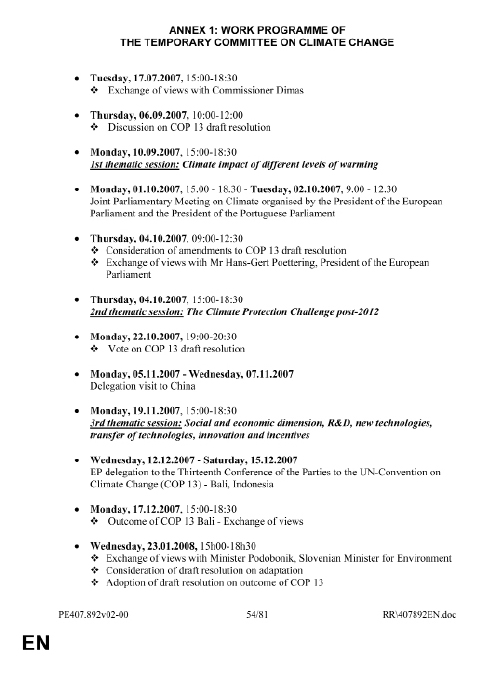
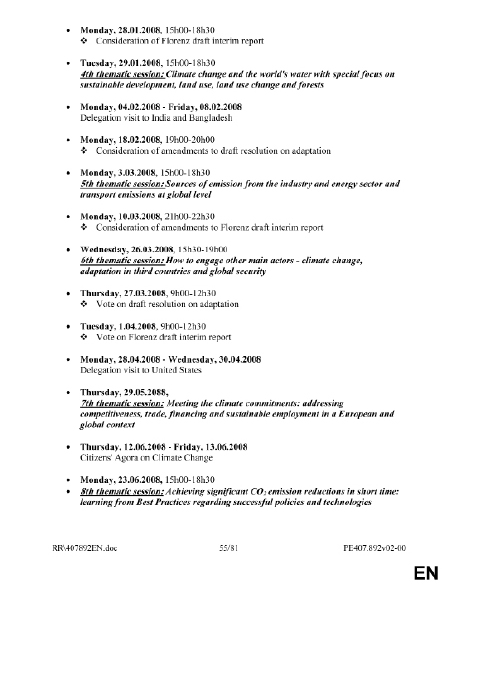
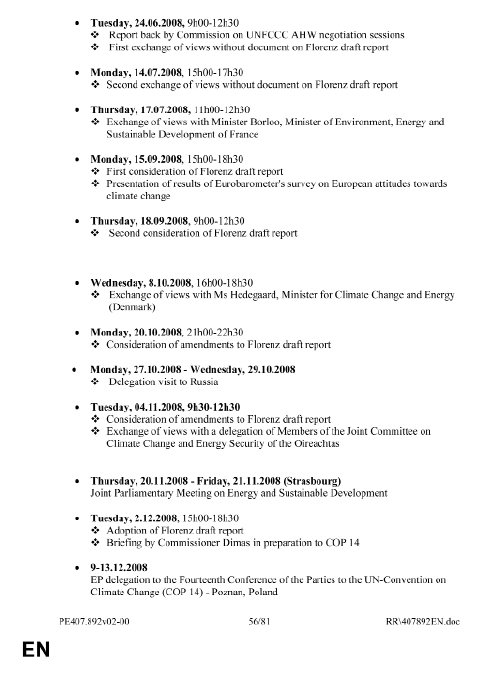

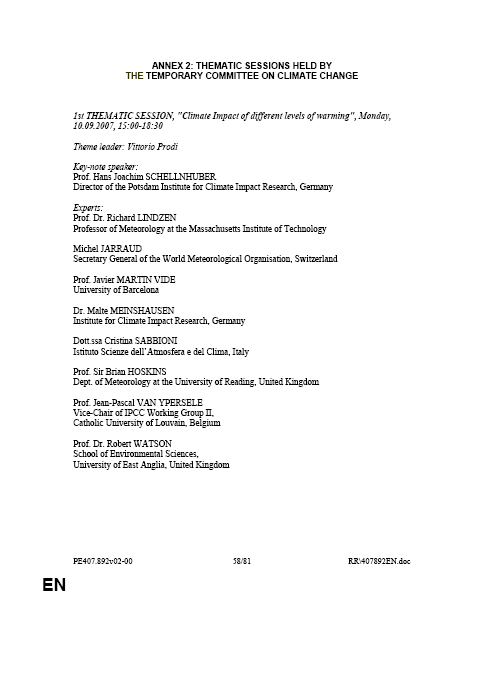


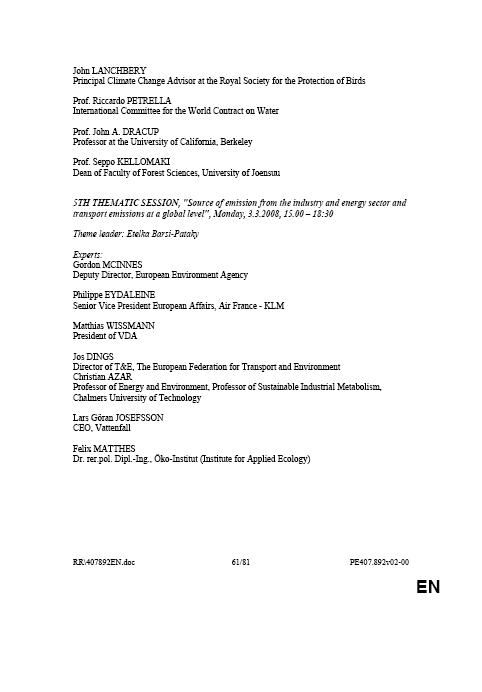





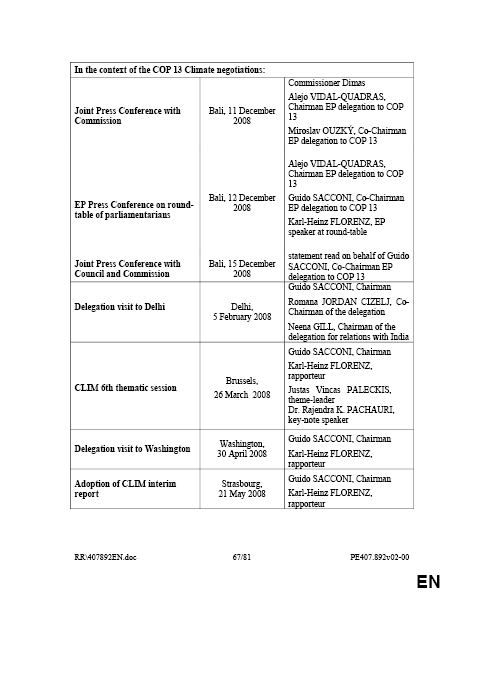



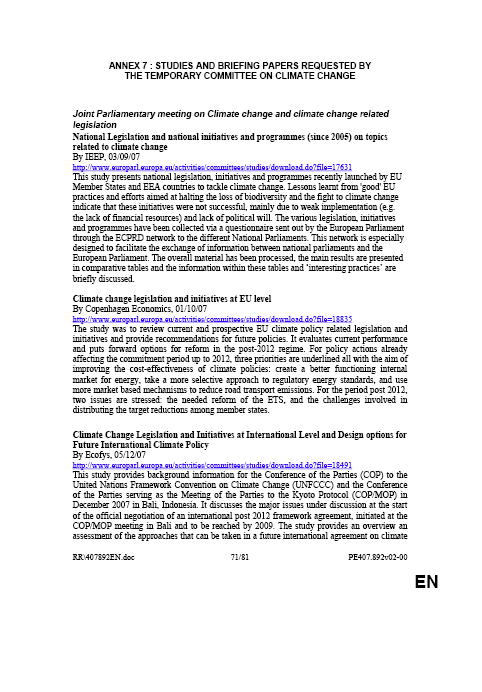

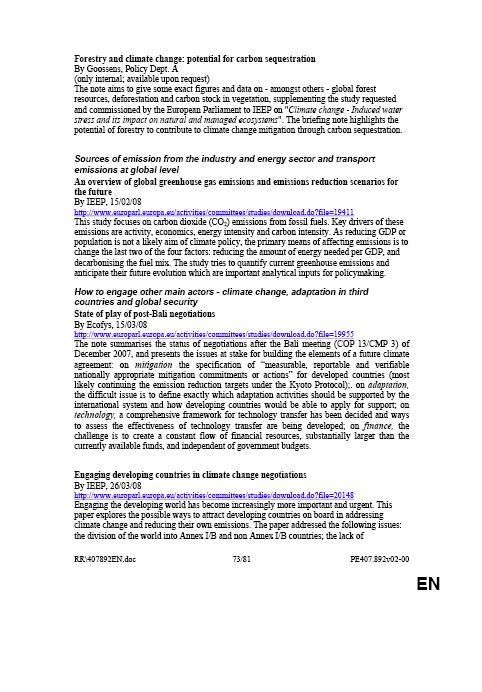
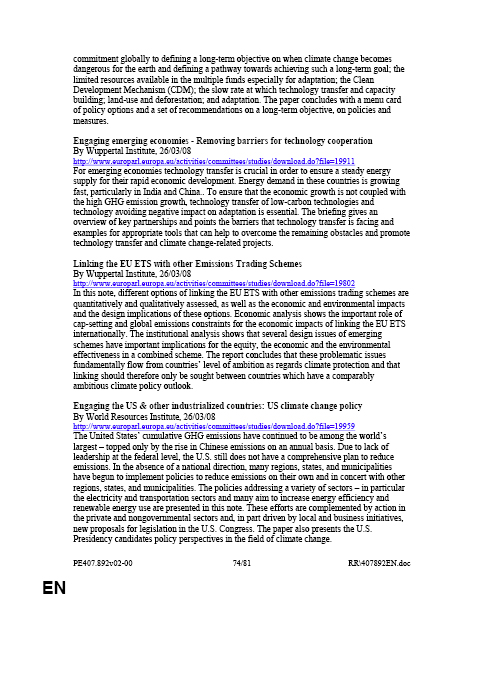
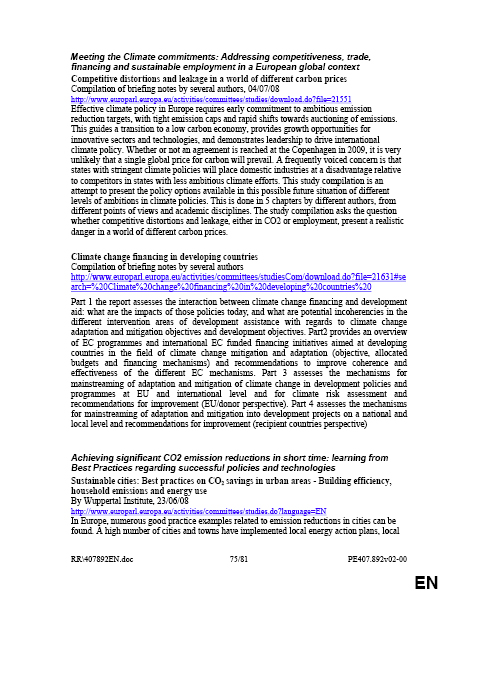
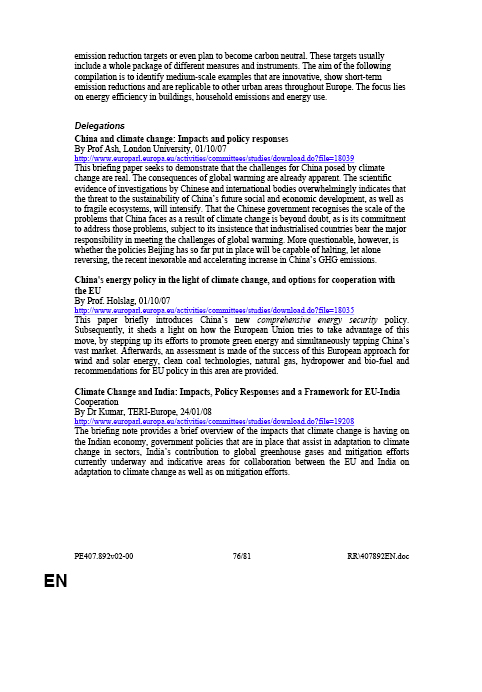

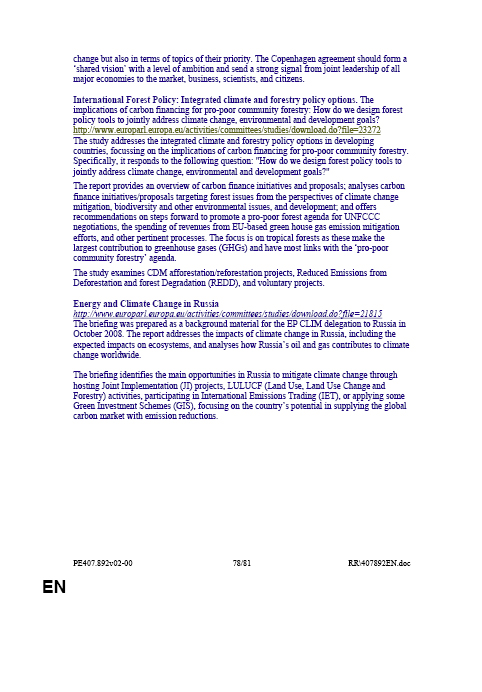

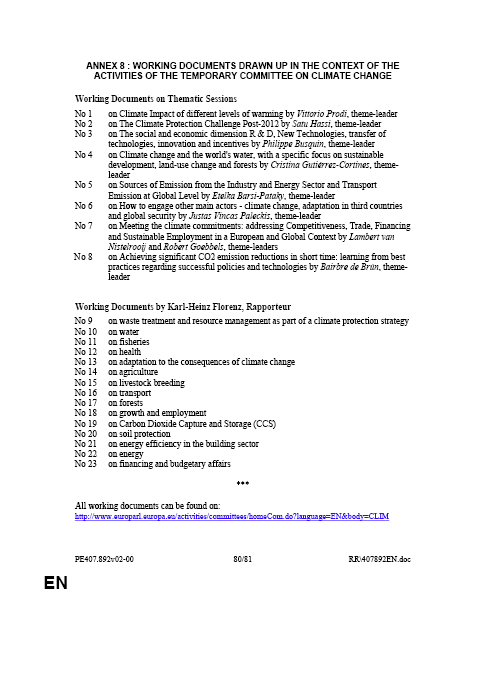
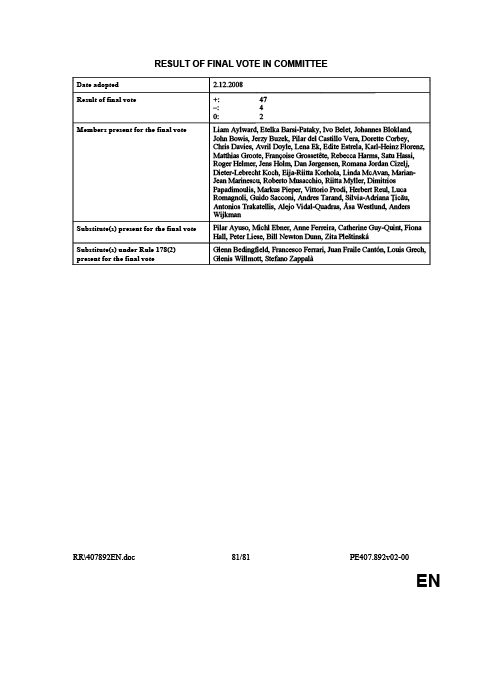
European Parliament
|
2004 |
|
2009 |
Temporary Committee on Climate Change
14.7.2008
Working Document No. 8
on the 8th Thematic Session “Achieving significant CO2 emission reductions in short time: learning from best practices regarding successful policies and technologies"
Contribution by Bairbre de Brún, Theme leader to the Rapporteur
Temporary Committee on Climate Change
Rapporteur: Karl-Heinz Florenz
Introduction
The Temporary Committee on Climate Change (CLIM) held its eighth thematic session on the subject “Achieving significant CO2 emission reductions in short time: learning from best practices regarding successful policies and technologies" on Monday, 23 June 2008, from 15:00-18:30, in the premises of the European Parliament in Brussels, Room PHS 1A 002.[1]
The objective of the eighth session was to gather information on the possibilities to start quickly a coherent policy in order to combat climate change. These policies should not be dependent on R+D nor on possibilities that are not yet available in the market, but focus on existing technology. Together, they should be able to reduce significantly the amount of CO2 emissions.
Opening session and first expert panel
Guido Sacconi, Chairman of the Temporary Committee on Climate Change, opened the event introducing the speakers and the topics to be discussed. Inaugurating the eighth thematic session, the Chairman encouraged the experts to explain the various possibilities concerning the reduction of CO2 emissions.
Karl-Heinz Florenz, Rapporteur for the Temporary Committee on Climate Change asked the experts to deliver solutions that would be immediately applicable and that would produce significant positive results.
Bairbre de Brún, theme leader for the 8th thematic session stated that although climate change is a global challenge, solutions can be found at local level. The successful companies of the future will be green companies. The successful cities will have an urban infrastructure that helps to limit CO2 production.
Key-note speaker and First Expert Panel
Calling climate change “the single biggest problem humanity has faced" the key-note speaker Ken Livingstone said that the tools necessary to halve emissions are already in place. He said that political will and sustainable energy consumption are key requisites and that a successful EU climate change policy will have to involve the pooling of best practices across Europe. In London, said Livingstone, it would be possible to reduce carbon emissions “by 60 percent by 2025 and 80-90 percent by 2050" by using existing technologies.
Ken Livingstone had to convince the British government to change the regulatory framework to locally generated power, because the present mass power generation far from the users creates a waste of energy of 65 % in cooling and transport. When local power stations were used, the heat could also be applied usefully so that only 15 % is lost, which makes 50 % difference or 30 percent of the total.
The other 30 % of gains can come from lifestyle changes: never waste anything: re-use waste, never waste light, use efficient fridges, washing machines and other white goods, and properly insulate homes. If each city advances on every front - accumulating best practices from cities worldwide - the 60% reduction in London could be reproduced all over Europe.
Ken Livingstone when Mayor of London was instrumental in establishing the C40 group of the world’s largest cities, working in partnership with the Clinton Foundation to reduce greenhouse gas emissions among cities. The Clinton Foundation used its bargaining power to negotiate with big companies on the subject of retrofitting buildings. As the number of bigger projects increased, so did demand and thus the whole market, and prices could be brought down. Further there was a negotiation on special financing arrangements. The companies would do the work upfront without charging and would be paid back from 80 % of the energy savings, leaving 20 % for the “clients". The congestion charge was also important as will be the introduction of a low emission zone in London with tariffs on certain lorries not complying with standards.
European legislation is helping local government work more in a more environment-friendly way. Without regulation in the EU, the slowest would even be slower.
Frederic Ximeno i Rocca, Director General for Environmental Policies and Sustainability, Generalitat of Cataluña, spoke on the experiences of Catalonia, and in particular on the hugely participatory process that led to the development of their 2008-2012 Catalan Plan to Mitigate Climate Change. The aim of the government of Catalonia is to prevent the emission of 5.33m tonnes of CO2 equivalent on a yearly average during the Kyoto protocol period.
A Catalan office for combating climate change was created and citizens were invited to take part in the Catalan Convention on Climate Change. More than 800 people and around 500 different organisations were involved. More than 1000 proposals were examined, many of them highly developed. They adopted a structured approach involving not only meetings but also internet and media programmes, integrating all sectors of the government as well as civil society and resulting in clear objectives. The focal point of the plan’s efforts is on mitigating emissions from sectors not included in the EU’s Emissions Trading Directive, and which contribute 65% of emissions including mobility, waste, agriculture, the residential sector, retail, construction, industry and energy. The plan also includes a programme for the sectors covered in the directive, as well as a programme of actions aimed at driving research, awareness-raising and participation. The government of Catalonia considers that the participatory process has helped particularly to increase awareness, motivation and support by the population for the climate programme.
Mark Harbers, City Councillor (Wethouder) of Rotterdam, presented the Rotterdam Climate Initiative, which intends to achieve a 50% reduction in CO2 emissions by 2025, compared with the level in 1990. This initiative was partly inspired by Rotterdam’s participation in the international climate program of former US president Bill Clinton. Within this programme, Rotterdam leads the way in the subprogramme focused especially on world ports. Both the government and the corporate sector are represented in the Rotterdam Climate Initiative. This concerted approach allows rapid progress and it has created enormous action power.
Innovative entrepreneurs come up with clever ideas for alternative sources of energy. Sizeable transport companies, such as TNT, the Rotterdam taxi centre, and the municipal transport company all contribute their own programmes to enhance the sustainability of their fleet. Companies that emit a lot of CO2 capture this CO2 and transport it to the greenhouse district nearby, the Westland, where market gardeners use it to grow tomatoes. Housing associations are working hard to enhance the sustainability of their housing stock, and more and more property developers decide to build only sustainable buildings from now on.
The municipality, therefore, mainly needs to serve as a catalyst, a booster, a trailblazer. They remove barriers, for instance by helping to provide new forms of financing to improve the possibilities for sustainability investments. They detect initiatives and movements, identify frontrunners, place good examples on display for everyone to see, and bring parties together. They have reached agreements with developers, building contractors, architects and investors on sustainable construction in Rotterdam. Together with forty other large port cities they will conclude agreements on cleaner forms of shipping. They are conducting experiments concerning the possibilities of introducing LED lighting in the city centre of Rotterdam. And they invest in innovation, for instance in the further development of Formula Zero (cars running on hydrogen), as well as new types of wind energy. Last winter, they arranged for the delivery to over 300,000 homes, of two low-energy light bulbs. All of these low-energy light bulbs together result in a total saving of 50,000 tons of CO2.
Gösta Gustavsson, Vice Mayor of Linköping in Sweden talked about the initiatives and best practices in his city, including best practice transport initiatives, promoting public transport and halving the transport of goods through pooling. Linköping applies climate and environmental requirements to all purchases and communicates climate issues to employees, elected representatives, residents and businesses in the municipality. Bicycle traffic amounts to 30% of all traffic and there is more than 40km of pedestrian and bicycle paths.
Linköping is today one of Europe’s leading biogas cities and has fifteen years of experience of the processing, production and development of bio-methane, from organic matter such as waste from slaughterhouses and household food waste, which is used in city buses, refuse collection vehicles, almost all taxis, and the municipal car pool. There are three production plants, thirteen public fuelling stations, and one bus depot. Bio-methane sales represent 6% of the total vehicle fuel volume in Linköping. Bio-fertilizer is sold to farmers and replaces fossil fertilizers. Linköping will also try to run a train on biogas. Organic waste is turned to biogas with the advantage of a reduction of weight and volume of the “waste mountain".
Other initiatives mentioned include the district heating and cooling grid, a sorting plant/recycle station, landfill elimination and initiatives that seek to involve all citizens and the private sector. Linköping’s economic track record shows that the municipality and society has benefited. There must be long term targets and rules because companies and citizens must trust the city. That is the secret and the EU has, until now, been very helpful in creating this stable set of conditions.
In the discussion after the first expert presentations the following Members took part: Riitta Myller, Roberto Musacchio, Karl-Heinz Florenz, Catherine Guy-Quint, Vittorio Prodi, and Guido Sacconi. The discussion focussed on an eventual binding target for increased energy efficiency, the input of the non-used electrical power into the public grid, the stimulating power of European rules, the use of waste and the effects of measures on transport and mobility.
Key note speaker Ken Livingstone answered that there are still problems of congestion but that there is a shift away from cars usage to public transport and cycling. There are 50 % more bus passengers and many more buses. Incineration must be skipped in order to use more efficient ways of getting rid of waste. EU regulations always worked best and Ken Livingstone asks the Members to be tougher.
Frederic Ximeno I Roca mentions that Spain has not yet achieved its goals on CO2 reduction. EU regulation helps to put environmental objectives into mainstream SMEs take many initiatives in Barcelona because there is now more awareness. There are seventy-three measures to reduce pollution. Although drivers did not react well to 80 kilometres per hour speed limit, there are fewer accidents, less petrol use and less CO2-emissions.
Mark Harbers states that there is a very good information-exchange including the communication of experiences. Bigger companies know that it is in their economic interest to invest in CO2 reductions but SMEs are somewhat lagging behind. In the field of heat-power and residual heat there are extensions of district-heating. EU regulation is very important to make progress and Mark Harbers advocated regulation on the waste of heat, particularly because heat is not an unuseful waste.
Gösta Gustavsson. said that in Linköping there is no incineration of what can be re-used or recycled. A municipal company is responsible for district-heating. If you start with biogas you need to have it, you need to have the infrastructure and the users, and all that at the same time.
Second Expert Panel
Guido Sacconi welcomed the second expert panel consisted of Carin ten Hage, director of “Planet me" (the environment programme) within TNT, Neil Harris, Head of Green IT and Sustainability, CISCO Europe and Franco Miglietta, Associate Professor, Department of Nuclear and Theoretical Physics, Research Director at the Institute of Biometeorology of CNR, Firenze.
Carin Ten Hage stated that the overall ambition of TNT is a continuous reduction of the carbon intensity of operations through a three stage procedure. The first Count Carbon is to count carbon and integrate carbon management in business processes, measuring the impact of initiatives, setting targets, improving internal carbon reporting, developing a framework for effective carbon management and providing accurate CO2 information to customer level. The second part Code Orange touches on every aspect of business, including aviation, buildings, business travel, company cars, green investment, operational vehicles, procurement and partnering with customers. The company builds and implements a global fuel and energy efficiency programme, develops a subcontractor strategy, and purchases green electricity for TNT’s European operations. TNT will include CO2 among the principal criteria in their budget and investment process. They will also implement a green company car fleet and introduce an additional cash incentive for employees who choose cars that produce less than 120g/Co2 per kilometre. The company’s trucks and vans generate some 23% of total emissions and they are running a number of projects for the use of alternative fuels such as the use of electric lorries, pure bio diesel lorries, hybrid trucks, and even in bio diesel-blend trucks in India. The third part Choose Orange is a voluntary programme that aims to engage all employees and their extended family by educating, engaging and motivating employees on fuel efficient driving through the “Drive me" challenge, for example and through educating the next generation through the Planet Me Game.
Neil Harris, Head of Green Technology and Innovation for CISCO Europe says it is the responsibility of every industry to be greener. The Cisco green programme will by 2012 result in a 25 % reduction of greenhouse gas emissions. Cisco is a partner in the Clinton Global Initiative. ICT technologies account for a very small part of the world’s technologies, but they can provide solutions to help other technologies work more effectively. Cisco works to curb its own company’s greenhouse gas emissions through an eco drive that includes the measurement of energy flows, allowing machines to shut down when not in use and recycling material consumed in offices. The process to find the necessary reductions is to monitor, manage and reduce, as for electricity use in offices, appliances in homes, or traffic flows in cities. Other solutions for customers can include ICT and Ethernet to the factory floor for heavy industries such as steel work and cement factories and Smart grids for power generation and transmission. ICT solutions use energy but can also avoid the use of energy through the use of collaboration technology such as TelePresence software to allow for telecommuting thus reducing the need for business travel by employees, partners and customers. Connected Urban development is a Cisco initiative working with cities on urban design for better sustainability. It began in three cities San Francisco, Seoul and Amsterdam with a total Cisco investment of $15m and expanded to Birmingham, Hamburg, Lisbon and Madrid. The Amsterdam project alone is to save 76 thousand tonnes of CO2 over five years.
Franco Miglietta. Associate Professor, Department of Nuclear and Theoretical Physics, Research Director at the Institute of Biometeorology of CNR, Firenze, indicated the obvious problem: we have too much CO2 so the question is of how to make this carbon useful. His speech on “Biochar in agriculture for residue management, energy production and Carbon sequestration: a win to win strategy" intended to find solutions to that problem. Investigators found a dark type of soil in Brazil and this dark soil dates back to pre-colonial times. Charcoal was used as fertilizer, it made the plot very fertile and the result is a remaining black-coloured soil. Biochar is green charcoal. Vegetable charcoal remains in the soils for thousands of years, improves the water dynamics of the soil, remains active as fertilizer and the production by pirolyses/distillation also produces energy . You can make it out of plant waste. There are thus three win situations: substitution of a portion of fertilizers, sustainable land-use and reduction of off-site pollution.
In the discussion after the second round of expert presentations the following Members took part: Riitta Myller, Vittorio Prodi, Karl-Heinz Florenz and Guido Sacconi. The discussion focussed on the package which parliament should give its opinion on, the availability of plant-matter necessary for the production of biochar and other aspects of the production of biochar.
Carin Ten Hage stated that business needs a real value put on carbon emissions because then they will invest in new technologies. ETS must be transparent, must have the same standards for the whole economy. Businesses need consistent and pragmatic policies. Neil Harris answered that in the ICT industry we work a great deal on energy efficiency by ICT and that will contribute to solving the CO2 problem. Franco Miglietta gave an example of a farmer. On 1ha of land the outcome of 1 year could be an emission of 30 tons of CO2.Ten tons would lead to food to be consumed, 20 tons could be included in the waste. This waste should either be burned or it can be used to produce organic charcoal, with all the advantages. It is important that it is used and that there is a legislative framework. One can calculate how much CO2 is taken from the atmosphere. His opinion is that planting trees will create mitigation, but not much. In farming and biochar the result would be easier to calculate and more significant.
Bairbre de Brún, theme leader, stressed that speakers from both the public sector and business are for EU regulation. No sign of fear for employment has been shown, on the contrary the indications were that through the measures to combat climate change a lot of work and thus employment can be created. But the most important conclusion is bringing people with you. Every participant in the thematic session stressed that motivation is a very important factor.
Even though climate change in an urgent issue not many of our cities and governments are sharing the information that is out there.
Karl-Heinz Florenz, rapporteur, pointed out that the ideas of the C40, executed in London and other cities where an innovative financing plan was introduced where the works were done by and financed by industry from future gains were very interesting. They could certainly be more widely applied and might increase demand and thus lead to lower prices of innovative products. Internalization of external cost will lead to fair situation. As far as traffic is concerned, we are close to traffic collapse and ideas must be developed to improve the situation. If you collect and implement best practice from each area of the world you can advance significantly.
Conclusions by the Theme Leader:
On the basis of the presentations and the discussions held at the eighth thematic session the Theme Leader draws the following key conclusions:
1. A sufficient mix of technologies exists to make rapid CO2 reductions possible. EU policies act as a spur to the adoption and use of these technologies and can help on a national, local and regional level to achieve rapid reductions of CO2 emissions.
2. Information on climate issues and climate solutions is all important. Businesses, cities and governments will be inspired to action if they know that what they regard as ‘new’ technologies and policies are already standard practice in other places, and are producing results.
3. An action plan with clear objectives and targets will aid progress, drawing on widespread input from a range of participants and learning from best practices elsewhere. The challenge is global but individual and local actions produce solutions. No place is too small to make a contribution.
4. Motivating citizens, employees, business and other stakeholders is important in getting action and changing habits, attitudes, practices and lifestyles. Networking and information exchange will help local and regional governments in developing the necessary approaches.
5. Initiatives such as the distribution of two energy efficient lightbulbs to every household address mentioned in the presentations can be as important in raising awareness as the use of documents or media advertising campaigns.
6. Amongst the best practices mentioned in the thematic session were efficiency measures such as retrofitting of houses and offices, more sustainable buildings, better traffic planning, more efficient lighting, re-using and re-cycling, more efficient use of water, increased public transport, walking and cycling, use of ICT to reduce travel and to improve the effectiveness of processes in industry, monitoring the carbon footprint of the business or municipality, and a move to renewables. There are administrative and motivational barriers to be overcome, but the overall effect of these measures is a positive financial gain, less CO2 emissions and a significant rise in employment.
7. Sustainability and economic development are not opposing factors; they are opportunities for mutual reinforcement. Quality of life and employment will not suffer from actions to combat climat change.
8. There is a greater willingness to contribute to tackling climate change than is generally thought, including among business. Clear legislation and ambitious long-term emission requirements from the EU aid stability in planning as well as intermediate targets and clear legislation at member state level.
9. Local and regional level governments could set stricter, binding targets than the 20/30 % reduction envisaged by the climate package of the European Commission. However, as cities and regions differ greatly, those targets should be tailored to the regional or urban level.
10. Innovative financing programmes must play a role in order to overcome barriers
11. Waste management and the use of waste are crucial for urban areas. The use of waste in an environmentally sustainable manner can create a supply of biogas, energy, and heat, relatively close to users in the urban area. As examples have shown, waste management can provide financial gains, less CO2 and a positive effect on employment.
12. Large companies can make changes not only to their own practices but, through engagement with subcontractors and suppliers, can influence the behaviour of SMEs also. They can also engage with their employees about lifestyle changes outside the workplace.
[1] Please note that some presentations delivered at the thematic session are available at the CLIM-Webpage at http://www.europarl.europa.eu/comparl/tempcom/clim/sessions/default_en.htm
Bairbre de Brún MEP
February 2009
Overview
Sinn Féin recognises the potentially disastrous impact of climate change on our environment and society. We believe that effectively tackling climate change brings opportunities as well as challenges.
In the Sinn Féin submission to the Programme for Government (PfG) we identified recommendations relating to a number of Departments on how to tackle Climate Change.
The Executive should commit to reducing our emissions by at least 30% from their 1990 level by 2020. The rate of reduction should be at least 3% per annum. There also needs to be periodic targets set by the Executive for the period leading up to 2020, and proposals made to compensate where emissions reductions targets have not been met.
The European Union has introduced a mandatory target of 20% renewable energy-use by 2020, and we should play our part in meeting that target. We believe that Ireland is well-placed to be at the centre of a new, green economy, if the political will exists, because of our potential abundance of wind and wave energy as well as our historic lack of heavy industrialisation compared to other developed countries. Sinn Féin also supports the use of biomass and solar energies as a part of our renewable energy production.
Sinn Féin supports waste to energy solutions where these involve production of electricity from Mechanical-Biological Treatment and Anaerobic Digestion processes in Combined Heat and Power plants, and do not involve incineration or other thermal waste treatment.
Within an all-Ireland framework, Sinn Féin also supports moves towards energy independence and decentralisation in energy production. We believe the Assembly Executive and the Irish Government should put renewable energy production at the heart of all-Ireland economic planning in order to allow a prosperous all-island economy to become a world leader in renewable energy production.
Underpinning this approach should be an integrated strategy across government departments and in conjunction with local councils, accompanied by targets, goals and monitoring mechanisms.
Initial commitments
Climate change is not just the major political challenge of our time; the worst impacts of climate change constitute a great social, environmental and economic threat. We cannot afford to fail in addressing the very real danger of climate change.
While much political attention is rightly focused on bringing down the emissions that cause climate change, we also need to work on adapting to climate change. Even if we agree strict new emission reduction standards, we will still need to deal with changing climate conditions for decades to come. We need to be prepared.
The Assembly has given its consent for the provisions of the Climate Change Act 2008 to apply to the North of Ireland. There is an opportunity through new local legislation and a new integrated Executive policy to take forward a strategic response to setting and meeting specific targets for the North of Ireland on reducing CO2 emissions and responding the economic challenges facing us.
A detailed integrated Executive strategy to setting out how we are going to meet our carbon emissions targets and adapt to Climate Change should spell out how each sector of the economy and society can contribute to reducing these emissions. The Scottish Climate Bill shows the direction that we can and should go, and we should take account of suggestions being made in Scotland for further strengthening of the Scottish legislation.
Sinn Féin believe the Executive could give a greater focus on a number of key areas, including:
- A reduction in energy consumption;
- The development of renewables; and
- Decentralisation of the energy infrastructure.
The Executive needs to reassess its options for tackling rising energy demand, meeting energy efficiency and renewable energy targets and reducing CO2 emissions. A tremendous opportunity exists to put the production and use of renewable energy at the heart of the Executive economic development strategy.
Investing in new technologies and moving much more decisively to renewable energies as well as energy efficiency can create more jobs and lower energy bills. Renewable energy in particular could be developed in an all-Ireland energy market.
The Executive needs to be pro-active in its support for low carbon innovation. Actions can and should be taken across departments, including in the fields of enterprise and job creation, energy, transport, agriculture and land use, waste management, planning, tourism, fisheries and forestry, education and training and finance and investment. Closer co-operation and co-ordination between Departments is needed and between the relevant Assembly Committees.
I also strongly support the call for building regulations here to be revised to promote the use of renewable energy technologies.
International and European context
2009 is a key year in setting out the global response to Climate Change with the UN Conference in Copenhagen at the end of the year due to agree new targets and actions to tackle Climate Change.
The European Parliament Climate and Energy Package has also given effect to the targets set by the EU last year to have 20% renewable energy, 20% energy efficiency and a 20%-30% reduction in emissions relative to the 1990 level by 2020. This represents an unprecedented attempt to tackle the causes and consequences of climate change. Sinn Féin supports all measures at local, national, EU and indeed at global level through the UN climate talks which can set the necessary binding targets for CO2 reductions.
There are some very disappointing elements in the EU package such as the possibility for member states to export the majority of their emissions reductions actions to countries outside the EU and the complete failure to stand up to the automobile industry and impose strict reductions in CO2 emissions from passenger cars. On the other hand the measures on renewable energy and on fuel quality and the improvements to the Emissions Trading Scheme represent movement in the right direction.
Efforts to decarbonise the economy will offer significant business opportunities in the time ahead and we should introduce fiscal incentives to develop research into clean technologies.
The European Commission has announced, as part of its European Economic Recovery Plan that it will allow EU funds be used for energy-efficiency projects in low-income housing. This is something Sinn Féin argued strongly for. The Executive should make this part of their strategy to deal with fuel poverty and to tackle climate change.
Sinn Féin also believe that all investments and policies in Europe should be ‘disaster and climate proof’. We have recently seen a stark example of a lack of local disaster-proofing in Stoneyford where a housing estate, built on a flood plain, has experienced repeated serious flooding, making the houses uninhabitable. We have to ensure that preventative measures are in place and that protection structures are well maintained. We also need to have strong policy controls on where building takes place.
In 2007 the European Parliament set up a Temporary Committee on Climate Change, vested with a number of powers including to formulate proposals on the EU’s future integrated policy on climate change. It held a number of thematic sessions, and I was theme leader for the 8th Thematic Session “Achieving significant CO2 emission reductions in short time: learning from best practices regarding successful policies and technologies"
Amongst the best practices mentioned in the thematic session were efficiency measures such as retrofitting of houses and offices, more sustainable buildings, better traffic planning, more efficient lighting, re-using and re-cycling, more efficient use of water, increased public transport, walking and cycling, use of ICT to reduce travel and to improve the effectiveness of processes in industry, monitoring the carbon footprint of the business or municipality, and a move to renewables. There are administrative and motivational barriers to be overcome, but the overall effect of these measures is a positive financial gain, less CO2 emissions and a significant rise in employment.
I attach the report of that session, Working Document No 8 of the Temporary Committee on Climate Change, as an annex to this submission.
The concluding report of the European Parliament Temporary Committee on Climate Change emphasised that tackling climate change will help to create new jobs in new technologies, combat energy poverty and dependency on imported fossil fuel and provide social benefits for citizens. It also calls for a ‘climate audit’ so that EU budget lines can be adapted in line with the requirements of climate policy, as well as tackling the question of allocating unused existing EU funds for climate policies. The report, which has since been adopted by the whole parliament in a somewhat amended form, contains useful suggestions in a range of areas, which could provide a good starting point for discussion and policy-making. I therefore attach a copy of that report also, (Appendix I) the European Parliament resolution of 4 February 2009 on “2050: The future begins today – Recommendations for the EU’s future integrated policy on climate change" (2008/2105(INI) )
Executive Action Plan on Climate Change
Binding domestic legislation which incorporates emission reduction targets can go some way to address the affects of climate change at home and throughout the world. A local Climate Change Bill with annual appraisals that places the emphasis on action at local and all-Ireland level would help deliver long term sustainable environmental development that positions climate change as a priority policy concern. Such a bill could also encourage initiatives involving unions and the workforce in negotiated green workplace agreements to cut carbon footprints.
Engaging with business as well as the public sector makes a lot of sense. Large companies can make changes not only to their own practices but, through engagement with subcontractors and suppliers, can influence the behaviour of SMEs also. They can also engage with their employees about lifestyle changes outside the workplace.
All public sector procurement, especially the Investment Strategy (ISNI) should have robust components built in to underpin targets for reducing CO2 emissions and respond to the impact of Climate Change.
As stated above, actions can and should be taken across departments, including in the fields of enterprise and job creation, energy, transport, agriculture and land use, waste management, planning, tourism, fisheries and forestry, education and training and finance and investment. Closer co-operation and co-ordination between Departments is needed and between the relevant Assembly Committees also.
In terms of adaptation to the climate change we already know will take place, we need to take account of the 2007 report of the Scotland and Northern Ireland Forum for Environmental Research (SNIFFER) ‘Preparing for a Changing Climate in Northern Ireland’
Action needs to happen now and should not be left until the deadline for some of the longer-term targets looms. Actions should be incorporated into the priorities of the Departments and there should be annual assessments made of progress towards reaching those targets.
Targets
Sinn Féin proposes that both governments in Ireland set legally binding targets of reducing CO2 emissions by at least 80% on 1990 levels by 2050. The key to achieving this locally will be an agreed approach across all Stormont departments on how to build a low carbon economy. This will include promoting energy efficiency, better waste management, investing in renewable energy sources such as wind, tidal and solar, and expanding public transport.
Sinn Féin believes that the Executive should commit to reducing emissions by at least 30% from their 1990 level by 2020. The rate of reduction should be at least 3% per annum.
There need to be periodic targets set by the Executive for the period leading up to 2020. There needs to be detail about how we are going to meet carbon emission targets and how this will affect policy in different departments.
The Committee established under the Climate Change Act 2008 should also be asked for advice with regard to targets.
The Carbon Trust has set out a number of areas for action and Sinn Féin would broadly support these; including:
- Investing in industrial energy efficiency
- Transforming building design and construction
- Planning for sustainable housing development
- Decarbonising the electricity supply industry
- Developing the skills base
- Changing attitudes
- Exchanging best practice, solutions and ideas
- Stimulating innovation and product development; and
- Exploring new technology options
There should be a specific target for low carbon, good quality, well-insulated, energy efficient, affordable housing.
We should also use the expertise of other EU member states, through the cross-border, territorial or interregional programmes, through the EU Task Force and through the 2009 regional development OPEN DAYS in Brussels. We should also use the expertise gained to date in this field at local government level through the Interreg programme.
Green Cities
Cities are an obvious place where energy efficiency needs to be secured, and housing is a major area where this efficiency can be maximised. There should be a specific target for low carbon affordable housing, and this should apply to existing as well as new housing. High building standards should be set in regard to building new homes, with energy efficiency at the core. The same high standards should apply to new public buildings and other structures.
Reaching the targets set by the EU, known as the 20/20/20 targets, will require the development of more ‘Green Cities’. 80% of the EU’s population live in cities or urban areas. Sustainable development models need to be applied to all urban planning.
Transport
In transport there area number of necessary shifts in policy which we need to get to grips with. Decades of underinvestment in our transport services mean a culture of car dependency has evolved. This dependency must be broken by providing efficient and sustainable public transport networks in cities, towns and rural areas.
We need to provide accessible, efficient and integrated public transport provision through increased investment in bus and rail network services in urban and rural communities across the north.
Cities and urban areas in the EU produce 40% of the greenhouse gas emissions in transport. Most city dwellers travel only relatively small distances each day yet many travel in private transport based on petroleum fuels. In an effort to reduce transport’s burden on our environment, the EU as part of the climate package, passed a directive which will limit the CO2 emissions from cars.
The EU is also encouraging the use of green procurement with regard to local government vehicles. We must look at ways of facilitating the roll-out of such green procurement here.
A small company in a remote rural area of County Mayo in Ireland developed “Adaptive Intelligent Street Lighting" that allows for remote monitoring of electrical power consumption, individual control and monitoring of each street light and remote dimming capabilities depending on the amount of traffic. These have been installed worldwide, including Oslo, Paris and parts of Asia. Oslo has 10,000 intelligent street lights.
Energy Supply
In terms of energy, the question of security of energy supply is important to any economy and society. Self-sufficiency should be aimed for as much as practicably possible, and we should aim for decentralisation of the energy structure.
In Ireland’s case this means the greatest possible use of our own resources such as solar, wind and tidal power and the development of energy saving, resource-efficient, renewable and low emission technologies.
By helping to meet our share of the European Union target of achieving 20 % of energy from renewable sources such as wind and tidal power as well as solar power, we can boost the local economy, and create jobs while meeting the challenge of climate change. We have wind, wave and tidal resources here and we have some great individual projects. We also have the possibility to work on cross-border projects. The Executive must provide the push and the incentives for the development of renewables on both a small-scale and large scale, and to move beyond individual projects to put the development of renewable energy firmly centre stage in our economic development plans.
We should reject the notion that nuclear energy has any part to play in meeting our energy needs.
In particular the opening up of an all-Ireland energy market could help bring down prices, particularly for electricity. We would also be in a better position to benefit from a new green deal to help re-launch the global economy.
We should also look at some of the work done by DARD and the Agriculture and Rural Development Committee in terms of renewable energy.
Reducing our Carbon footprint
While we are working towards such self sufficiency, we can and should take simple actions in our own lives to reduce our own “carbon footprints" and lead by example - use energy efficient electrical appliances, low energy light bulbs, resist leaving electrical items on standby, shop locally, avoid over packaged goods, have properly insulated homes, move to renewable energy and car share to work where walking, cycling or public transport is not a viable option.
Energy saving through simple steps such as insulating older homes and commercial properties must also be addressed. The ban on incandescent light bulbs should be supported with those on low incomes being supported during the phasing out process. Awareness raising programmes and incentive initiatives for business are to be encouraged and built upon.
Protecting our Environment
Protecting our natural environment will also pay dividends in the fight to reduce our emissions. Planting trees protecting vital carbon sinks are just two examples. Agriculture also has a part to play and there is a need to find a way to create sustainable livestock production. Biomass and short rotation coppice willow has also made a contribution in some areas.
Both mitigation and adaptation measures need to look very specifically at the question of biodiversity and habitats.
We also need to look at the role of waste management and the contribution that waste prevention, minimisation and recycling can play in reducing emissions.
Working with local government
Local authorities also need to grab hold of this issue as Dublin City Council has done on Sinn Féin’s initiative. Dublin has adopted a Climate Change Strategy with a focus on reduction, reuse and recycling. This type of local action needs to be replicated across Ireland. One of the best aspects of this Strategy is its coherence. Waste management, transport, planning, energy generation and biodiversity are linked within the strategy and not treated as individual phenomena.
This type of joined-up thinking also shows where Assembly strategy and legislation could usefully encourage coordination of policy areas.
Attitudinal change is the most important element required in tackling climate change. This change can come from the bottom-up as was done by Dublin City Council and the many excellent environmental activists and organisations we have but making this change at the very top at government level can only be ensured through legislation that places the emphasis on action at national and local level.
The world economy is moving to meet this challenge and the Executive needs to ensure that we don’t get left behind.
Housing and Planning
There should be a specific target for low carbon, good quality, well-insulated, energy efficient, affordable housing. In this regard we should take account of the 2008 House of Commons Communities and Local Government Committee report on Existing Housing and Climate Change.
High building standards should be set in regard to building new homes, with energy efficiency at the core. The same high standards should apply to new public buildings and other structures. This is important for meeting our emissions targets as well as for tackling fuel poverty.
There should also be minimum standards for homes and a major programme of insulation and energy efficiency as a first step. There is a need for a cross-departmental action to ensure greater fuel efficiency in existing homes, including improvements to insulation schemes. Such a strategy could tackle three major issues in tandem - energy efficiency in relation to climate change, fuel poverty and the downturn in the building industry.
Costs
There is undoubtedly a cost to the measures that need to be taken. However the successful economies of the future will be green economies and there will be significant extra cost to our economy if we are left behind. Moreover, the Stern Report indicates that extreme weather could reduce global gross domestic product (GDP) by up to 1% and that a two to three degrees Celsius rise in temperatures could reduce global economic output by 3%
We also need to offset against the cost of measures we take the considerable potential benefits to the local economy in embracing green jobs and technologies. Across Europe this is identified as a key focus for action on climate change and
as part of a wider response to the current financial challenges.
In presenting the proposed Climate and Energy Package to the European Parliament in January 2008, Commission President Barroso described it as “an opportunity that should create thousands of new businesses and millions of jobs in Europe,"
Action Renewables estimated that almost 6,000 short term and 400 long term jobs could be sustained in the North of Ireland, exclusively by developing renewable energy here.
Assembly legislation
The Executive should introduce its own legislation in the form of a Climate Change Act for the North of Ireland that includes a legally binding regional target to reduce our carbon dioxide emissions by at least 30% from their 1990 level by 2020 and by at least 80% from 1990 levels by 2050. We should also introduce legislation to include a tax on plastic bags, and also to tackle the problem of packaging waste.
British Wind Energy Association and
Irish Wind Energy Association
20 February 2009
Summary Points
The British Wind Energy Association (BWEA) and the Irish Wind Energy Association (IWEA) welcome the Environment Committee’s Inquiry into Climate Change. The Committee is right to focus its Inquiry at identifying how Northern Ireland can play its part in tackling climate change. The scientific and economic rationales for addressing human impact on climate change is well established and widely accepted. The time for action is now.
IWEA and BWEA represent the interests of the renewable energy industry in Northern Ireland, Ireland and Great Britain. Through this submission, we will demonstrate the necessary role that wind, wave and tidal technologies will be required to play in order to meet existing climate change objectives, and provide guidance as to how the Assembly can facilitate the deliver of renewable energy and climate change targets. We very much welcome the opportunity to submit evidence at this stage and look forward to engaging with you further.
Northern Ireland can positively contribute to both the European and UK Carbon targets in two main ways. Firstly, taking advantage of the natural resources available to Northern Ireland will make an appreciable contribution to these targets. The UK has a rich variety of renewable energy resource, including 40% Europe’s wind resource. Northern Ireland has a significant share of this resource, with one of the greatest wind resources in Europe. As such, Northern Ireland has a real opportunity to make a meaningful contribution to reducing carbon-dioxide emissions through renewable energy, while meeting Northern Ireland’s energy demands and delivering a cleaner local environment.
As the world moves towards a low-carbon economy the price of carbon will increase. Northern Ireland should not be left behind but should embrace this approach; indeed Northern Ireland has the potential to be a world leader in the ever growing green economy. The region has unique access to markets and natural energy resources including wind, marine and geological storage. US president elect Obama has outlined a strategy for developing 5 million new green collar jobs in the US. Based on the relative sizes of the US and NI economies this would be equivalent to over 14 000 new jobs in NI if the region can deliver a similar strategy. IWEA and BWEA believe that Northern Ireland can use its strategic advantages to surpass this level.
We believe that there are four key areas in which the Northern Ireland Assembly can enable the renewable energy sector to realise climate change objectives:
1. Northern Ireland should adopt a target of 42% electricity from renewable sources by 2020.
2. A strategy for investment and development in the Grid infrastructure should be developed.
3. Consistent policy and strategy should be adopted across government. In particular energy and planning policy should be aligned.
4. A roadmap for policy development should be introduced to provide greater investment confidence in all aspects of the renewable energy sector
The need for action
The Committee is right to focus its Inquiry at identifying how Northern Ireland can play its part in tackling climate change. The scientific and economic rationales for addressing human impact on climate change is well established and widely accepted.
The Intergovernmental Panel on Climate Change (IPCC), a group containing over 2500 scientists, reported in 2007 that ‘warming of the climate is unequivocal’ and that ‘most of the observed increase in temperature is very likely (90%) due to human activity’. The findings of the IPCC are also supported by the Academies of Science of the 11 largest countries in the world, including the Royal Society of London.
The Stern Review calculated that the dangers of unabated climate change would be equivalent to at least 5% of GDP each year. However, when more recent scientific evidence is included in the models, the Review estimates that the dangers could be equivalent to 20% of GDP or more. In contrast, the costs of action to reduce greenhouse gas emissions to avoid the worst impacts of climate change can be limited to around 1% of global GDP each year. The central message is that reducing emissions today will make us better off in the future: one model predicts benefits of up to $2.5 trillion each year if the world shifts to a low carbon path.
The people of Northern Ireland are asking for leadership from the Assembly. A survey conducted in 2008 by Sustainable Northern Ireland for the Northern Ireland Climate Change Impacts Programme revealed that, “92% of respondents were willing to make changes to their lifestyles, especially if encouraged to do so by strong government leadership." The Committee should provide this leadership.
The industry would welcome the opportunity to make an oral presentation to the Committee Inquiry.
BWEA and IWEA broadly support the views set out by Northern Ireland Environment Link. We have re-iterated some of these points in this response, for the purpose of emphasis. If you would like to discuss these comments we would be delighted to do so.
Submission of Evidence
The comments below relate to the Terms of Reference provided by the Committee, in its call for evidence.
(a) To identify initial commitments for Northern Ireland that will ensure it plays a fair and proportionate role as part of the UK in meeting climate change targets.
The Committee on Climate Change recommended, and the UK Government has accepted that a reduction of 80% by 2050 - based on 1990 emissions levels - would be an “appropriate" UK contribution to global aims to cut emissions by 50%. The Assembly has accepted that the provisions of the UK Climate Act will be extended to Northern Ireland. However, the UK Act does not set specific emission reduction targets for the devolved administrations.
Northern Ireland’s per capita emissions of 12.83 tonnes per annum compares badly with the UK average of 10.48 tonnes, the global average of 4 tonnes and the global fair share of 1.65 tonnes.
The Executive and Assembly should urgently make commitments to introduce a Northern Ireland Climate Change Act with a legally binding regional target to reduce our carbon dioxide emissions by 80% from 1990 levels by 2050. This is the minimum requirement that will be necessary to play our part in the global attempt to avoid dangerous climate change.
To ensure we achieve an immediate and sustained decline in Northern Ireland’s greenhouse gas emissions the Executive should set an “intermediate" target for emissions in 2020, a series of legally binding 5 year “carbon budgets" and an annual carbon reduction target at an average of at least 3% per annum. Combining indicative annual milestones with the legal framework of the budget periods should offer flexibility without compromising longer term targets.
The Committee on Climate Change’s role in Northern Ireland should be enhanced to facilitate the setting and monitoring of Northern Ireland specific budgets and action plans. The Committee on Climate Change’s reports on progress and action plans should be delivered to the Assembly and responded to by the Executive.
The Committee on Climate Change should help ensure co-ordination of emissions reduction efforts across the UK. Carbon emissions in Northern Ireland and the Republic of Ireland are closely interlinked. Therefore, provisions to enable joint achievement of emissions reduction goals should be made.
All plans, programmes and policies should be assessed (Climate Impact Assessments) to determine their contribution to or impact on achieving carbon budgets.
(b) To consider the necessary actions and a route map for each significant sector in Northern Ireland (energy, transport, agriculture and land use, business, domestic, public sector etc)
The Committee on Climate Change’s statutory duty to Northern Ireland includes:
To provide advice on the sectors of the economy in which there are particular opportunities for contributions to be made towards meeting the budgets through reductions in emissions.
The Committee on Climate Change’s first report was released in December 2008. It includes an analysis of what opportunities exist for making emission reductions in Northern Ireland. It states Northern Ireland could contribute emissions reductions of over 2MtCO2e (Million tonnes of carbon dioxide equivalent) per year in 2020:
- Emissions from buildings and industry could be reduced by up to 1 MTCO2 in 2020 by using energy more efficiently;
- More efficient vehicles and new transport fuels could deliver reductions of up to 1 MTCO2 in 2020;
- Emissions from agriculture, land use and forestry and waste management sectors could be reduced by up to 0.5 MtCO2e in 2020.
BWEA and IWEA do not consider that the actions outlined above go far enough to keep Northern Ireland on track to achieve an 80% emissions reduction target by 2050. We believe that it should be a requirement of each government department to investigate the opportunities for and obstacles to carbon reductions within their areas of responsibility, and that the Public Sector procurement budget be used as a tool to deliver significant emissions reductions.
But first and foremost, it is imperative that all government departments work together in establishing a holistic approach to carbon reduction. All government departments have a key role to play in delivering a low-carbon economy and in ensuring economic, social and environmental resilience, through a commitment to sustainable development. The need for joined-up policy approaches to economic policy, energy policy and spatial planning, for example, will be essential if Northern Ireland is to deliver on existing climate change targets, and develop more sustainable communities.
We therefore recommend that the Committee on Climate Change’s role in Northern Ireland be enhanced to facilitate the setting of Northern Ireland specific budgets and action plans, and the monitoring of these budgets and plans.
The rapid deployment of renewable energy and improved energy efficiency are essential in meeting carbon reduction targets. This view is shared by many governmental, scientific and environmental stakeholders, including the IPPC, the Carbon Trust, Stern, WWF, and RSPB, etc. as key areas to target early in the de-carbonisation plans.
A Strategic Energy Framework target of sourcing 15% of all our energy (electricity, transport and heat) from renewable sources by 2020 (this is the target set for the UK in the EU Climate and Energy Package) will act as the driving forces towards a low carbon society.
To achieve the energy target it is estimated over 40% of electricity would have to be produced from renewable sources and renewable sources would also have to provide a significant source (5-10%) of energy for heating purposes. The Department of Enterprise Trade and Investment, in co-operation with its counterpart in Ireland, published the internationally acclaimed All Island Grid Study in January 2008. This study demonstrated that 42% of the island’s energy needs could be met by renewable sources. The IWEA and BWEA believe that Northern Ireland should adopt 42% as a formal target.
It is vital that a formal target is adopted as this will create the framework for other policy decisions. Without a target in place for renewable energy, development of the industry will continue to be frustrated by a multitude of detailed policy concerns and minimal progress will be made.
Achieving a 42% share of electricity from renewable sources would ensure lower wholesale energy prices, lower carbon emission, enhanced energy security and robust system stability as well as foster the growth of a multi-million pound Northern Ireland renewable industry.
(c) To identify the costs associated with meeting these obligations and compare them with the costs that will be incurred if they are not achieved.
The Stern Review calculated that the dangers of unabated climate change would be equivalent to at least 5% of GDP each year. However, when more recent scientific evidence is included in the models, the Review estimates that the dangers could be equivalent to 20% of GDP or more. In contrast, the costs of action to reduce greenhouse gas emissions to avoid the worst impacts of climate change can be limited to around 1% of global GDP each year. The central message is that reducing emissions today will make us better off in the future: one model predicts benefits of up to $2.5 trillion each year if the world shifts to a low carbon path.
As the world moves towards a low-carbon economy the price of carbon will increase. Northern Ireland should not be left behind but should embrace this approach; indeed Northern Ireland has the potential to be a world leader in the ever growing green economy. The region has unique access to markets and natural energy resources including wind, marine and geological storage.
The significant emissions reductions proposed for the UK in the Committee on Climate Change’s first report can be achieved without harming the economy and at a cost less than 1% of GDP in 2020. In other words, an economy that might grow by 30% in the period to 2020 would instead grow by 29%. The Committee on Climate Change advises that this is a price worth paying, given the long-term costs of inaction on climate change.
Based on current market conditions, meeting a 42% renewable electricity target will generate private investment of over £1.2bn in wind generation in Northern Ireland. Of this, around £300m will be retained by local NI businesses. This will provide a significant boost to local industry and will create several thousand jobs in high value industries.
The Prime Minister stated that the overall added value of the low carbon energy sector by 2050 could be as high as $3 trillion per year worldwide and that it could employ more than 25 million people. The Carbon Trust estimates that more than 70,000 jobs could be created in the UK by investing in and developing offshore wind technology.
Investing in innovation and development of skills will allow Northern Ireland to benefit significantly from the growing international market for renewable energy and support services. NI is also uniquely placed to access the UK and Irish markets for energy and renewable certificates. Increased interconnection and harmonisation of policy will also facilitate access to these markets.
Government should see investment in a low carbon future as a way to stimulate the local economy (as President Obama has in the USA). The move to renewable fuels may help develop industries that will provide economic opportunities and jobs. Given the huge potential that exists around our shores for wind power there are sound economic and environmental reasons for ensuring that a significant proportion of these jobs are developed in Northern Ireland.
Action Renewables estimate that almost 6,000 short term and 400 long term jobs could be sustained in Northern Ireland, exclusively by developing renewable energy within the region. We believe that there is potential for even greater growth in the number of green collar jobs in Northern Ireland, based on the proposals of US President Obama. If the Executive were to adopt a similar strategy to the US, there would be the potential to generate 14 000 new jobs in Northern Ireland. BWEA and IWEA believe that Northern Ireland can use its strategic advantages to surpass this level.
In addition, a robust and reliable grid infrastructure will be necessary to enable the continued development of the Northern Ireland economy. A high performance grid infrastructure which takes advantage of the latest technological advancements to support both renewable and conventional generation is needed for a high performance generation portfolio. An infrastructure which can accommodate increased levels of renewable generation gives greater energy security, greater price stability and depresses the average market price, ultimately resulting in lower energy costs for consumers.
A robust grid system provides greater security of supply to Northern Ireland customers and enables investment in energy intensive industries. It will also allow for more efficient dispatch of generating resources and the reduction of transmission losses.
Further interconnection with the ROI and the UK would add to system flexibility while the enhanced integration of the SEM North and South should lead to greater price stability.
(d) To identify a formal cost effective mechanism for assessing the potential impact of new policies on climate change / CO2 emissions. (Akin to Regulatory Impact Assessments/Rural Proofing)
The industry believes that long term plans, supported by a strong legislative framework, are the best way to promote efficiency and innovation in policy and technology design and thus the best mechanism to minimise costs.
A consistent policy framework facilitates the efficient delivery of objectives. This will reduce the ultimate cost of implementing any strategy to the benefit of the customer and the economy. Due to the complexity of the energy industry this is a challenging task that most jurisdictions have not effectively addressed. This strategic energy review provides Northern Ireland with an opportunity to investigate means of delivering a consistent platform for policy.
In particular there is a need to align policy between the planning and energy sectors. The development of new energy generation facilities (renewable or conventional) will have a significant interaction with the planning process. It is essential that the developments respect the character of Northern Ireland’s landscape and fit within its overall planning strategy. Once this has been achieved the costs of new developments can be reduced by aligning the planning process with energy considerations.
The current process for determining supplementary planning guidance for wind development in Northern Ireland should fit within the overall Northern Ireland policy framework. It is feared that in the event that this process imposes restrictions on the height of turbines that may be developed, Northern Ireland will be forced to develop more expensive generating facilities in the future. Reducing the height of a wind turbine leads to a disproportionate loss in energy yield. This will add significant costs to the consumer and will result in a greater number of turbines being required to deliver the same quantity of energy. We believe that Northern Ireland should use world class technology to fully reap the benefits of its natural resources.
It will also lead to less efficient and more dispersed grid development. We believe that the draft SPG should be amended to reduce its prescriptive nature. This will allow individual developments to be considered on their merits. It will allow for more efficient development in specific cases where this meets overall policy objectives.
There should also be more flexibility in the generator licensing process. In particular if it were possible to assign licenses it would simplify the transfer of ownership process and facilitate the entry of new investors to the Northern Ireland energy sector.
All plans, programmes and policies should be assessed using Climate Impact Assessments to determine their contribution to or impact on achieving carbon budgets. The process should be akin to equality screening and should be initiated at the start of policy design to maximise outcomes and minimise costs.
(e) To make recommendations for appropriate targets/actions that could be included in the new Northern Ireland Sustainable Development Implementation Plan.
The key climate targets that the SD Strategy should deliver are those identified in a Northern Ireland Climate Act, carbon budgets and annual targets.
We believe that the SD Strategy should include a renewable energy strategy within it, which should be fed down to the local level and developed for each of the 11 new proposed super councils.
The SD Strategy should also help deliver the recommendations on how to achieve emissions reductions put forward by the Committee on Climate Change.
The SD Strategy could play an important role in helping to inform and empower individuals to take action to tackle climate change.
The Strategic Energy Review also has a key role to play here. While the strategic Energy Framework will set the broad direction of energy policy for Northern Ireland there will be many detailed policy issues to be developed as the industry evolves. The manner in which this policy develops is of central interest to investors and energy market players. A clear and transparent process greatly reduces the perceived risk associated with Northern Ireland as an investment location. Policy makers in Northern Ireland have an excellent track record in this regard. We strongly commend their efforts to involve industry in discussions and analysis of key issues. However, the sheer number of important issues that require analysis makes it difficult for industry to engage as constructively as it might wish. The proposed roadmap is a device to facilitate industry in its engagement.
We recommend the introduction of a formal process for policy development that provides clarity on its scope and likely timing. It is recognised that policy makers may need to make decisions on issues outside the normal timelines and process. If there is a facility available to fast track decisions and consultations where necessary we believe that it will allow the development of a more structured and scheduled approach to be adopted for the majority of policy considerations
(f) To make recommendations on a public service agreement for the DOE Climate Change Unit’s commitments in the second Programme for Government that will ensure Northern Ireland will meet its climate change obligations.
The Executive and Assembly should urgently make commitments to introduce a Northern Ireland Climate Change Act with a legally binding regional target to reduce our carbon dioxide emissions by 80% from 1990 levels by 2050. This is the minimum requirement that will be necessary to play our part in the global attempt to avoid dangerous climate change.
To ensure we achieve an immediate and sustained decline in Northern Ireland’s greenhouse gas emissions the Executive should set an “intermediate" target for emissions in 2020, a series of legally binding 5 year “carbon budgets" and an annual carbon reduction target at an average of at least 3% per annum.
The legal responsibility to deliver the targets set in a Northern Ireland Climate Change Act, and through the carbon budgets, should fall collectively on the Executive.
Specific responsibilities to deliver the targets set in the Climate Act and in the carbon budgets should be identified in public service agreements for each Northern Ireland department. Departments should prepare action plans on how they intend to deliver their reduction targets.
Sharing responsibility to meet targets across the Executive and departments is the only way to ensure that all parts of government play their part in delivering the targets.
A public service agreement should be drafted for the Department of the Environment which would include a commitment to provide information and support to the other departments to help deliver the targets set in a Northern Ireland Climate Change Act and in the carbon budgets.
(g) To consider what secondary legislation raising powers within the UK Climate Change Act would contribute to Northern Ireland’s commitment to the UK Climate Change Bill.
The industry believes that the secondary legislation in the UK Bill should not be the basis of Northern Ireland’s climate change regulation. Instead, Northern Ireland should introduce its own primary legislation.
The Executive and Assembly should urgently make commitments to introduce a Northern Ireland Climate Change Act with a legally binding regional target to reduce our carbon dioxide emissions by 80% from 1990 levels by 2050.
The introduction of primary legislation in Northern Ireland will enable secondary legislation to be introduced to set 5-year carbon budgets and annual carbon targets (3% annual emissions reductions is a minimum) for the region.
Secondary legislation under a Northern Ireland Act should be used to impose public sector duties to deliver targets and to set sectoral targets for emissions reductions.
The role of the Committee on Climate Change should also be set and amended via secondary legislation.
The UK Act enables targets to be reviewed and amended but the 2020 and 2050 targets should only be amended based on the best available scientific advice.
(h) To express views on if and how the Assembly might conduct more effective scrutiny of climate change responsibilities across all relevant departments.
The Environment Committee should scrutinise progress towards achieving the targets in the Act and within budgets. The Minister should be asked to explain progress and outline plans to achieve the targets to the Committee
The ability of the Committees and the Assembly as a whole to scrutinise progress will be greatly enhanced by ensuring the Committee on Climate Change report to the Executive and the Assembly and that the Executive respond to their reports in the Assembly.
(i) To produce a report on the findings and recommendations of the inquiry by September 2009.
The longer Northern Ireland delays significant and decisive action on climate change, the larger the task will become. Stern has concluded that early action makes economic sense. The greatest opportunities for job creation and market share in emerging technologies will also be delivered by responding early to the challenges we know we face. Therefore, the Committee should use its influence to encourage action now. Waiting until September to recommend that Northern Ireland should act on climate change, is only delaying the inevitable.
Chartered Institute of Environmental Health
February 2009
The Chartered Institute of Environmental Health
Our mission is to maintain, enhance and promote improvements in environmental and public health through knowledge, understanding and campaigning.
As a professional and awarding body, we set standards for the education and professional development of our members and the public, awarding qualifications and accrediting universities and training courses.
As a knowledge centre, we provide information, evidence and policy advice to government departments, students, members of the public and industry. We publish magazines and journals, commission research and develop policy positions.
As a training organisation, we educate employers, practitioners and individuals about environmental health issues. We organise events and courses with recognised qualifications enabling people to make a real difference to health and wellbeing.
As a campaigning body, we are committed to pushing environmental health further up the public policy agenda and are called upon by government and local authorities to share our knowledge, research and evidence.
We are a registered charity with nearly 11,000 members across England, Wales and Northern Ireland.
Any enquiries about this response should be directed in the first instance to:
Gary McFarlane
Director NI
Chartered Institute of Environmental Health
Philip House
123 York Street
Belfast BT15 1AB
Telephone 028 9024 3884
Email g.mcfarlane@cieh.org
Contents
Page
1. Summary xx
2. Background xx
3. Health implications xx
3.1 Food poverty, security and demographics xx
3.2 Heatwaves xx
3.3 Cold-related illness xx
4.4 Increased rainfall and rising sea levels xx
4.6 Waterborne disease and water pollution xx
4.8 Waterborne disease and temperature increase xx
4.10 Food poisoning xx
4.12 Sunburn and skin cancer xx
4.14 Other health effects xx
4. Discussion and recommendations xx
Appendix 1: CCCNI Submission xx
Summary
1.1 The CIEH commends the Environment Committee on its decision to make climate change the subject of its next inquiry. In our view this is the most urgent and challenging issue faced by not only by the Northern Ireland Assembly, but indeed by governments across the world.
1.2 This written submission seeks to set out some broad proposals. We believe it should be viewed as the start of a process of dialogue on this subject between the organisation and the committee. We would ask for the opportunity to discuss the contents of this paper in more detail with the committee and other stakeholders through whatever process the committee deem most appropriate.
1.3 We will also be happy to provide further supporting documentation and evidence on any of the issues raised in this initial paper if required or requested.
1.4 As a member of both Northern Ireland Environment Link (NIEL) and the Climate Change Coalition Northern Ireland (CCCNI), the CIEH is aware of and would wholly endorse and support the proposals made in those submissions.
1.5 Given the previous point this paper does not seek to reiterate those proposals, but rather to provide further evidence, particularly regarding the health impacts which relates to our field of professional expertise.
1.6 Health impacts clearly carry with them not only a financial cost (primarily through additional burdens on an already overstretched NHS) but also a significant, even profound, social cost which is more difficult to quantify in terms of a financial indicator.
1.7 The future of the economy is entirely dependant on adopting a truly integrated sustainable development approach across all government policy areas. If we fail to urgently incorporate and address environmental factors into all areas of the public, private and community & voluntary sector then our economy, along with the natural systems on which we ultimately depend for life, will collapse. Government in NI must urgently readdress its regrettably poor track record in this. Tackling climate change is the pro-growth strategy for the longer term, and it can be done in a way that does not cap the aspirations for growth of rich or poor countries.[1]
Background
2.1 At the core of climate change is the increase in average global temperatures. Eleven of the past 12 years (1995-2006) rank among the twelve warmest in the instrumental record of global surface temperature since 1850. (IPCC 4th Assessment report 2007).[2]
2.2 The IPCC report contains conclusions that have profound implications for the future and highlight the absolute critical need for action now. These are summarised below:
21st Century Climate changes are
- Most of the global warming of the past half-century is due to increases in greenhouse gases.
- That the CO2 concentration in the atmosphere is unprecedented in the last 650,000 years
- The changes are cumulative (caused by past activities)
- The effects are irreversible
- There are large time lags – today’s actions are tomorrow’s problems and the world is already committed to more warming over the next few decades (even if we stopped all emissions now)
- They are global – they affect everyone
2.3 The CIEH accepts the evidence and analysis carried out by the IPCC which concludes that the main cause of this unprecedented rate of warming is the release of greenhouse gases through human activities. It is important to note that the vast majority of international governments and policy makers also accept these conclusions. Consequently, governments around the world are now actively seeking to develop both mitigation and adaptation policies and programmes to meet this urgent challenge.
2.4 This does not in any way in our view contradict or conflict with the evidence that suggests extreme climatic changes are a natural phenomena in the history of the planet. The same evidence also suggests that previous changes to global temperatures took place over substantially longer time periods than what we are now experiencing.
Health implications
There is a growing body of information and evidence on the health impacts of climate change. The World Health Organization estimates that the warming and precipitation trends due to anthropogenic climate change of the past 30 years already claim over 150,000 lives annually. Many prevalent human diseases are linked to climate fluctuations, from cardiovascular mortality and respiratory illnesses due to heatwaves, to altered transmission of infectious diseases and malnutrition from crop failures.[3]
As well as having direct effects on health such as those relating to rising temperatures, increased flooding and more infectious disease, climate change also contributes towards widening the gap in health inequalities. Brief outlines of some of the potential health impacts/costs are summarised below. These have been abbreviated from a more substantive document published in November 2008. The data and evidence is drawn from a wide variety of sources and is fully referenced within the document which is available at http://www.cieh.org/library/Policy/Publications_and_information_services/Policy_publications/Climate_Change_Public_Health_Health_Inequalities.pdf
The reason why we believe that the health implications are so important in the Committees deliberations is largely to do with its expressed desire to consider the costs of failing to meet proportionate climate change obligations and commitments for NI (we note and are greatly concerned that as yet no such commitments have been made – we fully support and endorse the proposals set out in the CCCNI submission attached at appendix 1).
It is impossible and perhaps even unethical to attempt to place a financial figure on these - particularly in the case of predicted or modelled mortality increases as a result of extreme weather events such as: heatwaves and/or floods; increases in infectious diseases; possible civil unrest; or simply hunger. But it is very clear that Northern Ireland will face global impacts.
In November 2008 CIEH organised and facilitated a conference which incorporated many of the issues summarised below. The panel of speakers included leading international thinkers and academics as well as input from major UK advocates, policy makers, and business leaders. Webcasts of those presentations are available for viewing at http://www.cieh.org/event/climatechange_webcasts.html and may be useful for the committee to consider as part of their deliberations.
3.1 Food poverty, food security and demographics
3.1.1 The potential impact of climate change on world agriculture is enormous for us in the UK. The UK is self sufficient in food. We import around 40 percent of our food needs.
Some argue that we are heading towards a significant crisis in world food supplies as world crops are already being hit by extreme weather. For example, recent drought in Australia caused wheat prices to rise resulting in increased bread, cereal and animal feed prices across the world. Additionally countries are increasingly converting agricultural land to the production of bio-fuels – putting further pressure on basic food items like rice, wheat and corn.
3.1.2 Food animals, particularly, cattle produce significant amounts of methane. Methane, like carbon dioxide, is also a greenhouse gas – and in actual fact a much more potent one. Methane has been estimated to have around five times the warming potential of CO2. Meat consumption in the developing world, particularly China and India, is increasing significantly as overall affluence increases and those populations aspire to lifestyles that the privileged world has enjoyed for decades. A world of global carnivores with meat consumption levels akin to that of the US and UK is not sustainable. Interestingly, this is but one example of where there is a strong complimentarity between what might arguably be a sound environmental policy direction for the future, i.e. reducing consumption of red meat and increasing intake of fresh fruit and vegetables, and clear public health benefits in that this would entirely compliment current health policy.
3.1.3 Another very significant factor is population growth and demographics. The global population is currently increasing by around 7 million per month, and people are living longer lives. This has implications for consumption of both natural and man made resources and subsequently greenhouse gas emissions. Virtually everything we consume carries a carbon cost since energy, water and ultimately fossil fuels are inextricably linked to the production of all goods and services including food.
3.1.4 Equally significant may well be substantial increases in migration. Even in the best case scenario several scientific models already predict severe climate impacts in low lying deltas such as North East Africa, Bangladesh and Southern Asia. This has profound implications for global migration patterns and could significantly increase migration to these islands. Predictions indicate that by 2050 up to 1 million people could be displaced from each of these regions as a result of rising sea levels alone – the loss of these areas are also extremely significant in terms of world food production.
3.1.5 As a result of the above coupled with the inextricable link between food production and two key natural resources – oil and water – food prices are accelerating exponentially. Food prices have risen 45 percent since the end of 2006. There is, and is likely to be in the future, less land available in the world to grow crops, less oil and water for its production (while increased rainfall maybe a phenomenon of climate change we see in these latitudes, drought will be equally significant in other major food production areas of the world) and more people to feed. Food security is a very real and poignant threat. The 2006 interdependence report, published by the New Economics Foundation, indicated that the UK was, at that stage, reliant on the rest of the world by 16 April each year. That reliance includes food.
3.1.6 Even without global food shortages it is virtually certain that increasing food prices, coupled with other increasing vital daily living costs such as energy and water, will see increasing numbers of vulnerable people facing life threatening poverty, whether that be food, fuel or both. This will add to the burden of food poverty already existent in NI as outlined in a report published by the Public Health Alliance for the island of Ireland (PHAII) in November 2007.[4]
3.2 Heatwaves
3.2.1 Heatwaves are potentially lethal for vulnerable people, particularly those living in cities. Associated air pollution can further add to the dangers. For northern European countries, the heatwave threat is perhaps one of the most dramatic manifestations of climate change. For Europe, one of the most significant examples of the danger of climate change was the 2003 heatwave in France. In an advanced nation with excellent healthcare 35,000 people died. In the UK that summer it is estimated that there were 2,000 to 3,000 excess deaths [i.e. more than usual] in England.
3.2.2 There is a one in 40 chance that by 2012, southern England will have a severe heatwave which could again cause up to 10,000 heat related deaths. A wide variety of people are at risk, but particularly the most vulnerable in society including the elderly and those already ill. The risk of this type of occurrence within NI is, as yet, unquantified. However what is clear is that national UK targets for reductions in greenhouse gas emissions and international targets such as Kyoto have been calculated in an attempt to contain global temperature rise to no more than 2c above pre industrial levels by 2050. In other words by 2050 it is likely that summer temperature peaks will be significantly higher in the UK, and potentially including NI.
3.2.3 As with all health impacts, efforts to mitigate the effects of climate change must be considerably stepped up. However it is equally vital that appropriate and commensurate adaptive efforts are made in NI. At present NI, unlike England and Wales, does not have any plans in place to deal with a heatwave emergency. This needs to be addressed as a matter of urgency.
3.3 Cold-related illness
3.3.1 Despite predicted temperature rises cold related illness needs to remain a public health priority. In the last five years, more than 130,000 people over 65 have died from cold related illness during the winter months in Britain. There has been considerable political debate, campaigning, and ultimately intervention by the NI Assembly within the last six months concerning the issue of fuel poverty.
3.3.2 To what extent cold related deaths will be affected through climatic changes in the future is unclear. Some predictions suggest that they may well decrease due to milder winters, whilst other modelling has suggested the contrary, particularly with more extreme rises in global temperatures because of the way in which weather systems are affected (the changes are not necessarily either linear or corresponding – i.e. increased global temperatures can actually cause colder weather). What is more certain is that there is a high likelihood of increasing fuel poverty in the future due to increasing fuel and energy costs as well as increasing food costs. It is clear that efforts to reduce the number of people living in fuel poverty need to be substantially increased.
3.3.3 Strategies or interventions developed to tackle fuel poverty must include facilitating a greater move towards more sustainable heating alternatives. For example, the previous grants scheme administered by DETI, which encouraged and facilitated the installation of renewable technologies for households and encouraged a move away from fossil fuel dependence not only helped households in cutting fuel bills but also reduced carbon emissions.
3.4 Increased rainfall and rising sea levels
3.4.1 Floods are the most common natural disaster in Europe. They can cause death and serious injury as well as psychological distress through the devastating effects that such events can lead to, such as the loss of one’s home or material possessions. Apart from the obvious direct health impacts of flooding there are also additional potential risks created as a result of secondary consequences that may arise, for example pollution incidents (chemical or biological and including the contamination of drinking water supplies); an increase in breeding grounds for disease carrying organisms due to high volumes of standing water; soil disturbances as a result of flood water which may increase exposure of agents such as anthrax and toxic contaminants such as heavy metals and disease and hazards associated with evacuation.
3.4.2 The potential for the frequency of flooding incidents is increasing not only because of increasing rainfall in the UK, but also due to rising sea levels. Sea level rise also affects the drainage capabilities of substantial river basins and estuaries. NI has not escaped from serious flooding incidents in recent times. In December 2005 properties around the Ormeau road in Belfast were flooded for the 3rd time in 5 years[5] . Serious flooding incidents occurred in June 2007 and August 2008 affecting large parts of NI.
3.4.3 Quite apart from the obvious social costs associated with these incidents in terms of the damage to and displacement of people from their homes, and the payouts in insurance claims which has been estimated to run into several million, the combined cost to the public purse from these incidents can conservatively be estimated at 6.2 million.[6]
3.5 Waterborne disease and water pollution
3.5.1 Waterborne disease outbreaks, like cholera, are currently regarded as low risk in developed countries. However after Hurricane Katrina in the USA in August 2005 a cluster of Vibrio organisms were attributed to flood water and other environmental exposure. Severe flooding has the potential to significantly affect drinking water supplies through contamination of the mains supply. Most at risk are people with poorly treated private water supplies, unfiltered surface water and groundwater. More surface water turbidity caused by heavy rain escalates indicator bacteria and pathogens - a challenge for water treatment works, particularly those abstracting direct from rivers. Cryptosporidium parvum, Giaria Iamblia and microsporidia are found in higher numbers after heavy rainfall. They can cause diarrhoea, stomach cramps and vomiting. Acute gastroenteritis proved to be another consequence of Hurricane Katrina. A Norovirus outbreak was reported in Texas among evacuees in overcrowded temporary shelters.
3.5.2 Floods can also increase the risk of rodent-borne disease. Flood related outbreaks of leptospirosis have been reported in several developing countries. Given that there are significant concerns over the increasing prevalence of pests in the UK, this is a risk which needs to be considered more seriously. Breeding of other potential insect vectors following floods could become a matter of concern in the UK, particularly when coupled with warmer weather. Standing water as a result of flooding creates an ideal breeding ground for mosquitoes.
3.6 Waterborne diseases due to increases in temperatures
3.6.1 Pipes and reservoirs are more vulnerable to micro-organisms during frequent droughts, particularly in coastal areas and at the end of water distribution systems. Algal blooms are likely to increase and associated health problems, from skin irritation to severe systemic disease.
3.6.2 Drinking water quality is more vulnerable in warmer climates. The risks from increased consumption of bottled water in warm weather are contamination, multiplication during storage and re-use of containers. Importing and transporting bottled water also increases our carbon footprint.
3.6.3 Water shortages and standpipes during drought periods could indirectly increase infections because of difficulties maintaining hygiene. Upland sources in peat-covered catchments would contain higher levels of dissolved organic carbon, risking trihalomide formation or disinfection with chlorine. This would be more likely after dry periods.
3.6.4 Water associated diseases like legionellosis could increase with the increased use of air conditioning and humidifiers that may be needed as part of adaptation interventions necessary to prepare for heatwaves etc.
3.6.5 As pathogens survive longer in warmer water, there are implications for wider leisure use of untreated fresh and marine waters contaminated by sewerage and animals.
3.7 Food poisoning
3.7.1 There is a strong correlation between notified food poisoning, Salmonella infections and temperature in the UK. Climate change could cause about 10,000 extra cases of food poisoning a year in the UK.[7]
3.7.2 Higher temperatures also increase the risk of infection in animals, multiply bacteria in animal feed and add risk to the food chain.
3.8 Sunburn and skin cancer
3.8.1 Rates of melanoma, the most dangerous form of skin cancer, have risen by over 40 percent in the past decade, making it the fastest rising cancer in the UK. Melanoma skin cancer rates could treble over the next 30 years. There are more than 76,000 new cases of skin cancer in the UK each year.
3.9 Other health effects
3.9.1 As mentioned above, pests could become even more important disease vectors in the UK as a result of climate change. The spread of West Nile fever in the US and Lyme disease in Europe are warning signals of the impact of pests on public health. The World Health Organization report Public Health Significance of urban Pests has recently highlighted this issue. Paradoxically, the control of significant pests in the UK has been declining over the past decade. Given the evidence that indicates future temperature increases and the clear consequences of this in terms of the increased risk from pests this decline needs to be reconsidered.
3.9.2 As temperatures and rainfall increase, mosquitoes carrying the malaria parasite will extend their range. The Australian Centre for Epidemiology and Public Health estimates that up to 80 million people will be living in malarial regions by 2080. Indigenous malaria may be re-established in the UK by 2050.
3.9.3 The risk of disease from tick bites, such as tick borne encephalithis (TBE) and Lyme disease is harder to estimate, but the trend is upwards.
3.9.4 Other insect vectors that could be re-introduced in a warmer climate include fleas responsible for plague, associated with an increase in rodent populations or movement of rats during flooding.
3.9.5 Stinging and biting insects (bees, wasps, horseflies, hornets) could increase along with the danger of severe allergic reactions.
Discussion
4.1 This paper has sought to compliment and indeed support the recommendations made in the CCCNI submission as well as develop in more detail some of the critical public health implications of climate change. There is currently very little research that attempts to quantify the actual costs associated with some of these projections and predictions. In part that is because it is very difficult to do so, coupled with the fact that there are some extremely sensitive issues around doing so – how for example does one “cost" the loss of a human life through a heatwave for example?
4.2 It is however clear that there will be significant financial costs associated with dealing with highly probable consequences of unmitigated or unadapted climate change in terms of emergency responses; associated health care and treatment costs; and escalating insurance costs. It is also clear that “doing nothing" will have severe and seriously detrimental consequences for the NI economy.
4.3 Whilst the lack of research for NI is on the one hand a difficulty, it is difficult to see how this gap can be bridged either easily or, more importantly, in time. There is clear scientific evidence to suggest that emissions can only continue to rise for at best another eight years – six years would be, arguably, a wiser target – before they need to begin decreasing. That conclusion is based in turn upon the widespread consensus that it is imperative to contain global temperature rises to no more than 2 degrees above pre industrial levels. The key reason why this target is held as so critical is because even the most conservative modelling suggests that further temperature rises will trigger natural “positive feedback" mechanisms within our environment which will in turn then cause even greater release of greenhouse gases and therefore in turn even greater and more catastrophic climate change.[8]
4.4 Whilst we accept the lack of current NI specific evidence in terms of cost analysis, we would urge the assembly to take both a pragmatic and risk averse approach to this, particularly because of what is already known in terms of the science. “Business as usual" is not in our view an option.
4.5 As already outlined, CIEH wholly supports and endorses the proposals made by both CCCNI and NIEL to this inquiry (appendix 1). It is imperative in our view that a robust legal framework is put in place and that the Assembly commits to the appropriate and commensurate targets, including the proposed interim target of a 40% reduction by 2020. It is also vitally important that the correct framework is developed to support both the achievement and the robust monitoring of these targets.
4.6 In addition to government other sectors, including the business, local authority and community and voluntary sectors have vital roles to play in the collective efforts to tackle climate change. Notwithstanding the previous point it is vital that this is not overlooked.
4.6 Action by local authorities will be critical to the achievement of the Assembly’s climate change objectives. Local authorities are uniquely placed to provide vision and leadership to local communities by raising awareness and to influence behaviour change. In addition, through their core business and services, LAs can have significant influence over emissions in their local areas both directly and indirectly. The forthcoming community planning responsibilities could and should add even greater capacity and support for this potential.
4.7 Serious consideration should be given to linking all parts of the public sector into the achievement of binding targets for NI through appropriate statutory means. This could be achieved for local authorities through a strengthening of the mandatory sustainable development powers and duties.
4.8 At present NI lacks any coherent and consistent framework for potentially monitoring current and future carbon emissions at local level. DEFRA have developed a national indicator, NI186, to allow reporting of per capita emissions by local authority area[9]. However, to the best of our knowledge at the time of this submission, this framework and data collection does not extend to cover NI. We would strongly advocate that this should be the case and that this needs to be addressed as a matter of urgency.
4.9 At present there the UK heatwave plan does not extend to cover NI, nor is there any equivalent. This issue needs to be addressed in an appropriate way.
4.10 Likewise there is a need to look comprehensively at the wider health aspects and risks associated with flooding incidents and ensure that appropriate and commensurate precautions are in place to prevent against potential public health threats.
4.11 Notwithstanding the previous points regarding the need for a clear government commitment to binding targets and an appropriate framework to develop prioritised future actions, it is clear that there is much that could be and needs to be done in the shorter term. Government must lead this agenda by example. Yet there are still large parts of the public sector which operate (i.e. in terms of the way they do their business) in a largely unsustainable way. Through better use of technology, much greater facilitation of remote and home working, much better staff engagement and ownership of the issue through appropriate capacity building and awareness raising programmes, the public sector could not only achieve significant carbon savings but also significant financial ones. All government departments should seek to put in place an effective environmental management system forthwith and should utilise the considerable expertise and assistance that already exists in NI in doing so.
Appendix 1
Climate Change Coalition
Northern Ireland
20 February 2009
1. Summary of Points
1.1 The Climate Change Coalition (NI) comprises a wide range of environment and development groups who all wish to see Northern Ireland play its full role in combating global climate change.
1.2 The Coalition believes that written submissions should be considered as initial thoughts which can be added to and developed throughout the inquiry.
1.3 The Northern Ireland Assembly should ensure that its voice is heard at the national and international level. It should categorically state its support for an international climate change agreement to limit global warming to no more than 2° Celsius above pre-industrial temperatures (most scientists accept that ‘dangerous climate change’ is much more likely above this temperature increase).
1.5 The Assembly has accepted that the provisions of the UK Climate Act will be extended to Northern Ireland. However, the UK Act does not set specific emission reduction targets for the devolved administrations.
1.6 The Executive and Assembly should urgently make commitments to introduce a Northern Ireland Climate Change Act setting a legally binding regional target to reduce our carbon dioxide emissions by 80% from 1990 levels by 2050. This is the minimum requirement that will be necessary to play our part in the global attempt to avoid dangerous climate change.
1.8 To ensure we achieve an immediate and sustained decline in Northern Ireland’s greenhouse gas the Executive should set an “intermediate" target for emissions in 2020, a series of legally binding 5 year “carbon budgets" and an annual carbon reduction target at an average of at least 3% per annum.
1.9 The Committee on Climate Change’s role in Northern Ireland should be enhanced to facilitate the setting and monitoring of Northern Ireland specific budgets and action plans.
1.10 All plans, programmes and policies should be assessed to determine their contribution to or impact on achieving carbon budgets.
1.11 Each government department should investigate the opportunities and obstacles to carbon reductions within their competency areas.
1.12 The Public Sector procurement budget should be used as a tool to deliver significant emissions reductions.
1.13 The Executive and Assembly should invest in emissions reduction and low carbon infrastructure now; the Stern Review concludes this is the economically prudent path to follow.
1.14 The legal responsibility to deliver the targets set in a Northern Ireland Climate Change Act and through the carbon budgets should fall collectively on the Executive.
1.15 Specific responsibilities to deliver the targets set in the Climate Act and in the carbon budgets should be identified in public service agreements for each Northern Ireland department.
1.16 A public service agreement should be drafted for the Department of the Environment which would include a commitment to provide information and support to the other departments to help deliver the targets set in a Northern Ireland Climate Change Act and in the carbon budgets.
1.18 The Environment Committee should share responsibility for scrutinising progress towards achieving the targets in the Act and within budgets with all other departments.
1.20 The ability of the Committees and the Assembly as a whole to scrutinise progress will be greatly enhanced by ensuring the Committee on Climate Change reports to the Executive and the Assembly and that the Executive responds to their reports in the Assembly.
1.21 The Environment Committee should recommend that the Executive and Assembly should urgently make commitments to introduce a Northern Ireland Climate Change Act with a legally binding regional target to reduce our carbon dioxide emissions by 80% from 1990 levels by 2050.
2. Climate Change Coalition Northern Ireland Overview
The Climate Change Coalition (NI) comprises a wide range of environment and development groups who all wish to see Northern Ireland play its full role in combating global climate change.
The goals of the Coalition are to raise awareness of climate change and to change behaviour and public policies to deliver local and global benefits. The coalition recognises that the behaviour of people in Northern Ireland is, through climate change, having disproportionate negative impacts on those living in many parts of the developing world. By working together we hope that we can help people here recognise that individual and political action in Northern Ireland can make a difference both here and internationally.
Vision
A world in which human-induced climate change is contained at a level that will allow all of humanity to prosper, by means that enables social, environmental and economic justice for all.
Mission Statement
The Coalition will publicise the need for individual action to combat climate change and will promote policy changes that will encourage and facilitate individual, governmental and corporate action to stop human-induced climate change having terrifying consequences.
Manifesto
Without urgent action, climate change is very likely to devastate life on earth as we know it. Hundreds of millions of people, particularly the world’s poorest and most vulnerable, will be put at severe risk of drought, floods, starvation and disease. Species and habitats are also at risk with scientists warning that by the middle of the century significant numbers of species could face extinction.
High emitting countries, with their responsibility for historic emissions, must reduce their greenhouse gas output as well as helping poorer countries adapt to existing climate change. But because all countries share the obligation to ensure that damaging global warming is permanently avoided, each must commit to policies to guarantee that global greenhouse gas emissions decline beyond 2015.
The Coalition believes that there are strong moral, economic, social and environmental imperatives for Northern Ireland to contribute its fair share of global emissions cuts in order to combat global climate change.
The Northern Ireland Assembly’s priority should be to:
1. Introduce a Northern Ireland Climate Change Act with a legally binding regional target to reduce our carbon dioxide emissions by 80% from 1990 levels by 2050. This is the minimum requirement that will be necessary to play our part in the global attempt to avoid dangerous climate change. An annual Northern Ireland Carbon Budget should be set to ensure we achieve an immediate and sustained decline in Northern Ireland’s greenhouse gas emissions by an average of at least 3% per annum.2.
The Assembly should also:
2. Support the International Negotiation Process for global warming to peak at no more than 2° Celsius above pre-industrial levels – there is international consensus that this is the threshold beyond which we risk catastrophic climatic change. This will mean global greenhouse gas emissions must peak by 2015 and then decline thereafter.4.
3. Assist the Poorest Countries and Biodiversity (in Northern Ireland and around the world) to Adapt to the Unavoidable Effects of Climate Change by urging the UK, Ireland and the EU to support and strengthen the UN’s international adaptation fund helping developing countries to protect themselves against climate change happening now. They should also transfer low/zero carbon technology to developing economies to allow for sustainable growth and support programmes helping biodiversity locally and across the world adapt to climate change.6.
The Climate Change Coalition (NI) will strive to generate public support for personal and political action pursuant to the above objectives. Within this shared framework members will promote their own approaches to aspects of the challenge ahead.
CCC (NI) Members:
- ARENA Network
- Baglady Productions
- British Council (Northern Ireland)
- Centre for Global Education
- Chartered Institute of Environmental Health
- Christian Aid
- Concern
- Conservation Volunteers Northern Ireland
- Friends of the Earth
- Green Action
- NICVA
- Northern Ireland Environment Link
- Oxfam Ireland
- RSPB
- Sustainable NI
- Sustrans
- Tearfund
- The National Trust
- TIDY NI
- Tools for Solidarity
- Trocaire
- Ulster Wildlife Trust
- WWF Northern Ireland
3. Introduction
3.1 The Climate Change Coalition Northern Ireland welcomes the Environment Committee’s decision to conduct an Inquiry into Climate Change. Climate change is an issue that must be addressed urgently at the local, regional, national and international levels.
3.3 The Committee is right to focus its Inquiry at identifying how Northern Ireland can play its part in tackling climate change. The scientific and economic rationales for addressing human impact on climate change is well established and widely accepted.
3.5 The people of Northern Ireland are asking for leadership from the Assembly. A survey conducted in 2008 by Sustainable Northern Ireland revealed that, “92% of respondents were willing to make changes to their lifestyles, especially if encouraged to do so by strong government leadership." The Committee should provide this leadership.
3.6 There is a great deal of expertise on climate change available in Northern Ireland and many groups are willing to play their part in facilitating moves towards a low carbon economy. The Committee should engage widely and openly.
3.7 The call for submissions allowed interested parties only a short response time. The Coalition understands the urgency for action and commend the Committee in its efforts to publish its findings quickly. Therefore, the Coalition believes that written submissions should be considered as initial thoughts which can be added to and developed throughout the inquiry.
3.8 The Coalition would welcome the opportunity to make an oral presentation to the Committee Inquiry.
4. Response to the Terms of Reference
a. To identify initial commitments for Northern Ireland that will ensure it plays a fair and proportionate role as part of the UK in meeting climate change targets.
4.1 Climate change must be addressed urgently at the local, regional, national and international levels.
4.2 The Assembly should ensure that its voice is heard at the national and international level. It should categorically state its support for an international climate change agreement to limit global warming to no more than 2° Celsius above pre-industrial temperatures (most scientists accept that ‘dangerous climate change’ is much more likely above this temperature increase).
4.3 To limit global temperature rise to no more than 2ºC the IPCC suggests that atmospheric carbon dioxide levels should be limited to a maximum of 450 parts per million.
4.4 As carbon dioxide persists in the atmosphere for many years, the real determinant of the severity of climate change is not emissions in 2050, but total cumulative emissions by 2050. The Tyndall Centre has estimated that global carbon emissions need to peak by 2015 and then decrease by up to 6.5% each year if atmospheric CO2 levels are to stabilise at 450ppm.
4.5 Industrialised countries have an historical responsibility for causing climate change and as a matter of fairness and justice should bear the leading responsibility for tackling the problem, both by reducing their emissions and by assisting developing countries to adapt to the changes that are already occurring.
4.6 New multinational climate agreements being developed by the United Nations (the post Kyoto climate agreement should be finalised in Copenhagen in December 2009) and the European Union (the Energy and Climate Package was endorsed by the European Parliament in December 2008) will require the United Kingdom and ultimately Northern Ireland to significantly reduce emissions. Attempts to delay action on climate change will only make achieving the new responsibilities more difficult and costly.
4.7 The Committee on Climate Change recommended, and the UK Government has accepted that a reduction of 80% by 2050 - based on 1990 emissions levels - would be an “appropriate" UK contribution to global aims to cut emissions by 50%.
4.8 The Assembly has accepted that the provisions of the UK Climate Act will be extended to Northern Ireland. However, the UK Act does not set specific emission reduction targets for the devolved administrations.
4.9 Northern Ireland’s per capita emissions of 12.83 tonnes per annum compares badly with the UK average of 10.48 tonnes, the global average of 4 tonnes and the global fair share of 1.65 tonnes.
4.10 The Executive and Assembly should urgently make commitments to introduce a Northern Ireland Climate Change Act with a legally binding regional target to reduce our carbon dioxide emissions by 80% from 1990 levels by 2050. This is the minimum requirement that will be necessary to play our part in the global attempt to avoid dangerous climate change.
4.11 To ensure we achieve an immediate and sustained decline in Northern Ireland’s greenhouse gas emissions the Executive should set an “intermediate" target for emissions in 2020, a series of legally binding 5 year “carbon budgets" and an annual carbon reduction target at an average of at least 3% per annum. Combining indicative annual milestones with the legal framework of the budget periods should offer flexibility but without compromising longer-term targets..
4.12 The Committee on Climate Change’s role in Northern Ireland should be enhanced to facilitate the setting and monitoring of Northern Ireland specific budgets and action plans. The Committee on Climate Change’s reports on progress and action plans should be delivered to the Assembly and responded to by the Executive.
4.13 The Committee on Climate Change should help ensure co-ordination of emissions reduction efforts across the UK. Carbon emissions in Northern Ireland and the Republic of Ireland are closely interlinked. Therefore, provisions to enable joint achievement of emissions reduction goals should be made.
4.14 All plans, programmes and policies should be assessed (Climate Impact Assessments) to determine their contribution to or impact on achieving carbon budgets.
4.15 Adaptation is intrinsically linked to mitigation, and it is essential that both be addressed as a matter of urgency. The Northern Ireland Assembly should introduce cross-departmental policies and measures which will allow people, infrastructure, biodiversity and natural systems to adapt to changing climatic conditions.
b. To consider the necessary actions and a route map for each significant sector in Northern Ireland (energy, transport, agriculture and land use, business, domestic, public sector etc)
4.16 The Committee on Climate Change’s statutory duty to Northern Ireland includes:
To provide advice on the sectors of the economy in which there are particular opportunities for contributions to be made towards meeting the budgets through reductions in emissions.
4.17 The Committee on Climate Change’s first report was released in December 2008. It includes an analysis of what opportunities exist for making emission reductions in Northern Ireland. It states Northern Ireland could contribute emissions reductions of over 2MtCO2e (Million tonnes of carbon dioxide equivalent) in 2020:
- Emissions from buildings and industry could be reduced by up to 1 MTCO2 in 2020 by using energy more efficiently;
- More efficient vehicles and new transport fuels could deliver reductions of up to 1 MTCO2 in 2020;
- Emissions from agriculture, land use and forestry and waste management sectors could be reduced by up to 0.5 MtCO2e in 2020.
4.18 The actions outlined above do not go far enough to keep Northern Ireland on target to achieve an 80% emissions reduction target. The Committee on Climate Change’s role in Northern Ireland should be enhanced to facilitate the setting of Northern Ireland specific budgets and action plans.
4.19 Each government department should investigate the opportunities for and obstacles to carbon reductions within their areas of responsibility.
4.20 The Public Sector procurement budget should be used as a tool to deliver significant emissions reductions.
4.21 Improved energy efficiency and rapid deployment of renewable energy are mentioned by the Carbon Trust, Stern, WWF, RSPB, etc as key areas to target early in the decarbonisation plans.
4.22 Appendix 1 contains a list of suggested actions the Climate Change Coalition Northern Ireland presented to Stormont Committees during 2008. The Coalition understands the requirement for cross-cutting actions and for each department and sector in Northern Ireland to be involved in emissions reductions.
c. To identify the costs associated with meeting these obligations and compare them with the costs that will be incurred if they are not achieved.
4.23 The Stern Review calculated that the dangers of unabated climate change would be equivalent to at least 5% of GDP each year. However, when more recent scientific evidence is included in the models, the Review estimates that the dangers could be equivalent to 20% of GDP or more. In contrast, the costs of action to reduce greenhouse gas emissions to avoid the worst impacts of climate change can be limited to around 1% of global GDP each year. The central message is that reducing emissions today will make us better off in the future: one model predicts benefits of up to $2.5 trillion each year if the world shifts to a low carbon path.
4.24 The significant emissions reductions proposed for the UK in the Committee on Climate Change’s first report can be achieved without harming the economy and at a cost less than 1% of GDP in 2020. In other words, an economy that might grow by 30% in the period to 2020, would instead grow by 29%. The Committee on Climate Change advises that this is a price worth paying, given the long-term costs of inaction on climate change.
4.25 The renewable sector in Germany supports 170,000 people and existing German government support measures promoting renewable energy could create 130,000 new jobs by 2020 according to the German environment ministry.
4.26 The Prime Minister stated that the overall added value of the low carbon energy sector by 2050 could be as high as $3 trillion per year worldwide and that it could employ more than 25 million people.
4.27 The Carbon Trust estimates that more than 70,000 jobs could be created in the UK by investing in and developing offshore wind technology.
4.28 Government should see investment in a low carbon future as a way to stimulate the local economy (as President Obama has in the USA). The move to renewable fuels may help develop industries that will provide economic opportunities and jobs. Given the huge potential that exists around our shores for wind power there are sound economic and environmental reasons for ensuring that a significant proportion of these jobs are developed in Northern Ireland.
4.29 Action Renewables estimate that almost 6,000 short term and 400 long term jobs could be sustained in Northern Ireland, exclusively by developing renewable energy within the region.
4.30 The Coalition believes that there are strong moral imperatives for Northern Ireland to contribute its fair share of global emissions cuts in order to combat global climate change. Hundreds of millions of people across the globe could lose their lives and livelihoods, up to a third of land-based species may become extinct, immense political instability will occur as people migrate to avoid droughts and floods and compete for scarce resources, and great economic damage will be caused by increasingly extreme weather.
4.31 Climate change is one of the biggest threats to development: it could undo decades of progress in fighting poverty and compromise the achievement of the Millennium Development Goals (MDGs) which aim to reduce poverty and promote sustainable development by 2015.
4.32 The SNIFFER report on the impacts of climate change on Northern Ireland identified a number of direct effects, mostly negative, on human health, the economy, natural habitats and water resources, for example, the extent of flood risk to existing settlements remains unquantified compared with the situation in Great Britain.
4.33 Northern Ireland’s Chief Medical Officer Michael McBride has said,
“Current predictions on climate change suggest greater long-term impacts on health than any current public health priority. To preserve health in a changing climate, we need to modify and strengthen the systems we have to adapt to the likely future impacts of global warming. We must tackle this issue on all fronts, reducing our contribution to the problem and responding to the effects of climate change is a shared international responsibility."
d. To identify a formal cost effective mechanism for assessing the potential impact of new policies on climate change / CO2 emissions. (Akin to Regulatory Impact Assessments/Rural Proofing)
4.34 The Coalition believes that long term plans, supported by a strong legislative framework, are the best way to promote efficiency and innovation in policy and technology design and thus the best mechanism to minimise costs.
4.35 The Committee on Climate Change’s role in Northern Ireland should be enhanced to facilitate the setting of Northern Ireland specific budgets and action plans: sharing this resource with the rest of the UK should help minimise costs.
4.36 All plans, programmes and policies should be assessed using Climate Impact Assessments to determine their contribution to or impact on achieving carbon budgets. The process should be akin to equality screening and should be initiated at the start of policy design to maximise outcomes and minimise costs.
e. To make recommendations for appropriate targets/actions that could be included in the new Northern Ireland Sustainable Development Implementation Plan.
4.37 The key climate targets that the SD Strategy should deliver are those identified in a Northern Ireland Climate Act. As stated earlier:
The Act must set a legally binding regional target to reduce our carbon dioxide emissions by 80% from 1990 levels by 2050. This is the minimum requirement that will be necessary to play our part in the global attempt to avoid dangerous climate change. To ensure we achieve an immediate and sustained decline in Northern Ireland’s greenhouse gas emissions the Executive should set an “intermediate" target for emissions in 2020, a series of legally binding 5 year “carbon budgets" and an annual carbon reduction target at an average of at least 3% per annum.
4.38 The SD Strategy should also help deliver the recommendations on how to achieve emissions reductions put forward by the Committee on Climate Change.
4.39 The SD Strategy could play an important role in helping to inform and empower individuals to take action to tackle climate change.
f. To make recommendations on a public service agreement for the DOE Climate Change Unit’s commitments in the second Programme for Government that will ensure Northern Ireland will meet its climate change obligations.
4.40 The Executive and Assembly should urgently make commitments to introduce a Northern Ireland Climate Change Act with a legally binding regional target to reduce our carbon dioxide emissions by 80% from 1990 levels by 2050. This is the minimum requirement that will be necessary to play our part in the global attempt to avoid dangerous climate change.
4.41 To ensure we achieve an immediate and sustained decline in Northern Ireland’s greenhouse gas emissions the Executive should set an “intermediate" target for emissions in 2020, a series of legally binding 5 year “carbon budgets" and an annual carbon reduction target at an average of at least 3% per annum.
4.42 The legal responsibility to deliver the targets set in a Northern Ireland Climate Change Act and through the carbon budgets should fall collectively on the Executive.
4.43 Specific responsibilities to deliver the targets set in the Climate Act and in the carbon budgets should be identified in public service agreements for each Northern Ireland department.
4.44 A public service agreement should be drafted for the Department of the Environment which would include a commitment to provide information and support to the other departments to help deliver the targets set in a Northern Ireland Climate Change Act and in the carbon budgets.
g. To consider what secondary legislation raising powers within the UK Climate Change Act would contribute to Northern Ireland’s commitment to the UK Climate Change Bill.
4.45 The Coalition believes Northern Ireland should introduce its own primary legislation.
4.46 The Executive and Assembly should urgently make commitments to introduce a Northern Ireland Climate Change Act with a legally binding regional target to reduce our carbon dioxide emissions by 80% from 1990 levels by 2050.
4.47 To ensure we achieve an immediate and sustained decline in Northern Ireland’s greenhouse gas emissions the Executive should set an “intermediate" target for emissions in 2020, a series of legally binding 5 year “carbon budgets" and an annual carbon reduction target at an average of at least 3% per annum.
h. To express views on if and how the Assembly might conduct more effective scrutiny of climate change responsibilities across all relevant departments.
4.48 The Environment Committee should share responsibility to scrutinise progress towards achieving the targets in the Act and within budgets with all other departments.
4.49 The ability of the Committees and the Assembly as a whole to scrutinise progress will be greatly enhanced by ensuring the Committee on Climate Change report to the Executive and the Assembly and that the Executive respond to their reports in the Assembly.
i. To produce a report on the findings and recommendations of the inquiry by September 2009.
4.50 The Environment Committee should recommend that the Executive and Assembly should urgently make commitments to introduce a Northern Ireland Climate Change Act with a legally binding regional target to reduce our carbon dioxide emissions by 80% from 1990 levels by 2050. This is the minimum requirement that will be necessary to play our part in the global attempt to avoid dangerous climate change.
4.51 To ensure we achieve an immediate and sustained decline in Northern Ireland’s greenhouse gas emissions the Executive should set an “intermediate" target for emissions in 2020, a series of legally binding 5 year “carbon budgets" and an annual carbon reduction target at an average of at least 3% per annum.
5. Appendix
The Climate Change Coalition has made representations to eight of Stormont’s Statutory Committees. The following details a range of actions that will help reduce emissions
| Theme | Committee(s) | Ask | Supporting Evidence |
| Awareness | Culture, Arts and Leisure | Use libraries, British Council, etc displays, events and activities to promote CC awareness | |
| Awareness | Education | Incorporate Education for Sustainable Development more fully across all areas of teaching | ESD remains an unexamined component of the current curriculum |
| Awareness | Health, Social Services and Public Safety | Encourage healthier lifestyles which incorporate key health message and environmentally responsible citizenship | Climate change will have direct implications in terms of ill health in the world but also in Northern Ireland (Michael McBride quote) |
| Energy Efficiency/ Renewable Energy | Culture, Arts and Leisure | Work on energy efficiency and renewable energy in Departmental buildings | |
| Energy Efficiency/ Renewable Energy | Education | Reduce carbon emissions by improving energy efficiency in existing and new buildings and offices | Northern Ireland schools, colleges and universities consume 744 million kWh of energy per annum at a cost of £36.5 (164 000 tonnes of carbon dioxide emission / 1/3 of energy spend for the entire Public Sector) |
| Energy Efficiency/ Renewable Energy | Enterprise, Trade and Investment | Demand reduction with energy efficiency in industrial buildings, energy efficiency, behavioural change and work on transport and agriculture | |
| Energy Efficiency/ Renewable Energy | Enterprise, Trade and Investment | Promote renewables (wind, wave, tidal), combined heat and power and distributed generation: e.g. introduce feed-in tariffs | Enormous potential exist in northern Ireland for renewable energy but at the present 6% of the electricity is generated from renewables + good potential for job creation (6.000 short term and 400 long term) |
| Energy Efficiency/ Renewable Energy | Finance and Personnel | Update Building Regulations to introduce zero carbon homes, mandatory micro generation | Between 8000 and 10000 sub optimal houses are built every year in northern Ireland (They are not “future proof") |
| Energy Efficiency/ Renewable Energy | Finance and Personnel | Introduce banded rates depending on Eco homes rating | |
| Energy Efficiency/ Renewable Energy | Finance and Personnel | Reintroduce Environment and Renewables Energy funding schemes to incentivise low carbon lifestyle | The EU energy package set a target for the UK to achieve a 15% share of renewable energy in its final demand by 2020. The domestic heat sector alone accounts for 49.2% of energy consumed in NI, excluding transport |
| Energy Efficiency/ Renewable Energy | Finance and Personnel | Deliver zero carbon government estate by 2015 (SDS Target), develop action plan towards 2015 target | |
| Energy Efficiency/ Renewable Energy | Health, Social Services and Public Safety | Reduce NHS’s own carbon emission | NHS carbon emission are by a long way the largest of any government organisation |
| Procurement | Finance and Personnel | Promote fair trade, ethical trade, carbon accounting and life cycle Analysis | DFP has responsibility for central procurement |
| Procurement | Enterprise, Trade and Investment | Investment strategy Energy: A detailed action plan in the form of a long term energy strategy needs to be prepared | |
| Transport | Education | Encourage environmentally friendly methods of transport to and from school (including walking and cycling) | Only 3% of pupils cycle to school while 40% would like to: if they had opportunity and safe means to do so. |
| Transport | Culture, Arts and Leisure | Provide public transport to facilitate access to events | |
| Transport | Regional Development | Need of urgent action to tackle increasing transport emissions | Transport accounted for 33% of the Northern Ireland CO2 emission, and it rose by 41% between 1990 and 2005. |
[1] The Stern Review; http://www.hm-treasury.gov.uk/stern_review_report.htm
[2] IPCC 4th Assessment report; http://www.ipcc.ch/ipccreports/index.htm
[3] Impact of regional climate change on human health; Patz, JA et al; 2005
[4] Food Poverty – Fact or Fiction; http://www.phaii.org/index.cfm/section/publications/
[5]http://archive.niassembly.gov.uk/io/research/2008/9708.pdf
[6]http://archive.niassembly.gov.uk/io/research/2008/9708.pdf
[7] Cooking up a storm, Tara Garnett, Centre for Environmental Strategy, University of Surrey, 2008. Prof G. Bentham, Centre for Environmental Risk, University of East Anglia
[8] Six degrees; Lynas M; 2006
[9]http://www.defra.gov.uk/environment/localgovindicators/ni186.htm
Climate Change Committee
Terms of Reference
a. To identify initial commitments for Northern Ireland that will ensure it plays a fair and proportionate role as part of the UK in meeting climate change targets.
To meet the obligations laid out in the Climate Change Act (2008) the Committee on Climate Change set out recommendations for the level of UK carbon budgets in its inaugural report “Building a low carbon economy – the UK’s contribution to tackling climate change". The Committee advised that budgets apply to all greenhouse gases (GHGs), as defined in the Kyoto basket, and exclude emissions from international aviation and shipping, pending agreement on their treatment internationally. The UK budgets imply a reduction in emissions of 31% against 2005 levels by 2020, should a global deal to tackle emissions be reached, with a 21% reduction required in the interim. The Committee advised that no limit was required on purchase of EUA’s in the traded sector, whilst the purchase of offset credits should be strictly limited in the Interim budgets to ensure a minimum level of domestic effort.
This advice did not specify precisely how budgets should be met, either at a sectoral or regional level. However, it did suggest that the pattern of abatement ought to reflect the costliness of emissions reductions, the actions required on the path to an 80% reduction in UK GHG emissions by 2050 and the availability of policy levers to unlock emissions reductions.
The Committee has made an initial assessment of Northern Ireland’s share of abatement opportunities as a proportion of the UK total. This work identifies over 2 million tonnes of carbon dioxide equivalent (CO2e) of abatement potential in Northern Ireland in 2020, including:
- Emissions from buildings and industry could be reduced by up to 1 MtCO2 in 2020 by using energy more efficiently;
- More efficient vehicles and new transport fuels could deliver reductions of up to 1 MtCO2 in 2020;
- Emissions from agriculture, land use and forestry and waste management sectors could be reduced by up to 0.5 MtCO2e in 2020.
Given the indicative nature of the analysis for Northern Ireland to date, the Committee recommends that further work is required in identifying appropriate climate change targets in Northern Ireland. However, the Committee’s work to date highlights that there are opportunities for significant emissions reductions in Northern Ireland.
The Committee also notes that the Climate Change Act 2008 does not require commitments to be made by Northern Ireland in relation to meeting UK carbon budgets.
b. To consider the necessary actions and a route map for each significant sector in Northern Ireland (energy, transport, agriculture and land use, business, domestic, public sector etc)
The Committee has not yet advised on the precise sectoral contributions or necessary actions required to meet carbon budgets. In the first progress report to the UK parliament, to be provided in September 2009, the Committee’s focus will be to set out a UK level framework against which future progress in reducing emissions can be monitored.
A key component will be to develop a set of leading indicators to drive forward the emissions reduction pathway to 2020 and help measure progress in achieving a low carbon economy. There will be four levels of indicators:
- Sectoral emissions – recent, current and projected
- Drivers of sectoral emissions (e.g. average g/kWh for power generation, energy demand, g/km for new cars)
- Actions required (e.g. renewables capacity added, number of houses insulated, number of electric car charging points installed)
- Policy frameworks required to drive required actions (e.g. package to support energy efficiency improvement in homes)
The Committee is not currently in a position to advise on necessary actions or a sectoral road map for Northern Ireland. The principles established in the progress report will provide an appropriate framework around which to base an approach for Northern Ireland.
c. To identify the costs associated with meeting these obligations and compare them with the costs that will be incurred if they are not achieved.
The Committee estimates the UK macroeconomic impact of meeting carbon budgets in 2020 would be under 1% of GDP. Meeting required reductions to 2050 are expected to cost around 1-2% of GDP in the UK, or 1-3% of GDP globally.
The Committee believes that this cost is affordable and necessary if larger climate change costs and consequences are to be avoided.
The Committee has not estimated the macroeconomic impact in Northern Ireland.
d. To identify a formal cost effective mechanism for assessing the potential impact of new policies on climate change / CO 2 emissions. (Akin to Regulatory Impact Assessments/Rural Proofing)
Not covered by CCC’s analysis
e. To make recommendations for appropriate targets/actions that could be included in the new Northern Ireland Sustainable Development Implementation Plan.
See response to ‘b’.
f. To make recommendations on a public service agreement for the DOE Climate Change Unit’s commitments in the second Programme for Government that will ensure Northern Ireland will meet its climate change obligations.
Not covered by CCC’s analysis
g. To consider what secondary legislation raising powers within the UK Climate Change Act would contribute to Northern Ireland’s commitment to the UK Climate Change Bill.
Not covered by CCC’s analysis
h. To express views on if and how the Assembly might conduct more effective scrutiny of climate change responsibilities across all relevant departments.
Not covered by CCC’s analysis
Committee for Regional Development
Committee Office Room 402
Parliament Buildings
Belfast
BT4 3XX
Tel: 02890 521970
Fax: 02890 525927
Email committee.regionaldevelopment@niassembly.gov.uk
Mr Patsy McGlone, MLA
Chairperson of the Environment Committee
Parliament Buildings
Stormont
Belfast BT4 3XX
5 March 2009
Dear Patsy,
1. The Regional Development Committee has noted your Committee’s inquiry into climate change and would make the following comments in response to the Environment Committee’s call for evidence.
2. The Committee for Regional Development is aware that the Climate Change Act 2008 puts into statute the UK’s target to reduce carbon dioxide emissions through domestic and international action by at least 60% by 2050, and at least 26% by 2020, against a 1990 baseline. In November 2007, the Prime Minister committed to a targeted reduction of 80% by 2050. It is important to note that, as the baseline used is 1990 levels, and the amount of carbon, methane and other greenhouse gases has increased significantly over the last 19 years, some estimate that the actual cut required will be more in the order of 90% of current levels.
3. The approval of the Northern Ireland Assembly for this Climate Change Act, and the duty on the relevant Northern Ireland departments was granted, by the Assembly, on 10 December 2007. This duty is reflected in the Programme for Government through the following Department for Regional Development Public Service Agreements (PSAs):
PSA 1: Productivity Growth
Objective 7 – Improve the Strategic Road Network by the advancement / completion of a range of major works schemes.
- Target - In line with PSA 13, by 2015 reduce journey times on Key Transport Corridors by 2.5% compared to 2003.
PSA 13: Improving the transport infrastructure
Objective 1 - Improve the Strategic Road Network by the advancement/ completion of a range of major works schemes.
- Target - By 2015 reduce journey times on Key Transport Corridors by 2.5% compared to 2003.
Objective 2:- Maintain the road infrastructure to keep it safe, effective and reliable through resurfacing, surface dressing and the timely repair of road effects.
- Target - At least 70% of the motorway and trunk road network is in satisfactory structural condition by March 2011. Other roads in the network to receive resurfacing treatment of 30% of that recommended in Best Practice Guidelines by March 2011.
Objective 3 - Promote increase in usage of public transport.
- Targets - Commence work on first Rapid Transit line in Greater Belfast by 2011.
- Achieve and maintain 77m passenger journeys per annum across all bus and rail public transport by March 2011.
- Support Translink to procure more than 200 new buses by March 2011.
- Support Translink to procure 20 additional new trains with the first trains introduced to service in 2011.
- Support Translink in a range of rail track and station developments.
PSA 14: Promoting safer roads
Objective 2 - Contribute to safer roads using a range of initiatives, including road safety engineering, traffic calming and further enhancement of the pedestrian and cycling network.
- Target: 50% reduction in total number of target collisions at treated sites over the 3 years following completion of collision remedial works.
4. In its response to the Budget and Programme for Government for the period 2008-11, the Committee noted with some concern that, although the Programme for Government includes as a priority to Protect and enhance Northern Ireland’s environment and natural resources, the achievement of this priority has not been explicitly linked to the DRD transport related PSAs as outlined above. In addition, PSA 22 Protecting our environment and reducing our carbon footprint does not contain a DRD objective. Given the impact of public and private transport on levels of carbon emissions, air, environmental and noise pollution, it is worrying to the Committee that the role of DRD in this area has not been recognised.
5. The Committee noted that the Investment Strategy for Northern Ireland (ISNI) Measure Investment Proposal documents made substantial reference to the environmental impact of differing forms of infrastructure investment; however, it is not clear to the Committee that this has been followed through to the Budget and ISNI 2 allocation stage.
6. In light of the above, it is the view of the Committee that the link between transport and the reduction of emissions is not being made clearly or explicitly enough in the PfG and the DRD budget allocation does not appear to reflect the pressing need to address these reductions in any immediate or radical way.
7. The Regional Development Committee, at its meeting of 8 October 2008, received briefing from the Assembly’s Research Service on sustainable transport issues. This scoping work was undertaken as part of the Committee’s consideration of an inquiry into sustainable transport planned for later this year.
8. At this session the Committee considered the high level findings of both the 2006 Stern Review on the Economics of Climate Change and the 2006 Eddington Transport Study, and would bring the following points to the attention of the Environment Committee in its inquiry into climate change:
- Eddington advised that a comprehensive and high-performing transport system is important to enable sustained economic prosperity;
- In mature economies with well-developed transport networks, it is transport constraints which are most likely to impact upon productivity and competitiveness;
- Emissions from the transport sector are a significant and growing contributor to the UK’s overall greenhouse gas emissions;
- Transport is likely to be the last area to reduce its share of emissions; and
- Stern concluded that tackling climate change is the pro-growth strategy, and that ignoring climate change will ultimately damage economic growth.
9. It is the view of the Committee that it is the nature of demand for transport that makes addressing climate change in the transport sector such a complex issue. As Stern reported, demand for transport is derived demand – it is not demanded for its own sake, but rather for the things it enables people to do, such as getting to work, education and training, moving raw materials and finished goods from supplier to market, and accessing social and leisure services (2006). Growth in transport emissions is driven by factors such as income, cost, the availability of less carbon intensive alternatives, social choices and low carbon technological developments.
10. The Review of the Regional Development Strategy illustrates that main area of growth in emissions occurred in the transport sector, which rose by 40%, where private car usage rose rapidly to a point where there are now over 900,000 vehicles in Northern Ireland. Therefore reducing carbon emissions from transport will require a radical and cross-cutting approach to address the growth factors.
11. Looking further ahead, there are a huge number of major road schemes waiting to be rolled out, however only the Belfast Rapid Transit proposal is aimed at significantly increasing public transport services. The Committee has expressed its views on the Rapid Transit proposals for Belfast, and continues to work with the Department for Regional Development to bring this worthwhile public transport project to fruition. The Committee is also aware that work is ongoing on sections of the line from Belfast to Derry/Londonderry, and that lines such as the Larne line, would benefit from improvements to the track and trains.
12. At present 69% of the total DRD transport budget is spent on private transport and the rest (31%) on bus and rail. In three years time the budget indicates that 70% of the expenditure will be spent on roads. The Committee is aware that much of Northern Ireland’s public transport is road based, and that splitting the DRD budget between roads and bus and rail may be a simplification of the situation. However, it is the view of the Committee that more must be spent on public transport in tandem with a range of cross-cutting measures such as public and private sector employer traffic and travel to work plans, car sharing, home working options and so forth. A modal shift will only be achieved when attractive and reliable alternatives are in place and when the public begins to see public transport as a positive travel choice. It is not a question of roads or public transport spending, rather of striking a balance between these two vital elements of transport expenditure that is economically, socially and environmentally sustainable.
13. It is the view of the Committee that the weight of evidence indicates that, at present, there are no clear linkages made in the PfG and the Budget between transport and greenhouse gases. Radical changes are needed if Northern Ireland is to even start to meet the very challenging targets established for the UK as a whole. Opportunities exist, with the development of the review of the Regional Development Strategy and the review of the Regional Transportation Strategy, and the Committee would urge the Executive to seize these opportunities without delay.
14. Thank you for the opportunity to contribute to this important inquiry.
Yours sincerely,
Fred Cobain, MLA
Chairperson of the Committee for Regional Development
Conservation Volunteers Northern Ireland

1. Background
1.1 Conservation Volunteers Northern Ireland has been a registered charity involving all sections of the community for 25 years. We’re aiming for a better environment where people feel valued, included and involved. Every year Conservation Volunteers Northern Ireland, which is part of BTCV, connects with 29,800 people who make positive differences to their local communities and their environments. BTCV is a unique international volunteering organisation providing the bridge between global environmental ideals and local reality in the UK and overseas.
1.2 Conservation Volunteers’ values are integral to all our work. They have been developed through two decades of a ‘hands-on’ approach to conservation activities. During this time we have adapted to meet the changing needs of communities, we care about people, the communities in which they live and the quality of their lifestyles and living environment.
1.3 Conservation Volunteers Northern Ireland aims to create a better environment where people from all ages, abilities and cultures feel valued, included and involved. Our mission is to create a more sustainable future by inspiring people and improving places. This is achieved through the delivery of projects under four broad themes: Health, Environments for All, Direct Action and Biodiversity.
1.4 If you would like to discuss these comments further we would be delighted to do so, please contact
Robert Shearman
Senior Development Manager
Conservation Volunteers
Dendron Lodge, Bangor
Tel; 028 9185 2817
E-mail; r.shearman@btcv.org.uk
www.cvni.org.uk
Conservation Volunteers Northern Ireland is a registered Charity 261009
2. Introduction
2.1 Conservation Volunteers Northern Ireland welcomes the Environment Committee’s decision to conduct an Inquiry into Climate Change. The scientific evidence is now overwhelming: climate change is a serious global threat, and it demands an urgent global response.
2.2 Our actions now and over the coming decades could create risks of major disruption to economic and social activity, on a scale similar to those associated with the great wars and the economic depression of the first half of the 20th century. And it will be difficult or impossible to reverse these changes. There is still time to avoid the worst impacts of climate change, if we take strong action now
2.3 If no action is taken to reduce emissions, the concentration of greenhouse gases in the atmosphere could reach double its pre-industrial level as early as 2035, virtually committing us to a global average temperature rise of over 2°C.
2.4 The Committee is right to focus its Inquiry at identifying how Northern Ireland can play its part in tackling climate change. The scientific and economic rationales for addressing human impact on climate change is well established and widely accepted.
2.5 Conservation Volunteers Northern Ireland agree that it is most appropriate to avoid and reduce emissions through changing behaviour, and that carbon offsetting is a second best option, when it is not possible or easy to avoid and reduce emissions.
2.6 The people of Northern Ireland are asking for leadership from the Assembly. A survey conducted in 2008 by Sustainable Northern Ireland for the Northern Ireland Climate Change Impacts Programme revealed that, “92% of respondents were willing to make changes to their lifestyles, especially if encouraged to do so by strong government leadership." The Committee should provide this leadership.
2.7 There is a great deal of expertise on climate change available in Northern Ireland and many groups are willing to play their part in facilitating moves towards a low carbon economy. The Committee should engage widely and openly.
2.8 Climate change will have significant social impacts on UK society, in particular physical & mental health, access to basic services (including water, shelter and food), education, employment and crime. As a result social deprivation will worsen.
2.9 Deprivation increases vulnerability to climate change and climate change increases deprivation.
2.10 People who are most likely to be most vulnerable are those who:- live in places at risk, are already deprived in terms of health, income, housing, mobility, lack awareness of the risk, do not have good support networks.
2.11 Conservation Volunteers already work with people who are considered to be most vulnerable to the effects of climate change.
2.12 Conservation Volunteers work to build the capacity of vulnerable communities will also contribute to building and maintaining communities which are resilient to climate change.
2.13 Conservation Volunteers work develops social networks, which are important in providing information, advice and support to those vulnerable to climate change.
2.14 Conservation Volunteers develops the confidence of individuals and communities to participate in the development and implementation of local adaptation response plans.
2.15 Conservation Volunteers want to show that seemingly insurmountable problems can be tackled by direct, positive action at a local level. To demonstrate that an individual sense of powerlessness can be overcome through collective action and common purpose and to deliver outcomes which are beneficial both for biodiversity and for local communities.
3. Response to Terms of Reference
A. To identify initial commitments for Northern Ireland that will ensure it plays a fair and proportionate role as part of the UK in meeting climate change targets.
3.1 Climate change must be addressed urgently at the local, regional, national and international levels.
3.2 The Assembly should ensure that its voice is heard at the national and international level. It should categorically state its support for an international climate change agreement to limit global warming to no more than 2° Celsius above pre-industrial temperatures (most scientists accept that ‘dangerous climate change’ is much more likely above this temperature increase).
3.3 The Executive and Assembly should urgently make commitments to introduce a Northern Ireland Climate Change Act with a legally binding regional target to reduce our carbon dioxide emissions by 80% from 1990 levels by 2050. This is the minimum requirement that will be necessary to play our part in the global attempt to avoid dangerous climate change.
3.4 Adaptation is intrinsically linked to mitigation, and it is essential that both be addressed as a matter of urgency. The Northern Ireland Assembly should introduce cross-departmental policies and measures which will allow people, infrastructure, biodiversity and natural systems to adapt to changing climatic conditions.
B. To consider the necessary actions and a route map for each significant sector in Northern Ireland (energy, transport, agriculture and land use, business, domestic, public sector etc)
3.5 The actions outlined in the Committee on Climate Change’s first report December 2008 do not go far enough to keep Northern Ireland on target to achieve its own 80% emissions reduction target. The Committee on Climate Change’s role in Northern Ireland should be enhanced to facilitate the setting of Northern Ireland specific budgets and action plans.
3.6 Each government department should investigate the opportunities and obstacles to carbon reductions within their competency areas. The Public Sector procurement budget should be targeted as a tool to deliver significant emissions reductions.
3.7 Conservation Volunteers propose efforts to mobilise mass public action on climate change. Our experience is that trees/woodland/greenspace projects have enormous public appeal, and we see these as offering:
- Direct beneficial carbon impacts (eg through carbon sequestration by growing trees)
- A route to active engagement with the general public - raising awareness, and, more importantly, changing behaviour through practical action
- A powerful educational experience, in which “learning by doing" becomes a catalyst for further positive environmental behaviour (eg recycling, reduced car use etc).
The evidence for changed behaviour has been demonstrated by recent research, showing, for example, that
“with an increase in connectedness to nature, there is an increase in environmental awareness and responsibility and also an increase in environmentally friendly practice",
and also that
“A volunteer who has a high connectedness to nature is also likely to have high environmental awareness and responsibility and is likely to be practicing a number of environmentally friendly practices".
(“Evaluating the impact of environmental volunteering on behaviours and attitudes to the environment. Department of Biological Sciences, University of Essex, March 2007).
C. To identify the costs associated with meeting these obligations and compare them with the costs that will be incurred if they are not achieved.
3.8 The Stern Review calculated that the dangers of unabated climate change would be equivalent to at least 5% of GDP each year. However, when more recent scientific evidence is included in the models, the Review estimates that the dangers could be equivalent to 20% of GDP or more. In contrast, the costs of action to reduce greenhouse gas emissions to avoid the worst impacts of climate change can be limited to around 1% of global GDP each year. The central message is that reducing emissions today will make us better off in the future: one model predicts benefits of up to $2.5 trillion each year if the world shifts to a low carbon path.
3.9 The SNIFFER report on the impacts of climate change on Northern Ireland identified a number of direct effects, mostly negative, on human health, the economy, natural habitats and water resources, for example, the extent of flood risk to existing settlements remains un quantified compared with the situation in Great Britain.
3.10 Northern Ireland’s Chief Medical Officer Michael McBride has said,
“Current predictions on climate change suggest greater long-term impacts on health than any current public health priority. To preserve health in a changing climate, we need to modify and strengthen the systems we have to adapt to the likely future impacts of global warming. We must tackle this issue on all fronts, reducing our contribution to the problem and responding to the effects of climate change is a shared international responsibility."
D. To identify a formal cost effective mechanism for assessing the potential impact of new policies on climate change / CO 2 emissions. (Akin to Regulatory Impact Assessments/Rural Proofing)
3.11 Conservation Volunteers believes that long term plans, supported by a strong legislative framework, are the best way to promote efficiency and innovation in policy and technology design and thus the best mechanism to minimise costs.
E. To make recommendations for appropriate targets/actions that could be included in the new Northern Ireland Sustainable Development Implementation Plan.
3.12 Climate Change Adaptation Policy in the UK recognises the social justice implications but offers little in terms of action. More work is needed to ensure that adaptation responses involve, engage, empower and build the adaptive capacity of vulnerable people
3.13 In line with UK government adaptation programme principles, action should promote sustainable development, integrate social deprivation measures, be at a local and community level, work in partnership
3.14 The Committee on Climate Change Northern Ireland should provide greater emphasis on and support for community led adaptation, in particular
- Use community engagement techniques
- Integrate community engagement into planning
- Support the climate change work of NGOs who work directly with vulnerable people
3.15 Conservation Volunteers agree that carbon offsetting is not a ‘cure’ for climate change but it can help raise awareness and reduce the impact of our actions. Our ideal position would be that a regulatory system governing emissions reduction and trading schemes would sit alongside a wider campaign aimed at mobilising public opinion and changing behaviour. A code of best practice would “kite mark" both the mechanics of emissions control and organisations that can demonstrably shift public behaviour towards carbon reduction and offset.
F. To make recommendations on a public service agreement for the DOE Climate Change Unit’s commitments in the second Programme for Government that will ensure Northern Ireland will meet its climate change obligations.
3.16 The Executive and Assembly should urgently make commitments to introduce a Northern Ireland Climate Change Act with a legally binding regional target to reduce our carbon dioxide emissions by 80% from 1990 levels by 2050. This is the minimum requirement that will be necessary to play our part in the global attempt to avoid dangerous climate change.
G. To consider what secondary legislation raising powers within the UK Climate Change Act would contribute to Northern Ireland’s commitment to the UK Climate Change Act.
3.17 The Executive and Assembly should urgently make commitments to introduce a Northern Ireland Climate Change Act with a legally binding regional target to reduce our carbon dioxide emissions by 80% from 1990 levels by 2050. This is the minimum requirement that will be necessary to play our part in the global attempt to avoid dangerous climate change.
H. To express views on if and how the Assembly might conduct more effective scrutiny of climate change responsibilities across all relevant departments.
3.18 To ensure we achieve an immediate and sustained decline in Northern Ireland’s greenhouse gas emissions the Executive should set an “intermediate" target for emissions in 2020, a series of legally binding 5 year “carbon budgets" and an annual carbon reduction target at an average of at least 3% per annum.
3.19 Conservation Volunteers recognise that the challenge of climate change encompasses environment, society and economy, and that a cross sectoral response is required. Conservation Volunteers is committed, using its front line experience of tackling climate change, to help shape the policy debate within the NI Assembly, with third sector and private partners. Next steps include:
- Report and promote: Monitor range and extent of behaviour changes among individuals and communities involved, evaluate against baseline behaviours and present to various audiences
- Consultation response and discussion papers: Submit response to consultations on climate change etc
- Forums: Continued involvement in Climate Change Coalition NI, feed into CCCNI to strengthen lobbing power to make changes at highest strategic level
I. To produce a report on the findings and recommendations of the inquiry by September 2009.
3.20 To ensure we achieve an immediate and sustained decline in Northern Ireland’s greenhouse gas emissions the Executive should set an “intermediate" target for emissions in 2020, a series of legally binding 5 year “carbon budgets" and an annual carbon reduction target at an average of at least 3% per annum.
Council for Nature Conservation and the Countryside
Summary
The Council for Nature Conservation and the Countryside (CNCC) is the statutory body providing advice to the Department of the Environment on nature and countryside conservation issues, particularly as they affect Northern Ireland. Considering that climate change will have considerable effects upon our countryside, its wildlife and its human population, CNCC has produced this paper to outline its overall position on climate change. Further information on the Council’s position on specific renewable energy sources is available in the Council’s paper on renewable energy.
Recognising that there is now widespread acceptance, globally, that climate change is occurring, and that human-induced activities are contributing to these changes, CNCC accepts that there is an urgent need to consider what actions need to be taken in the years ahead in order to reduce or eliminate the adverse effects of climate change. One of the most important expert bodies dealing with climate change is the Intergovernmental Panel on Climate Change (IPCC), established in 1987 as part of the United Nations Framework on Climate Change. Composed of approximately 2500 scientists from all over the world, most of whom are climatologists, in its 2007 Fourth Assessment Report, signed off by all the world’s governments, the IPCC wrote that
“Warming of the climate system is unequivocal". (1)
It is however both significant and worrying that even since the IPCC’s Fourth Assessment Report, a number of studies have emerged which, based upon observed changes that were more severe (worse) than even the worst case scenarios previously painted by the IPCC and observations of positive feedback (where warming changes circumstances to the point where the new circumstances then create further warming) that strongly suggest that many of the IPCC’s predictions were conservative and that the rate and scale of climate change could be much worse than the IPCC had predicted(2).
In summary:
- CNCC accepts that the climate is already changing and that further warming and change is inevitable. Consequently, CNCC believes a combination of mitigation and adaptation policies, as part of a long term climate change and energy strategy must be developed and implemented throughout all future Northern Ireland policies to help Northern Ireland better manage the threats to biodiversity and people from a changing climate. Where relevant, this should be done in co-ordination with neighbouring administrations.
- CNCC recognises that climate change is a natural phenomenon and that the Earth’s climate is variable and has changed a number of times throughout the billions of years of the Earth’s history. However, CNCC also accepts that the changes in climate that have been observed in the last few decades of the 20th Century and the changes in climate that are being predicted to take place throughout the 21st Century, and beyond, are outside of the range of normal variation in the climate and that these changes can only be adequately explained when one accounts for the additional input of greenhouse gases due to man’s activities. Based upon the current body of evidence and what is currently the best available science, CNCC accepts that recent changes in climate are primarily the result of man’s behaviour and that to tackle man made climate change, man must reduce the emission of greenhouse gases produced as a result of man’s activities.
- CNCC supports the target which has been adopted by both the EC and the UK that global temperatures must not be allowed to rise by more 2oC above pre-industrial levels (of approximately 1750). All future policies must facilitate and be designed towards the achievement of this target.
- CNCC believes that a global temperature rise of more than 2oC above pre-industrial levels is likely to be ‘dangerous’ and must, if possible, be prevented. However, CNCC recognises that further warming, even if does not exceed the 2oC threshold, threatens to produce very serious negative effects for wildlife and people, both locally in Northern Ireland and globally.
- CNCC believes that in order to have at least a 50% chance of meeting the 2oC target, global emissions of greenhouse gases (GHGs), especially Carbon Dioxide (CO2) need to peak no later than 2015 and then be reduced by at least 50% by 2050 so the global concentration of GHGs does not exceed 450 ppm CO2 equivalent.
- Given the historical disproportionately large contribution of GHG emissions from developed countries, CNCC supports the principle of contraction and convergence (which is based upon a global fair share of GHG and CO2 emissions) at a much lower level of emissions (at least 50% lower by 2050) in order to try to ensure greater fairness of energy availability. Accordingly, developed countries like the UK, will need to reduce their CO2 emissions from 1990 levels by at least 80%, and probably closer to 95% by 2050.
- CNCC believes that because the costs of the unmitigated impacts of climate change are likely to be many times the costs of tackling climate change, Northern Ireland must take immediate and long term action to both mitigate and adapt to climate change. CNCC regards any attempts to justify inaction on the grounds of cost as unacceptable.
1. Background
Though climate change is one of the greatest challenges we face, action to tackle it is thin on the ground. There is no doubt that man is influencing the composition of the atmosphere and as a result, affecting the earth’s climate. As long ago as 2001, the IPCC said
“Is the Earth’s climate changing? The answer is unequivocally “Yes".(3)
The unequivocal nature of the IPCC’s statements is indicative of the growing scientific consensus that the climate is changing. The evidence for change comes from marine, freshwater, forest and mountain ecosystems and from all corners of the world - from glacier melting in the Alps and Andes to sea level rise in Tuvalu – a small island state in the Pacific Ocean which has concluded a deal with New Zealand to evacuate the entire 10,000 population (4) - and the mangrove forests of the Sunderbans along the coasts of India and Bangladesh - which threatens millions of people and species such as the Bengal tiger. The break up of the Larsson B ice shelf in Antarctica in 2002 provided a stark demonstration of how gradual changes in the climate can, on occasion, precipitate very sudden, large scale, irreversible changes. The impacts of climate change on people and nature could potentially be catastrophic unless we act now and change our habits, and key to this will be energy policy and energy supply.
1.2. Greenhouse gases, global temperature rise and the 2oC target.
In 1996 the EU adopted a target, based on IPCC findings, to ensure global temperatures do not rise by more 2oC above pre-industrial levels. This same target was reiterated by the EU and UK at the G8 summit in Germany in 2007 and by the UN Human Development Report of 2007(5).
However achieving this target is only likely to be possible if we drastically cut our global emissions of greenhouse gases (GHGs) into the atmosphere, by at least 50% globally by 2050.According to recent research, an average global warming of 2°C by 2050 will result in dangerous and irreversible impacts (IPCC 2001 and PIK 2004 (6)) to the planet. These could result in an additional:
- 228 million people at risk from malaria
- 12 million people at risk from hunger as crop yields fall
- 2,240 million people at risk from water shortages, particularly in the sub-tropics
- 200 million people at risk from coastal flooding
The problem is, temperatures have already increased by approximately 0.8oC in the 20th Century with recent warming growing at 0.2oC per decade (7,10). Though this ties in very closely with the IPCC’s Fourth Assessment Report (2007) figures of 0.74oC rise, significantly, it is higher. The IPCC’s 2007 figures were themselves higher than the 0.6oC temperature rise predicted in the IPCC’s Third Assessment Report of 2001. It is noteworthy that since 1980, Ireland’s average temperatures have risen by 0.44oC (0.79F) per decade, approximately twice the average global rate(8).
Since gases like Carbon Dioxide (CO2) remain active in the atmosphere for many years, with approximately one third of the CO2 remaining in the atmosphere after 100 years and approximately one fifth of the CO2 remaining for more than 1,000 years (9), there will inevitably be further temperature rises, predicted to be around 0.6oC (10), though this is also likely to rise as our emissions continue to rise. This leaves a very narrow window of time and temperature rise to act if we are to avoid dangerous climate change. The inevitability of further warming and change due to this long residence time of CO2, also means that as well as mitigation, adaptation must be an integral part of future policies across the board, including, but not limited to, managing biodiversity and planning.
The primary cause of these changes, especially the most recently observed ones, is our combustion of fossil fuels with 80% of man-made CO2 emissions due to the burning of these fuels, the remainder due to deforestation and cement production. As fossil fuels continue to be burned to provide heat, electricity, transport fuels and chemicals, increasing quantities of CO2 are produced. CO2 is one of the greenhouse gases that warms the planet by reflecting much of the sun’s energy that once radiated out from the surface of the earth, which would otherwise escape into space. While life could not exist on Earth without this warming effect, CO2 is being pumped into the atmosphere at excessive and unnatural rates and this is causing excessive warming that is contributing to climate change.
Global temperature rise is linked to increasing concentrations of GHGs in the atmosphere. Though the concentration of CO2 in the atmosphere reached 387 parts per million (ppm) in 2008, the highest level for the last 650,000 years,(11) if we count other GHGs, like methane, which also have a warming effect, together these approach the equivalent of approximately 440 ppm CO2 equivalent (or 440 ppm CO2 eq). If we could stabilise at today’s atmospheric concentration of GHGs, it has been estimated there is a more than 50% probability that we will not exceed the 2°C threshold. However this is highly unlikely because CO2 levels are rising faster than ever before, at 1.9 parts per million (ppm) annually (10) (the average increase 1960-2005 was 1.4 ppm annually) (11). As was outlined in the Stern report,(12) at 450 ppm CO2 eq. the chances of staying below the 2°C threshold in the long term is around 50%. It is generally accepted that we need to ensure we give ourselves at least this 50/50 chance of staying below the 2oC target and given that the UK is and has been a disproportionate consumer of energy and producer of CO2, stabilising atmospheric GHGs at that level means UK GHG emissions need to fall by 80-95% by 2050. It is worth noting that even a 2oC temperature rise has associated risks and some commentators, most notably James Hansen, Director of the NASA Goddard Institute for Space Studies, has said the safe upper limit for atmospheric CO2 is no more than 350 ppm (13)
2. Targets for Tackling Climate Change and Reducing Emissions
2.1 EU
The EU has three main climate change and energy-related goals for 2020: namely to reduce energy consumption through energy efficiency by 20%, to reduce GHG emissions by 20% and to have 20% of energy supplied from renewable sources. According to the terms of the EU package of measures announced on 23rd January 2008, one of the UK’s legally binding targets is to achieve a 15% share of renewables in the final energy demand by 2020. A series of interim targets were also agreed by the EU on the following basis: member states must achieve a 25% of their 2005-2020 renewables increase by 2012, 35% by 2014, 45% by 2016, and 65% by 2018. Together these targets would make up an “indicative trajectory" that each member states would be expected to follow. Since the EU Energy package looks at overall energy, which includes electricity, heating and transport demands, it is anticipated that in order to comply with this directive the amount of electricity from renewables in the UK will need to increase up to ten-fold – to approximately 40% from the 2007 levels of approximately 4%.
2.2 UK
The UK government is taking steps to address climate change and redress the balance to the natural world. In December 2008, the UK Climate Change Bill with both medium term (2020) and long term (2050) targets for reductions in CO2 emissions gained Royal Assent and became law. This is the first such bill in the world and should be welcomed as a sign of global leadership on climate change.
Further to the advice of the Climate Change Committee (CCC) in October 2008 of the need for an 80% reduction in CO2 emissions by 2050 the bill included this amended target. This 80% target reflects the evidence of the need for a global cut in emissions of greenhouse gases (GHGs) into the atmosphere by at least 50% by 2050 because in order to achieve this global reduction of 50%, industrialised countries will need to reduce their emissions by at least 80% by 2050. However it is important to note that some commentators, including senior IPCC scientists, have argued that even with an 80% cut in emissions damages will be significant and much more substantial adaptation efforts than those currently planned will be required to avoid much of the damage (14), and the reductions need to be of the order of 90% by 2050.
The Welsh Assembly Government’s (WAG’s) Renewable Energy Route Map targets include generating 100% of Wales’ electricity demand from renewable sources within the next 20 years or sooner, that demand should not exceed the electricity consumption level of 2007, that all new buildings should be zero carbon by 2011 and supporting the development of distributed generation and energy supply companies.
Scotland revised its target to produce 40% of its electricity from renewable sources by 2020 upwards at the end of 2007 to 50% by 2012, having already met its 2010 target to produce 16% of its electricity from renewables in 2007. Scotland also has a target to reduce its CO2 emissions by 80% by 2050 through the Scottish Climate Change bill. According to a 2003 report by WWF Scotland (15) nearly 50,000 new jobs could be created in Scotland in sectors such as wave and wind energy, recycling, public transport and organic farming, in addition to the 80,000 jobs that already existed.
Northern Ireland’s target as of 2008 by comparison is to have only 12 % of electricity generated from renewable resources by 2012, though this will be reviewed as part of the redrafting of DETI’s Strategic Energy Framework (SEF) in 2009, and at present has no long term (beyond 2030) CO2 emissions reduction target. Though the potential for renewable energy sources such as wind and wave power are undoubtedly larger in Scotland than Northern Ireland, the potential in Northern Ireland is significant and should be explored and higher targets for the production of electricity from renewable sources in Northern Ireland set. Given the significant win-win economic benefits of investing in the development of renewable energy resources, CNCC believes that this should be progressed as a matter of urgency.
2.3 Republic of Ireland and all island issues
The Republic of Ireland (RoI) is planning to introduce a Climate Protection Act which will include a target of 80% reduction in CO2 emissions by 2050, with an annual reduction of 3%. Launching his second Carbon Budget in October 2008 Mr John Gormley (Green Party), Minister for the Environment, Heritage and Local Government in the Republic of Ireland proposed an number of significant measures including increasing to 40% the target for electricity from renewable sources by 2020. This (40%) is roughly the level that was found to be feasible by a recent all-island grid study which reported in 2007 and concluded that a 42% contribution from renewable energy sources was possible by 2020. This has important implications for Northern Ireland given the single, all-island energy market.
Minister Gormley also proposed a plan to develop a strategy to have up to 10% of the road transport fleet electrically powered by 2020 and a plan to set up a high-level group to advise on the development of Ireland’s Green Economy. Gordon Brown has outlined his intention to have all new cars sold in Britain to be electric or hybrid vehicles producing less than 100 g/km of CO2 by 2020. In the light of this push for more electric vehicles in both the Republic of Ireland and across the UK, and the huge potential that exists in Northern Ireland for wind power, Northern Ireland really needs to grasp the opportunity offered by the electrification of the transport network as a matter of urgency. Some of the major car manufacturers already offer electric versions of established models and more are likely to come on line in the near future. Considering the previously identified economic benefits from investing in renewables, CNCC believes the Northern Ireland administration should work closely with the UK and Republic of Ireland governments in developing the opportunities for electric vehicles in relation to these proposals and ultimately should set firm targets for the electrification of Northern Ireland’s transport system.
2.4 Northern Ireland
Northern Ireland also has an important part to play in addressing climate change and setting Northern Ireland specific emissions reductions targets, equal to or greater than those in the UK Climate Change Bill, would be an important step. The Carbon Trust Vision Study (CTVS) (16) published in 2005 outlined how Northern Ireland could reduce its CO2 emissions by 60% by 2050 and estimated the cost of achieving this at £775 million. While both the 60% target is now generally regarded as insufficient and the costs of achieving it will likely have risen since the report was produced, in the absence of any Northern Ireland wide long term energy strategy the CTVS should provide a useful blueprint for how Northern Ireland can move towards a low carbon economy.
Though no Northern Ireland specific targets have yet been developed as part of the EU energy package or the UK Climate Change Bill, in order to facilitate the achievement of the national and international targets and also to guide the development of energy policy in Northern Ireland, CNCC believes there is a need for a long term (e.g. up to 2050) Northern Ireland energy strategy which sets much more ambitious targets for the generation of renewable energy in Northern Ireland than currently exists.
2.4.1. The need for Northern Ireland targets
CNCC considers that the 2007 Northern Ireland Programme for Government (PfG) should have been more ambitious in setting future renewable energy targets; the mere restating of already-published targets is unacceptable. It is also regrettable that the targets for the reduction of Northern Ireland’s carbon footprint (stated to be 25% by 2025) are set below those of the comparable UK targets, both in terms of time scale and amount of reduction aimed for.
In addition, given that the interim target in the Climate Change Bill is to reduce CO2 emissions by at least 26% by 2020 against a 1990 baseline, a target to reduce Northern Ireland’s carbon footprint by 25% by 2025 is also well below the comparable UK target, in terms of both the level of reduction and the time by which this has to be achieved, again reflective of a lack of ambition in Northern Ireland.
3. Tackling Climate Change and Reducing Emissions
The good news is that recent research suggests that a reduction in CO2 of 80% by 2050 is achievable. According to “80% Challenge: Delivering a low carbon Britain" (17) a report published by the Institute for Public Policy Research, the RSPB and WWF in October 2007, the UK can reduce its CO2 emissions by 80% by 2050, without new nuclear generation, and including international aviation and shipping emissions. Moreover, the level of economic growth predicted in the report would still be achieved by 2052, just 18 months later than would otherwise be expected, though with the most recent trends in the UK and global economy, previous predictions of the rates of economic growth may be less reliable.
When tackling climate change we must also take account of the impact of forests and oceans, both of which act as sinks because they absorb CO2. The seemingly relentless felling of rainforest needs to be stopped, not only on ecological and humanitarian grounds, but also because, as the IPCC have pointed out, deforestation is now the third largest source of CO2 emissions globally, accounting for approximately 20% of GHG emissions, behind coal and oil. To tackle climate change we need to reduce deforestation, and buying sustainable wood products, with the FSC logo, is one way of doing that.Disappointingly no targets for emissions reductions were set at the UN discussions on climate change in Bali in December 2007 and in effect decisions were deferred until the next meeting due in Copenhagen in 2009, though there was agreement on the need to reduce deforestation which is a timely and welcome first step.
The oceans have absorbed approximately half of all accumulated emissions since the industrial revolution began (18), slowing the effects of climate change. The addition of these gases to the seas however has meant the oceans have become more acidic. If this trend continues unchecked, it could inhibit calcareous shell formation, which would affect crustaceans, which are a major source of food globally, and coral reefs which comprise just 0.25% of all the oceans but are home to 25% of all fish species. Results of a decade-long study(19), show that in the North Atlantic, the most intense sink for atmospheric CO2, uptake of CO2 decreased by more than 50% between the mid-nineties and the early 2000s. This may slow down oceanic acidification, but if the seas absorb less CO2, then more will go into the atmosphere and increase the warming and climate change.
3.1 Tackling climate change can create economic opportunities
There are also sound business reasons to tackle climate change and move to a low carbon economy, as highlighted in a speech by Gordon Brown at WWF’s One Planet Future seminar in November 2007. He said that globally, the overall added value of the low carbon energy sector could be $3 trillion annually worldwide by 2050, and it could employ more than 25 million people. If Britain maintains its share of this growth there could be over a million people employed in environmental industries within the next two decades.
A recent study by European Foundation for the Improvement of Living and Working Conditions found that the adoption of best available energy conservation technologies could create 500,000 extra jobs in the EU. (20)
A 2008 report by WWF France (21) concluded that a 30% reduction in CO2 emissions by 2020 would create around 684,000 new net jobs in France.
The use of alternative power sources such as hydrogen or electric vehicles offer opportunities not just to reduce emissions and have cleaner air but to create jobs, as illustrated by the order for 10 hydrogen buses from the Mayor of London received by a Northern Ireland bus building company in November 2007(22). Hydrogen has many potentially very exciting applications as an energy source. For example, vehicles powered by hydrogen emit only water and if the hydrogen is produced with electricity from renewable sources, it can be made in a completely green life cycle. Iceland, which aims to have a hydrogen economy by 2040 is leading the way in the use of hydrogen.
Enormous potential exists for renewable energy, and yet currently only approximately 5% of Northern Ireland’s electricity is generated from renewables. This compares to more than 16% in Germany, which has embraced green technology and has around 170,000 people currently employed in green industries. Germany’s Federal Environment Minister Sigmar Gabriel has predicted the second package implementing the integrated energy and climate change programme will “create more than 500,000 additional jobs by 2020". (23) The German government already has a target to cut CO2 emissions by 40% against 1990 levels by 2020, which it estimates will generate savings of €5bn in private households and industry by that time, and that on average, every tonne of CO2 saved has a saving effect of €26(24)
The Yorkshire Regional Economic Strategy 2006-2015 found that meeting the region’s targets to reduce GHGs by at least 30% by 2020 and 80% by 2050 and have 22% renewable electricity by 2010 could generate 13,000 new jobs.
Investing in renewables can also have significant economic benefits for Northern Ireland, primarily by ensuring that rather than leaving Northern Ireland, more of the money spent on energy consumed in Northern Ireland will remain in the Northern Ireland economy. According to the DTI’s “Renewable Supply Chain Gap Analysis" produced in association with the Scottish Executive in 2004 more than half a million jobs (564,000) could be created in the UK as a whole from renewable technologies by 2020. Of course, the number of jobs created in Northern Ireland, or any other part of the UK, depends not only on the mix of technologies (wind, solar, wave, biomass and so on) pursued but also on the level of inward investment in these technologies in that region. Based upon those DTI figures, there is the potential to create between 8,000 and 33,000 jobs in Northern Ireland in an industry that could be worth almost £1,000,000,000. The employment potential from investing in renewables was illustrated by a 2006 report by Action Renewables which found that there is potential for 5,600 short term and 400 long term jobs in Northern Ireland from investing in indigenous renewables.
4. The Impacts of Climate Change
The primary effect of climate change is an increase in global temperature. This increase has been about 0.8ºC over the past century, but half of this increase has occurred over the last 30 years. Projections suggest that by the end of this century the increase will be between 1.8ºC and 4.0ºC, but many commentators feel that these figures are now likely to be exceeded.
The most obvious result of the rise in global temperature is the melting of ice and snow, both at high latitudes and high altitudes. The melting of sea ice in the Arctic, which threatens the future of the polar bear, is seen as further clear evidence of climate change, and the Arctic summer melting in 2007 set new records. The record minimum of 2007 was 4.3 million km2 when ice cover was 39% less than 1979-2000 mean and the lowest for the entire 20th Century based on monitoring from ships and aircraft according to data from the National Snow and Ice Data Centre(NSIDC). According to the NSIDC, the September rate of sea ice decline since 1979 is now approximately 10% per decade, or 72,000 square kilometers (28,000 square miles) per year (25). In December 2007, modelling studies led by Professor Wieslaw Maslowski, which included co-workers at NASA and the Polish Academy of Sciences, indicated that previous projections for sea ice loss were underestimates and that northern polar waters could be ice-free in summers by 2013. It could be argued that this projection of 2013 is already too conservative as Professor Maslowski’s studies used data sets from 1979 to 2004 and did not account for the last two minima, in 2005 and 2007(26). Although this projection of an Arctic sea ice free in summer by 2013 is 30 years ahead of the projections in the IPCC Fourth Assessment Report of 2007 but it has been supported by other authors(27).
An ice free Arctic Ocean during summer is expected to further amplify warming because rather than being covered in ice, which reflects around 90% of incoming sunlight, the exposed sea will absorb more incoming sunlight which will in turn cause further warming, an example of a positive feedback (a consequence of warming causing further warming).
Frozen groundwater in the tundra regions will also melt, turning solid ground into swamp, and causing vast quantities of carbon stored as frozen organic matter to be released into the atmosphere as it breaks down. This will form another positive feedback mechanism as more greenhouse gases are released, leading to further warming. Arctic ecosystems may be squeezed into significantly smaller islands of high ground, with the resultant loss of both species diversity and genetic diversity.
The melting of so much ice and snow will lead to sea level rising by 20-60cm by the end of the century, resulting in the inundation of many low-lying coastal areas. Large parts of some countries, such as Bangladesh, could disappear under the sea, while many coral atolls will become uninhabitable. Coastal ecosystems like mangrove swamp and saltmarsh will shift inland where there is space for them , but will disappear where the hinterland rises steeply, or where efforts are made to protect the coastline with engineering solutions.
The temperature changes will also lead to shifts in thermo-haline circulation patterns in the world’s oceans leading to changes in weather patterns that are less easy to quantify and predict. Rainfall patterns are likely to change significantly, with some places receiving much more rain and others suffering severe and prolonged droughts. Rainfall seasons may also change significantly, with some times of year becoming much wetter or drier, depending on the location. The semi-arid regions at the fringes of the sub-tropical zone, including the Mediterranean, the southwestern United States, southern Australia and southern Africa, are likely to become significantly drier as the adjacent desert areas spread towards the poles.
This shift of climate zones towards the poles has been highlighted by a study by the US National Center for Atmospheric Research (NOAA) published in December 2007 (28)
This shift will have a significant effect on vegetation zones, which may be further complicated by the shifts in rainfall. According to the study, the observed widening of the tropical climate zone appears to be occurring faster than climate models predict in their projections of anthropogenic [man-made] climate change.
Perhaps the most noticeable change is likely to be in agriculture, where some arable areas will become impossible to cultivate and revert to pastoral systems, while in other places there may be large changes in the type of crops that can be grown. As agriculture is one of the dominant land uses around the world this will have enormous implications for biodiversity as well as for human societies.
So what about Northern Ireland?
4.1 Climate change and Northern Ireland
4.1.1 Physical Effects of Climate Change
There is no doubt things are changing even on a local level. The State of Environment (2008) report stated (29)
“Climate change is occurring at an increasingly measurable scale"
According to the UK Climate Impacts Partnership report of 2007, temperatures in Northern Ireland have already risen by about 0.8oC since about 1980. (30)
As outlined in the 2007 SNIFFER report, (31) “Preparing for a changing climate in Northern Ireland", the climate of Northern Ireland is already changing. Air temperature is rising and the number of hot days is increasing; the proportion of rainfall in summer is decreasing, while winters are slightly wetter (EHS 2004). These changes are expected to accelerate over the coming century. Average temperature may rise by 3°C or more and summer rainfall may fall by up to 50% while winters may be 25% wetter (Hulme et al., 2002). In light of recent flooding problems, this is a worrying scenario.
In addition, this projected shift in precipitation patterns and distribution is likely to have a number of impacts on Ireland’s biodiversity, agriculture and water availability. According to Sweeny et al (8) large parts of the south east of Ireland, around counties Cork, Waterford and Wexford, as well as Wicklow, Dublin, Louth and Down could receive less than half their current summer rainfall. On this basis the summer flow of the Boyne is predicted to drop by as much as 20% by the 2020s and up to 40% by the end of the century.
Further evidence of the potential impact of climate change in Northern Ireland was provided by the National Trust report Shifting Shores (35) the likely changes in the Northern Ireland climate include
- Annual temperatures in Northern Ireland are predicted to increase by between 1.5oC and 2oC along the east coast and between 1oC and 2.5oC on the north coast by the 2080s. The greatest warming is likely to occur in the autumn although warming is also expected to be greater in summer than winter.
- Wetter winters and dries summers. There is evidence that our winters have been getting wetter and our summers drier, relative to each other. During this century winter precipitation is likely to increase by up to 20% and summer rainfall to decrease by more than 40%. By the 2080s reductions in soil moisture content of 20% are probable on east and north coasts in the summer.
- Sea level rise of between 85cm and 100 cm likely by 2100.
- Increased frequency of extreme storm surge events/water elevations. The present day 1 in 50 year extreme surges are likely to happen every 1 in 3 years by 2050. By that time the new 1 in 50 year extreme storm events could raise extreme water levels (i.e. flooding levels) by 3-4 metres above today’s mean sea level. This has implications for flooding and as such is an issue for a number of government departments.
The report also highlighted the potential impacts on coastal sites from increased erosion and flooding, changes to degradation and even loss of important habitats and wildlife,
increased land instability, roads and paths becoming unstable and risks to settlements
4.2 Impacts on Biodiversity
The SNIFFER report, (page 5) evaluated the implications for a number of sectors and the threats to biodiversity include:
- a change in distribution and species composition of habitats in response to warmer winters
- an increase in the range of invasive non-native species in response to warmer temperatures
- intertidal habitats, salt marshes and mudflats threatened through flooding and erosion
- loss of coastal grazing marsh
- estuarine and river ecology threatened by tidal flooding
- warmer sea temperatures affecting phytoplankton communities – the resulting decline in sand eel populations would adversely affect a wide range of seabirds
A number of studies have modelled and mapped the response of different species and habitats to the projected changes. These include the MONARCH project (Modelling Natural Resource Responses to Climate change)(34) was a seven year phased programme to assess impacts of projected climate change in Britain and Ireland and it has amongst other things examined the potential impacts on 120 UK BAP (Biodiversity Action Plan) species. When MONARCH then examined 32 of those species in greater detail it found that more than 90% (29) showed a substantial change in climate space over the timescale of the scenarios used (up to 2080). Species like the Song Thrush were found to be at risk of almost complete loss of suitable climate space, while other species such as the Lesser Horseshoe Bat, that is close to the northern limits of its range could become much more widespread. Some species may show little change in abundance but a shift in distribution, while others, such as the Tree Sparrow, may show little or no change in climate space.
Similar results have been mapped for birds in “A Climatic Atlas of European Breeding Birds", and for butterflies in “The Climatic Risk Atlas of European Butterflies". These show that as temperatures rise the majority of species will try to move northwards across Europe, but that for some this will not be possible. Changes in land use patterns mean that suitable areas of habitat are now often small and too far apart for sedentary species to travel between them. The impacts will vary depending on the habitat involved.
A report by the National Botanic Gardens in Ireland in November 2007 revealed a fifth of Ireland’s native plant life is under threat from climate change with 171 species of flora out of Ireland’s 850 species facing possible extinction by 2050, with a further 74 species on the Irish endangered list at risk of being pushed closer to extinction, including the Irish Ladies Tresses orchid, one of 37 UK priority species which occurs in Northern Ireland and Pyramidal bugle, which is protected under the 1985 Wildlife Order.
4.2.1 Marine and coastal
On Rathlin island, significant decreases in breeding success, which in some cases are total failures, have already been observed in seabird populations and similar failures in breeding success have been observed along the islands of the west coast of Scotland. It seems that a major factor in that decline is a decrease in sand eels, which again in turn appears to be the result of climate change and warming waters and reflects the predictions made by the SNIFFER report. However, the potential impact of increased storminess, which can have a negative effect on sea bird survival, may also be a contributing factor.
Shifts in species and habitats within Northern Ireland will vary. The thick toothed topshell (an intertidal mollusc) is shifting northwards along the County Down coast and this may be a response to climate change. However, not all species will be able to respond in this way – the UK Biodiversity Standing Committee suggested that climate change posed a significant risk to between 5-25% of UK BAP species. Whilst the serious implications of this are clear, what is also clear from the range of this estimate is how difficult it is to predict likely outcomes for species that already are under threat.
Shifting Shores predicted that the Giants Causeway, Northern Ireland’s only World Heritage Site and most visited tourist attraction, is likely to experience increased erosion from wetter winters, drier summers and more frequent and longer lasting storms. These conditions will have impacts on the habitats and species of the site including coastal saltmarsh and vegetated shingle and the narrow mouthed whorl snail (the only location for this species in Northern Ireland) which are of European significance.
Shifting Shores also evaluated the potential impact on Murlough, a six thousand year old dune system and one of the largest sand dune complexes in Northern Ireland which contains about 15% of the total UK resource of coastal dune heathland. Murlough was Northern Ireland’s first nature reserve, designated in 1967 and is home to 334 species of moth and butterfly, including a significant population of Marsh Fritillary, a butterfly of European importance, which is also protected under the European Habitats Directive of 1992, as well as 326 kinds of plants, 150 species of beetle and 53 breeding bird species. Shifting Shores highlighted the risk of between 50 and 400 metres of existing dune frontage being eroded away by 2100. The loss of so much dune frontage could have a devastating effect on the huge community of flora and fauna in Murlough.
Strangford Lough is Northern Ireland’s most protected marine site, for example it is a Special Area of Conservation under the Habitats Directive and Northern Ireland’s only Marine Nature Reserve. Shifting Shores predicted that sea level could rise here by up to 25 cm. A 20 cm rise could result in the submergence of 20-30 metres of tidal mud flats, home to the marine grass Zostera a vital food source for around 80% of the East Canadian High Arctic population of Light Bellied Brent Geese that come to Strangford each autumn, as well as a host of other wildfowl and waders including shelduck, redshank, dunlin and oystercatcher. The movement of fine sediment from these mudflats into deeper water could have a disastrous effect on the already threatened Horse Mussel (Modiolus) community, and the efforts to re-establish it.
Furthermore, in 2005 DEFRA stated sea surface temp increased by 0.5oC from 1871 to 2000 and that waters around the UK have been warming since 1980’s with the trend more pronounced in the southern North Sea and Irish Sea than elsewhere (36). It has also been observed by the Sir Alistair Hardy Foundation for Ocean Science that in the NE Atlantic cold water plankton have moved northwards by 10o latitude. Both of these changes could have major impacts on species higher up the food chain, including cod. There also seems to be evidence of a change in the distribution of basking sharks, which seems to be more concentrated around the SW of England and this could be in response to changes in the distribution of plankton, and in turn climate change.
As on land, arrivals of new species have been recorded with an increased North coast presence of blue finned tuna, sunfish, and leather backed turtles. The Red Mullet, a Mediterranean species has reportedly become so common off Ireland’s coasts that they are being landed commercially for the first time(32).
Since Northern Ireland lies at the confluence of distributions of southern Lusitanian and Mediterranean species with those of sub arctic species, a warming of sea temperatures could well be signalled by population changes in both groups in our waters.
4.2.2 Upland habitats
The projected changes in precipitation, in particular the decrease in summer rainfall, could also have a negative effect on Ireland’s peatlands. By 2075, it is estimated that almost half of Ireland’s peatlands will have gone (32). Many of Ireland’s peatlands are ancient, with some dating back to the end of the last ice age, but across Ireland as a whole only approximately 21% of the area of original blanket bog and 9% of the area of original raised bog remains in a state worthy of conservation or of conservation importance and this is a matter of concern.(33) Having already experienced such high rates of loss, any further potential loss of such an ancient habitat so deeply ingrained in Irish history, society and culture and home to rare and unusual plants and animals including the carnivorous sundew and butterwort and the Irish hare, would indeed be a serious matter and a great shame.
The breakdown of the peat will also add to the problem in a different way, through the loss of the carbon stored within it. As it dries out this will oxidize, leading to further release of carbon dioxide into the atmosphere, thereby accelerating the greenhouse effect and acting as another positive feedback mechanism. To put this in context, if all the peat in the UK were lost it would be the equivalent of the total UK Carbon emissions over 35 years.
The effects of climate change will also be catastrophic for the small remnant populations of montane plants, already clinging on at the tops of our mountains. These would include the Parsley fern (Cryptogramma crispa) and Mountain Saw-wort (Saussaurea alpine) in the Mournes, and Purple saxifrage (Saxifraga oppositifolia) on Benevenagh. Already at the tops of the mountains these plants would have nowhere to go and would become extinct.
4.2.3 Freshwater Habitats
The reduction in summer rainfall and rise in temperatures have serious implications for freshwater habitats, with river flows reduced, lower oxygen levels, and the drying out of many ephemeral wetlands. These latter habitats are of critical importance to our two species of amphibian, the frog and the smooth newt, which are already under pressure from habitat loss due to land drainage and pollution.
According to Hickey(32) a list of Ireland’s seven most critically endangered creatures has been drawn up and at the top of the list is the Atlantic salmon, another species protected under the EU Habitats Directive. Indeed a 2007 report by the UK to the European Commission produced as part of the reporting process of Article 17 of the Habitats Directive described the prospects for salmon as ‘poor’. The Atlantic salmon faces a number of threats including overfishing and fish farming and inappropriately low water quality but it appears that an additional factor affecting Atlantic salmon is climate change. Warming in rivers is an additional stress on salmon and also means salmon are tending to leave rivers for the sea earlier, leaving them out of synch with the peak abundance of their food.
Indeed, since, according to Hickey (32), four of the other seven most critically endangered species, namely the Freshwater Pearl Mussel, the Nore Pearl Mussel, the Twaite Shad and the Pollan are also freshwater species, the quality of our lakes and rivers needs to be a higher priority than at present. Unfortunately however, the percentage of rivers achieving good biological quality in 2006 was lower in Northern Ireland (54%) than England (71%), Scotland (88%) or Wales (82%)(40). For rivers In England, Scotland and Wales the percentage achieving good biological quality had risen since 2000, whereas in Northern Ireland the level had fallen, from 61% in 2000 to 54% in 2006. While the monitoring network in Northern Ireland expanded since 2000, this performance in terms of water quality is poor and is unlikely to help our freshwater species. It is a matter of concern that this already poor level of water quality is likely to be exacerbated by climate change in a number of ways including lower flows (mainly in summer), lower water quality due to lower oxygen levels, algal blooms, increased rainfall (mainly in winter) causing erosion of soil and leaching of agrichemical and agricultural wastes, storms causing more combined sewer overflows, higher evaporation and risks from invasive species.
In light of the aims and requirements of the Water Framework Directive (WFD), to achieve good quality status in our freshwater by 2015, but also the requirements of the Habitats Directive to protect habitats and species designated as Special Areas of Conservation, and because of the overall importance of our freshwater bodies for Ireland’s plants and animals, it is clear that a much higher standard of water quality is needed across the island. The need for improvement was further demonstrated by the admission by the NI Environment Agency that more than 200 of Northern Ireland’s rivers are defined as “polluted beyond acceptable levels" and that 66 rivers also failed to meet the quality criteria outlined under the EC Freshwater Fish Directive with regards to supporting fish life.(41)
It is CNCC’s hope that in addition to full compliance with the WFD, significant improvements in the quality of Northern Ireland’s entire freshwater system will be achieved and as a matter of urgency.
4.2.4 Woodlands
Climate change will have consequences for our woodlands, affecting both semi-natural and man-made habitats. The decrease in summer rainfall will put many trees under water stress as soils dry out, while increased storminess will lead to more wind damage in the winters. A study of Dartmoor suggests that western sessile oakwoods could disappear from South West England by the end of the century, with the consequent loss of a huge associated flora and fauna, from mosses and liverworts to Pied Flycatchers.
4.2.5 Agricultural Land
Changes in climate will inevitably lead to changes in agriculture, with a probable shift from grass-based livestock systems to more arable production. This will have inevitable consequences for wildlife since agriculture is the dominant land use across most of Northern Ireland, and forms the main barrier to the movement of species from one patch of habitat to another.
Any drop is summer rainfall could also have an impact on agricultural production. According to Sweeney et al, the predicted decrease in summer rainfall may no longer suit the growing of potatoes, and as a result “It is likely that potatoes will no longer be a commercially viable crop over much of Ireland".(8) Evidence for a change in potato growing was provided by Hickey (32) who stated that in 2001, perhaps 15% of Ireland’s potato crop was being irrigated. Eventually more of the potato crop may be replaced by maize, which is likely to become a dominant crop while soybeans may also become a marginal specialist crop(8). Agriculture may change in other ways. For example, increased warming as well as increased storminess could have a negative impact on the Orchard County’s most famous agricultural product, as apples need a certain amount of cold to complete their development.
4.2.6 Migratory species
Wildfowl and waders migrate to and from breeding areas in arctic and subarctic regions, overwintering in Northern Ireland. Terns, hirundines and other species like cuckoo move north into Northern Ireland from sub-Saharan Africa in order to breed here. Shifts in weather patterns could impact on the energy balance of migration patterns, for example an increase in frequency of headwinds due to shifts in the tracks of weather systems. Changes in weather in northern breeding areas could impact on breeding ecology – for example it has been suggested that breeding of light bellied brent geese may suffer from incursions of normally more southerly breeding birds, causing increased competition for limited food resources, and predation from hitherto unfamiliar predators. For the brent, already breeding in Canada’s most northerly islands, there is literally nowhere to go further north. To the south, expansion of the Sahara could threaten survival of swallows, house martin and various species of warbler coming to Northern Ireland to breed, by expanding the distance of hostile terrain they are required to cross.
With 2oC of warming there is also a risk that almost 20,000 dunlin, which come to Northern Ireland’s shores in large numbers from October to March, could lose almost half of their Arctic breeding grounds over the next 20 years. If climate change continues at current levels, the earth will have warmed by 2oC (3.6 degrees F) above pre-industrial levels (c. 1750) some time between 2026 and 2060, leading to the loss of summer sea ice as well as important habitats for its wildlife.(37)
4.2.7 Invasive species
Finally, the major threat to native habitats and species from invasive alien species must always be guarded against as far as possible. With a warming Irish climate the situation is even more pressing as many may thrive better in such conditions. Co-ordination between both administrations on the island of Ireland is essential – for example, the arrival of zebra mussels in Northern Ireland was probably of animals that had bred in waterways south of the border. By contrast, the arrival of Sargassum muticum in Strangford Lough is thought to have been due to importation of seed oysters. Policies and practices, especially at ports and airports should be aimed at complete prevention. However, this may not always work, and there need to be well resourced fall-back procedures to eliminate certain aliens before they have a chance to become established on a widespread basis, when, experience has shown from the above examples, they are almost impossible to eliminate.
In some cases, little or nothing can be done to prevent certain alien species expanding their range to include the island of Ireland. For example, the Little Egret, common in the Mediterranean and Africa has become a breeding resident along the south coast of Ireland (7) and has made its way to the shores of Strangford Lough.
4.3 Adapting to climate change
In the course of developing the UK Biodiversity Strategy and the subsequent England Biodiversity Strategy, the Department of the Environment, Food and Rural Affairs (DEFRA) has developed a set of principles to guide the process of adaptation to climate change. These principles are fundamental to conserving biodiversity, and while many of their elements are not new, they demand a new impetus with the pressures and threats presented by a rapidly changing climate. CNCC believes that these principles need to be adopted here in Northern Ireland to guide our approach to adaptation.
The five main principles are :-
1. Take practical action now. We cannot wait to gather every last piece of evidence that change is taking place, but need to move with greater urgency to
- Conserve our existing biodiversity
- Conserve our protected areas and all other high quality habitats as the current biodiversity hotspots. We must press forward with our programme of designating Areas of Special Scientific Interest (ASSIs) which is now 15 years behind schedule. It is planned to complete the network of approximately 400 sites by 2016, but this target is under pressure as more resources are required to monitor and manage the sites already designated. In spite of this there are concerns about the condition of many of our ASSIs, as highlighted in the recent NIEA Assessment completed in 2008, which showed that overall 31% of the features for which sites had been designated were in unfavourable condition. This overall figure masked some habitats, such as freshwater and woodland, for which the figures were very much worse.
- Reduce sources of harm not linked to climate change. Species and habitats faced with other threats, such as pollution, fragmentation, or invasion by alien species will be much more vulnerable to the effects of climate change. Implementing the Water Framework Directive is a good example of how this might be achieved for freshwater habitats.
- Use existing biodiversity legislation and international agreements. We have a considerable body of legislation to protect our biodiversity, and we need to use it more effectively. The recent review of the Wildlife Order should provide a major step in the right direction, with a number of loopholes being closed and outstanding issues addressed. CNCC remain concerned about both the level of fines and sentences that are imposed for “wildlife crime" and the perception of the seriousness of such offences in the eyes of the judiciary.
2. Maintain and increase ecological resistance.
- Conserve the range and ecological variability of habitats and species. It is vital to maintain the diversity, in terms of physical features, of our ecosystems. This will often involve active management through grazing, cutting of vegetation, removal of unwanted species, and control of water levels. Mechanisms such as agri-environment schemes must be used to effect this management on land that is not owned or managed by the government or conservation NGOs.
- Maintain existing ecological networks. Northern Ireland has a highly fragmented biodiversity resource. Much of the landscape is now intensively farmed with impoverished biodiversity. Wildlife corridors like good quality hedgerows, strips of woodland, naturally structured rivers and streams, are now a scarce commodity, but can provide a vital lifeline for species. Where we have areas of quality habitat like blanket bogs, these are already occupying the only areas that are suitable for them, though reversal of inappropriate forestry policies may help to some extent. The situation is similar for marine habitats and species – there are few areas of the Irish sea or along the north coast that have not been adversely impacted by fishing activity, but the contiguous nature of the marine environment is such that at least for those species producing dispersing planktonic larvae there are opportunities for transfer. As on land however, many species both dependent on certain habitats, or keystone species for habitats, may lack this ability.
- Create buffer zones round high quality habitats. One of the problems of our ASSI legislation is that only areas that are of exceptional scientific interest can be designated, so that the boundaries of such sites are vulnerable to pressures from outside sources. It is important that we seek methods of creating buffer zones around our most important sites, if necessary by acquisition of more land. This has been achieved in a few cases, such as around the Giant’s Causeway World Heritage Site, where the National Trust has followed a long term acquisition policy for both coastal land and the immediate hinterland.
- Take prompt action to control the spread of invasive species. The major threat to native habitats and species from invasive alien species must always be guarded against as far as possible. With a warming Irish climate the situation is even more pressing as many may thrive better in such conditions. Co-ordination between both administrations on the island of Ireland is essential – for example, the arrival of Zebra mussels in Northern Ireland was probably of animals that had bred in waterways south of the border. By contrast, the arrival of Sargassum muticum in Strangford Lough is thought to have been due to importation of seed oysters. Policies and practices, especially at ports and airports should be aimed at complete prevention. However, this may not always work, and there need to be well resourced fall-back procedures to eliminate certain aliens before they have a chance to become established on a widespread basis, when, experience has shown from the above examples, they are almost impossible to eliminate.In some cases, little or nothing can be done to prevent certain alien species expanding their range to include the island of Ireland. For example, the Little Egret, common in the Mediterranean and Africa, has already become a breeding resident along the south coast of Ireland (7) and has made its way to the shores of Strangford Lough.
3. Accommodate change. Conservation is essentially the management of change, and the pressures of climatic change bring this into a sharper focus. As populations change and move they will interact in different and novel ways with other species and habitats. We must :-
- Understand that change is inevitable. Habitats have never been static, and we need to find ways to work with the process of change rather than always trying to hold it back.
- Make space for the natural development of rivers and coasts. As sea levels rise many coastal habitats such as salt marsh or mudflat will become squeezed up against the shoreline, which is generally controlled and protected by man. Unless we are prepared to make room for these habitats by abandoning what we have considered to be “dry land" they will disappear. There is an urgent need to survey the coastline of Northern Ireland to identify where we can make this space in the process known as “managed retreat". CNCC would recommend that a pilot study is commenced immediately to create a plan for how sea level rise is managed around the shores of Strangford Lough, where a wide range of coastal habitats occur, most of them designated as National Nature Reserve or ASSI, as well as a wide range of human activities, ranging from intensive agriculture to aviation. This process could then be extended to the rest of the coastline.
- Establish ecological networks through habitat restoration and creation. Species and habitats vary enormously in their abilities to adjust to climate changes. Mobile species like insects and birds have already demonstrated their capacity to move, and ‘jump’ over unsuitable terrain, but successful re-establishment in new areas is still often dependent on the ability to find new suitable habitat - if it exists. Other groups, for example terrestrial molluscs, slow propagating plants like orchids and habitats like woodlands, are unlikely to be able to adjust in the timescales available unless given a ‘helping hand’. The creation of wildlife corridors linking existing patches of habitat is one way of achieving this. Such corridors would include well managed hedgerows, woodland strips connecting areas of mature/ancient woodland,and interconnecting wetlands and water bodies to allow populations to migrate slowly, provided the management of such features is consistent over a long timescale. To achieve this, it is vital that planning, site designation, and agricultural policies are reviewed to accommodate this need. This landscape scale conservation work is being looked at by a wide range of bodies in Northern Ireland but requires strategic direction and well directed funding policies.
- Species translocation and ex-situ conservation. . While translocation should only be considered as a last resort because of feasibility, appropriateness and resource implications, it may, nonetheless be an option in certain cases where the source population is doomed in some way, for example complete loss of habitat from climatic causes or from development.
- Respond to changing conservation priorities. We need to recognise that we will be working with a potentially different community of species and habitats in our management of Northern Ireland’s environment. Any new arrivals will most likely migrate from the Republic of Ireland, but could come from Britain, continental Europe, and in the marine environment from anywhere on the western waters of Europe or even further afield. We will need to identify susceptible areas and review their management regimes, which may include accepting that the conservation value may decline, which in turn could necessitate putting possible additional resources into other areas.
4. Integrate action across partners and sectors. Biodiversity and natural ecosystems are generally undervalued when economic models are used to assess competing uses for land and resources, in spite of growing evidence of their importance in providing critical services such as clean water, carbon storage and flood relief. The scale of adaptation to climate change that is required is so large that it is vital to integrate conservation with economic activities rather than see them in constant competition. This requires us to :-
- Integrate adaptation and mitigation measures. Biodiversity can play an important role in carbon capture and storage, in peatland and woodland for example.
- Integrate policy and practice across relevant economic sectors. Adaptation measures can provide many wider benefits for society and it is important that these linkages are recognised and built on. Funding and delivery of adaptation is too great a burden for conservation organisations on their own, and it is essential that other beneficiaries, such as health services and water management bodies, become involved in effective delivery.
- Build and strengthen partnerships. The scale of adaptation and ecosystem conservation means that progress is dependent on large numbers of stakeholders, from individuals and communities to businesses and government bodies. While creating and maintaining partnerships can be time-consuming and create problems, adaptation strategies will only be successful if all relevant parties are involved and committed from the start. We are fortunate in Northern Ireland that our conservation bodies have a long history of working together, but this requires new approaches to joint working with partners that have not been considered previously. In addition we have a poor record of Government Departments working together which needs to be addressed if we are to make progress.
- Raise awareness of the benefits of the natural environment to society. The campaign to raise awareness, “Biodiversity – its in our Nature" ran in 2006-7, and succeeded in raising awareness levels about biodiversity with a series of events and extensive media coverage. However spontaneous awareness and understanding of biodiversity still remains low in the general population, and a continued effort is required. In particular it appears that there is little or no appreciation of the relationship between climate change and biodiversity, and the need for adaptation. This problem should be addressed in conjunction with messages about the environmental services provided by natural ecosystems.
5. Develop knowledge and plan strategically.
While considerable uncertainty remains about the effects and consequences of climate change we do have enough information to predict the general trends and the responses of many species. Using this information we can plan for the future and develop strategies to minimise the effects of climate change on our biodiversity. At the same time it is important to continue research and modelling of both our climate and its impact on our natural ecosystems so that we can continuously improve our adaptation measures. Specific actions would include:-
- Assessment of the vulnerability of different species. Some work has been done through the Monarch project and other work, and this approach can be built on to develop priorities for action.
- Piloting of new approaches. Assessments need to be made of different approaches, particularly when developing large-scale measures to link small patches of habitat to provide corridors for movement and spread of populations. There is work of this sort going on across Britain and Europe that we can draw on, without having to repeat it for Northern Ireland, though it may be necessary to seek some purely local solutions.
- Identify the win-win solutions. These are measures that either deliver several adaptation measures at once and/or bring other social and economic benefits. Success with this sort of approach is likely to lead to further opportunities for cross-sectoral working.
- Improve the understanding of the role of biodiversity in providing ecosystem services. Support for adaptation will be greatly enhanced if a wide range of people and bodies are more aware of the very real benefits of maintaining biological diversity. There is an urgent need to look at ways of realistically valuing the economic contribution made by ecosystems to human wellbeing and prosperity.
4.4 How Northern Ireland’s biodiversity can mitigate climate change and its effects
Careful management of biodiversity, permeating all aspects of our environment and fundamental to all aspects of social and economic development, has considerable potential to mitigate climate change. Conversely, misuse of biodiversity has the potential to make climate change more severe by releasing extra CO2 and methane into the atmosphere at a time when we should be reducing it. In Northern Ireland there are several aspects of biodiversity that are relevant to this, both in terms of mitigation and adaptation.
Certain habitats can act as carbon sinks, for example, woodlands and particularly peatlands (both blanket and raised bogs) have considerable potential to lock atmospheric carbon, though in both cases, this only offers benefits in the long term. However, it should be stressed that extraction of peat for fuel and horticultural purposes releases carbon and methane very rapidly. This is a matter of concern especially as methane is 21 times more effective as a greenhouse gas than carbon dioxide i.e. 1 tonne of methane has the same warming effect as 21 tonnes of CO2. It should also be stressed that while retaining Northern Ireland’s peatlands is beneficial to Northern Ireland’s environment, in global terms of climate change and biodiversity, we must ensure that the problem is not displaced to other countries by the replacement of Irish sourced peat with supplies of peat imported from other countries. The virtually pristine peatlands of Russia, Finland. Lithuania and other eastern European countries are now either facing the threat of exploitation for peat and/or are already being exploited for consumption by the horticultural market. This consumption needs to stop.
Peatlands and other wetlands, wet grasslands on floodplains, interdrumlin hollows, and willow carr all have the capacity to retain water, like a sponge. In addition to supporting rich biodiversity, both distinctive and important plant species notably in peatlands and other wetlands, breeding birds (eg waders in lowland wet grasslands), these habitats also regulate water flow. These habitats can not only hold back waters and slow down run-off in periods of excessive rain thereby reducing the impacts of or even potentially preventing flooding, and also act as a source of water to downstream habitats and species in times of drought. Such a function is likely to be of considerable, though unrecognised, economic value.
With some sections of low-lying coast becoming increasingly susceptible to storm events, the conservation of saltmarshes and low-lying marginal farmland can dramatically dampen the effects of severe wave action and in cases of very low-lying areas either eliminate or reduce the need for expensive sea defences. Allowing erosion to take place in other areas, providing a supply of sediments to biodiversity-rich habitats like dune systems and soft cliff areas can all conserve important species whilst stabilizing soft coasts.
4.5 Actions to safeguard Northern Ireland’s biodiversity in relation to climate change
It is important to recognise that, given the predictions of inevitable further climate change, some species and habitats may eventually find life impossible in Northern Ireland. This will be mainly due to direct changes in climate but also could be due to competition from new species that become established here. This is an added worry given the existing threats to and pressures on our biodiversity. The process of designating Northern Irelands ASSIs (Areas of Special Scientific Interest) is already 15 years behind schedule. The previous target, referred to as Target 2001, to complete ASSI designation of approx 400 sites by 2001 was not met. The most recent target is now to complete the ASSI designation process by 2016. Better monitoring and management of ASSIs and other protected areas is essential in a changing climate.
The State of the Environment (SoE) report (29) gives other grounds for concern. For example, of the 271 Northern Ireland priority species in 2004 over 50% were classed as declining (page 118). Only 2 out of the 88 UK priority species occurring in Northern Ireland and reported on as part of UK BAP were increasing. For 58 species there were insufficient data to report on changes and of the remaining, 7 were considered lost from Northern Ireland. Even our most important wildlife sites, for example, those with European designations such as the Special Areas of Conservation (SACs) designated under the EU Habitats Directive, suffered. The SoE report also outlined (page 114) how less than 30% of SAC features were in favourable condition. This level of performance where only 2 out of 88 species are increasing and so many of our protected areas are not in favourable condition can not be acceptable and places Northern Ireland’s biodiversity at even greater risk from threats including climate change. This unfortunate trend must be halted and reversed.
In adapting to climate change we will need to identify susceptible areas and review their management regime, which may include accepting that the conservation value may decline, which in turn could necessitate putting possible additional resources into other areas. However it is also likely that a very wide range of species and habitats in Northern Ireland will continue to survive and even flourish in a warming regime. Three major issues therefore remain:
- To conserve and enhance those native species and habitats that are threatened by climate change
- To account for a potentially different community of species and habitats in our management of Northern Ireland’s environment. Any new arrivals will most likely migrate from the Republic of Ireland, but could come from Britain, continental Europe, and in the marine environment from anywhere on the western waters of Europe or even further afield.
- To control invasive, alien species as these can threaten existing native habitats and species. Some alien species are already present in Northern Ireland and could expand in a new climate regime, while others have an increased potential to thrive if they enter.
Northern Ireland has a highly fragmented biodiversity resource. Much of the landscape is now intensively farmed with impoverished biodiversity. Wildlife corridors like good quality hedgerows, strips of woodland, naturally structured rivers and streams, are now a scarce commodity, but can provide a vital lifeline for species. Where we have areas of quality habitat like blanket bogs, these are already occupying the only areas that are suitable for them, though reversal of inappropriate forestry policies may help to some extent. The situation is similar for marine habitats and species – there are few areas of the Irish sea or along the north coast that have not been adversely impacted by fishing activity, but the contiguous nature of the marine environment is such that at least for those species producing widely dispersing planktonic larvae there are opportunities for transfer. As on land however, many species both dependent on certain habitats, or keystone species for habitats, may lack this ability.
4.6 Other economic and social implications of climate change
The threat to the planet and to people is stark. Seven years ago the World Health Organisation calculated 150,000 people die every year as a direct result of climate change. The area of the world stricken by drought has doubled from 15% to 30% between 1970 and the early 2000s(42). An estimated 25 million people (roughly equal to the combined population of London, New York and Tokyo) are displaced by environmental causes, more than double the 12 million political refugees (43).
The European heatwave of 2003 caused an estimated 40,000 premature deaths and cost $13.5 billion. Based on evidence from ice cores and tree rings, the summer of 2003 was probably the hottest in Europe for 500 years and it is likely (confidence level >90%) that human influence has at least doubled the risk of a heatwave exceeding 2003 threshold magnitude. Worringly, the likelihood of such events were predicted to increase 100 fold over the next four decades, with the result that by 2040 more than half of years would be warmer than 2003(44)
A changing climate also has implications for our economy, both in terms of businesses and householders. According to the WWF Report “Stormy Europe", the UK would be likely to see the most drastic increase in storm activity if CO2 emissions rise unabated. 3 out of 4 models show the number of severe storms would likely increase by up to 25% by the end of the century representing an increase of up to nearly 10 more storms over the 30 year period 2071-2100. This if of particular concern in terms of insurance losses because winter storms are the cause of nearly 70% of all insured losses in Europe, costing an average of over €2 billion in financial losses a year (Munich Re 2000: Climate Risk Management Ltd., 2005). Projections from the UK alone from the Association of British Insurers suggest that by 2050 the annual cost of weather claims will double to €3.3 billion while an extreme year might cost €20 billion.
According to the Stern review (10) the costs action, reducing GHGs to avoid the worst impacts of climate change are between 1% and 2% of global GDP, whereas
“the overall costs and risks of climate change will be equivalent to losing at least 5% of global GDP each year now and forever. If a wider range of risks and impacts is taken into account the estimates of damage could rise to 20% of GDP or more."
5. Conclusions and Recommendations
Accounting for the potentially catastrophic risks for the global economy and for people and wildlife, in Northern Ireland and further afield, from inaction as well as the very positive economic, health and general environmental opportunities that greater investment in green technologies and subsequent emissions reductions offers, it CNCC’s view that action to tackle climate change must be a priority for the Northern Ireland administration and that this issue must be tackled on a integrated, collaborative cross departmental basis.
The scale of the threat from climate change is enormous, as was outlined by the former Environment Minister Arlene Foster who said, in introducing the legislative consent motion for the UK Climate Change bill in the Assembly on Monday 10th December 2007
“it is now accepted that climate change is the greatest environmental challenge faced by the world today."
and
“The UK Government, and each of the devolved administrations, are committed to tackling the issue, because we in Northern Ireland must play our part."
A motion was passed by the Assembly on 2nd October 2007 recognising the need to integrate climate change and sustainable development policies in
“all relevant areas of government"(45).
However, there appears to be very little evidence that the Executive has thus far ensured that environmental commitments on sustainable development and tackling climate change are mainstreamed in the Programme for Government.
CNCC therefore urges the Northern Ireland Administration to review its policies in order to ensure that Northern Ireland fully plays its part in tackling climate change by :-
1. Mitigation
- decarbonising Northern Ireland’s energy supply
- reviewing the energy distribution system to ensure a greater degree of decentralised and renewable energy production
- increasing inward investment in alternative low and/or zero carbon technologies to create Northern Ireland based green jobs
- reducing Northern Ireland’s consumption of fossil fuels while also increasing the generation of energy from renewable sources thereby reducing Northern Ireland’s energy bill while also increasing Northern Ireland’s degree of energy security and
- ensuring climate change and sustainable development policies are integrated in and across “all relevant areas of government".
2. Adaptation
- Taking practical action now to conserve our biodiversity
- Maintaining and increasing ecological resilience
- Accommodating change which is inevitable
- Integrating adaptation action across partners and sectors
- Developing our knowledge and planning strategically.
Malachy Campbell CNCC January 2009
Bibliography
(1) IPCC 2007 IPCC ‘Summary for Policy Makers’ (p5)
(2) WWF ‘Climate Change: Stronger, Faster, Sooner’ 2008
(3) IPCC 2001, IPCC Working Group 1, “The Scientific Basis"
(4) People and the Planet
(5) UN Human Development Report 2007/2008 Fighting Climate Change Human Solidarity in a divided world
(6) PIK 2004 Potsdam Institute for Climate Research No. 93 How much warming are we committed to and how much can be avoided. Hare, B and Meinshausen, M.
(7) J Hansen et al Global Temperature Change Proceedings of the National Academy of Science 103, no.39 2006
(8) Sweeny, K., Fealy R., McElwain L., Siggins L., and Sweeny J. (2008) Changing shades of green : The Environmental and Cultural impacts of Climate change in Ireland Irish American Climate Project Berkeley USA
(9) Hansen et al “Dangerous human-made interference with climate: a GISS modelE study" Atmospheric Chemistry and Physics 7, 2287-2312, 2007
(10) Hansen et al Earth’s Energy Imbalance Science 308, pp 1431-1435 2005
(11) Siegenthaler et al Science 25 November 2005 310: 1313-1317
(12) Stern review on the Economics of Climate Change 2006
(13) www.350.org
(14) Parry, M., Palutikof, J., Hanson, C and Lowe J 2008 Squaring up to reality Nature reports climate change, 2 68-70
(15) A Smart, Successful, Sustainable Scotland: the potential for green enterprise and green jobs’ WWF Scotland
(16) http://www.carbontrust.co.uk/Publications/publicationdetail.htm?productid=CTC520
(17) WWF, RSPB and ippr “80% Challenge: Delivering a low carbon Britain"
http://www.wwf.org.uk/news/n_0000004525.asp
(18) Sabine et al Science Vol 305 no. 5682 pp 367-371 2004
(19) Journal of Geophysical Research (Vol 112), Schuster and Watson of UEA
(20) Ecotec (1994) The Potential for Employment Opportunities from Pursuing Sustainable Development, report to the European Foundation for the Improvement of Living and Working Conditions, Birmingham/Brussels: Ecotec.
(21) WWF France http://www.wwf.fr/s_informer/nos_missions/changement_climatique
“-30% de CO2 = + 684,000 emplois pour la France, l’equation gagnante pour la
France" or “- 30% CO2 = + 684,000 jobs, France’s wining formula" At the time
of writing only the French version of this report was available via the WWF France
website but it is anticipated that the English version will also be made available
(22) http://www.wrightbus.com/site/default.asp?CATID=9
(23) http://www.bmu.de/english/current_press_releases/pm/41914.php
(24) http://www.bmu.de/english/current_press_releases/pm/40276.php
(25) http://nsidc.org/news/press/2007_seaiceminimum/20071001_pressrelease.html
(26) http://news.bbc.co.uk/1/hi/sci/tech/7139797.stm
(27) Stroeve, J., Holland, M, Weir, W., Scambon, T. and Serreze M. 2007 Arctic sea ice decline:faster than forecast Geophysical Research Letters 34 L09501, doi:10.1029/2007GL029703
(28) Nature Geoscience Widening of the tropical belt in a changing climate NOAA 2 December 2007 | doi:10.1038/ngeo.2007.38
(29) Department of Environment, State of the Environment Report, 2008
(30) UK Climate Impacts Partnership The climate of the United Kingdom and recent trends 2007
(31) SNIFFER Preparing for a changing climate in Northern Ireland
(32) Five Seconds to Midnight, Kieran Hickey 2008 White Row Press
(33) Foss, P.J., O’Connell, C and Crushell, P.H. Bogs and Fens of Ireland Conservation
Plan 2005 Irish Peatland Conservation Council 2001.
(34) MONARCH – a synthesis for biodiversity conservation
(35) J.D.Orford, N.Betts, J.A.G. Cooper and B.J. Smith 2007 Future Coastal Scenarios
for Northern Ireland Unpublished report for the National Trust
(36) DEFRA Charting Progress report April 2005
(37) Arctic Climate Change with a 2°C Global Warming, Dr Mark New, Oxford University
(38) Webb, D.A., The Flora of Ireland in its European context:The Boyle Medal
Discourse 1982 J. Life Sci. R. Dublin. Soc 4: 143-160
(39) Ireland, David Cabot (1999) The New Naturalist Library
(40) DEFRA The environment in your pocket 2007
(41) Information provided in response to an Assembly Question on river pollution levels
by Thomas Burns see http://www.thomasburns.org/ for more detail
(42) Dai et al, Journal of Hydrometeorology 2004 Vol 5 Issue 6 pp1117-1130
(43) The Guardian 19th June 2002
(44) Stott, P.A., Stone, D.A., Allen, M.R, Human contribution to the European heatwave
of 2003 Nature 432, 610-614 2 December 2004
(45) Assembly motion of 2nd October 2007 “That this Assembly recognises sustainable development, in general, and climate change, in particular, as central to its consideration in all relevant areas of government, including opportunities to use local economic and technological innovation strategies to place Northern Ireland at the forefront of the emerging green economy in Europe; calls for the full implementation of ‘First Steps, the Sustainable Development Strategy for Northern Ireland’; and calls on the Executive to ensure that environmental commitments on sustainable development and tackling climate change are mainstreamed in the Programme for Government."
CTS Projects Ltd
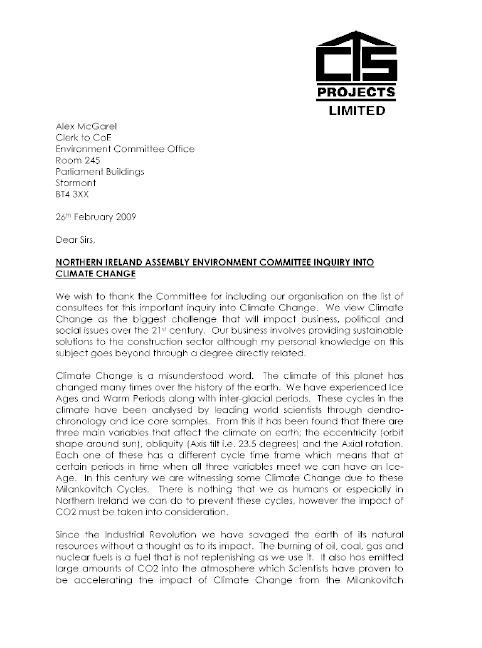
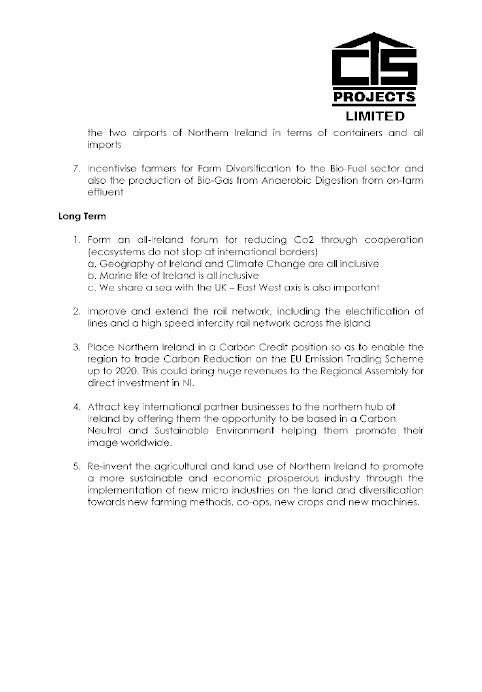

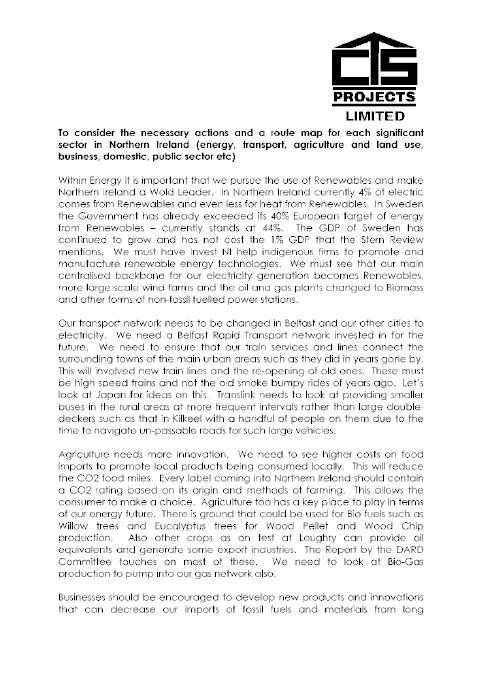


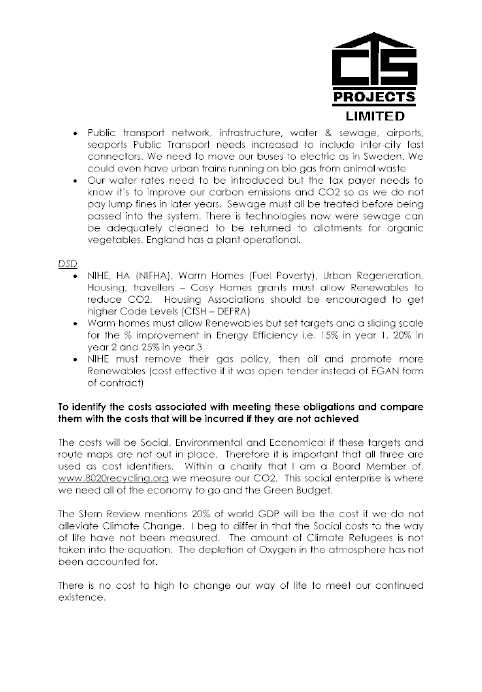
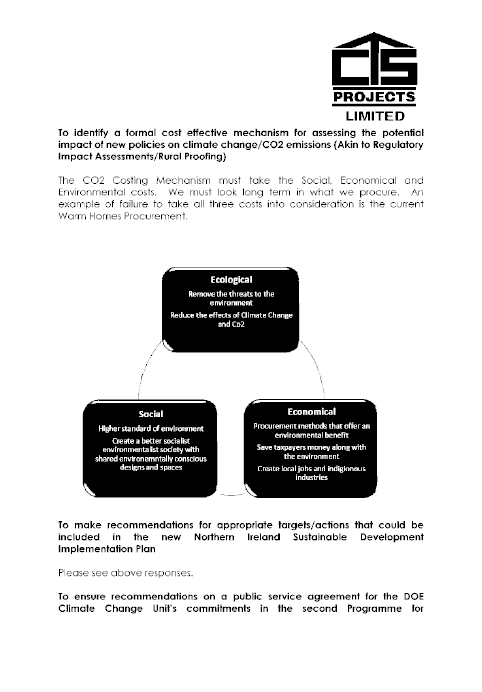


DOE

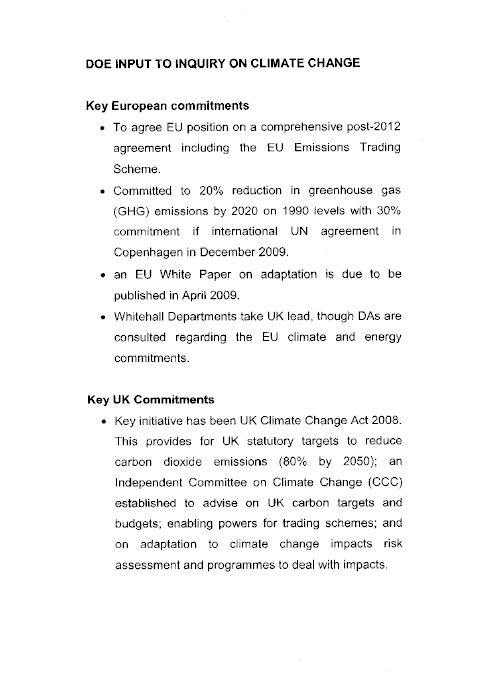
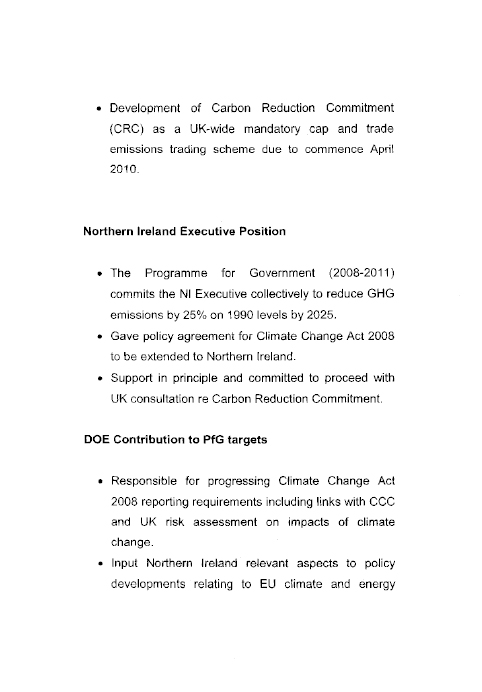
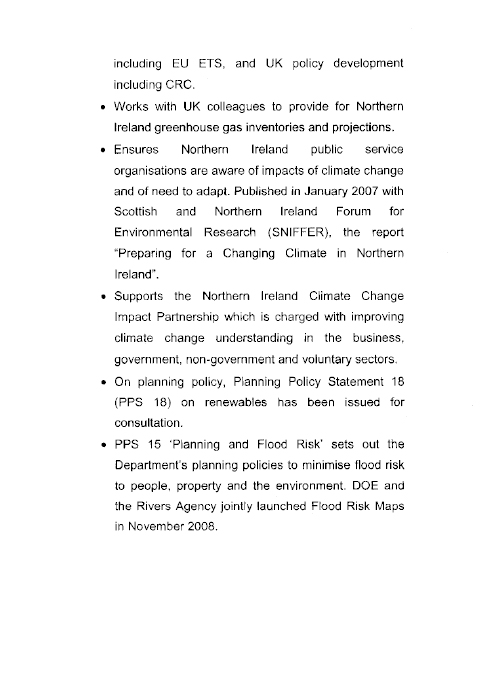
Energy Savings Trust Northern Ireland
Alex McGarel
Clerk to the Committee for the Environment
Environment Committee Office
Room 245
Parliament Buildings
Stormont
BT4 3XX
25 February 2009
Dear Alex,
Northern Ireland Assembly Environment Committee Inquiry into Climate Change
Thank you for giving the Energy Saving Trust the opportunity to respond to the above consultation. Please find enclosed a detailed response.
We hope our response provides a useful contribution to the Committees thinking, and would welcome the opportunity to provide oral evidence.
If you require any further information or would like to discuss this response in further detail please do not hesitate to contact me on 028 9072 6007.
Meanwhile I trust that you find our response helpful.
Yours sincerely
Noel Williams
Head of Energy Saving Trust
Northern Ireland
This is the response of the Energy Saving Trust to the Environment Committee’s inquiry into climate change issued on 6 Feb 09. This response should not be taken as representing the views of individual Energy Saving Trust members.
The Energy Saving Trust was established as part of the Government’s action plan in response to the 1992 Earth Summit, which addressed worldwide concerns on sustainable development issues. We are Northern Ireland (NI) and the UK’s leading organisation working through partnerships towards the sustainable and efficient use of energy by households, communities and the road transport sector.
Our response focuses on the key areas of the Energy Saving Trust’s activities and related issues.
- To identify initial commitments for Northern Ireland that will ensure it plays a fair and proportionate role as part of the UK in meeting climate change targets.
The Energy Saving Trust believes that a regular series of targets needs to be set for the reduction of greenhouse gas emissions in NI and that within this sectoral targets need to be set so it is clear what each sector’s contribution to emissions reductions targets will be.
In terms of setting targets, we note that there are practical issues associated with setting annual targets, in that the ability to meet them can be unduly impacted by changes in weather or economic activity. On the other hand, however, targets over a 5-year timeframe could be too infrequent to adequately assess progress towards meeting climate change targets. It is worthwhile noting that both approaches have been adopted across the UK, with the UK Climate Change Act adopting 5-year carbon budgets, and both the Scottish Climate Change Bill and the Welsh Assembly Government’s draft Climate Change Strategy proposing annual targets. In this context NI might want to consider the option of rolling targets outlined in our response to the UK Climate Change Bill[1], but we note this would add a degree of complexity.
We believe that commitments to ensure that NI ‘plays a fair and proportionate role as part of the UK in meeting climate change targets’ need to be based on a full analysis of the actual and realistic potential for emissions reductions in NI. We believe that the detailed analyses within the recent Committee on Climate Change (CCC)[2] report should be used to guide decisions in NI. However, we note that while it explored the potential for such reductions at a UK-wide level, it did not break down the potential for NI, and we are not aware of any NI-specific work that does this job. Given that the potential for emissions reductions (at least for the household sector) varies considerably across the UK, such NI-specific work will be vital to determine what a ‘fair and proportionate’ contribution from NI would be.
Our views on emissions reduction targets for the household, transport and waste sectors are outlined below.
1. Domestic
When considering targets for the residential sector in NI it is important to take into account:
a)
The fact that it is more cost-effective to deliver carbon savings in the household sector than in any other (see table below).
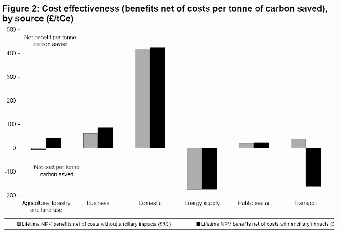
Source:
Synthesis of Climate Change Policy Appraisals, Defra, January 2007, see: http://www.defra.gov.uk/environment/climatechange/uk/ukccp/pdf/synthesisccpolicy-appraisals.pdf
Indeed the findings of the CCC’s analysis[3] highlight that ‘One key feature of the sectors covered, in particular of the residential sector, is that there appears to be scope for significant energy efficiency improvement at a cost to the economy and to individuals which is low, nil, or indeed negative (i.e. where upfront investment would be quickly repaid and give a good return).’
b) The potential for improvements to the housing stock in Northern Ireland.
The potential for the installation of energy efficiency and microgeneration technologies in NI is different to that of the UK as a whole. This is for a range of reasons including the different composition of the housing stock, the proportion of household on and off the gas grid, the historical rate of installations, etc. The Energy Saving Trust’s analysis of the potential for energy efficiency measures in NI (and the other countries of the UK is summarised in table 1 in Annex 1).
c) The conclusions of the CCC[4] and DECC/CLG (outlined in the current Heat and Energy Savings Strategy consultation) that if the UK is to meet its climate change targets then emissions from existing housing will need to be reduced by at least 80 per cent by 2050, and that emission from buildings (by 2050) will be ‘as close to zero as possible’.
d) CCC’s analysis of potential realistic reductions for the household sector and DECC/CLG’s proposed targets (outlined in the current Heat and Energy Savings Strategy consultation), including proposals that by 2015 all lofts and cavity walls should be insulated, where it is practical to do so and that by 2020 seven million homes will have had the opportunity to take up a ‘whole-house’ package of measures going beyond simply insulation, and that by 2030 all buildings will have received such a package.
We note that the above information suggests NI is likely to need to reduce emissions from its housing stock at a different rate than emissions reductions in this sector in the rest of the UK and as such interim percentage reduction targets for emissions in the sector may need to be different than those set for other parts of the UK.
We recommend that the NI Executive undertake more detailed analysis to determine the potential for household energy efficiency and microgeneration measures in NI. This analysis should also take account for actions that can be undertaken at the community level (distributed energy) as well as those that can be undertaken at the individual household level. This analysis should be used to set a challenging, but achievable, target for the residential sector in NI.
2. Road transport
Again, we believe it is important for account to be taken of the CCC’s analysis of potential realistic reductions for the transport sector.
However, in the context of setting targets for the road transport sector in NI it is worthwhile highlighting that there are big wins that can be achieved now from existing infrastructure and technologies. For instance, choosing the lowest carbon vehicle in its class (so the consumer does not have to compromise on utility) can save 25 per cent of CO2 emissions. Driving in the most efficient style (smarter-driving) can save up to 15 per cent of CO2 emissions. Someone who normally drives alone instead choosing to car-share can save at least 50 per cent CO2 (and fuel costs) off their journey, and more than this if they take more than one passenger. Replacing a local car journey with a bus journey can cut emissions by approximately 50 per cent; replacing a long distance car journey with a coach journey can reduce CO2 emissions by 85 per cent and choosing the train over the plane about 65 per cent. Most efficient of all, walking and cycling journeys are zero carbon so any shift to this mode will save 100 per cent CO2. However, it is important not to underestimate the need for investment into low carbon infrastructure such as public transport and walking and cycling to encourage modal shift and behaviour change.
3. Waste
Over the last six months we have been running waste pilots, testing the inclusion of waste into our advice offering. Our activity in this area has been developed in partnership with WRAP (Waste & Resources Action Programme) and has centred on three areas; food waste, home composting and recycling. Four pilots ran during Jun to Sep 08 in London, Wales, North-East England and Northern Ireland. With early positive results including advising over 10,000 consumers on waste between Jun and Oct 08 and early indications showing that waste is a natural fit to the energy advice service, waste advice will be rolled out over the course of 2008/9 to some of the remaining advice centres. An evaluation of the original four pilots will be completed by the end of the financial year 2008/09.
Over the coming year we will be looking in more detail at the potential for waste related carbon savings through using our advice network channel. We look forward to sharing this data with the Committee later in the year.
- To consider the necessary actions and route map for each significant sector in Northern Ireland (energy, transport, agriculture and land use, business, domestic, public sector etc).
1. Domestic
For the domestic sector the key actions that the Energy Saving Trust would like to see are as follows:
- The development of a forward looking strategy for emissions reductions from the housing sector, which includes a long-term of at least 80 per cent by 2050, together with interim targets, for emission reductions from NI’s housing stock.
- A programme of public engagement to help gain buy-in into the technologies and policies required to effect the emissions reductions required.
- The next update of NI Building Regulations will need to extend coverage of triggers for improving the energy performance of existing homes, including extensions, loft conversions, etc. In addition NI ought to adopt the Code for Sustainable Homes or an equivalent mechanism.
- A signal that the recommendations of Energy Performance Certificates will become mandatory by a certain date in the future, say 2015, for home sales, rental, etc.
- A variety of incentives and awareness raising activities, developed around people’s behaviour and the lifetime of their homes, in preparation for eventual mandation.
2. Transport
For the transport sector the key actions the Energy Saving Trust would like to see are as follows:
- The development of a forward looking strategy which includes a long-term target for the reduction of emissions from transport in NI together with interim targets.
- Implementation of measures to reduce transport emissions from driving which should include the promotion of smart-driving (saving 15% CO2), signposting consumers to the lowest carbon vehicles (savings of up to 25% CO2 if every consumer chose the most fuel efficient car for their needs), and car-sharing (can save over 50% CO2 emissions). Our advice centres across the UK offer independent advice on energy saving. In Scotland and England this includes advice on the above issues, as well as modal shift (see below). This advice could and should be extended to NI.
- Implementation of schemes to encourage, a) car sharing which can save over 50% of CO2 emissions and b) modal shift to walking and cycling, which are zero carbon transport modes. Smarter choice measures help people find less costly and less carbon intensive ways to travel. A UK Department for Transport report showed travel planning can reduce car travel by 15% and 25% in peak hours in urban areas.[5]
- Investment in low carbon public transport to ensure attractive, affordable and viable alternatives to travelling by car.
- In the longer term, a commitment to major low carbon infrastructure development (such as electric vehicle re-charging points and/or hydrogen re-fuelling stations) will be necessary if NI is to move towards advanced lower carbon vehicles. This would need to be part of a co-ordinated UK-wide approach.
- Planning can have a major impact on determining how people travel. All new developments should be designed so that they minimise car dependency and maximise low carbon travel options such as walking, cycling, and public transport.
- In Scotland and England the Energy Saving Trust offers free government funded advice to business to reduce the carbon footprint of their fleets. It delivers cuts in CO2 from business travel through cleaner vehicle purchase, efficient driving and reduced travel. And in Scotland the Energy Saving Trust offers free government funded travel planning consultancy for schools, businesses and other organisations. These are services that could be expanded to cover NI.
3. Waste
The NI Executive should work towards ensuring that:
- More people link waste to their carbon footprint, understand the relative contribution of waste to their carbon footprint, and understand how reducing waste can help tackle climate change.
- Consumers understand the importance of following the waste hierarchy: reduce, reuse, recycle and chose/use products that generate the least waste.
The Nl Executive should help facilitate domestic waste minimisation by helping to coordinate the efforts of Councils. They play a key role in making waste minimisation easier for householders, and the current wide range of different services in different areas makes it confusing; people don’t know what they can recycle and where, and don’t understand why they can recycle some things in one area, but not in another.
- To identify the costs associated with meeting these obligations and compare them with the costs that will be incurred if they are not achieved.
We are not aware of any specific analysis that has been undertaken to look specifically at the costs of NI meeting delivering a ‘fair and proportionate’ share of the UK’s climate change targets, and would be surprised if such analysis exists because NI’s appropriate share has yet to be determined. In terms of the costs of delivering improvements to the energy performance of existing buildings it worthwhile noting the findings of the CCC’s analysis,[6] which highlights that ‘One key feature of the sectors covered, in particular of the residential sector, is that there appears to be scope for significant energy efficiency improvement at a cost to the economy and to individuals which is low, nil, or indeed negative (i.e. where upfront investment would be quickly repaid and give a good return).’ It is also our view that additional work needs to be undertaken to look at costs (of improving the housing stock), including exploring marginal capital cost when measures are implemented as part of wider works, capital cost reductions with time and with volume installations etc.
It is also important to note that replacing car journeys by walking, cycling or car sharing can save money for consumers. Driving more efficiently or buying a more fuel efficient car reduces fuel bills, as well as CO2.
- To make recommendations for appropriate targets/actions that could be included in the new Northern Ireland Sustainable Development Implementation Plan.
As noted above we believe that targets should be set for all sectors. We also believe that specific targets for microgeneration, and within this heat generating microgeneration should be set for NI. Long-term, as well as interim targets, should be set. The UK also has a role in meeting European 2020 renewables targets, and as such it is important that targets for the microgeneration and heat generating microgeneration are set for 2020 and are consistent with NI delivering an appropriate share of these targets. In this context we draw the Committee’s attention to a key point that we have raised in recent submissions to the NI Executive, as follows: ‘We are not aware of any NI-specific analysis that provides sufficient detailed analysis to allow an assessment of a) the potential for microgeneration, and in particular heat generating microgeneration, in NI or b) an appropriate target for renewable microgeneration, and in particular heat generating microgeneration for NI[7]. In this context we strongly recommend that DETI undertake further research in this area. The Energy Saving Trust has extensive experience of both managing and steering this type of work.’
Key actions that we believe should be taken in the housing and transport sectors are outlined in our response to the second bullet point above.
Table 1: Potential for energy efficiency measures in NI
| Wales | Scotland | England | Northern Ireland | ||||||
| numbers | as % of all households | numbers | as % of all households | numbers | as % of all households | numbers | as % of all households | ||
| Number of households: | 1,264,000 | 100% | 2,237,000 | 100% | 20,866,000 | 100% | 680,000 | 100% | |
| Insulation potentials: | |||||||||
| 250,000 | 20% | 600,000 | 27% | 6,500,000 | 31% | 70,000 | 10% | ||
| Solid walled homes (assume all uninsulated): | 430,000 | 34% | 500,000 | 22% | 6,300,000 | 30% | - All completely uninsulated solid-wall homes; includes some homes with extensions with filled cavity walls | 130,000 | 19% |
| Under-insulated lofts: | |||||||||
| - Virgin | 3,000 | 0.2% | 100,000 | 4% | 400,000 | 1.9% | - Virgin | 30,000 | 4.4% |
| - 100mm or less | 537,000 | 42% | 980,000 | 44% | 10,500,000 | 50.3% | - Less than 100mm | 160,000 | 24% |
| Double glazing: | |||||||||
| - None | 160,000 | 13% | 260,000 | 12% | 4,900,000 | 23% | 95,000 | 14% | |
| - Some | 130,000 | 10% | 40,000 | 2% | 3,900,000 | 19% | 126,000 | 19% | |
Please note that the categories used in the table above differ slightly than those for the other countries of the UK. This reflects the categories used in the NI house condition survey.
[1] See: http://www.energysavingtrust.org.uk/uploads/documents/aboutest/Defra_Climate_Change_Bill_120607.pdf
[2] See: http://www.theccc.org.uk/
[3] See: http://www.theccc.org.uk/reports/
[4] CCC outline the potential (both technical and realistic) for the reduction in emissions across the UK, specifically that by 2020: In the residential sector there is technical potential to reduce emissions by almost 40 MtCO2, over half of which is through negative cost energy efficiency improvements and lifestyle changes, and with much of the remainder costing less than our forecast carbon price of £40/tCO2. Our assessment of realistic potential suggests that a reduction of 9-18 MtCO2 could be achieved from existing buildings, with an additional 4 MtCO2 from new buildings. And In addition the development of renewable heat sources (mainly biomass) and of microgeneration (solar photovoltaic) could save up to 65 MtCO2 but at a much higher cost per tonne saved. Our assessment of realistic potential suggests a much lower reduction of up to 10 MtCO2.’.
[5]Smarter choices – changing the way we travel, Cairns et al, DfT 2004
[6] See: http://www.theccc.org.uk/reports/
[7] While relevant analysis exists at a GB or UK level, given the substantial differences that exist between NI and the rest of the UK, it would make little sense to simply pro-rata suggested GB targets on the basis of, for example NI’s population, as the potential for the installation of such technologies in NI is likely to be considerably different. Indeed, we believe that that potential for such technologies is likely to be greater in NI than in other parts of the UK because substantial parts of NI are off the gas network.
Federation of Small Businesses
Northern Ireland Policy Unit
Federation of Small Businesses
Cathedral Chambers
143 Royal Avenue
Belfast
BT1 1FH
Environment Committee Office
Room 245
Parliament Buildings
Stormont
BT4 3XX
www.fsb.org.uk
20th February 2009
Re: Committee for the Environment – Inquiry into Climate Change
The Federation of Small Businesses is Northern Ireland’s largest business organisation with almost 8000 members drawn from across all sectors of industry, and over 210,000 members throughout the UK.
The Federation lobbies decision makers to create a better business environment and welcomes this opportunity to input into the Northern Ireland Assembly Environment Committee Inquiry into Climate Change.
We trust that you will find our comments helpful and that they will be taken into consideration. The FSB is willing for this submission to be placed in the public domain. We would appreciate being kept apprised of further developments.
Regards
Wilfred Mitchell OBE
Northern Ireland Policy Chairman
Introduction
The FSB is supportive of measures to protect the environment and human health and encourage resource efficiency; however environmental legislation to date has continued to apply a ‘one-size fits all’ approach which presents many barriers for small businesses in their efforts to seek effective environmental solutions.
The current debates on climate change are very academic in nature and tend to focus on large businesses or householders. There must be a change in this focus, taking into the account the dominant role (98%) that small businesses play in the Northern Ireland economy.
Impact on Small Businesses
Future policy on climate change will have a significant impact on small businesses. Small businesses behave in a similar way to householders, in terms of expertise levels. The energy market remains a difficult one for small businesses and micro-businesses in particular, and their perception is that the situation will only get mor difficult for them, in terms of cost, regulation, and the potential for legal penalties, and that this could have a knock-on effect on their ability to survive.
Professor Rob Baldwin of the LSE found that the burden of small businesses from regulation is five times higher than that of large businesses (employing 250 or more). As with all types of legislation and red tape, the FSB calls for a reduction in regulation, not an increase, and where possible, simplification and clear guidelines.
The long term risks to businesses not engaging in the climate change programme include increased costs and loss of revenue. However, climate change will also provide new markets and technologies for many small businesses. Energy prices are a particular and immediate concern. However, businesses who understand the issues surrounding climate change will be better equipped to maximise opportunities and mitigate negative impacts/risks.
A Mori survey in 2005 found that 87% of SMEs were of the view that climate change offered considerable opportunities to business yet only 19% saw climate change as a significant opportunity for their own business.
Lack of resources and awareness remain a barrier to small businesses exploring ways to mitigate rising energy costs. They know they have to do something but are unclear about the next steps.
The FSB has found that lack of clear advice and information, together with the constraints faced by SMEs has prevented many small businesses from taking steps to improve energy efficiency. A recent survey found that 60% of SMEs have taken some steps to increase energy efficiency (e.g. changes to heating and lighting) but notably 40% have taken no action. For small companies, technical problems and the cost of changing production processes are barriers to increasing efficiency but so too is a lack of quality information and advice.
In a recent FSB survey on Corporate Social Responsibility (2008), well over a third of respondents reported that they engaged in energy efficiency measures. Approximately 70% of those that provided information on energy efficiency did the following:
- Utilised low energy light bulbs
- Invested in low energy lighting
- Turned of PC/lights etc
- Changed heating systems
- Minimised electrical usage
- Reduced temperature in office
Engaging SMEs in the climate change debate will require a major shift in this perception of the opportunities and also the risks of climate change.
Environmental Taxation
The FSB is opposed to environmental taxation, which burden small businesses disproportionately. We would highlight the Climate Change Levy in particular, which FSB research (The Climate Change Levy – ‘Another Cost for Small Business’ 2002) demonstrated did little to improve energy efficiency among small businesses (and had no measurable effect on environmental behaviour).
Recommendations
Government initiatives to date have had a negligible impact on small businesses as FSB research demonstrates.
To be effective, the Northern Ireland Assembly needs to raise awareness of the requirements and objectives of legislation and to explore ways to incentivise support the small business sector in relation to environmental issues.
- A clear regulatory framework will reduce uncertainty but the particular position of small businesses must be taken into account at the outset.
- A practical, joined-up approach to climate change policy, including consideration of planning policy, is required. The technical nature of the language associated with debates on climate change is inaccessible to the average small business owner.
- Legislation/regulation to be applied proportionately and take into consideration the particular position of small businesses.
- Investment in technical innovation, capital and financial incentives on energy efficiency for small businesses would be an important contribution to these targets.
- Reduction of VAT on green energy sources to encourage take-up among small businesses.
- Present both the risks and opportunities tackling climate change and what it could mean to small businesses.
- Statutory authorities, together with suppliers should promote energy efficiency measures that SMEs can easily apply to their businesses. This should be developed in tandem with practical support and clear examples of how small businesses can maintain and improve profitability through energy savings.
Friends of the Earth
1. Introduction
1.1. Friends of the Earth would like to thank the Environment Committee for holding this inquiry into climate change and for inviting us to make a submission. We are heartened by the fact the Committee has accepted the reality of climate change and the inquiry does not include an exploration of the science or a call for a public debate. The debate is settled and further debating the issue merely postpones action when action is urgently needed.
1.2. Friends of the Earth believes the single most important action the Committee can take is to press the Executive to bring forward a Northern Ireland Climate Change Bill. While the Assembly has opted into the UK Climate Change Act, the targets in the Act are not disaggregated for the devolved administrations and the Committee on Climate Change has no authority to enforce the targets. For Northern Ireland to play its part fully in reducing greenhouse gas emissions, therefore, legally binding targets should be adopted in order to provide a clear for businesses, individuals and future Assemblies.
2. The terms of reference
To identify initial commitments for Northern Ireland that will ensure it plays a fair and proportionate role as part of the UK in meeting climate change targets.
2.1. The global fair share of per capita carbon emissions has been calculated at about 1.65 tonnes per year. Northern Ireland’s per capita emissions are about 13 tonnes per year, compared to a UK average of just under 10.5 tonnes. Plainly Northern Ireland is not currently playing a fair and proportionate role, either globally or as part of the UK.
2.2. There is scientific consensus that in order to prevent catastrophic climate change temperature rise must be limited to no more than 2oC above pre-industrial levels which corresponds to greenhouse gas concentrations of about 450 part per million by volume of CO2 equivalent (ppmve). Current concentrations are around 430 ppmve.
2.3. Furthermore, research from the Tyndall Centre for Climate Change Research suggests that if current emission trends continue a global average temperature rise of around 4oC is likely with a 6oC rise being a distinct possibility. In the distant past temperature rises of this magnitude were associated with mass extinctions. Needless to say it is unlikely civilization as we know could continue under such circumstances.
2.4. The Committee on Climate Change recommended, and the UK Government accepted, a reduction of 80 per cent on 1990 emissions levels by 2050.
2.5. In order for Northern Ireland to do its fair share in meeting the targets set out in the Climate Change Act the Executive should introduce a Northern Ireland specific Climate Change Bill. Such a Bill should follow the precedent set in the UK Act and include a legally binding target to reduce our carbon dioxide emissions by 80 per cent from 1990 levels by 2050. This is the minimum requirement that will be necessary to play our part in the global attempt to avoid dangerous climate change.
2.6. To ensure we achieve an immediate and sustained decline in Northern Ireland’s greenhouse gas emissions the Executive should set an intermediate target for emissions in 2020, a series of legally binding 5 year carbon budgets and an annual carbon reduction target at an average of at least 3 per cent per year. Combining indicative annual milestones with the legal framework of the budget periods should offer flexibility but with a firm steer.
2.7. The Committee on Climate Change’s role in Northern Ireland should be enhanced to facilitate the setting of Northern Ireland specific budgets and action plans. The Committee on Climate Change’s reports on progress and action plans to achieve the targets should be delivered to the Assembly and responded to by the Executive.
2.8. The Committee on Climate Change should help ensure co-ordination of emissions reduction efforts across the UK. Carbon emissions in Northern Ireland and the Republic of Ireland are closely interlinked. Therefore, provisions to enable joint achievement of emissions reduction goals should be made.
2.9. All plans, programmes and policies should be subject to full Climate Impact Assessments before implementation. If they do not contribute to carbon reduce policies they should be redesigned.
2.10. A supplement to Planning Policy Statement 1for England and Wales was published in 2007 which sets out the principles that the Government should observe in formulating planning policies, making development plans and exercising its development powers in order to tackle climate change. A Northern Ireland planning Policy Statement on climate change would put tackling climate change at the heart of Assembly policy and provide a clear steer to both planners and energy companies.
To consider the necessary actions and a route map for each significant sector in Northern Ireland (energy, transport, agriculture and land use, business, domestic, public sector etc).
2.11. The Committee on Climate Change’s statutory duty to Northern Ireland includes:
‘To provide advice on the sectors of the economy in which there are particular opportunities for contributions to be made towards meeting the budgets through reductions in emissions.’
2.12. The Committee on Climate Change’s first report was released in December 2008. It includes an analysis of what opportunities exist for making emission reductions in Northern Ireland. It states Northern Ireland could contribute emissions reductions of over 2MtCO2e (Million tonnes of carbon dioxide equivalent) in 2020:
Emissions from buildings and industry could be reduced by up to 1 MTCO2 in 2020 by using energy more efficiently;
More efficient vehicles and new transport fuels could deliver reductions of up to 1 MTCO2 in 2020;
Emissions from agriculture, land use and forestry and waste management sectors could be reduced by up to 0.5 MtCO2e in 2020.
2.13. The actions outlined above do not go far enough to keep Northern Ireland on target to achieve its own 80 per cent emissions reduction target. The Committee on Climate Change’s role in Northern Ireland should be enhanced to facilitate the setting of Northern Ireland specific budgets and action plans.
2.14. Energy: The current electricity generation system wastes about ? of the energy produced, either as waste heat or through transmission losses. A decentralised grid using small-scale generators close to the end user minimises transmission losses and also enables the waste heat to be utilised. Such a decentralised grid should be based around small-scale Combined Heat and Power.
2.15. Micro-renewables, such as solar thermal, heat pumps and biomass burners, should constitute a significant element of a decentralised network. The high upfront costs of installing micro-renewables mean uptake is likely to be small. To facilitate the adoption of micro-renewables the Reconnect grants should be re-instated.
2.16. Northern Ireland has some of the best renewable energy resources in Europe and they are currently under-utilised. On-shore wind is well developed, though there is room for further development, but off-shore wind remains undeveloped and marine technologies are still in the test stage. A sustainable energy infrastructure should include a range of renewable technologies sited to maximise exploitation of the resource. By using a range of renewables, intermittency problems can be eliminated.
2.17. It is likely that a greater proportion of our energy needs will be met by electricity as fossil fuel use for space and water heating decreases. It is important, therefore, that the inefficiency inherent in a large-scale centralised system are minimised and greater use is made of decentralised grids. There is also potential for using off-peak renewables for generating electric heat for storage, or for recharging electric vehicles. The use of off-peak electricity should therefore be encouraged and the Department of Enterprise, Trade and Investment’s target of reducing electricity use by 1 per cent annually until 2012 could be problematic unless it is targeted at fossil fuel derived electricity.
2.18. A sustainable energy infrastructure will require significant new development in decentralised grid and renewable technologies and effective use of the planning system will be required to facilitate the necessary level of development. A Planning Policy Statement on climate change would create the necessary policy context and place action on climate change at the heart of planning policy.
2.19. It is regrettable that the proposal to amend Building Regulations to include mandatory renewables for new build developments was dropped by the Department of Finance and Personnel. Such amendments would provide clear guidance to the building sector and facilitate the development of renewable energy technologies.
2.20. The Energy Act, which became law in November 2008, includes a provision to introduce a feed-in tariff (FIT) for renewable electricity and renewable heat incentives. These, if implemented correctly, will give a long-term guaranteed payment to homes, businesses and communities for installing renewable electricity and heat technologies. Such a provision should be extended to Northern Ireland. A similar system operates in parts of Europe the and, more importantly, in Republic of Ireland. If the Single Electricity Market is to function there must be compatible incentive systems north and south of the border.
2.21. It is likely that a European supergrid will be developed to facilitate greater use of renewables and to enable sharing of renewable energy resources. For example, a supergrid could include German photovoltaics, Icelandic geothermal and Spanish concentrated solar. Enhanced electricity interconnection would enable Northern Ireland to tap into, and contribute to, a European supergrid.
2.22. Transport: investment in public transport is essential if cuts in transport emissions are to be realised. Other measures to encourage a modal shift from the private care include walking and cycling. The balance of transport is currently about 80 per cent roads and 20 per cent for other measures. Such a balance is likely to lead to higher transport emissions rather than achieving cuts.
2.23. Emissions from transport are closely linked to land-use planning. How our villages, towns and cities are planned will dictate what method of transport will be most convenient, and most used. A PPS on climate change would put climate considerations at the heart of the planning system.
2.24. Electric vehicles offer the potential for reducing carbon emissions associated with transport, but only if electricity generation is de-carbonised. Assuming there will be a significant increase in the use of renewables, greater efficiency in electricity generation and a conversion to gas for large power-stations still using fossil fuels then electric vehicles will be a viable low-carbon option.
2.25. Agriculture: modern food production is very resource and energy intensive. The single most significant source of emissions is the production of chemicals such as fertilisers and pesticides. Organic and other low input farming methods have significantly lower carbon emissions associated with them. They also tend to be more labour intensive than conventional agriculture so there are also job creation opportunities with low input farming.
2.26. A focus upon the localisation of food and farming implies the development of local food economies. Local food economies emphasise the importance of shorter, less centralised food chains, and subsequently lower emissions, involving much closer and greater contact between farmers and the consumers, processors, retailers and caterers that they serve. They deliver an integrated suite of benefits and are unique as agents of sustainable development by occupying a point of convergence between four main issues – economic development and regeneration; environment and climate change; social cohesion and community development; and health.
2.27. Meat and dairy production has a particularly large environmental footprint. Intensive farming methods in Europe, which rely on high-protein animal feeds, have created a global food chain in which Northern Ireland poultry, pigs and cattle depend on feed crops from the other side of the world. The livestock sector is responsible for an estimated 18 per cent of global greenhouse gas emissions and deforestation is a significant source. Reducing the impact of the livestock sector is critical if we are to prevent dangerous climate change. Friends of the Earth is not advocating a vegetarian diet, but a reduction in meat consumption must be part of any coherent plan to tackle climate change.
2.28. It should be possible to satisfy the twin demands of agricultural waste management and greenhouse gas reductions through the use of anaerobic digestion (AD) of biodegradable waste linked to small-scale combined heat and power (CHP). Such a combination can vary in size from very small on-farm units to larger units suitable for food processing plants.
2.29. Business: According to the Carbon Trust report Climate Change – a business revolution report, implementing measures which are compatible with the need to tackle climate change has the potential to increase a company value by up to 80 per cent. Conversely, failure to position itself for a low-carbon future could devalue a company by 65 per cent. Saving can be made in energy efficiency in much the same way as for the domestic sector. In addition, industry should be encouraged to invest in modern, efficient motors.
2.30. The shift to a low-carbon economy is likely to create the environment in which low-carbon businesses succeed at the expense of inflexible, high-carbon industries. The biggest winner is likely to be the building insulation industry.
2.31. There is much scope for the development of businesses designing, constructing and fitting green technologies. Harland and Wolff may have missed the initial phase of wind power development but are now assembling turbines and are developing wave power devices. The Assembly should actively encourage the development of green businesses.
2.32. Micro-renewables offer businesses the opportunity to cut energy bills and, if Feed-in Tariffs are extended to Northern Ireland, to make additional money by supply excess electricity to the grid. The Energy Act, which became law in November 2008, includes a provision to introduce a feed-in tariff (FIT) for renewable electricity and renewable heat incentives. Such a provision should be extended to Northern Ireland. A similar system operates in parts of Europe and, more importantly, in the Republic of Ireland. If the Single Electricity Market is to function there must be compatible incentive systems north and south of the border.
2.33. Domestic: Energy efficiency is the single most cost effective way of reducing domestic carbon emissions. There is great potential to bring Northern Ireland’s housing stock up to very high standards of energy efficiency through insulation, use of efficient appliances and simple lifestyle changes. The average SAP rating in Northern Ireland’s housing stock is 50 points out of a possible 100. The technology and techniques already exist which would enable significant efficiency gains to be made. The Carbon Trust Northern Ireland Vision Study (2005) concluded it is possible to achieve 60 per cent reduction in emissions from households by 2050 with energy efficiency being key component. High upfront costs can discourage home-owners from fitting insulation materials though. A wholly or partially funded programme of improving energy efficiency should be introduced. Such a programme would save people money, create good quality skilled and semi-skilled jobs and help to stimulate the market in energy efficiency measures.
2.34. Micro-renewables, such as solar thermal, heat pumps and biomass burners, should constitute a significant element of a decentralised network. As with energy efficiency, the high upfront costs of installing micro-renewables mean uptake is likely to be small. To facilitate the adoption of micro-renewables the Reconnect grants should be re-instated.
2.35. Householders and landlords should be encouraged to install key-pad electricity meters. One in four already use the NIE keypad meter, supplied free by the utility, for prepayment purposes. But the meter also allows consumption to be monitored. Households with keypads use 5 per cent less electricity on average than those without.
2.36. It is regrettable that the proposal to amend Building Regulations to include mandatory renewables for new build developments was dropped. Such amendments would provide clear guidance to the building sector and facilitate the development of renewable energy technologies. Although this is not an area the Environment Committee has responsibility for, it should recommend the proposed amendments be adopted.
2.37. Public sector: the Assembly could be showing leadership and stimulating the market by improving the energy performance of the public sector. The civil service estate has a target to be carbon neutral by 2015. This target should be met through tangible carbon reduction measures such as insulation, micro-renewables and behaviour changes rather than through offsetting schemes. In addition, the target should be extended to the entire public sector.
2.38. Public sector buildings are often large traffic generators. The Stormont estate, for example, has thousands of visitors each day and most come by car. Public transport provision to the estate is infrequent and free car-parking makes driving an attractive option. The Assembly should encourage public servants to use sustainable means of transport such as public transport, walking and cycling. Remove free car-parking spaces along with enhanced public transport would facilitate such a shift.
To identify the costs associated with meeting these obligations and compare them with the costs that will be incurred if they are not achieved.
2.39. The Stern Review calculated that the dangers of unabated climate change would be equivalent to at least 5 per cent of GDP each year. However, when more recent scientific evidence is included in the models, the Review estimates that the dangers could be equivalent to 20 per cent of GDP or more. In contrast, the costs of action to reduce greenhouse gas emissions to avoid the worst impacts of climate change can be limited to around 1 per cent of global GDP each year. The central message is that reducing emissions today will make us better off in the future: one model predicts benefits of up to $2.5 trillion each year if the world shifts to a low carbon path.
2.40. The renewable sector in Germany supports 170,000 people and existing German government support measures promoting renewable energy could create 130,000 new jobs by 2020 according to the German environment ministry.
2.41. The Prime Minister stated that the overall added value of the low carbon energy sector by 2050 could be as high as $3 trillion per year worldwide and that it could employ more than 25 million people.
2.42. The Carbon Trust estimates that more than 70,000 jobs could be created in the UK by investing in and developing offshore wind technology. Action Renewables estimate that almost 6,000 short term and 400 long term jobs could be sustained in Northern Ireland, exclusively by developing renewable energy within the region.
2.43. Government should see investment in a low carbon future as a way to stimulate the local economy, as recommended in the New Economics Foundation’s Green New Deal report. President Obama has already established a plan to kick start the economy which includes significant investment in green technologies. The move to renewable fuels may help develop industries that will provide economic opportunities and jobs. Given the huge potential that exists around our shores for wind power there are sound economic and environmental reasons for ensuring that a significant proportion of these jobs are developed in Northern Ireland.
2.44. The SNIFFER report on the impacts of climate change on Northern Ireland identified a number of direct effects, mostly negative, on human health, the economy, natural habitats and water resources, for example, the extent of flood risk to existing settlements remains unquantified compared with the situation in Great Britain.
To identify a formal cost effective mechanism for assessing the potential impact of new policies on climate change / CO 2 emissions. (Akin to Regulatory Impact Assessments/Rural Proofing).
2.45. All plans, programmes and policies should be subject to strict Climate Change Impact Assessments to determine their contribution to or impact on achieving carbon budgets. The process should be initiated at the start of policy design to maximise outcomes and minimise costs and would be similar to equality screening.
2.46. The Committee on Climate Change’s role in Northern Ireland should be enhanced to facilitate the setting of Northern Ireland specific budgets and action plans: sharing this resource with the rest of the UK should help minimise costs.
To make recommendations for appropriate targets/actions that could be included in the new Northern Ireland Sustainable Development Implementation Plan.
2.47. The key climate targets that the Sustainable Development Strategy should deliver are those identified in a future Northern Ireland Climate Bill.
2.48. The Sustainable Development Strategy should also help deliver the recommendations from the Committee on Climate Change.
To make recommendations on a public service agreement for the DOE Climate Change Unit’s commitments in the second Programme for Government that will ensure Northern Ireland will meet its climate change obligations.
2.49. A public service agreement should be drafted for the Department of the Environment which would include a commitment to provide information and support to the other departments to help deliver the targets set in a Northern Ireland Climate Change Act and in the carbon budgets.
2.50. Specific responsibilities to deliver the targets set in the Climate Act and in the carbon budgets should be identified in public service agreements for each Northern Ireland department.
2.51. To consider what secondary legislation raising powers within the UK Climate Change Act would contribute to Northern Ireland’s commitment to the UK Climate Change Act.
2.52. The Northern Ireland Assembly should introduce its own primary legislation in the form of a Climate Change Bill with binding carbon dioxide gas reduction target of at 80 per cent on 1990 levels by 2050; 5 year carbon budgets and an annual carbon reduction target at an average of at least 3 per cent per year.
To express views on if and how the Assembly might conduct more effective scrutiny of climate change responsibilities across all relevant departments.
2.53. The Assembly should consider concentrating climate change related responsibilities in one department in a similar way to how the UK Government created the Department for Energy and Climate Change.
2.54. The Environment Committee should share responsibility to scrutinise progress towards achieving the targets in the Act and within budgets with all other departments.
2.55. The ability of the Committees and the Assembly as a whole to scrutinise progress will be greatly enhanced by ensuring the Committee on Climate Change report to the Executive and the Assembly and that the Executive respond to their reports in the Assembly.
Greener Horizon Films Ltd
request to provide oral evidence
From: McCann, Sean
Sent: 27 February 2009 09:00
To: Long, William
Subject: FW: Gobal warming enquiry
Attachments: Ann McElhinney bio.doc; Phelim McAleer bio.doc
From: ann mcelhinney [mailto:annmcelhinney@gmail.com]
Sent: 26 February 2009 18:44
To: +Comm. Environment Public Email
Subject: Gobal warming enquiry
Dear Sir/Madam
We are writing to you to suggest that we should speak to your committee’s enquiry on Global Warming.
We have been approached by a number of MLAs who believe our research would be useful to your committee.
We are a Northern Ireland based film production company who have just completed Not Evil Just Wrong, a documentary on Global Warming which in due to be released in up to 400 US cinemas in the summer.
We have investigated the issue for two years and have given interviews on the topic on the BBC, RTE, ABC, CBC (Canada) and have toured Australia, Ghana and Bulgaria looking at the financial cost of extreme environmentalism.
Our documentary concentrates on the cost of Global Warming legislation on working families, those on fixed or low incomes and the people of the third world who need industrial development to rise out of poverty.
You can view the trailer of our documentay here
http://www.youtube.com/watch?v=sHMOEVRysWE
We have attached our bios.
Thank you
Ann McElhinney
Phelim McAleer
Greener Horizon Films Ltd
29 Coolnagard Grove
Omagh, Co.Tyrone,
United Kingdom
BT78 1AW
+ 353 86 209 2942 Cell Ireland)
Visit the website www.noteviljustwrong.com
annmcelhinney@noteviljustwrong.com
Watch the Trailer of Not Evil Just Wrong here
http://www.youtube.com/watch?v=sHMOEVRysWE
Submission from Helena Rafferty


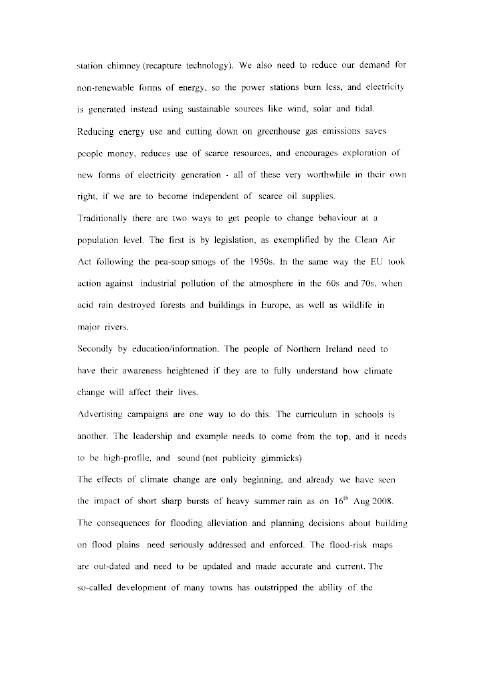
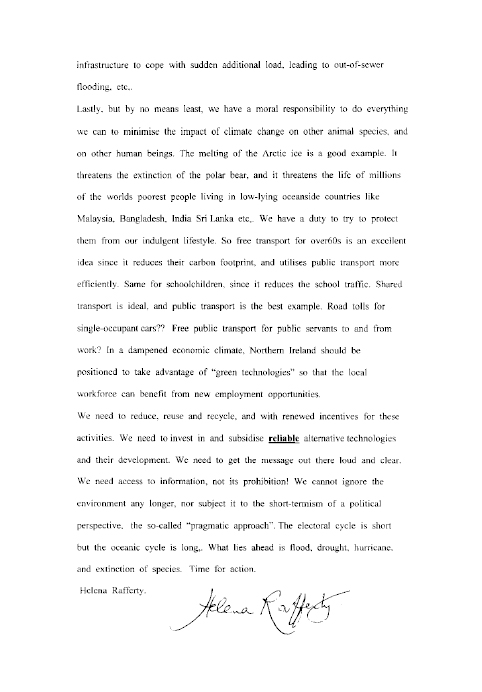
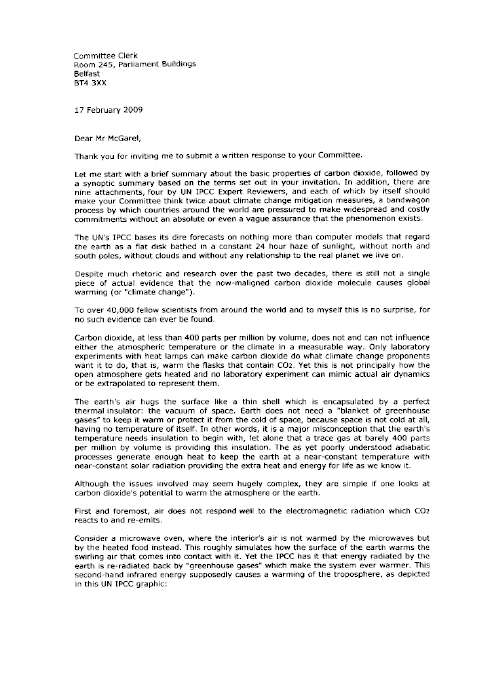
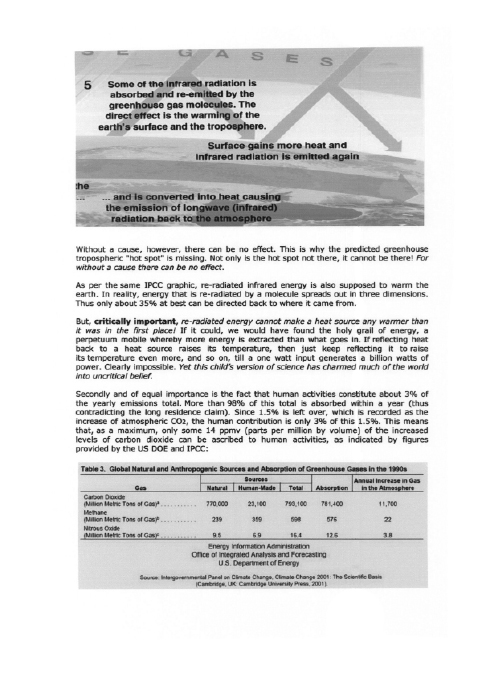

Submission from Hans Schreuder
re Climate Change Inquiry
From: McCann, Sean
Sent: 10 February 2009 08:12
To: Long, William
Cc: McGarel, Alex
Subject: FW: Northern Ireland Environment Committee Climate Change Inquiry
From: Hans IP [mailto:hans@ips-pix.biz]
Sent: 09 February 2009 22:07
To: McCann, Sean
Subject: Re: Northern Ireland Environment Committee Climate Change Inquiry
Sean,
Earlier than planned, but due to your NI Minister for the Environment, Sammy Wilson, being attacked for standing up for the truth, I hereby send you the first draft of my Submission - for the sole purpose of passing it along to Sammy Wilson.
Please allow me to reserve the right to change the final Submission, as I may wish to include further up-to-date scientific papers, which are coming out almost every day now.
The days of alarmism are over and Sammy Wilson needs all the support he can get.
Kind regards,
Hans Schreuder
First Draft Submission - For the specific attention of Sammy Wilson, Minister for the Environment
Committee Clerk
Room 245, Parliament Buildings
Belfast
BT4 3XX
For the attention of Sean McCann, Environment Committee Staff
Dear Sean,
Thank you for inviting me to comment to your Committee.
I will start with a brief summary of the basics of carbon dioxide’s properties, then follow with a synoptic summary based on the terms set out within the invitation. In addition, you will find six attachments, three by UN IPCC Expert Reviewers, and each of which by itself should make your Committee think twice about climate change mitigation measures, a bandwagon process by which countries around the world are pressured to make widespread and costly commitments without an absolute or even a vague assurance that the phenomenon exists.
The UN’s IPCC bases its dire forecasts on nothing more than computer models that regard the earth as a flat disk bathed in a 24 hour haze of sunlight, without north and south poles, without clouds and without any relationship to the real planet we live on.
Despite much rhetoric and research over the past two decades, there is still not a single piece of actual evidence that the now-maligned carbon dioxide molecule causes global warming (or “climate change").
To over 40,000 fellow scientists from around the world and to myself this is no surprise, for no such evidence can ever be found.
Carbon dioxide, at less than 400 parts per million by volume, does not and can not influence either the atmospheric temperature or climate in a measurable way. Only laboratory experiments with heat lamps can make carbon dioxide do what climate change proponents want it to do, that is, warm the flasks that contain CO2. Yet this is not principally how the open atmosphere gets heated and no laboratory experiment can mimic actual air dynamics or be extrapolated to represent them.
The earth’s air hugs the surface like a thin shell and is encapsulated by a perfect insulator: the vacuum of space. Earth does not need a “blanket" of special gases to keep it warm or “protect" it from the cold of space, because space is not cold at all, having no temperature of itself. In other words, it is a major misconception that the earth’s temperature needs insulation to begin with, let alone that a trace gas is providing this insulation.
Although the issues involved may seem hugely complex, they are simple if one looks at carbon dioxide’s potential to warm the atmosphere.
First and foremost, air does not respond well to the electromagnetic radiation which CO2 reacts to and re-emits.
Consider a microwave oven, where the interior’s air is not warmed by the microwaves but by the heated food instead. This roughly simulates how the surface of the earth warms the swirling air that comes into contact with it. Yet the IPCC has it that energy radiated by the earth is re-radiated back by “greenhouse gases" which make the system even hotter. This second-hand infrared energy supposedly causes a warming of the troposphere, as depicted in this UN IPCC graphic:
Without a cause, however, there can be no effect. This is why the predicted greenhouse tropospheric “hot spot" is missing. Not only is the hot spot not there, it cannot be there! For without a cause there can be no effect.
As per the IPCC graphic above, re-radiated infrared energy is also supposed to warm the earth. In reality, energy that is re-radiated by a molecule spreads out in three dimensions. Thus only about 35% at best can be directed back to where it came from. But, critically important, re-radiated energy cannot make a heat source any warmer than it was in the first place! If it could, we would have found the holy grail of energy, a perpetuum mobile whereby more energy is extracted than what goes in. If reflecting heat back to a heat source raises its temperature, then just keep reflecting it to raise its temperature even more, and so on, till a one watt input generates a billion watts of power. Clearly impossible. Yet this child’s version of science has charmed much of the world into uncritical belief.
Secondly and of equal importance is the fact that human activities constitute about 3% of the yearly emissions total. More than 98% of this total is absorbed within a year (thus contradicting the long residence claim). Since 1.5% is left over, which is recorded as the increase of atmospheric CO2, the human contribution is only 3% of this 1.5%. This means that, as a maximum, only some 14 ppmv (parts per million by volume) of the increased levels of carbon dioxide can be ascribed to human activities, as indicated by figures provided by the US DOE and IPCC:
Third is the inconvenient fact that the world hasn’t been warming for a decade, anyway, despite an ever climbing carbon dioxide level.
From this short summary, coupled with the attachments below, I sincerely urge your Committee to demand positive proof from alarmist scientists to indicate that it is carbon dioxide and nothing else that has ever - now or in the past - caused any warming of the earth.
Actual evidence needs to be put on the table, not computer model outputs or presumptively-inferred evidence. Glaciers are not melting in alarming fashion, the Greenland icecap is not collapsing and the Arctic is not about to become ice-free. Neither is the Antarctic melting away and sea levels are not rising any faster than they have done for the past 11,000 years.
Alarmist predictions have been decisively disproved over the past decade, as global temperatures have been going down instead of ever up as had been so widely predicted by the constant tweaking of climate models. Based on the behaviour of the one and only true climate driver, our sun, your Committee as well as the UK Government would be better advised to prepare for longer, colder winters and shorter growing seasons
With respect,
Hans Schreuder
www.ilovemycarbondioxide.com/carbondioxide.html
Synoptic summary based on the terms of reference as set out in the stakeholder invitation.
To identify initial commitments for Northern Ireland that will ensure it plays a fair and proportionate role as part of the UK in meeting climate change targets.
Climate change is far beyond the realm of humans to control and nothing humans do will change the climate from its natural and cyclical behaviour, which right now appears to be heading towards a lengthy period of colder winters and shorter growing seasons.
To consider the necessary actions and a route map for each significant sector in Northern Ireland (energy, transport, agriculture and land use, business, domestic, public sector etc)
No amount of action in whatever sector of the NI economy will have even the slightest influence over the climate, not in NI or anywhere in the world, even if the entire world co-operated with whatever the NI Government would want to implement.
To identify the costs associated with meeting these obligations and compare them with the costs that will be incurred if they are not achieved.
There will be huge costs associated with any kind of climate change directive with no benefits to or from the climate on any timescale.
To identify a formal cost effective mechanism for assessing the potential impact of new policies on climate change / CO2 emissions. (Akin to Regulatory Impact Assessments/Rural Proofing)
Carbon dioxide does not have any influence over the climate. Despite billions of dollars spent on research, not one single piece of actual observational evidence has ever been presented to categorically indicate that it does. This is because no such evidence exists.
To make recommendations for appropriate targets/actions that could be included in the new Northern Ireland Sustainable Development Implementation Plan.
Without knowing the details of the Plan referred to here, commenting would not be appropriate, other than to say that wind farms are an unreliable and highly inefficient source of energy requiring constant maintenance and destroying the habitats in which they are constructed.
To make recommendations on a public service agreement for the DOE Climate Change Unit’s commitments in the second Programme for Government that will ensure Northern Ireland will meet its climate change obligations.
The entire issue of climate change obligations and legislation should be scrapped. Nothing at all that any government could possibly promote will have the slightest effect on the global climate. Issues of genuine pollution and wastage of energy should instead be addressed.
To consider what secondary legislation raising powers within the UK Climate Change Act would contribute to Northern Ireland’s commitment to the UK Climate Change Act.
No secondary legislation should be considered, as no action that the NI Government may consider will have the slightest influence on the climate, neither locally nor globally.
To express views on if and how the Assembly might conduct more effective scrutiny of climate change responsibilities across all relevant departments.
The Assembly would be well advised to appoint an independent board of enquiry made up of unbiased scientists who’s brief it must be to provide actual evidence that carbon dioxide affects the climate, that carbon dioxide acts as a forcing agent to increase the temperature of the atmosphere, to prove conclusively that carbon dioxide - by whatever means - can increase the temperature of the atmosphere beyond the temperature that the atmosphere would reach by solar radiative input alone and finally, to prove beyond any doubt that the open atmosphere of our earth acts like a Fourier style greenhouse in warming up and thus increase the temperature of the atmosphere beyond the temperature that the atmosphere would reach by solar radiative input alone.
- To produce a report on the findings and recommendations of the inquiry by September 2009.
Should such a report conclude that specific actions are needed to curb emissions of carbon dioxide in order to influence the climate, then the Inquiry will have failed in its purpose of truthfully reporting on the actual state of not only our atmosphere but also the direction in which our climate appears to be heading due to the natural and cyclical behaviour of the climate as influenced by the sun, our position in space relative to the sun and various other celestial parameters over which we clearly have no control whatever.
Links to papers from some of the world’s leading experts in climate science and related disciplines.
1. Climate Change: a constant policy challenge, by Richard Courtney, IPCC expert reviewer
http://www.ilovemycarbondioxide.com/pdf/Climate_Change-a-constant-policy-challenge.pdf
2. The Global Warming Scam, by Vincent Gray, IPCC expert reviewer
http://www.tech-know.eu/uploads/GLOBAL_SCAM.pdf
3. CFC Destruction of Ozone, by Bob Ashworth, Chem. Eng. (Energy & Environment)(ret.)
http://www.ilovemycarbondioxide.com/pdf/CFC_Destruction_of_Ozone.pdf
4. Burn and Bury?, by Viv Forbes, geologist and mineral economist
http://www.ilovemycarbondioxide.com/pdf/Burn_and_Bury.pdf
5. Letter to Ministers, by Piers Corbyn, astrophysicist (QMC) and first class Physics Imperial College
http://www.ilovemycarbondioxide.com/pdf/letter_to_ministers.pdf
6. Selected other excerpts, by Hans Schreuder, analytical chemist (ret.)
http://www.ilovemycarbondioxide.com/pdf/Hans_Schreuder_SUPPORTIVE_INFORMATION.pdf
end of first draft Submission
From: McCann, Sean
To: Hans IP
Sent: Monday, February 02, 2009 8:24 AM
Subject: RE: Northern Ireland Environment Committee Climate Change Inquiry
Hans
You could send me an electronic copy.
Thanks
Sean
From: Hans IP [mailto:hans@ips-pix.biz]
Sent: 30 January 2009 16:28
To: McCann, Sean; hoi@ilovemycarbondioxide.com
Cc: Long, William
Subject: Re: Northern Ireland Environment Committee Climate Change Inquiry
Sean,
Thank you for inviting me to submit a written response on the issue of climate change.
In due course and within the time limit set out in the terms of reference, I will submit my comments and would appreciate knowing if this could be done electronically or whether one or more hard copies need to be delivered to the address provided.
Kind regards,
Hans Schreuder
Ipswich, UK
www.ilovemycarbondioxide.com
From: McCann, Sean
To: hoi@ilovemycarbondioxide.com
Cc: Long, William
Sent: Friday, January 30, 2009 3:08 PM
Subject: Northern Ireland Environment Committee Climate Change Inquiry
Hans
Please find attached a letter inviting submissions to the NI Environment Committee’s Climate Change Inquiry along with the Terms of Reference.
Thanks
Sean McCann
Environment Committee Staff
02890 521720
Kenny Boyd - request to
provide oral evidence
From: patsymcglonemla@yahoo.ie [mailto:patsymcglonemla@yahoo.ie]
Sent: 23 February 2009 17:16
To: McGarel, Alex
Subject: Fw: Sammy Wilson
Alex, Mr Boyd would like to have his correspondence formally placed before the Committee and he would like to present to the Public Enquiry on climate change. Thank you. Patsy
Sent from my BlackBerry® wireless device
From: Kenny Boyd
Date: Sun, 22 Feb 2009 14:42:00 +0000
To: <p.mcglone@sdlp.ie>; <patsymcglonemla@yahoo.ie>
Subject: Sammy Wilson
Dear Patsy
We met at the UTV debate on climate change in December in which you were on the panel and I was in the audience. I have spent 15 years working in sustainable development here and in England. In 2007 I became the first man to swim bareskin across the Rathlin Sound raising money for Concern to buy hand held radios to alert of extreme weather events in Bangladesh. Last year I pioneered a race across the Rathlin Sound calling for a zero carbon future for Northern Ireland (www.swimforlife08.org)
I wanted to write to you in your capacity as Chair of the Environment Scrutiny Committee with regards to Sammy Wilson’s recent comments and actions relating to climate change. Like so many people across NI I am deeply saddened that we have no policitical leadership on this pressing issue. That our political system allows one individual’s personal views influence his ministerial brief to such an extreme is a travesty of democracy and moral responsibility and is reprehensible. You know well that everything we do to avert catastrophic climate change is good for us in terms of enhanced energy efficiency, energy security, jobs and economic stability.
I recently had the pleasure of meeting and interviewing the Environment Minister for Bangladesh in Dhaka courtesy of Concern. He had not longed launched a Climate Change Strategy and Action Plan and the country is showing leadership with limited resources. We spoke of NI’s approach and indeed the attitude of Sammy Wilson which was rather humilating whilst listening to a political leader drammatically illustrate how his country is being ravaged by climate change (attributable to man made greenhouse gases). I also saw for myself how the country is being blighted and the daily struggle for survival as demonstrated by a mother who offered me her baby boy, such was the desperation of her situation.
Someone once said that “its not enough that we do our best, we have to do what is necessary."
I firmly believe (like so many others) that this is to steer our economy towards a zero carbon future as a matter of great urgency. I would urge you Patsy as a politician with moral skill and courage to use your considerable influence to ensure that bold steps are taken to ensure that this is the case.
Yours sincerely
Kenny
Kenny Boyd
boydkenny@hotmail.com
+44(0)7877309684
Met Office submission to the
Northern Ireland Assembly Environment Committee: Inquiry into Climate Change
Introduction
1. The Met Office has a world-leading standing: because of its scientific excellence in both Numerical Weather Prediction and Climate Research and because - uniquely - both activities are carried out within one organisation using a single modelling suite. This combination of scientific expertise and operational capability means that the Met Office can provide “seamless" prediction - on timescales from an hour to 100 years - and is uniquely placed to understand how short or medium term forecasting and warning services can be used to manage some of the impacts of climate change.
2. Scientists from the Met Office’s Hadley Centre made a significant contribution to the Intergovernmental Panel on Climate Change (IPCC) 4th assessment report and to the internationally recognised UK Stern review on the economics of climate change.
Climate Change is a reality
3. Climate change is real and getting worse. The earth is already nearly 0.8ºC warmer than it was in around 1900. Without large and rapid global emissions reductions it is very likely that global warming will exceed 2ºC over the coming decades .
4. The present day concentration of the main man-made greenhouse gas, CO2, is already around 380 ppm. Other greenhouse gases add an equivalent CO2 of around 70 ppm. Some estimates suggest that greenhouse gases would have to be stabilised at or below 500 ppm CO2-eq to give a good chance of limiting eventual global temperature rises to between 2 and 3 ºC above pre-industrial levels. The Met Office Hadley Centre models warn that an even lower level of 450 ppm would most likely be required. Even if we can limit global warming to between 2 and 3 ºC, and local changes may be considerably larger over most of the globe, there will be significant changes in the world’s climate, some of which may be irreversible.
Uncertainties in Climate Change
5. Although there is now a clear consensus on the reality of anthropogenic climate change there is a great deal of uncertainty in local detail particularly in relation to extreme weather events.
6. Detail in local predictions are limited because:
- Temperature changes are comparatively easy to predict, currently other parameters – such as cloud and wind – are subject to much greater uncertainty;
- Regional predictions can be subject to considerable uncertainty. For example for northern parts of the UK different climate models do not agree on the sign of summer rainfall changes. This results in wide range of predicted outcomes for many climate variables such as rain and wind. For some variables, this will make the predictions difficult to use for planning purposes;
- Computer limitations mean that climate predictions are generated at relatively coarse resolutions that do not represent important weather features, such as intense storms, as well as current weather forecast models;
7. Climate models are not suitable for assessing low frequency, high impact extreme events, for example 1 in 50 or 100 year events. It is not yet clear how far UKCP scenarios can be pushed in terms of assessing such extremes, though guidance is being developed for the release in April 2009. Given known model deficiencies in representing a range of important modes of climate variability, it is unlikely that they will be suitable for assessing the risk of extremes with periods of 1 in 20 years or greater.
8. Uncertainties in climate predictions are driven by several factors, including
- Climate sensitivity: the response of the climate to change in concentrations of greenhouse gases and aerosols;
- Carbon cycle: how climate effects the natural uptake of carbon;
- Regionalisation of climate response;
- Uncertainties in emissions pathways;
- Natural variability.
9. UKCP09 will, for the first time, provide estimates of the probability of a particular level of future change for a given weather variable – unlike UKCIP02 which only provided a single ‘most likely’ prediction. The estimation of uncertainty across a range of parameters is particularly valuable as, for example, predictions for temperature are likely to be significantly more reliable than for precipitation, wind and cloud.
10. There are good scientific reasons to believe that significant progress can be made over the next 5-10 years, to provide more reliable predictions at local scales, with reduced (and better quantified) uncertainties. However, achieving this will require a coordinated science programme, bringing together climate scientists across the UK and abroad, together with significantly enhanced supercomputing capacity.
11. Legislation should therefore remain as flexible as possible to accommodate increased understanding. Correct interpretation of the UKCP reports is vital to any future mitigation and adaptation strategies; the Met Office is well placed to support the Northern Ireland Assembly’s understanding of this work, and how it can best be applied in directing future policy and planning.
Mitigation and Adaptation
12. Fundamental to all strategic planning should be an understanding of the uncertainties of climate change and of the impact of mitigation activities on adaptation plans. If mitigation actions are themselves dependent on climate change (eg: implementation of some renewable energy sources, or non-fossil fuel energy sources such as nuclear) then the associated infrastructure (eg: siting of power stations) should take future climate changes and impacts into consideration.
13. The use of return periods for critical weather events in planning is useful in putting these into historical perspective. With climate change playing an increasing role in the evolution of current and future weather patterns, the use of return periods should not be used to predict the future likelihood of occurrence. Simply put, the past is no longer an adequate guide to the future.
14. Whatever emissions scenarios are realised over the next few decades, ‘inertia’ in climate system means that the extent of global warming is likely to remain broadly constant across the scenarios over the next 30 years. Consequently, a significant amount of adaptation will be required by both the public and private sector.
15. The time periods of 2020, 2050 and 2100 should all be considered if changes over these time periods affect decisions eg: on the development of infrastructure. In the near term (2020 or before), natural climate variability should be taken into account in addition to human-caused climate change.
16. Decadal forecasting techniques are being developed by the Met Office Hadley Centre to assist with decision-making affected by climate change on these timescales. In the longer term, the main driver of change is expected to be human-caused emissions of greenhouse gases. Again, climate modelling by the Met Office Hadley Centre can assist with that, including regional climate modelling such as that provided for UKCP09
17. Policy and adaptation planning requires an in-depth scientific understanding of future trends and risks. To be successful, early and coordinated intervention requires a sound understanding of the impacts of climate change and the impact of both the proposed adaptation and the impact of ongoing mitigation activities.
18. Adaptation must be seen as an ongoing requirement, not a single alteration or adjustment. Strategy must be flexible enough to accommodate increased understanding of climate change impacts. Key to adaptation is understanding the likely extent of future climate change, including the effects of mitigation, on the rate of change. In turn, the key to greater understanding of how climate change will evolve is to ensure we continue to align the advances in technology and in science to better model the global climate system. Future predictions will improve only if model complexity and model resolution improves in line with advances in the supporting science.
19. The Met Office is a world leading organisation, both in the field of weather forecasting and climate prediction which supports the UK’s high profile policy role on climate change issues. Scientists from the Met Office’s Hadley Centre made a significant contribution to the Intergovernmental Panel on Climate Change (IPCC) assessment reports and to the internationally recognised UK Stern review on the economics of climate change. We are at the forefront of world leading climate research, funnelling data from diverse natural sciences into climate prediction models that will produce, for example, the UKCP09 projections.
20. This, and our commitment to provide the best advice to science based policy, means we remain well placed to provide the guidance needed by the Northern Ireland Assembly to ensure policy remains flexible enough to react to increased understanding of climate change impacts, and that actions realise the greatest benefits as well mitigating the highest risks.
NI Branch of the Institute of Highways
and Transportation (IHT)
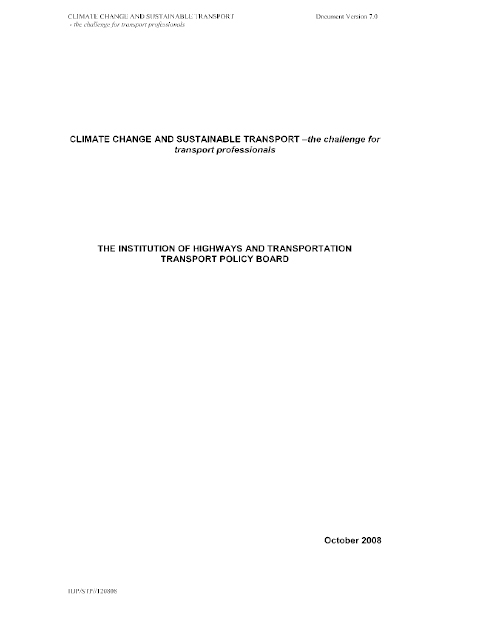


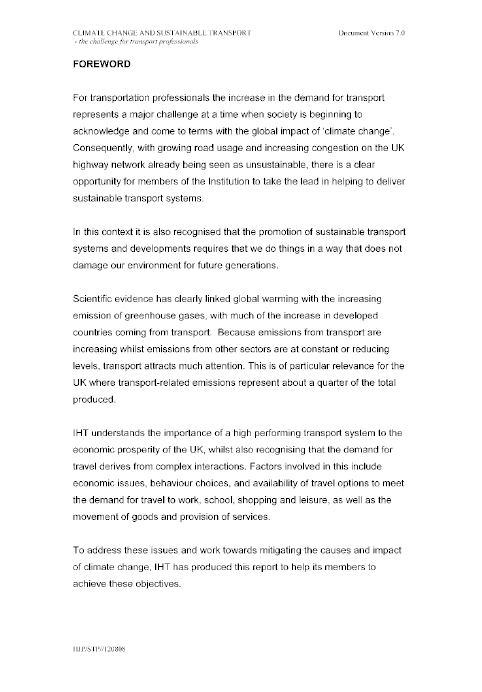

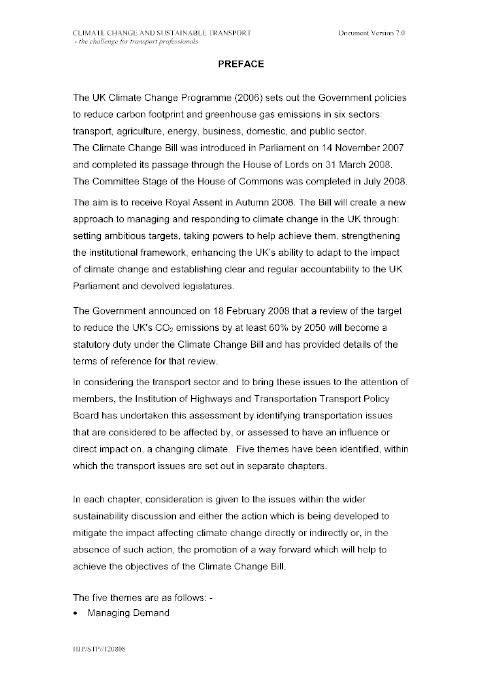
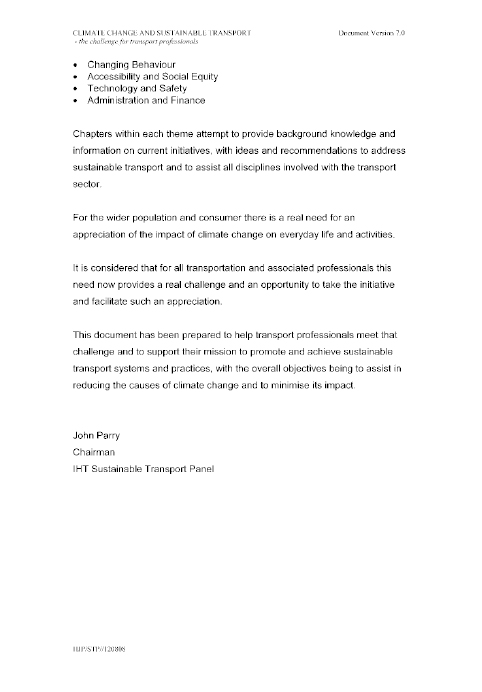
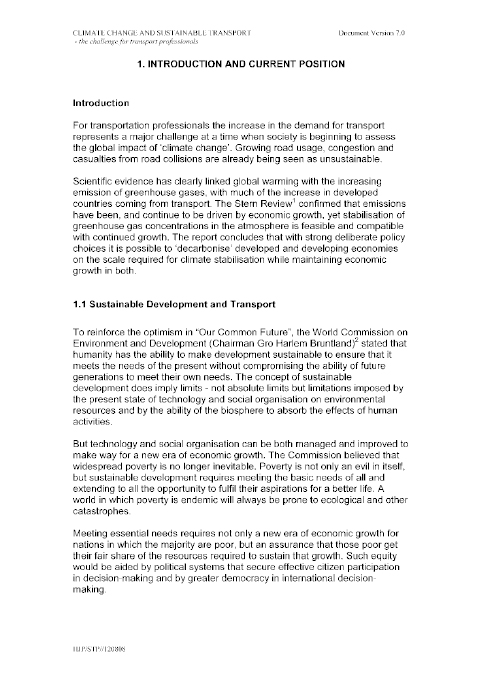


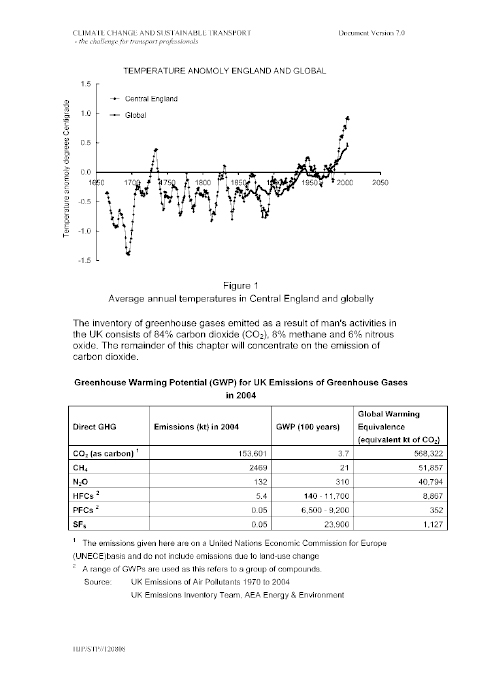
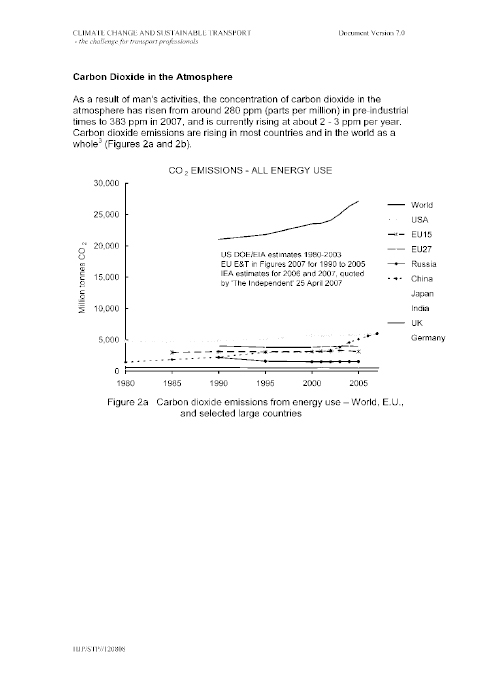
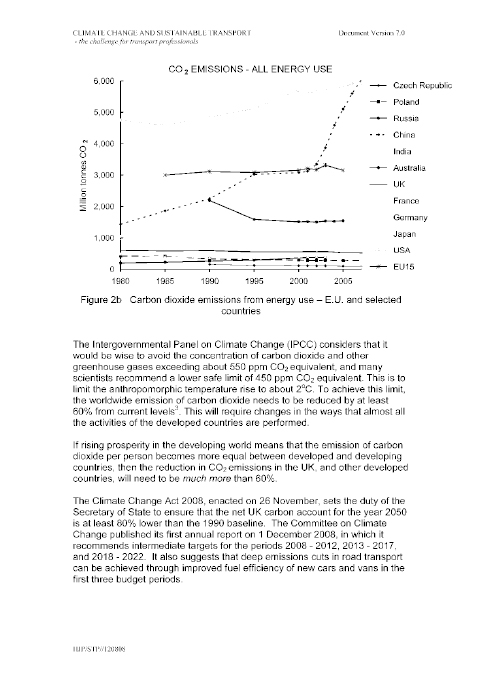
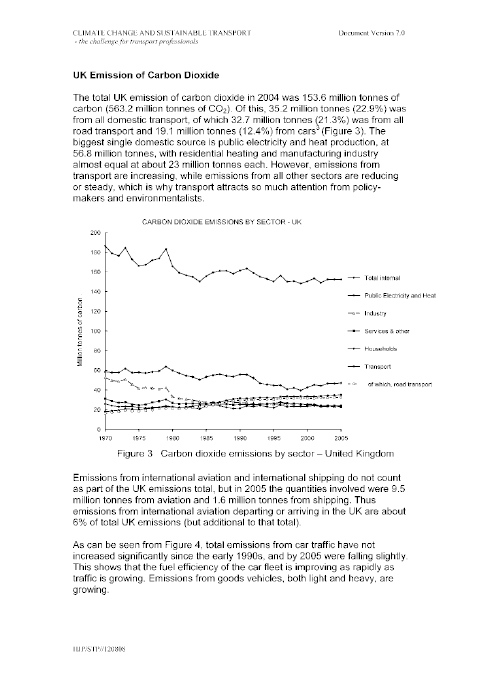


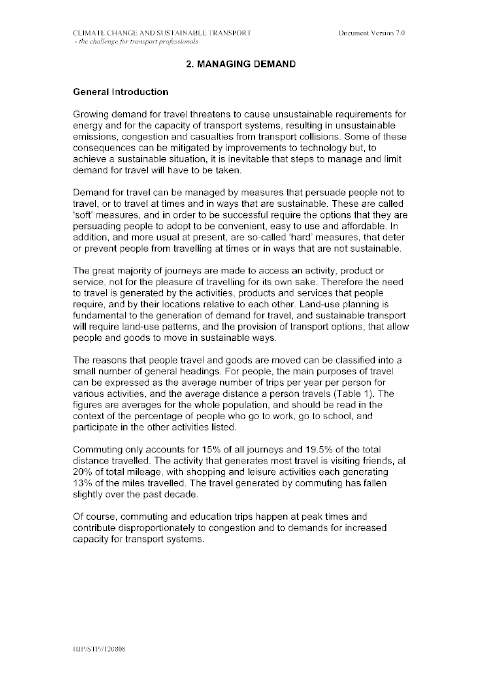

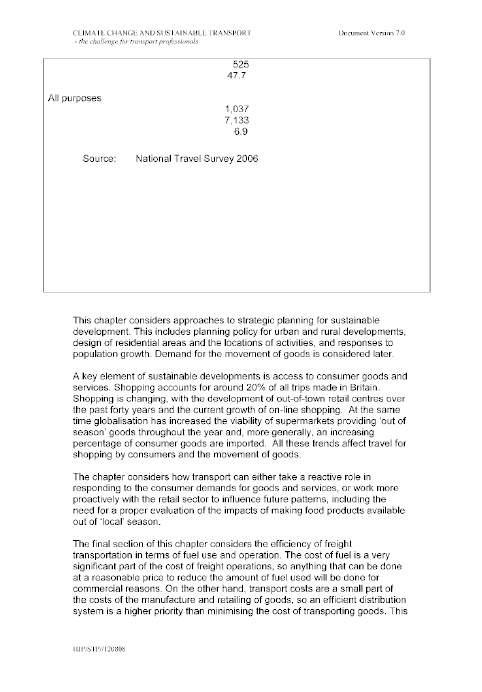
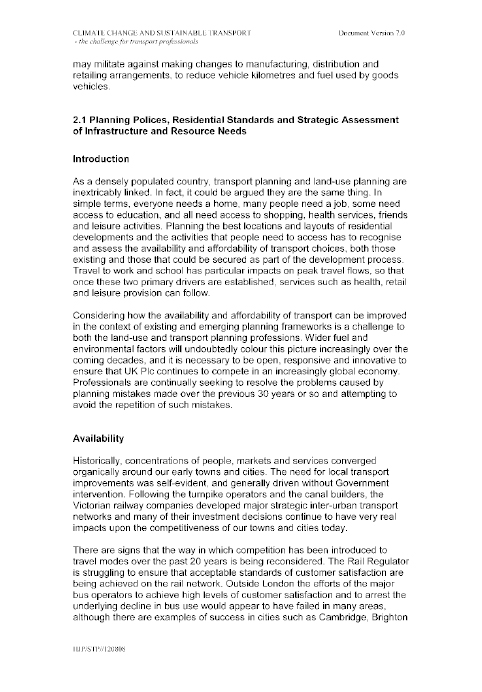

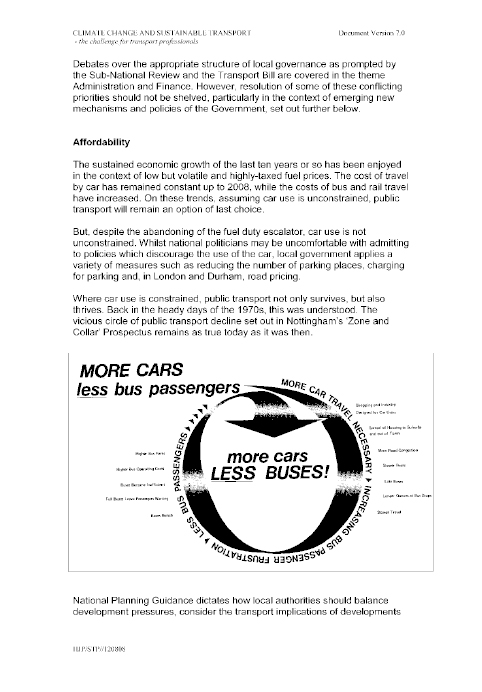
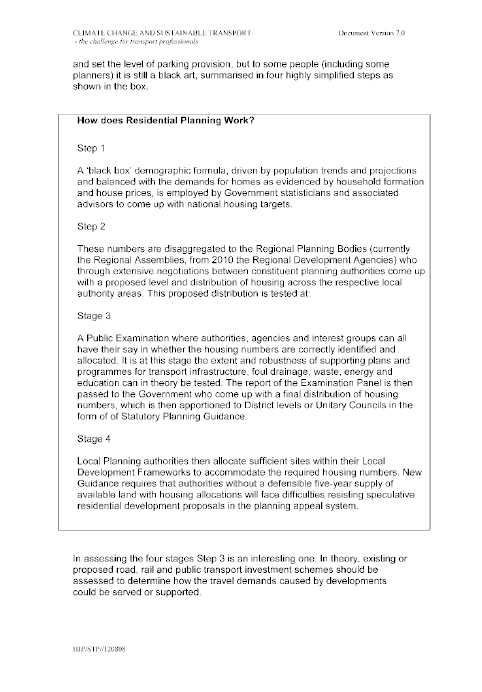
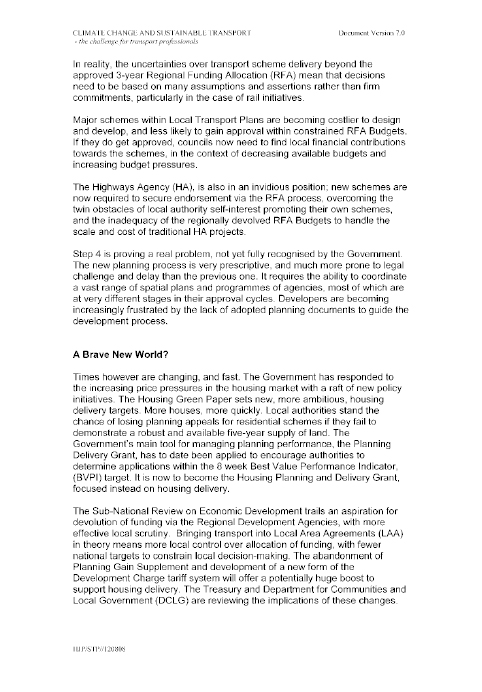
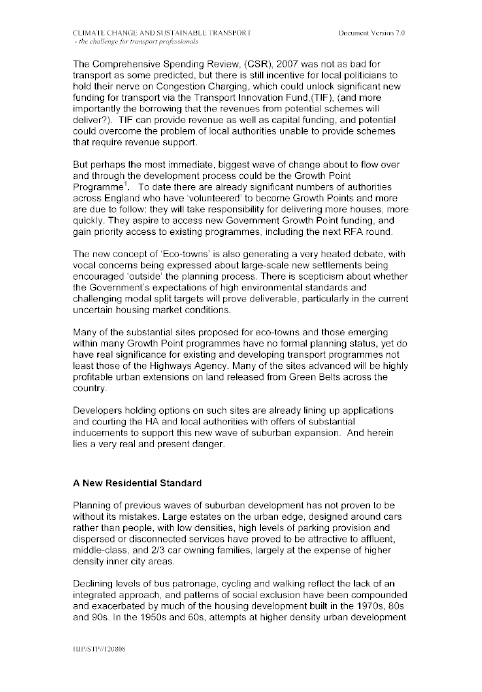


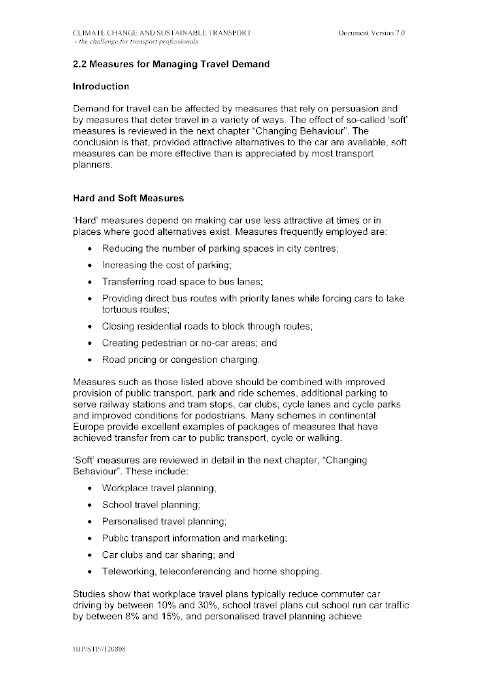
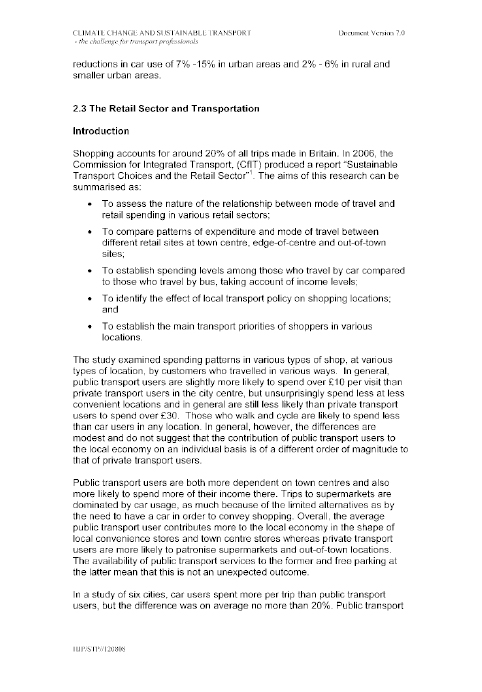

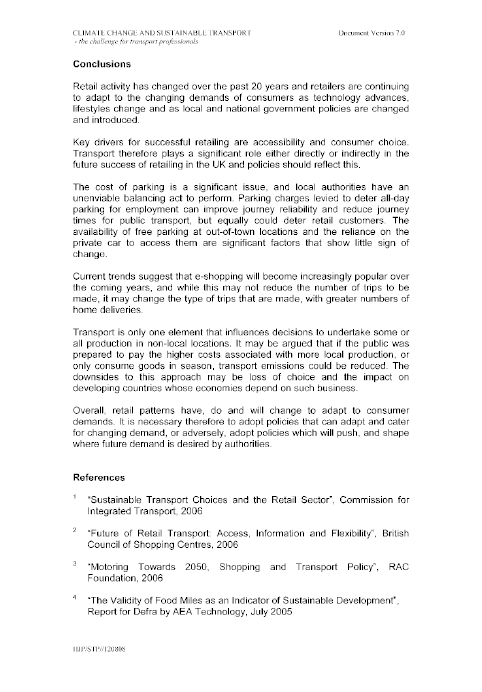

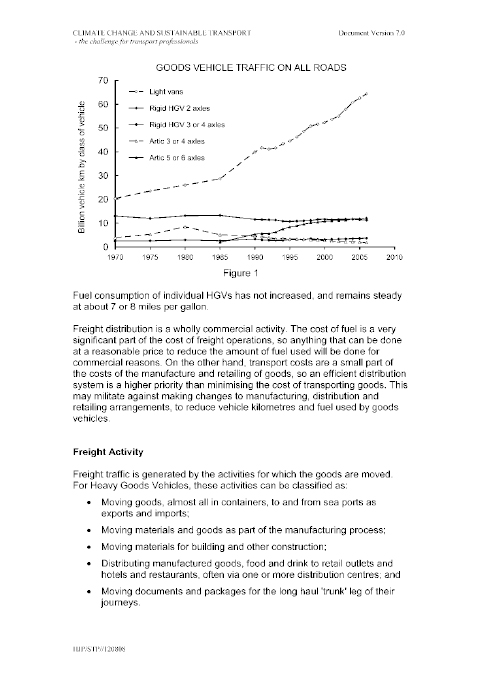
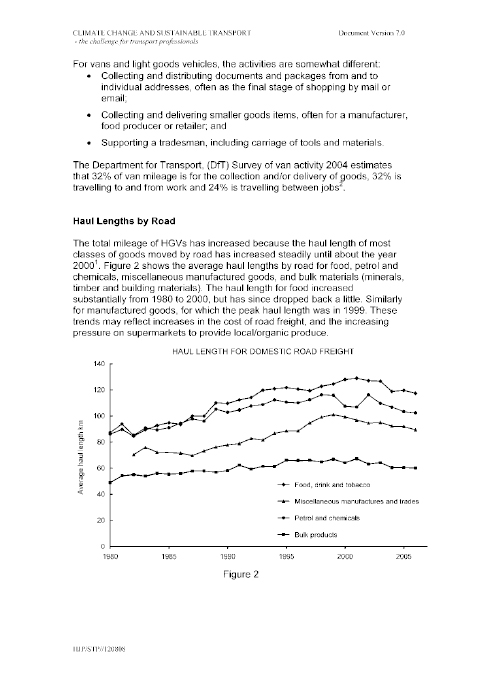
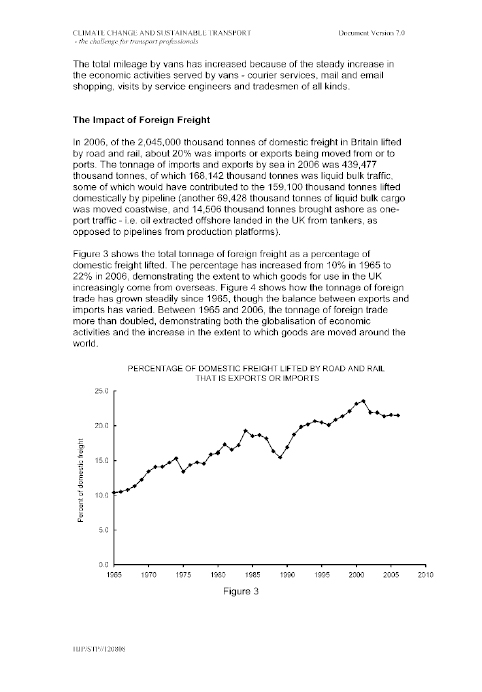
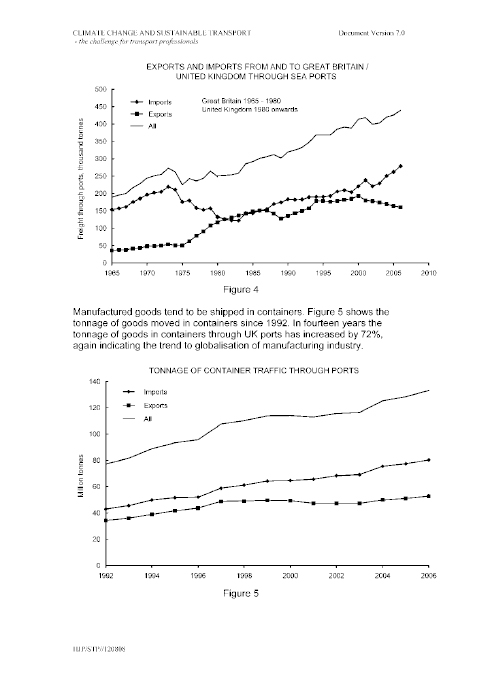



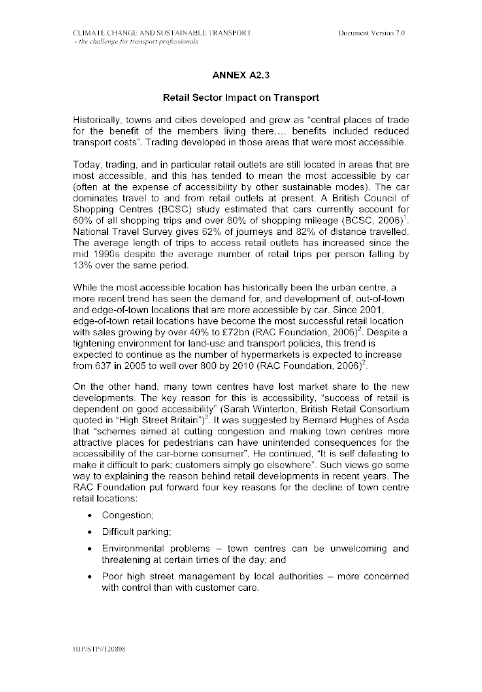

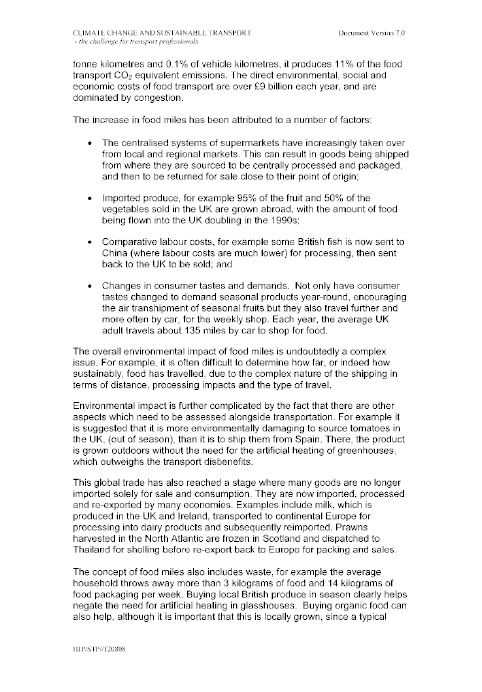
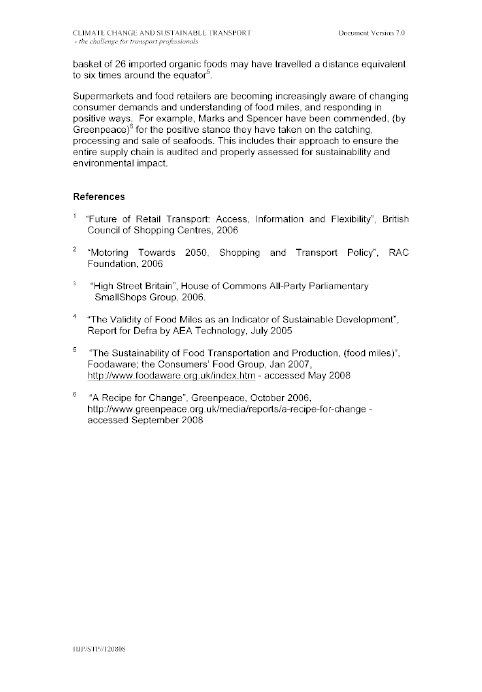
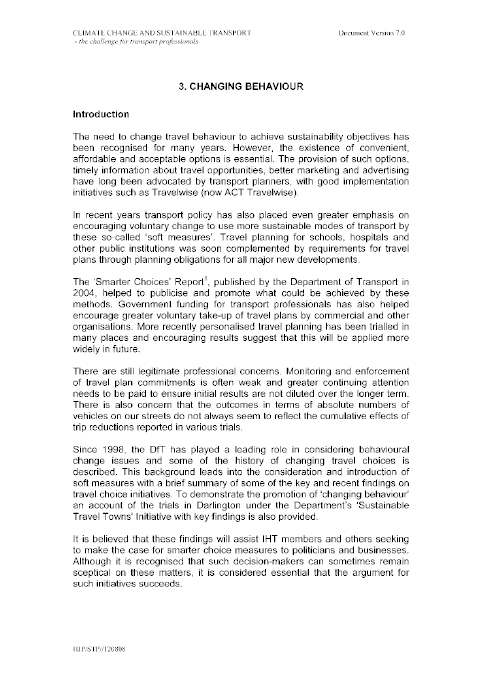
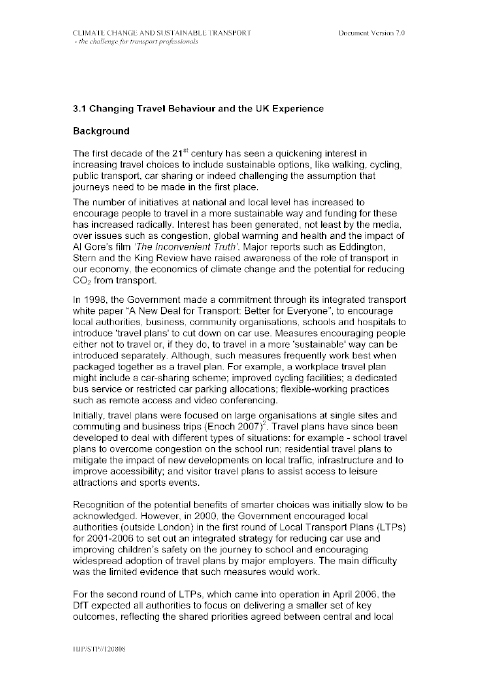
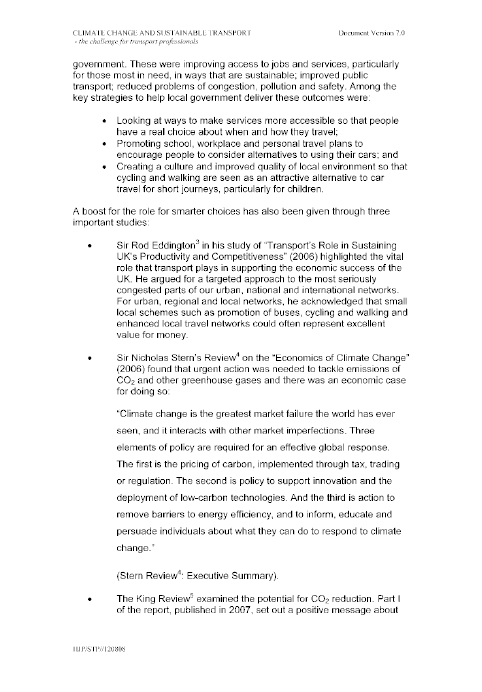

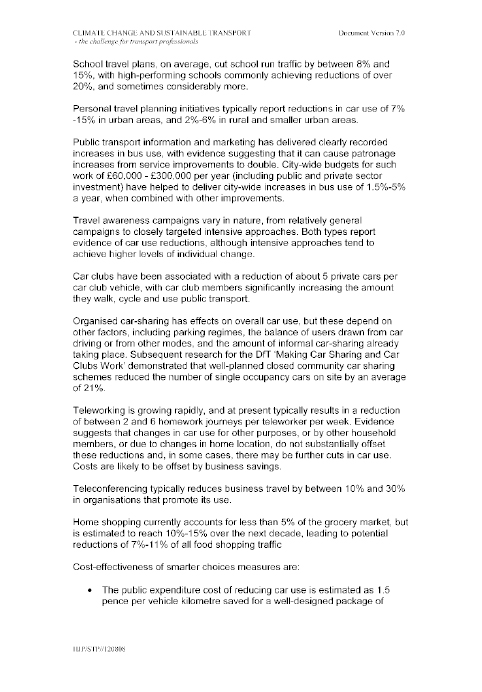


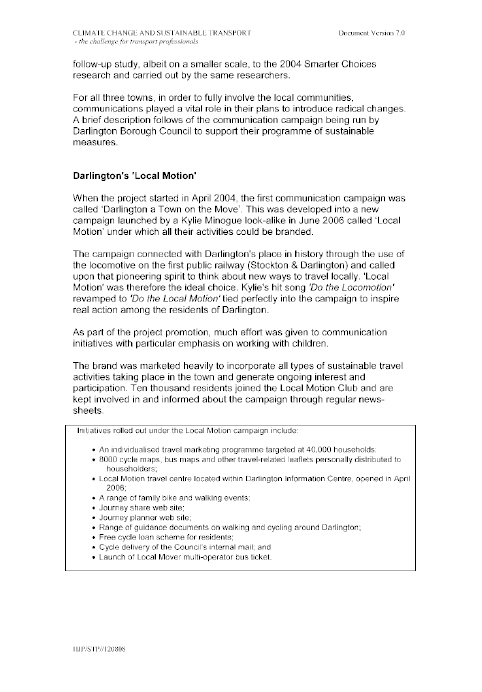

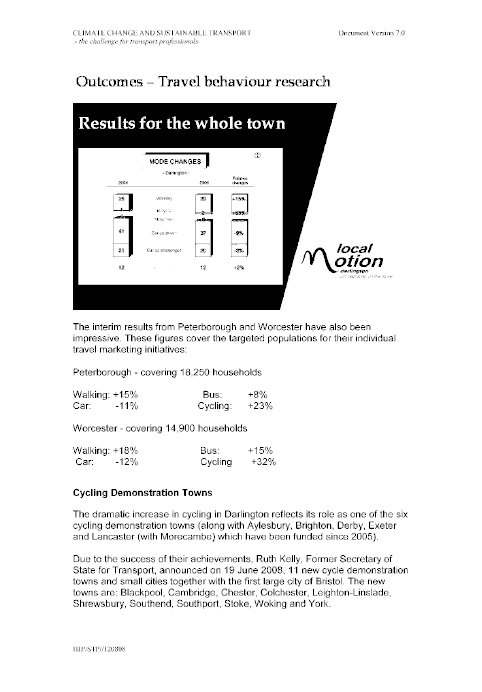

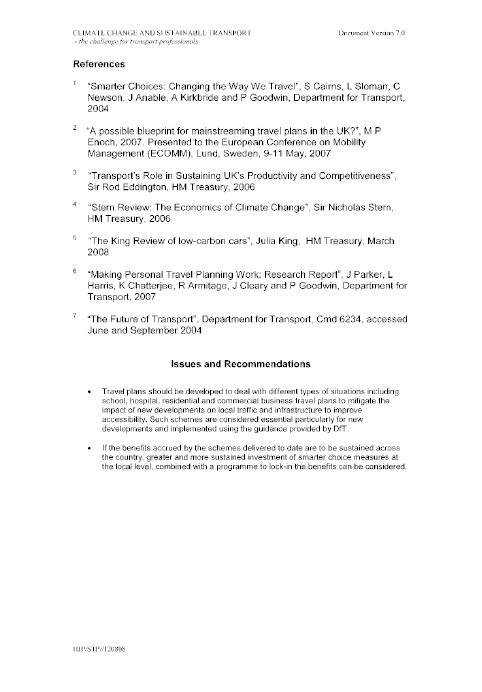

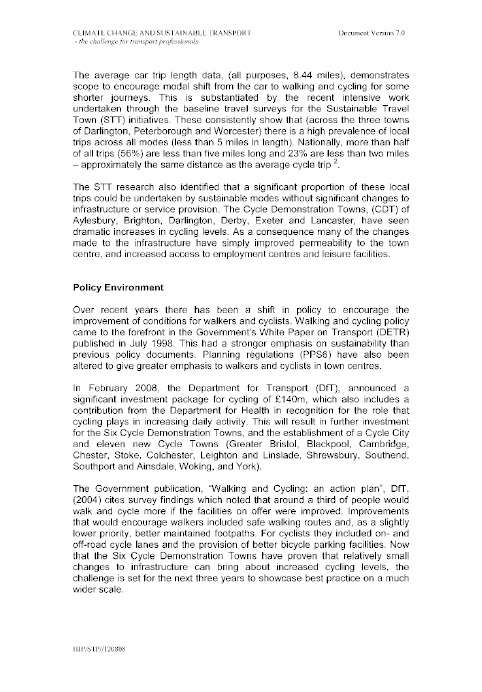

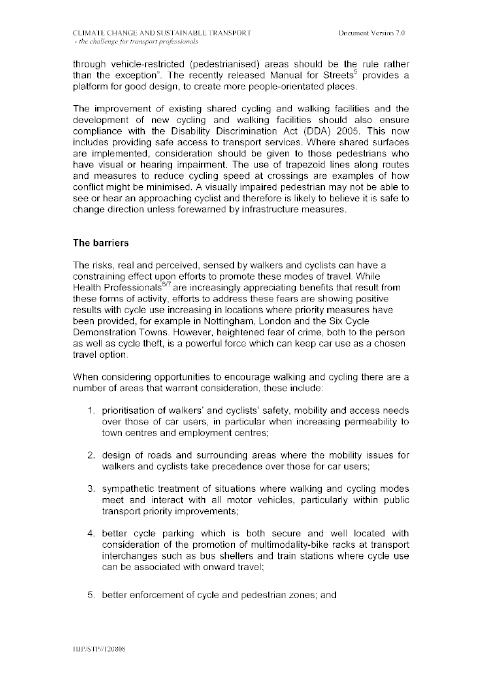
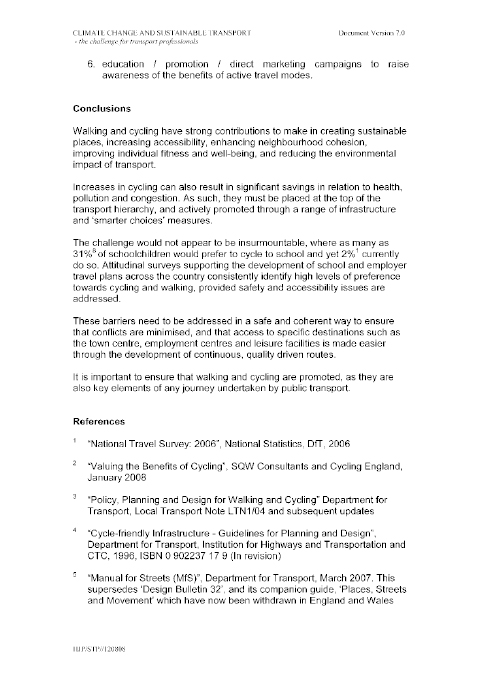
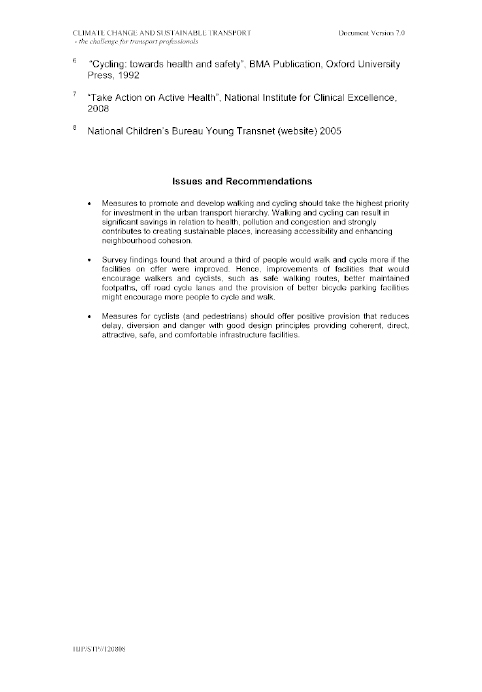
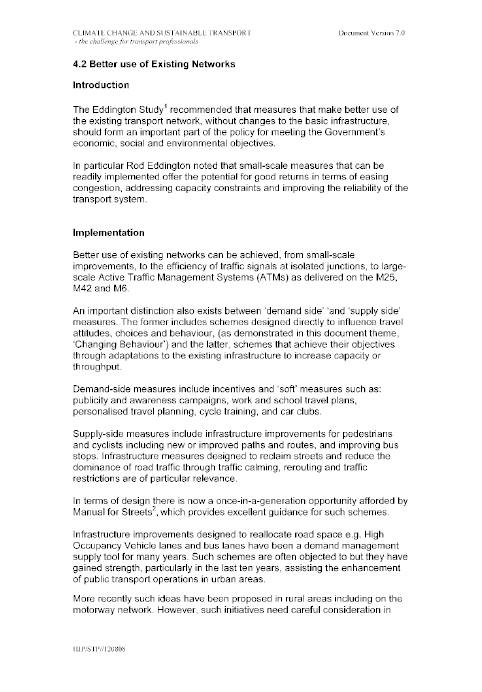



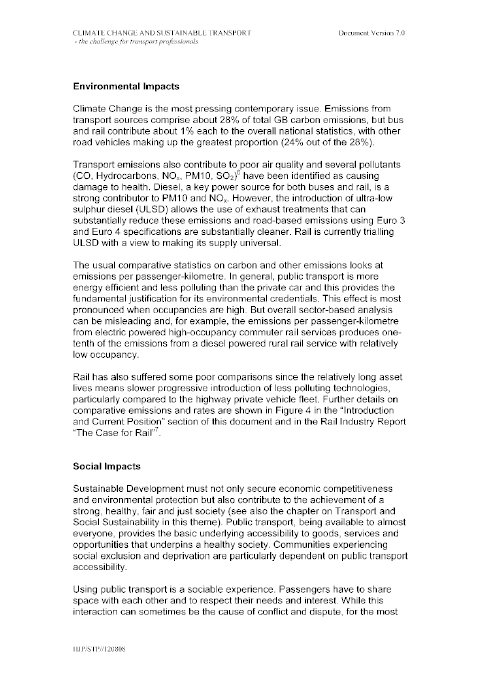
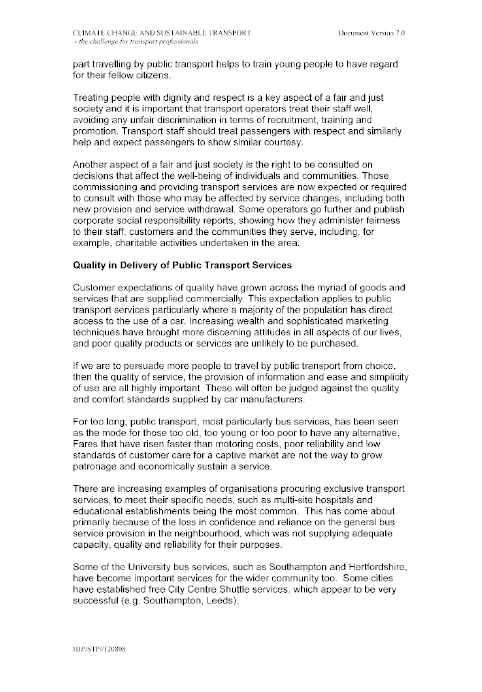
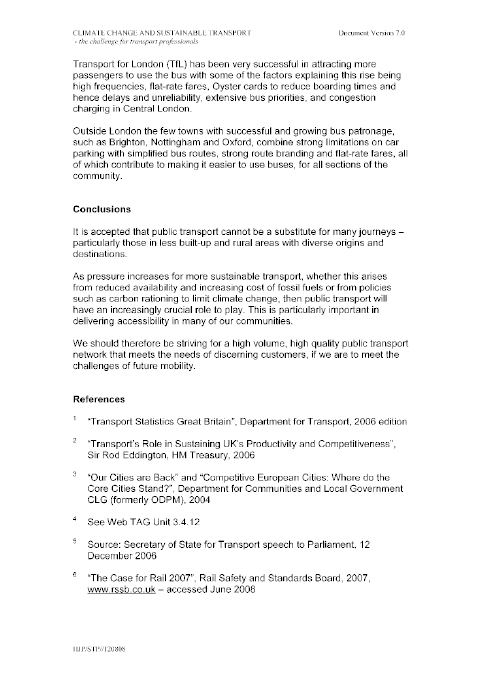
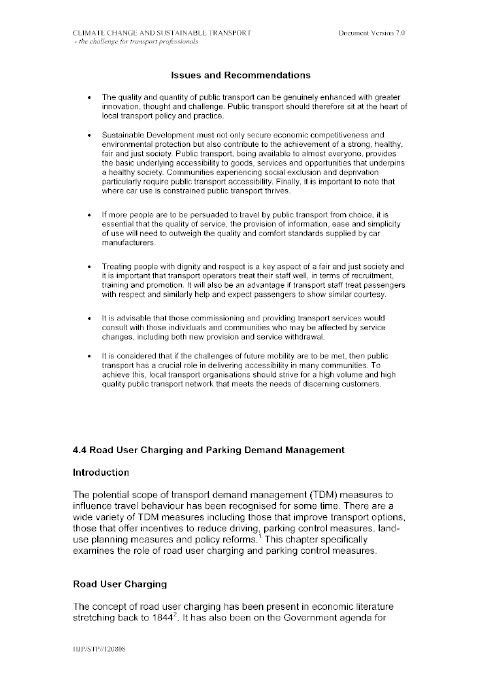
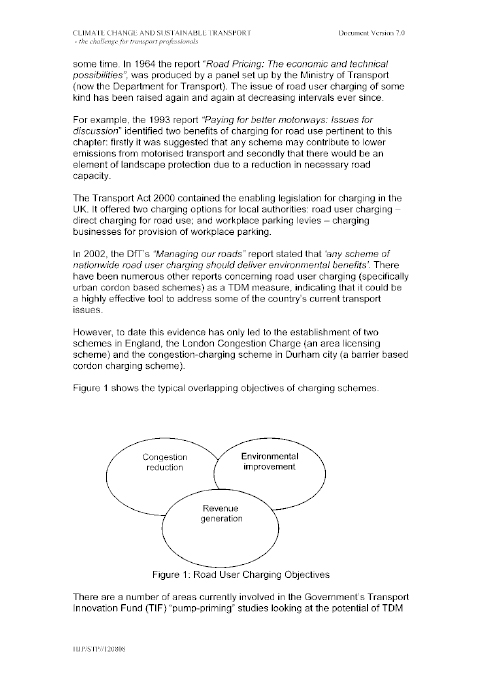


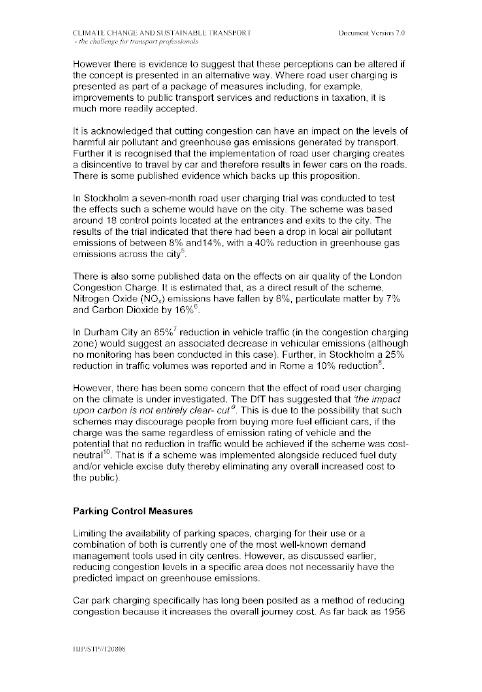



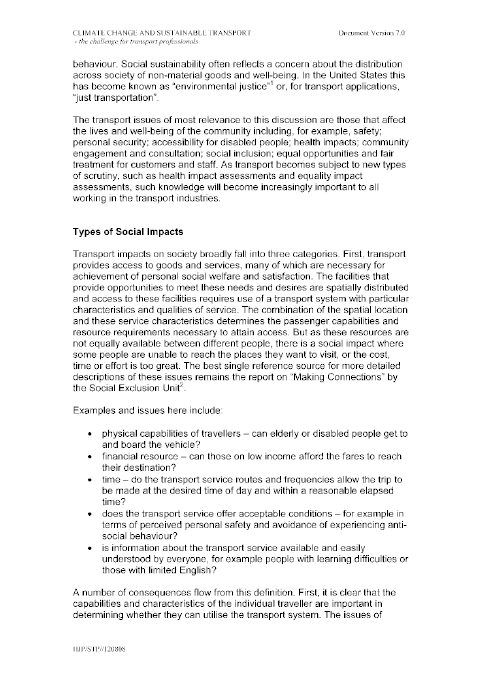



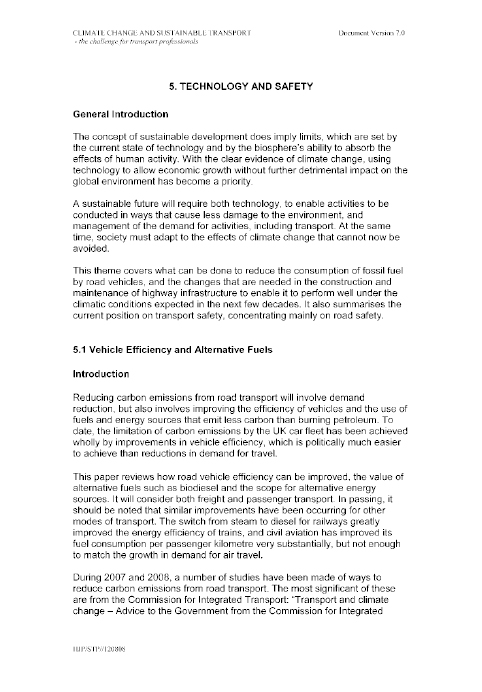







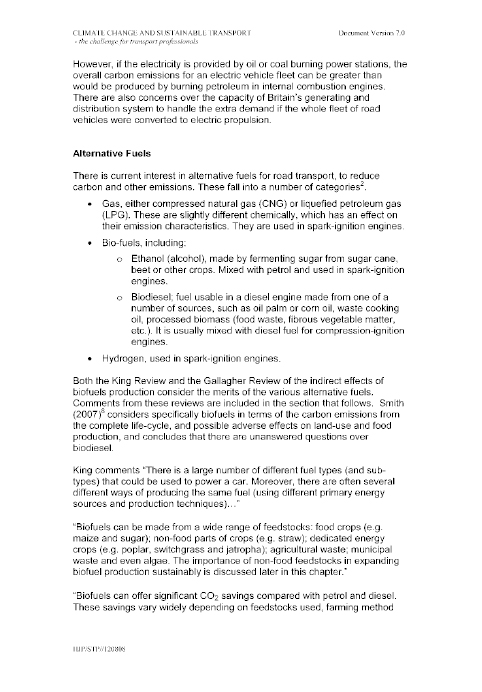


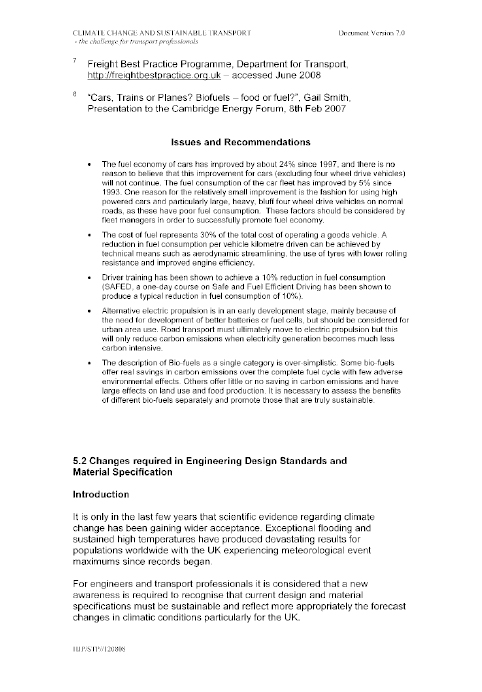
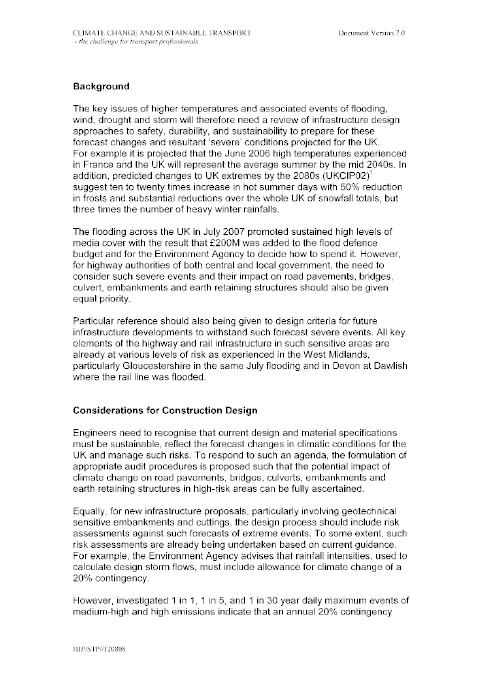
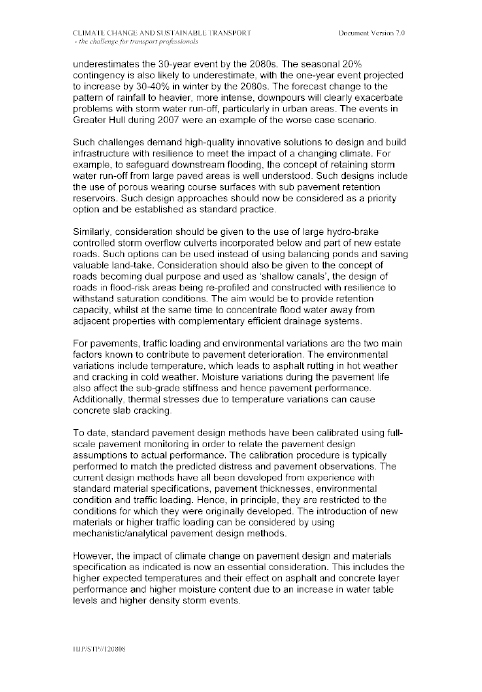
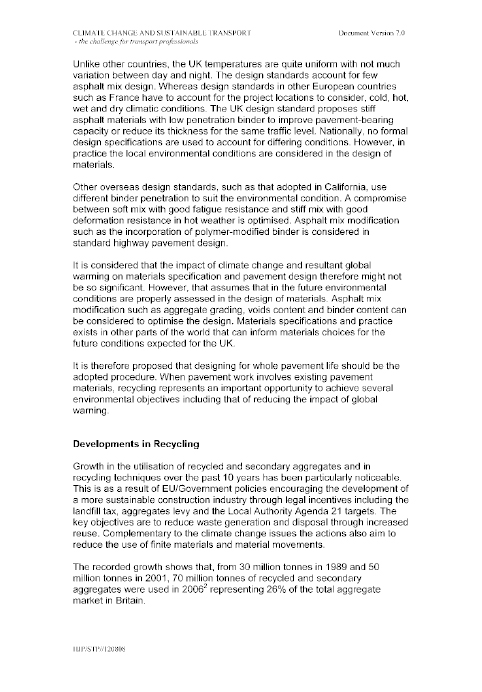

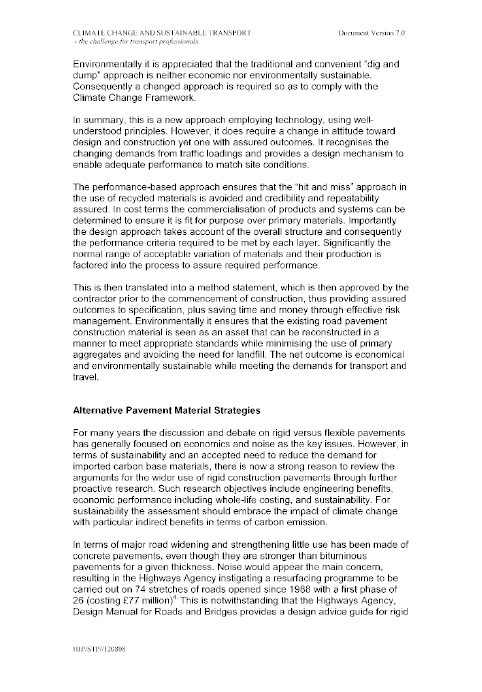

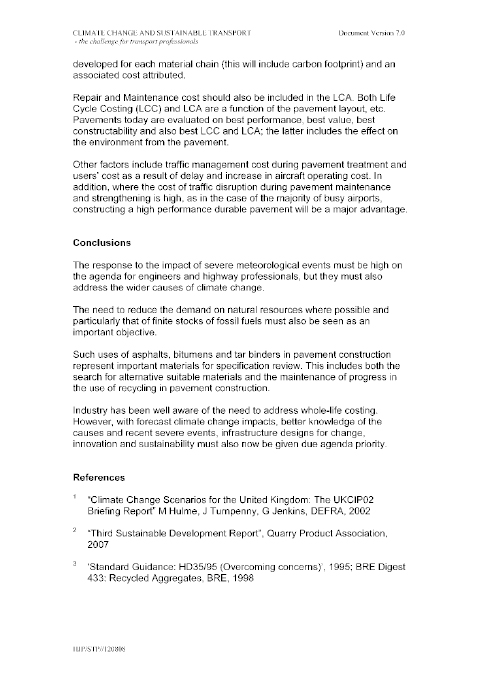
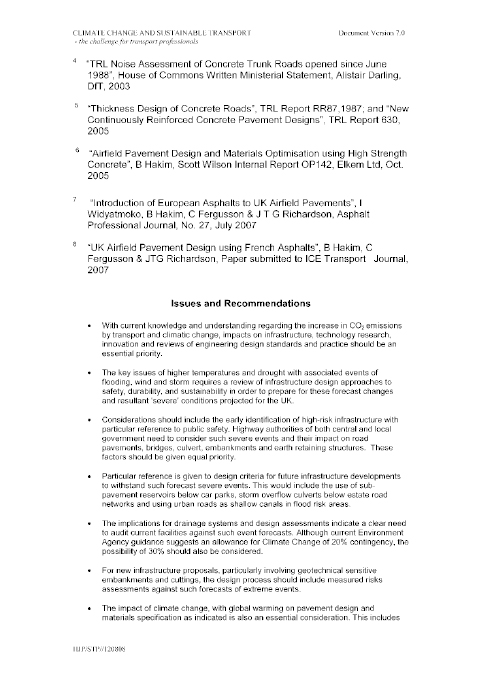
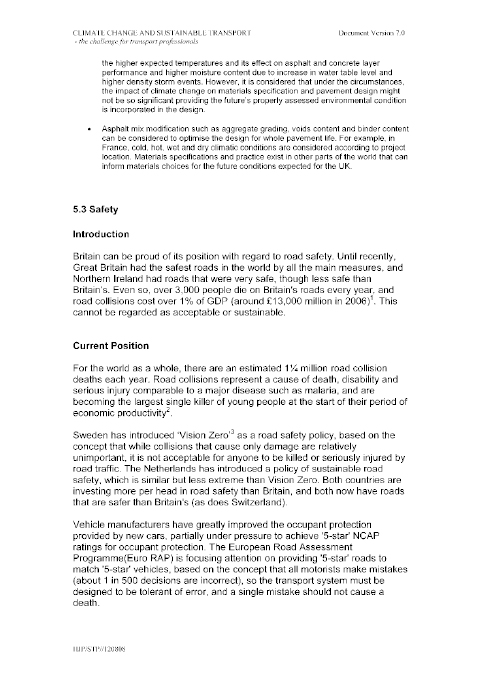
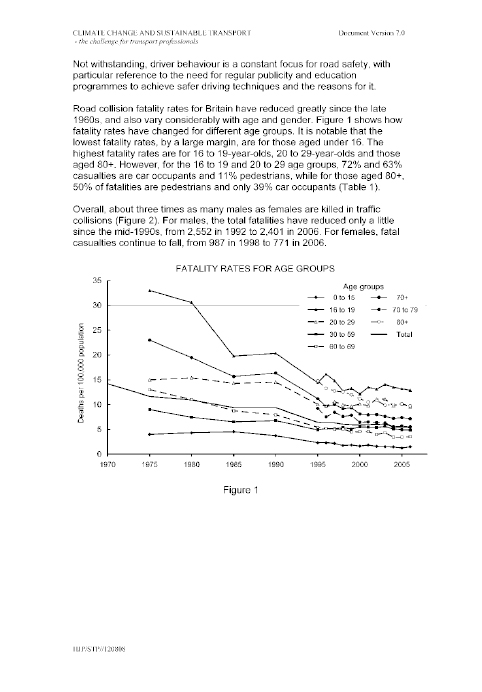
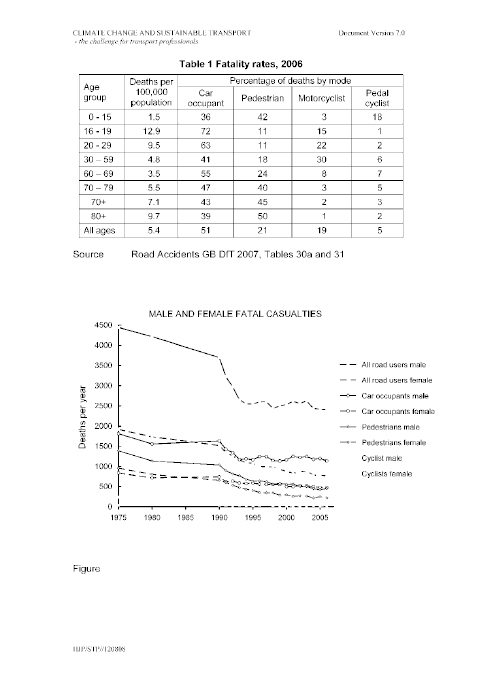
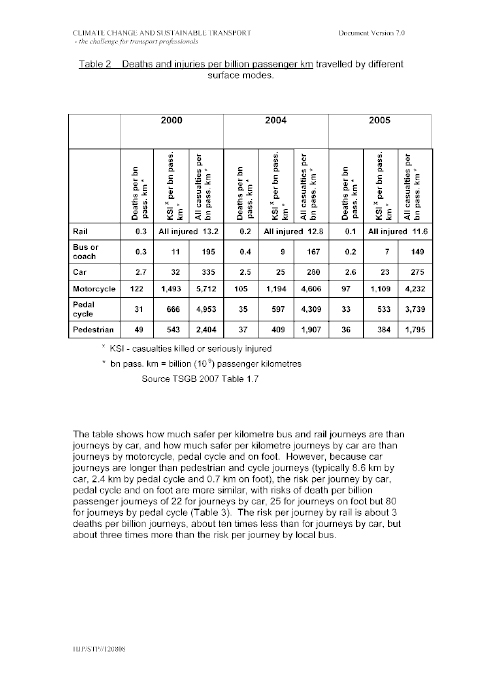
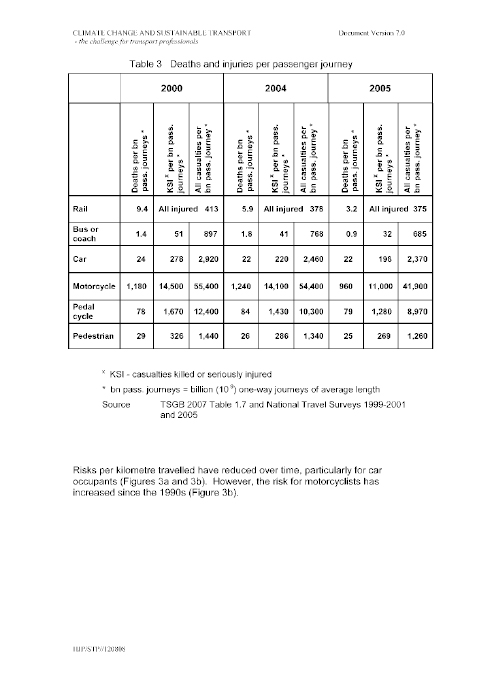

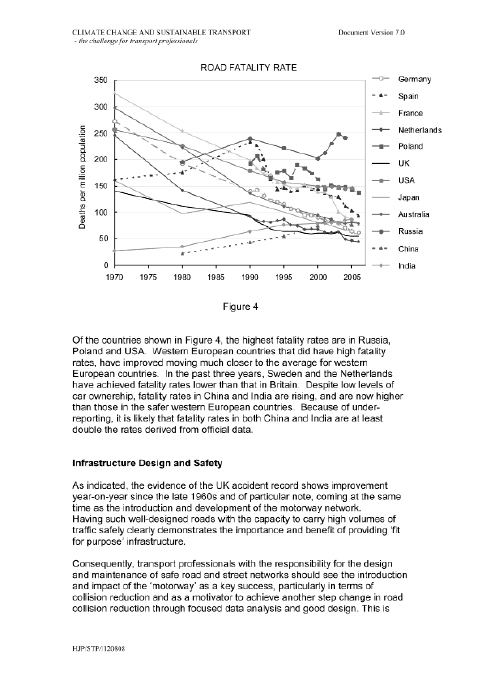
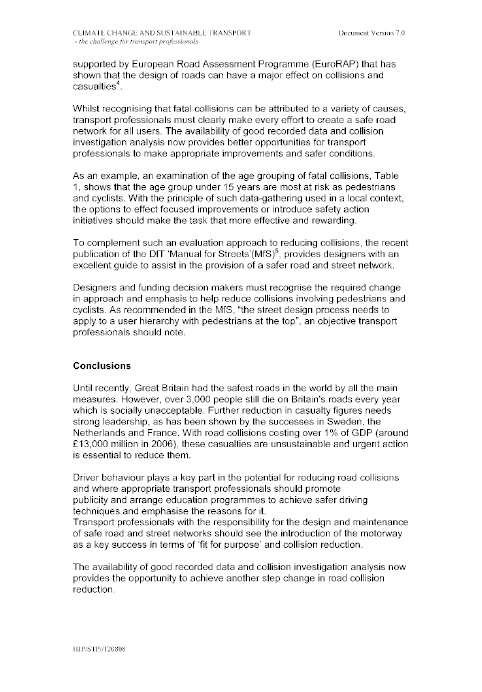

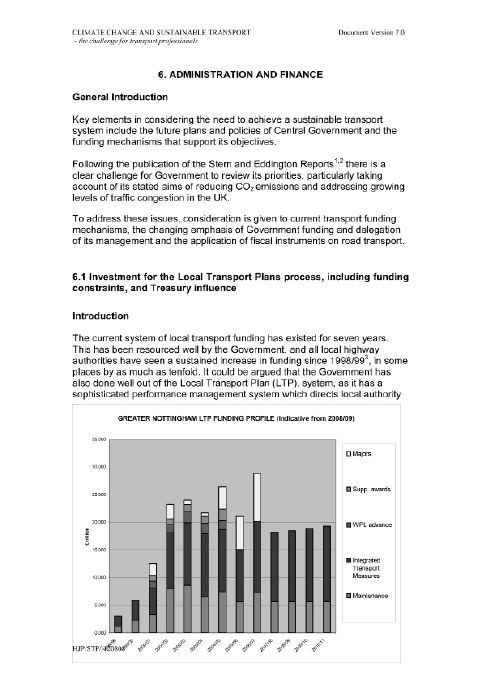

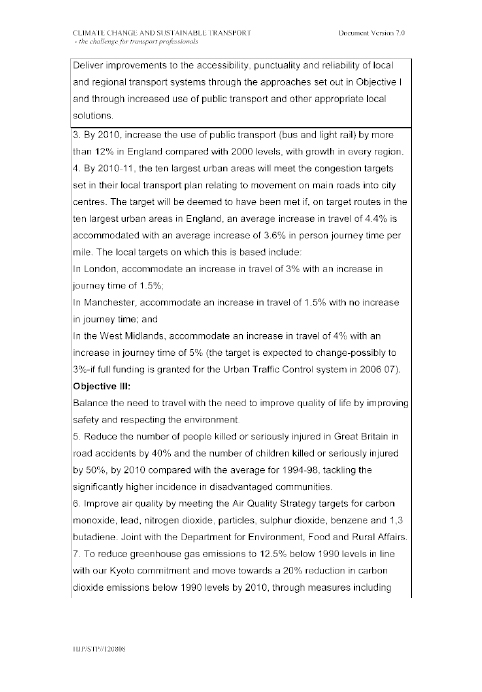
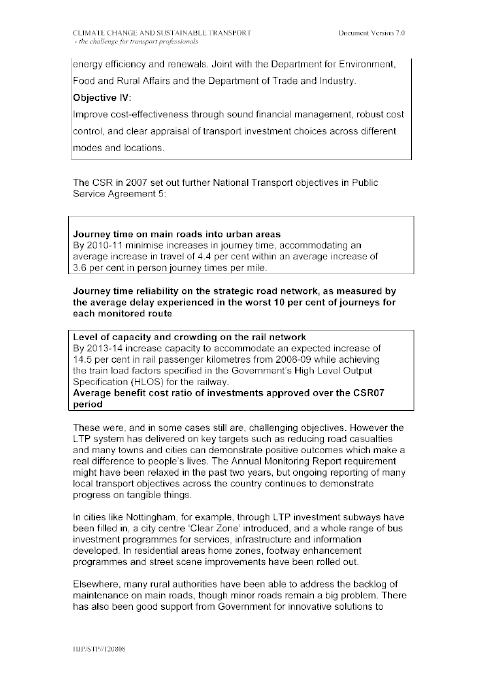
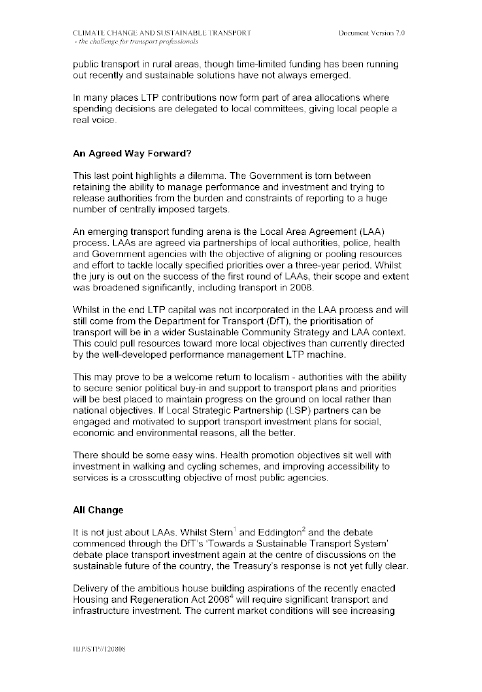

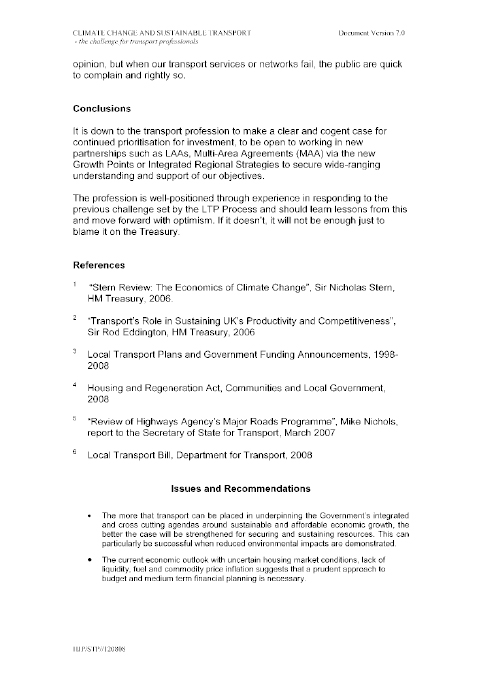

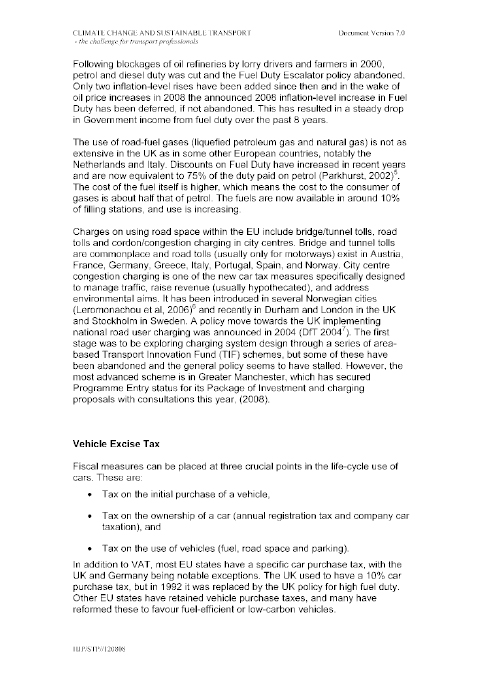





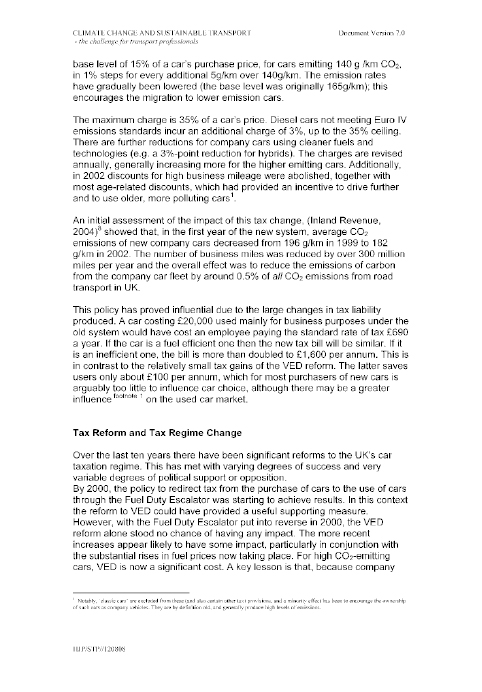
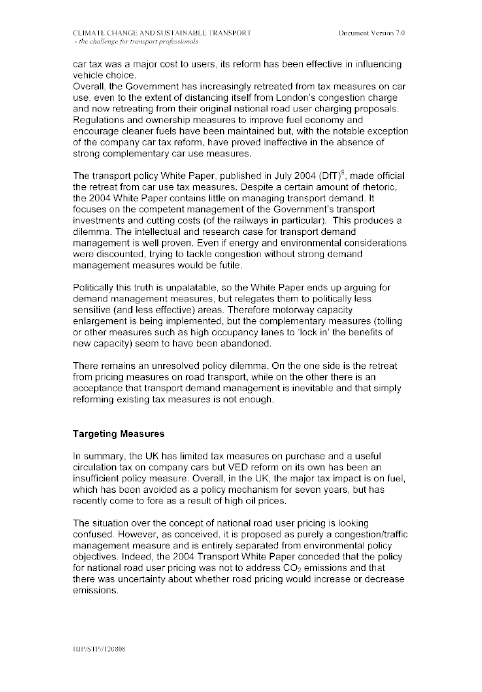
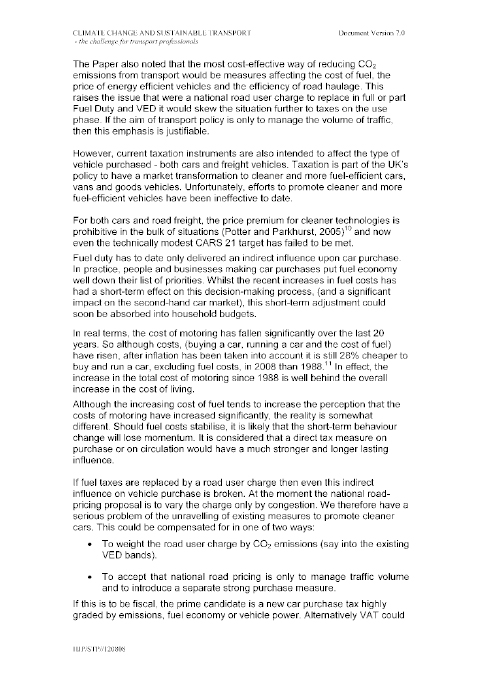
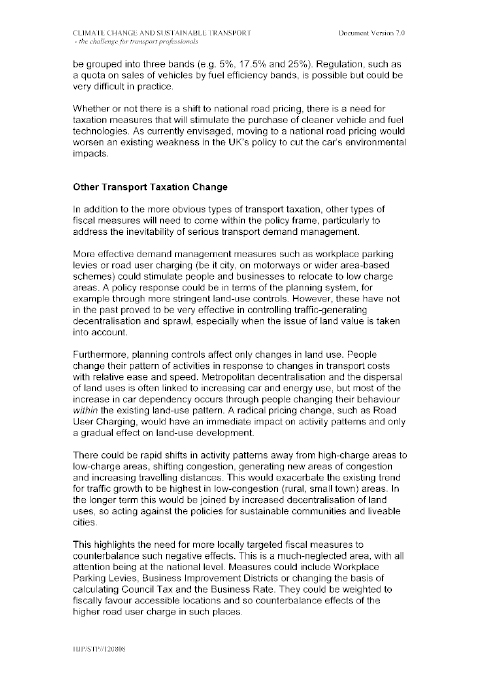
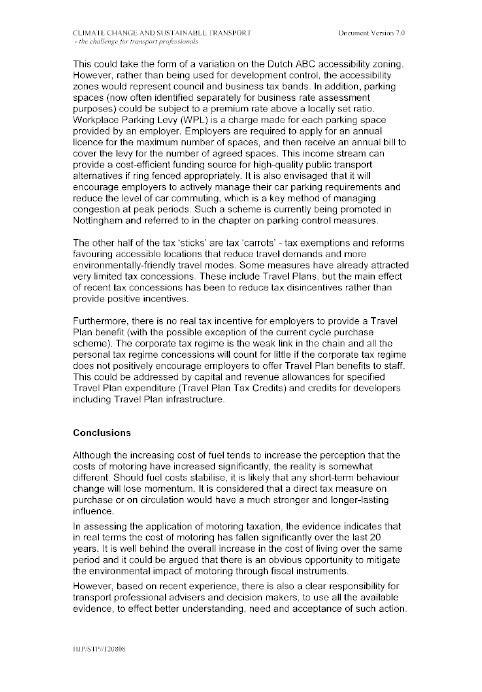
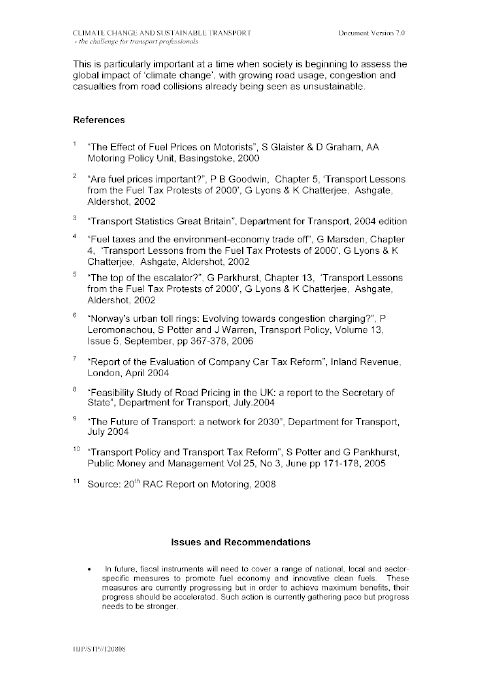

IHT NI Branch - Submission on
Climate Change to the Northern Ireland Assembly Environment Committee
The Northern Ireland Branch of the Institution of Highways & Transportation welcomes the opportunity to contribute to the NI Assembly Environment Committee Inquiry into Climate Change.
We note that the Aim of the Inquiry is initially to understand the implications of climate change for Northern Ireland. While we recognise that there is ongoing debate and scientific study into trends in ‘climate change’ locally and globally, we believe that it is not appropriate to ignore the issues which may be contributing to those trends, actual or perceived. We also note the Committee’s wish to make recommendations on government policies to mitigate the impacts, to examine economic implications and identify suitable adaptation initiatives.
The Institution of Highways & Transportation is a learned society with over 11,500 members. It is concerned specifically with the planning, design, construction, maintenance and operation of land-based transport systems and infrastructure.
IHT recognises that for transportation professionals the increase in the demand for transport represents a major challenge at a time when society is beginning to acknowledge and come to terms with the global impact of ‘climate change’. For that reason, in November 2008, it published ‘Climate Change and Sustainable Transport – the challenge for transport professionals’ to contribute to professional practice and to assist all disciplines involved in the transport sector to address the consequential impacts of climate change. Our contribution to the Inquiry is based around the advice within this publication couched in terms of Northern Ireland’s unique position within the United Kingdom. A copy of the Executive Summary and the full document are attached.
Climate Change and Sustainable Transport
Long-term road transport, powered by fossil fuel, is not sustainable. It is contributing to the depletion of a finite stock of fossil fuel and emitting a rising amount of carbon dioxide. There is a need to address environmental impacts such as noxious emissions, noise and unsustainable land development that cause extended journey patterns. The transition to a sustainable transport system involves a combination of technological and transport demand policies.
However we accept for the needs of society and the economy of Northern Ireland good road infrastructure is essential to serve the transport needs of the community for the short to medium term.
We are alert to scientific evidence that has linked global warming with the increasing emission of greenhouse gases, with much of the increase in developed countries coming from transport. The fact that emissions from transport are increasing whilst emissions from other sectors are constant or reducing is of particular relevance for the UK where transport related emissions represent about a quarter of the total produced .
We also recognise the importance of a high performing transport system to the economic prosperity of the UK, and the key role of Northern Ireland’s strategic links to the rest of the UK and to other European and world markets and destinations.
The Stern Review into the economics of climate change confirmed that emissions have been, and continue to be, driven by economic growth. Stern estimates that the costs of reducing the emission of green house gases are substantially less than the costs of repairing the damage caused by climate change.
Whether we believe in climate change or not, if we do nothing we may find that it will not be possible to turn back the clock and recover the lost opportunities of acting now.
Emissions and transport
Emission of anthropomorphic greenhouse gases has raised the concentration of carbon dioxide in the atmosphere from around 280 ppm before the industrial revolution to 383 ppm in 2007. In the last century the global average temperature has increased by about 0.9°C and the average temperature in central England by about 1.4°C . Emission of carbon dioxide is rising in many countries, though in EU27 it is falling.
In the United Kingdom, production of public electricity and heat is responsible for 31% of total emissions of CO2; all transport produces 23% of emissions, and car traffic 12.7% in 2005. Industry, households and services each produce about 15% of total emissions.
Emission of carbon dioxide from all car traffic was almost constant between 1993 and 2003, and is now falling. This implies that the fuel economy of the average car in service is improving faster than traffic is growing. Carbon dioxide emissions from road traffic are growing, but this growth is due to growing emissions from freight transport.
1. Managing Demand
Planning Policies
It is essential that planning polices and residential standards are reviewed to ensure they work with, rather than against, integrated transport where it can serve new developments. Sustaining integrated urban and suburban living patterns will become even more of a priority as fuel prices increase.
Reducing the need to travel will not be just an environmentalist objective, but it will become one necessitated by daily and weekly household budgeting. It will play an increasing role in choices about where to buy a house or where to seek work.
It is essential that reviews of the RDS and RTS provide for on-going strategic assessment of infrastructure and resource needs and take account of climate change, peak oil and the sustainable transport.
Policies must be strengthened to require contributions which can secure wider sustainable transport infrastructure for cyclists, pedestrians and complementary pump priming for bus service enhancements.
Demand for travel can be affected by measures that rely on persuasion and by measures that deter travel in a variety of ways. Provided attractive alternatives to the car are available, soft measures can be more effective than is appreciated by most transport planners.
The Retail Sector and Freight Transportation
Retail activity has changed over the past 20 years and retailers are continuing to adapt to the changing demands of consumers as technology advances, lifestyles change and as local and national government policies are changed and introduced. Key drivers for successful retailing are accessibility and consumer choice. Transport therefore plays a significant role either directly or indirectly in the future success of retailing and policies should reflect this.
Current trends suggest that e-shopping will become increasingly popular over the coming years, and while this may not reduce the number of trips to be made, it may change the type of trips that are made, with greater numbers of home deliveries.
?In the UK, agriculture and food accounts for nearly 30% of goods transported by road and food miles rose by 15% between 1992 and 2002. In 2002, food transport accounted for 25% of all HGV vehicle kilometres in the UK. Of imported produce, 95% of the fruit and 50% of the vegetables sold in the UK is grown abroad and the amount of food being flown into the UK doubled in the 1990s. The direct environmental, social and economic costs of food transport are over £9 billion each year and are dominated by congestion.
In addition to the reliance factor of UK imported produce, the wider implications of the unsustainable transportation impact need to be addressed at local, national and global levels..
In the planning and assessment of proposed new retail and shopping outlets, which includes the establishment of Farmer’s Markets, a priority should be given to the accessibility and servicing by sustainable forms of transport such as good public transport, walking and cycling links with appropriate facilities.
The introduction of effective traffic and parking management policies and improvements to public transport could improve the accessibility of town centres. If implemented effectively, travel around urban areas should be more efficient for consumers and thus potentially make the urban centres increasingly accessible. It is important to understand the value that consumers place upon time and that congestion is a major factor in influencing the time taken to access retail facilities.
Northern Ireland is almost 100% dependant on road transport for the movement of freight. Fuel consumption by road freight has increased because the total mileage by goods vehicles has increased. The fastest growth has been for light vans, followed by articulated HGVs; traffic by rigid HGVs has not increased. Fuel consumption of individual HGVs has not increased, and remains steady at about 7 or 8 miles per gallon.
Freight distribution is a wholly commercial activity. The cost of fuel in 2008 was about 30% of the cost of freight operations, so anything that can be done at a reasonable price to reduce the amount of fuel used will be done for commercial reasons.
The total mileage by vans has increased because of the steady increase in the economic activities served by vans - courier services, mail and online shopping, visits by service engineers and tradesmen of all kinds. About a quarter of the total tonnage of UK domestic road freight are goods travelling to or from ports as imports or exports. Empty running of HGVs for particular commodities has reduced slightly, particularly for the movement of manufactured goods and petrol, but the changes are small.
Reducing the distances that goods are moved would require major changes in the supply chains and manufacturing processes that are served by road freight. This is not impossible, although supply chains, distribution arrangements and depot locations have been optimised, and the disincentives to change them are great.
- Improved operation management leading to the better utilisation of goods vehicles can reduce empty and part-loaded running.
- While pilot projects in the food distribution industry in GB have shown that long-distance road freight can be transferred to rail for the trunk stage of a journey, the restricted rail network in Ireland limits the opportunities although we recommend that opportunities should be kept under review.
2. Changing Behaviour
Travel Behaviour and Effectiveness of Smarter Choices
Since the realisation that the philosophy of ‘predict and provide’, to keep pace with traffic growth, was not sustainable, a healthy awareness by transport professionals has emerged to consider alternative strategies and apply innovative measures to manage demand. The need to change travel choice behaviour to achieve sustainable objectives and project the existence of convenient, affordable and healthier acceptable alternative options is a priority. The provision of such options, timely information about travel opportunities, better marketing, advertising and good implementation initiatives have long been advocated by transport professionals. It is therefore considered appropriate for transport professionals to take the initiative, where possible, to engage with society to establish and promote such communication schemes.
While personal travel planning projects have demonstrated effective outcomes based upon area-wide approaches, there is a long-term opportunity to support this work by building upon existing networks and communication channels. Appropriate opportunities to target people would include during life-changing moments, when individuals may be most likely to deliberate about travel behaviour and break established habits. These could include when moving house or school, applying for a new job, obtaining an over-60 public transport pass and changes in public transport provision.
Travel plans should be developed to deal with different types of situations including school, hospital, residential and commercial business travel plans to mitigate the impact of new developments on local traffic and infrastructure to improve accessibility. Such schemes are considered essential particularly for new developments and implemented using the guidance provided by DfT.
Accessibility and Social Equity
The Promotion of Walking and Cycling Journeys
Walking and cycling have strong contributions to make in creating sustainable places, increasing accessibility, enhancing neighbourhood cohesion, improving individual fitness and well-being, and reducing the environmental impact of transport.
Survey findings found that around a third of people would walk and cycle more if the facilities on offer were improved. Hence, improvements of facilities that would encourage walkers and cyclists, such as safe walking routes, better maintained footpaths, off road cycle lanes and the provision of better bicycle parking facilities might encourage more people to cycle and walk.
Measures to promote and develop walking and cycling should take high priority for investment in the urban transport hierarchy. Walking and cycling can result in significant savings in relation to health, pollution and congestion and strongly contributes to creating sustainable places, increasing accessibility and enhancing neighbourhood cohesion.
Better use of Existing Networks
To facilitate and achieve better use of existing networks has been a particular objective since the realisation that the philosophy of ‘predict and provide’ for traffic growth was unsustainable.
The agenda must now extend from reducing congestion to the complementary and real need to secure greater benefits to reduce the impact of climate change. Innovative measures must be pursued with consideration of Traffic Demand Measures first, ahead of hard infrastructure solutions.
Better use of existing transport networks can also be achieved by the promotion of publicity campaigns to affect more efficient use of motorways by targeting driver behaviour for improvements in lane discipline.
Public Transport Quality, Accessibility and Integration
It is accepted that public transport cannot be a substitute for many journeys – particularly those in less built-up and rural areas with diverse origins and destinations. As pressure increases for more sustainable transport, whether this arises from reduced availability and increasing cost of fossil fuels or from policies such as carbon rationing to limit climate change, then public transport will have an increasingly crucial role to play. This is particularly important in delivering accessibility in many of our communities. We should therefore be striving for a high volume, high quality public transport network that meets the needs of discerning customers, if we are to meet the challenges of future mobility.
The quality and quantity of public transport can be genuinely enhanced with greater innovation, thought and challenge. Public transport should therefore sit at the heart of local transport policy and practice.
If more people are to be persuaded to travel by public transport from choice, it is essential that the quality of service, the provision of information, ease and simplicity of use will need to outweigh the quality and comfort standards supplied by car manufacturers.
Treating people with dignity and respect is a key aspect of a fair and just society and it is important that transport operators treat their staff well, in terms of recruitment, training and promotion. It will also be an advantage if transport staff treat passengers with respect and similarly help and expect passengers to show similar courtesy.
Road User Charging and Parking Demand Management
Road User Charging is not a new concept but the delivery of such an approach remains controversial at both the local and national level. Charging schemes have the ability to influence choices of travel, aiming to reduce demand on the existing highway network, and improving the environment. It can also provide valuable revenue for the promotion and development of alternative modes. If they are to be successful, action needs to be taken towards promoting the positive aspects of schemes, counteracting the opinions generated through negative press coverage.
Car parking demand management measures have the possibility to significantly influence modal choice, but care needs to be given in particular to the migration of congestion to other areas. As with road user charging, parking control measures can also provide revenue support for improving access to public transport. It is therefore also considered important to ensure that these positive aspects of schemes are promoted to gain acceptance from travellers.
Road user charging has an important role to play in an integrated and equitable transport network with particular reference to urban areas. However, the arguments to promote such schemes need to be well prepared and that the benefits in terms of reduced congestion, CO2 emissions, and improved public transport services are clearly demonstratable.
3. Technology and Safety
Vehicle Efficiency and Alternative Fuels
The fuel economy of cars has improved by about 24% since 1997, and there is no reason this improvement for cars will not continue. The fuel consumption of the car fleet, including 4 x 4s and MPVs, is reported to have only improved by 6% since 1993, although this is inconsistent with the slight fall in the total fuel used by cars since 1993, despite a 15% increase in car traffic. One reason for the relatively small reported improvement is the fashion for using
large, heavy, bluff four-wheel drive vehicles on normal roads, as these have poor fuel consumption.
The fuel consumption of goods vehicles is being reduced, but the scope for savings is less than for cars.
Alternative electric propulsion is in an early stage, mainly because of the need for development of better batteries or fuel cells. Road transport must ultimately move to electric propulsion, but this will only reduce carbon emissions when electricity generation becomes much less carbon intensive.
The benefits of alternative fuels, other than hydrogen, which is in a very early stage of development, are marginal, with only small reductions in carbon emissions and possible adverse impacts on land-use and food production. However, even if the first generation of bio-fuels are not sustainable and probably release as much or more carbon over their life-cycle as conventional fuels, the second-generation fuels are expected to achieve a significant improvement in their life-cycle carbon emissions and result in a net benefit.
Driver training has been shown to achieve a 10% reduction in fuel consumption (SAFED, a one-day course on Safe and Fuel Efficient Driving has been shown to produce a typical reduction in fuel consumption of 10%).
Alternative electric propulsion is in an early development stage, mainly because of the need for development of better batteries or fuel cells, but should be considered for urban area use. Road transport must ultimately move to electric propulsion but this will only reduce carbon emissions when electricity generation becomes much less carbon intensive.
The description of Bio-fuels as a single category is over-simplistic. Some bio-fuels offer real savings in carbon emissions over the complete fuel cycle with few adverse environmental effects. Others offer little or no saving in carbon emissions and have large effects on land use and food production. It is necessary to assess the benefits of different bio-fuels separately and promote those that are truly sustainable.
Changes required in Engineering Design Standards and Material Specification
The response to the impact of severe meteorological events must be high on the agenda for engineers and highway professionals, but they must also address the wider causes of climate change.
The need to reduce the demand on natural resources where possible and particularly that of finite stocks of fossil fuels must also be seen as an important objective. Such uses of asphalt, bitumen and tar binders in pavement construction represent important materials for specification review. This includes both the search for alternative suitable materials and the maintenance of progress in the use of recycling in pavement construction. Industry has been well aware of the need to address whole-life costing.
The key issues of higher temperatures and drought with associated events of flooding, wind and storm requires a review of infrastructure design approaches to safety, durability, and sustainability in order to prepare for these forecast changes and resultant ‘severe’ conditions projected for the UK.
Considerations should include the early identification of high-risk infrastructure with particular reference to public safety. Highway and transport authorities need to consider such severe events and their impact on road pavements, permanent ways, bridges, culvert, embankments and earth retaining structures.
Design criteria for future infrastructure developments should consider how to withstand such forecast severe events. This would include the use of sub-pavement reservoirs below car parks, storm overflow culverts below estate road networks and using urban roads as shallow canals in flood risk areas.
The implications for drainage systems and design assessments indicate a clear need to audit current facilities against such event forecasts. Although current Environment Agency guidance suggests an allowance for Climate Change of 20% contingency, the possibility of 30% should also be considered.
The impact of climate change, with global warming on pavement design and materials specification is also an essential consideration. This includes the higher expected temperatures and its effect on asphalt and concrete layer performance and higher moisture content due to increase in water table level and higher density storm events.
Asphalt mix modification such as aggregate grading, voids content and binder content can be considered to optimise the design for whole pavement life. For example, in France, cold, hot, wet and dry climatic conditions are considered according to project location. Materials specifications and practice exist in other parts of the world that can inform materials choices for the future conditions expected for the UK.
Safety
While this Inquiry is related to Climate Change we believe that regard must not be lost for the safety of those using the transport network and all proposals that affect transport performance must to ensure that publicity and education programmes continue to promote safer driving techniques and emphasise the reasons for it
4. Administration and Finance
The current economic outlook with uncertain housing market conditions, lack of liquidity, fuel and commodity price inflation suggests that a prudent approach to budget and medium term financial planning is necessary. In view of the trends being identified in global warming and climate change and the irreversible damage that will occur if insufficient or inappropriate action is taken, bold decisions are required on investment in policies and measures that will sustainably address and slow down or reverse trends.
Fiscal Instruments on Road Transport
Although the increasing cost of fuel tends to increase the perception that the costs of motoring have increased significantly, the reality is somewhat different. Should fuel costs stabilise, it is likely that any short-term behaviour change will lose momentum. It is considered that a direct tax measure on purchase or on circulation would have a much stronger and longer-lasting influence.
In assessing the application of motoring taxation, the evidence indicates that in real terms the cost of motoring has fallen significantly over the last 20 years. It is well behind the overall increase in the cost of living over the same period and it could be argued that there is an obvious opportunity to mitigate the environmental impact of motoring through fiscal instruments. However, based on recent experience, there is also a clear responsibility for transport professional advisers and decision makers, to use all the available evidence, to effect better understanding, need and acceptance of such action.
This is particularly important at a time when society is beginning to assess the global impact of ‘climate change’, with growing road usage, congestion and casualties from road collisions already being seen as unsustainable.
In future, fiscal instruments will need to cover a range of national, local and sector-specific measures to promote fuel economy and innovative clean fuels. These measures are currently progressing but in order to achieve maximum benefits, their progress should be accelerated. Such action is currently gathering pace but progress needs to be stronger.
Additional measures, which will complement integrated transport policies, should consider the introduction of locally targeted fiscal measures including Workplace Parking Levies, Business Improvement Districts or changing the basis of calculating Domestic and Business rates. These could be weighted to fiscally favour accessible locations and so counterbalance potential effects of road user charge in such places.
It may also be beneficial to promote and achieve sustainable travel benefits through the introduction of tax exemptions and reforms, favouring accessible locations that reduce travel demands and using more environmentally friendly travel modes. Some measures have already attracted very limited tax concessions using Travel Plans, but much more could be achieved in adopting this approach.
5. Alternative energy sources
As global fossil fuel sources become further depleted the need to replace them with sustainable sources becomes more urgent. Electricity has been a base energy source for many decades but in NI has been largely dependant on fossil fuels although the interconnector to GB means that some of NI’s electricity consumption is met by nuclear generation. It may be years before NI’s road based transport can be refocused on an electric based or other sustainable fuel system. The use of fossil fuels for much of our energy demand must be replaced by development of alternative and sustainable fuel sources.
NI, with extensive rural countryside, long coastline and situation on the edge of the Atlantic Ocean, is well placed to develop alternative power sources. Generation from wind and water as well as managed cultivation of crops for bio fuels or as fuel for power generation plants must be facilitated by sensitive but clear planning policies and economic support packages.
As waste disposal is also a major transportation and environmental problem for Ireland generally, careful consideration must be given to establishing strategic power and heat generation plants fuelled by waste.
6. Conclusions
Highways and transportation professionals recognise that their industry has an impact on the environment, on society and on the performance of the economy and seek to minimise and mitigate the negative impacts while maximising the positive impacts.
The IHT believes that it is essential for Ireland, both North and South, to become more self sufficient in energy as an economic and climate change priority.
Freight movement, on which much of our economy depends, is totally road based within NI. If transport impacts on the environment and climate are to be minimised there needs to be an ongoing investment in both transport infrastructure and transport technology to ensure efficient and sustainable movement of goods and people.
Most importantly there is need for behavioural change. The climate change message needs to be clearly communicated to the public and in particular the a general public duty to adapt and mitigate the impact of their desire to travel. Many areas including energy and water saving, waste recycling, and and promotion of alternative modes of transport all should be part of the behaviour change agenda. Leadership and commitment from business and political leaders is required. Potentially unpopular decisions will have to be taken if unsustainable trends are to be reversed.
The investment to date in transport must now be underpinned by the RDS and RTS reviews to ensure continued and sustainable economic benefit. IHT supports the investment in Public transport set out in the BMTP and reinforced by the DRD Minister’s public announcements. A high quality integrated public transport system for the Belfast urban area will offer an alternative to car travel and, with the help of investment in park and ride sites and demand management measures ,encourage the public to use public transport and so reduce CO2 emissions.
Road user charging/pricing has potential to contribute to a reduction in CO2 emissions and must be fully reinvestigated. Money raised should be “ring fenced" for investment in public transport. 60% of people in the GB prefer Road User Charging to car tax. ( ICE ) Pricing at “point of use" tackles congestion and CO2 emissions ( IHT )
Failure to maintain our road infrastructure to serviceable standards will be a significant issue in terms of sustainability. Poor road conditions slows traffic, creates unsafe conditions and damages vehicles, all of which increases costs on the economy. Reconstruction of our roads following failure, as opposed to resurfacing requires more materials, fuel etc and could have a significant detrimental impact on our environment.
Greater priority needs to be given to development of sustainable renewable energy sources in Ireland. Development of wind energy sites which is an established source, is essential and will require strategic planning and bold decisions.
IHT Northern Ireland Branch March 2009
NI Climate Change Impacts Partnership
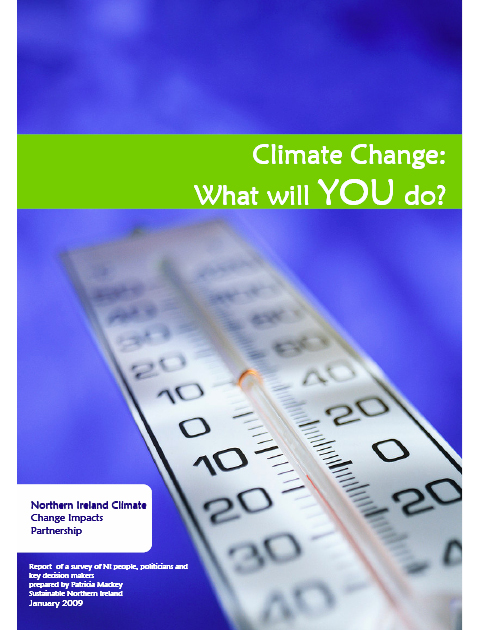


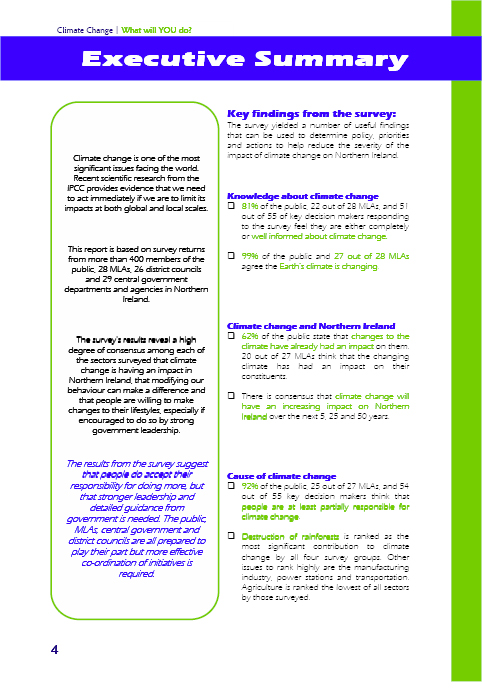
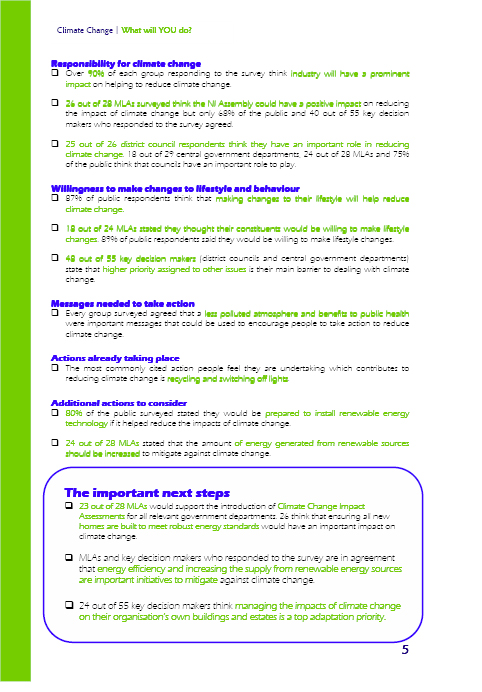

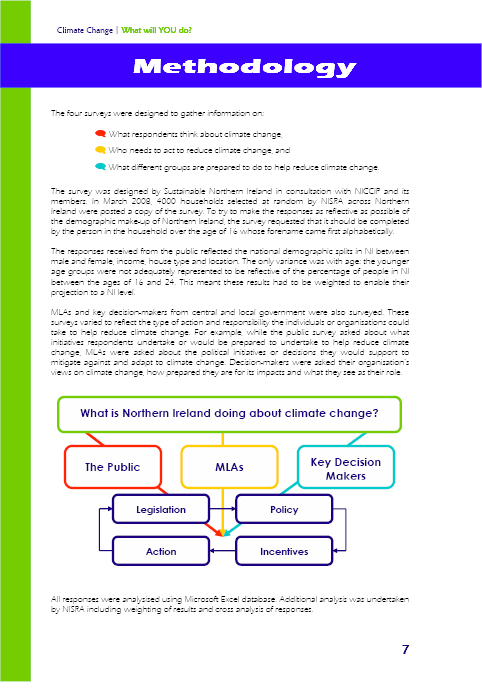

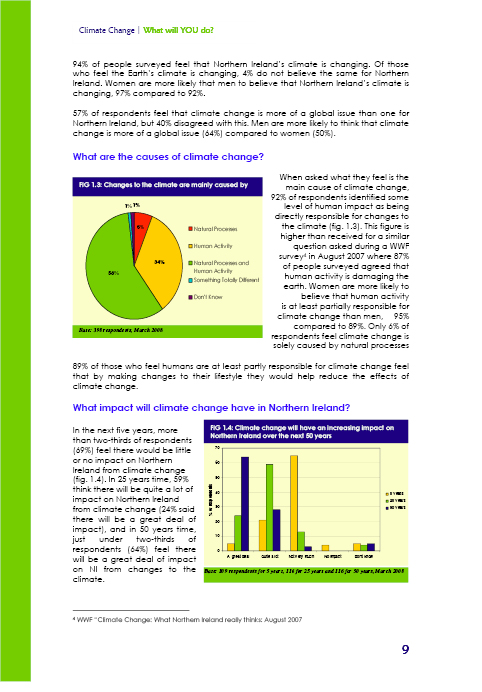


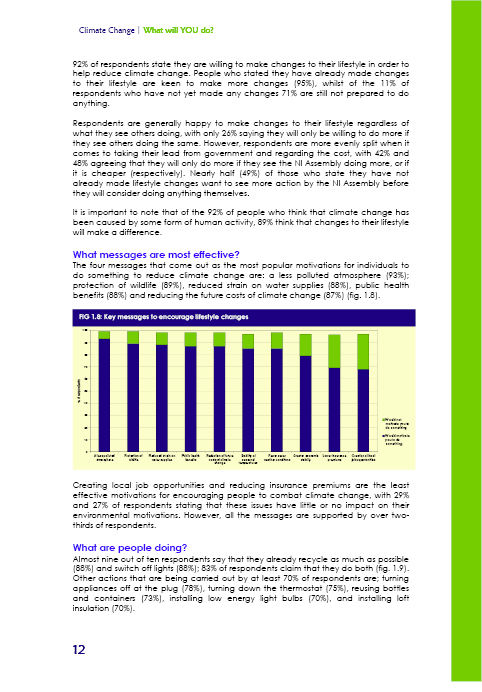

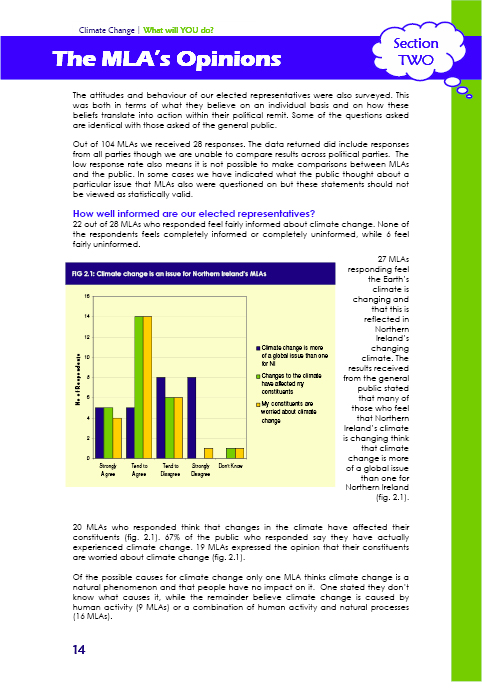

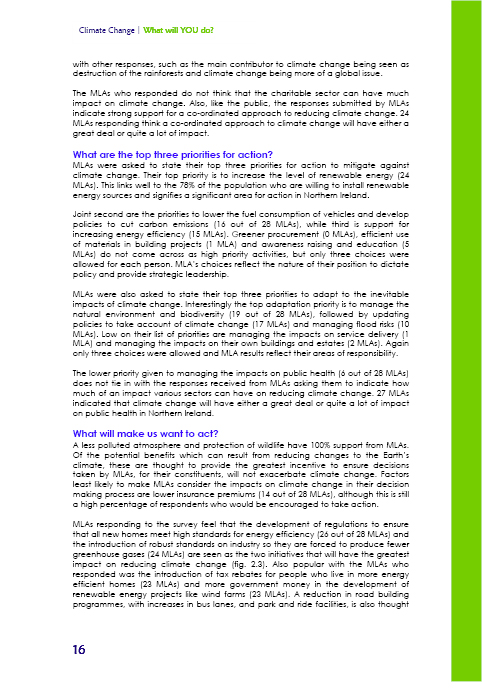



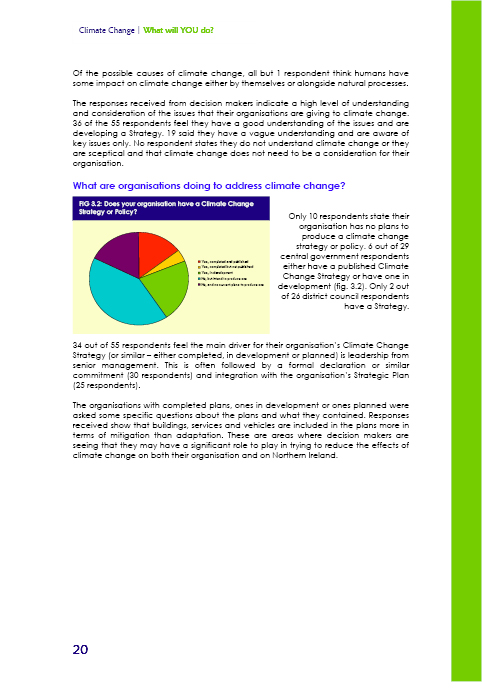

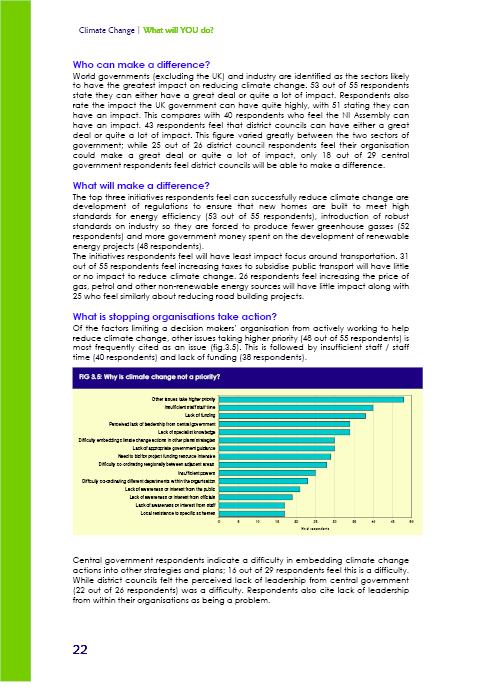
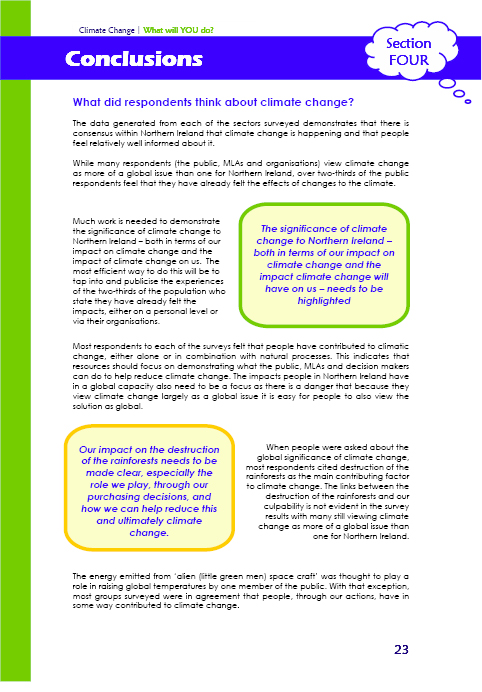
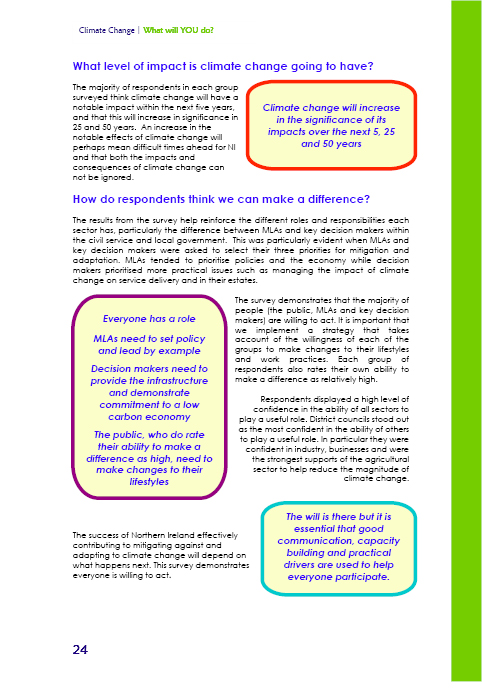





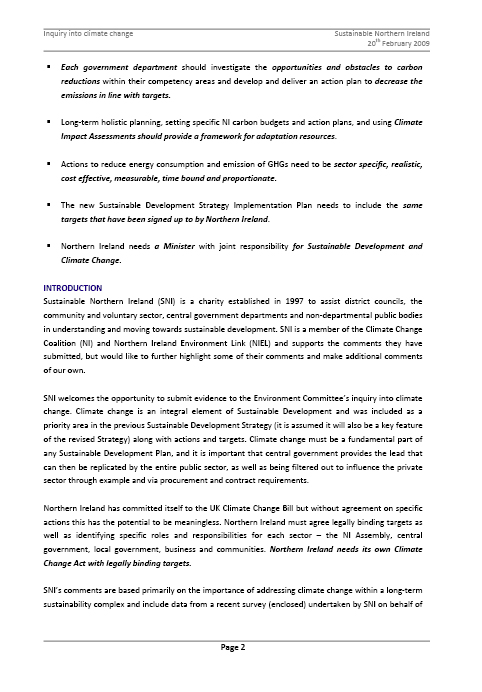
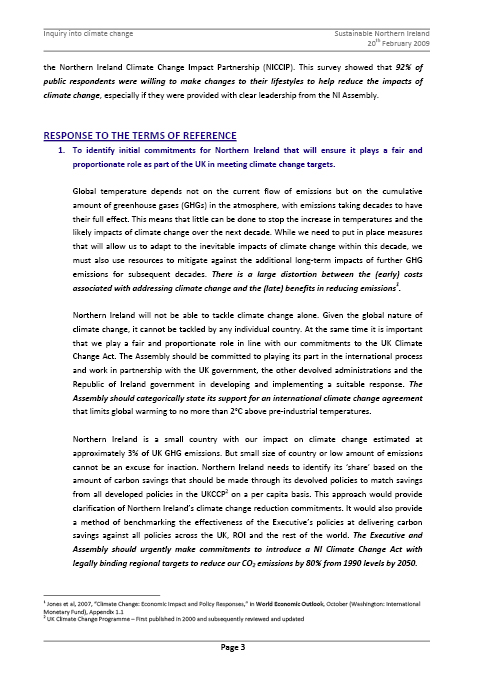



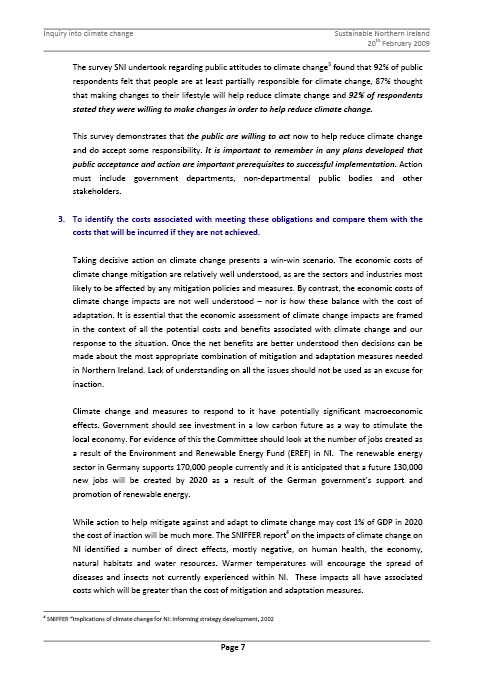
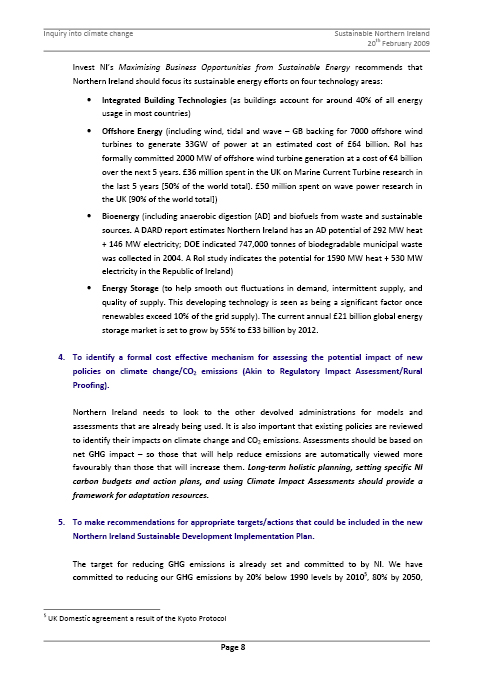

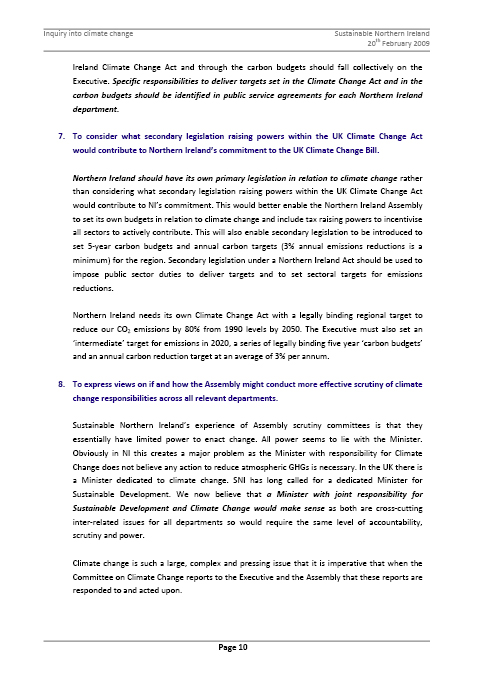
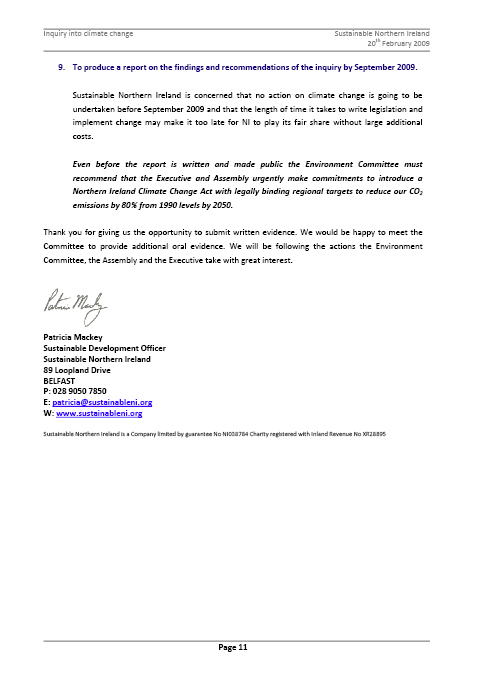
Evidence to the Environment Committee Inquiry into Climate Change - NICVA
As the umbrella representative organisation for the voluntary and community sector in Northern Ireland, the Northern Ireland Council for Voluntary Action (NICVA) has over 1,000 members. Full members, of which there are 914, are independent voluntary and community organisations. NICVA also has 87 subscribers to NICVA services. These include all District Councils in Northern Ireland and some statutory bodies which have an interest in or relationship with the voluntary and community sector.
NICVA is an independent body with charitable status and is a company limited by guarantee. The organisation is owned by its members who elect the board of trustees or Executive Committee. NICVA offers comprehensive advice to member organisations on charity law, funding, finance, personnel and policy matters. With a dedicated communications team, NICVA works to ensure the sector is represented at every level, and that the voice of the sector is facilitated through the media and into the corridors of power.
NICVA works in partnership with other organisations on the issue of climate change, being a member of the NI Climate Change Coalition and the NI Climate Change Impacts Partnership. We note that in 2008 a survey conducted by Sustainable Northern Ireland found that, “92% of respondents were willing to make changes to their lifestyles, especially if encouraged to do so by strong government leadership." We call upon the Committee, the Executive and the rest of the Assembly to provide this leadership.
1.0 Initial commitments for Northern Ireland
The Assembly has accepted that the provisions of the UK Climate Act will be extended to Northern Ireland. However, the UK Act does not set specific emission reduction targets for the devolved administrations. Northern Ireland’s initial commitments should include local, legally binding targets for reducing carbon dioxide emissions by 80% from 1990 levels by 2050, in keeping with the UK legislation. These targets should be contained in a Northern Ireland Act and the Assembly and Executive should clearly state support for an international climate change agreement to limit global warming to no more than 2° Celsius above pre-industrial temperatures, as the scientific consensus recommends.
1.1 The Assembly and Executive should be considering both mitigation (reducing carbon emissions and the slowing of the rate of climate change) and adaptation (preparing for the effects of the changes already happening and those confidently predicted by the available science). Work done on behalf of DOE by the Scotland and Northern Ireland Forum for Environmental Research in 2007 has identified a number of adaptation responses which Northern Ireland should be preparing. These are in the areas of biodiversity and habitats, agriculture, forestry, fisheries, water resources, coastal and flood risk management, buildings, construction and planning, business, insurance, transport, energy and health. All public sector procurement, especially the Strategic Investment Strategy should have robust adaptation components built in.
1.2 The Assembly and Executive must ensure that short-term adaptation actions do not run contrary to longer-term mitigation goals.
2.0 Necessary actions and a route map
In order to reach the long-term targets, intermediary benchmarking targets should be set. In keeping with the existing target in the Programme for Government, the Executive should set an “intermediate" target for emissions in 2020, a series of legally binding five year “carbon budgets" and an annual carbon reduction target at an average of at least 3% per annum. Immediate action is required; it is not sufficient to set long-term targets and act at the last minute as this implies more damaging carbon emissions in the short term and only exacerbates the overall problem. Current estimates are that emissions should peak no later than 2015. A short-term route map could be provided by the action plans to accompany the Sustainable Development Strategy. These plans should be focused on achieving the targets set out in a Northern Ireland Bill. The Committee on Climate Change should be involved in setting benchmarks and targets for Northern Ireland.
3.0 Costs
The Stern Review calculated that the dangers of unchecked climate change would be equivalent to at least 5% of GDP each year possibly rising to 20% of GDP or more. By contrast, the costs of action to reduce greenhouse gas emissions to avoid the worst impacts of climate change can be limited to around 1% of global GDP each year.
3.1 There are also potential benefits to the NI economy in embracing green jobs and technologies, especially in an economic downturn. As NICVA highlighted in its response to the last Programme for Government, the renewables sector in Germany supports 170,000 people and existing German government support measures promoting renewable energy could create 130,000 new jobs by 2020. The Carbon Trust estimates that more than 70,000 jobs could be created in the UK by investing in and developing offshore wind technology and Action Renewables estimate that almost 6,000 short term and 400 long term jobs could be sustained in Northern Ireland, exclusively by developing renewable energy within the region.
4.0 A Public Service Agreement for the Climate Change Unit
The Climate Change Unit in DOE should act as a centre of expertise across government. Its function should be to provide information and support to the other departments to help deliver the targets set in a Northern Ireland Climate Change Act and in the carbon budgets.
5.0 Secondary legislation
The Northern Ireland Executive should introduce its own primary legislation in the form of a Northern Ireland Climate Change Act with a legally binding regional target to reduce our carbon dioxide emissions by 80% from 1990 levels by 2050. Secondary legislation might usefully include a tax on plastic bags as has been introduced in other jurisdictions.
6.0 More effective scrutiny
The Environment Committee should work jointly with other committees to ensure effective scrutiny on climate change actions across all Departments. This scrutiny role could be enhanced by ensuring that the Committee on Climate Change reports to the Executive and the Assembly and that the Executive response to the reports is made in the Assembly.
For further information please contact Frances McCandless, Director of Policy frances.mccandless@nicva.org
NILGA FINAL response to the NI
Assembly Inquiry into climate change
Introduction
NILGA, the Northern Ireland Local Government Association, is the representative body for district councils in Northern Ireland. NILGA represents and promotes the interests of local authorities and is supported by all the main political parties. Climate change is a key issue for local government due to the huge impact it can have on local communities, the economy and sustainability. NILGA is pleased to be able to have an opportunity to comment on the Assembly Environment Committee Inquiry into Climate Change and we trust that our comments will be taken into account when developing an assembly position on the matter. For further information regarding this response, please contact Karen Smyth, Head of Policy at NILGA on (028) 9079 8972 or at k.smyth@nilga.org
Summary
Local government work on issues relating to climate change is ongoing. From our experiences and the work that has already taken place, particularly on a local government declaration on climate change, we would summarise our views as follows:
- The proposed Declaration on Climate Change to be signed by Councils has not proceeded, due to a lack of support from government, and due to a lack of resources to implement such a document within local government.
- There is an urgent need for a ministerial champion to be appointed to take the climate change issue forward working within either a climate change interdepartmental working group or a sustainable development working group.
- In the current economic crisis savings could be made throughout the population and in particular by those suffering fuel poverty, if there was a clear and coherent strategy to address this issue.
- A budget should be set aside to develop a communication strategy on climate change and sustainable development to ensure that the general public understands the issues and the necessity to take action.
Background and Targets
NILGA is aware that in January 2007, as part of an integrated climate change and energy policy, the European Commission set out proposals and options for an ambitious global agreement in its Communication “Limiting Global Climate Change to 2 degrees Celsius: The way ahead for 2020 and beyond". EU leaders endorsed this vision in March 2007. They committed the EU to cutting its greenhouse gas emissions by 30% of 1990 levels by 2020 provided other developed countries commit to making comparable reductions under a global agreement. To start transforming Europe into a highly energy-efficient, low-carbon economy, they committed to cutting emissions by at least 20% independently of what other countries decide to do.
The 30% carbon dioxide reduction target is mirrored by the UK Climate Change Bill which aims to introduce UK targets to reduce carbon dioxide emissions by at least 60 per cent by 2050 and 26-32 per cent by 2020, against a 1990 baseline. The Republic of Ireland Climate Change Strategy 2007-2012 states that under the Kyoto Protocol, the Republic of Ireland must limit the growth in emissions to 13% above the 1990 levels in the 2008- 2012 period. The strategy recognises, however, that the EU has adopted a much more challenging reduction target for 2020 and while Ireland’s precise contribution within this new framework has yet to be agreed, it will require a reduction to below its 1990 emission levels.
It is the NILGA view that the targets for Northern Ireland should be proportional and appropriately related to the EU targets.
Nilga Work on Climate Change
NILGA has been at the forefront of local government work on climate change, both at a national and regional level. We ensured that councils in Northern Ireland communicated with the Local Government Climate Change Commission, whose work culminated in the production of the report “A Climate of Change" available at http://www.lga.gov.uk/lga/aio/20631.
NILGA has also been a key player in the Northern Ireland Climate Change Impacts Partnership, chaired by Douglas McIldoon, from whom you will have received a separate response. As part of our work within NICCIP, NILGA has drafted a local government declaration on climate change (attached – Appendix A) which is similar to the Nottingham, Scottish and Welsh declarations, giving suggested aims, objectives and targets for local government up to 2025. This declaration is designed to be signed jointly by the Minister for Environment and the Mayors/Chairs of the 26 district councils.
NILGA Project: Achieving Sustainable Councils
Whilst developing a climate change declaration for Northern Ireland, similar to the Nottingham declaration it became apparent that the local authorities in Northern Ireland lack the capacity, technical expertise and funding to deliver adequately on the key elements such a declaration would contain. To ensure appropriate delivery of the declaration, it was identified that a comprehensive support structure would be required, providing:
- Additional capacity
- Access to technical support
- A logical sequence of steps to enable delivery
- Resourcing to stimulate action and investment in new technologies
- Networking opportunities to enable sharing of best practice
- Mechanisms for community involvement, to stimulate change at individual level.
Representatives of the subgroup widened this discussion and contacted government and council representatives in the Republic of Ireland, who identified similar issues and needs. Given that climate change is an issue ‘blind’ to borders, and that many of the difficulties that are likely to be experienced in the future will be similar, North and South of the border, it was agreed that a strategic local government project on climate change should be pursued on a cross-border basis, to enable greater public sector collaboration in developing a more sustainable future for the island of Ireland.
The key need identified was to improve the resource use efficiency of local government and local community groups and in doing so, reduce the carbon footprint of local councils and the communities they serve.
It was established that no resource would be forthcoming from the Republic of Ireland, UK or Northern Ireland Assembly governments to fund this work. It was also established that some work was being done on behalf of Department of Environment, Heritage and Local Government in the Republic of Ireland that could be built upon to enable local government, North and South to work towards meeting this key need.
In addition to the pure environmental issues, during the next three years, councils in Northern Ireland will be grouping together as set out in the NI Review of Public Administration policies. Each group of councils will be required to begin to work together to develop unified policy, strategy and practice, and to take on new functions such as Planning. The vital preparation time between 2009 and 2011 allowing councils to modernise, build capacity and improve service delivery for the benefit of the citizen, was viewed by the declarations sub-group as a strategic opportunity to build sustainable development principles and working into the corporate policy and practice of the new councils. The ASC project will enable the development of a collaborative approach on climate change and sustainable development issues whilst the new Northern councils are being developed, and it will also give the eligible county councils an opportunity to forge sustainable working relationships with the new structures in the North, which will be vitally important for ongoing cross-border working.
NILGA has been unsuccessful in obtaining funding via INTERREG for this work, but the project identified provides a viable methodology for taking climate change and carbon reduction work forward within councils and communities in Northern Ireland. Our suggested project was estimated to cost almost £4m over 3 years. A summary of the proposed project is attached (Appendix B).
Other Examples of Local Government Best Practice
Two examples of how local government can be effective in tackling issues such as climate change and sustainability at a local level are:
1. The STEM Project – This project involved 9 councils and the Southern Group Environmental Health Committee working together to identify and address environmental issues, both within the councils and in businesses in each of the council areas. Each council and 284 businesses implemented an Environmental Management system, and over 10,000 employees were trained on environmental issues during the course of the project. The project was included in the Sustainable Development Strategy for Northern Ireland as an example of Best Practice and has won many awards in recognition of its success.
2. The Community Eco- Challenge Project - By helping community organisations measure and take action to reduce their ecological footprint, this project brought the issue of sustainability to the home. Having identified the benefits of this approach the Assembly Environment Committee have arranged a visit on the 12th March to see how it is operating on the ground.
Mitigation and Adaptation
NILGA is of the view that although it is completely necessary to mitigate against climate change, and has proposed the ASC project to assist in doing so; for local government and other public service delivery organisations, the main challenges will be seen to involve adaptation. NILGA would therefore particularly endorse the NICCIP comments to the Environment Committee on adaptation. Government needs to plan for change and to ensure that the citizens of Northern Ireland are adequately protected in the face of the challenges we face as a result of climate change. NILGA would recommend that the Environment Committee examine the valuable work of the UK Climate Impacts Programme in this area, and make recommendations to the Assembly to take this work into account when planning any future development.
It is vital that adaptation measures are also built into the programme for government, and that adequate resources are provided for this work. At present NILGA is of the view that emergency management, and particularly that done by local government, is under-resourced. The emergency management role of local government will grow after the reform of local government and it will be key to protecting public safety to resource this role properly.
A Climate Change Strategy for Northern Ireland
The Assembly departments will need to ensure that any future development can withstand the challenges climate change will bring, and will need to protect existing development. This will impact on each and every government department and it will be necessary to develop and implement a strategy to ensure that all policy brought forward by government is ‘proofed’ for climate change, mitigation and adaptation.
It has been the experience of local government that the Sustainable Development Strategy has not delivered. There has been little implementation, with sustainable development issues frequently put in the ‘too hard’ box. Local government is still waiting on adequate and appropriate guidance as to how it should implement the statutory duty introduced within that strategy. There is no point introducing a strategy that will not be implemented, and it will be critical to the success of any NI Climate Change Strategy to ensure that all stakeholders are aware of their responsibilities and enabled to perform these.
A review of all existing government strategies needs to take place to ensure that climate change is taken into account. For example, there is no mention of climate change in the existing waste management strategy, even though the targets expressed within it are a direct result of EU climate change policy, and the raison d’etre of landfill diversion is the reduction of greenhouse gases.
Working across Departments
It is the experience of NILGA that government finds working on cross-cutting strategies particularly challenging. This has been amply demonstrated by the waste strategy and the sustainable development strategy. To ensure the success of such strategies, it is vital to have cross-governmental ministerial oversight. There must be ministerial pressure to perform, and an appropriate level of buy-in from officers.
We have witnessed the resolution of particularly difficult issues (such as PPS14) through joined-up Ministerial working and although this is encouraging, for issues on which there is less pressure from the electorate in an environment where constitutional politics usually takes precedence, it has been the case that implementation of particularly complex issues (such as sustainable development) have fallen by the wayside.
It will be extremely difficult to take any work on climate change forward without a ministerial ‘champion’.
Funding
As evidenced by the work NILGA has done on preparing the ASC project, local government is seeking innovative ways of obtaining funding for work on climate change. It is our experience that those councils who have started along the road of monitoring energy use and reducing their carbon footprint have quickly saved large amounts of money, enabling them to pay for the officers they have employed (e.g. Ballymena Borough Council).
It is likely that with a regional governmental approach to climate change, after the quick wins that will initially be experienced, a resource will need to be made available, that is strategically targeted to those areas we need to do most work on.
Adequate and appropriate research must be done on how NI can reduce its carbon footprint and what needs to be done to implement any climate change strategy. There is a need to prioritise work, and to support our universities to develop new technologies. There is a huge economic development opportunity linked to work on renewable and sustainable technology, and no reason why NI cannot become a world leader in this area.
Sources of Information
The following sources of information were used when researching the ASC project and the Committee may find them useful.
EU Climate Change Policy
In January 2007, as part of an integrated climate change and energy policy, the European Commission set out proposals and options for an ambitious global agreement in its Communication “Limiting Global Climate Change to 2 degrees Celsius: The way ahead for 2020 and beyond"
EU leaders endorsed this vision in March 2007. They committed the EU to cutting its greenhouse gas emissions by 30% of 1990 levels by 2020 provided other developed countries commit to making comparable reductions under a global agreement. And to start transforming Europe into a highly energy-efficient, low-carbon economy, they committed to cutting emissions by at least 20% independently of what other countries decide to do.
In line with the Strategic EU Energy Review, the EU will ensure a significant reduction of greenhouse gas emissions in the EU by 2020 by:
- Improving the EU’s energy efficiency by 20 % by 2020.
- Increasing the share of renewable energy to 20 % by 2020.
The need to improve resource use efficiency in all sectors of society is identified by the EC Thematic Strategy on the Sustainable Use of Natural Resources.
(available at http://ec.europa.eu/environment/natres/) which sets as its key objective ‘to reduce the negative environmental impacts generated by the use of natural resources in a growing economy’.
Scotland and Northern Ireland Forum for Environmental Research
“Review of Climate Change Mitigation Tools for Local Authorities", available at: http://www.sniffer.org.uk/
The report highlighted a number of ways in which policy makers and local authorities could strengthen the development of tools to address climate change. In particular there is a need for:
Tools which clearly explain how they can help local authorities deliver specific climate change commitments;
Consistent standards and verification of local authorities used to inform local emissions’ baselines;
Strengthened tools and support for local authorities’ ‘climate change-proofing’ of strategies, plans and programmes;
More ‘hand-holding’ support for local authorities who are embarking on developing climate change strategies and action plans; and using tools to do so;
Opportunities and mechanisms for local authorities to share their experience in developing responses to climate change and using tools.
Sustainable Development Commission
“I will if you will - Towards sustainable consumption", available at:
http://www.sd-commission.org.uk/publications.php
The report stresses the need for collective action across all sectors if society is to move towards a more sustainable future. The NILGA ASC project will not focus solely on one group or collection of organisations. Through working with local councils to reduce the carbon footprint of the councils and with community groups, greater reductions in climate change impacts in the participating areas will be delivered compared to if a single area or sector was targeted.
The report stresses that ‘four areas of our lives generate four-fifths of our overall impact on the environment around us: how we run our homes; the food we eat; how we get around; and how we travel on our holidays’ (page 2). The carbon footprinting exercise involving local community groups will discover the areas of activity that contribute most significantly to the carbon footprints of local people in the participating areas and participants will be provided with the skills to affect behavioural changes in their own lifestyles in accordance with the outcome of the carbon footprinting.
“An Independent Review of Sustainable Development in the English Regions", available at:
http://www.sd-commission.org.uk/pages/localgovt.html
This study emphasised that the English regions have a crucial part to play in advancing sustainable development in England as important policies are developed, decisions taken, and resources deployed in the regions. The document asserts regions should have an important role in helping to deliver the four shared priorities for UK Sustainable Development strategy:
- Sustainable Consumption and Production
- Climate Change and Energy
- Natural Resource Protection and Environmental Enhancement
- Sustainable Communities.
The study found the lack of consistent leadership at the regional level to be a major obstacle to the delivery of sustainable development in the English regions. In most regions no single body is acting as the lead advocate for delivering sustainable development principles and priorities. The ASC project will help overcome this obstacle in Northern Ireland and the 6 Republic of Ireland border councils, enabling NILGA to work as lead partner, providing leadership and facilitating the delivery of sustainable development principles throughout local councils and local community groups.
“Inspiring a Sustainable Local Future", available at: http://www.sd-commission.org.uk/publications.php?id=364
This report highlights a number of common barriers to effectively implementing sustainable development at a local government level. The barriers identified in the report are shown below, along with the ways in which the NILGA ASC project will overcome these barriers.
World Wildlife Fund
“The Right Climate for Change", available at: http://www.wwflearning.org.uk/localmatters/resources/climate-for-change,1348,AR.html
The report highlights that transition towards a low-carbon economy requires a fundamental change in the way climate change is tackled at a local level. This change not only requires local government to minimise the impact of their service delivery on climate change but also to encourage behavioural change amongst local communities. The report highlights that the average UK local authority produces at least 30,000 tonnes of carbon dioxide per year, whilst the average council area has a carbon footprint of over 1.5 million tonnes. The ASC project will offer local councils the opportunity to fulfil their responsibility to ‘get their own house in order’ by providing support, training and resources to reduce the size of the council carbon footprint. The project will also undertake work with local communities to affect behaviour change and reduce the carbon footprints of communities living within the council area.
HM Treasury
“Stern Review on the economics of climate change", available at
http://www.hm-treasury.gov.uk/independent_reviews/stern_review_economics_climate_change/stern_review_Report.cfm
The 2006 Stern Report highlights the economic consequences of failing to reduce the climate change impacts of our current behaviour. The review estimates the costs of climate change will be equivalent to losing 5% of global GDP each year, now and forever. If a wider range of risks and impacts is taken into account, the estimates of damage could rise to 20% of GDP or more. The worst impacts of climate change can be substantially reduced if annual emissions of greenhouse gases can be brought down to more than 80% below current levels. The ASC project will develop an evidence base of the climate change impacts of local government resource consumption, indicating where improvements in resource consumption can be made whilst maintaining optimum service delivery to all citizens.
NI Office of the First and Deputy First Minister
“First Steps Towards Sustainability; A Sustainable Development Strategy for Northern Ireland", available at: http://www.ofmdfmni.gov.uk/sustain-develop.pdf
In aiming to improve the efficiency of resource consumption in Northern Ireland and progress towards an environmentally sustainable future, the Northern Ireland Sustainable Development strategy sets the following objectives:
- Northern Ireland to become 85% resource efficient by 2025:
- Stabilise the Northern Ireland Ecological Footprint by 2015 and reduce it thereafter
- Reduce greenhouse gas emissions by 25% below 1990 levels by 2025
- From 2007 reduce consumption of electricity in Northern Ireland by 1% annually until 2012
- Beyond 2025, 40 % of all electricity consumed in Northern Ireland to come from indigenous renewable sources – 25% non wind.
Delivery of the ASC project’s objectives will contribute to meeting each of these targets for Northern Ireland.
ROI Department of the Environment, Heritage and Local Government
“National climate change strategy 2007-2012", available at:
http://www.environ.ie/en/publicationsdocuments/filedownload,1861,en.pdf
Ireland, as a member state of the EU, is committed to the Kyoto Protocol and must therefore limit the growth in missions to 13% above the 1990 levels in the 2008-2012 period. Whilst Ireland’s precise contribution within this new framework has yet to be agreed, it is likely to require a reduction to below the 1990 levels.
The purpose of this Strategy is twofold:
1. To show clearly the measures by which Ireland will meet its 2008-2012 commitment; and
2. To show how these measures position Ireland for the post-2012 period, and to identify the areas in which further measures are being researched and developed to enable them to meet the 2020 commitment.
The Strategy shows, sector by sector, that the range of existing and additional measures which have already been developed, will reduce Ireland’s greenhouse gas emissions by over 17 million tonnes (Mt) of CO2 equivalent in the period 2008-2012.
Sectors identified and explored in detail in this report are as follows:
1. Energy Supply
2. Transport
3. Residential
4. Industry, Commercial and Services
5. Agriculture, Land-use and Forestry
6. Waste
7. Public Sector
Local authorities are specifically mentioned in this Strategy as they can have a significant influence over emissions in their local areas, both directly through reducing emissions from their own energy use and procurement activities, in raising awareness and stimulating action in local communities, and indirectly through the exercise of their housing planning and other statutory functions.
LGA Commission on Climate Change report
A Climate of Change: Final report of the LGA Climate Change Commission
http://www.lga.gov.uk/lga/publications/publication-display.do?id=20630
Two key recommendations made in the LGA report which have impacted upon the structure of the ASC Project are as follows:
1. By December 2008, all councils should have signed the Nottingham Declaration and published a climate change strategy and action plan. These plans should include measurable and quantifiable milestones at 2010, 2015 and 2020.
2. All councils must undertake a climate change impact assessment of all major policy, planning and investment decisions, screening decisions to ensure that they are systematically lowering carbon emissions and ensuring that all decisions are resilient to climate change.
The ASC project requirements for councils to sign the Climate Change Declaration and develop a carbon reduction action plan are guide by these recommendations.
Welsh, Scottish and Nottingham Declarations
The Welsh Declaration on Climate Change and Energy Efficiency recognises that local authorities need to play their full part at local level, leading and delivering the Welsh response to climate change within the UK Climate Change Programme.
The declaration welcomes the opportunity for local authorities to lead the response at local level by helping encourage local residents and businesses to reduce their energy costs, reduce transport congestion, and improve the local environment and to deal with fuel poverty within communities.
Additionally, the declaration allows local authorities to make a public declaration, in line with agreed targets, to:
- Deliver a significant reduction in greenhouse gas emissions;
- Improve energy efficiency in greenhouse gas emissions; and
- Increase the use of ‘green’ energy from renewable sources.
The Welsh Climate Change Declaration is available at:
http://www.wlga.gov.uk/english/meeting-documents/a-welsh-declaration-on-climate-change/
Scotland’s Climate Change Declaration is similar to the Welsh Declaration on Climate Change and is signed by each Council Leader and Chief Executive, committing to actions such as encouraging and working with others in the local community to take action to adapt to the impact of climate change, to reduce their own greenhouse gas emissions and make public their commitment to action.
The Scottish Climate Change Declaration is available at:
http://www.sustainable-scotland.net/climatechange/
The Nottingham Declaration also recognises the crucial role local authorities have to meet national targets for reducing emissions and adapting to climate change. By signing this Declaration, councils can show their commitment to this important issue by pledging to actively tackle climate change. So far, over 200 local authorities have signed the Declaration.
The Nottingham Climate Change Declaration is available at:
http://www.energysavingtrust.org.uk/housingbuildings/localauthorities/NottinghamDeclaration
Fuel Poverty
The UK Warm Homes and Energy Conservation Act 2000 placed a statutory duty on the Westminster Government to eradicate fuel poverty by 2016. This Act was adopted by the NI Assembly and Eradicating Fuel Poverty: A Strategy for Northern Ireland was produced in 2004. This strategy proposes to eliminate fuel poverty for vulnerable households by 2010 and for all households by 2016. Northern Ireland has a very high rate of fuel poverty compared with the rest of the UK and the ASC project aim of improving resource use within local community groups in Northern Ireland will contribute to lowering rates of fuel poverty in Northern Ireland.
In the Republic of Ireland, no government department adopts specific lead responsibility for coordinating actions to tackle fuel poverty. Despite the absence of an over-riding fuel poverty strategy or dedicated government unit, the fuel poverty issue is considered within a number of government documents:
- The Energy Policy Framework 2007-2010 commits to ‘systematically address fuel poverty in an era of increased fuel prices’. The National Action Plan for Social Inclusion 2007-2016 is named the main instrument of delivery.
- The National Action Plan for Social Inclusion 2007-2016 emphasises proposed developments by the Department of Social and Family Affairs in respect of social welfare payments and increases in budget allocation to local authorities to improve heating in rented dwellings. Funding for the Warmer Homes Scheme and to support fuel poverty research through the work of Sustainable Energy is also proposed.
NILGA Interreg IVA Climate
Change Bid Summary
NILGA has developed a Local Government Climate Change project proposal which was submitted for funding under the Interreg IVA project. The following information has been adapted from the application, however, this is a work in progress and some detail may be subject to change. We are expecting a decision on the bid in late February 2009.
Project Summary
The Achieving Sustainable Councils (ASC) project will engage the 26 district councils in Northern Ireland and 6 county councils in the Republic of Ireland in a proactive programme to improve the environmental sustainability of council services and their communities with the aim of contributing to the national and international climate change objectives and global sustainability. Councils will identify the climate change impacts of council activity and develop action plans to target for improvement the areas that will most readily enhance environmental sustainability, contributing to the long term goal of achieving carbon neutral local government in Ireland. Local communities will be engaged in capacity building and practical projects to provide citizens with the necessary resources knowledge and skills to enable behavioural change that will reduce the climate change impacts of citizens’ lifestyles.
General Objectives
A joint development committee will be formed to oversee delivery of the project and ensure the input of key agencies, statutory bodies, participating councils and project funders.
As lead partner, NILGA will recruit a project manager and 12 project officers to implement the project.
Council Focused Objectives
Councils will be invited to join the project through a marketing programme highlighting the benefits of participating and the commitment required during participation. Deadlines will be given for inclusion within the project to enable delivery within the funding deadlines.
Participating councils will be required to sign up to the Local Government Declaration on Climate Change. Supporting the declaration will commit local government to work with regional and central government, to contribute at a local level, to the delivery of the National Climate Change Programmes and participate in local, regional and cross-border networks for support and sharing of best practice. This is aimed at ensuring top level management and elected member commitment to the projects aims and objectives. The declaration will also require the identification of an in-house project champion from each Council and the development of an internal delivery sub-committee chaired by a nominated elected member. At this stage the Council will be asked to adopt a climate change approach to community development functions.
The 26 district councils in Northern Ireland will participate in accordance with the Review of Public Administration Boundary groupings. Therefore the 26 district councils will form 11 groups. These 11 groupings will work collaboratively with the 6 County Councils in the Republic of Ireland towards achieving the project aim of reducing the carbon footprint of local government in Ireland.
Project officers will establish a working partnership with an in-house project champion for each of the council groupings.
Project officers will conduct baseline studies for the individual councils in each of the groupings to determine the carbon footprint of each local council and the climate change impacts caused by the delivery of council services. The baseline studies will examine:
- Electricity consumption
- Transport (including air travel)
- Fuel consumption including heating oil and gas
- Energy efficiency of council property
- Waste Quantity and disposal
- Water Usage
Each council grouping will be required to develop an action plan to target for improvement the areas of activity identified by the carbon footprint analysis where enhancements in energy efficiency will most readily lead to a reduction in the size of the council’s carbon footprint. Prioritisation of options for carbon reduction will be based on project scale, carbon reduction potential, cost/payback, potential for direct control, PR potential and demonstration value. Financial resources of £20,000 will be provided to each council to be used undertake carbon minimization activities for council activities and service delivery.
Additional projects will be run, one in each of the following areas:
- Electricity consumption
- Transport
- Fuel consumption including heating oil and gas
- Energy efficiency of council property
- Waste Quantity and disposal
- Water Usage
Calls for innovative projects in each of the above areas will be tendered by NILGA and the council groupings will be encouraged to develop project proposals and submit applications for additional resources to deliver these projects. £500,000 will be ring-fenced for resourcing innovative projects in these areas.
The project will rely heavily on opportunities to network and share best practice. Regional cluster meetings for the participating council groupings will be held quarterly and a multi-council conference on climate change and local solutions to address global problems will be held during the lifespan of the project.
Each council grouping will be required to evaluate the programme delivery and communicate a state of the environment report and progress against the action plan for each council to elected members, council committees, officers and other councils.
Community Focused Objectives
Project officers will provide training for Community Development departments across Councils, educating officers on issues relating to climate change and the opportunities for community development to address these.
A review will be undertaken identifying opportunities within existing community development plans, proposed action plans, priority areas and community networks within the area which may be engaged in programmes aimed at improving the sustainability of the wider Borough.
Community Groups will be invited to join the project through a marketing programme highlighting the benefits of participating and the commitment required during participation. Deadlines will be given for inclusion within the project to enable delivery within the funding deadlines.
Project officers will hold an event in each council grouping area for community representatives. Representatives will be given a demonstration of the carbon foot-printing tool and the benefits of assessing the community carbon footprint in order to identify key areas for improving the efficiency of energy and resource use will be communicated to participants.
Project officers will conduct the carbon foot-printing analysis for participating community groups. Groups will be assisted in developing actions to reduce the size of their community carbon footprint based on the outcome of the footprint analysis. Community groups will receive training on how they may reduce the climate change impact generated by everyday activities. Issues examined will include:
- Transport (including air travel)
- Electricity use
- Fuel use for heating
- Energy efficiency of housing
- Food consumption
- Waste production
- Purchasing
Community groups will have access to financial resources of £15,000 per council area through the project to seed fund activity programmes and stimulate change.
To facilitate sharing of experiences and best practice, regional cluster meetings for the participating community groups will be held quarterly and a multi-council conference on climate change and local solutions to address global problems will be held during the lifespan of the project.
Each community Group participating will be required to evaluate, with assistance from project officers, the effectiveness of the actions taken to reduce the size of the community’s carbon footprint. The reports produced will be presented to the respective local councils.
The Draft Northern Ireland
Local Government Declaration
on Climate Change
We acknowledge that:
- Evidence shows that climate change is occurring.
- Climate change has begun to and will continue to have far-reaching effects on people and places, economy, society and environment in Northern Ireland and the planet as a whole.
We welcome the:
- Social, economic and environmental benefits which come from combating climate change.
- Emission reduction targets agreed by central government and the programme for delivering change, as set out in the UK Climate Change Programme.
- Opportunity for local government to lead the response at a local level, encouraging and helping local residents, local businesses and other organisations - to reduce their energy consumption, to adapt to the impacts of climate change, to improve the local environment and to help deal with fuel poverty in our communities.
- Endorsement of this declaration by the Northern Ireland Executive.
We commit our Council from this date to:
- Work with regional and central government, to contribute at a local level, to reduce greenhouse gas emissions by 25% below 1990 levels by 2025 as outlined in the Programme for Government for Northern Ireland.
- Participate in local, regional, cross-border and European networks for support and sharing of best practice.
- Within the next three years develop action plans with our partners and local communities to progressively address the causes and the impacts of climate change, according to our local priorities, securing maximum benefit for our communities.
- Publicly declare, within appropriate plans and strategies, the commitment to achieve a significant reduction of greenhouse gas emissions from our own authority’s operations, especially energy sourcing and use, travel and transport, waste production and disposal and the purchasing of goods and services.
- Assess the risk associated with climate change and the implications for our services and our communities of climate change impacts and adapt accordingly.
- To educate promote and encourage all sectors in our local community to take the opportunity to adapt to the impacts of climate change, to reduce their own greenhouse gas emissions and to make public their commitment to action.
- Monitor the progress of our plans against the actions needed and publish the result.
Council acknowledges the increasing impact that climate change will have on our community during the 21st century and commits to tackling the causes and effects of a changing climate on our council area.
NIIRTA Submission to the
Northern Ireland Assembly
Environment Committee on their
enquiry into Climate Change
February 2009
The Northern Ireland Independent Retail Trade Association has over a 1000 members from the independent retail grocery and food sector in Northern Ireland who generate in excess of £1 billion turnover every year and employ over 20,000 staff.
We very much welcome the opportunity to submit evidence on this subject.
Northern Ireland is a small business economy with 98% of all business classified as ‘small’. The independent retail sector is the biggest sub-sector of that economy and plays a crucial role as the backbone of the private sector. In addition, NIIRTA is also a socially responsible organisation who through its members strives for a sustainable future in terms of social, ethical and environmental factors.
Climate change is the greatest environmental challenge facing the world today (Blair, 2006). It is widely accepted that emissions of greenhouse gases, like carbon dioxide and methane, from human activities are causing global warming and a change in the earth’s weather patterns. The main human influence on global climate is emissions of the key greenhouse gases - carbon dioxide (CO2), methane and nitrous oxide. At present, just over 7 billion tonnes of CO2 is emitted globally each year through business and consumer use of fossil fuel (DEFRA, 2009).
The commitment of business and the public sector to tackling climate change is growing in the UK (DEFRA, 2009). For example, recent research from the Friends of the Earth has highlighted the fact that independent retailers and local shops are extremely energy efficient and strive to minimise their impact on the environment (FOE, 2007).
Therefore, NIIRTA is committed in helping the UK Government and the NI Executive achieve its targets to climate change through 5 main proposals which are:
1. Publish PPS5
2. Promote local town centre shops therefore reduce car usage for shopping
3. Promote SMEs who are sourcing food locally and reducing food miles
4. Food miles should be labelled
5. Reduce packaging
1. Publish PPS5
The publication of PPS5 has many environmentally friendly benefits. The actual shops in which independent retailers trade out of have usually a small square footage as they are generally town centre locations (Independent, 2006). Owing to this, research has highlighted that independent retailers emit less carbon dioxide than larger multiple owned outlets (FOE, 2005). For example, the average greengrocer emits on average three times less carbon dioxide per square foot compared to a large multiple retailer (FOE, 2005).
Moreover, Sheffield University found that large superstores are the most energy inefficient buildings in the retail industrial sector (BBC, 2007). Therefore it can be argued that to help tackle climate change local government must revise the planning laws within Northern Ireland, as the devastation caused from out of town retailing cannot be underestimated.
2. Promote local town centre shops therefore reduce car usage for shopping
Recent work for DEFRA suggests that car use for food shopping results in costs to society of more than £3.5 billion per year, from traffic emissions, noise, accidents and congestion (DEFRA, 2005) and cars are responsible for 20 per cent of the UK’s CO2 emissions from food transport.
On the other hand, Friends of the Earth (2007) have highlighted that the average independent retail store is more likely to be visited on foot by its customers, therefore reducing car usage and in turn carbon emissions. As a result of this, it is important that Government encourages consumers to use town centre shops as this will enviably reduce car usage for shopping.
Furthermore, it must be considered that 26% of households in Northern Ireland don’t have access to a car (DRDNI, 2007) hence, public transport is an important element of shopping in Northern Ireland and Government must help ensure that it meets the needs of consumers.
3. Promote SMEs who are sourcing food locally and reducing food miles
Agriculture, processing, storage of products and the way consumer’s shop all have to be factored into the bigger carbon emissions picture. Most importantly, the UK is still generating higher levels of carbon dioxide emissions from transporting foodstuffs than any of the other European countries, (European Commission, 1999).
The term ‘Food Miles’ has been created to describe this phenomenon which refers to the distance food travels from field to plate (BBC, 2004). To paint a picture of the amount of food miles generated in the UK, it is appropriate to highlight that half the vegetables and 95 per cent of the fruit eaten in the UK comes from beyond our country (BBC, 2008). Food transport is responsible for 25 per cent of the miles travelled on UK roads (Sustainable Food, 2008).
Furthermore, Young (2004) stated that local produce generates much less carbon emissions than produce from foreign countries (e.g. food from Mexico emitates 5,278 kg of CO2 compared with only 17 kg if the food is sourced locally).
Therefore, it is imperative that local government must look at the issue of food miles within the bigger picture of climate change. It is clear that local retailers in Northern Ireland play their part in reducing food miles and sourcing food locally however, Governement must encourage all retailers in Northern Ireland to follow the example of local independent retailers and source more products locally, not just food but all aspects of retail.
4. Food miles should be labelled
From the aforementioned points, another recommendation for government is to label food with the amount of food miles travelled to help consumers make an informed decision on their food. Moreover, it will also encourage retailers to source locally to meet the demands of consumers.
5. Reduce packaging
Furthermore, local retailers significantly reduce their carbon footprint by the way they pack their produce. Packaging makes up nearly a quarter of household waste, and 70 per cent of it is food related (INCPEN, 2001). In contrast, buying fruit and vegetables from independent shops can produce an estimated 75% less waste in terms of packaging and food waste (Soil Association, 2003).
For instance a independent grocery retailer‘s fresh produce is often sold loose therefore cutting down on the amount of packaging used. In addition, research has emphasised that a higher proportion of their packaging is recyclable (LGA). Government must ensure that all retailers in Northern Ireland follow the same example set by independent retailers and cut down on packaging and plastic bags to ensure an environmentally friendly retail landscape.
Conclusion
From the aforementioned points, it is clear that independent retailers in Northern Ireland are significantly contributing to the fight against climate change. However, there is no debate that more needs to be done from all dimensions of society.
Therefore it is vital that PPS5 be produced immediately to stop the influx of out of town retailing so that shops are located in town centres thus becoming more environmentally friendly.
Finally, Government must think strategically about climate change. Independent retailers must be commended for their contribution to ecologically aware practices and used as an example of good practice across the board.
Glyn Roberts
Chief Executive
Northern Ireland Independent Retail Trade Association
261-263 Ormeau Road
Belfast BT7 3GG
Tel: 028 90220004
Mob: 07515 710517
Email: glyn.roberts@niirta.com
www.niirta.com
Northern Ireland Electricity
WGD/jes.
Mr Alex McGarel
Clerk to the Committee for the Environment
Northern Ireland Assembly
Environment Committee Office (Room 245)
Parliament Buildings
Stormont
BELFAST
BT4 3XX.
20 February 2009.
Dear Alex
Northern Ireland Assembly Environment Committee
Inquiry into Climate Change
NIE welcomes this opportunity to participate in the Committee’s “Inquiry into Climate Change".
As the owner of the electricity network (the transmission and distribution system) and the operator of the distribution system in Northern Ireland, NIE is aware that its activities are very relevant to the debate on climate change.
Regarding the Inquiry’s terms of reference, we consider that they will need to ensure that a fully interlinked approach is taken, both within the energy sector itself and across each sector of the Northern Ireland economy.
In regard to the electricity sector, the Committee should ensure that it involves all key stakeholders, including the generators and suppliers of electricity in Northern Ireland. Also, it will be important to obtain the views of the Utility Regulator having regard to its role in sustainable development (the subject of a public consultation in 2008).
NIE’s transmission and distribution business impacts on each of the sectors that are mentioned in the Committee’s terms of reference. For example the development of a new housing site will require detailed guidance from the Planning Service, and will have both long and short term impacts on energy requirements, construction and subsequent maintenance, transport, land use, and waste management. It is not surprising, given the many issues that arise, that conflicting requirements emerge frequently. Therefore, it is critical that statutory tools are established, through bodies such as the Planning Service, which ensure that these conflicting requirements can be resolved satisfactorily.
We would appreciate any guidance that could be provided by the Department at this stage on the preliminary approach that will be employed in addressing the issues outlined in the terms of reference for this inquiry.
Yours sincerely
Gareth Hughes
Environment Officer, Northern Ireland Electricity plc
L 090220 Inquiry into Climate Change (NIA)
Northern Ireland Environmental Link
Environment Committee
Inquiry into Climate Change
Comments by
Northern Ireland Environment Link
20 February 2009
Northern Ireland Environment Link (NIEL) is the networking and forum body for non-statutory organisations concerned with the environment of Northern Ireland. Its 53 Full Members represent over 90,000 individuals, 262 subsidiary groups, have an annual turnover of £70 million and manage over 314,000 acres of land. Members are involved in environmental issues of all types and at all levels from the local community to the global environment.
These comments are agreed by Members, but some members may be providing independent comments as well. If you would like to discuss these comments we would be delighted to do so.
Prof Sue Christie, Director
Northern Ireland Environment Link
89 Loopland Drive
Belfast, BT6 9DW
P: 028 9045 5770
E: Sue@nienvironmentlink.org
W: www.nienvironmentlink.org
Northern Ireland Environment Link is a Company limited by guarantee No NI034988 and a Charity registered with Inland Revenue No XR19598
Contents
1. Summary Points
2. Introduction
3. Submission of Evidence
1. Summary Points
1.1 NIEL believes that written submissions should be considered as initial thoughts which can be added to and developed throughout the inquiry. NIEL requests the opportunity to speak directly with the Committee and would also be happy to facilitate a meeting/seminar involving NIEL members and the Committee.
1.2 The Northern Ireland Assembly should categorically state its support for an international climate change agreement to limit global warming to no more than 2° Celsius above pre-industrial temperatures.
1.3 The UK Act does not set specific, legally binding emissions reduction targets for the devolved administrations. The Executive and Assembly should urgently make commitments to introduce a Northern Ireland Climate Change Act setting a legally binding regional target to reduce our carbon dioxide emissions by 80% from 1990 levels by 2050.
1.4 To ensure we achieve an immediate and sustained decline in Northern Ireland’s greenhouse gas the Executive should set an “intermediate" target for emissions in 2020 (42% below 1990 levels), a series of legally binding 5 year “carbon budgets" and an annual carbon reduction target at an average of at least 3% per annum.
1.5 The Committee on Climate Change’s role in Northern Ireland should be enhanced to facilitate the setting and monitoring of Northern Ireland specific budgets and action plans.
1.6 The energy (efficiency and renewable) and transport sectors should be targeted for initial emissions reductions.
1.7 All plans, programmes and policies should be assessed to determine their contribution to or impact on achieving carbon budgets.
1.8 Each government department should investigate the opportunities and obstacles to carbon reductions within their competency areas and develop departmental and sectoral action plans to achieve reduction targets.
1.9 The Public Sector procurement budget should be used as a tool to deliver significant emissions reductions.
1.10 Government should invest in emissions reductions and low carbon infrastructure now; the Stern Review concludes this is the economically prudent path to follow.
1.11 The legal responsibility to deliver the targets set in a Northern Ireland Climate Change Act, and through the carbon budgets, should fall collectively on the Executive.
1.12 Specific responsibilities to deliver the targets set in the Climate Act and in the carbon budgets should be identified in public service agreements for each Northern Ireland department.
1.13 The Environment Committee should share responsibility for scrutinising progress towards achieving the targets in the Act and within budgets with all other departments.
2. Introduction
2.1 Northern Ireland Environment Link is a member of the Climate Change Coalition Northern Ireland (CCC NI). NIEL supports the CCC NI submission.
2.2 NIEL welcomes the Environment Committee’s decision to conduct an Inquiry into Climate Change. Climate change is an issue that must be addressed urgently at the local, regional, national and international levels.
2.3 The Committee is right to focus its Inquiry at identifying how Northern Ireland can play its part in tackling climate change. The scientific and economic rationales for addressing human impact on climate change is well established and widely accepted.
2.4 The Intergovernmental Panel on Climate Change (IPCC), a group containing over 2500 scientists, reported in 2007 that ‘warming of the climate is unequivocal’ and that ‘most of the observed increase in temperature is very likely (90%) due to human activity’. The findings of the IPCC are also supported by the Academies of Science of the 11 largest countries in the world, including the Royal Society of London.
2.5 The Stern Review calculated that the dangers of unabated climate change would be equivalent to at least 5% of GDP each year. However, when more recent scientific evidence is included in the models, the Review estimates that the dangers could be equivalent to 20% of GDP or more. In contrast, the costs of action to reduce greenhouse gas emissions to avoid the worst impacts of climate change can be limited to around 1% of global GDP each year. The central message is that reducing emissions today will make us better off in the future: one model predicts benefits of up to $2.5 trillion each year if the world shifts to a low carbon path.
2.6 The people of Northern Ireland are asking for leadership from the Assembly. A survey conducted in 2008 by Sustainable Northern Ireland for the Northern Ireland Climate Change Impacts Programme revealed that, “92% of respondents were willing to make changes to their lifestyles, especially if encouraged to do so by strong government leadership." The Committee should provide this leadership.
2.7 There is a great deal of expertise on climate change available in Northern Ireland and many groups are willing to play their part in facilitating moves towards a low carbon economy. The Committee should engage widely and openly.
2.8 The call for submissions allowed interested parties only a short response time. NIEL understands the urgency for action and commend the Committee in its efforts to publish its findings quickly. Therefore, NIEL believes that written submissions should be considered as initial thoughts which can be added to and developed throughout the inquiry.
2.9 NIEL would welcome the opportunity to make an oral presentation to the Committee Inquiry.
3. Submission of Evidence
3.1. To identify initial commitments for Northern Ireland that will ensure it plays a fair and proportionate role as part of the UK in meeting climate change targets.
3.1.1 Climate change must be addressed urgently at the local, regional, national and international levels.
3.1.2 The Assembly should ensure that its voice is heard at the national and international level. It should categorically state its support for an international climate change agreement to limit global warming to no more than 2° Celsius above pre-industrial temperatures (most scientists accept that ‘dangerous climate change’ is much more likely above this temperature increase).
3.1.3 To limit global temperature rise to no more than 2ºC the IPCC suggests that atmospheric carbon dioxide levels should be limited to a maximum of 450 parts per million.
3.1.4 As carbon dioxide persists in the atmosphere for many years, the determinant of the severity of climate change is total cumulative emissions by 2050. The Tyndall Centre has estimated that global carbon emissions need to peak by 2015 and then decrease by up to 6.5% each year if atmospheric CO2 levels are to stabilise at 450ppm.
3.1.5 Industrialised countries have an historical responsibility for causing climate change and as a matter of fairness and justice should bear the leading responsibility for tackling the problem, both by reducing their emissions and by assisting developing countries to adapt to the changes that are already occurring.
3.1.6 Professor James Hansen, Director of NASA’s Goddard Institute, has calculated that the UK has contributed the most greenhouse gas emissions to the atmosphere of any country in the world when historical emissions are totalled.
3.1.7 The Committee on Climate Change recommended, and the UK Government has accepted that a reduction of 80% by 2050 - based on 1990 emissions levels - would be an “appropriate" UK contribution to global aims to cut emissions by 50%.
3.1.8 The Assembly has accepted that the provisions of the UK Climate Act will be extended to Northern Ireland. However, the UK Act does not set specific emission reduction targets for the devolved administrations.
3.1.9 Northern Ireland’s per capita emissions of 12.83 tonnes per annum compares badly with the UK average of 10.48 tonnes, the global average of 4 tonnes and the global fair share of 1.65 tonnes.
3.1.10 The Executive and Assembly should urgently make commitments to introduce a Northern Ireland Climate Change Act with a legally binding regional target to reduce our carbon dioxide emissions by 80% from 1990 levels by 2050. This is the minimum requirement that will be necessary to play our part in the global attempt to avoid dangerous climate change.
3.1.11 To ensure we achieve an immediate and sustained decline in Northern Ireland’s greenhouse gas emissions the Executive should set an “intermediate" target for emissions in 2020, a series of legally binding 5 year “carbon budgets" and an annual carbon reduction target at an average of at least 3% per annum. Combining indicative annual milestones with the legal framework of the budget periods should offer flexibility without compromising longer term targets.
3.1.12 The Committee on Climate Change’s role in Northern Ireland should be enhanced to facilitate the setting and monitoring of Northern Ireland specific budgets and action plans. The Committee on Climate Change’s reports on progress and action plans should be delivered to the Assembly and responded to by the Executive.
3.1.13 The Committee on Climate Change should help ensure co-ordination of emissions reduction efforts across the UK. Carbon emissions in Northern Ireland and the Republic of Ireland are closely interlinked. Therefore, provisions to enable joint achievement of emissions reduction goals should be made.
3.1.14 All plans, programmes and policies should be assessed (Climate Impact Assessments) to determine their contribution to or impact on achieving carbon budgets.
3.1.15 Adaptation is intrinsically linked to mitigation, and it is essential that both be addressed as a matter of urgency. The Northern Ireland Assembly should introduce cross-departmental policies and measures which will allow people, infrastructure, biodiversity and natural systems to adapt to changing climatic conditions.
3.1.16 An adaptation strategy to detail how human infrastructure and natural systems will be managed to help them adapt to a range of climate change scenarios should be developed. It is particularly important that climate change impacts are a strong consideration in all decisions relating to nature conservation and archaeological sites. New ways of looking at designated sites (e.g. buffer zones, corridors, low intensity networks and landscape scale actions) will be required for wildlife to adapt to changing climatic conditions. Archaeological sites which may be affected by the impacts of climate change should be assessed and managed accordingly.
3.2. To consider the necessary actions and a route map for each significant sector in Northern Ireland (energy, transport, agriculture and land use, business, domestic, public sector etc)
3.2.1 The Committee on Climate Change’s statutory duty to Northern Ireland includes:
To provide advice on the sectors of the economy in which there are particular opportunities for contributions to be made towards meeting the budgets through reductions in emissions.
3.2.2 The Committee on Climate Change’s first report was released in December 2008. It includes an analysis of what opportunities exist for making emission reductions in Northern Ireland. It states Northern Ireland could contribute emissions reductions of over 2MtCO2e (Million tonnes of carbon dioxide equivalent) per year in 2020:
- Emissions from buildings and industry could be reduced by up to 1 MTCO2 in 2020 by using energy more efficiently;
- More efficient vehicles and new transport fuels could deliver reductions of up to 1 MTCO2 in 2020;
- Emissions from agriculture, land use and forestry and waste management sectors could be reduced by up to 0.5 MtCO2e in 2020.
3.2.3 The actions outlined above do not go far enough to keep Northern Ireland on target to achieve an 80% emissions reduction target. The Committee on Climate Change’s role in Northern Ireland should be enhanced to facilitate the setting of Northern Ireland specific budgets and action plans.
3.2.4 Each government department should investigate the opportunities for and obstacles to carbon reductions within their areas of responsibility.
3.2.5 The Public Sector procurement budget should be used as a tool to deliver significant emissions reductions.
3.2.6 Improved energy efficiency and rapid deployment of renewable energy are mentioned by the Carbon Trust, Stern, WWF, RSPB, etc as key areas to target early in the decarbonisation plans.
3.2.7 Approximately 500,000 homes in Northern Ireland have either no loft insulation or have insulation below the recommended levels of 270mm while some 70,000 homes would benefit from cavity wall insulation. The Assembly should set annual targets to upgrade the existing housing stock to recommended insulation levels: all new homes should be zero carbon by 2016.
3.2.8 A Strategic Energy Framework target of sourcing 15% of all our energy (electricity, transport and heat) from renewable sources by 2020 (this is the target set for the UK in the EU Climate and Energy Package) will act as the driving forces towards a low carbon society.
3.2.9 To achieve the energy target it is estimated over 40% of electricity would have to be produced from renewable sources and renewable sources would also have to provide a significant source (5-10%) of energy for heating purposes. It is estimated that by 2050 micro-generation could supply 30-40% of the UK’s electricity needs. Government will have to provide additional support to renewable technologies to achieve the 15% target. This may include:
- investing in large scale projects, facilitating large projects (NIEL welcomes the recent announcement to undertake a Strategic Environmental Assessment of offshore energy generation in Northern Ireland);
- ensuring that renewables are included in the design requirements for all new public buildings;
- providing funding packages for smaller scale technologies (such as extending the Environment and Renewable Energy Fund);
- requiring energy companies to generate an increased percentage of their energy from renewable sources (by increasing the NIRO; the obligation in the rest of the UK is significantly higher);
- by guaranteeing good long term prices for units of energy generated from renewable sources to encourage greater uptake of microgeneration schemes (provisions to implement a system of feed-in tariffs for small renewable energy producers by 2010 are included in the UK Energy Bill, which was given Royal Assent on 26 November 2008); and/or,
- introduce mandatory micro-generation, including community heating schemes.
3.2.10 Transport was responsible for around 30% of Northern Ireland’s CO2 emissions in 2004, highlighting the need for tailored transport solutions in Northern Ireland. At the moment highway measures have been allocated 80% of the transport spend. Only by increasing the share of the budget for other transport modes (walking, cycling and public transport) will significant strides be taken towards ending this reliance.
3.2.11 Spatial and land-use planners have a key role to play in delivering a low-carbon economy and a resilient environment and society. Planners should only make decisions after they have considered how the development will contribute to mitigation efforts and whether the site and design is appropriate given the predicted impacts of climate change in Northern Ireland.
3.3. To identify the costs associated with meeting these obligations and compare them with the costs that will be incurred if they are not achieved.
3.3.1 The Stern Review calculated that the dangers of unabated climate change would be equivalent to at least 5% of GDP each year. However, when more recent scientific evidence is included in the models, the Review estimates that the dangers could be equivalent to 20% of GDP or more. In contrast, the costs of action to reduce greenhouse gas emissions to avoid the worst impacts of climate change can be limited to around 1% of global GDP each year. The central message is that reducing emissions today will make us better off in the future: one model predicts benefits of up to $2.5 trillion each year if the world shifts to a low carbon path.
3.3.2 The significant emissions reductions proposed for the UK in the Committee on Climate Change’s first report can be achieved without harming the economy and at a cost less than 1% of GDP in 2020. In other words, an economy that might grow by 30% in the period to 2020 would instead grow by 29%. The Committee on Climate Change advises that this is a price worth paying, given the long-term costs of inaction on climate change.
3.3.3 The All Island Grid Study suggested that 42% of power generation could come from renewable sources in 2020 without a debilitating increase in cost (7%) compared to continuing with our current energy mix. The cost differential will lessen as fossil fuel prices increase.
3.3.4 The renewable sector in Germany supports 170,000 people and existing German government support measures promoting renewable energy could create 130,000 new jobs by 2020 according to the German environment ministry.
3.3.5 The Prime Minister stated that the overall added value of the low carbon energy sector by 2050 could be as high as $3 trillion per year worldwide and that it could employ more than 25 million people.
3.3.6 The Carbon Trust estimates that more than 70,000 jobs could be created in the UK by investing in and developing offshore wind technology.
3.3.7 Government should see investment in a low carbon future as a way to stimulate the local economy (as President Obama has in the USA). The move to renewable fuels may help develop industries that will provide economic opportunities and jobs. Given the huge potential that exists around our shores for wind power there are sound economic and environmental reasons for ensuring that a significant proportion of these jobs are developed in Northern Ireland.
3.3.8 Action Renewables estimate that almost 6,000 short term and 400 long term jobs could be sustained in Northern Ireland, exclusively by developing renewable energy within the region.
3.3.9 Invest NI’s Maximising Business Opportunities from Sustainable Energy recommends that Northern Ireland should focus its sustainable energy efforts on four technology areas:
- Integrated Building Technologies (as buildings account for around 40% of all energy usage in most countries)
- Offshore Energy (including wind, tidal and wave – GB backing for 7000 offshore wind turbines to generate 33GW of power at an estimated cost of £64 billion. RoI has formally committed 2000 MW of offshore wind turbine generation at a cost of €4 billion over the next 5 years. £36 million spent in the UK on Marine Current Turbine research in the last 5 years [50% of the world total]. £50 million spent on wave power research in the UK [90% of the world total])
- Bioenergy (including anaerobic digestion [AD] and biofuels from waste and sustainable sources. A DARD report estimates Northern Ireland has an AD potential of 292 MW heat + 146 MW electricity; DOE indicated 747,000 tonnes of biodegradable municipal waste was collected in 2004. A Republic of Ireland study indicates the potential for 1590 MW heat + 530 MW electricity in the Republic of Ireland)
- Energy Storage (to help smooth out fluctuations in demand, intermittent supply, and quality of supply. This developing technology is seen as being a significant factor once renewables exceed 10% of the grid supply). The current annual £21 billion global energy storage market is set to grow by 55% to £33 billion by 2012.
3.3.10 NIEL believes that there are strong moral imperatives for Northern Ireland to contribute its fair share of global emissions cuts in order to combat global climate change. Hundreds of millions of people across the globe could lose their lives and livelihoods, up to a third of land-based species may become extinct, immense political instability will occur as people migrate to avoid droughts and floods and compete for scarce resources, and great economic damage will be caused by increasingly extreme weather.
3.3.11 Climate change is one of the biggest threats to development: it could undo decades of progress in fighting poverty and compromise the achievement of the Millennium Development Goals (MDGs) which aim to reduce poverty and promote sustainable development by 2015.
3.3.12 The SNIFFER report on the impacts of climate change on Northern Ireland identified a number of direct effects, mostly negative, on human health, the economy, natural habitats and water resources, for example, the extent of flood risk to existing settlements remains unquantified compared with the situation in Great Britain.
3.3.13 Northern Ireland’s Chief Medical Officer Michael McBride has said,
“Current predictions on climate change suggest greater long-term impacts on health than any current public health priority. To preserve health in a changing climate, we need to modify and strengthen the systems we have to adapt to the likely future impacts of global warming. We must tackle this issue on all fronts, reducing our contribution to the problem and responding to the effects of climate change is a shared international responsibility."
3.4. To identify a formal cost effective mechanism for assessing the potential impact of new policies on climate change / CO2 emissions. (Akin to Regulatory Impact Assessments/Rural Proofing)
3.4.1 NIEL believes that long term plans, supported by a strong legislative framework, are the best way to promote efficiency and innovation in policy and technology design and thus the best mechanism to minimise costs.
3.4.2 The Committee on Climate Change’s role in Northern Ireland should be enhanced to facilitate the setting of Northern Ireland specific budgets and action plans: sharing this resource with the rest of the UK should help minimise costs.
3.4.3 All plans, programmes and policies should be assessed using Climate Impact Assessments to determine their contribution to or impact on achieving carbon budgets. The process should be akin to equality screening and should be initiated at the start of policy design to maximise outcomes and minimise costs.
3.5. To make recommendations for appropriate targets/actions that could be included in the new Northern Ireland Sustainable Development Implementation Plan.
3.5.1 The key climate targets that the SD Strategy should deliver are those identified in a Northern Ireland Climate Act, carbon budgets and annual targets.
3.5.2 The SD Strategy should also help deliver the recommendations on how to achieve emissions reductions put forward by the Committee on Climate Change.
3.5.3 The SD Strategy could play an important role in helping to inform and empower individuals to take action to tackle climate change.
3.6. To make recommendations on a public service agreement for the DOE Climate Change Unit’s commitments in the second Programme for Government that will ensure Northern Ireland will meet its climate change obligations.
3.6.1 The Executive and Assembly should urgently make commitments to introduce a Northern Ireland Climate Change Act with a legally binding regional target to reduce our carbon dioxide emissions by 80% from 1990 levels by 2050. This is the minimum requirement that will be necessary to play our part in the global attempt to avoid dangerous climate change.
3.6.2 To ensure we achieve an immediate and sustained decline in Northern Ireland’s greenhouse gas emissions the Executive should set an “intermediate" target for emissions in 2020, a series of legally binding 5 year “carbon budgets" and an annual carbon reduction target at an average of at least 3% per annum.
3.6.3 The legal responsibility to deliver the targets set in a Northern Ireland Climate Change Act, and through the carbon budgets, should fall collectively on the Executive.
3.6.4 Specific responsibilities to deliver the targets set in the Climate Act and in the carbon budgets should be identified in public service agreements for each Northern Ireland department. Departments should prepare action plans on how they intend to deliver their reduction targets.
3.6.5 Sharing responsibility to meet targets across the Executive and departments is the only way to ensure that all parts of government play their part in delivering the targets.
3.6.6 A public service agreement should be drafted for the Department of the Environment which would include a commitment to provide information and support to the other departments to help deliver the targets set in a Northern Ireland Climate Change Act and in the carbon budgets.
3.7. To consider what secondary legislation raising powers within the UK Climate Change Act would contribute to Northern Ireland’s commitment to the UK Climate Change Bill.
3.7.1 NIEL believes that the secondary legislation in the UK Bill should not be the basis of Northern Ireland’s climate change regulation. Instead, Northern Ireland should introduce its own primary legislation.
3.7.2 The Executive and Assembly should urgently make commitments to introduce a Northern Ireland Climate Change Act with a legally binding regional target to reduce our carbon dioxide emissions by 80% from 1990 levels by 2050.
3.7.3 The introduction of primary legislation in Northern Ireland will enable secondary legislation to be introduced to set 5-year carbon budgets and annual carbon targets (3% annual emissions reductions is a minimum) for the region.
3.7.4 Secondary legislation under a Northern Ireland Act should be used to impose public sector duties to deliver targets and to set sectoral targets for emissions reductions.
3.7.5 The role of the Committee on Climate Change should also be set and amended via secondary legislation.
3.7.6 The UK Act enables targets to be reviewed and amended but the 2020 and 2050 targets should only be amended based on the best available scientific advice.
3.8. To express views on if and how the Assembly might conduct more effective scrutiny of climate change responsibilities across all relevant departments.
3.8.1 The Environment Committee should scrutinise progress towards achieving the targets in the Act and within budgets. The Minister should be asked to explain progress and outline plans to achieve the targets to the Committee
3.8.2 The ability of the Committees and the Assembly as a whole to scrutinise progress will be greatly enhanced by ensuring the Committee on Climate Change report to the Executive and the Assembly and that the Executive respond to their reports in the Assembly.
3.9. To produce a report on the findings and recommendations of the inquiry by September 2009.
3.9.1 The longer Northern Ireland delays significant and decisive action on climate change, the larger the task will become. Stern has concluded that early action makes economic sense. The greatest opportunities for job creation and market share in emerging technologies will also be delivered by responding early to the challenges we know we face. Therefore, the Committee should use its influence to encourage action now. Waiting until September to recommend that Northern Ireland should act on climate change, is only delaying the inevitable.
3.9.2 New multinational climate agreements being developed by the United Nations (the post Kyoto climate agreement should be finalised in Copenhagen in December 2009) and the European Union (the Energy and Climate Package was endorsed by the European Parliament in December 2008) will require the United Kingdom and ultimately Northern Ireland to significantly reduce emissions. Attempts to delay action on climate change will only make achieving the new responsibilities more difficult and costly.
Queen’s University
Belfast Climate Change Working Group
An inter-disciplinary collaborative group working between the QUESTOR Centre
and the Centre for Sustainability and Environmental Governance
Comments to the Department of the Environment in Northern Ireland (DoENI), as per their request, concerning the Review of the UK Climate Change Programme Consultation Paper, with particular emphasis on the role of Devolved Administrations
Submitted on: 25 Februrary 2005
Co-ordinator and Correspondent for the Working Group:
Dr. John Barry, Acting Director of the Institute of Governance, Public Policy and Social Research and Co-Director, Centre for Sustainability and Environmental Governance, Queen’s University Belfast, 63 University Road, Belfast, BT 7 1PA, Northern Ireland Office: 0044 (0) 2890 972549 / Direct: 0044 (0) 2890 972546 / Fax: 0044 (0) 2890 972551 Email: j.barry@qub.ac.uk / Web: www.governance.qub.ac.uk
Members of the Working Group:
Dr John Barry (Institute of Governance, Public Policy and Social Research; and Centre for Sustainability and Environmental Governance); Dr William Beattie (Electrical and Electronic Engineering; Electric Power and Energy Systems; SNIFFER); Dr Nicholas L Betts (School of Geography; SNIFFER); Dr Sumon Bhaumik (School of Management and Economics); Mr Thomas Crawford (School of Geography); Dr Vivienne Crawford (School of Medicine; SNIFFER); Ms Katharine N Farrell (Institute of Governance, Public Policy and Social Research); Dr David Favis-Mortlock (School of Geography, SNIFFER); Mrs Claire Griffin (The QUESTOR Centre); Dr David Hughes (School of Civil Engineering; SNIFFER); Professor Bob Kalin (Professor in Environmental Engineering, School of Civil Engineering; SNIFFER); Dr Jim McAdam (School of Agriculture and Food Science; SNIFFER); Professor Ian Montgomery (Biology and Biochemistry; SNIFFER); Professor Julian Orford (School of Geography; SNIFFER); Dr Paula J. Reimer (School of Archaeology and Palaeoecology); Dr Dai Roberts (Biology and Biochemistry; SNIFFER); Mr Suresh Rohilla (School of Geography); Dr Alastair Ruffell (School of Geography; SNIFFER); Professor Bernie J Smith (School of Geography; SNIFFER); Dr Jude Stephens (Gibson Institute for Land, Food and the Environment; SNIFFER); Mr John Stewart (School of Computer Science); Dr Roy Tomlinson (School of Geography; SNIFFER); Professor Sharon Turner (School of Law); Mr Christopher Tweed (School of Architecture; SNIFFER); Professor Brian Whalley (School of Geography; SNIFFER)
General Comments on the Consultation Document
1. It is the general consensus of the Working Group that most of the questions raised in this consultation document are addressed in their most current form in the SNIFFER report of 2002, prepared by an interdisciplinary team of QUB researchers, in collaboration with researchers in Scotland and Wales (electronic copies of the full report can be found at: http://boris.qub.ac.uk/sniffer/index.html / you will find the report as a pdf, choose the link marked ‘Final report’) were highly relevant). The objectives of this study were to investigate — in broad terms — the likely impacts of climate change on the environment, economy, and natural resources of Northern Ireland; and to assess levels of awareness of climate change, to consider the possibilities of adapting to climate change and to assess policies for mitigating emission of greenhouse gases. Publications were reviewed and organisations and individuals (stakeholders) from the public and private sectors were interviewed. The scenarios of climate change published in 1998 for the UK Climate Impacts Programme were the primary source of information on possible future climates. These were used to guide discussion with stakeholders. The purpose of the SNIFFER research was to provide a baseline reference on the Northern Ireland situation and to identify data gaps and requirements for further research. While some further research has taken place (mainly with regard to building codes) the QUB CC-WG is disappointed to report that most of the identified data gaps remain.
2. The overwhelming view of the Climate Change Working Group is that there is a data deficiency in Northern Ireland on the points of interest to the DoENI and that the relevant data deficiencies are well documented in the SNIFFER report (see comment 1 above). We do not have the sufficient Northern Ireland data to provide comments on many of the questions specified throughout the consultation document. The Working Group recommends to the DoENI that if they wish to have information on the status of these indicators and/or to measure the intensities of the Climate Change related pollution and impacts, then the DoENI should fund the research that is required to compile these data.
3. Research on Climate Change cannot take place within a single department. It is a highly complex and problem with aspects requiring the attention of research from a broad range of departments, where combining and collaborating across different viewpoint, can create substantial challenges to researcher. The SNIFFER research was conducted with great enthusiasm by a broad inter-disciplinary group of researchers and serves as an excellent example of successful inter-disciplinary research on a research problem that could not possibly be addressed within any one discipline. However, there remain points of conflict between different perspectives on the Climate Change problem, even within the Working Group (in the comments below you there are points of ambiguity, reflecting ongoing debates within the CC-WG). It is the view of the QUB CC-WG that similar follow-up inter-disciplinary research will require targeted financial support for cross-departmental co-operation if it is to produce competitive research and results. The CC-WG also note that this research, which would ideally take place in co-operation with the Devolved Northern Ireland Administration, is an excellent opportunity for the University to further extend its Industrial Collaboration research activities.
Comments on Devolved Administration Questions 52 and 53
Q52: What more can devolved administrations contribute to UK climate change objectives?
The relationship between sustainable development and environmental governance is crucial in the case of achieving reduction of CO2 emissions and the shift to a low carbon economy. The devolved administrations should be devising new, novel and bespoke policies and strategies to ensure environmental governance is a driver for innovation and for meeting targets. Devolved administrations could be encouraged or mandated to develop and disseminate ‘good practice’ in devising policies aimed at both a) reducing CO2 emissions and b) developing an economic case for the opportunities in the transition to a low carbon technology. Here, the Scottish executive has much to offer by way of examples and Wales to a lesser extent.
The devolved administrations ought to be encouraged to experiment and try out novel ways of working with various stakeholders, the public etc. to develop carbon reducing policies. In particular, given the small scale of Northern Ireland as a region of the UK, government here in NI should be able to communicate and relate to the public and other stakeholders, business in particular. For example: NI also is unique in the size of its public sector, which while financially/fiscally unsustainable (as heralded in the forthcoming Review of Public Administration), does offer the advantage of giving the public sector here an opportunity to take a lead on devising policy, procurement strategies in energy, building, goods and services. Innovative procurement policies could create markets for renewable energy and other carbon reducing economic opportunities (local food supplies to local hospitals and schools for example).
In terms of mediating impacts, devolved administrations should seek to make a positive contribution, as some of the potential changes could be very regional: for example, in NI it is predicted that there will be a clear east / west split in terms of the impact on agriculture. Farming is more important here than in Great Britain, therefore, by taking region specific actions, the NI devolved administration can make a greater ameliorative impact here than might be required elsewhere in the UK.
However, apart from delivering on emission targets, supporting innovation and best practice in the region and identifying any impacts unique to the region and what might be done by way of mitigation, devolved administrations can do little with respect to national and more importantly global issues. If world/national government fails to assess the scale of the problem correctly and to do anything constructive, no region acting in isolation will have any effect.
To the extent that all parts of the European Union (EU) will have to adhere to European norms and all parts of the UK will have to adhere to terms agreed by treaty, devolution per se does not add new targets and obligations. However, if compliance mechanisms are soft (meaning that the regulations are adopted through best practice rather than being required by law), regions that are economically backward (by EU standards) will be able to bargain for more time and flexibility in achieving compliance with the norms. Under these conditions, devolution endows NI with institutions able to lobby on behalf of the special needs and circumstances of local farmers, businesses etc. This could improve the quality of NI implementation and so in this respect, making the case for special conditions of NI is one more thing that devolved administrations can contribute.
The devolved administrations could fund research specific to the NI region to fill data gaps relating to the special NI situation and could support the targeting of UK level funding toward this research, which is highly region specific and therefore not necessarily supported by other funding resources.
~ One case in point example of data gaps and the need for further research…
For the last 10 years, Dr R Tomlinson and Mrs M Cruickshank (RT & MC) have contributed to the programme of the Global Atmosphere Division of DEFRA, based at the Centre for Ecology and Hydrology, Edinburgh, which provides annual estimates of changes in carbon (C) stocks due to Land Use, Land-use Change and Forestry (LULUCF) for the United Kingdom. RT & MC have submitted the estimates for NI see, e.g.:
http://www.edinburgh.ceh.ac.uk/ukcarbon/reports.htm. However, these estimates have limitations; in particular relating changes in soil C stocks (Mt C) to changes in land use. There is insufficient local data on soil C density (t C/ha) under different cover types, and of the rate of change of soil C density consequent on land use change. There is a need for field studies of paired soil samples under different land cover types, and ideally for paired samples with a known history of land use.
Current estimates of soil C stocks in NI, suggest that c50% is held by peat and peaty soils, but those estimates (Cruickshank et al. 1998) are based on available data on extents of peats of different depths; these data are insufficient. There is a requirement for more field investigation of the extent of peats of different depths. The estimates are also based on peat C densities derived from studies in GB; there is a requirement for local data on peat C densities, given the apparent importance of peat as a C store in NI and the extent and nature of peatlands in NI. Such local data should include the effect of changes in land cover on peat; for example reclamation for agriculture or planting to forests.
Estimates for changes in biomass C stocks due to LULUCF similarly are limited by a lack of local data on biomass C densities, including models for forest C densities as well as for agricultural land cover types and peat cover types.
In summary, best estimates of soil and biomass C stocks and changes have been made for NI, but there is an urgent need for the devolved administration to support research that will yield local data that can be used in the estimates - with a view to suggesting land use practices and changes that might provide sinks for atmospheric C in Northern Ireland and mitigate against our annual losses of C to the atmosphere.
Reference: M M Cruickshank, R W Tomlinson, P M Devine and R Milne. Carbon in the vegetation and soils of Northern Ireland. Biology and Environment: Proc. Roy. Irish Academy 98B, 9-21 (1998).
Q53: Should the devolved administrations have their own targets for measuring progress in delivering greenhouse gas emissions reductions and, if so, what form should these take?
Yes, devolved administrations should have targets that take into account national and global objectives. Conditions in NI are sufficiently different from other regions of the UK that local targets can be expected to improve implementation and reduce negative side-effects.
For progress to be made on reducing greenhouse gas emissions ambitious but realistic targets need to be set for devolved regions. For example, a recent report from the National Environmental Technology Centre (NETCEN) for DEFRA gives the greenhouse gas emission trends for England, Scotland, Wales and Northern Ireland. It stated that Northern Ireland’s overall emissions of greenhouse gases, those responsible for global warming, were 1.9 per cent higher in 2002 than in 1990. This compares to an 18 per cent decrease in England, a 5.6 per cent decrease in Scotland and an 8.6 per cent decrease in Wales in the same period. Similarly, our Carbon Dioxide (CO2) emissions (N.B. CO2 accounts for more than 80 per cent of the emissions that contribute to climate change) were 3.0 per cent higher in 2002 than in 1990. This compares with an overall UK decrease of 8.7 per cent with reductions of 10.8 per cent in England, 5.9 per cent in Wales and 3.2 per cent in Scotland.
According to the NETCEN report, road transport accounted for 31 per cent of Northern Ireland’s CO2 emissions in 2002, overtaking energy production as the single largest contributor. This contrasts sharply with the rest of the UK, where energy production is the largest single source of CO2 emissions. Northern Ireland’s over reliance on private transport and our poor public transport infrastructure shoulder a large part of the blame for our disappointing record.
In order to monitor progress toward local targets NI would need to compile region specific data and these data would help measure regional progress and also could be used to communicate with the public and various stakeholders.
This being said, it should also be noted that recent modelling data and scientific publications suggest that we are well past the niceties of pandering to regional or indeed national sensitivities in taking action. The level of inaction nationally and internationally is extremely alarming, whilst the level of inactivity regionally is only to be expected.
Devolved administrations targets:
- can be more ambitious than the national government would have. For example, on the agricultural front, specific policies can enhance Carbon uptake and stabilisation. Forestry planting targets should be made available;
- might have a common currency e.g. Carbon emissions and might reflect environmental and socio-economic criteria unique to the region;
- could take a form similar to ‘eco-footprinting’ / mass balance that is identifying the ‘ CO2 footprint’ of Northern Ireland as a region of the UK or as part of the Island of Ireland (given that from the point of view of EU environmental directives, the Island as a whole is treated as one ‘eco-region’). Some work on this has already been done both in the SNIFFER report (2001) and ‘Northern Limits’ (2003). One of the advantages of the eco-footprinting method is its usefulness as part of a communication/consultation strategy, which is of course one of the main issues in addressing reducing CO2 emissions;
- could take the form of local procurement strategies, complementing programs aimed at creating innovation and advancing state-of-the art best practice in the region
Dissenting Opinion:
If NI has to adhere to pan-European norms, why would regional government have its own targets? Would not any NI government’s role be to monitor how adherence to the norms would affect other aspects of the NI population, e.g., how profitability of the businesses is affected, how the transportation system is affected etc.
Queen’s University Belfast
Queen’s University Belfast submission to the Northern Ireland Assembly’s Environment Committee Inquiry into Climate Change
Co-ordinated and compiled by Dr. John Barry, Assistant Director, Institute for a Sustainable World[1]
Introduction
The scientific case for the significance of anthropogenic emissions in climate change is now proven beyond doubt. There is no scientific debate about the reality or anthropogenic climate change –with the Intergovernmental Panel on Climate Change presenting the most authoritative science on the matter. What debate there is should be about how we as societies and a species adapt to inevitable climate change while also at the same time seek to mitigate the causes of that change. If CO2 and methane emissions are not curbed and radically reduced, global temperatures will continue to rise faster than at any time in world history. Even if we take effective action now, global temperatures will continue to rise for many decades. The effect of global warming seems to be such that global warming is accelerated e.g. loss of rainforest, melting of permafrost, and decline in area of ice cap, acidification of seawater. Climatic change involves other challenges including a greater frequency of severe weather conditions and more extremes. These factors influence many areas of human endeavour and interest from our food supply to shelter, from health to wealth creation. Climate change interacts with many other environmental challenges e.g. habitat loss, invasive species, eutrophication, such as to exacerbate their impacts locally, nationally and throughout the world.
One cannot separate climate change policy from energy policy in general and the ‘managed retreat’ from fossil fuel based heating, transport and electricity production. Climate change must therefore be explicitly sand consistently linked to low-carbon energy proposals and strategies.
The point at which science delivered incontrovertible evidence of climatic change and its impact was in the late 1990s. Sceptics tend to have vested interests or are self publicists and lack any credibility in the wider scientific community. Their arguments usually relate to time scales far in excess of the rate of change recorded over the last 30 years. Governments and people have done little of any importance in addressing the problem since the 1990s. They are now distracted by economic issues at least for the short term. Globally, environmental problems will increase during this period.
As scientists we are used to being cautious and not extrapolating our results. As people we do think about the future. The scales are human - 10s of years or a few 100s. The future looks bleak. Governments seem incapable of grasping the magnitude of the challenge and the short period we have left to offset the worst of the impacts of climate change. We have reached and gone beyond the ‘tipping’ point and our only hope of avoiding the worst impacts of climatic change is to reduce greenhouse gases in the face of rising temperatures in the hope that the ‘tipping’ point can be passed. We know we can get ever hotter. We don’t know if this can be reversed. The 21st century looks like an increasingly unpleasant world with the failure of global and regional political structures, resource wars and major human catastrophes.
Northern Ireland is a small part of a medium sized but highly developed, democratic country in world terms and together with the Republic of Ireland is an island ecological entity. We should expect to be involved in taking a lead in combating climatic change and adapting to the challenges ahead. We must contribute to meeting and exceeding all targets for carbon reduction and getting involved in adaptation measures. It cannot be an issue that we leave to others. Similarly it is an issue that people cannot leave to their governments. A politician who does not accept his or her responsibility to deal with the most significant of problems facing all people is a like a health minister denying the existence of lung cancer and the influence of cigarette smoking.
Science has delivered the answer to the initial questions about whether the global climate is changing and what are the root causes of this change. Science also provided the solutions but delays in taking action and the speed of change are such that we are no longer sure these will work, or work in the most effective manner. Hence, the emphasis now is on a technological fix. This may prove an ‘opportunity’ even here in Northern Ireland. However, there is not a single technological fix that is affordable, risk free and environmentally sustainable and doubt even more it is an opportunity for Northern Ireland. Rapid changes in our approach to food production, energy generation, transport, built environment and so on could overall make a difference and would offer sustainable employment within Northern Ireland. Climate change is not only as Lord Stern pointed out, ‘the greatest market failure in history’ but also one that provides the opportunity for economies to decarbonise and for those willing to lead to take ‘first mover advantage’ in investing now in renewable, low-carbon technologies and sectors, and encouraging the uptake of low carbon lifestyles so as to be ‘fit for purpose’ for the inevitable transition to a low-carbon future in a climate changed world.
1. Summary Points
1. The Northern Ireland Environment Committee, Executive and Assembly should categorically state its support for an international climate change agreement to limit global warming to no more than 2° Celsius above pre-industrial temperatures.
2. The UK Act does not set specific, legally binding emissions reduction targets for the devolved administrations. The Executive and Assembly should urgently make commitments to introduce a Northern Ireland Climate Change Act setting a legally binding regional target to reduce our carbon dioxide emissions by 80% from 1990 levels by 2050, in line with the UK Climate Change Act and targets agreed by the Scottish Executive and the Irish government.
3. To ensure we achieve an immediate and sustained decline in Northern Ireland’s greenhouse gas the Executive should set an “intermediate" target for emissions in 2020 (42% below 1990 levels), a series of legally binding 5 year “carbon budgets" and an annual carbon reduction target at an average of at least 3% per annum.
4. The Committee on Climate Change’s role in Northern Ireland should be enhanced to facilitate the setting and monitoring of Northern Ireland specific budgets and action plans.
5. Serious consideration should be given to creating a new Department of Climate Change and Energy following the UK government’s lead, amalgamating elements from the DETI, DoE and DRD.
6. The energy (efficiency and renewable), housing and transport sectors should be targeted for initial emissions reductions.
7. All plans, programmes and policies should be assessed to determine their contribution to or impact on achieving demanding carbon budgets.
8. Each government department should investigate the opportunities and obstacles to carbon reductions within their competency areas and develop departmental and sectoral action plans to achieve reduction targets.
9. The Public Sector procurement budget should be used as a tool to deliver significant emissions reductions as well as support emerging markets for low-carbon energy technologies and encourage low-carbon lifestyle changes.
10. As far as possible solutions to climate change should also be linked to the decarbonisation of the economy, the managed transition to a low carbon economy and the creation of a new green economy with employment, investment and wealth creation opportunities.
11. Government should invest in emissions reductions and low carbon infrastructure now; the Stern Review concludes this is the economically prudent path to follow.
12. The legal responsibility to deliver the targets set in a Northern Ireland Climate Change Act, and through carbon budgets, should fall collectively on the Executive.
13. Specific responsibilities to deliver the targets set in the Climate Act and in the carbon budgets should be identified in public service agreements for each Northern Ireland department.
14. The Environment Committee should share responsibility for scrutinising progress towards achieving the targets in the Act and within budgets with all other departments.
15. There is an opportunity for the Committee to consider political innovations in terms of mobilising citizens in Northern Ireland not only to ‘do their bit’ in adopting less carbon-intensive lifestyles but also by exploring innovative forms of ‘sustainability citizenship’ to mobilise and enthuse communities and citizens to take part in decarbonising the NI economy.
16. There is a pressing need for the Assembly and Executive to demonstrate leadership on this issue, to help prepare Northern Ireland citizens for the inevitable transition to a low carbon future.
Inquiry’s Terms of Reference
1. To identify initial commitments for Northern Ireland that will ensure it plays a fair and proportionate role as part of the UK in meeting climate change targets.
1.1 The Assembly should categorically state its support for an international climate change agreement to limit global warming to no more than 2° Celsius above pre-industrial temperatures because most scientists accept that ‘dangerous climate change’ is much more likely above this temperature increase.
1.2 To limit global temperature rise to no more than 2ºC the IPCC suggests that atmospheric carbon dioxide concentrations should be limited to a maximum of 450 parts per million.
1.3 The Assembly has accepted that the provisions of the UK Climate Act will be extended to Northern Ireland. However, the UK Act does not set specific emission reduction targets for the devolved administrations.
1.4 Northern Ireland’s per capita emissions of 12.83 tonnes per annum compares badly with the UK average of 10.48 tonnes, the global average of 4 tonnes and the global fair share of 1.65 tonnes. Northern Ireland has a higher Carbon Footprint than Scotland and Wales, and only the South-East region of England is higher and NI is the only region in the UK in which CO2 emissions are increasing.
1.5 The Executive and Assembly should urgently make commitments to introduce a Northern Ireland Climate Change Act with a legally binding regional target to reduce our carbon dioxide emissions by 80% from 1990 levels by 2050. This is the minimum requirement that will be necessary to play our part in the global attempt to avoid ‘dangerous climate change’.
1.6 To ensure we achieve an immediate and sustained decline in Northern Ireland’s greenhouse gas emissions the Executive should set an ‘intermediate’ target for emissions in 2020, a series of legally binding 5 year ‘carbon budgets’ and an annual carbon reduction target at an average of at least 3% per annum. Combining indicative annual milestones with the legal framework of the budget periods should offer flexibility without compromising longer term targets.
1.7 The Committee on Climate Change’s role in Northern Ireland should be enhanced to facilitate the setting and monitoring of Northern Ireland specific budgets and action plans. The Committee on Climate Change’s reports on progress and action plans should be delivered to the Assembly and responded to by the Executive.
1.8 The Committee on Climate Change should help ensure co-ordination of emissions reduction efforts across the UK. Carbon emissions in Northern Ireland and the Republic of Ireland are closely interlinked and provision should be made to enable joint achievement of emissions reduction goals.
1.9 Adaptation is intrinsically linked to mitigation, and it is essential that both be addressed as a matter of urgency. The Northern Ireland Assembly should introduce cross-departmental policies and measures which will allow people, infrastructure, biodiversity and natural systems to adapt to changing climatic conditions.
1.10 An adaptation strategy to detail how human infrastructure and natural systems will be managed to help them adapt to a range of climate change scenarios should be developed. It is particularly important that climate change impacts are a strong consideration in all decisions relating to nature conservation and archaeological sites. New ways of looking at designated sites (e.g. buffer zones, corridors, low intensity networks and landscape scale actions) will be required for wildlife to adapt to changing climatic conditions. Archaeological sites which may be affected by the impacts of climate change should be assessed and managed accordingly.
2. To consider the necessary actions and a route map for each significant sector in Northern Ireland (energy, transport, agriculture and land use, business, domestic, public sector etc)
2.1 The Committee on Climate Change’s statutory duty to Northern Ireland includes:
To provide advice on the sectors of the economy in which there are particular opportunities for contributions to be made towards meeting the budgets through reductions in emissions.
2.2 The Committee on Climate Change’s first report was released in December 2008. It includes an analysis of the opportunities that exist for making emission reductions in Northern Ireland. It states, “Northern Ireland could contribute emissions reductions of over 2MtCO2e (Million tonnes of carbon dioxide equivalent) per year in 2020:
- Emissions from buildings and industry could be reduced by up to 1 MTCO2 in 2020 by using energy more efficiently;
- More efficient vehicles and new transport fuels could deliver reductions of up to 1 MTCO2 in 2020;
- Emissions from agriculture, land use and forestry and waste management sectors could be reduced by up to 0.5 MtCO2e in 2020."
2.3 The actions outlined above are not adequate to keep Northern Ireland on target to achieve an 80% emissions reduction target. The Committee on Climate Change’s role in Northern Ireland should be enhanced to facilitate the setting of Northern Ireland specific budgets and action plans.
2.4 Each government department should investigate the opportunities for carbon reductions within their areas of responsibility.
2.5 The government can lead by example by introducing systems and efficiencies which they would like the public and industry to follow, including greater use of public transport and other non-car based transportation or the use and encouragement of new technologies such as video-conferencing to reduce travel or working at home initiatives.
2.6 The Public Sector procurement budget should be used as a tool to deliver significant emissions reductions.
2.7 Approximately 500,000 homes in Northern Ireland have either no loft insulation or have insulation below the recommended levels of 270mm while some 70,000 homes would benefit from cavity wall insulation. The Assembly should set annual targets to upgrade the existing housing stock to recommended insulation levels. All new homes should be zero carbon by 2016.
2.8 A Strategic Energy Framework target of sourcing 15% of all our energy (electricity, transport and heat) from renewable sources by 2020 (the target set for the UK in the EU Climate and Energy Package) will act as the driving forces towards a low carbon society.
2.9 To achieve the energy target it is estimated over 40% of electricity would have to be produced from renewable sources and renewable sources would also have to provide a significant source (5-10%) of energy for heating purposes. It is estimated that by 2050 micro-generation could supply 30-40% of the UK’s electricity needs. Government will have to provide additional support to renewable technologies to achieve the 15% target. This may include:
- investing in large scale projects;
- ensuring that renewables are included in the design requirements for all new public buildings;
- providing funding packages for smaller scale technologies such as extending the Environment and Renewable Energy Fund;
- requiring energy companies to generate an increased percentage of their energy from renewable sources by increasing the NIRO - the obligation in the rest of the UK is significantly higher;
- by guaranteeing good long term prices for units of energy generated from renewable sources to encourage greater uptake of microgeneration schemes (provisions to implement a system of feed-in tariffs for small renewable energy producers by 2010 are included in the UK Energy Bill, which was given Royal Assent on 26 November 2008); and/or,
- introducing mandatory micro-generation, including district heating schemes.
2.10 Transport was responsible for around 30% of Northern Ireland’s CO2 emissions in 2004, highlighting the need for tailored transport solutions in Northern Ireland. At present, highway measures have been allocated 80% of the transport spend. Only by increasing the share of the budget for other transport modes (walking, cycling and public transport) will significant strides be taken towards ending this reliance.
2.11 Spatial and land-use planners have a key role to play in delivering a low-carbon economy and a resilient environment and society. Planners should make decisions only after they have considered how the development will contribute to mitigation efforts and whether the site and design are appropriate given the predicted impacts of climate change in Northern Ireland.
2.12 Support for local start up businesses to provide the services needed for larger and deeper engagement with the energy question. For example more grants to homeowners for PV systems and other renewable energy technologies, and more support for companies to install these. Support for the training needed for installation personnel and maintenance personnel.
2.13 Medium to long term initiatives to the universities and industry to develop next generation solutions, appropriate to the infrastructure, economic strategy and climate in NI.
3. To identify the costs associated with meeting these obligations and compare them with the costs that will be incurred if they are not achieved.
3.1 The Stern Review calculated that the dangers of unabated climate change would be equivalent to at least 5% of GDP each year. However, when more recent scientific evidence is included in the models, the Review estimates that the dangers could be equivalent to 20% of GDP or more. In contrast, the costs of action to reduce greenhouse gas emissions to avoid the worst impacts of climate change can be limited to around 1% of global GDP each year. The central message is that reducing emissions today will make us better off in the future. One model predicts benefits of up to $2.5 trillion each year if the world shifts to a low carbon path.
3.1.1 Lord Stern in a recent London School of Economics report has stipulated that government needs to commit to at least a 20% investment of any fiscal stimulus packages to decarbonise the economy and support the green/environmental goods and services sector, especially supporting renewable energy innovation and mass market penetration.
3.2 The significant emissions reductions proposed for the UK in the Committee on Climate Change’s first report can be achieved without harming the economy and at a cost less than 1% of GDP in 2020. In other words, an economy that might grow by 30% in the period to 2020 would instead grow by 29%. The Committee on Climate Change advises that this is a price worth paying, given the long-term costs of inaction on climate change.
3.3 The All Island Grid Study suggested that 42% of power generation could come from renewable sources in 2020 without a debilitating increase in cost (7%) compared to continuing with our current energy mix. The cost differential will lessen as fossil fuel prices increase.
3.4 The renewable sector in Germany supports 170,000 people and existing German government support measures promoting renewable energy could create 130,000 new jobs by 2020 according to the German environment ministry.
3.5 The Prime Minister stated that the overall added value of the low carbon energy sector by 2050 could be as high as $3 trillion per year worldwide and that it could employ more than 25 million people.
3.6 The Carbon Trust estimates that more than 70,000 jobs could be created in the UK by investing in and developing offshore wind technology, while the Prime Minister stated that 160,000 jobs will be created in the UK in the renewable energy sector over the next decade and 20,000 in the energy efficiency sector alone.
3.7 Government should see investment in a low carbon future as a way to stimulate the local economy (as President Obama has in the USA). The move to renewable fuels may help develop industries that will provide economic opportunities and jobs. Given the huge potential that exists around our shores for wind power there are sound economic and environmental reasons for ensuring that a significant proportion of these jobs are developed in Northern Ireland.
3.8 Action Renewables estimate that almost 6,000 short term and 400 long term jobs could be sustained in Northern Ireland, exclusively by developing renewable energy within the region.
3.9 Invest NI’s Maximising Business Opportunities from Sustainable Energy recommends that Northern Ireland should focus its sustainable energy efforts on four technology areas:
- Integrated Building Technologies (as buildings account for around 40% of all energy usage in most countries)
- Offshore Energy (including wind, tidal and wave – GB backing for 7000 offshore wind turbines to generate 33GW of power at an estimated cost of £64 billion. RoI has formally committed 2000 MW of offshore wind turbine generation at a cost of €4 billion over the next 5 years. £36 million spent in the UK on Marine Current Turbine research in the last 5 years [50% of the world total]. £50 million spent on wave power research in the UK [90% of the world total])
- Bioenergy (including anaerobic digestion [AD] and biofuels from waste and sustainable sources. A DARD report estimates Northern Ireland has an AD potential of 292 MW heat + 146 MW electricity; DOE indicated 747,000 tonnes of biodegradable municipal waste was collected in 2004. A Republic of Ireland study indicates the potential for 1590 MW heat + 530 MW electricity in the Republic of Ireland)
- Energy Storage (to help smooth out fluctuations in demand, intermittent supply, and quality of supply. This developing technology is seen as being a significant factor once renewables exceed 10% of the grid supply). The current annual £21 billion global energy storage market is set to grow by 55% to £33 billion by 2012.
3.10 Climate change is one of the biggest threats to development: it could undo decades of progress in fighting poverty and compromise the achievement of the Millennium Development Goals (MDGs) which aim to reduce poverty and promote sustainable development by 2015.
3.11 The SNIFFER report on the impacts of climate change on Northern Ireland identified a number of direct effects, mostly negative, on human health, the economy, natural habitats and water resources, for example, the extent of flood risk to existing settlements remains unquantified compared with the situation in Great Britain.
3.12 The SNIFFER report identified some of adaptation mechanisms and changes needed in key sectors – transport (reducing Northern Ireland’s dependence on car-based mobility), housing (insulating our extremely energy inefficient housing stock), and electricity (our vulnerability to foreign sources of fossil fuel, especially natural gas).
3.13 In the transport sector urgent action is need to encourage a ‘modal shift’ away from car-based mobility towards other forms of mobility. The rough base-line is that 80% of journeys in NI is car-based according to a 2006 DRD Roads Service Northern Ireland Travel Survey 2003-2005. Achieving the modal shift targets in the Regional Transportation Strategy would make significant carbon savings.
3.14 Northern Ireland’s Chief Medical Officer Michael McBride has said,
“Current predictions on climate change suggest greater long-term impacts on health than any current public health priority. To preserve health in a changing climate, we need to modify and strengthen the systems we have to adapt to the likely future impacts of global warming. We must tackle this issue on all fronts, reducing our contribution to the problem and responding to the effects of climate change is a shared international responsibility."
3.15 As the OECD’s Ministerial Environment Policy Committee it late last year: “Removing subsidies to carbon-intensive technologies, pricing pollution and creating a “level playing field" is also important to enable low carbon alternatives to compete fairly in the market, and to find ways of helping these technologies to move quickly into the market-place". Removing these perverse subsidies could provide the necessary incentive as well as potential sources of funding to provide the investment for a strategy towards a low-carbon, green economy in NI.
3.16 Results from the 2008 Northern Limits: Footpaths to Sustainability report, approximately 80% of the Carbon Footprint of Northern Ireland residents relate to three policy areas: namely housing, transport and energy.
3.17 In the agriculture/agri-food sector lower carbon footprint production methods based on less use of chemical fertilisers will also deliver win-wins by reducing diffuse agricultural pollution contributing to compliance with the Nitrates Directive and reduction of eutrophication pressure as required under the Water Framework Directive.
3.18 The universities and some companies have capability to carry out costing, but it must be whole life costs and must be based on clearly agreed system boundaries. These are very easy to fudge depending on the point of view taken – costs can be pushed from one sector to another giving a false impression. Although some previous studies have indentified costs these are often aggregated over a large system, for example UK or EU and not necessarily what is needed for the NI region.
4. To identify a formal cost effective mechanism for assessing the potential impact of new policies on climate change / CO2 emissions. (Akin to Regulatory Impact Assessments/Rural Proofing)
4.1 The Committee on Climate Change’s role in Northern Ireland should be enhanced to facilitate the setting of Northern Ireland specific budgets and action plans. Sharing this resource with the rest of the UK would help minimise costs.
4.2 All plans, programmes and policies should be assessed using Climate Impact Assessments to determine their contribution to or impact on achieving carbon budgets. The process should be akin to equality screening and should be initiated at the start of policy design to maximise outcomes and minimise costs.
4.3 All plans, strategies and policies should be assessed also using ‘materials flow analysis’ methodology as employed and demonstrated in Northern Limits: Footpaths to Sustainability research project which looked at sustainability policy scenarios for Northern Ireland. Key here is the use of assessment tools, decision-making and scenario-building policy tools which use physical and not just monetary evaluations and metrics.
4.4. As the Northern Limits report put it
Northern Ireland needs a fit-for-purpose environmental-socio-economic framework for policy development underpinned by a robust evidence base to enable the management of the transition to a low carbon economy. To achieve this resource and carbon accounting needs to be fully integrated with ‘traditional’ economic planning. Northern Ireland needs a framework which allows the forecasts for investment and economic development to be integrated with a backcasting process which sets out how this economic development can be decoupled from increasing resource use and carbon emissions. Namely, an integrated economic and environmental accounting framework which allows budget forecasts for investment to be made in conjunction with year-on-year carbon reduction budgets.
5. To make recommendations for appropriate targets/actions that could be included in the new Northern Ireland Sustainable Development Implementation Plan.
What is needed are:
1. A definition of the northern Ireland energy system to a detailed level
2. Models accurately reflecting the behaviour of elements.
3. A roadmap of technology developments needed
4. A roadmap of the business developments needed to fulfill the new energy efficient economy.
5. A targeted and generous system of incentives to encourage developments
We need to do this like the Republic of Ireland did with its road building programmes. Investment at a fundamental level and an open system of opportunities. If the government can put the business ‘road network’ in place then business will use it, and bring the new technology to people at a more cost effective level and uptake will improve.
5.1 The key climate targets that the SD Strategy should deliver are those identified in a Northern Ireland Climate Act, carbon budgets and annual targets. The targets are annual 3% reduction in CO2 and 80% reduction by 2050. However, demanding intermediate targets with implementation strategies and regular monitoring against progress updates are needed for 5 year periods 2015, 2020, 2025 etc.
5.2 The SD Strategy and Implementation Plan should also help deliver the recommendations on how to achieve emissions reductions put forward by the Committee on Climate Change.
5.3 The SD Strategy and Implementation Plan could play an important role in helping to inform and empower individuals to take action to tackle climate change.
5.4 The Northern Ireland Vision Study found that a step change in improving the building regulations from 2012 to demand zero emission buildings will achieve most of the required reduction in the Carbon Footprint, demolition rates of older and energy-inefficient buildings will have to increase or more householders will need to be motivated and incentivised to use renewable energy from before 2012.
6. To make recommendations on a public service agreement for the DOE Climate Change Unit’s commitments in the second Programme for Government that will ensure Northern Ireland will meet its climate change obligations.
6.1 The Executive and Assembly should urgently make commitments to introduce a Northern Ireland Climate Change Act with a legally binding regional target to reduce our carbon dioxide emissions by 80% from 1990 levels by 2050. This is the minimum requirement that will be necessary to play our part in the global attempt to avoid dangerous climate change. However, we also require transparent and achievable interim targets set at 5 year intervals.
6.2 To ensure we achieve an immediate and sustained decline in Northern Ireland’s greenhouse gas emissions the Executive should set an ‘intermediate’ target for emissions in 2015, a series of legally binding 5 year ‘carbon budgets’ and an annual carbon reduction target at an average of at least 3% per annum.
6.3 The legal responsibility to deliver the targets set in a Northern Ireland Climate Change Act, and through the carbon budgets, should fall collectively on the Executive.
6.4 Specific responsibilities to deliver the targets set in the Climate Act and in the carbon budgets should be identified in public service agreements for each Northern Ireland department. Departments should prepare action plans on how they intend to deliver their reduction targets.
6.5 Sharing responsibility to meet targets across the Executive and departments is the only way to ensure that all parts of government play their part in delivering the targets.
6.6 A public service agreement should be drafted for the Department of the Environment which would include a commitment to provide information and support to the other departments to help deliver the targets set in a Northern Ireland Climate Change Act and in the carbon budgets.
6.7 The second Programme for Government should explicitly put climate change, the decarbonising of the economy and sustainable development at its heart and have an implementation and investment strategy to achieve those objectives.
7. To consider what secondary legislation raising powers within the UK Climate Change Act would contribute to Northern Ireland’s commitment to the UK Climate Change Bill.
7.1 The Executive and Assembly should urgently make commitments to introduce a Northern Ireland Climate Change Act with a legally binding regional target to reduce our carbon dioxide emissions by 80% from 1990 levels by 2050.
7.2 The introduction of primary legislation in Northern Ireland will enable secondary legislation to be introduced to set 5-year carbon budgets and annual carbon targets (3% annual emissions reductions is a minimum) for the region.
7.3 Secondary legislation under a Northern Ireland Act should be used to impose public sector duties to deliver targets and to set sectoral targets for emissions reductions.
7.4 The role of the Committee on Climate Change should also be set and amended via secondary legislation.
7.5 The UK Act enables targets to be reviewed and amended but the 2020 and 2050 targets should only be amended based on the best available scientific advice.
7.6 The Assembly should introduce secondary legislation where appropriate to enable carbon reduction targets to be met through requiring and enabling post-RPA Local Councils to contribute.
8. To express views on if and how the Assembly might conduct more effective scrutiny of climate change responsibilities across all relevant departments.
8.1 The Environment Committee should scrutinise progress towards achieving the targets in the Act and within budgets. The Minister should be asked to explain progress and outline plans to achieve the targets to the Committee
8.2 The ability of the Committees and the Assembly as a whole to scrutinise progress will be greatly enhanced by ensuring the Committee on Climate Change report to the Executive and the Assembly and that the Executive respond to their reports in the Assembly.
9. To produce a report on the findings and recommendations of the inquiry by September 2009.
9.1 The longer Northern Ireland delays significant and decisive action on climate change, the larger the task will become. Stern has concluded that early action makes economic sense. The greatest opportunities for job creation and market share in emerging technologies will also be delivered by responding early to the challenges we know we face. Therefore, the Committee should use its influence to encourage action now. Waiting until September to recommend that Northern Ireland should act on climate change, is only delaying the inevitable.
9.2 New multinational climate agreements being developed by the United Nations (the post Kyoto climate agreement should be finalised in Copenhagen in December 2009) and the European Union (the Energy and Climate Package was endorsed by the European Parliament in December 2008) will require the United Kingdom and ultimately Northern Ireland to significantly reduce emissions. Attempts to delay action on climate change will only make achieving the new responsibilities more difficult and costly.
9.3 The Committee’s Inquiry should be used as an opportunity to consolidate, integrate and where appropriate update existing climate change research on Northern Ireland. The 2005 Carbon Trust Northern Ireland Vision Study, for example, examined the prospects for reducing carbon emissions in five key sectors of the Northern Ireland economy and developed a set of scenarios and a model of Northern Ireland’s energy balance. The main conclusion of this work was that it was possible to realise a 60% reduction in Northern Ireland carbon emissions by 2050, if early action was taken to:
- Ensure that all sectors of the economy adopt a sustainable approach to energy use.
- Encourage the development of low carbon lifestyles.
- Support the development of low carbon technologies, products and services.
- Invest in energy efficiency and renewable energy programmes.
Other Carbon Trust research in NI has demonstrated that a maximum of 15% reduction in CO2 emissions from housing can be achieved through behavioural change such as turning down the thermostat by 1°C and ensuring that appliances are not left on stand-by. Other research demonstrates that adopting as less carbon-intensive food diet (eating less red meat Dr Rajendra Pachauri, chair of the IPCC has recommended, or eating at home more and adopting a more vegetarian-based diet as the Northern Limits research found). These behavioural changes strategy should be linked to the point above about linking CO2 reduction strategies to mobilising and empowering ‘sustainability citizens’.
UK-wide research such as the UK Foresight Programme Scenarios should also be used by the Committee to inform its deliberations.
Concluding Comments
If progress is to be made in moving towards achieving significant CO2 emissions reduction and the transition to a low carbon economy and low carbon lifestyle then it is vital to know what the relative impact of production and consumption activities are. In the same way that all actions to reduce footprints are not equal, such as replacing incandescent light bulbs compared to travelling less, the impact of consumption activities are not equal. Transport and domestic energy use have the highest impact per pound spent.
The Committee should also take the ‘rebound effect’ of any putative policy initiatives into account. Rebound effects occur because efficiency improvements make certain activities cheaper compared to others but can undermine the overall strategy of meeting CO2 targets. If financial benefits gained from lower fuel bills as a result of reducing energy consumption are then spent on high impact activities such as holidays then the CO2 reduction benefits will be lost.
In Northern Ireland, tackling climate change requires ‘buy in’ from all major stakeholders – businesses, trades unions, the Northern Ireland Assembly, Executive and civil society. But such is the scale of the ‘triple crunch’ – economic, climate and energy insecurity – that we are facing; it is conceivable that such a coalition could be created and Government should be leading not following on this issue. In Northern Ireland tackling climate change and decarbonising our economy offers a way to harness the abundant renewable energy sources we have, link universities and energy companies, provide skills and training for the creation of a new and growing ‘green collar’ economy. To reduce carbon dramatically will require skills ranging from energy analysis, design and production of hi-tech renewable alternatives, large-scale engineering projects such as combined heat and power and offshore wind, through to work in making every building ‘energy tight’, and fitting more efficient energy systems in homes, offices and factories.
The scale of the challenges we face cannot be underestimated but then neither can the potential benefits. The most timely and targeted measures include those that promote smart energy-efficient public buildings and homes, and switching to cleaner types of transport, such as light-rail systems in cities such as Belfast.
However, tackling climate change in Northern Ireland or elsewhere should not simply be about spending public money. It is important that fiscal measures that are not explicitly ‘green’ do not make achieving climate change goals more difficult by subsidising greenhouse gas emissions or ‘locking in’ high-carbon infrastructure for decades to come. Hence, dealing with climate change should also include removing subsidies and other fiscal or financial incentives from forms of near-term infrastructural investment or technological innovation which maintains the unsustainable and therefore ultimately uneconomic ‘business as usual’ high-carbon energy economy.
Governments around the world are spending hundreds of billions attempting to stabilise the global economy. Tackling climate change, using Stern’s recent analysis, requires that at least 20% of the stimulus packages that are now being developed should be targeted towards, not maintaining and sustaining the old economy of the twentieth century, but investing in the new economy of the twenty-first century. Northern Ireland is uniquely placed, not least in terms of its abundant renewable (especially wind and marine) energy resources, and with political, business, union and environmental leadership and partnership become a ‘green economy’ leader.
Scottish Finance Minster John Swinney laid out the Scottish government’s aim of seizing at least a 10th of the estimated 160,000 renewable energy jobs that will be generated in the UK over the next 10 years. Across the UK the potential for new jobs in home energy efficiency is 20,000. There will also be new jobs in managing the risks associated with climate change. For example, additional public investment in new flood defences will generate new jobs. Unfortunately, at present, we here in Northern Ireland do not see the same determination and leadership we see in Scotland from our own executive. Without such leadership Northern Ireland runs the risk of losing out from the job and investment potential of the transition to a low-carbon, renewable energy economy.
[1] Correspondence details: Dr. John Barry, 21 University Square, Queen’s University Belfast, email: j.barry@qub.ac.uk, tel: 02890972546
Royal Institute of Chartered Surveyors
9 -11 Corporation Square
BELFAST
BT1 3AJ
Tel: 028 9032 2877
Fax : 028 9023 3465
Email : noneill@rics.org
www.rics.org/ni
27 February 2009
Mr Patsy McGlone MLA
Chairman
Northern Ireland Assembly Environment Committee
Room 245
Parliament Buildings
Stormont Estate
Belfast BT4 3XX
(e) doecommittee@niassembly.gov.uk
Dear Mr McGlone,
RE: RICS Northern Ireland submission to the Northern Ireland Assembly Environment Committee Inquiry into Climate Change
The Royal Institution of Chartered Surveyors (RICS) Northern Ireland is the principal body representing professionals employed in the land, property and construction sectors and represents some 3,000 members. Our members practice in land, property and construction markets and are employed in private practice, in central, regional and local government, in public agencies, in academic institutions, in business organisations and in non-governmental organisations.
As part of its Royal Charter, the Institution has a commitment to provide advice to the government of the day and, in doing so, has an obligation to bear in mind the public interest as well as the development of the profession. RICS Northern Ireland is therefore in a unique position to provide a balanced, apolitical perspective on issues of importance to the land, property and construction sectors.
The Royal Institution of Chartered Surveyors is pleased to have the opportunity to provide this submission regarding the Committee’s inquiry into climate change. Tackling climate change is an integral part of the RICS sustainability framework that will also address energy, waste and water. The Institution takes a serious approach to the policy arena of the environment, climate change and sustainability. It established a Sustainability Commission in 2005 and set ‘a low carbon built environment’ as a policy priority in 2007.
Background
“Climate change is widely accepted by the scientific community as a major environmental threat and is likely to result in alterations to the current situation in Northern Ireland. Predictions show increases to both annual rainfall and average temperatures, with a principal area of concern being resultant changes to species and habitats."[1]
Reports on climate change have indicated that:
- the world has warmed up by about 0.7ºC in the last 100 years and man made emissions of carbon dioxide are the principal cause;
- global temperature rises of up to 4ºC are predicted for the next 100 years if emissions continue at their present rate with knock-on effects on extreme events such as storms, sea level rise and rainfall. The impact on ecosystems could be devastating;
- the UK’s buildings are responsible for almost 50% of the UK’s energy consumption and carbon emissions[2]; and
- Northern Ireland has a larger ecological footprint when compared to England Scotland and Wales. If the rest of the world lived as Northern Ireland’s population does, it would take three planets to support us.
Executive Action
RICS Northern Ireland would like to acknowledge the actions taken by the Northern Ireland Executive which will help improve energy efficiency and reduce greenhouse gas emissions, such as:
- the introduction of the Code for Sustainable Homes (from 1 April 2008) which was applied to all new social houses to make them more energy efficient and environmentally friendly both in construction and occupation. The Code meant that a house built after 1 April 2008 will be 25% more energy efficient that one built two years before this date;
- the introduction of Energy Performance Certificates (EPC) will ensure that people are aware of the efficiency grade of their property and guide people towards cost effective improvements;
- the recent announcement that from 2010 ‘green’ rebates will be introduced for homeowners who bring their homes up to modern standards of insulation; and
- the announcement of the creation of an eco-village in Omagh.
While it is welcome that these initiatives have been introduced much more work is required to deliver cultural and attitudinal change necessary to meet targets that will help mitigate against the worst effects of climate change.
Initial Commitments
As a minimum, urgent action must be taken if the Executive’s target of reducing greenhouse gas emissions by 25% below 1990 levels by 2025 is to be reached. However RICS believe that the Executive should be taking action to meet the more ambitious target set out in the UK Climate Change Act which sets out a UK Carbon account in 2050 at least 80% less than the 1990 baseline.
Necessary Actions
According to the Northern Ireland Environment Agency the main driving forces and pressures in Northern Ireland with respect to both local air and contribution to greenhouse gases are transport, energy production, agriculture, industrial processes and residential development. RICS Northern Ireland has focused on transport, energy production and the build environment in this submission to the Environment Committee.
Energy
A two track approach must be adopted with a focus on reducing energy demand alongside improvements in energy efficiency (see section on building stock).
Northern Ireland is precariously dependent on imported fossil fuel which comprises 94%[3] of power generation. RICS Northern Ireland concurs with the Department of Enterprise, Trade and Investment’s assessment that the primary focus of energy policy will be to tackle the threat of climate change as well as addressing concern around security of supply and economic development. Increasing sources of renewable energy will help meet these goals. Northern Ireland has a rich resource of wind power; there are currently 19 wind farms across Northern Ireland which equates to approximately 6% of our energy consumption. EU targets demand that by 2012 at least 12% of all electricity consumption comes from renewable sources. The European Commission Renewables Directive places an onus on us to develop renewable technologies as well as ensure that targets relate to the energy mix rather than just electricity.
A recent report “Turning Tides" by the Sustainable Development Commission states that energy contained in the tides around Rathlin Island could produce over 10% of the electricity needs of Northern Ireland. The Northern Ireland Executive needs to explore the viability of options for renewable energy. To ensure a meaningful reduction in green house gas emissions a cross-departmental approach must be adopted by Government for example ensuring greater compatibility between energy and planning policies.
Transport
The Northern Ireland road surface transport system is almost entirely dependent on fossil fuel, global reserves of which are depleting at a faster rate than the discovery of replacement. RICS Northern Ireland acknowledges that while roads play an important role in social cohesion a significant amount more than is currently envisaged needs to be spent on public transport.
Whilst increasing numbers of people are using public transport in Northern Ireland, figures show that car use is the dominant mode of transport. In the period 2005-2007 car travel accounted for over four fifths (81%) of the total distance travelled in Northern Ireland[4]. Since 1990 emissions from road transport in Northern Ireland have risen by 34.7%.[5] Emissions from cars have reduced in recent years due to the development of ‘cleaner’ cars, however, carbon dioxide emissions from road transport in Northern Ireland accounted for nearly 1/3 of carbon dioxide emissions in 2005, and road transport is also the largest combustion related source of nitrous oxide.
RICS Northern Ireland considers there to be a need for greater investment in the rail network. The introduction of new rolling stock has contributed to increased use by passengers. The weekly average rail passenger journeys have increased by 12% since the third quarter of 2007, during the same period weekly average rail passenger receipts rose by 14%.[6] Northern Ireland Railways (NIR), unlike England, Scotland and Wales does not carry freight transport. There is potential to tap into the investment from the private sector, if NIR were to adopt a policy of allowing freight to be transported on its lines. We need to move to more sustainable forms of transport, encouraging people to become less reliant on their cars through investment in public transport, links to developments and development of workplace travel plans.
Building Stock (Residential & Commercial)
- Buildings contribute 44% of carbon emissions. Of this figure non-domestic buildings constitute 18% and domestic 26%.
- 63% of all energy consumed in the UK is used in the built environment.
- The largest proportion of energy consumed in the built environment is in the domestic sector, where consumption has increased by 15% since 1990 and 27% since 1970.
The RICS and its members are strongly committed to the delivery of a sustainable property sector where the use of resources, particularly energy, is minimised throughout the life of the building, from concept to disposal. Significant cost and energy savings are possible using low cost technologies and management and behavioural change techniques that already exist. The British Government is currently consulting on the Heat and Energy Savings Strategy which contains policies aimed at reducing annual emissions by up to 44 million tonnes of CO² in 2020 – the equivalent of a 30% reduction in emissions from households compared to 2006. RICS Northern Ireland urges the Northern Ireland Executive to explore the proposals contained in this strategy and adopt examples of best practice to reduce energy loss from buildings.
To date the focus of Government policy has been on two key areas: measures to improve domestic energy efficiency, through grants for insulation; and micro-generation equipment and new buildings, through the Code for Sustainable Homes and stronger building regulations. While these are welcome steps, a significant impact can be made on carbon emissions from ensuring improvements are made to existing commercial buildings.
Building regulations can ensure environmental standards in new building, provided there is proper compliance, but the current focus is too biased towards new build and public funded stock and not majority owned existing stock. It is imperative that building regulations will reflect the highest possible European standards.
New build homes are typically more energy efficient than older properties: carbon emissions from a typical pre 1914 home are in the region of 8 tonnes of CO² per year compared to 4 tonnes from a home built after 1995. In light of the vast number of existing properties, improving the energy efficiency of these homes must be a priority.
The adoption of best practice within the construction sector and the exchange of information to enable owners and developers to improve the environmental performance of their buildings offer the better way to meet the challenges of climate change.
Costs
“No-one can predict the consequences of climate change with complete certainty; but we know enough to understand the risks. Mitigation – taking strong action to reduce emissions – must be viewed as an investment, a cost incurred now and in the coming few decades to avoid the risks of very severe consequences in the future. If these investments are made wisely, the costs will be manageable, and there will be a wide range of opportunities for growth and development along the way."[7]
BCIS (is the Building Cost Information Service of the RICS) published the Greener Homes Price Guide in July 2008. The book is aimed at getting people to organise and budget for energy efficiency and reducing their carbon footprint. The guide also contains information on payback periods on the installation of energy efficient measures. RICS Northern Ireland will forward a copy of this book by post to the Committee for information.
Conclusion
It is clear that transport, energy production and energy loss from buildings significantly increase levels of greenhouse gases that contribute to global warming. Urgent action must be taken to address these issues if we are to assuage the consequences of climate change.
RICS Northern Ireland would welcome the opportunity to provide oral evidence to the Committee should Members require further information on any of the issues raised.
Yours sincerely
Nuala O’Neill
Public Policy Executive
[1] Department of the Environment, State of the Environment Report, April 2008
[2] Department of Communities and Local Government (DCLG) website 2009
[3] Department for Enterprise, Trade and Investment – Northern Ireland Strategic Energy Framework Pre-consultation Scoping Paper
[4] Northern Ireland Statistics and Research Agency (NISRA), 2005-2007 Travel Study
[5] Greenhouse Gas Inventories for England, Scotland, Wales and Northern Ireland: 1990-2005 AEA/EDO5452200/Draft Final
[6] Northern Ireland Road and Rail Transport Statistics July- September 2008, Department for Regional Development
[7] Stern Review: The Economics of Climate Change
Royal Town Planning Institute
Planning to Live with Climate Change
Refreshing the New Vision for Planning: 2009-2014
Consultation Report
February 2009
This draft Consultation Report on “Planning to Live with Climate Change" has been prepared by the RTPI Planning Policy & Practice Committee in discussion with the Executive Board in late 2008 and early 2009, as the basis for consultation with the RTPI General Assembly and the wider membership in spring 2009. It has been developed from an Interim Report on Refreshing the New Vision for Planning that was prepared by the RTPI New Vision Task Group in late 2007 and early 2008 and then restructured and supplemented with further material by the Planning Policy & Practice Committee and General Assembly debate on the development of the 21st Century Professional in mid-to-late 2008.
Planning Policy and Practice @ Rtpi: 2009
Planning to Live with Climate Change
Draft Consultation Report : January 2009
Summary Challenge, Options and Action Plan
1 Introduction Spatial planning and climate change
2 The Challenge Global sustainable development
3 Options for the Future 3.1 Climate change
3.2 Sustainable development
3.3 Spatial planning
3.4 Value-driven planning
3.5 Action-orientated planning
4 Action Plan 4.1 Realign the responsibilities for planning
4.2 Improve the capabilities of planning
4.3 The 21st Century professional
4.4 The role of the RTPI
5 Conclusion Putting climate change at the heart of sustainable development
6 Get Involved How to contribute your views
Planning to Live with Climate Change
Consultation Report: February 2009
Summary: Planning to Live with Climate Change
Human civilization is entering a new era. Most social and economic decisions throughout our history have been taken with little concern for the use of finite natural resources. We have now reached a point when we must provide for the needs of future generations as well as our own present needs. We must change the way we use natural resources both globally and locally to become truly sustainable and to avoid threatening the survival of humankind and other world ecosystems. Traditional growth and development models now need to be reconsidered at every level to ensure sustainable development. Sound analysis demonstrates that urgent action is needed to tackle climate change and can secure economic as well as social and environmental benefits.
This review of The New Vision for Planning suggests how everyone engaged in spatial planning should adapt their professional approach to plan for living with climate change, to advise and work in partnership with others and to campaign for fundamental change to shape a sustainable new future for humankind. It points the way ahead for the Royal Town Planning Institute (RTPI) in extending a culture change in our approach to sustainable development, both nationally and internationally.
The Challenge
Climate change threatens our survival. Recent studies have shown that we have about 5 to 7 years - the timescale of this document - to change our ways before accelerating trends in environmental degradation lead to irreversible and chaotic change that could challenge the very basis of our way of life and ability to plan. Global warming would hit us at home as well as abroad. Consequential economic change threatens our security both locally and globally. Environmental and economic changes threaten the well-being of communities, families and individuals. Social changes on a global scale will unavoidably lead to increasing deprivation amongst poorer communities and increasing social and economic polarity worldwide.
Options for the Future
“Planning to Live with Climate Change" introduces the challenges of climate change to our vision for planning as an over-arching priority. It revisits the key issues of sustainable development, spatial planning, value-driven planning and action-orientated planning at the heart of the RTPI’s original “New Vision for Planning". It then develops the original agenda for change into an Action Plan that seeks to realign the responsibilities for planning, improve the capabilities of planning, focus on the role of the 21st Century professional and identify the actions that the RTPI must take to tackle what is emerging as a new world order. This document challenges you, the spatial planner, to propose individual and collective actions that you can take over the period 2009 – 2014 that will make a difference and asks how the RTPI and its partners should contribute towards effective delivery.
Climate change
Conventional approaches to planning for sustainable development have tended to balance a range of competing considerations, in ways that sometimes assume they are of equivalent weight. Our need to respond to climate change suggests that these approaches cannot continue. Where there is a challenge to the survival of human civilisations and/or ecosystems, measures to mitigate climate change should have priority over the balance that is conventionally sought between economic, social and environmental factors in planning for the specific needs and circumstances of a particular area. The challenge to survival might, for example, be defined in relation to international and national targets for reducing the carbon and related greenhouse gas emissions that drive global warming.
Sustainable development
The ‘New Vision for Planning’ called for clear planning frameworks to engage people and integrate action to achieve sustainable development. The ‘UK Sustainable Development Strategy’ has focused on living within environmental limits, ensuring a strong, healthy and just society, achieving a sustainable economy, promoting good governance and using sound science responsibly to achieve sustainable development. Spatial planning aims to balance economic, social and environmental issues and link them with integrated transport systems, community governance and new technology. Whilst government priorities may change over the lifetime of this document, these objectives are likely to endure.
Spatial planning
The new vision proposed that planning should be spatial, sustainable, integrated and inclusive. The RTPI’s 2007 report ‘Effective Practice in Spatial Planning’ found an evolving understanding of spatial planning that involves “place shaping and delivery at the local and regional levels". Spatial planning should aim to enable a vision for the future of regions and places that is based on evidence, local distinctiveness and community derived objectives and translate this vision into a set of policies, priorities, programmes and land allocations together with the resources to deliver them.
Value-driven planning
The RTPI Education Commission aimed to develop education, skills and life-long learning to raise standards of professional competence. There is now a need to extend the continuing culture change in planning to promote change in the management of governments, councils, companies and agencies that are involved in spatial planning. There is an increasing clash of values about the social, economic and environmental issues raised by development and their spatial implications, particularly as between the challenge posed by climate change and the challenges posed by economic growth and social polarity.
Action-orientated planning
The Agenda for Action in the New Vision should be extended to promote sustainable development, to tackle climate change and to secure global survival. The RTPI should establish itself as the voice on spatial planning and become a “campaigning profession". It should strengthen its commitment to community engagement, particularly through Planning Aid, and its programme of consultation across a wide range of public, private and voluntary partners. It should also consolidate its position as the primary professional and academic accreditation body for a wide range of practitioners.
Action Plan
The role of partners
The Action Plan for “Planning to Live with Climate Change" is built on the New Vision for Planning and is focussed on professional leadership, vision and delivery to promote fundamental shifts in practice in response to local and global change. The RTPI is uniquely placed to support civic leadership and establish professional competence, technical capabilities and inclusive processes.
Key shifts in the practice of spatial planning amongst all the partners involved in promoting sustainable development should include:
- Realigning the responsibilities for planning. This should resolve conflicts within sustainable development and realign the powers and responsibilities of the professionals, governments, community organisations, public sector agencies, the private sector developers and operators and the local and global companies involved in spatial planning. Action is required to undertake planning at the right scale and to secure a new accountability for central agencies so that decisions are taken at the lowest possible level consistent with good outcomes. Action is also required to align the agenda of the private sector with the agenda of the public sector so that investment decisions can be effectively integrated to achieve commonly agreed objectives.
- Improving the capabilities of planning. This should address the increasing complexity of urban and rural development at all levels and the need to realign the responsibilities for planning. The RTPI has a lead role to influence government and to support individual planners in developing their own competencies in spatial planning. Action is required to promote research and to manage knowledge for spatial planning at all levels. Action is also required to advance effective practice in spatial planning to work with associated professions and practitioners by consolidating the on-going shift from "blueprint" regulatory models towards more flexible “outcome focused" models of spatial planning.
- Fostering the 21st Century professional. This should encourage professionals in spatial planning to be multi-disciplinary, globally responsible, socially ethical and, above all, progressively campaigning. The RTPI should become a campaigning profession and support planners in extending the current “culture change" in planning. It will need to approach this leadership role at both the strategic and the operational levels with public, private and voluntary sectors and with companies, local communities and individual people. Planners are good at managing change, at finding synergy amidst competing demands and at synthesising complex situations into integrated policies and programmes of action.
The role of the RTPI
The RTPI will need to translate the Action Plan for “Planning to Live with Climate Change" into its
Corporate Plan and annual Business Plan to complement the actions that will be required by professional planners, central and local government, public and voluntary sector agencies and the private sector. It will need to adapt its organisation and operation to promote spatial planning and engage its members and partners in tackling global economic, social and environmental issues. It will also need to engage the commitment of its members and partners to deliver practical action.
The RTPI should set its own action plan to achieve its wider objectives including:
- Action to promote international planning to facilitate the major contribution that spatial planning can make to address issues that are essential to the survival of civilisations and ecosystems such as climate change, economic stability and urban and rural poverty.
- Action to achieve planning at the right scale to advocate decision-making at the appropriate level for each decision which may be at the international, national, regional, subregional or local level of spatial planning.
- Action to secure a new accountability for central agencies to counter the increasing responsibility which is being given to non-elected agencies and to private service monopolies that combine to separate communities from decision-making processes.
- Action to align the agenda of the private sector to encourage companies to align their agendas to wider economic social, environmental goals as part of their commitments to sustainability and corporate responsibility.
- Action to strengthen checks and balances within the voluntary sector to ensure that the expertise and values of voluntary sector interest groups are not undermined and to strengthen and promote the role and value of Planning Aid.
- Action to re-empower local governance to support policies to strengthen effective spatial planning and to secure accountability and long-term commitment to each particular locality.
- Action to re-engage local communities to advocate the importance of planning local communities as a key means of re-energising local democracy.
- Action to adapt and improve the skills and ethics of spatial planning to face the challenges of climate change and sustainable development in exercising the RTPI’s role as the custodian and developer of initial professional training, life long learning, skills and professional standards.
Conclusion
The RTPI must promote a debate about the fundamental shift that is needed to put climate change at the heart of sustainable development. “Planning to Live with Climate Change" advocates a “climate change priority" to change the conventional approach to planning for sustainable development where there is a challenge to the survival of civilisations and/or ecosystems. Measures to mitigate climate change should have priority over the conventional balance between economic, social and environmental factors in planning for a particular area where it is essential to achieve targets to reduce greenhouse gas emissions that threaten global survival.
The Action Plan for “Planning to Live with Climate Change" advocates a new focus on professional leadership, vision and delivery to promote change in response to the challenge of climate change and the threat to global survival. It is built on a review of the original proposals for realigning the responsibilities for planning and improving the capabilities of planners in the New Vision for Planning. It develops fresh ideas about the new professionalism that will be needed to tackle climate change and promote spatial planning. It identifies the action the RTPI must take to achieve them but, above all, it challenges the spatial planning profession to consider it must act to deliver critically important change to tackle the challenge of climate change.
Planning to Live with Climate Change
Consultation Report: February 2009
1 Introduction
1. Human civilization is entering a new era. Most of the key social and economic decisions throughout human history have been taken with little concern about the rate at which natural resources are consumed. But we have now reached a point when responsible decision-making must ensure that we provide for our current needs as well as ensuring our long term ability to provide for the needs of future generations. We must make radical changes to the way we use natural resources globally and locally if we are to avoid becoming increasingly unsustainable and to avoid threatening the survival of human civilisations and ecosystems across the globe. The traditional processes of growth and development now need to be reconsidered at every level to make way for truly sustainable development.
2. The planning profession has the opportunity and the responsibility at this turning point in world change and development to take the lead in tackling climate change through sustainable development both nationally and internationally. Planners have and can further develop the skills and experience to work creatively with associated professions and practitioners to find synergy and synthesis amidst the many complicated issues in sustainable development and to suggest realistic visions and workable solutions for future sustainable development. They also have the skills and experience to work with the local communities involved to secure commitment to shared proposals for change.
3. Spatial planning is well-placed to diagnose emerging needs and to help local and global communities to agree responsible visions for the future and deliver the necessary actions to realise them. This review of The New Vision for Planning suggests how everyone engaged in spatial planning should adapt their professional approach to plan for living with climate change, to advise and work in partnership with others and to campaign for fundamental change to shape a sustainable new future for humankind. It points the way ahead for the Royal Town Planning Institute (RTPI) in leading a culture change in our
approach to sustainable development, both nationally and internationally.
2 The Challenge
4. Climate change threatens our survival both locally and globally. The Stern Report[1] and other studies[2] suggest that we have about 5 to 7 years - the timescale of the action plan proposed in this document - to change our ways before the rapidly rising trends in major natural environmental changes become too major or chaotic to allow them to be managed or reversed with the means we currently have at our disposal. Current human civilisation has emerged in an era characterised by relative stability in climate systems, in which the predictability of our physical environment and our access to resources has liberated humanity to plan, construct and develop the many complex urban societies that now encompass the majority of the human population.
5. The risks of global warming include widespread flooding and coastal inundation for many of the world’s leading cities, significant changes to the climatic stability and productivity of key staple food and resource producing regions and increases in the frequency, damages and cost of extreme weather events. These changes are likely to escalate the costs of world water, food and energy supplies and the more significant and less predictable they become, the greater is the likelihood of desperate shortages that could lead to rapid increases in world poverty, mass migration and warfare to settle competing claims for scarce vital resources. These threats will hit us at home as well as abroad.
6. Economic change threatens our security both locally and globally. The economic crisis that swept the world in 2008 has shown us how unstable our wealth and security had become. Whatever the individual causes of this crisis, we have witnessed a rapid loss of confidence and a downturn in economic activity in the construction, finance, business and retail sectors, which has then undermined demand in the manufacturing sector and prompted a widespread rise in unemployment.
7. These environmental and economic changes threaten the well-being of communities, families and individuals both locally and globally. Social changes appear likely to lead to increasing deprivation amongst poorer communities whilst having relatively less impact on wealthier communities and increasing social polarity. The risks are that increasing poverty in the developing world combined with rapid urbanisation and inadequate infrastructure provision will challenge the environmental and economic resources of many countries and prompt conflict. The developed world too faces similar challenges in different terms that could nonetheless create profound social distress.
8. So is this just scare-mongering or a harsh reality that most of us find difficult to take seriously? Even if the reality is far less than worst-case fears, we know that these environmental, economic and social issues could ultimately threaten our basic needs, our prosperity, our peace and security and, ultimately, the survival of human civilisations and natural ecosystems. Surely, there is now good reason to adopt the “precautionary principle". We need sustainable development to secure survival.
3 Options for the Future
9. This fundamental review of the RTPI’s New Vision for Planning attempts to grapple with the challenges of climate change, adverse economic change, social polarity and disruption to civilisations and ecosystems. It introduces the challenge of climate change at the outset and revisits the key issues of sustainable development, spatial planning, value-driven planning and action-orientated planning that were at the heart of the original New Vision for Planning when it was first published in 2002. It then develops the original agenda for change into an Action Plan that seeks to realign the responsibilities for planning, improve the capabilities of planning, focus on the role of the 21st Century professional and identify the tasks that the RTPI itself should be taking to tackle the issues of what is emerging as a new world order at every level. It challenges spatial planners acting individually or through the various organs of the RTPI to identify what can be done.
10. “The New Vision for Planning: An Agenda for Action" was launched in 2002 and provided a stimulus for wide-ranging reforms in the scope and culture of planning including the statutory adoption of “spatial planning", including the introduction of the Scottish National Spatial Planning Framework, the Wales Spatial Plan, the Planning and Compulsory Purchase Act 2004 in England and Wales and the renewal of the RTPI itself. The original version of the New Vision promoted four key defining themes that planning should be spatial, integrative, inclusive and sustainable. Two further themes argued that planning to be value driven and action orientated. A wider approach to spatial planning replaced the traditional approach to land use planning and expanded the role and reach of the profession.
3.1 Climate change
11. Climate change must now be recognised as a key driver in sustainable development. Indeed, a “climate change priority" is needed to change the conventional approach to planning for sustainable development. Where there is a challenge to the survival of civilisations and ecosystems, measures to mitigate climate change should have priority over the balance that is usually sought between economic, social and environmental factors in planning for the specific needs and circumstances of a particular area. The challenge to survival might, for example, be defined in relation to international and national targets for reducing the carbon and related greenhouse gas emissions that drive global warming and threaten survival.
12. The RTPI must promote national and international debate about a fundamental “paradigm shift" in thinking and action that is needed to put climate change and the survival of civilisations and ecosystems at the heart of sustainable development, spatial planning and project delivery. It must review our scientific understanding of global warming, assess the potential social and economic consequences and develop the role of spatial planning in mitigating and managing the impact of climate change. The original New Vision for Planning called for effective and creative planning to secure the sustainable development of communities and nations but it did not identify climate change as a priority issue. This is now the primary task of refreshing the New Vision.
13. Climate change is now recognised as a global issue driven by energy use, land use change and other human activities, leading to changes to the atmosphere and increases in carbon dioxide and related greenhouse gas emissions. The Stern report suggested that global greenhouse gas emissions should be reduced by 2% per year by 2015 – only 7 years from now – if a potentially catastrophic increase in global temperatures of more than 20C is to be avoided. The recent Hadley Centre Report for the UK Meteorological Office[3] seems to suggest that it will be necessary to cut global carbon emissions by 3% per annum from 2010 to avoid a global temperatures rise of more than 20C which is widely recognised as the level of significant risk of the worst effects of sea level rise and drought.
14. The RTPI must take a clear and bold position to promote a positive and realistic response to the challenges of climate change on behalf of the planning profession and advocate it through debate with government, related professions and the general public. The initial focus should be on how to facilitate the movement towards more sustainable energy generation and use and on how to develop more sustainable forms of communities which are based on lower energy and de-carbonised systems of movement. The UK government has set a target of an 80% cut in carbon emissions by 2050 and set up a Department of Climate Change and Energy to coordinate action to tackle climate change, energy policy and the move towards a low carbon economy. The RTPI should continue to engage the resources of the planning profession at the national, regional and local levels.
3.2 Sustainable development
15. The New Vision for Planning called for clear planning frameworks to integrate action and engage people across key sectors, locations and scales to achieve sustainable development. Spatial planning aims to balance the key economic, social and environmental elements of sustainable development in each area according to its particular needs and circumstances, link them with integrated transport systems and set them into the wider context of governance and technology. The UK Sustainable Development Strategy focused on the principles of living within environmental limits, ensuring a strong, healthy and just society, achieving a sustainable economy, promoting good governance and using sound science responsibly to achieve sustainable development.
16. One of the key recommendations of the New Vision for Planning was that Regional Economic Strategies should be integrated with Regional Spatial Strategies. The principle of integrating spatial planning and economic development has now been accepted in England through the Sub National Review (SNR). The Scottish National Planning Framework and the Wales Spatial Plan embody a similar approach, but more can yet be done. It will be important to ensure that this integration does not result in the marginalisation of social and environmental issues as mere derivatives of an economic agenda. The RTPI will continue to press for a truly joint policy framework for the preparation of Integrated Regional Strategies and national spatial plans and planning frameworks. It will continue to press for the development of truly spatial National Policy Statements for infrastructures under the Planning Act 2008. Above all, it will continue to highlight the need for integration at the scale of the UK and the European region.
17. The social consequences of environmental degradation and economic decline must be given greater priority and local communities must be engaged more effectively in planning for sustainable development. Community development policies and programmes need to be more closely integrated with other plans and programmes at the regional and local levels at the formative stage to achieve sustainable development. The post 2008 economic downturn and the threats of climate change are likely to intensify the problems of deprivation and the need for regeneration in the areas that are still recovering form the economic recession of the early 1990s as well as generating new problems and opportunities as a new round of economic restructuring in sectors such as finance becomes apparent.
18. The original New Vision for Planning highlighted the need to shift the focus on the environment to positive action to complement negative planning controls and to realise the economic and social potential of restoring lost habitats and removing inherited blight. The concept of “green infrastructure" is now accepted as part of planning but it is not yet widely applied in practice. The need for resourcing and evaluating environmental projects still needs to be addressed, for example, by reviewing the way that discounting practices in effect devalue and write-off the long term benefits of sustainable approaches to development. The need to tackle the challenges of climate change must now be brought up to the top of the agenda.
19. Transport provision has become a universal challenge that threatens the quality of life in many local communities in addition to adding to unnecessary greenhouse gas emissions. This challenge cannot be solved by new high-tech integrated transport systems alone. New development must be better related to transport infrastructure and access requirements must be a critical determinant in locating new development. A systematic approach is now needed to manage demand for travel to help achieve sustainable transport as part of sustainable development. Demand management in transport will need to be complemented by similar policies to manage demand in the use of energy and other natural resources that are non-renewable and where uncontrolled rises in demand lead to increased greenhouse gas emissions that are not effectively managed using current price signals.
3.3 Spatial planning
20. The New Vision for Planning proposed in 2002 that planning should be spatial, sustainable, integrated and inclusive. The report of the RTPI’s Effective Practice in Spatial Planning project, “Shaping and Delivering Tomorrow’s Places: Effective Practice in Spatial Planning", found in 2007 an evolving understanding of spatial planning that involves “place shaping and delivery at the local and regional levels". It suggested that spatial planning should aim to enable a vision for the future of regions and places that is based on evidence, local distinctiveness and community derived objectives and translate this vision into a set of policies, priorities, programmes and land allocations together with the public sector resources to deliver them. It should then create a framework for private investment and regeneration that promotes economic, environmental and social well being and coordinate and deliver the public sector components of the vision with other agencies and processes.
21. Spatial planning is now built into the heart of the RTPI charter, into government legislation, policies and planning practice. It is the ‘core business’ of the planning profession. Essential elements include new practice in local government linked with Sustainable Community Strategies, Local Area Agreements and other agency plans using a common evidence base shared amongst partners and the public through emerging Multi Area Agreements in England or national spatial plans and frameworks in Wales and Scotland. Spatial planning needs better integration between strategies, policies and resources at the regional, subregional and local levels to achieve effective resource coordination. Development management must play a key role and more training for planners, including an MBA and courses on project and programme management, will be needed to provide new skills.
22. The original New Vision for Planning argued that the integration of economic, social and environmental issues should be at the heart of a sustainable approach to development both in the long and in the short term. This review of the New Vision has identified a widening gap between the rhetoric of “sustainable planning" and the reality of plans and policies that are branded “sustainable" but perhaps only really succeed in balancing two rather than three of the economic, social and environmental aspects of development in a particular area. For example, the tension between short term economic objectives and long term environmental aims may be reinforced by tension between the implications of economic and social change.
23. The original New Vision for Planning explained how planning seeks to integrate all aspects of the development of communities and localities but that the corporate decisions which determine the location of new developments are already taken as matters of principle before the local community, politicians and ‘planners’ are involved. This review of the New Vision has focussed on the need to address the increasing fragmentation of the institutional roles and capabilities to deliver programmes and projects. The Sub National Review in England proposed a closer integration between spatial planning and economic development at the regional, subregional and local levels. It could broaden the scope of spatial planning and strengthen the mechanisms for delivery again drawing on similar approaches in Scotland and Wales.
24. The original New Vision for Planning also explained how society is becoming increasingly interactive and flexible in travel, relationships and communications whilst local community identity and engagement in development plans is fragmented by cultural differences and social exclusion. All members of society must be able to take part in spatial planning if it is to be truly inclusive. The process of planning is concerned with balancing the costs and benefits of alternative decisions for different interests and the achievement of net community benefit. There is a growing democratic deficit as social fragmentation and institutional structures distance decisions and decision-makers from local people. The RTPI has therefore worked with government and others to extend the role of Planning Aid in supporting individuals and communities to find a more effective voice in place shaping and spatial planning for their areas.
3.4 Value-driven planning
25. The RTPI appointed an Education Commission alongside its work on the original New Vision to develop the foundation of education, skills and life-long learning that is vital to maintaining and raising standards of professional competence. This review of the New Vision has identified a need to extend the continuing culture change for planners which it instigated to promote a culture change in the management of the governments, councils, companies and agencies that are also involved in spatial planning. There is a need to shift governments away from preoccupations with quantitatively measuring the inputs and outputs of planning processes to qualitatively assessing the outcomes of planning activity. Despite the cynicism that can prevail, planning makes a major contribution to the well-being of society.
26. There is an increasing clash of values about the social, economic and environmental issues of development and their spatial implications. The most significant conflict will be between the challenge of climate change and the challenges of economic growth and social polarity. If we fail to join forces across the globe to counter the effects of climate change, we will face an “ultimate market failure" as a result of rapid, compound and adverse environmental, economic and social changes which could amount to global catastrophe. We have a moral responsibility to continue to put the short-term in the context of the long-term, to point out the potential for market and other single dimensional policy failures, to promote integrated and spatial policy development and project evaluation and to shape all our research, education and skills programmes in the context of long-term needs and requirements.
27. The RTPI promotes spatial planning at the national and international levels and so it needs to address the needs and responsibilities of the planning profession in the UK and abroad. This means that the UK planning profession must tackle climate change, economic change and social change in a global context as well as a UK context if it is to meet its global responsibilities. Similarly, it must look at future trends and their possible implications as a basis for action in both the short term and the long term, nationally and internationally. The way that the planning profession approaches spatial planning in the UK must recognise the challenges for spatial planning at an international level and adopt approaches to spatial planning that can enable planners abroad to work in complementary ways to address common issues and achieve common goals.
3.5 Action-orientated planning
28. This review of the New Vision for Planning has revisited the original Agenda for Action to see where priorities should be reassessed and where proposals for action need to be extended or adjusted. It has identified a primary need for the RTPI to promote the need for sustainable development to tackle the challenge of climate change and the threat to the survival of civilisations and ecosystems on a global scale. The RTPI should establish itself further as the recognised voice of spatial planning and it should become a “campaigning profession". It should also audit the effectiveness of current national policy objectives, broaden the scope of spatial planning across all aspects of sustainable development, adopt a new urban agenda for urban expansion, urban centres and suburban regeneration and improve the integration of rural planning with the management of natural systems and natural resources.
29. The RTPI should improve its national and international standing and build both local and global networks to disseminate good practice in spatial planning, to influence governments and international agencies, to strengthen professional inputs on international issues and to engage in joint action with associated professions to direct attention and resources to the challenge of climate change. It should strengthen its commitment to community engagement, particularly through Planning Aid, and its programme of consultation across a wide range of public, private and voluntary partners to improve effective practice in spatial planning. It should also consider conducting specific campaigns to promote spatial planning and to advocate action to address the challenges of climate change.
30. The RTPI should establish its position as the primary professional and academic accreditation body become for a wide range of practitioners across the expanding spectrum of spatial planning. In particular, it should maintain the impetus of the Education Commission to raise the quality of planning education, to encourage the development of new planning courses, to review the current membership structure, to develop a careers advisory service, to support young planners, to extend the scope of continuing professional development, to review the ethical context of planning practice and to create a programme of external fund raising for RTPI activities.
4 Action Plan
31. The Action Plan for “Planning to Live with Climate Change" has been developed from the New Vision for Planning. It has been built on a review of the original proposals for realigning the responsibilities for planning and improving the capabilities of planners. It has gone further in developing fresh ideas about the new professionalism that will be needed to tackle climate change and to promote spatial planning in the 21st Century and in identifying the action that the RTPI itself will need to take. The Action Plan is still being developed. It will need to be changed to respond to issues raised in consultation. The consultation process will include a challenge to individuals and groups of spatial planners to identify the actions that they can take themselves, with their employers or with the RTPI. It will have to be aligned to the RTPI Corporate and Business Plans.
32. A new focus on professional leadership, vision and delivery to promote and guide change is now required which is unlikely to be provided by governments with their shorter term perspective and their administrative and financial constraints. The RTPI is uniquely placed to provide the renewed leadership that is needed to support civic vision and leadership and to establish effective professional competences, technical capabilities and inclusive processes that can tackle the challenges of the future.
33. The primary role of planning in the 21st Century will be to provide professional leadership to governments, local government, business and communities in responding to the challenges of climate change by identifying and promoting vision at the strategic level and delivery at the operational level. The action to realign the powers and responsibilities of planning and to improve the professional and technical capabilities of planning will all contribute to defining the 21st Century professional.
4.1 Realign the responsibilities for planning
34. The key shift that is needed to address the conflicts and contradictions of sustainable development is to realign the powers and responsibilities of the professionals, governments, community organisations, public sector agencies, private sector developers and operators and local and global companies that are involved in various ways in spatial planning.
35. Action is required to undertake planning at the right scale and to secure a new accountability for central agencies so that decisions are taken at the lowest possible level (the principle of subsidiarity) and so that decisions, resources and action are coordinated centrally and delivered locally. Action is also required to align the agenda of the private sector with the agenda of the public sector so that investment decisions can be effectively integrated to achieve commonly agreed objectives.
36. It will be necessary to strengthen the checks and balances in the voluntary sector by ensuring that its expertise and resources are fully utilised whilst also ensuring that its objectives complement and support the aspirations of local communities. It will also be important to re-empower the governance structures of local authorities and to re-engage with local communities to ensure that spatial planning embodies sufficient democratic accountability and community support.
37. Professionalism is being revolutionised by the dramatic expansion of freely available information on the internet, the fundamental shifts in the roles of national, regional and local government and the increasing devolution of responsibilities for public sector action to various public and semi-public agencies. Professionals in spatial planning are also finding themselves increasingly involved in working with professionals and practitioners in associated disciplines in economic and social development, transport and infrastructure provision, building design and environmental conservation.
38. Last but not least, planners are becoming increasingly aware of and involved in spatial planning issues at an international level. Action is needed by the RTPI and other professions to develop new approaches to professional responsibility in global issues such as climate change, economic restructuring, social polarity, natural resource conservation and world poverty. This will necessitate working alongside government and business to ensure complementary action on common problems to think globally and act locally. The RTPI’s involvement with UN Habitat, the World Urban Forum, the Global Planners Network (GPN), the European Spatial Planning Observatory Network (ESPON) and the Commonwealth Association of Planners (CAP) is already demonstrating a lead on these issues.
4.2 Improve the capabilities of planning
39. An effective response to the increasing complexity of urban and rural development at all levels requires a significant improvement in the capabilities of planning as well as a progressive realignment in the responsibilities for planning. The RTPI has a lead role to identify what capabilities and skills are required, to influence governments and also to support individual planners in developing their own competencies in spatial planning.
40. Action is required across the planning profession to promote research and to manage knowledge on the expanding scope of spatial planning at all levels. Research and knowledge management should aim to support the formulation of shared development strategies that meet the needs and characteristics of particular areas and the priorities and preferences of local authorities, local people and local businesses. This will necessitate action to build the capacity of local communities to engage effectively in spatial planning for their areas and to generate social capital amongst the various public, private and voluntary partners and stakeholders in the area to work together towards commonly agreed aims.
41. Action is also required to advance effective practice in spatial planning to work with associated professions and practitioners by consolidating the on-going shift from "blueprint" regulatory models towards more flexible “outcome focused" or “performancebased" models of spatial planning. It will also be important to continue raising professional standards in spatial planning by developing a long-term educational programme to meet the future needs of a broader profession and its associate practitioners in an internationally globalising society.
42. The RTPI must develop understandings of professional ethics amongst its members and the members of associated professions by ensuring that all voices are heard in debates about ethical issues and that the different value systems of the various partners and stakeholders involved in spatial planning are reconciled within a shared approach to common problems. It will also be important to improve the performance of spatial planning by focussing on the outcomes of planning policies and programmes rather than the inputs and outputs of planning interventions.
43. Finally, the RTPI must mobilise for action by translating this Action Plan into the specific tasks and projects that will need to be incorporated into its Corporate Plan and annual Business Plan to direct the necessary resources to agreed priorities for delivery. This will mean involving the membership in considering the priorities and resources for action between the competing interests of member services and the wider responsibilities of the profession in helping to address international as well as national, regional and local issues. The various organs of the RTPI such as the General Assembly, the Regions and Nations and the Networks and Associations will need to be engaged in the delivery of the Action Plan as well as monitoring the effectiveness of its results.
4.3 The 21st Century professional
44. The 21st Century professional in planning will need to be multi-disciplinary, globally responsible, socially ethical and, above all, progressively campaigning. Planners should say what is needed to achieve sustainable development and effective responses to climate change without fear or favour. These shifts in professionalism will be the hallmarks of all the professionals who become engaged in the ever-widening scope of spatial planning. Equally, the RTPI will need to lead the change in professionalism by becoming a campaigning profession and by supporting planners in broadening the current process of “culture change" in planning. It will need to approach this leadership role at both the strategic and the operational levels of spatial planning by the public, private and voluntary sectors and by companies, local communities and individual people who become engaged in planning and the development process.
45. The multi-disciplinary professional will need to understand and work with associated professionals and practitioners who are also involved in spatial planning. There is a multiplicity of different values systems in spatial planning not only for planners themselves but for all the other professionals and practitioners involved. We must all consider “how can we live together ? – how can we recognise common destinies, respect each other’s views and work together to secure the survival of civilisations and ecosystems ?" The key challenges for the multi-disciplinary professional in spatial planning will be to provide leadership and to share ownership in solutions to the problems and opportunities of climate change, economic recession and social polarity across the world.
46. The globally responsible professional will need to understand and act upon the complex relationships between the needs and circumstances of their own areas and the wider national and international context of climate change, economic restructuring, social polarity and global survival. But planners are good at managing change, at finding synergy amidst competing demands and at synthesising complex situations into integrated policies and programmes of action. The RTPI is determined to extend its international agenda to encourage and support the practice of spatial planning across the world to tackle these major changes.
47. The socially ethical professional must remember that the role of the planner is to find the right balance between the economic, social and environmental needs of an area in the wider public interest and also within the wider global interest which now includes the challenge of climate change. The planning profession must continue the current “culture change" in developing spatial planning and place shaping within new development and particularly within existing development. In an ever more dynamic world, planners must also commit themselves to their Continuing Professional Development (CPD) and help to extend the knowledge and skills of associated professions and practitioners in spatial planning.
48. The progressively campaigning professional must take up the cause of promoting truly sustainable development to help address the challenge of climate change, economic restructuring and social polarity across the world and to help secure global survival. The RTPI must now move away from its current “value-free" stance on planning issues to become a “campaigning profession" that is ready and able to strengthen spatial planning at all levels and advocate a new professionalism that is based on much broader values both nationally and internationally.
4.4 The role of the RTPI
49. The RTPI will need to translate the Action Plan for “Planning to Live with Climate Change" into the action it must take forward itself through its Corporate Plan and annual Business Plan to complement the actions that will be required by professional planners, central and local government, public and voluntary sector agencies and the private sector. It will need to take hard decisions to adapt its organisation and methods to promote spatial planning and engage its members and partners in delivering a programme of action to tackle global economic, social and environmental issues.
50. The RTPI will need to engage the commitment required from its members and partners to deliver practical action to tackle climate change and safeguard the survival of civilisations and ecosystems in developed and developing countries. It must not be afraid to stand up to people who oppose change and it must promote and celebrate progress in national and international sustainable development. It will also need to develop its broad coalition with governments, business and other professions world-wide to deliver the programme of action for international sustainable development. It must demonstrate that it is taking the lead in delivering on climate change, economic adversity and social polarity to earn respect from other partners before exhorting them to take complementary action.
51. The original New Vision for Planning set out the RTPI’s Manifesto for Action which incorporated key objectives for sustainable development to resolve the competing interests of economic development, social inclusion, environmental conservation and integrated transport. It focused on the processes of change within urban and rural communities at the local, national and international scales. It advocated shifts in the roles and responsibilities of central government, central agencies, the private sector, the voluntary sector, local governance and local communities and it emphasised the need to secure professionalism in providing planning advice.
52. In taking this forward to form a new Action Plan, the RTPI must recognise that:
- Current arrangements for planning locally and globally are not capable of taking effective decisions, particularly in linking plan making to plan delivery and further ‘statutory’ change is needed.
- Despite assertions about ‘evidence-based’ policy, our technical resources and capabilities are inadequate, particularly in addressing the urgent challenges presented by climate change.
- Planning decisions are increasingly challenged by investors in development and by people who become alienated by the effects of development.
53. n effective response to these challenges will require a new focus on professional leadership, vision and delivery to promote and guide change which is unlikely to be provided by governments with their shorter term and administrative constraints. The RTPI is uniquely placed in view of its mandate and its experience to provide renewed leadership in setting out the Action Plan that is required to support civic vision and leadership and to create effective professional competences, technical capabilities and inclusive processes to tackle the challenges that now face the 21st century professional.
54. Action is required to promote international planning, where we will draw out the major contribution that spatial planning can make to address issues that are essential to the survival of global civilization and ecosystems such as climate change, economic stability and urban and rural poverty reduction. This means that the RTPI will:
- Support the Global Planners Network (GPN) and other groups of spatial planners across the world to develop and share policy and practice.
- Stand for and advocate the proposition that spatial planning enables communities to develop equitable visions for their sustainable futures in partnership with other professional bodies for planning.
- Support the identification of the global planning capacity that is necessary to deliver sustainable strategies.
- Develop and promote a ‘tool kit’ of policy and practice tools and techniques to support climate change adaptation.
- Undertake research and work in partnership with governments and research bodies to support these actions.
- Ensure that the professional learning outcomes of spatial planning education respond to the critical nature of climate change in driving change in policy and practice.
- Influence planning curricula in tertiary education to this end via the Association of European Schools of Planning (AESOP), Council of Head of Planning Schools (CHOPS) and education partnerships.
- Develop international benchmarking around training and curriculum development in spatial planning.
- Influence overseas policy and practice in spatial planning through the accreditation of overseas professional training providers.
- Generate debate and disseminate advances in policy and practice through the Planning Education and Research Network (PERN).
55. Action is required to achieve planning at the right scale where we will advocate
- decision-making at the appropriate level for each decision which may be at the
- international, national, regional, subregional or local level. This means that the RTPI will:
- Engage in political and policy dialogue to ensure the best means of delivering spatial planning objectives through plan-making and plan-implementation.
- Continue to campaign for the development of national planning frameworks, drawing on its United Kingdom Spatial Planning Framework research stream and from experience in Scotland, Wales, Northern Ireland, the Republic of Ireland and other jurisdictions.
- Lead and support the development and integration of locationally specific national policy statements under the Planning Act 2008.
- Lead and support the development of marine spatial planning.
- Lead and support the development of integrated regional planning in England.
- Lead and support the ongoing development of regional and sub-regional partnerships and plans for sustainable futures.
56. Action is required to secure a new accountability for central agencies where we will counter the increasing responsibility which is being given to non-elected agencies and private service monopolies that has reinforced the separation of communities from the decision-making process. This means that the RTPI will:
- Advocate formal and informal accountability and engagement mechanisms under which stakeholders can positively and efficiently engage with central and unelected bodies’ policies and programmes.
- Work in partnership and seek to influence the agendas of key government departments and agencies, in UK and devolved administrations.
- Seek better means of integrating agency programmes to ensure effective community engagement and support and the best balance of community benefit at the regional, sub-regional and local level.
57. Action is required to align the agenda of the private sector where we will encourage entities to align their agendas to wider social, environmental and sustainable economic goals as part of their commitments to corporate responsibility. This means that the RTPI will:
- Develop and promote tools and techniques to support private sector planners in practice, delivering climate change adaptation and sustainable development outcomes.
- Work in partnership with and seek to influence private sector peak bodies pursuing climate change adaptation and sustainable development outcomes (including UK Green Building Council, UK Business Council for Sustainable Energy, CBI, BWEA)
58. Action is required to strengthen checks and balances in the voluntary sector, where we will ensure that the expertise and values of voluntary sector interest groups are not undermined and particularly seek to strengthen and promote the role and value of Planning Aid. This means that the RTPI will:
- Advocate and support the deployment of positive community engagement in spatial planning.
- Develop and promote tools and techniques to support practice, delivering climate change adaptation and sustainable development outcomes.
- Work in partnership with and seek to influence broader built environment professional bodies including CIC, ICE, RIBA, RICS, Landscape Institute, IHBC, CIH, CIoEH.
- Work in partnership with and seek to influence voluntary sector environment and conservation bodies including RSPB, CPRE, National Trust, Greenpeace and Friends of the Earth.
- Ensure that Planning Aid is recognised as a key source of spatial planning advice in the voluntary sector, underpinned by the voluntary effort of spatial planners.
59. Action is required to re-empower local governance where we will support policies to strengthen effective spatial planning as a critical element in its accountability and its long-term commitment to and identification with a particular locality. This is means that the RTPI will:
- Develop messages emerging from the Effective Practice in Spatial Planning research stream.
- Develop messages emerging from the Outcome Indicators research stream, supporting local government to identify and communicate the positive benefits of planning.
- Work in partnership with government improvement and development agencies and local government representative bodies to this end.
- Work with government departments with responsibility for local government to support the message that spatial planning empowers local governance and is key to achieving the vision of local, sub-regional and regional partnerships (for example through Sustainable Community Strategies, Local and Multi Area Agreements).
- Advocate and support the development of infrastructure plans and programmes at the local level.
- Develop a competency framework for spatial planning in local government to assist in staff and service development.
- Further develop and promote Planning Aid as a key conduit between local government and hard-to-reach communities and individuals to ensure that their views are considered in plan making and development management decision making.
60. Action is required to re-engage local communities where we will advocate the importance of planning ‘ones own community’ as a key means of re-energising local democracy. This means that the RTPI will:
- Work with governments at all tiers and through Planning Aid to advocate meaningful mechanisms of community engagement in plan making and development management decision making.
- Support Planning Aid and the development of Community Planning practice as a positive means to enable communities to develop a vision for their own future and convey that vision into local government.
- Better enable Planning Aid to work with communities to develop local understanding of and responses to climate change and to promote sustainable development outcomes.
- Develop local political understandings of the role and potentials of spatial planning through the work of the Politicians in Planning Association (PIPA).
- Empower citizens to understand and use planning and community engagement in planning as a tool, by developing planning components of civics education, particularly in the 14-19 curriculum, in partnership with governments and secondary education providers.
61. Underpinning all of these actions, action is required to adapt and improve the skills and ethics of spatial planning to face the challenges of climate change and sustainable development. It is the RTPI’s role as the custodian and developer of initial professional training, life long learning, skills and professional standards for spatial planning to improve the skills and ethics of spatial planning at all spatial scales and in partnership with all relevant stakeholders. This means that the RTPI will:
- Undertake relevant research directly and through partnerships and foster research driven by others to inform the development of planning policy and practice.
- Ensure the effective integration of skills across different components of governments and local government.
- Influence the Homes and Communities Academy (formerly ASC), PAS, IDeA, Sector Skills Councils and equivalent bodies throughout the UK to ensure that built environment sector professionals share the skills necessary to respond to climate change and deliver sustainable development.
- Continuously monitor and develop tertiary education curricula through education partnerships.
- Continuously monitor and develop the requirements of the Assessment of Professional Competence (APC).
- Review personal development plans and continuing professional development (CPD) logs to diagnose the need for additional training.
- Introduce special CPD requirements for training in climate change which is appropriate to individual planners’ practice requirements.
- Provide greater direction on climate change and sustainable development to conference and training providers and the organisers of regional CPD programmes .
- Provide clearer and simpler access to practice advice and guidance on climate change and sustainable development in partnership with governments and with education, training and skills providers,
- Promote the use of the RTPI’s Planners in the Workplace (PiWP) and Learning Partners initiatives to support workplace learning and skills development through individual employees’ and employers’ commitments.
5 Conclusion
62. The RTPI’s work in refreshing the New Vision for Planning began with a wake-up call to the planning profession to respond to the urgent challenge of climate change, economic slowdown and the increase in social polarity both nationally and internationally. It drew attention to the threat to the survival of civilisations and ecosystems if we continue to use non-renewable natural resources and to generate greenhouse gas emissions at the present rate. It went on to highlight the imperative to adopt truly sustainable development within the next 5 to 7 years to avoid an irreversible move into chaotic and inherently unmanageable adverse change that would be hard to predict with any certainty.
63. Planners have and can develop the skills and experience to work with associated professions and practitioners to find synergy and synthesis amidst the many complicated issues in sustainable development and to suggest realistic visions and workable solutions for future development. Spatial planning is well-placed to diagnose emerging needs and to help local and global communities to agree responsible visions for the future and deliver the necessary actions to realise them. The challenge of climate change must now direct the practice of spatial planning advocated in the New Vision for Planning.
64. The RTPI must now promote a debate about the “paradigm shift" that is needed to put climate change at the heart of sustainable development. “Planning to Live with Climate Change" advocates “climate change priority" over the conventional approach to planning for sustainable development where there is a challenge to the survival of human civilisations or natural ecosystems. Measures to mitigate climate change should have priority over the usual local balance between economic, social and environmental factors in planning for a particular area where it is essential to achieve national and international targets for reducing the greenhouse gas emissions that drive global warming and threaten survival.
65. The Action Plan for “Planning to Live with Climate Change" advocates a new focus on professional leadership, vision and delivery to promote and guide change to respond to the challenge of climate change and the threat to global survival. It is built on a review of the original proposals for realigning the responsibilities for planning and improving the capabilities of planners that were put forward in the New Vision for Planning. It develops fresh ideas about the new professionalism that will be needed to tackle climate change and to promote spatial planning in the 21st Century and it identifies the action that the RTPI itself will need to take to initiate change.
6 Get Involved
66. Now is your chance to get involved. If you are an RTPI member or a member of an RTPI network or association, tell us how you would like to see this vision for planning to live with climate change developed further. To find out what the current New Vision says and to contribute to its further development, go to:
http://www.rtpi.org.uk/item/296/23/5/3
You will be asked to participate in our professional challenge, to shape how planning should respond to climate change to deliver a more sustainable world, by proposing actions that you, your organisation and the RTPI can take.
You can feed back your response in two ways:
- Nations, Regions, Networks, Associations and Planning Aid are being asked to consider this document in a process that will feed into a debate in the RTPI General Assembly on 22 April 2009. Encourage the part of the RTPI that you normally associate with to take part in this debate and please help the process by encouraging your GA representatives to participate in the debate and providing them with your ideas by 14 April 2009. You can do this directly, or responses can be sent via the RTPI offices at Botolph Lane, London, using the click link on the RTPI website.
- You can also contribute as an individual if you wish, also by 14 April 2009. Responses should be sent via the click link on the RTPI website.
67. Following the General Assembly debate, a Consultation Report will be made available on the website to RTPI members. The Executive Team and the Executive Board will work together to take the issues raised in the consultation process in preparing a final version of the Consultation Report. A Communications Plan will also be prepared to guide the dissemination and follow-up action on Planning to Live with Climate Change.
68. Views are sought on the key changes to the New Vision that are proposed in the Draft Consultation Report but not on the foundations of the New Vision itself which the Executive Board and the Policy and Practice Committee consider remain sound.
69. Views are sought on the key ideas in the Draft Consultation Report but not on the language or style of its drafting. Once the content of Planning to Live with Climate Change is settled, the presentation of its messages will be adjusted to the needs of various different audiences.
70. Views are also sought on specific questions raised in debates by The Policy and Practice Committee on the preparation of the Draft Consultation Report.
1. Action Challenges
1.1 What over-arching priorities should be set for the development of action by the RTPI executive across policy, practice and partnerships and education and life-long learning?
1.2 What specific priority actions can your nation, chapter, region, association or network undertake?
1.3 What RTPI staff, volunteer and financial resources might you need to carry out your actions?
1.4 What external partnerships or bids for external resources might you need to carry out your actions?
1.5 What changes can you make to your day to day work as a planning professional to help deliver the priorities and objectives in the Draft Consultation Report?
2. Evidence
2.1 What additional evidence should be reported on to support Planning to Live with Climate Change and develop members and stakeholders’ understanding?
2.2 How should this evidence be presented?
3. Nations, Regions, Networks and Planning Aid
3.1 What changes will help to ensure that Planning to Live with Climate Change is seen as generally applicable by spatial planners, whilst also specifically applicable within the policy contexts of the nations of the UK and Ireland?
3.2 What specific changes are needed to ensure that the document is applicable to Scottish Chapters and English Regions?
3.3 What specific changes that could be recommended on the particular specialist expertise or professional affiliations of the Networks and Associations?
3.4 What specific changes could be recommended to improve the application of Planning to Live with Climate Change to planners working with communities through Planning Aid?
4. External Audiences
4.1 Which audiences outside the RTPI should be targeted when Planning to Live with Climate Change has been finalised?
4.2 . Which particular priority audiences should be specifically targeted?
4.3 What key messages should be communicated to these priority audiences?
4.4 How should the document and its messages be presented to these priority audiences and what dissemination styles and methods should be used to engage them?
[1] Stern Report on the Economics of Climate Change 2006: http://www.hmtreasury.
gov.uk/independent_reviews/stern_review_economics_climate_change/stern_review_report.cfm
[2] Inter-Governmental Panel on Climate Change (IPCC) Fourth Assessment Report 2007:
http://www.ipcc.ch/pdf/assessment-report/ar4/syr/ar4_syr.pdf
[3] Hadley Centre Report on Climate Change to the UK Meteorological Office, September 2008
Royal Town Planning Institute
Planning to Live with Climate Change
Refreshing the New Vision for Planning: 2009-2014
Consultation Report: February 2009
Human civilization is entering a new era. Most social and economic decisions throughout our history have been taken with little concern for the use of finite natural resources. We have now reached a point when we must provide for the needs of future generations as well as our own present needs. We must change the way we use natural resources both globally and locally to become truly sustainable and to avoid threatening the survival of humankind and other world ecosystems. Traditional growth and development models now need to be reconsidered at every level to ensure sustainable development. Sound analysis demonstrates that urgent action is needed to tackle climate change and can secure economic as well as social and environmental benefits.
This review of The New Vision for Planning suggests how everyone engaged in spatial planning should adapt their professional approach to plan for living with climate change, to advise and work in partnership with others and to campaign for fundamental change to shape a sustainable new future for humankind. It points the way ahead for the Royal Town Planning Institute (RTPI) in extending a culture change in our approach to sustainable development, both nationally and internationally.
The Challenge
Climate change threatens our survival. Recent studies have shown that we have about 5 to 7 years - the timescale of this document - to change our ways before accelerating trends in environmental degradation lead to irreversible and chaotic change that could challenge the very basis of our way of life and ability to plan. Global warming would hit us at home as well as abroad. Consequential economic change threatens our security both locally and globally. Environmental and economic changes threaten the well-being of communities, families and individuals. Social changes on a global scale will unavoidably lead to increasing deprivation amongst poorer communities and increasing social and economic polarity worldwide.
Options for the Future
“Planning to Live with Climate Change" introduces the challenges of climate change to our vision for planning as an over-arching priority. It revisits the key issues of sustainable development, spatial planning, value-driven planning and action-orientated planning at the heart of the RTPI’s original “New Vision for Planning". It then develops the original agenda for change into an Action Plan that seeks to realign the responsibilities for planning, improve the capabilities of planning, focus on the role of the 21st Century professional and identify the actions that the RTPI must take to tackle what is emerging as a new world order. This document challenges you, the spatial planner, to propose individual and collective actions that you can take over the period 2009 – 2014 that will make a difference and asks how the RTPI and its partners should contribute towards effective delivery.
Climate change
Conventional approaches to planning for sustainable development have tended to balance a range of competing considerations, in ways that sometimes assume they are of equivalent weight. Our need to respond to climate change suggests that these approaches cannot continue. Where there is a challenge to the survival of human civilisations and/or ecosystems, measures to mitigate climate change should have priority over the balance that is conventionally sought between economic, social and environmental factors in planning for the specific needs and circumstances of a particular area. The challenge to survival might, for example, be defined in relation to international and national targets for reducing the carbon and related greenhouse gas emissions that drive global warming.
Sustainable development
The ‘New Vision for Planning’ called for clear planning frameworks to engage people and integrate action to achieve sustainable development. The ‘UK Sustainable Development Strategy’ has focused on living within environmental limits, ensuring a strong, healthy and just society, achieving a sustainable economy, promoting good governance and using sound science responsibly to achieve sustainable development. Spatial planning aims to balance economic, social and environmental issues and link them with integrated transport systems, community governance and new technology. Whilst government priorities may change over the lifetime of this document, these objectives are likely to endure.
Spatial planning
The new vision proposed that planning should be spatial, sustainable, integrated and inclusive. The RTPI’s 2007 report ‘Effective Practice in Spatial Planning’ found an evolving understanding of spatial planning that involves “place shaping and delivery at the local and regional levels". Spatial planning should aim to enable a vision for the future of regions and places that is based on evidence, local distinctiveness and community derived objectives and translate this vision into a set of policies, priorities, programmes and land allocations together with the resources to deliver them.
Value-driven planning
The RTPI Education Commission aimed to develop education, skills and life-long learning to raise standards of professional competence. There is now a need to extend the continuing culture change in planning to promote change in the management of governments, councils, companies and agencies that are involved in spatial planning. There is an increasing clash of values about the social, economic and environmental issues raised by development and their spatial implications, particularly as between the challenge posed by climate change and the challenges posed by economic growth and social polarity.
Action-orientated planning
The Agenda for Action in the New Vision should be extended to promote sustainable development, to tackle climate change and to secure global survival. The RTPI should establish itself as the voice on spatial planning and become a “campaigning profession". It should strengthen its commitment to community engagement, particularly through Planning Aid, and its programme of consultation across a wide range of public, private and voluntary partners. It should also consolidate its position as the primary professional and academic accreditation body for a wide range of practitioners.
Action Plan
The role of partners
The Action Plan for “Planning to Live with Climate Change" is built on the New Vision for Planning and is focussed on professional leadership, vision and delivery to promote fundamental shifts in practice in response to local and global change. The RTPI is uniquely placed to support civic leadership and establish professional competence, technical capabilities and inclusive processes.
Key shifts in the practice of spatial planning amongst all the partners involved in promoting sustainable development should include:
- Realigning the responsibilities for planning. This should resolve conflicts within sustainable development and realign the powers and responsibilities of the professionals, governments, community organisations, public sector agencies, the private sector developers and operators and the local and global companies involved in spatial planning. Action is required to undertake planning at the right scale and to secure a new accountability for central agencies so that decisions are taken at the lowest possible level consistent with good outcomes. Action is also required to align the agenda of the private sector with the agenda of the public sector so that investment decisions can be effectively integrated to achieve commonly agreed objectives.
- Improving the capabilities of planning. This should address the increasing complexity of urban and rural development at all levels and the need to realign the responsibilities for planning. The RTPI has a lead role to influence government and to support individual planners in developing their own competencies in spatial planning. Action is required to promote research and to manage knowledge for spatial planning at all levels. Action is also required to advance effective practice in spatial planning to work with associated professions and practitioners by consolidating the on-going shift from "blueprint" regulatory models towards more flexible “outcome focused" models of spatial planning.
- Fostering the 21st Century professional. This should encourage professionals in spatial planning to be multi-disciplinary, globally responsible, socially ethical and, above all, progressively campaigning. The RTPI should become a campaigning profession and support planners in extending the current “culture change" in planning. It will need to approach this leadership role at both the strategic and the operational levels with public, private and voluntary sectors and with companies, local communities and individual people. Planners are good at managing change, at finding synergy amidst competing demands and at synthesising complex situations into integrated policies and programmes of action.
The role of the RTPI
The RTPI will need to translate the Action Plan for “Planning to Live with Climate Change" into its Corporate Plan and annual Business Plan to complement the actions that will be required by professional planners, central and local government, public and voluntary sector agencies and the private sector. It will need to adapt its organisation and operation to promote spatial planning and engage its members and partners in tackling global economic, social and environmental issues. It will also need to engage the commitment of its members and partners to deliver practical action.
The RTPI should set its own action plan to achieve its wider objectives including:
- Action to promote international planning to facilitate the major contribution that spatial planning can make to address issues that are essential to the survival of civilisations and ecosystems such as climate change, economic stability and urban and rural poverty.
- Action to achieve planning at the right scale to advocate decision-making at the appropriate level for each decision which may be at the international, national, regional, subregional or local level of spatial planning.
- Action to secure a new accountability for central agencies to counter the increasing responsibility which is being given to non elected agencies and to private service monopolies that combine to separate communities from decision-making processes.
- Action to align the agenda of the private sector to encourage companies to align their agendas to wider economic social, environmental goals as part of their commitments to sustainability and corporate responsibility.
- Action to strengthen checks and balances within the voluntary sector to ensure that the expertise and values of voluntary sector interest groups are not undermined and to strengthen and promote the role and value of Planning Aid.
- Action to re empower local governance to support policies to strengthen effective spatial planning and to secure accountability and long-term commitment to each particular locality.
- Action to re engage local communities to advocate the importance of planning local communities as a key means of re-energising local democracy.
- Action to adapt and improve the skills and ethics of spatial planning to face the challenges of climate change and sustainable development in exercising the RTPI’s role as the custodian and developer of initial professional training, life long learning, skills and professional standards.
Conclusion
The RTPI must promote a debate about the fundamental shift that is needed to put climate change at the heart of sustainable development. “Planning to Live with Climate Change" advocates a “climate change priority" to change the conventional approach to planning for sustainable development where there is a challenge to the survival of civilisations and/or ecosystems. Measures to mitigate climate change should have priority over the conventional balance between economic, social and environmental factors in planning for a particular area where it is essential to achieve targets to reduce greenhouse gas emissions that threaten global survival.
The Action Plan for “Planning to Live with Climate Change" advocates a new focus on professional leadership, vision and delivery to promote change in response to the challenge of climate change and the threat to global survival. It is built on a review of the original proposals for realigning the responsibilities for planning and improving the capabilities of planners in the New Vision for Planning. It develops fresh ideas about the new professionalism that will be needed to tackle climate change and promote spatial planning. It identifies the action the RTPI must take to achieve them but, above all, it challenges the spatial planning profession to consider it must act to deliver critically important change to tackle the challenge of climate change.
RSPB
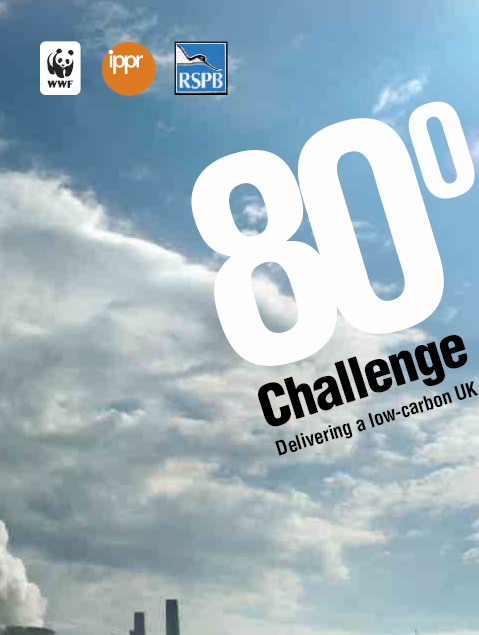


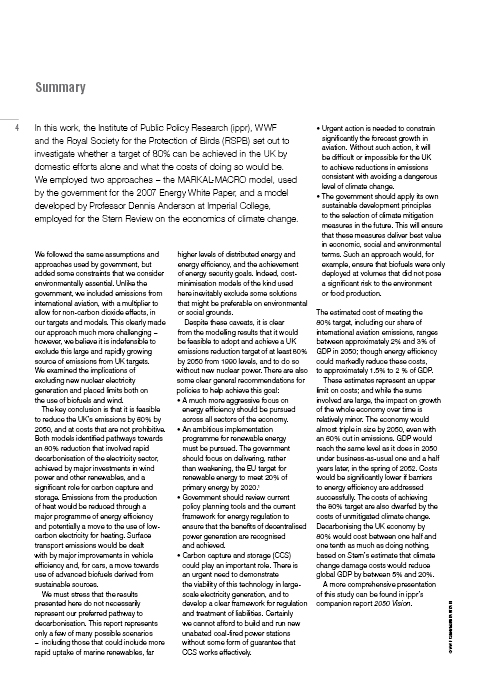
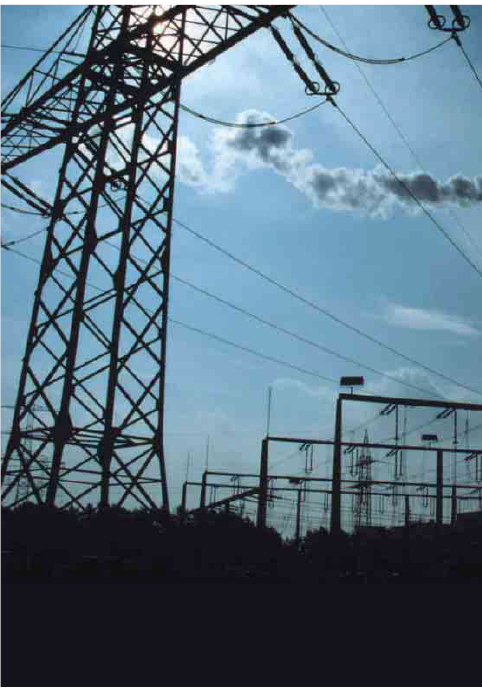
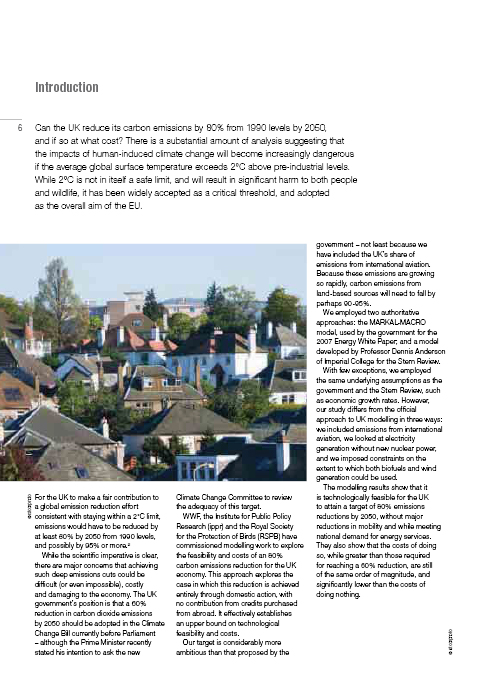




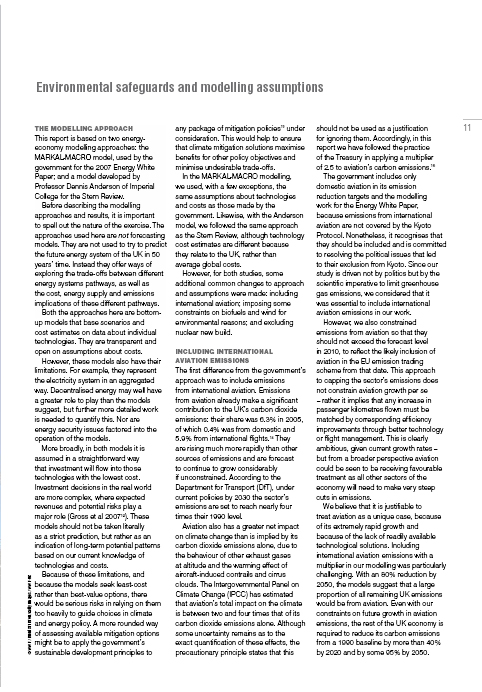

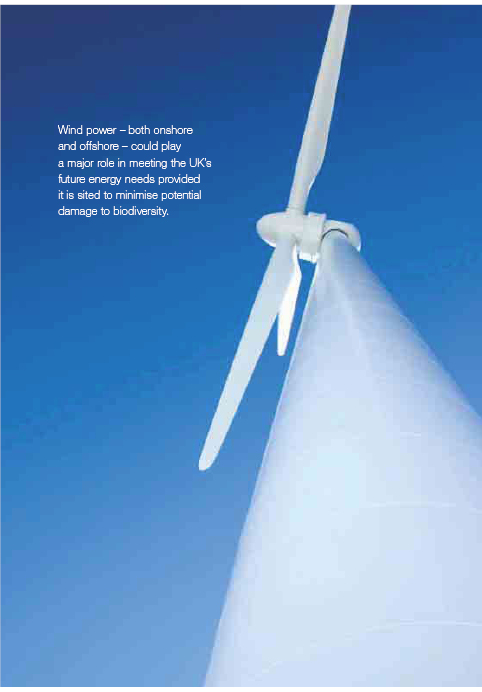


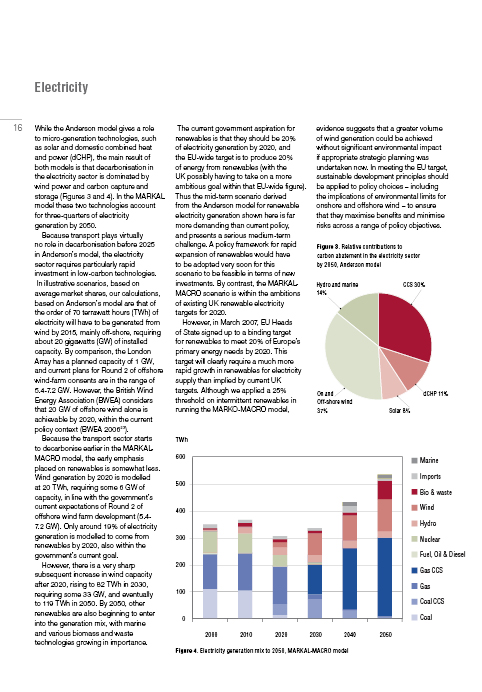

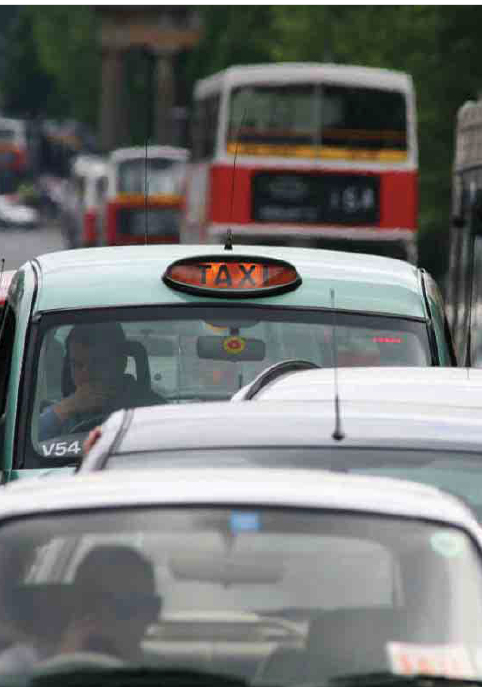







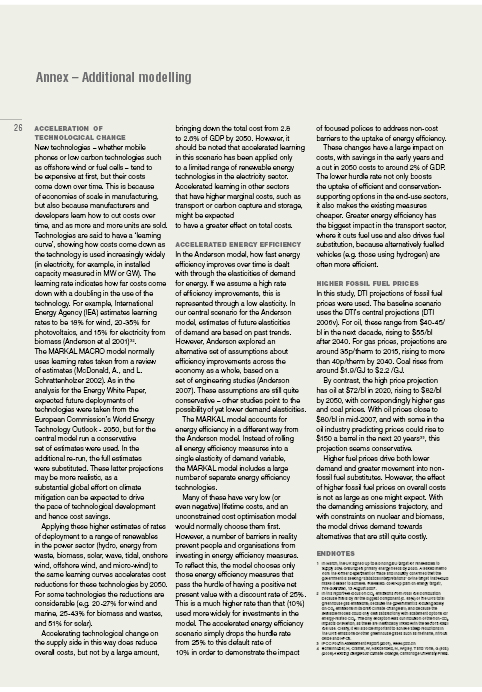
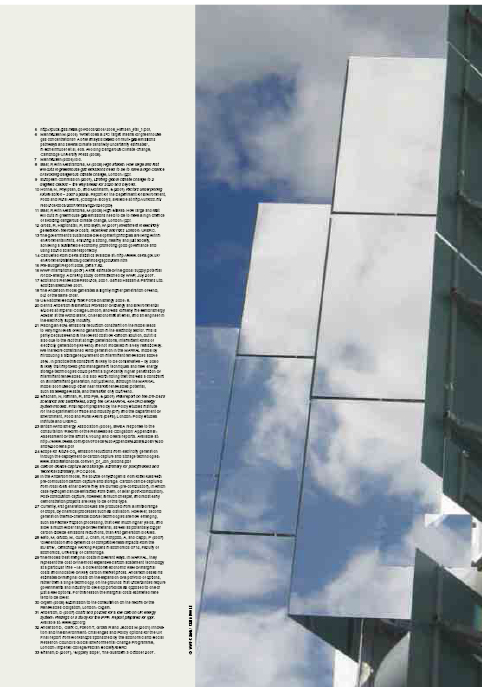
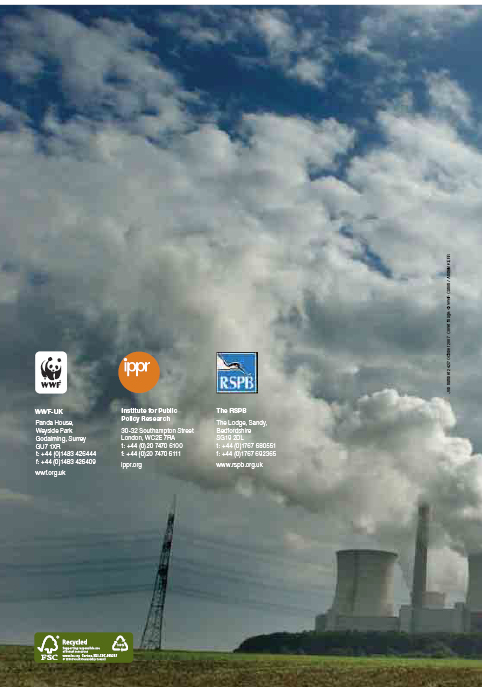
RSPB
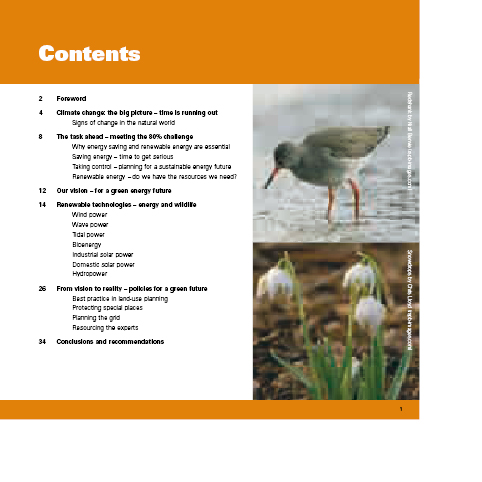


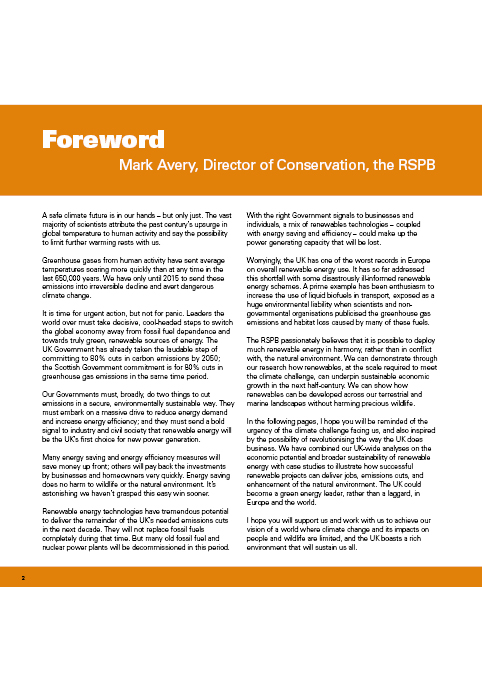
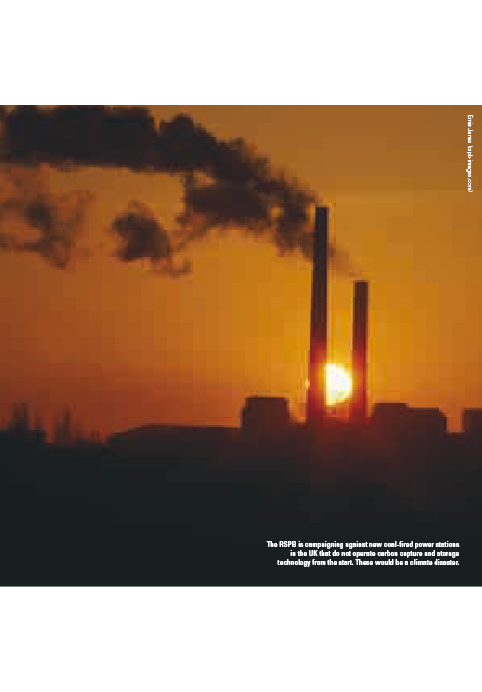
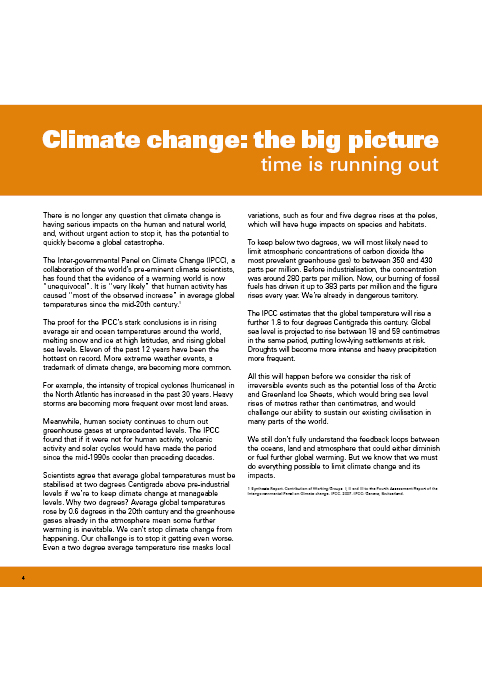

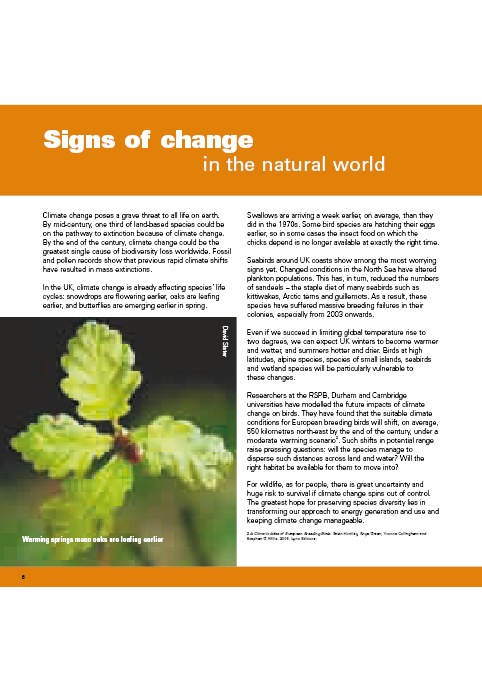
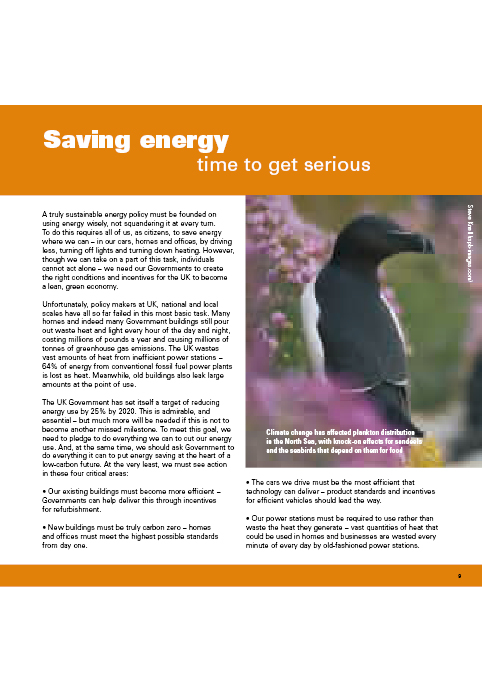
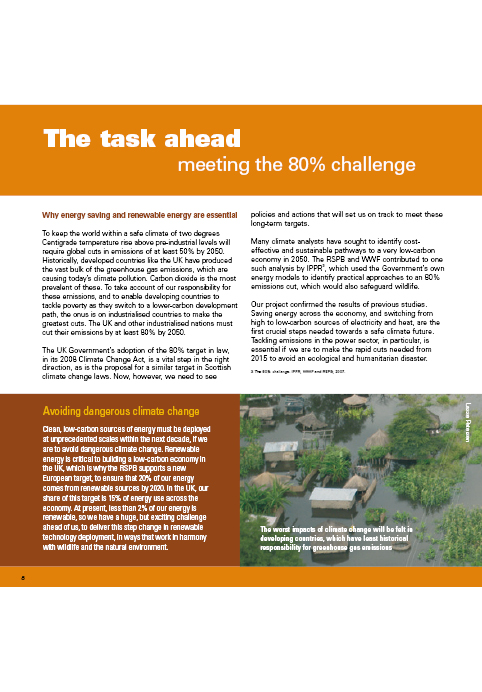
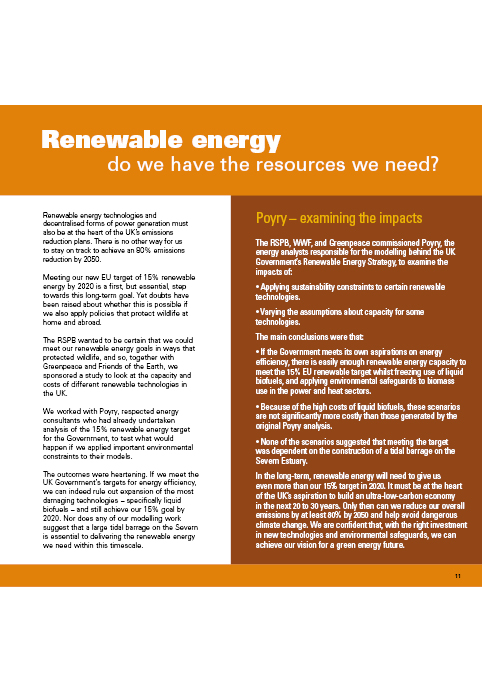



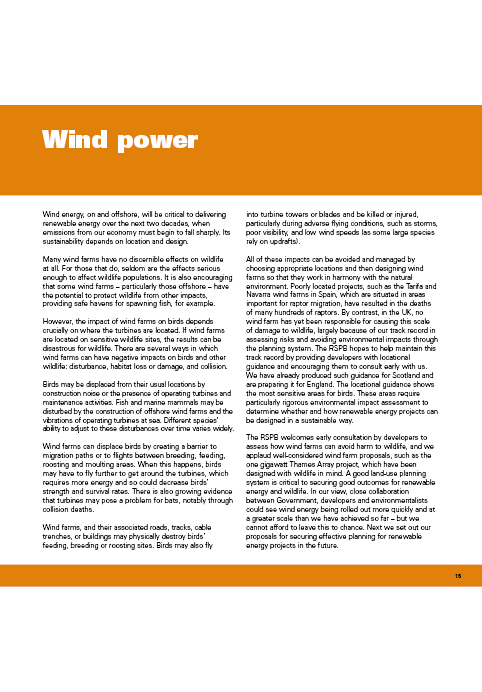
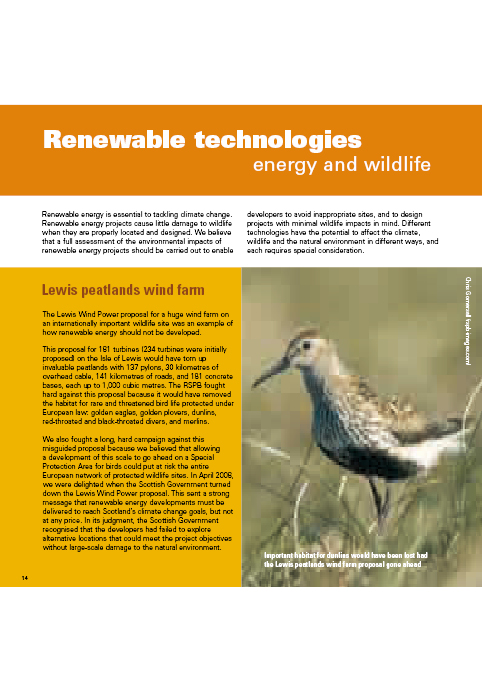
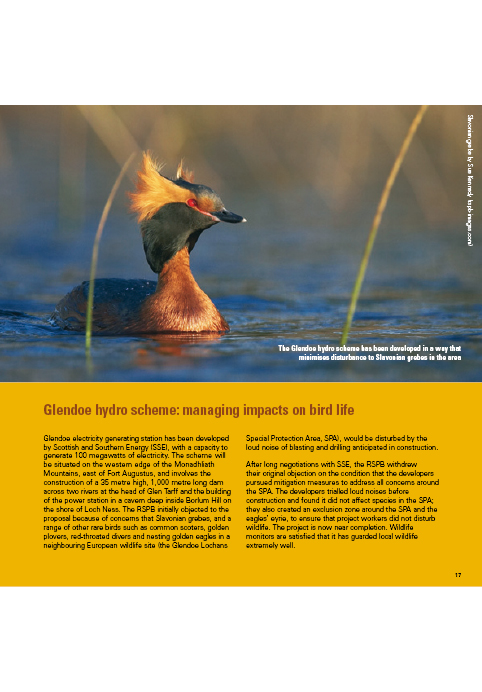
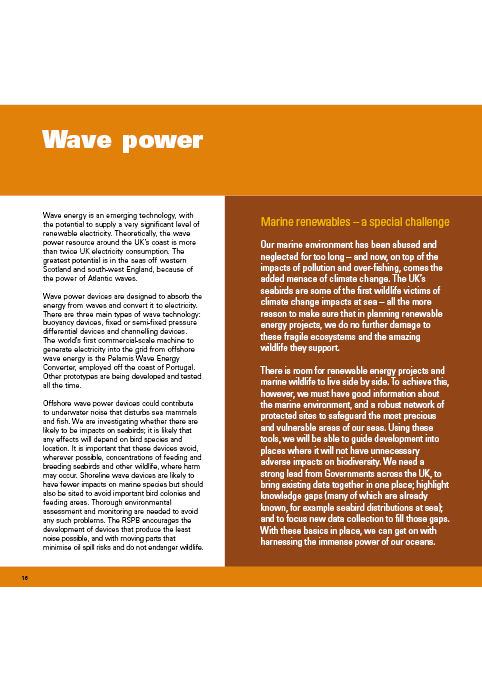
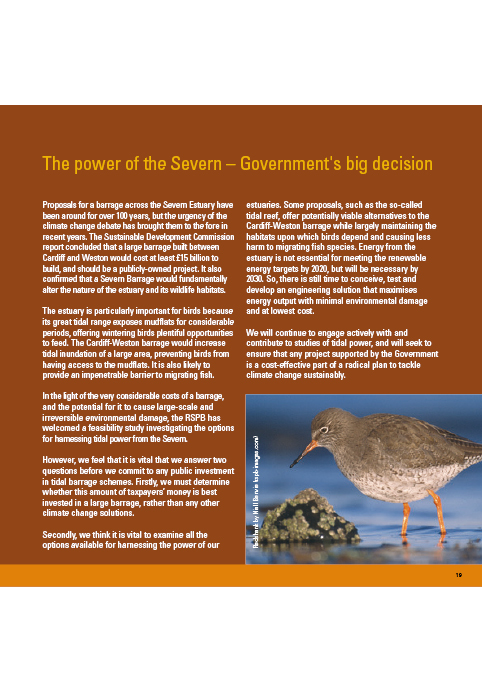

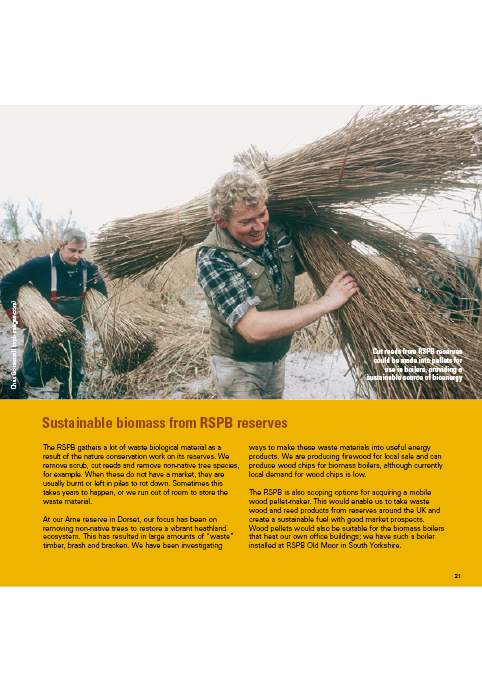
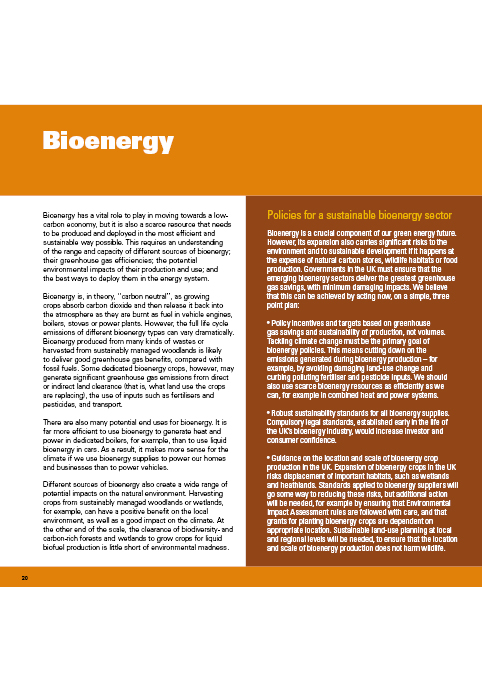

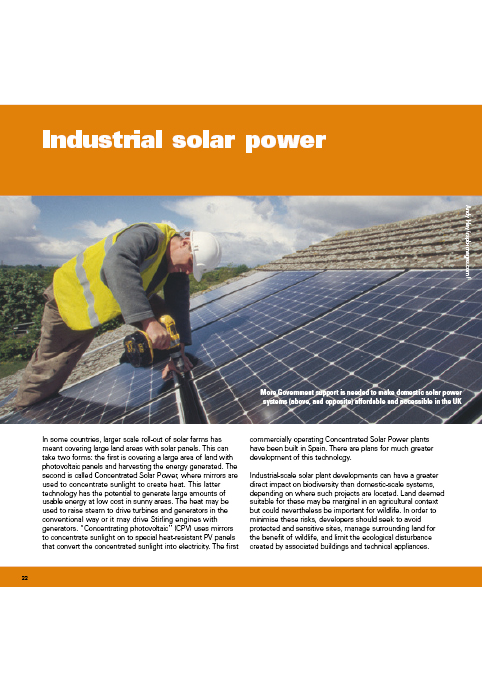

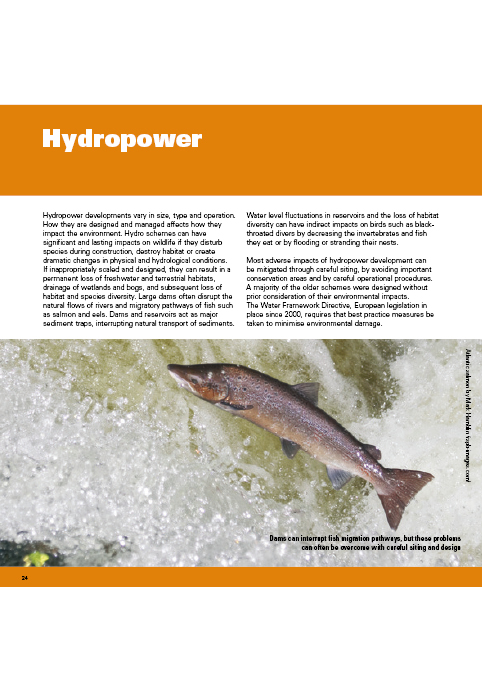

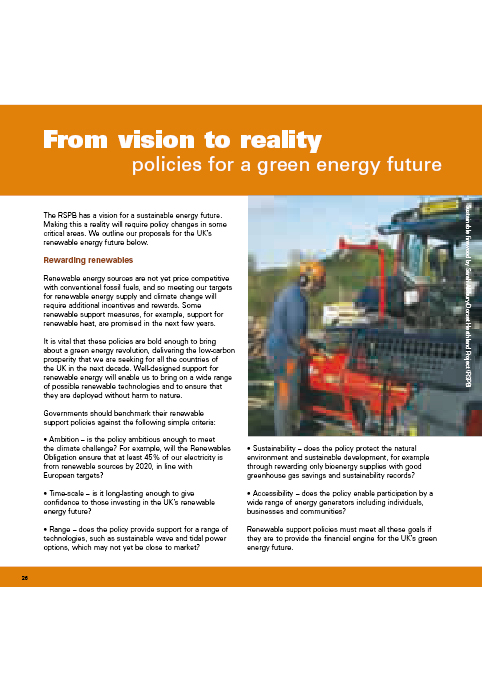

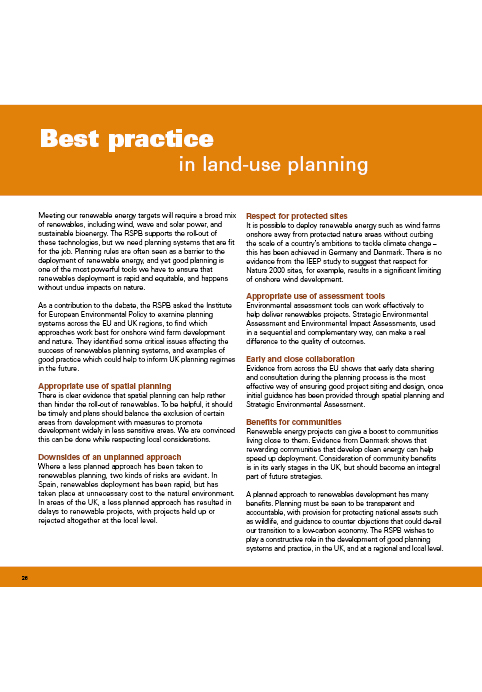

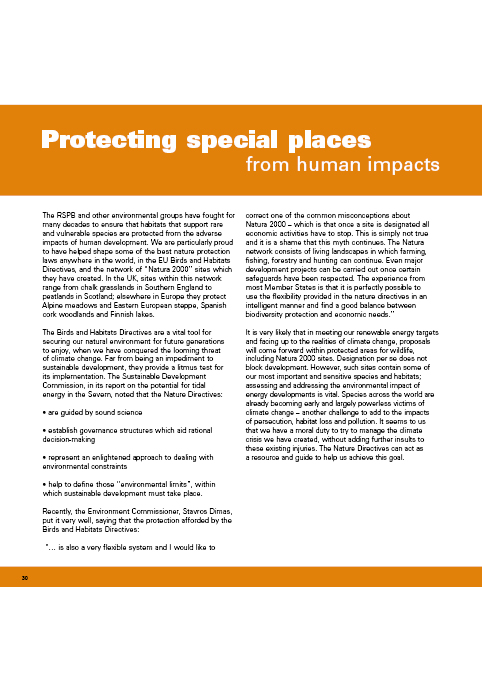

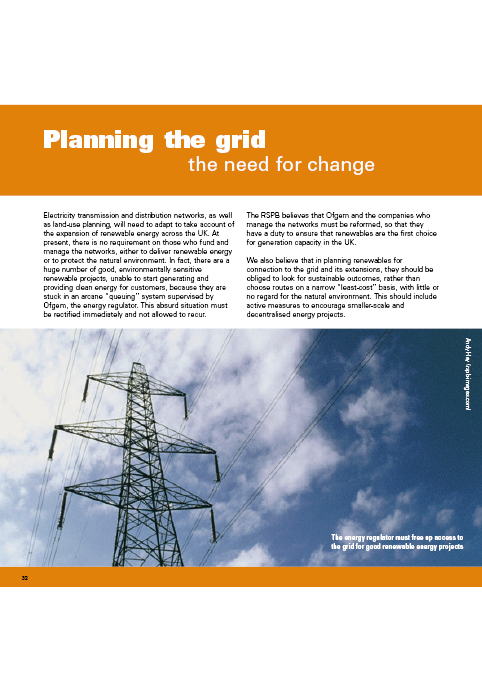


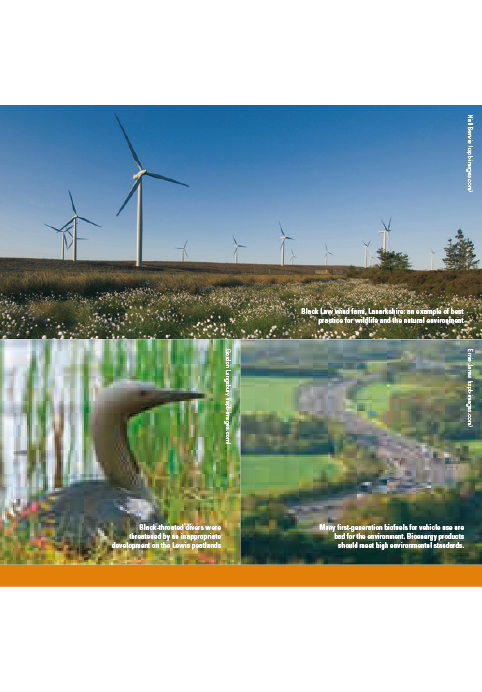
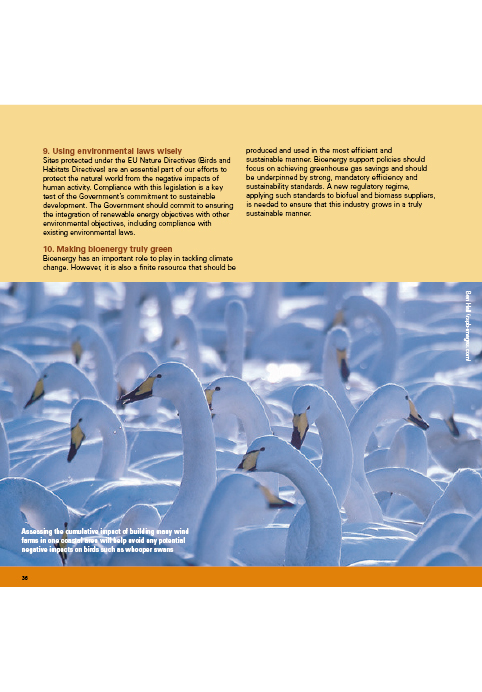

RSPB
 Northern Ireland Assembly Environment
Northern Ireland Assembly Environment
Committee Inquiry into Climate Change
A written response from RSPB Northern Ireland, February 2009
1. The RSPB and its interest in the Committee’s Inquiry
The RSPB is the largest nature conservation charity in Europe, supported by over a million members of which around 11,000 live and support our work in Northern Ireland. We employ around 40 members of staff and invest £1.4 million in conservation work in Northern Ireland annually.
The United Nation’s Intergovernmental Panel on Climate Change (IPCC) involves many thousands of scientists from across the world. The RSPB believes the work of the IPCC provides the most authoritative opinion on the causes of climate change. The IPCC has concluded that:
‘Warming of the climate system is unequivocal. Most of the observed increase in global average temperature since the mid-20th Century is very likely due to the observed increase in anthropogenic greenhouse gas concentrations. It is likely that there has been significant anthropogenic warming over the past 50 years averaged over each continent. During the past 50 years, the sum of solar and volcanic forcings would likely have produced cooling’.
The RSPB considers that human-induced climate change is the greatest long-term threat to global biodiversity and will have very serious impacts on the wildlife of Northern Ireland and beyond. Up to one third of land-based species on earth could be committed to extinction by 2050 if we do not act to address this problem (see below).
We believe that rapid and deep emission cuts in developed countries, including Northern Ireland, are essential to avoiding dangerous climate change. This will require a massive reduction in energy use; action to curb the growth in aviation emissions; and a rapid switch from high to low carbon sources of energy.
For many years, we have been urging the Northern Ireland Assembly to introduce targets to reduce greenhouse gas emissions and measures to help Northern Ireland’s wildlife to adapt to the inevitable changes in the climate we will experience in the coming decades. We are also at the forefront of the understanding of the effects and impacts of climate change on wildlife through our scientific work and we pride ourselves on developing sound policies based on the very best science available.
In summary, to tackle the causes of climate change and to help wildlife to adapt to these changes, we believe the Northern Ireland government should commit to:
- Reducing greenhouse gas emissions by 42% by 2020 relative to 1990 levels..
- Producing 20% of energy from renewables sources by 2020, with a minimum of 40% of this target met through electricity supply.
- Increasing energy efficiency in order to reduce energy use by 25% by 2020.
- Implementing emissions performance standards for all new power plants.
- Declaring 200 new Areas of Special Scientific Interest (ASSI) by 2016.
- Securing favourable, or approaching favourable, condition for at least 95% of features within the ASSI network by 2016.
- Delivering all existing UK and Northern Ireland targets for habitat restoration and creation, as published in relevant Habitat Action Plans.
- Securing at least 50% of the area of agricultural land in Northern Ireland covered by agri-environment schemes.
2. The impacts of climate change on wildlife
The following paragraphs explain the main threats to wildlife from climate change and the peer-reviewed science supporting our concerns in Northern Ireland and beyond.
2.1 Climate change is causing extinctions of our wildlife
Climate change has already begun to affect the natural world. Many species have become extinct or face an uncertain future if changes continue unabated. For example, research has shown that many species of frog in Costa Rica have gone extinct because higher temperatures have encouraged disease outbreaks[1]. One study has estimated that even for medium-range climate-warming scenarios, 15-37% of species studied were ’committed to extinction’ unless immediate action was taken to tackle climate change[2].
2.2 Our wildlife is already moving because of climate change
Climate change is already affecting biodiversity in Britain and Ireland. In an analysis of 1,600 northern hemisphere species, it was found that the ranges had changed on average 6.1 km northward and 6.1 m upward[3]. A recent briefing paper commissioned by the Sustainable Development Commission in Ireland has identified specifically the challenges climate change poses to wildlife across the island[4].
With collaborators at the University of Durham, the RSPB has attempted to predict the potential change in the distribution of all European breeding birds by the end of the 21st century, by showing where suitable climate conditions are likely to be present[5]. We have attached a copy of a summary of this work for the Committee’s use. Our results concur with those from other similar studies[6]. In brief, we have found that:
- The centre of the potential range of the average species is predicted to shift nearly 550 km northeast and will be 80% the size of current range.
- For some species, the potential future range does not overlap with the current range at all. The average overlap is 40%.
- Projected changes for some species found only in Europe, or with only small populations elsewhere, suggest that climate change is likely to increase the risk of extinction.
Of course, our models assume that species and the resources they need, will be able to respond at the uniquely rapid rates required. The behaviour of some sedentary species and landscape fragmentation/physical barriers will limit the potential of these species to occupy future suitable range.
By ‘retro-fitting’ our models to known population trends for European birds, we have demonstrated that those species facing deteriorating climate conditions (e.g. redwing) tend to be declining whereas the populations of those that have improving climatic conditions (e.g. Dartford warbler) are increasing[7].
Milder winters are also affecting the vast numbers of birds that spend the winter in Britain and Ireland. Many wading birds and wildfowl are choosing to winter on the east coast of the UK, reducing their dependence on the milder west coast and saving birds the travel costs of getting there[8]. This change in winter movements has been put forward as a potential cause of the recent massive declines in the numbers of diving ducks visiting Lough Neagh in the winter[9]. A four-year research study at Queen’ University, funded by the Northern Ireland Environment Agency and the RSPB is aiming to examine this relationship.
2.3 Climate change is creating indirect impacts on our wildlife
Changes in climate can affect wildlife indirectly, by impacting on food supplies. For example, climate change is detrimentally affecting breeding seabirds, such as the puffin, in the North Sea as increases in sea surface temperatures impact plankton and ultimately reduce the availability of their favoured sandeel prey[10]. Similar breeding failures for seabirds on Rathlin Island and other colonies around the North Channel may be related to the same pressure[11], and this is the subject of a major new research project undertaken by Queen’s University Belfast and funded by the Northern Ireland Environment Agency and the RSPB.
Warmer spring weather in recent decades has caused the advancement in the timing of spring events, such as egg laying or invertebrate emergence[12]. One study has shown that spring events had advanced by an average of 2.8 days per decade[13]. If bird breeding and food availability advance at different rates, significant reductions in productivity can result. For example, our research has shown that an increasing mismatch between the hatching of golden plover chicks (a ‘red-listed’ species in Northern Ireland[14]) and the peak supply of their favoured food, craneflies, is reducing the survival of chicks[15][16]. Coupled with the desiccation of cranefly eggs in hotter summers, these threatened birds face a ‘double whammy’ of climate change impacts.
Unseasonably heavy summer rainfall can be detrimental, by increasing chilling of chicks and by reducing food availability[17][18]. There is also some evidence that reduced rainfall in tropical areas is having an adverse impact on the populations of Northern Ireland’s trans-Saharan migrants, e.g. cuckoo, possibly again through effects on the food chain[19]. The effects of sea level rise may also become very important for our coastal wildlife in Northern Ireland in the future[20], especially given some of the major impacts being seen already along the east coast of Britain.
3. Helping Northern Ireland’s wildlife through the Committee’s Inquiry
We have chosen to respond to each of the bullet points outlined in the Terms of Reference for the Committee’s inquiry:
To identify initial commitments for Northern Ireland that will ensure it plays a fair and proportionate role as part of the UK in meeting climate change targets
Adaptation for wildlife
Observed evidence and predictive models of nature’s response to climate change suggest that action is necessary to enable wildlife to adapt. The UK Government is committed to preparing an adaptation programme under the UK Climate Change Act. The Department of the Environment has indicated that the Climate Change Act ‘will generate a structure for ensuring Northern Ireland’s ability to adapt to climate change’. We believe adaptation measures for wildlife need to be central to the elements of the programme that apply in Northern Ireland.
Given that the changes are occurring against a continuing background of the loss of natural habitats (see results of the Northern Ireland Countryside Survey 2007[21]) and fragmentation, many species may struggle to survive in Northern Ireland. The RSPB is developing an agenda with the UK Government and devolved administrations to enable wildlife to survive, thrive and adapt to the conditions imposed by climate change[22].
It is clear that the current network of protected areas for biodiversity will be insufficient. It will be necessary to make the wider landscape more suitable for species as they shift in response to climatic change. This will require more than just better protection of existing ‘hotspots’, i.e. within Natura 2000 or the network of Areas of Special Scientific Interest (ASSI).
The Northern Ireland landscape will need to become more permeable to species that are attempting to respond by adjusting their distributions to new conditions[23] [24]. This means that maintaining existing patches of semi-natural habitat in the landscape will be important, and creating new ones will be necessary. The spatial locations of these patches will, of course, determine whether they can act as ‘stepping stones’ for the suite of species requiring them. The Northern Ireland Countryside Management Scheme offers an excellent mechanism to provide these patches of habitat. However, the decision to remove set-aside land will act to remove patches of habitat in Northern Ireland and needs to be replaced with another mandatory mechanism to support habitats for wildlife.
Many of our protected areas are based on the presence of rare or threatened species and habitats. Given that Alcamo & Krielman 1996 (Global Environmental Change-Human Policy Dimensions 6: 305-334) have identified that >40% of the global land area will no longer experience climatic conditions to maintain ecosystems or biomes following climatic change, the species and habitats for which a site was originally protected will, in many cases, not be able to survive there. However, this should not mean we dispense with protected areas because these high quality natural and semi-natural areas will become important homes to new species and habitats. They will remain important nodes in the overall network of sites if some proportion of global biodiversity is to be conserved as the climate changes. It is, therefore, very important the overdue plans to declare all qualifying sites as ASSI in Northern Ireland progress as a matter of priority.
Selecting new sites that offer a diverse range of physical habitats, even if they currently do not play host to rare or threatened species, offers the best way to sustain a wide diversity of species. In other words, we need to take calculated decisions if we are to maximise our ability to conserve biodiversity in a changing climate, accepting uncertainty requires a refreshed approach to site selection[25]. We must, however, continue to identify and protect less common physical habitats as well.
To ensure wildlife can adapt to a changing climate we propose the Northern Ireland Government adopts the following principles:
- All existing biodiversity laws, policies and strategies are implemented across Northern Ireland to create resilient populations of species in healthy habitats;
- The area of land managed for biodiversity and other environmental benefits in increased, including areas for buffering and linkage outside the protected area network; and
- Habitat features are protected and created across Northern Ireland to make the landmass more permeable to biodiversity.
We have attached a copy of our document ‘Climate Change: Wildlife and Adaptation. 20 Tough Questions, 20 Rough Answers’ so that the Committee can understand the issues around adaptation in more detail and the positive agenda we are suggesting to tackle this challenging area.
Mitigating the causes of climate change
The United Nation’s IPCC has published figures which show the likely impacts for different levels of warming. They have included information on the impacts on ecosystems that support global biodiversity. Their assessment suggest that extinctions rates are likely to be increased with about a one degree Celsius rise in global mean temperature, and above a two degree Celsius rise the prospects are potentially catastrophic. This is why we do not wish to see global mean temperature rise above more than two degrees Celsius and advocate policies to reduce greenhouse gas emissions.
In their fourth assessment report, the IPCC examined the probabilities of staying below particular human-induced temperature rises for a range of atmospheric concentrations of greenhouse gases. They have shown that to be reasonably sure of staying below two degrees Celsius temperature rise, concentrations of all greenhouse gases must stabilise at less than 430 ppm, and to be fairly certain they need to be below 370 ppm. More recently, in the light of some new research findings, an increasing number of scientists are calling for the level of greenhouse gases (GHG) in the atmosphere to be stabilised at a significantly lower level than previously recommended, i.e. as low as 350 ppm CO2 equivalent[26].
To stay within safe levels, developed countries need to cut emissions by between 25% and 40% by 2020 and by 80% to 95% by 2050, according to the IPCC.
Under the Climate Change Act 2008, the UK Government has agreed that it should aim to reduce Kyoto greenhouse gas emissions by at least 80% below 1990 levels by 2050. The RSPB, as a member of the Stop Climate Chaos coalition, campaigned to ensure this target was adopted. This target is also accepted by the independent UK Climate Change Committee as an appropriate UK contribution to a global deal aiming to reduce Kyoto greenhouse gas emissions to between 20-24 billion tonnes by 2050. The UK is also committed to reducing greenhouse gas emissions by 42% by 2020 relative to 1990 levels, as recommended by the UK Climate Change Committee. Northern Ireland needs to play its part in meeting this target and must set legally-binding targets to reduce emissions.
The Northern Ireland administration is also committed, as part of the UK, to meeting its part of 20% of all energy supply being from appropriate renewable sources by 2020, as set out in the EU Renewable Energy Directive[27].
To consider the necessary actions and a route map for each significant sector in Northern Ireland
The UK Climate Change Committee has proposed that the 80% target should apply to the sum of all sectors of the UK economy, including international aviation and shipping[28].
The RSPB, with WWF, contributed to an analysis by the Institute for Public Policy Research (IPPR) of the route map for meeting the 80% target in the most cost-effective way. We have attached a copy of this report for the Committee’s use. This analysis resulted in several clear general recommendations;
- A much greater focus on energy efficiency measures across all sectors of the economy is required.
- The UK must meet its fair share of the EU target for renewable energy;
- Carbon capture and sequestration (CCS) must be investigated and promoted;
- No new coal-fired power stations should be consented unless they capture and store their carbon emissions from the start;
- Urgent action is required to constrain significantly the forecast growth in aviation; and
- Sustainable development principles must be used when selecting climate mitigation measures in the future, to avoid, for example, the use of unsustainable volumes or sources of biofuels.
More specifically to Northern Ireland, the UK Climate Change Committee has identified that we could reduce our emissions by 2 million tonnes of CO2 equivalent in 2020 by:
- Moving to clean, low carbon sources of energy such as renewable energy technologies;
- Emissions from buildings and industry could be reduced by up to 1 MtCO2e in 2020 by using energy more efficiently;
- More efficient vehicles and new transport fuels could deliver reductions of up to 1 MTCO2 in 2020; and
- Emissions from agriculture, land use and forestry and waste management could be reduced by up to 0.5 MtCO2e in 2020.
The use of land to abate climate change is receiving much attention. Peatland restoration has been identified as a potential land-use mechanism for storing carbon and we are urging governments to examine the carbon value of peatland conservation. Given the extent of the peatland resource available in Northern Ireland, this research to quantify carbon savings through the management and restoration of this habitat should be prioritised.
Reducing energy use
A reduction in around 25% in energy use by 2020 is needed for the UK to achieve its medium and long-term climate change goals. This will require action across all sectors, and will need to involve behavioural change, infrastructure investment, and adoption of best available technologies.
The RSPB has always been strong supporter of demand management and energy efficiency measures, since they are generally the most cost effective and sustainable approach to cutting greenhouse gas emissions.
The UK Climate Change Committee has identified that, because there is little gas central heating in Northern Ireland, we could reduce emissions further by replacing carbon-emitting heating (e.g. from oil) to low-carbon technologies (e.g. combined heat and power, biomass).
Investing in renewable energy
Given the likely halt in investment in new coal capacity in Northern Ireland, there are excellent conditions to invest in low or zero-carbon energy options as an alternative. Such investment is an essential component of a climate change programme capable of achieving cuts at the scale and speed required.
Despite having some of the best renewable resources in Europe, the UK as a whole has a very poor record in deploying renewable energy, running at third bottom in the EU league table. With the advent of the EU Renewable Energy Directive, the chance to increase renewables has arisen.
Renewable energy has significant advantages above and beyond its contribution to managing climate change; deployed at scale, renewable sources would help protect future Northern Ireland customers and businesses from fossil fuel price rises and increased dependence on fuel sources from abroad. However, a renewables ‘revolution’ on this scale could pose a threat to the natural environment and we must ensure that it is developed with true sustainability in mind.
The UK Climate Change Committee have identified that Northern Ireland has potential for onshore and offshore wind-generated power. They also identify the potential for tidal and wave technologies here. The RSPB has produced a document entitled ‘Power to the Planet’ that sets out a truly sustainable approach to the development of renewable energy projects. We have attached a copy of this document for the Committee’s use.
The Northern Ireland administration has the powers to approve onshore power generation and offshore capacity in adjacent waters. The administration is also responsible for consenting overhead electrical cables above 20kV and for investing in renewable technologies here.
The RSPB believes that the Northern Ireland Assembly should commit to the deployment of renewable energy in harmony with the natural environment and that this can play a major role in helping the UK to reducing greenhouse gas emissions by 80% by 2050. The development of a new Strategic Energy Framework for Northern Ireland in 2009 offers a superb opportunity to embed the commitment to renewable energy in Northern Ireland.
To identify the costs associated with meeting these objectives and compare them with the costs that will be incurred if they are not achieved.
The UK Climate Change Committee has calculated that the costs to the UK from reducing emissions by 80% below 1990 levels by 2050 can be made affordable. They estimate this at 1-2% of GDP in 2050. This estimate follows those provided by the Stern Review and other global and UK studies, including that undertaken by the IPRR with support from the RSPB and WWF (see above).
While the sums involved may appear large, by 2050 the UK economy is due to triple in size, even with a 80% reduction in emissions. GDP could reach the 2050 ‘business-as-usual’ level less than two years later, in the spring of 2052. The costs of meeting the 80% target are also likely to be dwarfed by the costs of unmitigated climate change, which the Stern Review estimated would reduce global GDP by between 5% and 20%.
The UK Climate Change Committee analysed the potential economic impacts for Northern Ireland. In terms of Gross Value Added (GVA), they predict that sectors at risk from reduced national production account for only 0.1% of GVA. They have estimated that employment losses would amount to less than 0.5% and could be replaced with new jobs created in a low-carbon economy (e.g. in renewable technologies).
With regard to fuel poverty, the UK Climate Change Committee also estimates that there will be 220,000 households in fuel poverty in 2020 and electricity impacts could result in an additional 20,000 households entering fuel poverty. However, energy efficiency improvements could remove 20,000 households from fuel poverty, thus fully offsetting any increase. They suggest that income transfers and social tariffs for fuels are required to address fuel poverty impacts in Northern Ireland regardless of the impacts of reducing greenhouse gas emissions.
To identify a formal cost effective mechanism for assessing the potential impact of new policies on climate change/CO2 emissions
A requirement is being developed at Westminster to assess all policies for greenhouse gas emissions. If, as recommended by the UK Climate Change Committee, all UK administrations are eventually responsible for their own greenhouse gas budgets, it is essential that all new policy decisions are assessed to establish any likely rise or fall in greenhouse gas emissions associated with their implementation, and the resultant overall impact on greenhouse gas budgets.
To make recommendations for appropriate targets/actions that could be included in the new Northern Ireland Sustainable Development Implementation Plan
Given our concerns outlined in the earlier parts of our response, we believe the Northern Ireland Government should commit to:
- Reduce greenhouse gas emissions by 42% by 2020 relative to 1990 levels (the current target is 25% by 2025).
- Produce 20% of energy from renewables sources by 2020, with a minimum of 40% of this target met through electricity supply.
- Increase energy efficiency in order to reduce energy use by 25% by 2020.
- Implement emissions performance standards for all new power plants.
To help wildlife to adapt to inevitable changes in climate, we believe the Northern Ireland Government should commit to:
- Declare 200 new Areas of Special Scientific Interest (ASSI) by 2016.
- Secure favourable, or approaching favourable, condition for at least 95% of features within the ASSI network by 2016.
- Deliver all existing UK and Northern Ireland targets for habitat restoration and creation, as published in relevant Habitat Action Plans.
- Secure at least 50% of the area of agricultural land in Northern Ireland covered by agri-environment schemes by 2013.
To make recommendations on a public service agreement for the DOE Climate Change Unit’s commitments in the second Programme for Government that will ensure Northern Ireland will meet its climate change obligations
Given our concerns outlined in the earlier parts of our response, we believe the Department of the Environment should commit to a Public Service Agreement that captures the need to reduce greenhouse gas emissions and help citizens and the wildlife of Northern Ireland to adapt to the changes we face as the climate inevitably changes in the future.
To consider what secondary legislation raising powers within the UK Climate Change Act would contribute to Northern Ireland’s commitment to the UK Climate Change Act
No comments.
To express views on if and how the Assembly might conduct more effective scrutiny of climate change responsibilities across all relevant departments
Following the lead taken by the UK and Scottish governments, we agree with the UK Climate Change Committee that the Northern Ireland Government should adopt a carbon budget. This would establish absolute limits on emissions during the Programme for Government. Responsibility for a carbon budget would require assessment of any likely decrease or increase in greenhouse gas emissions associated with new policy decisions, and thereby the impact of these on the budget overall.
To produce a report on the findings and recommendations of the inquiry by September 2009
The RSPB hopes that the Environment Committee finds our written response useful in their deliberations. If deemed appropriate, we would be delighted to make further representation to the Committee orally in due course. We would also be pleased to provide the Committee with any further information that may have been referred to in this response.
Prepared by Dr. James Robinson (Conservation Manager)
RSPB Northern Ireland, Belvoir Park Forest, Belfast BT8 7QT
Tel: (028) 9049 1547
Email: james.robinson@rspb.org.uk
[1] Pounds, J.A. et al. (2006) Nature 439: 161-167.
[2] Thomas, C.D. et al. (2004) Nature 427: 145-148.
[3] Parmesan, C. & Yohe, G. (2003) Nature 421: 37-42.
[4] Coll, J. et al. 2009. Briefing Paper on Climate Change and Biodiversity in Ireland. Report to Comhar Sustainable Development Commission.
[5] Huntley, B. et al. (2007) A Climatic Atlas of European Breeding Birds. Lynx Edicions, Barcelona.
[6] Walmsley, C.A. et al. (2007) Modelling Natural Resource Responses to Climate Change (MONARCH). UKCIP, Oxford.
[7] Green, R.E. et al. (2008) Biology Letters. Published online, doi:10.1098/rspbl.2008.0052.
[8] Austin, G.E. & Rehfisch, M.M. (2005) Global Change Biology 11: 31-38.
[9] Maclean I.M.D. et al. (2006) Declines in over-wintering diving ducks at Lough Neagh and Lough Beg: comparisons of within site, regional national and European trends. BTO Research Report No. 432 to the Environment & Heritage Service.
[10] Frederiksen, M. et al. (2006) Journal of Animal Ecology 75: 1259-1268.
[11] Chivers, L. (2008) Irish Birds 8: 359-364.
[12] Root, T.L. et al. (2003) Nature 421: 57-60.
[13] Parmesan, C. (2007) Global Change Biology 13: 1860-1872.
[14] Lynas, P. et al. (2007) Irish Birds 8: 149-166.
[15] Pearce-Higgins, J.W. et al. (2005) Oecologia 143: 470-476.
[16] Pearce-Higgins, J.W. & Yalden, D.W. (2004) Ibis 146: 335-346.
[17] Summers, R.W. et al. (2004) Journal of Applied Ecology 41: 513-525.
[18] Tyler, G.A. & Green, R.E. (2004) Ibis 146: 69-76.
[19] Peach, W.J. et al. (1991) Ibis 133: 300-305.
[20] Orford, J.D. et al. (2007). Future coastal scenarios for Northern Ireland. Unpublished report to the National Trust.
[21] http://www.ni-environment.gov.uk/biodiversity/nh-research/nicountrysidesurvey-2/nics2007-news.htm
[22] RSPB (2007) Climate Change: Wildlife and Adaptation. 20 Tough Questions, 20 Rough Answers. Sandy.
[23] Collingham, Y. & Huntley, B. 2000. Ecological Applications 10:131-144.
[24] Hill, J. et al. 2001. Ecological letters 4: 313-321.
[25] Huntley, B. et al. 1998. Conservation Biology 2: 375-385.
[26] Commission of the European Communities (2009) Toward a comprehensive climate change agreement in Copenhagen. Brussels.
[27] Commission of the European Communities (2008) Directive of the European Parliament and of the Council on the promotion of the use of energy from renewable sources. Brussels.
[28] UK Climate Change Committee (2008) Building a low-carbon economy – the UK’s contribution to tackling climate change. London.
Sustainable Development Commission

SDC Submission to
NI Assembly Environment Committee
Inquiry into Climate Change
February 2009
1. The Sustainable Development Commission (SDC)
1.1. The SDC is the Government’s independent advisor on sustainable development, reporting to the Prime Minister, the First Ministers of Scotland and Wales and, in Northern Ireland, the First and Deputy First Minister. Through advocacy, advice, appraisal and capacity-building, we help to place sustainable development at the heart of Government policy.
1.2. The SDC thanks the Committee for its invitation to submit a written response to this inquiry and welcomes the opportunity to contribute to this important initiative. The SDC recognises the global nature of the challenge represented by climate change, necessitating that we move towards a low-carbon society. This will involve fundamental changes in the operation of government and business and in all of our lives as citizens and consumers. The SDC believes that the only consistent, effective and equitable way to meet this challenge is through the framework of sustainable development – applying the six principles of sustainable development agreed in our strategy, First Steps to Sustainability.
The principles of sustainable development
Achieving a sustainable economy
Living within environmental limits
Promoting good governance
Using sound science responsibly
Ensuring a strong, healthy and just society
Promoting opportunity and innovation
1.3. In providing advice to government and acting as an advocate for sustainable development, climate change is already a major element of all our work programmes and, in particular, our work on energy, transport and the built environment. A selection of recent pertinent initiatives is listed below:
- SDC is represented on the NI Climate Change Impacts Partnership
- SDC organised a workshop for Departmental officials on carbon neutrality and carbon offsets, supported by DOE & OFMDFM.
- SDC hosted a one-day UK workshop on the implications of aviation policy in NI
- SDC offered specialist advice to the Assembly’s ARD Committee Inquiry on renewable energy
- SDC is a mentor to 20 young ‘climate change advocates’ from across the island of Ireland in the British Council’s Challenge Europe project
- SDC staff have spoken at numerous conferences and seminars on climate change & energy matters, with particular emphasis on the built environment
- SDC has published a number of articles on climate change and related issues
2. Initial commitments for NI to contribute to UK climate change targets.
2.1. The government already has a series of stretching commitments relating to climate change, in both its Programme for Government and in its sustainable development strategy and implementation plan, viz:
- PfG PSA 22: Reduce greenhouse gas emissions by 25% below 1990 levels by 2025
- PfG PSA 22: Secure 12% of electricity consumption in Northern Ireland from indigenous renewable sources by 2012.
- NISDS - IP Target 36: Make the Government estate carbon neutral by 2015
In addition, the SD strategy lists supportive ‘important steps’, such as
- Reduce CO2 emissions by 30% below 1990 levels by 2025
- improving the overall energy efficiency of NI households by 25% and that of NI Housing Executive housing stock by 40% by 2025
- Where technologically and economically feasible, to ensure that beyond 2025, 40% of all electricity consumed in Northern Ireland is obtained from indigenous renewable energy sources with at least 25% of this being generated by non-wind technologies.
2.2. The UK’s Climate Change Act contains another set of targets and, although Northern Ireland does not yet have an identified contribution towards the rolling five-year carbon budgets contained in the Act’s provisions, the Assembly’s Environment Committee has determined a largely positive position of support in relation to the UK Climate Change Act. It should be noted that Scotland, Wales and the Republic of Ireland have all identified emissions reduction pathways of around 3% per annum.
2.3. The UK Government’s independent Climate Change Committee published its first annual report in December 2008, in which it made recommendations for the UK to reduce its greenhouse gas emissions by at least 80% by 2050, with attendant interim targets.
2.4. Beyond the UK, the European Union has a further suite of targets to be delivered by 2020 – a 20% cut in greenhouse gas emissions, a 20% cut in energy consumption, and a 20% contribution to energy generation from renewable sources. These are hugely ambitious targets.
2.5. It is important that Northern Ireland adopts a responsible position and plays a proportionate role in contributing to the attainment of UK and EU targets. What has been clear is that the existing NI targets are mostly distant in time and there are few, if any, interim ‘milestones’ or any clear plan as to how we might achieve even the most modest of these targets. The next Programme for Government should be in place by 2012 – it would be appropriate for its constituent PSAs and their delivery plans to indicate much more clearly exactly how departments will contribute to the attainment of agreed climate change ‘milestones’, reflecting the EU, UK & existing NI targets listed above.
2.6. The SDC supports the concept of five-year carbon budgets. This mechanism allows for annual fluctuations due to factors beyond a government’s control, such as extreme weather patterns or, as at present, a severe economic downturn which is likely to suppress emissions levels. The SDC recommends that such carbon budgets be introduced here, along with disaggregated SMART targets for NI. By June 2009, the UK Government has to set the first three carbon budgets and, shortly thereafter, it must report to Parliament on its policies and proposals to meet the targets in those budgets.
3. Proposed actions and sectoral route maps
3.1. Several studies have undertaken different assessments of the sectoral contributions to GHG emissions in Northern Ireland. Their different conclusions have been the result of their varied methodologies and data handling.
3.2. Among the reports most often quoted are the DOE-commissioned Northern Visions and Footpaths to Sustainability as well as the NI sections of the UK Climate Impacts Partnership reports. DETI & OFMDFM commissioned another useful report from consultants AEA in 2008 which published very illuminating comparative figures demonstrating the changes in sectoral emissions for Northern Ireland, Scotland and the Republic of Ireland.
3.3. In both the Footpaths to Sustainability report and in some earlier work by the Carbon Trust, its NI Vision Study of 2003, there are detailed scenarios tackling the emissions in the most significant sectors.
3.4. The Carbon Trust simplifies its recommendations under three steps:
3.4.1. Optimising energy use by implementing all possible energy efficiency measures
3.4.2. Decarbonising energy & fuel supplies by investing in renewable energy resources
3.4.3. Decoupling economic growth and social activity from the consumption of high-carbon fuels by developing low carbon technologies, products and services.
3.5. The SDC wholeheartedly endorses the first two steps but we are less certain about the feasibility of the decoupling process. Put simply, decoupling is about doing more with less: more economic activity with less environmental damage; more goods and services with fewer resource inputs and fewer emissions. Most of the data demonstrates that, while we are making some relative progress in using resources more efficiently, the overall picture is less encouraging. This is an area explored in significant detail in a new SDC report to be published in the Spring of 2009.
3.6. The Footpaths to Sustainability report adopts a slightly different approach by modelling a range of scenarios to test the ability of government policies to meet the (then) 2050 UK target of a 60% reduction in CO2 emissions. Using scenarios focussed on sectors such as housing, food and transport, the report projected the effectiveness of different policy options in reducing the carbon footprint of each sector.
3.7. There is no need to duplicate the lengthy recommendations of these studies in this paper but the Inquiry should certainly consider these documents during its work.
4. Costs of meeting these obligations compared with costs if they are not achieved
4.1. SDC welcomes the inclusion of economic considerations within the Inquiry’s terms of reference. Essentially, the causes of climate change are economic, through the progress of material prosperity, and so must the solutions be predicated on sound economics. The Stern Review on the economics of climate change is the most authoritative of reports on the subject and concludes that “if we do not act, the overall costs and risks of climate change will be equivalent to losing at least 5% of global GDP each year now and forever….While in contrast the costs of action – reducing greenhouse gas emissions to avoid the worst impacts of climate change – can be limited to around 1% of global GDP each year."
4.2. The Stern Review adopts a global perspective to draw its conclusions. In earlier work, the UK’s Department of Trade & Industry (now BERR) estimated the cost of cutting UK emissions to meet the old 60% target by 2050 would be between 0.3 and 2.0% of GDP in that year
4.3. Existing assessments of the costs of meeting climate change obligations in Northern Ireland can only be considered speculative. The Carbon Trust Vision Study posits some estimates based on national figures but it seems more beneficial to focus on the economic opportunities presented by the need to move towards a low-carbon economy.
4.4. Several groups are currently developing versions of what is being called a ‘Green New Deal’, most of them based on variations of a public spending package intended to boost the economy in the current recession and at the same time help to kick-start activities to tackle emissions, such as:
- redesigning the electricity grid to facilitate renewable and distributed energy to promote the decarbonisation of electricity generation
- more sustainable management of the whole government estate, including schools, hospitals et al
- a programme to improve the energy efficiency of the existing housing stock
- a new approach to transport policy
While proposals of this nature are stimulated as much by the ‘credit crunch’ as by the need to tackle climate change, some of the ideas could form the basis of economic opportunities for the longer term. For example, the skills development fostered by the Renewable Energy Installer Academy helps to promote an increase in the use of domestic energy technologies.
4.5. Northern Ireland already has some significant strategic advantages in facilitating a shift towards a low-carbon economy. Both of our universities have dedicated research capacity in sustainable energy; our natural resources of wind, marine and agricultural potential provide a strong basis for low-carbon energy generation; our long tradition of engineering offers opportunities for the manufacture of wind and marine turbine components, to build upon the already existing assemblage of offshore turbine sets. These factors present a chance for NI to exploit its share of what is poised to be a significant global market in the coming years.
4.6. Some recent initiatives announced by Ministers in London indicate strengthening support for this approach. The proposed introduction of feed-in tariffs is designed to increase the uptake of renewable technologies and hasten the development of the nascent industry. Ministers also declared the government’s intention to retrofit all UK homes by 2030 to make them much more energy-efficient. Such ideas need serious consideration here too.
5. Mechanisms for assessing the impacts of policies on climate change
5.1. Existing instruments to guide policy development within the NICS structure are legion – among them are OFMDFM’s Policy Toolkit which contains excellent advice on screening policies for their adherence to sustainable development obligations; public sector procurement is covered by DFP’s document, Equality of Opportunity and Sustainable Development in Public Sector Procurement and the more recent sustainable procurement action plan; CPD’s Achieving Sustainability in Construction Procurement has a suite of worthy ambitions. These and other policy guidance are hampered by the fact that they are not mandatory – as guidance documents, they lack the authority of legislation.
5.2. It would certainly be possible and desirable to strengthen these existing guidance tools with more exacting criteria to assess their potential climate change impacts but the more deep-rooted problem is the need to see the guidance applied to policy development and implementation with greater rigour.
6. Targets for the new NI Sustainable Development Implementation Plan
6.1. As indicated earlier, the imperative is to ensure that departments have considered how they might contribute to the longer-term climate change targets. Virtually all departments of government have roles to play in tackling the effects of climate change – some focussed more on mitigation measures, such as DETI, others with a greater responsibility for adaptation, such as DRD.
6.2. Once the SD strategy has been approved by the Executive, it is critically important that each department becomes involved in a detailed consideration as to how it intends to contribute to the strategy’s high-level aims. In terms of climate change, this should entail the development of SMART objectives that clearly track how a department will play its part in moving towards whatever targets are set for 2020 or 2050. The overarching principles of sustainable development will not change and we must therefore continue to devise and implement policy positions which simultaneously allow us to ‘live within environmental limits’ while we ‘ensure a strong, healthy and just society.’
7. DOE Climate Change Unit PSA
7.1. The DOE is currently responsible for climate change policy but the reality is that many elements of policy which serve to combat the causes of climate change lie elsewhere within government. Energy policy and economic development sit within DETI; housing falls to DSD although Building Regulations are for DFP to determine; DRD covers transport strategy, DARD has sway over many aspects of land-use alongside DOE’s Planning Service; DCAL has responsibility for the government’s policy on architecture and the built environment. As with sustainable development, climate change touches almost every aspect of our lives.
7.2. In Whitehall, the government brought together into a single department the two most fundamental elements – climate change and energy. If we are serious about tackling climate change, it is our generation and use of energy that will be the largest determinant. Of the 22 million tonnes of CO2 equivalent we produce each year, energy use accounts for 75% (with agriculture producing a further 21%). There is a strong case to be made for combining the two responsibilities into one department of energy and climate change in Northern Ireland.
7.3. Any PSA in the next Programme for Government would thereby be able to set out the ambitions for climate change which would contribute proportionately to UK and EU targets, while also being able to have greater control over how those might reasonably be delivered through a sustainable energy programme.
8. Secondary legislation
8.1. The existing Statutory Duty on sustainable development, contained within Section 25 of the NI (Miscellaneous Provisions) Act 2006 is weak and ambiguous. It should be reviewed and strengthened to ensure that sustainable development is genuinely expressed throughout all government policymaking.
8.2. Any secondary legislation that is specifically related to climate change should find its focus in ensuring that Northern Ireland plays its proportionate role in meeting the obligations of the Climate Change Act by establishing disaggregated targets for Northern Ireland in a reflection of the legally binding targets of the UK Act.
9. Scrutiny
9.1. Plainly, the scrutiny committees of the NI Assembly will have a significant role to play in monitoring departmental progress against any future targets on climate change. This would be particularly important in the event that a new department of Energy and Climate Change was created.
9.2. In addition, however, the responsibility for a more detailed assessment of progress should be delegated to a body dedicated to that sole purpose. The NI Audit Office already undertakes work of this nature, reporting to the Assembly on other matters of policy and public spending and could be well placed to extend its responsibilities to this arena.
10. This submission can only introduce some limited aspects of the plethora of issues embraced by the extensive terms of reference for this important Inquiry. SDC will be pleased to expand on these comments with an oral presentation, if the Committee would find that helpful.
Sustainable Development Commission
Northern Ireland
February 2009
http://www.afbini.gov.uk/index/about-us/location/hillsborough.htm
Sustainable Energy Association

Sustainable Northern Ireland
Summary Points
- There is a large distortion between the (early) costs associated with addressing climate change and the (late) benefits in reducing emissions
- The Assembly should categorically state its support for an international climate change agreement that limits global warming to no more than 2°C above pre-industrial temperatures.
- The Executive and Assembly should urgently make commitments to introduce a NI Climate Change Act with legally binding regional targets to reduce our CO2 emissions by 80% from 1990 levels by 2050.
- The Executive should set an “intermediate" target for emissions in 2020, a series of legally binding five year “carbon budgets" and an annual carbon reduction target at an average of at least 3% per annum.
- The Committee on Climate Change’s role in Northern Ireland should be enhanced to facilitate the setting of Northern Ireland-specific budgets and action plans and monitoring performance against these.
- The Assembly should ensure that all plans, programmes and policies are assessed to determine their contribution to, or impact on, achieving carbon budgets.
- Each government department should investigate the opportunities and obstacles to carbon reductions within their competency areas and develop and deliver an action plan to decrease the emissions in line with targets.
- Long-term holistic planning, setting specific NI carbon budgets and action plans, and using Climate Impact Assessments should provide a framework for adaptation resources.
- Actions to reduce energy consumption and emission of GHGs need to be sector specific, realistic, cost effective, measurable, time bound and proportionate.
- The new Sustainable Development Strategy Implementation Plan needs to include the same targets that have been signed up to by Northern Ireland.
- Northern Ireland needs a Minister with joint responsibility for Sustainable Development and Climate Change.
Introduction
Sustainable Northern Ireland (SNI) is a charity established in 1997 to assist district councils, the community and voluntary sector, central government departments and non-departmental public bodies in understanding and moving towards sustainable development. SNI is a member of the Climate Change Coalition (NI) and Northern Ireland Environment Link (NIEL) and supports the comments they have submitted, but would like to further highlight some of their comments and make additional comments of our own.
SNI welcomes the opportunity to submit evidence to the Environment Committee’s inquiry into climate change. Climate change is an integral element of Sustainable Development and was included as a priority area in the previous Sustainable Development Strategy (it is assumed it will also be a key feature of the revised Strategy) along with actions and targets. Climate change must be a fundamental part of any Sustainable Development Plan, and it is important that central government provides the lead that can then be replicated by the entire public sector, as well as being filtered out to influence the private sector through example and via procurement and contract requirements.
Northern Ireland has committed itself to the UK Climate Change Bill but without agreement on specific actions this has the potential to be meaningless. Northern Ireland must agree legally binding targets as well as identifying specific roles and responsibilities for each sector – the NI Assembly, central government, local government, business and communities. Northern Ireland needs its own Climate Change Act with legally binding targets.
SNI’s comments are based primarily on the importance of addressing climate change within a long-term sustainability complex and include data from a recent survey (enclosed) undertaken by SNI on behalf of the Northern Ireland Climate Change Impact Partnership (NICCIP). This survey showed that 92% of public respondents were willing to make changes to their lifestyles to help reduce the impacts of climate change, especially if they were provided with clear leadership from the NI Assembly.
Response to the Terms of Reference
1. To identify initial commitments for Northern Ireland that will ensure it plays a fair and proportionate role as part of the UK in meeting climate change targets.
Global temperature depends not on the current flow of emissions but on the cumulative amount of greenhouse gases (GHGs) in the atmosphere, with emissions taking decades to have their full effect. This means that little can be done to stop the increase in temperatures and the likely impacts of climate change over the next decade. While we need to put in place measures that will allow us to adapt to the inevitable impacts of climate change within this decade, we must also use resources to mitigate against the additional long-term impacts of further GHG emissions for subsequent decades. There is a large distortion between the (early) costs associated with addressing climate change and the (late) benefits in reducing emissions[1].
Northern Ireland will not be able to tackle climate change alone. Given the global nature of climate change, it cannot be tackled by any individual country. At the same time it is important that we play a fair and proportionate role in line with our commitments to the UK Climate Change Act. The Assembly should be committed to playing its part in the international process and work in partnership with the UK government, the other devolved administrations and the Republic of Ireland government in developing and implementing a suitable response. The Assembly should categorically state its support for an international climate change agreement that limits global warming to no more than 2°C above pre-industrial temperatures.
Northern Ireland is a small country with our impact on climate change estimated at approximately 3% of UK GHG emissions. But small size of country or low amount of emissions cannot be an excuse for inaction. Northern Ireland needs to identify its ‘share’ based on the amount of carbon savings that should be made through its devolved policies to match savings from all developed policies in the UKCCP[2] on a per capita basis. This approach would provide clarification of Northern Ireland’s climate change reduction commitments. It would also provide a method of benchmarking the effectiveness of the Executive’s policies at delivering carbon savings against all policies across the UK, ROI and the rest of the world. The Executive and Assembly should urgently make commitments to introduce a NI Climate Change Act with legally binding regional targets to reduce our CO2 emissions by 80% from 1990 levels by 2050.
The Northern Ireland Sustainable Development Strategy, published in May 2006, committed Northern Ireland to a reduction of 25% in GHG emissions and 30% CO2 emissions below 1990 levels by 2025. This Strategy is now being rewritten and all targets may be removed from it. But this is not the only place that NI has committed to reducing GHG emissions. The UK has a domestic goal of reducing emissions of carbon dioxide to 20% below 1990 levels by 2010. The UK Climate Change Act has now set legally binding targets for the UK to reduce greenhouse gas emissions by at least 80% by 2050, and CO2 emissions by at least 26% by 2020, all set against a 1990 baseline. It also requires the Government to set five year carbon budgets, in order to set out a trajectory for emissions reductions to 2050. The first three budgets will cover the periods 2008-12, 2013-17 and 2018-2022, and must be set by 1st June 2009. The Executive should set an “intermediate" target for emissions in 2020, a series of legally binding five year “carbon budgets" and an annual carbon reduction target at an average of at least 3% per annum.
Northern Ireland needs to develop a considered long-term response to climate change. If the UK and NI are to achieve an 80% reduction in carbon emissions by 2050 we will require a significant change in lifestyle and an imaginative approach to ensure these changes are recognised as opportunities rather than perceived as burdens. The Committee on Climate Change’s role in Northern Ireland should be enhanced to facilitate the setting of Northern Ireland-specific budgets and action plans and monitoring performance against these.
A 2008 survey[3] of attitudes to climate change conducted by SNI for NICCIP included MLAs. The results of this survey showed that, of the MLAs who responded, two of the incentives they supported were climate change impact assessments for all relevant government policies and Northern Ireland’s participation in the UK Climate Change Bill. The Assembly should ensure that all plans, programmes and policies are assessed to determine their contribution to, or impact on, achieving carbon budgets.
Adaptation is intrinsically linked to mitigation, and it is essential that both be addressed as a matter of urgency The Northern Ireland Assembly should put in place cross-departmental policies and measures which will allow people, infrastructure, biodiversity and natural systems to adapt to changing climatic conditions.
An adaptation strategy to detail how human infrastructure and natural systems will be managed to help them adapt to a range of climate change scenarios should be developed. It is particularly important that climate change impacts are a strong consideration in all decisions relating to nature conservation as new ways of looking at designated sites (e.g. buffer zones, corridors, low intensity networks and landscape scale actions) will be required for wildlife to adapt to changing climatic conditions.
2. To consider the necessary actions and a route map for each significant sector in Northern Ireland (energy, transport, agriculture and land use, business, domestic, public sector, etc.). Climate change will have direct impacts in Northern Ireland. The impacts are already being felt and well thought-out planning for each sector will ensure they are better prepared to both adapt to the consequences of climate change and help to effectively mitigate against the longterm impacts.
Many sectors, in spite of a lack of leadership from Government, have already started taking steps to reduce their energy consumption and environmental footprint. It would be a reasonable comment that many sectors are in fact demonstrating more holistic and long-term strategic thinking than NI’s decision makers. If the Executive continues to procrastinate over climate change rather than taking strong and decisive action it is going to weaken its reputation as a serious political body which follows behind the business sector rather than leading. Business leaders desire a firm and fair legislative framework to provide the basis for their actions.
Each sector must be considered separately. A blanket approach to policies and actions is unlikely to have the necessary impact. Action to help reduce climate change will have wider benefits and these need to be factored into a sector-specific route map. For example, micro-generation of energy will have wider self-sufficiency benefits and provide lower energy costs in the long term, as well as ensuring greater security of supply.
Each government department should investigate the opportunities and obstacles to carbon reductions within their competency areas and develop and deliver an action plan to decrease the emissions in line with targets. Some departments will have larger scope for action than others and climate change will have different impacts and consequences for each department. There may be a level of uncertainty over the exact impacts of climate change on each specific sector but no sector will remain unaffected. For example, in agriculture climate change may in the short-term provide some benefits to northern hemisphere crop production by increasing yields. But this is likely to only be in the first 2°C of climate change and does not take into account that extreme weather conditions (which we are already starting to experience) could reduce or eliminate any grain. This scenario also does not take into account the negative impacts of increased ozone at ground level, increased variability of temperature and precipitation and increases in levels of weeds, pests and diseases.
Improved energy efficiency and rapid deployment of renewable energy are mentioned by the Carbon Trust, Stern, WWF, RSPB, etc as key areas to target early in the decarbonisation plans. Energy efficiency is a mechanism in which all sectors and departments can have a significant role. Stronger legislation and enforcement from the Assembly in this area will help cut Northern Ireland’s CO2 emissions in line with targets set out in the UK Climate Change Act.
- Approximately 500,000 homes in Northern Ireland have either no loft insulation or have insulation below the recommended levels of 270mm while some 70,000 homes would benefit from cavity wall insulation. The Assembly should set annual targets to upgrade the existing housing stock to recommended insulation levels: all new homes should be zero carbon by 2016.
- The Assembly should set a Strategic Energy Framework target of sourcing 15% of all our energy (electricity, transport and heat) from renewable sources by 2020 (this is the target set for the UK in the EU Climate and Energy Package) will act as the driving forces towards a low carbon society. Government will have to provide additional support such as:
- Ensuring that renewables are included in the design requirements for new public buildings;
- Providing funding packages for smaller scale technologies (such as extending the Environment and Renewable Energy Fund);
- Requiring energy companies to generate an increased percentage of their energy from renewable sources (by increasing the NIRO; the obligation in the rest of the UK is significantly higher);
- Guaranteeing good long term prices for units of energy generated from renewable sources to encourage greater uptake of microgeneration schemes (provisions to implement a system of feed-in tariffs for small renewable energy producers by 2010 are included in the UK Energy Bill, which was given Royal Assent on 26 November 2008); and/or,
- Introducing mandatory micro-generation, including community heating schemes. It is estimated that by 2050 micro-generation could supply 30-40% of the UK’s electricity needs.
Transport was responsible for around 30% of Northern Ireland’s CO2 emissions in 2004, highlighting the need for tailored transport solutions in Northern Ireland. At the moment highway measures have been allocated 80% of the transport spend. Only by increasing the share of the budget for other transport modes (walking, cycling and public transport) will significant strides be taken towards ending this reliance. The Assembly must increase the budget spent on creating a better public transport infrastructure for Northern Ireland. Consideration must be given to a government subsidised scheme to make non car related transport a viable alternative.
The survey SNI undertook regarding public attitudes to climate change3 found that 92% of public respondents felt that people are at least partially responsible for climate change, 87% thought that making changes to their lifestyle will help reduce climate change and 92% of respondents stated they were willing to make changes in order to help reduce climate change. This survey demonstrates that the public are willing to act now to help reduce climate change and do accept some responsibility. It is important to remember in any plans developed that public acceptance and action are important prerequisites to successful implementation. Action must include government departments, non-departmental public bodies and other stakeholders.
3. To identify the costs associated with meeting these obligations and compare them with the costs that will be incurred if they are not achieved.
Taking decisive action on climate change presents a win-win scenario. The economic costs of climate change mitigation are relatively well understood, as are the sectors and industries most likely to be affected by any mitigation policies and measures. By contrast, the economic costs of climate change impacts are not well understood – nor is how these balance with the cost of adaptation. It is essential that the economic assessment of climate change impacts are framed in the context of all the potential costs and benefits associated with climate change and our response to the situation. Once the net benefits are better understood then decisions can be made about the most appropriate combination of mitigation and adaptation measures needed in Northern Ireland. Lack of understanding on all the issues should not be used as an excuse for inaction.
Climate change and measures to respond to it have potentially significant macroeconomic effects. Government should see investment in a low carbon future as a way to stimulate the local economy. For evidence of this the Committee should look at the number of jobs created as a result of the Environment and Renewable Energy Fund (EREF) in NI. The renewable energy sector in Germany supports 170,000 people currently and it is anticipated that a future 130,000 new jobs will be created by 2020 as a result of the German government’s support and promotion of renewable energy.
While action to help mitigate against and adapt to climate change may cost 1% of GDP in 2020 the cost of inaction will be much more. The SNIFFER report[4] on the impacts of climate change on NI identified a number of direct effects, mostly negative, on human health, the economy, natural habitats and water resources. Warmer temperatures will encourage the spread of diseases and insects not currently experienced within NI. These impacts all have associated costs which will be greater than the cost of mitigation and adaptation measures.
Invest NI’s Maximising Business Opportunities from Sustainable Energy recommends that Northern Ireland should focus its sustainable energy efforts on four technology areas:
- Integrated Building Technologies (as buildings account for around 40% of all energy usage in most countries)
- Offshore Energy (including wind, tidal and wave – GB backing for 7000 offshore wind turbines to generate 33GW of power at an estimated cost of £64 billion. RoI has formally committed 2000 MW of offshore wind turbine generation at a cost of €4 billion over the next 5 years. £36 million spent in the UK on Marine Current Turbine research in the last 5 years [50% of the world total]. £50 million spent on wave power research in the UK [90% of the world total])
- Bioenergy (including anaerobic digestion [AD] and biofuels from waste and sustainable sources. A DARD report estimates Northern Ireland has an AD potential of 292 MW heat + 146 MW electricity; DOE indicated 747,000 tonnes of biodegradable municipal waste was collected in 2004. A RoI study indicates the potential for 1590 MW heat + 530 MW electricity in the Republic of Ireland)
- Energy Storage (to help smooth out fluctuations in demand, intermittent supply, and quality of supply. This developing technology is seen as being a significant factor once renewables exceed 10% of the grid supply). The current annual £21 billion global energy storage market is set to grow by 55% to £33 billion by 2012.
4. To identify a formal cost effective mechanism for assessing the potential impact of new policies on climate change/CO2 emissions (Akin to Regulatory Impact Assessment/Rural Proofing).
Northern Ireland needs to look to the other devolved administrations for models and assessments that are already being used. It is also important that existing policies are reviewed to identify their impacts on climate change and CO2 emissions. Assessments should be based on net GHG impact – so those that will help reduce emissions are automatically viewed more favourably than those that will increase them. Long-term holistic planning, setting specific NI carbon budgets and action plans, and using Climate Impact Assessments should provide a framework for adaptation resources.
5. To make recommendations for appropriate targets/actions that could be included in the new Northern Ireland Sustainable Development Implementation Plan.
The target for reducing GHG emissions is already set and committed to by NI. We have committed to reducing our GHG emissions by 20% below 1990 levels by 20105, 80% by 2050, and carbon dioxide emissions by at least 26% by 2020, all set against a 1990 baseline[5]. These are therefore the targets we should maintain and aim for and include in a Northern Ireland Climate Change Act. There is potential for assigning variable and specific targets to different sectors in order to ensure they contribute their fair share (or that this is at least included in determining who should play what part).
Actions to reduce energy consumption and emission of GHGs need to be sector specific, realistic, cost effective, measurable, time bound and proportionate. The new Sustainable Development Strategy Implementation Plan needs to include the same targets that have been signed up to by Northern Ireland. To ensure we deliver an immediate and sustained decline in NI’s GHG emissions the Executive should set an ‘intermediate’ target for emissions in 2020, a series of legally binding five year ‘carbon budgets’ and an annual carbon reduction target at an average of at least 3% per annum.
The Plan needs to identify how these targets are to be met, who is responsible for measuring compliance and the percentage reductions that can be applied to each sector. The Plan also must have full accountability and scrutiny where non-compliance can have budgetary repercussions for failing departments.
6. To make recommendations on a public service agreement for the DoE Climate Change Unit’s commitments in the second Programme for Government that will ensure Northern Ireland will meet its climate change obligations.
The DOE Climate Change Unit, along with NICCIP, needs to develop a detailed analysis of how NI is adding to human induced climate change, including a breakdown of sectors, but also an analysis of different policies, levies, and carbon trading impacts to give a net GHG figure. Every department in the Executive is part of the problem and therefore must be part of the solution. The additional problem we have in NI is that with a power sharing executive there is little cooperation between departments and there is no one individual to hold departments to account for not playing their fair share. For NI to have any impact on climate change the Executive must put in place a mandatory reduction target for each of the government departments (for their relevant sector, i.e. agriculture, business, homes, education, health, etc.) which is audited and monitored by the DOE CCU and the Committee for Climate Change and where non-compliance can have an impact on future budget allocations. Monies for each of the departments to undertake carbon reduction activities within their sector must be ring fenced.
A public service agreement should be drafted for the DOE Climate Change Unit’s role to help all government departments develop climate change Strategies that are linked to the agreed reduction targets for that sector. The legal responsibility to deliver targets set in a Northern Ireland Climate Change Act and through the carbon budgets should fall collectively on the Executive. Specific responsibilities to deliver targets set in the Climate Change Act and in the carbon budgets should be identified in public service agreements for each Northern Ireland department.
7. To consider what secondary legislation raising powers within the UK Climate Change Act would contribute to Northern Ireland’s commitment to the UK Climate Change Bill.
Northern Ireland should have its own primary legislation in relation to climate change rather than considering what secondary legislation raising powers within the UK Climate Change Act would contribute to NI’s commitment. This would better enable the Northern Ireland Assembly to set its own budgets in relation to climate change and include tax raising powers to incentivise all sectors to actively contribute. This will also enable secondary legislation to be introduced to set 5-year carbon budgets and annual carbon targets (3% annual emissions reductions is a minimum) for the region. Secondary legislation under a Northern Ireland Act should be used to impose public sector duties to deliver targets and to set sectoral targets for emissions reductions.
Northern Ireland needs its own Climate Change Act with a legally binding regional target to reduce our CO2 emissions by 80% from 1990 levels by 2050. The Executive must also set an ‘intermediate’ target for emissions in 2020, a series of legally binding five year ‘carbon budgets’ and an annual carbon reduction target at an average of 3% per annum.
8. To express views on if and how the Assembly might conduct more effective scrutiny of climate change responsibilities across all relevant departments.
Sustainable Northern Ireland’s experience of Assembly scrutiny committees is that they essentially have limited power to enact change. All power seems to lie with the Minister. Obviously in NI this creates a major problem as the Minister with responsibility for Climate Change does not believe any action to reduce atmospheric GHGs is necessary. In the UK there is a Minister dedicated to climate change. SNI has long called for a dedicated Minister for Sustainable Development. We now believe that a Minister with joint responsibility for Sustainable Development and Climate Change would make sense as both are cross-cutting inter-related issues for all departments so would require the same level of accountability, scrutiny and power.
Climate change is such a large, complex and pressing issue that it is imperative that when the Committee on Climate Change reports to the Executive and the Assembly that these reports are responded to and acted upon.
9. To produce a report on the findings and recommendations of the inquiry by September 2009.
Sustainable Northern Ireland is concerned that no action on climate change is going to be undertaken before September 2009 and that the length of time it takes to write legislation and implement change may make it too late for NI to play its fair share without large additional costs.
Even before the report is written and made public the Environment Committee must recommend that the Executive and Assembly urgently make commitments to introduce a Northern Ireland Climate Change Act with legally binding regional targets to reduce our CO2 emissions by 80% from 1990 levels by 2050.
Thank you for giving us the opportunity to submit written evidence. We would be happy to meet the Committee to provide additional oral evidence. We will be following the actions the Environment Committee, the Assembly and the Executive take with great interest.

Patricia Mackey
Sustainable Development Officer
Sustainable Northern Ireland
89 Loopland Drive
BELFAST
P: 028 9050 7850
E: patricia@sustainableni.org
W: www.sustainableni.org
Sustainable Northern Ireland is a Company limited by guarantee No NI038784 Charity registered with Inland Revenue No XR28895
[1] Jones et al, 2007, “Climate Change: Economic Impact and Policy Responses," in World Economic Outlook, October (Washington: International Monetary Fund), Appendix 1.1
[2] UK Climate Change Programme – First published in 2000 and subsequently reviewed and updated
[3] Climate Change: What will you do’ Northern Ireland Climate Change Impacts Partnership (NICCIP) written by Sustainable Northern Ireland, January 2009
[4] SNIFFER “Implications of climate change for NI: Informing strategy development, 2002
[5] UK Climate Change Act
Independent members of the
NI Cycling Board Forum
Preamble
The independent members of the Northern Ireland Cycling Forum Board welcome the opportunity to contribute to the Environment Committee’s Inquiry.
The NI Cycling Forum Board oversees the implementation of the NI Cycling Strategy. Membership of the Forum comprises staff from the Department of Regional Development, Government Agencies, Local Councils and non-governmental cycling organizations, Sustrans, CTC and the NI Cycling Initiative.
The Forum’s independent members hold posts on the Forum on a voluntary, unpaid basis.
The short response time to the consultation constrained our ability to produce an in depth comprehensive response however we would welcome an invitation to present further to the committee if the committee considers it advantageous
Terms of Reference for the Inquiry
To identify initial commitments for Northern Ireland that will ensure it plays a fair and proportionate role as part of the UK in meeting climate change targets.
The UK government has, by way of the Climate Change Act, made a commitment to the reduction of net UK carbon emissions of at least 80% by 2050 on a 1990 baseline. To meet this ambitious target it is vital that all countries of the UK fully contribute with efforts to reduce carbon emissions.
Current transport activities and policies within NI are not enabling reductions in carbon emissions and on current trends will result in an increase in emissions from the sector by 2050. To compound problems NI road surface transport system is nearly 100% dependent on imported fossil fuel, and as a result a significant amount of NI’s annual wealth is consumed by payment for fossil fuel. The Royal Commission on Environmental Pollution concluded that the only fair, acceptable and workable method of implementing carbon reduction was to allocate carbon emission quotas to nations on a per capita basis upon which each would be expected to converge towards over 50 to 100 years
It is vital that there is a committment to reduce net carbon emissions from Northern Ireland’s transport system by improving alternatives to the car travel and by providing sufficient investment to make low carbon travel a reality for people.
To consider the necessary actions and a route map for each significant sector in Northern Ireland (energy, transport, agriculture and land use, business, domestic, public sector etc)
Specific areas of action should include:
Reducing work-related and shopping car travel. Making big cuts in car commuting and shopping car travel would have a big impact. Commuting, business and shopping related travel accounts for over 44% of all adult journeys in NI[1]. People are taking long journeys by themselves – 91% of car commuting and 87% of business car trips are single occupancy journeys[2]. Travel plans should be promoted to businesses to promote alternatives to car travel and shared car travel.
- Reducing journey lengths and transfer short car journeys to walking and cycling. People are travelling longer distances to get to essential services or their places of work. Car journeys less than five miles account for 20% of UK passenger transport CO2 – shifting some of these to walking and cycling will help cut congestion and obesity and improve health too. In NI 63% of all journeys are less than 5 miles[3] (a 30 minute bike ride). 97% of rural dwellers in NI live within 5 miles of a rural settlement[4]
- By introducing a ‘Carbon Reduction Fund’ for transport open to Districts, transport operators, charities and other organisations the essential capital and revenue funding for initiatives to improve walking and cycling would be reality.
- Increasing public transport trips to enable people to have a real travel choice. Key to improving the public transport offer is the necessity of providing more bus and train services in addition to delivering on small scale upgrades to services and infrastructure and for them to be integrated. The introduction of door-to-door ticketing would make door to door journeys attractive to car users.
- Reducing the transport carbon impact of rural homes by introducing a carbon tax on nonagricultural single rural dwellings. This would reflect the extra carbon cost associated with their dependence on private motorised transport and a carbon tax levied through the rating system on parking spaces at shopping centres and other car dependent attractors
The recent economic report into carbon reduction by Lord Turner[5] suggests
“Lifestyle-change (e.g. substituting cycling for driving on short trips) will reduce energy consumption/production, with households reallocating expenditure towards less energy intensive goods and services. This will have no significant impact on GDP"
The Campaign for Better Transport recently published a report[6] which shows how to reduce carbon emissions from transport through a comprehensive package of transport policies mostly extensions of current practices building on past successes.
To identify the costs associated with meeting these obligations and compare them with the costs that will be incurred if they are not achieved.
We look to informed expert knowledge for carbon cost mechanisms and the implication of the cost arising from climate change. Transport externalities excluding carbon and air quality already cost NI society nearly one billion pounds per annum through obesity and road traffic collisions[7] Lord Turners report suggest carbon budgeting around 1% GDP
The Carbon Trust[8] estimates annual cost of carbon reduction in NI through to 2030 between £25 million and £55 million - less than half the annual cost of the NI Assembly
To identify a formal cost effective mechanism for assessing the potential impact of new policies on climate change / CO 2 emissions. (Akin to Regulatory Impact Assessments/Rural Proofing)
We look to informed expert knowledge on these issues and note that the Energy Saving Trust show rural households emit more GHGs[9] than urban households. Will the principle polluter pays hold true?
To make recommendations for appropriate targets/actions that could be included in the new Northern Ireland Sustainable Development Implementation Plan.
We suggest targets could include the number of children cycling and walking to school. The reduction of car parking spaces provided free to the NI Civil Service and the dependence of the Health Service on private motorised transport. Reducing the annual distance traveled in NI by private motor car. Increase in public transport patronage
To make recommendations on a public service agreement for the DOE Climate Change Unit’s commitments in the second Programme for Government that will ensure Northern Ireland will meet its climate change obligations.
The public service agreement must include a targeted and measured reduction in GHGs arising from departmental transport including how the public and employees travel to various government buildings. The current Regional Development and Transport Strategies are long on talk of sustainability but short on the strategies that implement sustainability as measured by the ever increasing rates of GHG emissions from road transport. Targets should be set to reduce CO2 emissions from transport and measures outlined how to make this happen. There is an opportunity to do this given the imminent review of the Regional Transportation Strategy.
To consider what secondary legislation raising powers within the UK Climate Change Act would contribute to Northern Ireland’s commitment to the UK Climate Change Act.
Adapt the legislation of local taxation and rating to allow for the carbon taxation of emissions associated with car parking provision and location.
To express views on if and how the Assembly might conduct more effective scrutiny of climate change responsibilities across all relevant departments.
Climate change science robustly demonstrates that climate change is happening. If the anthropomorphic effects on climate are not constrained the late adulthood of NI’s current generation of young children will be seriously compromised. The Assembly is obliged to act and shoulder responsibility for the highest rates by household of GHG emissions in the UK[10] The Assembly must give teeth and resources to scrutiny on a regular and searching basis
According to the Met Office, in their 2007 Report ‘Together: Make a difference to your climate with the Met Office’, the UK’s transport system could be severely affected as a result of the effects of climate change. Prolonged high temperatures caused by climate change could cause road surfaces to melt and railway lines to buckle, creating delays and disruption. Railways would be threatened with wetter UK winters, greater storminess, coastal erosion and sea-level rise.
It is essential that mitigating climate change be a priority for the Assembly but in addition that work be undertaken to prepare for mitigation of some of the effects of climate change on our transport
networks. Research should be undertaken on adapting materials and techniques in highway works to the changing climate, together with a full assessment of how to manage the risk from climate change to its roads, walking and cycling networks.
[1] Travel Survey for NI 2005-2007 Dept for Regional Development
[2] Campaign for Better Transport
[3] Travel Survey for NI 2005-2007 Dept for Regional Development
[4] Rural Settlement Patterns and Access to development land: Developing the Evidence base
[5] Building a low Carbon Economy http://hmccc.s3.amazonaws.com/pdf/TSO-ClimateChange.pdf
[6] Shrinking Carbon Improving Lives – A plan for reaching Climate Change Goals, Campaign for Better Transport November 2008 http://www.bettertransport.org.uk/system/files/Low_carbon_companion_report_0.pdf
[7] NI population is the least active most obese population in the UK. Obesity costs in NI are£500 million pa and Road Traffic Collisions in NI cost £450 million pa
[8] Carbon Trust Northern Ireland Vision Study for NI published 2005 http://www.carbontrust.co.uk/Publications/publicationdetail.htm?productid=CTC520
[9] GHG - Green House Gas
[10] Green Barometer Three Energy Saving Trust November 2007 http://www.energysavingtrust.org.uk/content/download/21447/80032/file/Green_Barometer_three.pdf
Ulster Farmers Union
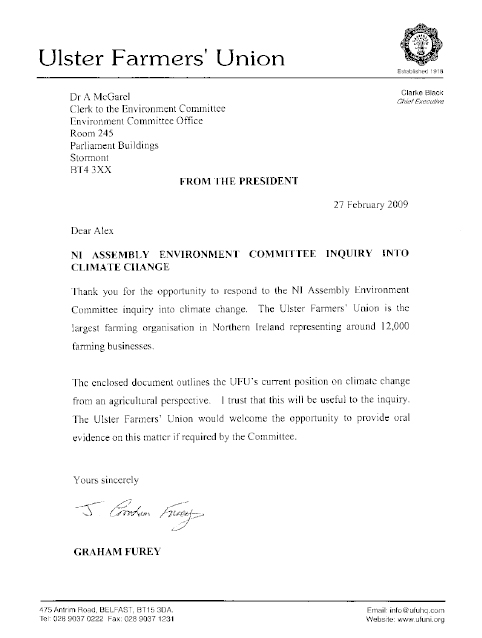
Ulster Farmers Union
UFU Response to NI Assembly Inquiry into Climate Change
27th February 2009
Introduction
Climate change is an important issue for agriculture and therefore would merit an inquiry on this aspect alone to fully consider the issues outlined in the terms of reference. Farm businesses in Northern Ireland need to adapt to a changing climate, potentially reduce greenhouse gas emissions while continuing to produce competitive quality food for the local and global marketplace. The UFU therefore feels that the agricultural sector needs to be specifically considered in the climate change debate and this response focuses on this aspect.
Emissions from Agriculture & Research
The Climate Change Committee report that 7% of UK Greenhouse Gas Emissions are from agriculture mainly coming from the use of fertiliser, enteric fermentation and manure management (in NI the proportion is much higher). This includes about 39% of UK methane emissions, about 67% of nitrous oxide emissions and 1% of carbon dioxide emissions. Agriculture is therefore a contributor to greenhouse gas emissions, particularly non-CO2 emissions.
It is recognised by the Committee on Climate Change that there is currently limited measurement of emissions at farm level. The UFU therefore feels that it is vital that more research is conducted in Northern Ireland to establish an accurate baseline before any decisions are taken on specific GHG emissions targets for the agricultural sector. We are aware that the Agri-Food and Biosciences Institute (AFBI) are working on some advanced research on the overall greenhouse gas emissions from dairying systems however this needs to be further analysed.
The UFU suggest that more research is also required in Northern Ireland on the potential impacts of climate change on the agricultural sector, adaptation measures and the consequences of these in terms of GHG emissions, and also on realistic measures for reducing greenhouse gas emissions.
It is also important to recognise that while agriculture contributes to greenhouse gas emissions, it could also play a significant role in mitigation through acting as a carbon sink and with the potential to produce renewable energy therefore displacing CO2 emissions produced by fossil fuels.
NI Commitments / Targets
Any proposals to identify Northern Ireland commitments or to set targets for local greenhouse gas emission reduction for the agricultural sector must be based on sound science, must be realistic and achievable. As it is not yet possible to produce accurate baseline figures at farm level, it is difficult to determine what actual effect potential actions on local farms will have on helping to meet overall targets. There are currently conflicting views on how agriculture should reduce emissions while continuing to produce quality food and therefore it is difficult to outline a route map for the sector until more work is carried out. E.g. a high yielding dairy cow will produce less methane per litre of milk but this is in a high input system. Others would propose that it there are less overall GHG emissions on a grass-based dairying system using a lower yielding cow but ultimately producing more methane per litre of milk. A further example of conflict is that farmers were advised to consider minimal-tillage / no-tillage systems to increase organic matter in soils and therefore sequester carbon however it has been identified that as these soils become anaerobic the NOx emissions are significantly increased therefore outweighing any benefits of carbon sequestration.
International Commitments
It is also important to recognise that discussions will take place in 2009 regarding a successor to the Kyoto Protocol. There are important points that need to be addressed to ensure that local agriculture is not penalised in any new agreement. The UFU believes that the Clean Development Mechanism within the Kyoto Protocol is currently flawed. The Clean Development Mechanism (CDM) allows industrialized countries with a greenhouse gas reduction commitment to invest in projects that reduce emissions in developing countries as an alternative to more expensive emission reductions in their own countries. This means that industry and power stations in the developed world can purchase ‘carbon credits’ from farmers for example using anaerobic digesters in the developing world to off-set emissions however farmers in NI using the same technology cannot benefit from this mechanism. Countries like Brazil who are competing with NI on the beef, pork and chicken markets qualify for the CDM and are effectively receiving a subsidy via this mechanism from industry in the UK which allows them to sell produce at a much cheaper rate than local farmers in the local market place. It is vital that such arrangements are considered during the 2009 talks and addressed in the successor agreement to the Kyoto Protocol. Industry in the developed world should be permitted to purchase carbon credits from UK farmers for carbon sequestration in land, forestry or through producing renewable energy.
It may also be easier for other countries to meet international targets due to differences in the techniques permitted. For example farmers in USA, Canada, Brazil and Argentina will be able to significantly reduce methane emissions from cattle by using growth promoters which are banned in the EU. These will allow animals to grow faster and therefore produce more milk or beef in a shorter period of time and consequently lower methane emissions. It is unfair to expect similar reductions in the EU where these substances are illegal and alternative practices to deliver such reductions would result in much more costly changes on farm.
Adapting to a changing climate
Agriculture is dependent on the climate and continuously adapts to any changes. UK farmers can and will adapt their farming practices, but it is important that they are assisted through adequate advice and information from Government. Climate change presents significant threats to farmers e.g. decreased water availability in some areas, weather extremes etc, but also opportunities e.g. new crops may be able to be grown. It is important that NI is ready for potential changes by carrying out the necessary research work and technology transfer sooner rather than later.
The UFU would also ask the Environment Committee to note that changes to current practices in order to cope with a changing climate could lead to increasing greenhouse gas emissions from farms. For example to cope with a drier summer more irrigation may be required resulting in increased emissions at an individual farm level. Wetter winters may result in livestock being housed for longer periods which could also increase overall emissions for the sector. There will also be a cost associated with such adaptation (see below).
Genetically modified (GM) crops may become more important in helping to adapt to climate changes and the consequences arising from such change such as increases in pest or invasive species. Current policies on GM crops may need to be developed to take account of this.
Renewable Energy
Government is also focused on renewable energy and its potential to mitigate excessive climate change and the UFU believes that this new direction creates many opportunities for local farmers. Northern Ireland farmers are well placed to produce renewable energy and the UFU has outlined this fully to the NI Assembly Agriculture Committee in their recent inquiry into renewables. It is important to highlight that the policies the Northern Ireland Government decides upon encourage the integration of this renewable energy into an existing energy network. This will require difficult but minor changes to the current supply chain structure to allow free competition for local markets that are currently exclusively supplied by external investors.
It is also important that the Northern Ireland Government opens strenuously protected markets such as electricity and fuel to local producers at financially viable prices. The previous NI Electricity Regulator reported that the producer of electricity should receive 80% of the retail value, this aspiration has not even come close for the average local renewable electricity supplier. If this figure could be achieved then direct financial support, required to install technologies, such as anaerobic digestion or small scale combined heat and power or even larger projects such as tidal power, would be supplied by commercial financial institutions without further ongoing government financial support.
In Germany, the government guaranteed the electricity supplied price from anaerobic digesters at approximately 20¢ per kilowatt hour. This promoted a very large number of installations because they became financially worthwhile – in Northern Ireland anaerobic digesters are currently not financially viable with the low electricity price offered resulting in gases from waste and organic manures that should be fuelling our local economy and displacing fossil fuels, currently adding to our greenhouse gas emissions. It is therefore important to consider these aspects in conjunction with developing policies on reducing greenhouse gas emissions and climate change.
Costs to Agriculture
The UFU would be concerned that policies put in place to meet emissions targets could result in rising costs for local farmers leading to higher food prices. If consumers are unwilling to chose the locally produced higher cost product this would have a severe impact on the agri-food sector. The sector in Northern Ireland could become uncompetitive in the global marketplace with the result that food production is moved elsewhere therefore simply moving the environmental problem with no global benefit. The consequences of this action would be considerable on the NI economy which relies heavily on the agri-food sector.
It is impossible to identify the costs associated with meeting obligations in the agricultural sector until there is better science and understanding of the size of the challenge for the sector. The costs are also very much dependent on the decisions taken by Government on how targets should be met. For example, it is suggested that lifestyle changes such as moving away from meat in diets will reduce methane emissions as the number of livestock will decrease however this would have catastrophic consequences for the agri-food sector and the local economy and there may be other environmental implications and costs by simply exporting the problem elsewhere and changing the way the countryside is managed. Reducing livestock numbers could may not reduce methane emissions e.g. if agricultural land lies dormant, vegetation will not be managed and may rot and produce methane during breakdown.
There is potential to reduce greenhouse gas emissions by changing farming practices and in some cases depending on what is suggested this could result in cost-savings for local farmers. For example, reducing fertiliser application where it is applied in excess and making better use of organic manures. NI is already being driven down this route since the introduction of the Nitrates Directive and therefore is already reducing GHG emissions indirectly via this water quality policy.
It is important that Government recognises that if more costly measures are imposed on local businesses such as forcing farmers to invest in new technologies, this would lead to increased costs for farm businesses which could affect the competitiveness of local farms as outlined above.
There are also likely to be increases in the costs to farm businesses in dealing with a changing climate e.g. increased need to spray crops due to increase in disease problems or a requirement to house livestock for longer periods due to wetter winters.
Rather than imposing costs, levies or taxes on farm businesses to force farms to reduce GHG emissions, the UFU would prefer an approach where farmers are rewarded for reducing emissions. The agriculture sector could be rewarded for their role in carbon sequestration into soils and vegetation, for changing practices to reduce emissions, for adopting new innovative technology or for producing heat and electricity from renewable sources. This could be advanced through trading schemes, incentivising the uptake of certain techniques and technologies and as outlined above making changes to the electricity supply chain.
The UFU would support the need for an effective mechanism to identify costs associated with the new climate change policies. As outlined above it is vital to properly assess the cost and benefits of any new climate change policies in NI but this cannot be looked at in isolation of other Government policies.
Retailers
UK retailers have already indicated a desire to move towards ‘carbon labelling’ of food products. The British Standards Institute have recently developed a Publicly Available Specification (PAS) for a method for measuring the embodied greenhouse gas (GHG) emissions from goods and services at the request of DEFRA and the Carbon Trust. The PAS method for measuring GHG emissions of goods and services will enable businesses to effectively measure the climate change related impacts of their goods and services with a view to using this information to improve the climate change related performance of these.
Demands from the retailers are at present the biggest threat to local farmers and food processors on this issue requiring almost immediate action to label products and ultimately moving towards ‘lower carbon’ products to apparently satisfy ‘consumer demands’. It is reported that using this new standard, Brazilian beef is currently performing better than locally produced beef in terms of the ‘carbon footprint’, but this mechanism fails to take into account the destruction of the Brazilian rainforest, the use of GM crops and growth promoters in these systems and other environmental consequences. The UFU queries the ability of the consumer to interpret this information and would urge Government to consider the implications for local farming when the retailers go down this route. It is vital that Government moves in a joined-up approach to help rectify this position.
Government
It is vital that there is a joined up-approach within the Northern Ireland Executive and in partnership with the agri-food sector on all of the above. The Committee on Climate Change have outlined that any policy identified for reducing emissions from the agriculture sector cannot be taken in isolation as there may be implications for other policy objectives e.g. biodiversity, water quality, food production, energy, animal welfare etc therefore requiring all Government departments to work together. It is also important that discussions result in actions being taken to help the agri-food sector adapt to climate change and move towards achieving any targets in a managed way backed up with scientific and practical information and advice.
Woodland Trust’s Response to
the Environment Committee’s
inquiry into Climate Change
1. The Woodland Trust welcomes the opportunity to respond to this consultation. The Trust is the UK’s leading woodland conservation charity. We have four main aims: no further loss of ancient woodland, restoring and improving woodland biodiversity, increasing new native woodland and increasing people’s understanding and enjoyment of woodland. We own over 1,000 sites across the UK, covering around 20,000 hectares (50,000 acres) and we have 300,000 members and supporters.
Summary
- The Northern Ireland Executive should now legislate for a carbon reduction target in order to establish what contribution the province will make to the overarching UK wide targeted cut in carbon emissions of 80 per cent by the year 2050.
- Climate change will continue to have significant, and negative, impacts on both wildlife and people. Accordingly, there is a need for landscape scale action in Northern Ireland to help secure the natural environment and the ecosystem services it provides such as clean air, enhanced soil and water quality.
- Caution should be exercised when imposing a purely economic valuation on the natural environment. Indeed, it is widely accepted that there has been a decline in the quality and diversity of Northern Ireland’s wildlife over the past fifty years, and therefore more must be done to safeguard vitally important environment assets such as ancient and long-established woodland.
- Given the crucial role woodland can play in helping Northern Ireland negate and adapt to climatic change, the Northern Ireland Sustainable Development Strategy should align its woodland creation target to that of the Northern Ireland Forestry A strategy for Sustainability and Growth by committing itself to doubling woodland cover in the province.
- The suite of PSA indicators should be expanded to include protecting, restoring and expanding the most important natural habitats. These habitats, including woodland, can help wildlife and people adapt to the negative impacts of climate change.
- All departments have a role in ensuring that Northern Ireland is able to meet is climate change objectives. As a consequence, the Assembly should be prepared to scrutinise the actions and pronouncements of any Minister whose policies might have an impact on the environment.
a. To identify initial commitments for Northern Ireland that will ensure it plays a fair and proportionate role as part of the UK in meeting climate change targets
2. In the Climate Change Act there is no legally binding emissions reduction target for Northern Ireland, and therefore it is unclear as to what is expected of the province in terms of its contribution to the UK wide target of an 80 per cent cut by 2050. To give clarity and transparency to climate change policy, the Executive could now legislate for its own target; and should at the very least put into statute the commitment in the Programme for Government to ‘Reduce greenhouse gas emissions by 25 per cent below 1990 levels by 2025’.
3. Section 60 of the Climate Change Act, ‘Programme for adaptation to climate change: Northern Ireland’, details the relevant duties Northern Ireland departments will have in relation to adapting to the negative impacts of climatic change. Crucially, the Assembly must be rigorous in its scrutiny of the adaptation programme, and this could take the form of annual report by the Environment Committee judging the actions and performance of the Executive’s departments and agencies.
4. Climate change is already here. It impacts on woodland habitats and the species they support by disrupting life cycles, altering interactions between species, and often requiring them to migrate to more suitable conditions. In light of this dynamic an adaptation strategy should focus on certain principles such as protecting the best of the resource, expanding it where possible, and restoring it where it might have been degraded. This should mean absolute protection of ancient and long-established woodland, creating new woodland where it can benefit either wildlife or people, and restoring ancient woods that were degraded by the planting of non-native conifers.
b. To consider the necessary actions and a route map for each significant sector in Northern Ireland (energy, transport, agriculture and land use, business, domestic, public sector etc)
5. Northern Ireland has a highly fragmented landscape and the likely rates of climate change threaten the survival of its natural world. Accordingly, the Trust expects the Northern Ireland Executive and its departments to recognise the importance of native woodland, in particular ancient and long-established woodland and ancient trees, as the foundation for the restoration of this fragmented landscape.
6. The Trust believes that there is a need to target actions at a landscape scale level.[1] When implementing an adaptation programme, the Executive could create new wildlife habitats within a sympathetically managed landscape that allows as many species as possible to adapt, and move, in response to changes in climate.
7. As climate change becomes a pressing issue for Northern Ireland, it is important that the Executive delivers on its commitments held within the following documents: the Northern Ireland Biodiversity Strategy, Northern Ireland Forestry A strategy for Sustainability and Growth, and the Northern Ireland Sustainable Development Strategy. These commit the Northern Ireland Executive to restoring ancient woodland, doubling woodland cover, and protecting important semi-natural habitats.
8. Further to this the Trust has produced its own manifesto, A vision for woodland in Northern Ireland. In response to a parliamentary question, OFMDFM welcomed our document as a ‘useful perspective on the environmental and social aspects of forestry.’[2] The Trust now hopes that our document will be incorporated into the wider policy framework.
c. To identify the costs associated with meeting these obligations and compare them with the costs that will be incurred if they are not achieved.
9. There is much research going into whether it is possible to impose an economic valuation onto the natural environment – something that remains deeply controversial because it is easier to place a value on biodiversity or ecosystem services that can be traded, whereas it is it is near impossible to do this for those that are not marketable. The Assembly should therefore be cautious, and possibly avoid trying to evaluate environmental policies by using a purely economic rationale.
10. Nonetheless, The Economics of Ecosystems and Biodiversity (TEEB report)[3] and an investigation into The Economic and Social Aspects of Biodiversity Benefits and Costs in Ireland[4] have sought to impose an economic valuation on the natural environment. The TEEB report concluded that: ‘The loss of biodiversity and ecosystems is a threat to the functioning of our planet, our economy and human society.’[5] Such sentiments justify spending public money on protecting the environment and improving the public’s engagement with, and understanding of, the natural world.
11. Moreover, in 2007 a piece of research, The Environmental Economy of Northern Ireland, put the gross value added accruing from forestry in the province at £3 million.[6] Tourism was a vital component in this success, and therefore protecting the best of the resource is vital if the province is to continue attracting inward investment and visitors.
12. Northern Ireland suffers from a legacy of habitat removal with 13 per cent of ancient and long-established woodland that survived to the 1960s being lost; representing a total of 273 ancient and long-established woods that have been cleared altogether. Additionally, the Executive is committed in the Programme for Government to reduce significantly the loss of wildlife by 2010 and halt wildlife decline by 2016. In response to this point it is quite legitimate that any climate change adaptation programme ensures that biodiversity is able to adapt in the face of climatic change. In respect of woodland conservation this should mean absolute protection for ancient and long-established woodland, restoration of those woods previously degraded by the planting of non-native conifers, and targeted woodland creation to benefit both people and wildlife.
13. A DOE led adaptation strategy should afford an opportunity to implement landscape scale action and impress upon the public conscious the value of the ‘services’ that Northern Ireland derives from a healthy natural environment. For example, this could be an ideal moment to create new woodland and restore those woods previously degraded by non-native conifers. In support of this the Trust has evidence demonstrating the economic benefit of restoring ancient woodland,[7] and perforce restoring PAWS should be a key strand in an adaptation strategy.
d. To identify a formal cost effective mechanism for assessing the potential impact of new policies on climate change / CO 2 emissions. (Akin to Regulatory Impact Assessments/Rural Proofing)
14. No comment.
e. To make recommendations for appropriate targets/actions that could be included in the new Northern Ireland Sustainable Development Implementation Plan
15. The original Northern Ireland Sustainable Development Strategy committed the Executive to increasing the area of forestry by 500 hectares per annum. This though is a less ambitious target than the one in Northern Ireland Forestry: A strategy for Sustainability and Growth that pledged to double woodland cover in the next 50 years. The Trust hopes that any revision to the Northern Ireland Sustainable Development Strategy furnishes an ambitious woodland creation target – primarily broadleaved woodland given its ecological value – in recognition of the benefits the province could derive from expanding its wooded resource.
16. It is estimated that Northern Ireland has 87,000 hectares of woodland, and therefore to double woodland cover there will need to be approximately 1,740 hectares of new woodland planted per annum. This then, is the figure the Trust would like included in the Northern Ireland Sustainable Development Strategy.
17. In the past OFMDFM admitted that they were unable to measure the increase of wooded area in Northern Ireland as they did not know comprehensively the location of the resource.[8] Another action that should be identified in the Northern Ireland Sustainable Development Strategy is the creation and maintenance of a record of all woodland in the province. The Trust has already compiled an inventory of ancient and long-established woodland, and would now ask the Executive to take over the mantle by creating and then maintaining a comprehensive inventory of all woodland. Such an amendment would deliver upon the recommendations in the Northern Ireland Biodiversity Strategy.
f. To make recommendations on a public service agreement for the DOE Climate Change Unit’s commitments in the second Programme for Government that will ensure Northern Ireland will meet its climate change obligations.
18. Adapting to climate change will be one of the great challenges facing DOE in the coming years. To return the natural environment onto a sustainable footing it will be necessary to improve the connectivity between habitats in order that wildlife can migrate to more suitable conditions. This will involve protecting the most valuable semi-natural habitats, restoring those that have been degraded, and expanding the resource.
19. A new suite of public service agreements could be created to improve the current commitment to declare 75 ASSIs by 2011 held within the Programme for Government. This could include a commitment to protect all ancient and long-established woodland, to restore those sites previously degraded by the planting of non-native conifers, and to double the area of woodland in Northern Ireland.
20. The current target in the Programme for Government to increase by 1650 hectares the area of forests in Northern Ireland by 2011 will fail to double woodland cover. Indeed, this target will only increase the area of woodland in the province by approximately a quarter, and sits uneasily with other commitments. Any new public service agreement should seek to rectify this anomaly by providing a realistic target that is going to allow the Executive to deliver a doubling of woodland cover in 50 years.
21. There is broad ranging political support for creating new woodland in the Assembly as demonstrated by the cross party support for the Ulster Unionist no-day named motion stating:
That this Assembly notes the limited target set in the Programme for Government for increasing the area of forest and woodland; and calls on the Minister of Agriculture and Rural Development to detail the strategies that are in place to achieve the 2006 Forestry Strategy target of doubling woodland cover in the next fifty years.[9]
g. To consider what secondary legislation raising powers within the UK Climate Change Act would contribute to Northern Ireland’s commitment to the UK Climate Change Bill.
22. No comment.
h. To express views on if and how the Assembly might conduct more effective scrutiny of climate change responsibilities across all relevant departments.
23. All government actions can have a significant impact on the success of climate change policies. It therefore behoves the Executive to test all of its policies against any negative impacts they might have on climate change. So as to ensure compliance with commitments in the Climate Change Act, the various departmental committees in the Assembly should be prepared to challenge ministerial pronouncements whenever appropriate. Additionally, the responsibility to challenge the Executive as a whole rests with the OFMDFM Committee, and therefore the Trust would hope that their inquiries reflect the importance of negating, and adapting to, climate change.
24. Moreover, the Assembly could also give the Environment Committee the power to scrutinise all aspects of policy that might affect climate change irrespective of whether the issue under consideration falls within the remit of the DOE.
Annex One
Landscape-scale principles for Northern Ireland
Northern Ireland has a highly fragmented landscape and likely rates of climate change threaten the survival of its natural world. Accordingly the Woodland Trust expects the application of landscape-scale principles to allow the widest range of species to move, survive and evolve in the face of climate change. This could involve:
- Conserving those species believed to be fundamental to wildlife habitats; and using individual species to promote wider protection, restoration and creation of wildlife habitats.
- Affording absolute legislative protection to all ancient and long-established woodland and ancient trees and other habitats in the NI Biodiversity Action Plan, and recognising this resource as the foundation for the restoration the province’s fragmented landscape.
- Restoring all ancient woodland, in both Forest Service and private ownership, previously planted with non-native conifers and also other NI Biodiversity Action Plan open habitat previously planted with conifers.
- Creating new habitats, including native woodland, where wildlife is best placed to survive. In practice this could involve creating new habitat where ancient woodland and other semi-natural habitat is already in abundance.
- Implementing habitat creation to buffer ancient and long-established woodland from negative land-use.
- Ensuring that the wider countryside is managed sustainably in order that wildlife can easily move across it. Climatic uncertainty dictates that it is not sufficient to simply physically link existing habitats.
- Demonstrating the benefits that society derives from a healthy natural environment. These include improved air and soil quality, flood alleviation, high quality food and timber, improved public health and opportunities for recreation and employment. As an exemplar, wooded habitats should be protected and expanded where it offers benefit in regard to either public amenity or wildlife conservation.
Woodland Trust, 1 Dufferin Court, Dufferin Avenue, Bangor, County Down, BT20 3BX
www.woodland-trust.org.uk/campaigns
For more information, please contact:
Lee Bruce at LeeBruce@woodlandtrust.org.uk 08452 935 551
[1] See Annex One, Landscape scale principles for Northern Ireland.
[2] Northern Ireland Assembly, Written Answer, ref AQW 1851/09 (7 November 2008) http://archive.niassembly.gov.uk/qanda/2007mandate/writtenans/2008/081107.htm
[3] Pavan Sukhdev, The Economics of Ecosystems and Biodiversity (2008).
[4] Government of Ireland, The Economic and Social Aspects of Biodiversity Benefits and Costs in Ireland (2008).
[5] Sukhdev, The Economics of Ecosystems and Biodiversity, p. 14.
[6] Northern Ireland Green NGOs Group and the Environment and Heritage Service of Northern Ireland, The Environmental Economy of Northern Ireland (April 2007), p. 48.
[7] Woodland Trust, The cost of restoring plantations on ancient woodland sites – an analysis of the economics of future management options.
[8] Northern Ireland Assembly, Written Answer, ref AQW 2962/2 (1 February 2008) http://archive.niassembly.gov.uk/qanda/2007mandate/writtenans/080201.htm
[9] Northern Ireland Assembly, Official Report (4 November 2008), http://archive.niassembly.gov.uk/record/reports2008/081104.htm#6
WWF Northern Ireland
WWF Northern Ireland
2nd Floor
7 Exchange Place
Belfast
BT1 2NA
tel: 028 9330 2869
fax: 028
northernireland@wwf.org.uk
wwf.org.uk/northernireland
Alex McGarel
Environment Committee Clerk
Parliament Buildings
Belfast BT4 3XX
Reference: Environment Committee Inquiry into climate change
27th February 2009
Dear Alex,
WWF Northern Ireland welcomes the Environment Committee’s inquiry into climate change and appreciates the opportunity to comment on this very important piece of work.
WWF Northern Ireland is part of the world’s largest independent conservation organisation in the world which operates in over 90 countries. WWF is a challenging, constructive, science-based organisation that addresses issues from the survival of species and habitats to climate change, sustainable business and environmental education. WWF has some five million supporters worldwide and approximately 90% of our income derives from voluntary sources such as people and the business community.
WWF works to
- conserve endangered species - such as tigers, great apes and whales;
- protect endangered spaces - such as forests, savannahs, wetlands and seas;
- address global threats to the planet - such as climate change and toxic chemicals
for the benefit of people and nature.
If you have a further queries on this submission please do not hesitate to contact me.
Yours sincerely
Malachy Campbell
Policy Officer WWF Northern Ireland
WWF Northern Ireland response to the Terms of Reference of the Environment Committee Inquiry into Climate Change
(a) To identify initial commitments for Northern Ireland that will ensure it plays a fair and proportionate role as part of the UK in meeting climate change targets
WWF Northern Ireland believes that Northern Ireland needs to set mandatory targets to reduce energy demand in absolute terms, reduce the overall contribution of fossil fuels, increase the contribution of renewables and reduce Carbon Dioxide (CO2) emissions by 80% from 1990 levels by 2050 and to plan appropriately, with targets, for the investment necessary to meet those energy targets set. The above key principles overlap and so a long term integrated approach needs to be taken, preferably via a long term energy strategy.
WWF Northern Ireland is therefore delighted that the Environment Committee has previously expressed support for Northern Ireland targets, for example in the Committee’s response dated 7th September 2008 to the UK Climate Change Bill.
WWF Northern Ireland is further encouraged by previous comments in January 2008, in relation to the North South study on renewable energy and the grid, made by the former Minister for Enterprise Trade and Investment, Nigel Dodds who said that Northern Ireland
“can make a significant contribution to the UK’s climate change goals by enhancing the amount of electricity generated from local renewable sources"
and that
“it is clear that we must be more ambitious in setting future renewable energy targets."
WWF Northern Ireland also supports the comments made by the current Minister for Enterprise Trade and Investment Arlene Foster at the launch of the pre scoping consultation on the Strategic Energy Framework in November 2008 that there is a need for Northern Ireland to plan
“for a sustainable energy future that will also deliver on EU climate change targets and increase security of energy supplies for domestic and business use"
and that
“The objective for us all is to achieve a successful, sustainable, long-term future for energy in Northern Ireland, through innovative and ambitious actions, involving a shared vision with industry and partners throughout the rest of the United Kingdom and the Republic of Ireland."
The targets set in Northern Ireland should at the very least match, but preferably surpass, the relevant UK targets in order to ensure it (Northern Ireland) plays a fair and proportionate role as part of the UK in meeting climate change targets, for example those targets in the Climate Change Act of 2008 and the UK targets in the EU Energy package of 2008, as endorsed for example, by the Minister for Enterprise Trade and Investment.
Tackling climate change and meeting Northern Ireland specific targets will, as things stand at present, require cross departmental co-operation, since many of the issues referred to above including energy, transport and agricultural policy are not the responsibility of the Department of Environment. As such there is a need for much greater levels of interdepartmental co-operation on climate change and energy issues. However, one possible option which WWF Northern Ireland supports is the establishment of an integrated sustainable energy agency for Northern Ireland, as a means of assisting the integration and better delivery of renewable energy policy and tackling many of the problems caused by the lack of a central department with responsibility for renewable energy. This was supported by recommendation number 38 in the ETI Committee’s “Report on the Energy Inquiry" published in March 2002 which said
“The Committee recommends the consideration of the establishment of a Renewable Energy agency."
This agency could operate on a similar basis to the existing agencies in Denmark, the Netherlands and Australia which have shown marked success in promoting the development of renewable energy in their respective countries. The agency, or body, should be responsible for inputs to policy and implementation. It should also have the political power to generate a public profile. The most appropriate option is for this body to be modelled closely or exactly along the lines of the Department of Climate Change and Energy (DECC) in Great Britain for facilitate greater UK wide cooperation.
(b) To consider the necessary actions and route map for each significant sector in NI (energy, transport, agriculture and land use, business, domestic public sector etc)
As stated above, some of the wide range of actions necessary to tackle climate change are beyond the remit of the Department of Environment and Environment Committee and the and as such the administrative/governance structures may need to be reviewed and amended if all these issues are to be tackled in more integrated fashion.
Overall, there is a clear need for Northern Ireland to move to a low carbon economy and WWF Northern Ireland believes ultimately, to a zero carbon economy. This needs to be the ultimate goal. Achieving such a transition will require urgent action in many sectors. The question of how various sectors including energy, transport, the domestic and public sector could contribute to tackling climate change in Northern Ireland was explored in the Carbon Trust Vision Study (CTVS) of 2005. The CTVS looked at how Northern Ireland could reduce its CO2 emissions by 60% by 2050 and estimated the cost of this at £775 million. Though both the level of CO2 reductions and the price of achieving them outlined in the CTVS are likely to now be out of date, with even greater reductions needed and an associated likely increase in cost, the fundamentals of the CTVS should still apply. In the absence of any long term strategic energy strategy in Northern Ireland the CTVS could provide a very useful foundation for a long term strategy. More detail on some of the main actions needed in relation to some of the sectors mentioned and on some of the main findings of the CTVS is given below.
It is worth noting that the Committee on Climate Change’s first report, released in December 2008, also includes an analysis of what opportunities exist for making emission reductions in Northern Ireland. It states Northern Ireland could contribute emissions reductions of over 2MtCO2e (Million tonnes of carbon dioxide equivalent) in 2020. Specifically,
- Emissions from buildings and industry could be reduced by up to 1 MTCO2 in 2020 by using energy more efficiently;
- More efficient vehicles and new transport fuels could deliver reductions of up to 1 MTCO2 in 2020;
- Emissions from agriculture, land use and forestry and waste management sectors could be reduced by up to 0.5 MtCO2e in 2020.
Though the timescales are different many of these figures are very close to the conclusions in the CTVS
Energy – decentralised energy and the grid
Basically there is a need to decarbonise, ultimately totally, the energy system. One of the key factors is the nature of the system for supplying/transmitting energy as the centralized grid is highly inefficient with two thirds of the energy generated wasted before it even reaches the consumer. There is then even further wastage at this point (of approximately 13%) resulting in a total cumulative loss of approximately 78%.
While WWF Northern Ireland recognises that the existing grid system will remain the primary vehicle for transmission and distribution of energy for much of Northern Ireland’s energy needs for the foreseeable
future and that further investment for amongst other things, reinforcement of the grid will be necessary, this shocking and avoidable waste of energy can be significantly reduced by greater use of distributed or decentralised energy. WWF Northern Ireland supports greater development of decentralised or distributed generation, which already provides over 50% of electricity supplies in Denmark and over 40% in the Netherlands and see decentralised energy as a key component of a lower carbon future for Northern Ireland.
Decentralised energy is also conducive to greater deployment of renewable heat e.g. through Combined Heat and Power (CHP) plants, which operate at very high efficiencies of approximately 80%, because
they also use the heat generated in the course of the electricity production process. Kilroot by contrast operates at around 30% efficiency, or less. Greater use of CHP can significantly reduce the amount of energy consumed and CO2 emissions – being, on average, twice as efficient as other plants, a CHP plant will, on average, produce approximately half the CO2 emissions of a conventional power plant. Though no new power plants are need, as Northern Ireland currently exports electricity any future power stations built should be CHP where possible.
Anaerobic Digestion (AD) offers a means of generating energy, in the form of natural gas, from animal and vegetable waste. According to AFBI in Hillsborough, the 9.7 tonnes of manure generated annually by housed livestock has the potential to produce 73MW electricity (10% of Northern Ireland demand) and 60 MW heat. Greater development of both CHP and AD in a more decentralised system would make a significant contribution to reducing our energy demands.
In the meantime, on the basis that the existing grid system will remain the primary vehicle for transmission and distribution of energy for much of Northern Ireland’s energy needs for the foreseeable future, WWF Northern Ireland would like to see mandatory priority access to the grid for renewables ahead of fossil fuel power plants.
The UK Government has acknowledged[1] that the nature of the current grid does pose challenges for
renewable energy and CHP industries. The 2002 House of Commons Trade and Industry Committee
(TIC) Security of Supply report says
“The Government agrees with the TIC’s view that the current design of the electricity distribution networks present a number of challenges to the connection of renewable and other small generation."
Housing
Over 27% of the UK’s CO2 emissions come from the residential sector. This needs to be reduced and the Government’s National Energy Efficiency Action Plan (NEEAP) has a target to reduce emissions from the domestic housing stock by 31% by 2020. However, WWF’s “How Low Can You Go?" report concluded that the UK can reduce CO2 emissions in the domestic housing sector by 80% by 2050 and this is the level of cutback we need to see achieved. The energy demand of houses also needs to be reduced, in line with Government targets for zero carbon housing
Transport
Emissions from road transport represented 29.4% of Northern Ireland’s CO2 emissions in 2006, an increase of 49.5% since 1990, and second only to energy production (35%)[2]. By comparison transport emissions in England increased by only 10% since 1990 so it seems clear that Northern Ireland has a disproportionate problem in relation to transport which needs to be tackled.
The use of alternative fuel sources, electricity in particular, for vehicles could help reduce these emissions, especially if the electricity were generated from a renewable source, such as wind power, thereby offering a completely green cycle for the fuel. WWF’s book “Plugged In: The End of the Oil Age" focuses on solutions to our reliance on oil for transportation needs, in particular the electrification of transport. As electric vehicles make use of up to 75% of electricity taken from the grid, they are up to 4 times more efficient than conventional mechanical vehicles where only 18-23% of the energy contained in the fuel is converted into motion.
The Presidency Conclusions of the Brussels European Council in June 2008[3] supported the greater use of electric cars – see paragraph 39 which said
“Other measures should be rapidly examined, in particular to promote competition in energy markets, promote modernisation of transport systems including the development of alternative technologies, inter alia electric cars"
Some European countries have already set targets for either the number or percentage of electric cars - Spain (1 million by 2014), Japan (50% by 2020) and the Republic of Ireland (10% by 2020). Gordon Brown has outlined his intention to have all new cars sold in Britain to be electric or hybrid vehicles producing less than 100 g/km of CO2 by 2020. In light of this push for more electric vehicles and the huge potential that exists in Northern Ireland for wind power, Northern Ireland really needs to grasp the opportunity offered by the electrification of the transport network as a matter of urgency and the development of an appropriate recharging network will be fundamental to any such expansion.
Hydrogen is another alternative fuel. Though hydrogen powered vehicles that use fuel cells have a lower efficiency (of approximately 40%) they emit only water. Hydrogen buses have been running in Chicago since the mid 1990s.
The Department of Finance and Personnel has a very important role, particularly in relation to the strategic investment plans for Northern Ireland’s transport system which are exacerbating rather than ameliorating the existing problems. The draft Investment Strategy says (page 12) that there will be £195.3 million spent on public transport 2008-11 and £611.8 million spent on roads 2008-11. According to the indicative budgets for the period 2011/12-2017/18 a total of £3,095 million will be spent on roads and £725 million on public transport. WWF Northern Ireland views this balance, whereby approximately three quarters of all of money is allocated for road building and approximately one third allocated for public transport as, at best, inappropriate as it compounds an existing problem, namely the inadequate provision of alternatives to car use, and is likely to make the achievement of Northern Ireland’s target to reduce GHG emissions by 25% by 2025 much more difficult to achieve
There is a sharp contrast with the plans announced by the Danish government in December 2008 of a “green traffic initiative" featuring infrastructure investments and transport measures costing DKr150bn (E20bn) over the next decade. According to the Danish plan, about two-thirds of the total will be spent on “renovating, improving and developing the railway network" with the aim of converting motorists to public transport. High emissions charges, road pricing, and financial incentives for fuel-efficiency are among a raft of additional measures. Similar strategic thinking and investment in greater public transport would be welcome in Northern Ireland.
Northern Ireland also has tremendous potential for the production of bioenergy, which could be used in the generation of electricity, a heating fuel and/or a transport fuel as discussed in greater detail below in the section on agriculture
Agriculture
In the course of 2008 both DARD and the ARD committee have explored how the agricultural sector and renewable energy may develop in the near future – DARD through the review of their Renewable Energy Action Plan (REAP) and the ARD Committee through their Inquiry into Renewables and Alternative Land Use. WWF Northern Ireland recommends that greater interdepartmental and inter committee collaboration is needed to tackle the issue of energy
The Northern Ireland Rural Development Programme does offer potential funding opportunities that can help contribute to the greater development of renewable energy in Northern Ireland thereby also contributing to the aims and objectives of other departments. A key underpinning rationale for the 2007-2013 Rural Development Programme is addressing climate change and WWF Northern Ireland is pleased that the Commission has guided Member States to include measures that will contribute to this objective under all axes of their programmes and not simply be considered as an Axis II priority.
In the Community Strategic Guidelines for Rural Development for the 2007-2013 Programming Period, Member States are encouraged to focus support on ‘development of new outlets for agricultural and forestry products, which includes “support for investment and training in the field of non-food production …by …helping the development of renewable energy materials, biofuels and processing capacity", under Axis I, ‘Improving the competitiveness of the agricultural and forestry sectors’. Also, by “developing the provision and innovative use of renewable energy sources", under Axis III, ‘Improving the quality of life in rural areas and encouraging diversification’. In addition to the more obvious ‘combating climate change’ element of Axis II these offer the potential for the NIRDP to make a significant contribution to Climate Change objectives. There is a need now that the programme is in place, for DARD to ensure that these measures are readily available to farmers, rural businesses and communities and positively incentivised with clear monitoring target associated to their delivery.
The potential role for AD has already been referred to. On top of that, biofuel production offers the rural and agricultural community another potential alternative means of contributing to future climate change, energy and emission reduction targets. Land use strategies also have an important role to play through the preservation of existing carbon stores or sinks, primarily peatlands but also forests, as well as developing new carbon sinks through planting native trees and woodlands.
While WWF Northern Ireland recognises the potential for renewable bioenergy sources to be grown in Northern Ireland it believes the broader impact of their production must be considered and acceptable levels of social and environmental performance in the production of bioenergy among supply chain actors, from growers to end users should all be factored in. For example, there is a risk, especially on a small island, that a biofuel processing plant would create a market demand that cannot be met locally. This would put pressure for biofuel to be imported. This risks creating a demand for importing biofuels that may not have been produced sustainably and this could have significant, long term detrimental consequences for people and nature, as exemplified by the biofuels produced from the palm oil plantations that have been planted on former rainforest in Indonesia. The changes in land use for biofuel production in the US and subsequent changes in wheat prices demonstrates how global changes in policy and demand can affect commodity prices.
In WWF’s view, the following environmental principles need to be addressed by any standard as a minimum both for crops produced in Northern Ireland and as a requirement for imported fuel sources
- not damage high conservation value habitats and biodiversity
- not degrade soil quality
- not adversely impact the quantity and quality of freshwater resources
- not lead to damaging release of toxic compounds into the environment
- lead to substantially positive lifecycle GHG balances compared to fossil fuel equivalents
Ireland has the greatest potential in Europe for growing biomass, which through the use of CHP offers the possibility of a much more efficient renewables based energy system.
The role of government
There is clear role for government, not least in relation to meeting the target in the NI SDS for the government estate to be carbon neutral by 2015. In order to meet this target WWF Northern Ireland believes each government department should investigate the opportunities and obstacles to carbon reductions within their competency areas. The Public Sector procurement budget should be targeted as a tool to deliver significant emissions reductions.
(c) To identify the costs associated with meeting these obligations and compare then with the costs that will be incurred if they are not achieved
There are two distinct but related parts to this section. The first deals with the predicted costs of inaction and/or delay in tackling climate change while the second part deals with the predicted benefits of tackling climate change by moving to a low/zero carbon future by reducing energy consumption and investing in low carbon/renewable energy sources.
The predicted costs of inaction and or a delay in tackling climate change
It is important to state that not only will tackling climate change be less expensive now than in the future, but costs of the impacts of climate change are also like to increase significantly the longer the delay in tackling climate change, as highlighted by the Stern Review of the Economics of Climate Change (2006) which said tackling climate change could cost 1% GDP each year but
“if we don’t act it the overall costs and risks of climate change will be equivalent to losing at least 5% of global GDP each year now and forever. If a wider range of risks and impacts is taken into account, the estimates of damage could rise to 20% of GDP or more."
This makes a very clear and persuasive argument in economic terms alone that climate change must be tackled urgently and the sooner the better. The increasing costs associated with a delay in addressing the issue were highlighted in an article in the Guardian on 26th June 2008 by Lord Stern in which he claimed that the costs of tackling climate change have already doubled since his 2006 report and estimated that £28bn may be need to tackle climate change. It is clear then that climate change must be tackled urgently.
It appears likely that there will be additional costs from climate change across a range of sectors including, but not limited to public health, biodiversity and loss of ecosystem goods and services, increased cost of extreme weather, including flooding and other associated insurance losses and impacts on agricultural production.
The European heatwave of 2003 was responsible for 35,000 extra deaths across Europe as a result of heat stress, bad air quality, and high levels of air pollutants such as ozone. A report commissioned by the Health and Environment Alliance (HEAL), Climate Action Network Europe (CAN-E) and WWF claims that health savings of up to €25 billion could be achieved every year in Europe if the EU raised its 2020 target for domestic greenhouse gas emissions from 20 to 30%, based on economic evaluations of loss of life and health, working days lots and hospital costs: they show reductions in hospital admissions of 8,000 per year and 2 million fewer work days lost per year by raising the target to 30%.(4) A European Commission impact assessment estimated that currently every year 369,000 people die prematurely in Europe due to air pollution and that premature deaths, health care and medication associated with air pollution amount to 3-9% of EU GDP[4]. According to Northern Ireland’s Chief Medical Officer Michael McBride
“Current predictions on climate change suggest greater long-term impacts on health than any current public health priority" [5]
The projected shift in precipitation patterns and distribution predicted for Ireland is likely to have a number of impacts. According to Sweeny et al[6] large parts of the south east of Ireland and Wicklow, Dublin, Louth and Down could receive less than half their current summer rainfall. On this basis the summer flow of the Boyne is predicted to drop by as much as 20% by the 2020s and up to 40% by the end of the century. The decrease in summer rainfall predicted may no longer suit the growing of potatoes, and as a result the report predicts
“It is likely that potatoes will no longer be a commercially viable crop over much of Ireland".
Evidence for a change in potato growing was provided by Hickey 2008[7] who stated that in 2001, perhaps 15% of Ireland’s potato crop was being irrigated. Agriculture may change in other ways and increased warming as well as increased storminess could have a negative impact on the Orchard County’s most famous agricultural product, as apples need a certain amount of cold to complete their development.
There is also a risk of more extreme weather resulting in higher numbers of larges insurance claims and/or losses. In 2004 Swiss Re predicted that economic costs of global warming could reach $150 billion a year in ten years though in 2005 weather-related insurance losses around the world totalled $200 billion.
Projections from the Association of British Insurers suggest that by 2050 the annual cost of weather claims will double to €3.3 billion while an extreme year might cost €20 billion.
According to the WWF report “Stormy Europe" the UK is likely to see the most drastic increase in storm activity if CO2 emissions rise unabated. 3 out of 4 models show the number of severe storms would likely increase by up to 25% by the end of the century - an increase of up to nearly 10 more storms over the 30 year period 2071-2100. This provides grounds for concern because winter storms are the cause of nearly 70% of all insured losses in Europe, costing an average of over €2 billion in financial losses a year[8]
The predicted benefits of tackling climate change by moving to a low/zero carbon future
Given that the two principal strands of tackling climate change will be reducing our energy demand in absolute terms and decreasing the amount of energy used and generated from fossil fuels while increasing the amount of energy used and generated from renewable sources, there are likely to be very significant economic advantages from this move to a low/zero carbon future - it will be a win-win situation.
A HSBC evaluation[9] of the various economic stimuli packages from around the world highlighted the benefits of tackling climate change and noted that amongst the arguments for a low carbon stimulus
“The low-carbon economy can also be a job rich economy at a time of soaring unemployment, particularly through enhancing building efficiency, either via retrofit or new construction, and improving mass transit."
The New Economics Foundation have advocated the need for a green new deal[10] to deal with what they referred to as the ‘triple crunch’ of a credit fuelled financial crisis, accelerating climate change and soaring energy prices underpinned by an encroaching peak in oil production. Similarly, an evaluation of the case for a ‘green’ stimulus co-authored by Nicholas Stern concluded[11]
“this is the right time to be spending on measures to promote energy efficiency and low-carbon technologies"
This report evaluated and ranked 23 specific proposals in terms of economic benefit and climate benefit and energy efficiency measures were consistently the top performers across all sectors. Though the benefits were not taken into account in the formal scoring the authors acknowledged that energy efficiency measures
“also enhance energy security and help the less well off with their fuel bills"
Research in California[12] found that well documented household energy savings of $56 billion 1972-2006 energy efficiency measures have enabled California households to redirect their expenditure toward other household goods and services creating about 1.5 million FTE jobs with a payroll of $45 billion. Similarly, the potential economic and environmental benefits of reducing demand, was outlined by the Performance and Innovation Unit[13] who said
“The current, apparently cost effective, potential for energy efficiency is approximately 30% of final energy demand. The potential financial benefits in reduced costs to customers (net of taxes) are £12 billion annually. And the potential carbon reductions are 40 Mtc/year…"
The importance of energy efficiency was clearly highlighted by DETI who said that[14]
“Reducing overall energy demand offers the potential for the most social, environmental and economic gains"
and that
“The Northern Ireland Authority for Utility Regulation (NIAUR) also recommends energy efficiency as the best opportunity to reduce emissions and energy bills in the near to medium term"
The target to reduce Northern Ireland’s energy consumption by 1% annually between 2007 and 2012, was outlined in DETI’s 2004 Strategic Energy Framework (SEF). However, a review of the sustainable energy market done by Arthur D Little Limited of electricity consumption in Northern Ireland between 1992 and 2007 in conjunction with NIE historic data shows the standard growth in electricity consumption to be 1.8% per annum between 1992 and 2007. The discrepancy between the target of 1% annual reduction in consumption and the reported 1.8% annual growth in consumption (1992-2007) is disappointing and needs to be turned around as a matter of urgency if this already weak and unambitious target is to be met. Given the target in the 2008-2011 Programme for Government (PfG) to reduce our carbon footprint by at least 25% by 2025, the level of reduction in energy consumption needs to be much higher than the 2004 SEF target, if this target is to be met. WWF Northern Ireland believes that in line with the emerging science, Northern Ireland should aim to reduce its CO2 emissions by at least 40% by 2020 and at least 80% by 2050.
Overall, the energy supply system needs to be decarbonised as much as possible and ultimately completely - WWF has previously advocated EU energy supplies should and can be completely decarbonised by 2050. The 2008 report “80% Challenge – delivering a low carbon UK" (copy attached for reference) commissioned by WWF UK, ippr and RSPB, concluded that it is feasible to reduce the UK’s emissions by 80% by 2050, without new nuclear build, including emissions from aviation and shipping and at costs that are not prohibitive, estimated to be between 2% and 3% of projected GDP in 2050, though energy efficiency could markedly reduce these costs to approximately 1.5% to 2% of GDP. This study used the MARKAL-MACRO model used by the Government for the 2007 Energy White Paper and a model developed by Professor Dennis Anderson at Imperial College, employed by the Stern Review on the economics of climate change and
The very significant benefits in terms of job creation potential from greater investment in renewables should make this a priority area for investment in Northern Ireland. According to the terms of the EU Energy package announced in January 2008, one of the UK’s legally binding targets is to achieve a 15% share of renewables in the final energy demand by 2020. A series of interim targets were also agreed by the EU on the following basis: member states must achieve a 25% of their 2005-2020 renewables increase by 2012, 35% by 2014, 45% by 2016, and 65% by 2018. Together these targets would make up an “indicative trajectory" that each member states would be expected to follow. Northern Ireland at present generates approximately only 1.8% of its energy from renewables (a total of 0.74 TWh). WWF Northern Ireland believes that Northern Ireland should at least match the UK level target of generating 15% of energy from renewables by 2015. On that basis and the basis that energy consumption does not increase beyond the current level of 40.7 TWh, in order to meet this EU target Northern Ireland energy production from renewables will need to increase by approximately by 731% by 2015 to approximately 6.16 TWh (15% of 40.7 TWh). This is a very significant increase and will require significant investment. Even if only a relatively small percentage of this investment is inward investment in Northern Ireland based industries there is enormous potential for both job creation and economic development as a result.
There have been many studies which show the economic benefits of investing in renewables, only some of which are referred to here, and the enormous potential that exists across the island for wind power is well known. According to the European Wind Energy Association, wind energy direct employment has increased from 48,363 in 2002 to 108,600 in 2007. In terms of direct jobs alone, on an average of 33 new people have been employed every day, seven days a week in the wind energy sector during that time period.[15] Including indirect employment the wind energy sector employs more than 150,000 in the EU.
A study by European Foundation for the Improvement of Living and Working Conditions found that the adoption of best available energy conservation technologies could create 500,000 extra jobs in the EU.[16]
A 2008 report by WWF France concluded that a 30% reduction in CO2 emissions by 2020 would create around 684,000 new net jobs in France.[17]
Even on a regional the scale the economic opportunities are significant. The Yorkshire Regional Economic Strategy 2006-2015 found that meeting the regions targets to reduce GHGs by at least 30% by 2020 and 80% by 2050 and have 22% renewable electricity by 2010 could generate 13,000 new jobs.
The benefits of developing a low carbon/renewables based economy are well illustrated by the example of the Austrian town of Güssing which has been transformed by the initiative of the townspeople themselves, led by the Mayor, from one of the poorest towns in Austria, to one of the wealthiest, based upon the development of a 100% renewable supply of energy for the town, which has reduced its CO2 emissions by 95% since 1991 and is now exporting renewable energy to the grid shows how a transformation from a fossil fuel based energy system to a renewables based system can also generate significant economic benefits.
The potential for job creation from investing in renewable energy technologies was also highlighted by the Northern Ireland Manufacturing (NIM) group who have called on the Executive to accept the
challenges and opportunities presented by climate change. NIM have said climate change[18]
“creates significant value creation opportunities for proactive companies and puts significant value at risk for companies that fail to adapt"
and that
“There is huge potential for Northern Ireland industry as a whole to be proactive, to establish itself at the cutting edge of these new technologies, bringing major opportunities and new markets."
Similarly the CBI have stated argued that delivering an investment framework to decarbonise the UK’s energy supply should be one of the UK Government’s priorities for 2009[19] and that
“We must not allow the global economic crisis become an excuse for inaction on climate change"[20]
According to the CBI,[21] evidence suggests that over time dangerous climate change
“would inflict damage to the UK economy of over £75 billion annually".
Denmark has shown how an economy can thrive while developing clean energy and cutting carbon emissions. Between 1980 and 2004, the country’s GDP rose 56% while CO2 emissions dropped 35%.[22]
(d) To identify a formal cost effective mechanism for assessing the potential impact of new policies on climate change/CO2 emissions (akin to regulatory impact assessments/rural proofing)
WWF Northern Ireland is unclear what the Committee means as regards identifying a mechanism for assessing the potential impact of new policies on climate change/CO2 emissions. Given that CO2 emissions all across the UK are monitored, collated and published every year, at present by AEA Technology PLC on behalf of England, Scotland, Wales and Northern Ireland, there may be no need for any additional mechanism to assess the potential impact of new policies on CO2 emissions as any reduction or increase in CO2 emissions will be measured annually as a matter of course.
Similarly while climate change is a global phenomenon, there has been some work done on assessing the impact of climate change in Northern Ireland for example by SNIFFER[23] and MONARCH[24]. However, WWF Northern Ireland does believe that improving the level and frequency of environmental monitoring would be useful and should help provide better evaluation of any new policies. On the basis that the State of the Environment report will be an annual publication it should help provide some evaluation of how Northern Ireland’s environment is being affected by and is responding to climate change. As such there may be no need for any additional mechanism to assess the potential impact of new policies.
In relation to policies, WWF Northern Ireland believes that long term plans, supported by a strong legislative framework, are the best way to promote efficiency and innovation in policy and technology design and thus the best mechanism to minimise costs and calls upon the Committee to support WWF’s call for a long term energy strategy.
(e) To make recommendations for appropriate targets/actions that could be included in the new NI Sustainable Development Implementation plan
As regards appropriate targets for Northern Ireland, WWF Northern Ireland believes that given the huge potential that exists in Northern Ireland for renewable energy Northern Ireland should, as a minimum, commit to matching the standards and/or targets that apply to the UK as a whole. This means for example, that Northern Ireland should also adopt the targets set in the UK Climate Change Act of 2008 to reduce GHG emissions by at least 26% by 2020 and 80% by 2050, with annual reductions of at least 3%. In 2008 the UK Climate Change Committee recommended cuts of 34% below 1990 levels by 2020 without a global deal on emissions reductions, and 42% with a global deal. WWF Northern Ireland believes that Northern Ireland should set a target of a 42% reduction, to be delivered through domestic action. Similarly WWF Northern Ireland believes that Northern Ireland should at least match the target, to generate 15% of its energy from renewables, set for the UK as part of the EU Energy Package in 2008, which is likely to be one of the most important factors in the immediate future and in the medium term.
Unfortunately though, this far the Northern Ireland Executive has lacked ambition. The 2008 Programme for Government (PfG) for example, was not more ambitious than any of the existing strategies and only restated existing targets. For example, though welcome the target to reduce Northern Ireland’s carbon footprint by 25% by 2025, was a pre-existing target from the Northern Ireland Sustainable Development Strategy (NI SDS). WWF Northern Ireland is disappointed that the 2008-2011 PfG did not raise existing targets in the NI SDS. Given that the interim target in the UK Climate Change Bill is to reduce greenhouse gas emissions by at least 26% by 2020 against a 1990 baseline, a target to reduce Northern Ireland’s carbon footprint by 25% by 2025 again compares poorly with the UK target, in terms of both the level of reduction and the time by which this has to be achieved, again reflective of a lack of ambition in Northern Ireland. WWF Northern Ireland recommends that in line with the emerging science, that Northern Ireland aims to reduce its CO2 emissions by at least 40% by 2020 and at least 80% by 2050, with annual reduction sof at least 3%. Meeting the target previously outlined in the NI SDS for 40% of electricity consumed to be generated from indigenous renewable sources by 2025 is likely to prove challenging but is achievable, as demonstrated by the findings of the 2008 All Island Grid Study which found that up to 42% of power generation could be from renewable sources, a figure WWF Northern Ireland regards as more appropriate, minimum level for future targets.
However WWF Northern Ireland would encourage Northern Ireland to set even higher targets in relation to electricity as both the Welsh and Scottish administrations have done. For reference, the Welsh Assembly Government’s (WAG’s) Renewable Energy Route Map targets include generating 100% of Wales’ electricity demand from renewable sources by 2025, that demand should not exceed the electricity consumption level of 2007, that all new buildings should be zero carbon by 2011 and supporting the development of distributed generation and energy supply companies.
It is important to point out that a recent analysis by Poyry “Closing the Energy Gap", (electronic copy of summary attached), commissioned in 2008 jointly by WWF-UK and Greenpeace, which looked at the implications for the UK electricity sector of meeting the UK’s share of the EU renewable energy target found that if the UK government meets its own energy efficiency and renewable targets, new baseload electricity generation capacity will not be needed until the period beyond 2020. By this time (2020) other low carbon technologies will be close to commercialisation. In addition, in the scenarios developed, the combination of renewable energy generation and energy efficiency results in up to 42% reduction in gas use, so reducing UK dependency on gas imports and strengthening energy security and carbon dioxide (CO2) emissions are reduced by up to 37% (from 1990 levels) by 2020, beyond the target in the Climate Change Bill for that time.
This analysis shows that in contrast to the views of government and industry, there is no need to build new fossil-fuelled power generation to keep the lights on in the UK. Instead, the focus should be on delivering existing targets and commitments for energy efficiency and renewable energy. Knowing that no investment in fossil fuel power stations in the UK will be necessary before 2020 is a hugely significant message. This very significant finding applies to the UK as a whole but in light of the fact that since 2005 Northern Ireland has been an exporter of electricity, WWF Northern Ireland believes there is no need for any new fossil fuelled power station to be built in Northern Ireland before 2020.
(e) To make recommendations on a public service agreement for the DoE Climate Change Unit’s commitments in the second programme for Government that will ensure NI will meet its climate change obligations.
It is likely to be very difficult for the DoE Climate Change Unit to ensure that Northern Ireland will meet its climate change obligations because as things currently stand many climate change and energy policy related policy responsibilities lie with and consequently can only be delivered by other Government departments. For example building regulations are the responsibility of DfP, housing policy is the responsibility of DSD, transport policy is the responsibility of DRD, while bioenergy development is primarily the responsibility of DARD. As such while DoE can and most likely will continue to have a scrutiny role as regards meeting any climate change commitments Northern Ireland might have, the very nature of the departmental structure makes it unlikely that DoE can ensure that other Government departments will meet their responsibilities and/or obligations under any future climate change targets.
As such, it may be advantageous for Northern Ireland to adopt a model of governance that is closer to, if not exactly like, that of the Department of Energy and Climate Change or DECC in England and Wales. This should ensure greater cohesion and facilitate better integration across the UK.
(f) To consider what secondary legislation raising powers within the UK Climate Change Act would contribute to NI’s commitments to the UK Climate change Act.
WWF Northern Ireland believes that establishing mandatory targets to reduce energy demand in absolute terms, reduce the overall contribution of fossil fuels, increase the contribution of renewables and reduce Carbon Dioxide (CO2) emissions, by 80% from 1990 levels by 2050 would be best achieved by introducing primary legislation, though some of the specific issues referred to in this submission, for example mandatory priority access to the grid for renewables ahead of fossil fuel power plants, may be best dealt with by other mechanisms including secondary legislation. WWF Northern Ireland is not best placed to advise on the legislative path that must be followed for each of these options.
(g) To express views on if and how the Assembly might conduct more effective scrutiny of climate change responsibilities across all relevant departments
The potential change to the departmental structure previously outlined, along the lines of a Northern Ireland DECC, may make the scrutiny of the Northern Ireland’s climate change responsibilities easier as collating and scrutinising information from one department is likely to be much easier than trying to collate and scrutinise information held by a number of different departments.
In the meantime, as is the case with so much of Northern Ireland policy and legislation, there is a key role for the Executive, and in relation to climate change policy specifically for the chair of the Environment committee. WWF Northern Ireland believes greater liaison and collaboration between the chair of the Environment committee and the chairs of other relevant committees including the Enterprise Trade and Investment committee, the Agriculture and Rural Development committee, Regional Development committee and Finance and Personnel committee, mirrored by similar liaison and collaboration between the same departments, should ensure better and more effective scrutiny of climate change responsibilities across all relevant departments. Such co-operation should also facilitate achieving the targets in the Act and within budget with all other departments.
Committee on Climate Change report to the Executive and the Assembly and that the Executive respond to their reports in the Assembly.
(h) To produce a report on the findings and recommendations of the inquiry by September 2009
In WWF Northern Ireland’s view this inquiry will provide a welcome contribution to the debate. WWF Northern Ireland would be happy to help the committee in any way possible in the course of this inquiry and the production of this report and would be interested to learn more about how the Committee anticipate this report will be used, and what role it will play, once published.
-ENDS-
M Campbell Policy Officer WWF Northern Ireland February 2009
[1] Third Special Report of Session 2001-02 of the House of Commons Trade and Industry Committee (TIC) “Security of Supply: Government Reply to the Second Report of Session 2001-02 from the Trade and Industry Committee" (May 2002)
[2] AEA’s Greenhouse Gas Inventories for England Scotland Wales and Northern Ireland 1990-2006
[3] Presidency Conclusions of the Brussels European Council 19/20 June 2008
[4] Holland, M. “The co-benefits to health of a strong EU climate change policy" October 2008 HEAL, CAN-E WWF
[5] Department of Health press release http://www.northernireland.gov.uk/news/news-dhssps/news-dhssps-april-2008/news-dhssps-070408-protecting-health-from.htm
[6] Sweeny, K., Fealy R., McElwain L., Siggins L., and Sweeny J. (2008) Changing shades of green : “Changing shades of green: The Environmental and Cultural impacts of Climate change in Ireland" Irish American Climate Project Berkeley USA
[7] Kieran Hickey “Five Minutes to Midnight? Ireland and Climate Change " White Row Press 2008
[8] Munich Re 2000: Climate Risk Management Ltd., 2005
[9] HSBC A Climate for Recovery Climate Change Global February 2009
[10] New Economics Foundation A Green New Deal July 2008
[11] A. Bowen, S. Frankhauser, N. Stern and D Zenghelis An outline of the case for a ‘green’ stimulus Policy Brief February 2009, London School of Economics
[12] Roland-Holst, D. (2008) Energy efficiency, innovation, and job creation in California Center for Energy, Resources and Economic Sustainability, University of California, Berkley
[13] Performance and Innovation Unit, Energy Review, 2002, (page 182)
[14] DETI “Delivering Northern Ireland’s 1% Energy Efficiency Target An Overview"
[15] EWEA Wind at work: wind energy and job creation in the EU 2009
[16] Ecotec (1994) The Potential for Employment Opportunities from Pursuing Sustainable Development, report to the European Foundation for the Improvement of Living and Working Conditions, Birmingham/Brussels: Ecotec.
[17] WWF France “-30% CO2 = + 684,000 emplois pour la France, l’equation gagnante pour la France" or “- 30% CO2 = + 684,000 jobs, France’s wining formula". At the time of writing only the French version of this report was available via the WWF France website see http://www.wwf.fr/s_informer/nos_missions/changement_climatique but an English version is expected
[18] NI Manufacturing Group Manufacturing Counts available at http://www.nimanufacturing.org/
[19] CBI Climate change tracker 2008 available at http://climatechange.cbi.org.uk/reports/00081/
[20] CBI Director-General Richard Lambert speaking at CBI’s Climate Change Summit in London 2 December 2008, see http://climatechange.cbi.org.uk/press_release/00091/
[21] CBI Opportunity knocks:business expectations for a global climate change agreement in 2009 Brief 2008 http://climatechange.cbi.org.uk/reports/00099/
[22] TIME magazine Feb 05 2009 see http://www.time.com/time/health/article/0,8599,1876647,00.html
[23] SNIFFER Preparing for a changing climate in Northern Ireland 2007
[24]C.A. Walmsley, R.J. Smithers, P.M. Berry, M. Harley, M.J. Stevenson, R Catchpole MONARCH A synthesis for biodiversity conservation 2007
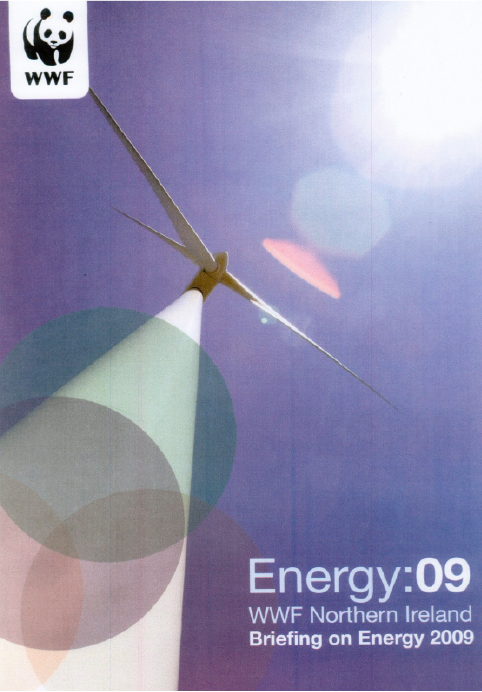

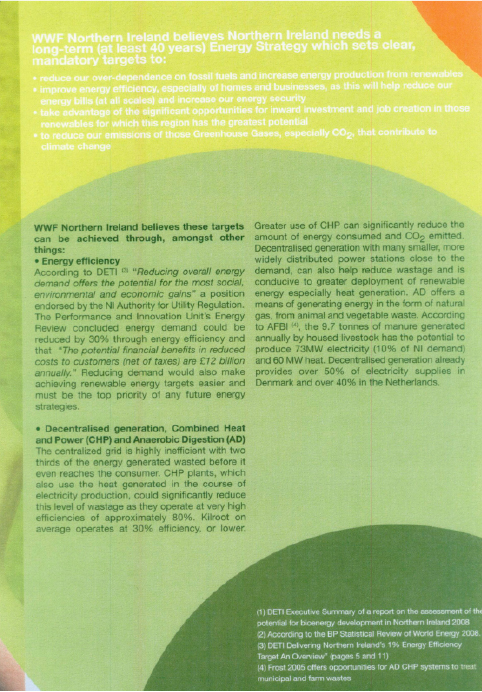

IOD
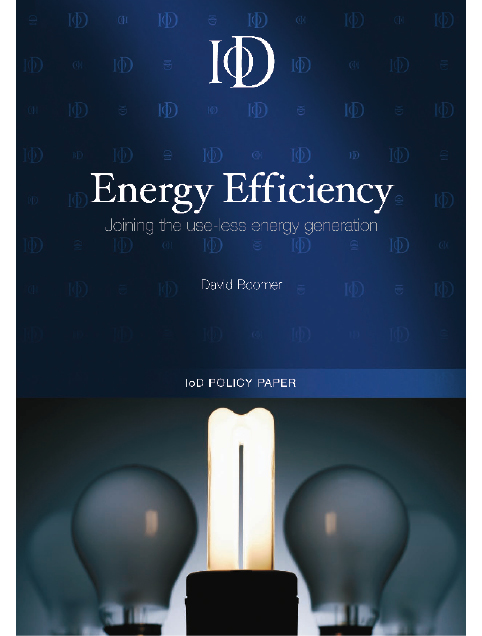
1: Executive summary and key points
1.1 Executive summary
The UK Government aims to reduce greenhouse gas emissions by at least 60% by 2050 and to increase the share of energy generated by renewables from the present 4% to 15% by 2020, in effect, moving to a low carbon economy. The UK is a net importer of energy and this is increasing. Our energy infrastructure is ageing and a large proportion of nuclear and coal-fired power stations will be decommissioned before 2020, creating a gap in available base load generating capacity. Even with the increase in renewable energy sources, significant investments in new fossil fuel (including coal) and nuclear power stations will be required in order to maintain electricity generating capacity. It is extremely doubtful therefore, whether either of these targets can be met.
However, there is an achievable and cost effective way to tackling some of the inherent difficulties of moving to a new lower carbon economy and that is through a concerted move to improve energy efficiency across the built environment. It is estimated that 40% of the UK’s greenhouse gas emissions are the result of business activities and in particular their use of buildings and other facilities. The Carbon Trust has estimated that a 20% improvement in energy efficiency is easily achievable across most business sectors. This not only reduces greenhouse gas emissions; it reduces business costs and helps reduce the UK dependency on imported fuel, overall improving the economy and the competitiveness of UK business.
Data from Philips Electronics and the Carbon Trust, and the case studies in Section 5, indicate a huge opportunity for businesses to improve their energy efficiency and reduce greenhouse gas emission. The IoD would like to see the UK Government focus more effort in the area of energy efficiency, thereby enabling a significant, achievable and cost effective contribution to the UK climate change commitments. The IoD would also encourage UK business to adopt the cost effective approaches outlined in the Good Practice and Case Studies in Section 5 of this report. Improving energy efficiency will quickly enable UK business to reduce their operational costs and energy use, and reduce their individual greenhouse gas emissions.
All businesses and public sector organisations irrespective of size can benefit from becoming more energy efficient. This report outlines the practical steps which demonstrate how they can reduce their energy bills, reduce carbon emissions and ‘join the use-less generation’.
1.2 Key points
Improving energy efficiency is the most cost effective way of reducing the UK’s carbon emissions.
Energy efficiency can affect an immediate reduction in greenhouse gas emissions. It will help reduce the UK’s dependency on imported energy sources, reduce the extent of the future energy gap and improve UK business’s competitive ability.
Small businesses in the UK are missing out on energy savings of more than £1 billion.
In 2004 the Carbon Trust published a report stating that British business in the burgeoning Small and Medium Enterprise (SME) sector, is ‘throwing away one billion pounds a year in wasted energy’1. These figures were startling at the time but with the increases in energy costs since 2004 this figure will be significantly higher. Even taking steps to save 10% of business’s energy bill, overall savings of £1.9 billion should be achievable.
Inefficient and out of date office lighting is costing UK public and business sector organisations up to £1 billion per year and resulting in 1 million tonnes of avoidable CO2 emissions.
Potentially 75% of the UK’s public and private sector office lighting is based on outdated and inefficient
lighting systems. Research by Philips Electronics2 has highlighted that if these lighting systems – primarily those using fluorescent lighting running on electromagnetic ballasts – were replaced by the latest lighting technology, realistic electricity savings of around £500 million per year (E6 billion for all EU) could be achieved and this could be doubled by the widespread use of lighting control systems. Currently, only 1% of office/building lighting uses lighting controls (timers, presence detection and daylight controls).
UK business energy spend in 2006 was around £19 billion.
According to the Department for Business, Enterprise & Regulatory Reform (BERR), UK business spend on energy in 2006 was in the region of £19 billion3.
The demand for energy is increasing.
Demand for energy in the UK is increasing and estimates of a 60% increase by 2030 have been forecast4. The UK’s own reserves of oil and gas are declining and while significant amounts still remain, production has peaked. The UK has now become a net importer of energy and as our economy grows, we will become increasingly dependent on imported energy. Although the use of renewable sources of energy is increasing, coal, gas and oil will remain the primary sources for electricity generation for the next 10 years or so5 – putting at risk achievement of the UK Government’s climate change targets and the overall move to a low carbon economy.
Prices will continue to rise.
The reality of current energy price rises since 2004 is that an industrial site with a gas bill of £1 million may have to pay an extra £500,000 by the end of 2008 for gas. A knock-on effect of this is the rise in electricity prices, as gas is used to fuel many power stations. A recent analysis by Thomson Financial expects to see further price increases this winter perhaps in the region of 8%6.
Energy efficiency is the most cost effective way to reduce carbon emissions.
Energy efficiency is the most cost effective way of reducing carbon emissions and thereby contributing to the UK and European emission reduction targets7. It improves business productivity and competitiveness, and can contribute to security of energy supplies by reducing the UK’s reliance on imported energy. The technology is available today to improve energy efficiency. For example, efficient lighting and heating systems can be installed for relatively low costs with a payback period as low as 6 months. Also, there are simple steps that some businesses can take that do not require financial investment such as reviewing tariff rates and voltage optimisation which can reduce costs and energy use.
Results from a recent energy efficiency survey revealed that business still has significant opportunities to save energy.
Although many businesses are addressing energy efficiency, the results from a recent IoD survey8 showed that more than 60% of responding organisations did not have an energy management policy or strategy and more than half did not have a person with direct responsibility for energy management. A similar picture was revealed regarding energy saving or efficiency programmes – almost 60% of organisations did not address energy efficiency. Of those organisations which did address energy efficiency 30% reported energy savings of between 6–10%.
A focused approach to energy efficiency can yield savings for all businesses.
The case studies in this report demonstrate that all types of businesses can tackle the issue of energy use and in so doing reduce their operating costs, increase their profitability and improve their competitiveness. Relatively simple approaches to managing energy demand can significantly reduce energy bills and CO2 emissions by, in some cases, up to 20%.
2 Introduction
This report does not focus on the issue of climate change policies – a recent IoD policy paper ‘A Competitive Response to Climate Change’9 has addressed this issue. Nor will this document cover energy use related to transport. This has also been the subject of a number of separate policy papers published by the Institute of Directors. This report concentrates on the practical steps that businesses can take to deliver improvements in operational energy efficiency within the built environment, i.e. in the buildings occupied and used by businesses, and in so doing reduce energy costs and address emissions associated with climate change.
The IoD clearly recognises that improving energy efficiency is an area where business activities and government climate change policies can move forward together. Improving energy efficiency reduces business operating costs and improves overall organisational efficiency, thereby contributing to improved competitiveness. It also reduces carbon dioxide (CO2) emissions and makes an active contribution to the UK government’s energy policy and climate change commitments. The IoD also acknowledges that although many businesses are currently engaged in addressing the issues of energy and climate change, further improvements, particularly in energy efficiency, can be achieved. This report, through highlighting a variety of case studies, aims to provide a resource for and encouragement to our members and UK business as a whole in the drive to improve energy efficiency.
Businesses in the UK spend billions of pounds annually on energy and even small price increases can have a dramatic effect on their ability to compete on the global stage. For example, Small and Medium Enterprises (SMEs), which contribute more than half of our GDP, spent an estimated £3.5 billion on energy in 200610. These smaller businesses, particularly if they are energy intensive such as printing, plastics and glass product manufacturing companies, and food producers, have been significantly affected by recent energy price rises – in the region of 50% in the past 18 months! This is compounding many of the financial problems small businesses face.
UK business activities account for around 40% of the UK’s carbon emissions and almost half of these emissions result from the energy used in buildings and operational activities11. Energy intensive businesses already face regulation and incentives to reduce carbon emissions through for example, compliance with Climate Change Agreements (CCAs) and the EU Emissions Trading Scheme (EU-ETS). A further cap and trade scheme as part of the forthcoming Climate Change Bill, the Carbon Reduction Commitment (CRC), will be in place by 2010. This new Government regulation is aimed at large non-energy intensive public and private sector organisations i.e. those which use more than 6,000MW/h per year (see Box 2). The organisations which will come within the CRC scheme are estimated to account for around 10% of UK emissions. However, there still remain a large number of smaller companies, which in total also contribute around 10% of the UK CO2 emissions. These businesses, like larger organisations, pay the Climate Change Levy (CCL) but in the main are not directly addressed by government policies or support from government organisations such as the Carbon Trust funded from the levy12.
All businesses and public sector organisations irrespective of size can benefit from becoming more energy efficient. This report outlines the practical steps through a variety of case studies which demonstrate how they can reduce their energy bills, reduce carbon emissions and ‘join the use-less generation’.
2.1 Energy efficiency and climate change
There appears to be little doubt within much of the international scientific community and most governments, including the UK’s, that the issue of climate change is one of the most challenging problems faced by this generation (and possibly subsequent generations). The UK Government has made a number of climate change commitments which will impact across all parts of society including business. The Government aims to reduce the UK’s carbon emissions by a minimum of 60% by 205013. The UK Government supports the EU renewable energy target of 20% by 2020 and has also indicated that it will adopt a binding UK share of this target – 15% of all the UK’s energy (covering the electricity, heat, and
transport sectors) to be sourced from renewables by 2020.
To address climate change successfully will require a variety of changes within government, business and society. These include developing effective energy policies, implementing more efficient use of existing energy sources to generate electricity, development of low-carbon energy sources, technological innovation and increasing skill levels. These will all take a significant time to be put in place and to contribute effectively to a low carbon economy. However, it is clear that significant reductions in emissions can be achieved immediately through the implementation of efficiencies in energy use from existing practices and technologies.
The IoD actively promotes the part that business can and should play in helping deliver the changes required to move towards a lower carbon economy. The IoD also recognises that businesses in the vanguard of the move towards a low-carbon economy will be those which will be in a position to realise new and emerging market opportunities.
No matter what view is taken regarding climate change there is no doubt that it has become one of the most important issues facing governments, business and society at large. Increasing use of energy sourced from fossil fuels such as coal, gas and oil is generally understood to be a major contributor to increasing levels of the atmospheric gases which are driving climate change.
The Institute of Directors recognises that business is integral to success in addressing the problems of climate change, and also in helping the UK and EU to achieve their emission reduction targets.
Reducing CO2 emissions through improving energy efficiency is primarily about reducing end-use demand. In most commercial and industrial buildings energy is used in the forms of electricity (indirect) and gas (direct). The description of electricity as indirect is because it is generated through the burning of fossil fuels (gas, oil and coal). The burning of fossil fuels results in the direct emission of CO2, the main greenhouse gas believed to be responsible for global warming. The more electricity is demanded by the end user, the more electricity has to be generated, causing more fossil fuels to be burned and resulting in increased greenhouse gas emissions. The CO2 emissions are calculated for natural gas at 0.19 kg/kWh based on its carbon content, whereas grid electricity is calculated at 0.43 kg/kWh electricity used. The actual CO2 emissions associated with grid electricity vary depending on the energy generation mix but for the purposes of current emission accounting, the UK Government (Defra) will use the existing figure of 0.43 kg/kWh until 2010.
2.2 UKenergy efficiency – the current view
The Department of Trade and Industry (DTI) – now known as The Department for Business, Enterprise and Regulatory Reform (BERR), published the Energy White Paper, ‘Meeting the Energy Challenge’14 in 2007, which set out two long-term challenges:
- Tackling climate change by reducing carbon dioxide emissions both within the UK and abroad; and
- Ensuring secure, clean and affordable energy as we become increasingly dependent on imported fuel.
A key point emphasised in the Energy White Paper was that using energy more efficiently is the fastest and most cost effective way of reducing energy use and cutting CO2 emissions. There are various government instruments and policies aimed at encouraging the implementation of and investment in energy efficiency, which includes the Climate Change Levy (CCL) and Emission Trading Schemes.
Although businesses in the UK are improving energy efficiency, recent research by the Institute of Directors found that 60% of organisations surveyed were not addressing energy efficiency15. The result of the IoD survey reflected similar findings of the National Audit Office report on The Carbon Trust16, which highlighted that although the Carbon Trust’s work had contributed to significant energy savings and carbon emission reductions in a number of larger organisations, it had worked with a relatively small proportion of businesses and that wider market penetration would be required to generate greater reductions in CO2 emissions.
In 2004 the Carbon Trust pointed out that British businesses in the growing Small and Medium Enterprise (SME) sector was ‘throwing away 1 billion pounds a year in wasted energy’17. Given the significant increase in energy costs since then, this figure will be significantly higher today. Overall, even taking a conservative average (and easily achievable) of a 10% saving this could represent savings of around £1.9 billion for UK business as a whole! Since 2004 energy prices have spiraled. Gas prices from the beginning of 2004 to the end of 2006 rose by 67%. This was coupled with a 41% increase in electricity prices in the same period. The crude oil price was around $55/barrel in 2004 and apart from a dip during early 2007, by mid 2008 the price had exceeded $140. Many forecasters are expecting the price to exceed $150 by the end of 2008.
In addition, research by Philips Electronics in 200618 highlighted that inefficient and out of date office lighting was costing UK public and business sector organisations up to £1 billion per year. Their research found that potentially 75% of the UK’s public and private sector office lighting is based on outdated and inefficient lighting systems – primarily those using fluorescent lighting running on electromagnetic ballasts. If these were replaced by the latest lighting technology, realistic electricity savings of around £500 million per year (16 billion for all EU) could be achieved and this could realistically be doubled by the widespread use of lighting control systems. They estimated that in 2006, only 1% of office/building lighting used lighting controls (e.g. timers, presence detection and daylight controls).
The Philips data and the Carbon Trust information, as well as the case studies in Section 5, indicate a huge opportunity for businesses to improve their energy efficiency, reduce their energy use and costs and therefore reduce their CO2 emissions.
2.3 Outline of UK regulatory framework
The 2007 Energy White Paper noted that improving energy efficiency will require everyone – individuals, businesses and Government – to take action. Individuals and businesses can play their part by reducing the waste of energy, by investing in energy efficiency measures for the home and workplace, by constructing more energy efficient buildings and by choosing to purchase more energy efficient products. The Government’s aim is to encourage and enable action by businesses and individuals by ensuring that the right regulatory and fiscal frameworks are in place.
The European Commission published a Green Paper on Energy Efficiency19 in 2005 ‘Doing More With Less’, which estimated that the EU could save at least 20% of its present energy consumption in a cost effective manner, equivalent to 160 billion per year, or the present combined energy consumption of Germany and Finland.
In order to ensure integration of energy efficiency measures into national legislation the European Commission (EC) proposed several directives. In response to the EC directives, and in order to achieve its Kyoto commitments the UK government has put in place a range of policies, schemes and regulations which transpose the EC directives and aim to reduce emissions and develop the transition to a low-carbon economy.
The following is a brief list of the main regulations and policies related to energy efficiency in the UK which currently and in the near future, will impact businesses and consumers. It is not comprehensive and this document does not aim to detail their impact on the various business sectors:
- Climate Change Levy and Climate Change Agreements – A levy introduced in 2001 for most non-domestic energy users. Further details are contained in Box 1. For more information see www.defra.gov.uk/environment/climatechange/uk/business/ccl/index.htm
- The Climate Change Bill (currently going through Parliament) – Sets out the targets for cuts in UK carbon emissions, making them legally binding and will enable new powers for the Government more easily to implement emissions policies. It also describes the formation of an independent Committee on Climate Change to monitor and advise on progress towards these targets. The Bill contains enabling powers to introduce new trading schemes, such as the Carbon Reduction Commitment (see Box 2), through secondary legislation. The Bill increases the policy options which Government could use to stay within budgets and meet emissions targets, while maintaining the need for thorough analysis, consultation and scrutiny of proposals before a new scheme is introduced. The devolved governments of Scotland and Wales have already enabled or are in the process of putting in place their own Climate Change Bills. For more details see
http://www.defra.gov.uk/Environment/climatechange/uk/legislation/index.htm
Box 1 Climate Change Levy (CCL)The Climate change levy (CCL) is a government imposed tax which came into effect from 1 April 2001. The money collected from this tax goes towards the Government’s energy efficiency programme to reduce greenhouse gas emissions by 2010. Consumers who pay VAT at 17.5% will pay CCL. Suppliers do not make any money from the CCL charge, all money goes to the Government.
Fuel oils are exempt from levy because they are already subject to excise duty. It was the Government’s intention to raise approximately £1 billion during 2001/2, with the intention to redistribute the taxation collected via a 0.3% reduction in employers’ N.I. contributions, together with an allocation of £150 million for support to energy efficiency and renewables. Exemptions from the CCL include:
|
- EU Emissions Trading Scheme – A mandatory cap and trade scheme for specific energy intensive activities. For more information see http://www.defra.gov.uk/environment/climatechange/uk/business/trading.htm
- Energy Performance of Buildings Directive and Energy Performance Certificates – By January 2009, as part of the directive, Energy Performance Certificates (EPCs) must be produced when buildings are constructed, sold or rented. For homes the requirement for EPCs is already in place. For more information see http://www.defra.gov.uk/environment/climatechange/uk/energy/efficiency/index.htm
- Enhanced Capital Allowances for energy efficient equipment. This allowance is claimed when equipment is installed if it is included in the Energy Technology List (ETL) which details over 6,000 products meeting Government-prescribed energy efficiency criteria. The scheme allows up-front tax relief for businesses paying corporation tax or income tax that invest in energy saving equipment. A large number of technologies are listed including automatic monitoring and targeting equipment (smart meters), lighting equipment and controls, motors, variable speed drives etc – for more information see http://www.eca.gov.uk/etl. For example, if a business pays corporation tax at 28%, every £1,000 spent on qualifying equipment would reduce its tax bill in the year of purchase by £280. In contrast, for every £1,000 spent the generally available capital allowance for spending on plant and machinery is 20%/year on the reducing balance basis, which would reduce the business’s tax bill in the year of purchase by £56. In other words, an ECA can provide a cash flow boost of £224 for every £1,000 it spends in the year of purchase. ECAs provide 100% tax relief, so there is no further tax relief in later years. The general rate of capital allowances does not provide 100% tax relief so there is a balance of spending to carry forward on the reducing balance basis for relief in later years.
- Carbon Reduction Commitment – Due to come into force in 2010. A mandatory ‘cap and trade’ scheme covering emissions from larger business and public sector organisations. For more information see Box 2 overleaf.
- Building Regulations – Building Regulations 2000 (as amended) which are made up of:
- Procedural regulations that set out what kind of work needs Building Regulations approval and how that approval should be obtained
- Technical requirements that set the standards that should be achieved by the building work. This area contains the Part L Approved Documents which relate to the Conservation of Fuel and Power in buildings other than dwellings. For more information see
http://www.planningportal.gov.uk/england/professionals/en/1115314112742.html - Environmental Transformation Fund – Funding for Low Carbon Technologies amounting to £400m over the next three years. A new joint Defra/BERR fund part of this year’s budget. For more information see http://www.defra.gov.uk/environment/climatechange/uk/energy/fund/index.ht
- Market Transformation Programme – a programme which supports the development and implementation of UK Government policy on sustainable products. For more information see
www.mtprog.com/ - Public procurement policy and standards – for more information see
http://www.ogc.gov.uk/procurement_policy_and_the_eu_sustainability.asp - Carbon Trust – an independent company set up by the Government with the aim to accelerate the move to a low carbon economy through providing assistance to business and organisations to reduce carbon emissions and develop commercial low carbon technologies.
For more information see www.carbontrust.co.uk Box 2 Carbon Reduction Commitment (CRC)
CRC is a cap & trade scheme announced in the Energy White Paper 2007, which will apply mandatory emissions trading for large non-energy intensive organisations in the private and public sectors. It is designed to drive energy efficiency and carbon savings through the financial incentive of emissions trading. This will be combined with publishing organisations’ performance in a league table. The CRC is scheduled to start on 1 January 2010 but the qualification year is 2008. During 2008 UK organisatons with annual energy consumption of 6,000 MWh and above will be included in the CRC. This equates to an annual energy bill of around £500,000. It has been confirmed that the CRC will be a UK wide based scheme.
In terms of identification there will be an obligation on energy suppliers to supply bill payers of half hourly metered electricity with an information pack, listing their half hourly meters and their annual consumption for 2008. Suppliers will also provide government with a list of these organisations and annual consumption figures in each case.
The scheme uses a top-down approach to identify if an organisation comes under CRC and will place an obligation on the highest UK parent organisation. The parent organisation will be required to report the aggregate emissions of all parts of its organisation including subsidiaries. The parent company will then be required to collate the information it has been given from all parts of its organisation and its electricity suppliers to enable it to assess as a whole if it falls within CRC. The organisation will be required to account for all its energy use, not just half hourly metered electricity.
Timetable:
- Climate Change Bill in Parliament – November 2007
- Report of Consultation on draft CRC regulations – Summer 2008
- CRC qualification year – 2008
- CRC regulations in force – January 2009
- Identification of CRC participants – Early 2009
- CRC scheme begins – January 2010
- Initial Phase – 2010 to 2012
- The price of allowances for the initial phase has been set at £12/tCO2.
For additional information:
http://www.defra.gov.uk/environment/climatechange/uk/business/crc/index.htm
3: The basics of energy
According to recent data from BERR, total energy spend by UK business exceeded £19 billion in 2006 and commercial and industrial buildings currently account for around 20% of UK greenhouse gas emissions20.
It is widely understood that energy efficiency is the most cost effective and achievable approach to reducing greenhouse gas (GHG) emissions. This is an area where significant savings in costs and CO2 emissions can be made in a relatively short time through addressing energy efficiency both in existing buildings and in standards for new builds.
There are a number of points related to the use of energy in business and public sector organisations:
- It contributes to the operational costs of organisations and in some energy intensive businesses it has a significant part to play in a business’s maintaining its competitive edge
- It results in emissions of greenhouse gases from the direct burning of fossil fuels in the production of heat and generation of electricity
- In order to achieve Government climate change targets significant investment is required to move towards low carbon sources of energy
- As demand for energy and related infrastructure developments increase there is a resulting increase in energy costs
- The majority of energy use for the foreseeable future will be based on fossil fuels
- The UK is a net importer of energy and as the main sources of fossil fuel supplies are located in
- politically volatile areas, there is therefore increased risk to energy supply.
In overall terms most energy used by businesses and other organisation in their buildings and facilities is in the forms of:
- Natural gas – mainly used in heating systems for both buildings and processes, and
- Electricity – used for lighting, air conditioning systems, motor drives and office equipment including IT and other communication equipment.
However, as shown in the BERR statistics, electricity is the major energy source21 used by business in operating their facilities and processes. The efficiency of electricity production in most thermal power stations is between 30–50%. Therefore, the unnecessary consumption of electricity can result in a two or three fold increase of CO2 emissions per delivered unit of energy, typically measured in kWh when compared to the direct consumption of fossil fuels.
The electricity supply industry has three areas:
- Generation – primarily by large centralised power stations
- Transmission network or Grid which transmits electricity via overhead high voltage lines
- Regional distribution networks of lower voltage (132kV and below) via overhead and underground lines.
Electricity is generated from a diverse mix of fuel sources. Figure 1 shows the 2006 fuel mix used to generate heat and electricity at the UK power stations.
Figure 1: The 2006 Energy Mix
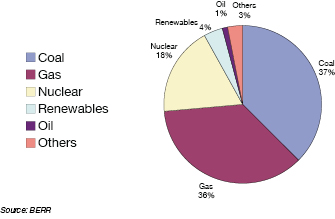
In 2006, most of the UK’s electricity was generated by gas, coal and nuclear power stations. Thirty large (>1GW) power stations meet the majority of the UK’s base electricity demand, which is ~40GW at a typical point in time and ~60GW at peak.
The contribution from coal and nuclear plants will fall as stations close, leaving an estimated ‘gap’ of ~15GW by 201522. This will be filled in the short–term by new gas and renewable (mainly wind) generation but will also require the introduction of new generation nuclear and coal-fired power stations to meet the current energy demand. However, as set out in The 2007 Energy White Paper, the UK aims to increase the proportion of electricity produced from renewables from the current 4% to 10% by 2010 and 20% by 2020. Note that the 15% renewable target currently being considered by the UK Government is related to total energy use and not just electricity generation. The renewable portion of electricity generation to meet the target is in the region of 40%.
Renewable energy is arguably no less reliable than energy generated from more traditional sources and using it does not mean that an organisation would have to change to new equipment or appliances but renewable energy does tend to be intermittent. Neither wind nor solar energy, both of which are inherently intermittent, can replace continuous base-load power. Basically, the only technologies that can produce large amounts of base-load power that supplies the necessary electricity to cope with standard and variable peak demand are fossil fuels (oil, coal and gas) and hydroelectric plants. Nuclear power plants can be considered in some circumstances to provide variable demand. Given that the Government aims to reduce fossil fuel use and that potential hydroelectric sites are limited, nuclear power must form a significant element in the energy power supply mix. Every solar panel and every wind turbine must be backed up by reliable power when the sun isn’t shining and the wind isn’t blowing, at least until the considerable problem of electricity storage is overcome.
Renewable energy sources and technologies in the UK include:
- Biomass/biofuels
- Geothermal (mainly through use of ground source heat pumps)
- Hydro-electrical small scale hydro
- Wind power/wind turbines
- Solar – photovoltaic (solar PV)
- Solar – water heating
- Tidal and wave power.
Other energy sources may be considered as low-carbon and include energy from waste, including capture and combustion of methane, and co-generation such as good quality Combined Heat and Power (CHP).
The Government in its 2007 Energy White paper also recognised that even if we increase the proportion of renewables and realize more potential for increasing low carbon sources of energy such as nuclear, fossil fuels (coal, oil and gas) will still play a significant part in meeting the the UK’s energy needs for the foreseeable future.
Both the European Commission’s green paper ‘Doing More With Less’23 and the subsequent UK Energy Efficiency Action Plan 2007 published by Defra24 positioned energy efficiency as the quickest and most cost effective way of cutting CO2 emissions.
The price of energy (gas and electricity) is closely aligned to the price of crude oil and as we have seen over recent months, the price of crude oil has continued to increase and now stands in the region of $140/barrel (June 2008). This has the effect of increasing the wholesale cost of gas, the cost of energy transportation and therefore prices to consumers but there are other factors which cause the cost of energy to increase, including the energy supply companies having to complying with UK regulatory requirements. These include the obligations on energy supply/generation companies to increase investments in infrastructure and costs associated with regulations such as the Renewables Obligation and the future installation of smart meters.
The UK power generation landscape is changing; firstly through phasing out around 35% of the UK’s electricity generating capacity as the older coal and nuclear plants are taken out of commission, and secondly through the increasing supply of energy from renewable sources. As older plants close and until the renewables sources can take up the difference, the UK will be even more reliant on imported gas, possibly importing up to 80% of our gas requirements by 2020. However, given the intermittent nature of renewable energy sources, a greater investment in new generation nuclear and coal fire power stations may be required to ensure an adequate base-load and an alternative to imported gas.
This potential energy gap emphasises the critical importance of energy efficiency which could partly fill this gap in a cost effective manner. If the demand for electricity (and gas) is reduced then the UK will be in a better position to move forward towards lower carbon energy sources and to enable significant reduction in CO2 emissions to be achieved.
4: Delivering energy efficiency
The approach to reducing energy use and associated greenhouse gas emissions is similar to almost any other aspect of improving a business’s or organisation’s operations. If the business improvement is to be successful and sustainable in the long-term it must form part of the overall business strategy and have appropriate resources, planning, key performance measures, communication and reporting.
4.1 Strategy – an economic, risk-based approach
Energy efficiency is often referred to as a ‘no-brainer’ or ‘no-cost’ business activity. However, if either of these terms were actually true we would not be writing this report and all businesses would be doing it! To address energy efficiency in an effective and sustainable manner will require management and staff time and, depending on the extent, it may also require direct financial investment. The main point here is that the allocation of resources to address energy use should be clearly appropriate to the economic and environmental aspirations of the organisation.
In order to make an informed decision as to whether or not, and to what extent, energy efficiency is to be tackled as part of the organisation’s operational activities, it is first essential to know:
- how much energy is being used and its cost within the organisation and;
- what benefits would be realised by adopting an energy efficiency programme.
Then the organisation can decide if and how to tackle energy use. The old adage that ‘if you can’t measure it, you can’t manage it’ is particularly relevant to energy use. It is worth mentioning that in carrying out a cost benefit analysis or return on investment (ROI) assessment, consideration of the various tax reliefs should be included. This might include relief from CCL, Enhanced Capital Allowances etc.
All organisations can reduce their energy use and associated greenhouse gas emissions but it has to make both economic and business sense before committing to spend what can be relatively significant amounts of time and resources. It may not be a wise use of resources to tackle energy use if a company has a low energy bill, say less than £5,000/pa (although it should be recognised that most reductions in operational costs will make sense) or say, if a business has a turnover of around £500,000 with energy representing less than 1% of operating costs, then it may be considered uneconomical to invest significantly in energy efficiency. This being said, it may fit with the overall profile and aspirations of the company to address and minimise energy use, perhaps in line with other environmental aspects as part of its corporate responsibility objectives. It may also be that the organisation decides to take a wider, supply chain approach to mitigation of greenhouse gas reduction (its carbon footprint).
4.2 Resourcing
Allocation of sufficient resources to address energy efficiency can present something of a challenge to many businesses, in particular smaller businesses that may not have the necessary in-house technical expertise. However, even in this situation or where the energy costs represent a small proportion of operating costs it can make economic sense to define and allocate resources to plan and manage these costs. Although there are basic principles which apply to addressing energy use in all companies, such as switching off lighting and equipment that is not in use, the development of an overall programme should be tailored to the character and type of a business – it is not a one-size fits all situation. It is also worth reiterating that any improvement plan should include an element of ensuring sustainability in order to gain the maximum benefit. For example, an energy intensive manufacturing business could develop a broad-based plan aimed at reducing base and operational loads (see the Marshalls case study for a typical approach) but the details will be specific to the business and sector. This should ideally identify all energy-using equipment and processes then target the high energy use but not forgetting the small items which collectively can account for significant levels of energy use and essentially engagement of people.
4.3 Developing a plan
Planning to address energy use is similar to most business improvement plans and good project management skills will go a long way towards effectively delivering improved energy efficiency. Briefly, a plan should include:
- Know your starting point – as previously mentioned, know what energy use/cost is and when an outline plan is being created set a realistic start date
- Set your overall policy and objectives – these can be fairly general and may form part of the organisation’s corporate responsibility and/or environmental policy. However, the more specific the policy is the better. It is essential that the policy and objectives are communicated to all relevant stakeholders. Objectives may form part of the policy statement or be developed by management teams in response to the policy – it depends on the complexity and scale of the organisation.
- Establish the processes and/or project plans necessary to deliver the objectives including who is responsible, the timescales and how these and the overall plan’s progress will be communicated
- Identify and allocate a budget and other resources – it may be beneficial to include targets for individuals and groups
- Ensure there are measures and targets against which to check progress
- Review process to measure and report progress against your objectives and targets.
This is in effect a version of the Plan, Do, Review process. One point to make is that the details of the plan and processes adopted should not turn out to be the ‘tail wagging the dog’ but should effectively and efficiently facilitate the achievement of reducing energy use and costs.
If the energy costs are significant and/or the organisation decides to address energy use in a comprehensive way, an energy survey is usually required in order to identify the areas where maximum benefit for a given cost can be gained. The cost of a survey will depend on the extent and depth to which it goes but costs may be partly offset by either working with the energy supplier (or an energy services company (ESCO) or in conjunction with a Government support organisation such as the Carbon Trust or Envirowise). If the organisation has sufficient internal resources the survey could be carried out by in-house engineers or it may be decided to employ a consultant engineer.
The following is a list of items that may be included in a survey – it is not comprehensive but covers many of the areas found in most business premises. Some processes will have specialist equipment which may require the services of competent engineers in order to monitor and check efficiency:
- Review of energy bills and how these are recorded and managed
- Measurement of energy use – requires reasonably accurate metering and where possible energy use should be split by type of equipment. This is where monitoring and targeting is a useful procedure. The following list gives examples of areas to be considered but it will depend on the complexity and operations of the organisation:
- Lighting levels and controls – internal and external
- Ventilation/air conditioning levels and controls
- Thermostat settings
- Heating systems and controls
- Processes e.g. compressed air
- Small power e.g. IT equipment and other office equipment
- Substation voltage levels (if appropriate)
- Assessment of timers and other controls.
- Identify inefficient equipment and poor practice, which may include:
- Maintenance issues e.g. compressed air leaks, flickering lights etc
- Lights and other equipment left on when not required
- Local air conditioning units left on when an area is unoccupied.
A comprehensive energy survey or audit should include a series of ‘walkabouts’. As energy use will vary throughout the day and/or week it is best to carry out a number of these tours and at various times. For example, during normal working times, lunch times when staff are away from their areas of work, during and after cleaners, outside normal work hours and at weekends (if work patterns differ from Monday to Friday).
The output from a survey should be a report which provides the energy consumption and patterns over a given time period. If half-hourly data is available this can show how electricity is used throughout a 24 hour period and if high and low use areas can be identified so much the better. The report should also provide an action plan detailing a prioritised list of areas/equipment to be tackled including outline costs. The aim is to ensure that energy supply is matched to demand and then reduce demand.
4.4 The people approach
At the heart of any energy efficiency endeavour are people and influencing the energy behaviours of an organisation’s people must form a central part of any plan to reduce energy use.
Depending on the complexity, size and operational diversity of an organisation it may be useful to carry out a ‘stakeholder analysis’. This should include employees at all levels, senior management, staff, customers, suppliers (especially the energy supplier), regulators, investors etc. A stakeholder analysis needn’t be a complex process but it should be aimed at identifying and understanding who the key players in energy efficiency are, where their influence lies, whether they are for or against the changes and what it will take to influence them.
Many of the case studies in this report, although they may focus on technological improvements, make it apparant that well-motivated people are at the heart of effectively reducing energy use.
A key part of sustaining changes like energy efficiency is communication – know what your main message for the various stakeholders should be and develop your communication campaign around this. For example, you may focus on the environmental benefits of tackling climate change and/or your main outcome could be focused on an economic, or a competitiveness approach through reducing costs.
In larger organisations it can pay dividends to survey the understanding and commitment of employees. The results can then be used to develop a more flexible approach which can allow for the different views of the various staff groups.
4.5 The technology approach
The important point to make here is that an effective approach to energy efficiency should not just rely on trying to persuade people to switch lights and equipment off – important as this is. A people approach may in fact be the limit of an organisation’s energy efficiency plan but this singular approach is generally limited to organisations with very small energy costs. However, even in smaller businesses the installation of energy efficient equipment such as presence detectors to control lighting, especially where a light may be left on in a room or area that is not easy to see such as cupboards or toilets, or installing simple timers etc., can have a very quick payback – sometimes as short as a few weeks.
Another important point to understand is that even if you do fit, for example, energy saving light bulbs, if they are not switched off when not required then the maximum benefits will not be realised. Equally, if lighting or heating controls are fitted to optimise operations and these are then regularly over-ridden the potential savings will be lost, and finally, equipment should be maintained to ensure optimum efficiency. For example, flickering fluorescent lights will use more energy and should be repaired as quickly as possible.
The following section outlines case studies which illustrate successful energy reduction in a wide range of businesses and other organisations.
5: Good practice and case studies
This section forms the most important part of this report which both outlines areas of good practice and provides examples of companies that have adopted energy efficiency as a strategic part of their business processes.
5.1 Managing the energy bill
As previously mentioned, it is essential that you know how much you are paying in order to decide your approach to energy efficiency. However, even if your energy costs are not particularly significant, it is always worth asking the questions: Is the business paying too much for its energy? Is the business on the correct tariff?
The simple way to approach these questions is to contact your energy supplier to explain your bill and tariff rate. This may be as simple as making a phone call to the supplier’s help-line but it may require a visit from the supplier. Although energy suppliers are not obliged by law to offer help to business, as they are required to advise domestic customers on ways to reduce energy use, it makes good sense to form a partnership with the supplier. A good supplier is one that will respond to a customer’s requests to become more energy efficient.
An invoice or bill should include data on:
- Charges and CCL rates
- Time period of invoice and meter readings
- Consumption – this is usually shown covering the two periods; daytime (7am to midnight) and night-time (midnight to 7am) measured in kWh i.e. the kilowatts used per hour. Note that in many situations if there is high night-time consumption this should be investigated.
- Total consumption again expressed as kWh
- Maximum demand – the peak power in kW in a 30 minute period during the period of invoice, usually monthly. This needs to be the minimum required. Note that if the maximum demand capacity is exceeded high charges are levied.
- Price – the costs of the various charge periods in p/kWh
Gas invoices normally only include total consumption over the period in kWh.
Questions to consider:
- Can you avoid paying the Climate Change Levy (CCL)? All businesses are charged this levy if the energy bill applies to an industrial or commercial facility and there are ways to reduce or avoid this charge. For example, green electricity is exempt from the CCL and depending on the supply contract it may not always be more expensive than a standard tariff.
- Are your electricity charges based on a maximum demand which is above that ever reached?
- How accurate is the energy meter/bill?
- Are you charged for what is used or is the charge based on estimated usage?
All these questions are best answered in discussion with your energy supplier.
5.2 Monitoring and targeting – invoices and metering (sub-metering)
The principles of monitoring and targeting are to:
- Measure present energy consumption
- Compare and assess over time – identify trends
- Set benchmarks and future improvement targets
- Provide data for progress reports.
It should be noted that metering does not save energy in itself but provides essential information on consumption which enables improvements to be made. The basic four-step process is data collection; analysis; reporting; action.
Most energy consumption and cost information can be obtained from invoices and meters and these can be used to cross reference consumption and charges to check the accuracy of the bill – see above for information on invoices.
As mentioned above there is no obligation for a supplier to go beyond supplying accurate billing and overall meter data but most will support collection and analysis of data if required, although there may be a charge for this service. However, if an organisation has a significant energy bill then it should employ the services of a competent energy manager with appropriate data management tools to monitor energy costs and ensure efficient use over time.
Once a reliable monitoring process has been established improvement targets can be set to reduce energy use.
A general point is that monitoring energy use needs to account for the seasonal differences in energy demand through changes in weather conditions. A system called degree-days is used which allows energy use to be assessed to take account of differences in heating (and cooling demands in air-conditioned buildings) due to different weather conditions.
Basically, the energy required to maintain an internal temperature depends on the difference between the internal and external temperatures. Degree-days utilise the daily difference between a base temperature and the 24 hour mean external temperature. Using correction for degree-day data in the analysis of energy bills can help eliminate changes in energy consumption resulting from weather conditions. This can provide a more consistent picture of energy performance. However, the correction should only be applied to the energy consumed by building services i.e. the energy to heat or cool a building. Process-related energy consumption should be independent of outside temperature. UK degree-day data and information on their use can be found at http://vesma.com/ddd/index.htm.
Even at its most basic level, metering is essential to allow management of energy use. Metering and monitoring systems are essential in order to provide the detailed information required to help minimise plant or building power consumption. Without a detailed understanding of current energy usage, services and equipment may be running when not required or running sub-optimally. Efficient management of services such as electricity, gas, steam, high pressure hot water (HPHW) heating systems, processed cold water, and compressed air will make significant contributions to energy costs within a facility. However, facility or energy managers often spend considerable man-hours gathering, collecting, checking and analysing metered data so that they can produce information in order to optimise the facilities’ energy use. Due to these restrictions the information is often generated at periodic intervals rather than in real time introducing a delay to the response time – resulting in further potential energy wastage.
The ideal situation has always been to have real-time information. However, the cost and practicalities of wiring main meters back to central data collection system usually result in only a few main meters being installed. Sufficient sub-metering and monitoring to allow efficient energy management may be considered too costly.
Digital wireless technologies are now available as alternatives to many traditional wired applications and digital wireless technologies that replace conventional wiring are now a realistic proposition. Technologies based upon the IEEE 802 working group’s standards have been adapted for industrial use. Developments in the areas of battery life, energy harvesting and energy management allow wireless sensors to operate without the need for wired power or unrealistic intervention intervals.
Conventional industrial signals (i.e. 4-20mA) can be transmitted across wireless infrastructures to more convenient locations where they can – via a gateway – be connected to structured wiring. Wireless infrastructures can be rapidly reconfigured and are relatively tolerant of interference.
Even if there is no need for real-time data acquisition, digital wireless technologies can eliminate the need to be physically close to the meter in order to take a meter reading and they can avoid or reduce recording errors.
Key benefits of digital wireless metering:
- enables management of energy supply and use
- wireless technology is now available and can reduce cost (labour and materials) of installation
- allows energy optimisation of existing services or equipment
- can be used to reduce energy costs
- easily deployed for energy auditing purposes.
Digital wireless technologies (so called smart meters) can dramatically reduce the cost of infrastructure required for data acquisition and allow collection of data that without wireless links would not be economically viable to obtain. The ability to collate a greater depth of information allows energy usage to be monitored closely and can enable prompt corrective action to be initiated. Wireless technologies can also be deployed with less operational disruption and on a temporary basis for energy auditing purposes.
Figure 2: An example of a smart meter
5.2.1 Case study – Canary Wharf building services company
The company is a leading real estate services and money management firm, delivering strategic, fully-integrated services for property owners, investors and occupiers. It is an industry leader in property and corporate facility management services, with a portfolio of over one billion square feet worldwide.
The company manages properties all over the world, including a high profile building in Canary Wharf, which is sublet to a number of leading financial institutions and commercial enterprises. Siemens Energy Services was awarded the contract to provide and maintain a tenants’ sub-metering system for the new building.
Siemens Energy Services delivered a metering system that would allow the customer accurately to allocate energy costs per floor – per tenant.
Requirement: accurate allocation of energy costs
The customer needed to allocate energy costs accurately to each of the tenants in the building to enable accurate billing. It needed to be able to identify exactly how much energy was used by each tenant on each floor, so that they could provide accurate bills as well as energy consumption monitoring.
Customer requirement:
- enable accurate billing
- access a monitoring system via the internet
- break out costs per floor – per tenant
- install hardware and software for meter assets
- provide expertise in data collection and data management
- provide consultancy on the sub-metering provision.
Solution: end-to-end metering package
Siemens Energy Services provided the design, supply, installation and commissioning of a sub-metering system, as well as meter maintenance and data collection services. A networked metering system was installed in the new Canary Wharf building to monitor over 250 meter points. As part of the data collection service, the data are consolidated into subgroups to enable cost-centre calculations. Regular reports are created which break out the cost and consumption elements.
Siemens Energy Services solution:
- install sub-metering system
- maintenance over the full meter-life cycle
- web-based energy efficiency application
- data management
- bespoke reporting systems.
Benefits: accurate tenant billing and added-value services
With the Siemens solution in place the property services company is now able to bill its tenants monthly, which helps them to manage cash flow and secure cost coverage. It also helps them to add value to tenants by raising awareness of the electricity used. This information enables tenants to be more energy-aware and to take steps to reduce energy consumption.
Customer benefits:
- monitor electricity consumption
- bill tenants monthly
- manage cash flow
- satisfy tenants’ information needs
- understand accruing costs
- put steps in place to reduce energy expenditure
- data constantly accessible via Intranet
- one supplier for the whole process
- flexible in changing supplier.
5.3 Lighting
The use of artificial lighting in the built environment has the ability to perform a number of functions. The main functions of lighting can be classed as: architectural, accent, ambience and task lighting and if these are used well can add functionality, atmosphere and character to any room whether at home or at work. Poor lighting will annoy and can affect working operations, while good lighting will blend seamlessly into the surroundings – used well, lighting will enhance an office, retail, reception, manufacturing or even a warehousing facility. Another point to be aware of is that all lighting gives off heat. This may be useful in winter but can compete with cooling systems in warmer periods, adding to the energy required to cool a room. Generally, the more efficient a lighting system is, the more of the energy used is converted to light and not heat. Incandescent lights are particularly inefficient, utilising less than half the energy they use to produce light.
Various surveys of a number of business facilities indicate that lighting accounts for around 30% of the total electricity used but in offices lighting is the single largest cost within the electricity bill. Why should lighting use so much energy? One factor is that a fluorescent or discharge lighting systems will actually use around 125% of the power shown on the lamp or light tube (shown in watts). This is because energy is also consumed by the ballast or control unit of the light fitting. Also, in many offices the lighting levels can be higher than required. Although guidelines for the lighting levels for various commercial and industrial facilities are available from the Chartered Institute of Building Services Engineers (CIBSE), many installations exceed the recommendations. It is not difficult therefore to see why lighting is such a high proportion of the electricity bill when one also considers how often lights are left on when not required. In many offices, corridors, meeting rooms, etc., lighting is only actually required at most for around 6 hours during the working day – carry out an out of hours audit to see how often these lights are left on and it is easy to see that huge savings can be made.
The use of efficient lighting systems and controls can therefore contribute to large electricity cost savings. If we consider office lighting alone we can see the kind of savings that can be achieved. Research by Philips in 200625 revealed that more than 75% of Europe’s office lighting is outdated and inefficient. Total cost savings up to 16 billion per year were estimated to be available to both public sector and businesses across Europe through cost effective upgrading of lighting systems to more modern technology. Philips figures show that if office lighting – primarily fluorescent lighting systems running on electromagnetic ballasts – were replaced by the latest lighting technology, realistic electricity savings of 13 billion per year could be achieved and this could be doubled by the widespread use of lighting control systems.
A similar picture can be seen in the UK and similar upgrades could represent an estimated cost saving of around £500 million/year in office lighting systems alone!
The payback on retrofitting these new office lighting systems can be achieved in as little as two or three
years. In addition, this could represent a reduction in the UK’s CO2 emissions of more than 1 million tonnes per year.
Solid-state lighting, mainly in the form of light emitting diodes (LEDs) is now showing wider application. Although this is a relatively new technology it has been used for a number of years, with considerable success in external lighting of bridges, buildings and monuments. For example, it is currently used to light the facade of Buckingham Palace. However it is now being used to light freezers and refrigerated cabinets in supermarkets resulting in more effective lighting and reduced electricity consumption.
A summary of the lighting facts:
- Currently most office lighting runs on outdated electromagnetic ballasts and uses older 1930’s based fluorescent lamp technology
- Huge savings can be made by upgrading lighting systems to fittings with high frequency ballasts and a new generation of T5 fluorescent lamps with their higher quality light. Higher levels of light also allow better spacing of light fittings meaning fewer are needed per office. Energy savings of 30% are easily achievable and these savings start immediately after installation. This does not even consider the use of even more modern LED systems which are particularly efficient for external architecturally based lighting use.
- Additional savings can be achieved by installing modern lighting control systems such as presence detectors which automatically turn off or reduce lighting levels when no one is present and daylight linking controls which reduce the lighting levels when more natural daylight is present
- A basic Philips Light Master Modular (LMM) system does not cost more than a conventional installation, and payback times of less than a year are possible
- Modern fluorescent lighting provides far higher quality light than older technology. This is in addition to the energy-saving potential.
TABLE 1: ENERGY SAVING LAMP OPTIONS (PHILIPS LIGHTING)
| Area of Lighting | Old lamp | New energy saving lamp | % Energy saving | CO2 saving/lamp/year |
| Retail outlet | Halogen PAR 30 | Master colour CDM | 80 | 115kg CO2 |
| Office & industrial | TL 8 | T5 with high frequency | 61 | 77kg CO2 |
| Home | Incandescent | Compact fluorescent | 85 | 34kg CO2 |
| Road | SON 70 | Cosmopolis 60 | 13 (possible 50) | 17kg CO2 |
Table 1 above, based on Philips data, outlines the energy saving lamp options with an indication of the energy saving and associated CO2 reductions that can be achieved.
The most efficient lamp types, associated control gear and luminaries (light fittings) for most interior and exterior lighting applications together with appropriate types of lighting controls are included in the lighting section of the Energy Technology List (ETL) which, like many investments in energy efficient equipment, attracts 100% capital allowances. For further information see Section 2.3 on regulatory framework. Details of the scheme can be found at http://www.eca.gov.uk.
5.3.1 Case study – Big Ben
If you have been to London you may have heard Big Ben – but it’s doubtful if you’ve ever seen Big Ben. What you have seen is St. Stephen’s Tower, the 400-foot-high, four-sided clock tower rising above Britain’s Houses of Parliament, on the banks of the Thames. Big Ben is inside the tower – it’s a 13 tonne bell, designed by the Baron Grimthorpe, cast in 1856, and named in honour of Sir Benjamin ‘Big Ben’ Hall, the Chief Commissioner of Works at the time. Londoners set their watches by the tower’s glowing clock faces by day and by night – and until recently, some poor soul frequently had to climb all 340 steps to the top with replacement bulbs, to keep those clock faces glowing.
That has all changed and the clock faces are now illuminated by means of 112 bulbs (28 per clock face), using Philips QL’s induction lighting system. The previous lamps were replaced with 55 watt lamps, guaranteed for an lifetime of 60,000 hours – around 15 years of normal usage. This has reduced maintenance and energy costs resulting in overall savings of an estimated 60 per cent. Newer versions of the QL system now offer 100,000 hours operation.
These QL lights offer not only economy, durability and high luminous efficiency but, since they are ‘solid state’ and contain no filaments or electrodes, they are also resistant to the immense vibrations of Big Ben’s bongs! In addition, a Philips QL system is used as the beacon light which, by tradition, shines from the top of the tower whenever Parliament is in session.
Energy efficient QL systems are now installed at various facilities worldwide, including Austria’s Military Museum, Sweden’s National Archives, the Rotterdam World Trade Centre, the Eurostar station in Brussels and Singapore’s Changi Airport.
5.3.2 Case study – retail organisation: The Co-operative Group
Commercial retail organisations large and small can make significant reductions in lighting costs and enhance their appeal to customers. Organisations including Thomas Cook, Crabtree & Evelyn, Tesco and the Co-operative Group have significantly improved the effectiveness of the lighting in their retail facilities and reduced their overall energy bills.
The Co-operative Group case study below is an example of taking a comprehensive approach to energy management of which a significant part covers lighting. They have operations that comprise food stores, banking, insurance, funeral care, travel agents and pharmacies with more than 3,000 high street outlets.
It was one of the first UK businesses publicly to acknowledge the need to cut carbon emissions and set internal targets for energy and emissions reductions and all business within the Co-operative Group have implemented energy strategies. These include refurbishment and procurement guidelines to make sure that all electronic equipment, such as lights, refrigeration and air conditioning, is as energy efficient as possible and the requirement that the Energy Technology List is used for all equipment purchases. Moreover, all electricity used by the Co-operative Group is generated by renewable energy sources.
The Co-operative Group wanted to see if it could make further improvements to existing activity so carried out a number of site surveys and a technical review of plant and equipment specifications as well as an inspection of existing equipment in conjunction with the Carbon Trust.
The recommendations included intelligent lighting, improved procurement processes, improved metering, monitoring & targeting and an energy awareness & training programme.
The group is currently delivering a programme to refit 250 retail stores per year, as well as embarking on a refurbishment programme for its pharmacy outlets.
What has been done? Half-hourly metering has now been installed at more than 1,400 sites. This selffinancing programme has identified opportunities for tariff/procurement savings. A retrofit programme designed to reduce energy at the 300 most energy intensive stores includes replacing their lighting systems with more energy efficient fittings. The programme was based on absolute energy reductions of c.14% gained at a trial of six stores, which will save in excess of £2m each year in energy costs.
The initiatives covered more than just lighting and included:
- Many of their stores still used old style fluorescent lamps in either twin or single fittings. A programme of work to replace these with more energy efficient lamps and occupancy control equipment is being installed. At a cost of £0.9m, it is estimated these measures will provide a 2% reduction in overall energy consumption – representing a reduction of almost 2 million kWh/year.
- Installation of a combination of fridge cabinet blinds and freezer trim controls, together with refrigeration pack controls in high consuming stores. At a cost of £3.5m, it is anticipated that these measures will provide a 7% reduction in overall energy consumption.
- Enhanced heating, ventilation and air conditioning (HVAC) control equipment, which will be more efficient than those switching heating, hot water, ventilation, cooling, lighting and appliances off when not required. The use of remote communication will ensure that the equipment is commissioned correctly and is appropriately maintained. At a cost of £2.3m, it is anticipated that these measures will provide a 5% reduction in overall energy consumption.
5.4 Case study – office-based energy efficiency
5.4.1 Case study
A local authority highways divisional office was surveyed and an improvement plan was put in place. The following table outlines the list of findings and associated improvements. The total investment costs were just over £2,000. The energy savings were more than 60,000 kWh, representing cost savings of almost £2,500 per year – payback was less than 10 months.
TABLE 2: LIST OF ISSUES AND IMPROVEMENTS IN LOCAL AUTHORITY OFFICES
| Issue | Solution | Comments |
| Standard 60w incandescent bulbs fitted. | Replace with compact fluorescent lamps (CFL). | In terms of light output a light 20w CFL gives equivalent light to a 100w tungsten filament type. |
| Twin 100w fluorescent light tubes. | Replace with twin 70w tubes. | |
| Lights were switched in banks – many on when not required. | Split lighting circuits and install occupancy sensors. | |
| Rooms with natural daylight had all lights on. | Daylight sensors fitted near windows. | |
| General lighting level was too high. | Some fluorescent tubes or fittings removed. | |
| Computers and monitors left switched on when not in use. | Communicate to users to switch off when not required. | Behavioural change plus enabled shutdown to power save mode and disabled screen savers. |
| Heating and cooling systems could run at same time. Cooling setting was too low. Windows and doors left open. Boiler was old and inefficient. | Provided interlock in system to avoid competition. Closed windows and replaced boiler controls. | Also adjusted room temperatures down to 23oC and adjusted thermostats on radiators. |
5.5 Voltage optimisation
Prior to 1 January 1995, the date of the European harmonisation of voltages, electricity in the UK was supplied at 415v 3 phase and 240v single phase. Equipment supplied in the UK around this time was rated accordingly. Harmonisation of voltages has meant equipment supplied now is rated at 400v 3 phase and 230v single phase, with tolerances of +10% and - 6%.
In the UK most industrial low voltage (LV) electrical networks are still running at or near to the higher limits of the voltage range as they have equipment pre-dating 1995. However, this equipment is becoming increasingly rare and running distribution networks at these higher voltages is wasting energy and having detrimental effect on certain types of equipment life. The voltage level coming off a substation into a distribution system can be reduced or ‘tapped down’ to provide significant energy savings.
Supplied power in the UK operates with what are called transients which are generally short-lived oscillations in the distribution grid caused by sudden change of voltage, current or load. Transients are increasing in line with the increasing use of small-scale generating plants, including wind generation, which gives rise to more switching on the grid – and hence more harmful transients. A voltage power optimiser (VPO) has the potential to buffer and eliminate transients up to 25,000 V. Harmonic distortion from nonlinear loads is also reducing power quality as more power control equipment comes online. To combat this, the Government introduced the G5/4 guidelines in 2003 that require both utility companies and customers to limit their harmonic outputs. So, by reducing harmonics in the supply, a VPO has the potential to protect sensitive equipment (especially IT) and provide a clean power supply.
The use of voltage optimisation or more accurately voltage power optimisation, through the use of a VPO, can offer similar savings to the simple ‘tapping down’ of a substation. Voltage power optimisation can be used not just in commercial applications but also in industrial based businesses.
There are further advantages to the use of VPOs in that not only do they ensure electrical equipment operates close to rated power but they are relatively easy to fit and can be installed on both LV supplies (415 V) and larger sites where HV is supplied (11,000 V and above) and transformed to LV.
However, simply ‘tapping down’ (if you own your HV/LV transformer) does not necessarily deliver the same efficiencies as fitting a VPO. Some companies (where they have a HV transformer) have ‘tapped up’ the transformer and then set a larger step-down using a VPO, which is reported to improve stability of supply and increased savings.
So, how does a VPO work? The supply voltage is optimised basically through a transformer, which corrects and improves the power quality. It reduces harmonics and improves the balance of the three-phase voltage supply allowing equipment to run closer to its optimum operation level, thereby reducing losses and consumption in three-phase equipment such as heating ventilation and air conditioning (HVAC) equipment, refrigeration and motor drives and compressors. For example, supplying a motor with a 5% imbalance in three-phase supply will cause the motor to draw up to 20% more power. In general, VPOs generate lower energy losses throughout their operating range (0.1%) and generate significantly less heat compared to a conventional transformer – the reason being their design and construction, which avoid the dual-wound configuration of a voltage transformer.
VPO is effective in most applications with a significant electrical load and businesses and organisations of all sizes can install this equipment. Businesses who have installed a VPO have reported reduced noise levels as well as reducing electricity costs by up to 15%.
Benefits:
- 5%–15% reduction in electricity consumption through operating electrical equipment at rated voltage levels
- Increased equipment life and lower maintenance requirements
- Potential to free up capacity on electrical distribution (by 5%–15%), possibly negating the need for expansion
- No capital investment required unless a Voltage Power Optimiser (VPO) is used which give further benefits and wider applications.
5.5.1 Case study 1 – AstraZeneca
This case study is based on work carried out at AstraZeneca, a multinational pharmaceutical company with a number of manufacturing and R&D sites across the UK.
Voltage was reduced across UK sites on a wide range of facility types including offices and laboratories. Each facility type has been monitored for savings and results demonstrated savings varied with the type of facility. Laboratories and offices provided the greatest potential for saving as they generally operated equipment rated at 230v.
The R&D site in Loughborough produced the most comprehensive set of data with all substations reduced by 2.5% at 11kv/400v level. This was then followed up with a 3% reduction at site incomer level at 33kV/11kV level (see Table 3).
The scope of this work was to reduce the voltage levels as close as practical to the European harmonised levels. There may be further savings by operating at lower voltages but the operational outcomes may be more difficult to predict and further drops should be managed and monitored for problems. However, the voltage levels can be reinstated to the higher levels if problems do occur.
There are two particular points to make in this example. Firstly, there was no capital cost associated with the change in voltage but it did require a shutdown of the substation for the short period of time it took to ‘tap down’ voltage. So, it is an improvement that can be carried out during planned maintenance schedules or at times when the building or facility is not in use e.g. at weekends if this is the case.
The other point is that after the reduction in voltage was carried out follow-up monitoring of plant and equipment such as pumps and motors were found to be running at lower temperatures mainly through running slower – not slow enough to affect their operational aspects but slow enough to reduce wear thereby reducing maintenance requirements.
At one particular site located in the south west of England, the electricity supply company was brought in to carry out the changes with the agreement to monitor electricity usage and also to reinstate to the original settings if the facility’s equipment showed signs of malfunction. No problems were experienced and the new settings have shown a significant reduction in electricity consumption.
TABLE 3: TYPICAL SAVINGS IN ELECTRICITY CONSUMPTION
| Scale of reduction in voltage | Electricity savings (%) |
| 2.5% | 5% – 7.5% |
| 5% | 10% – 15% |
The table above (Table 3) summarises the range of ‘tap down’ voltage reductions made at various substations and the associated electricity savings achieved.
5.5.2 Case study 2 – Defra
Another example of voltage optimisation which delivered similar electricity savings is seen in the installation of a VPO at the Department of Environment, Farming and Rural Affairs (Defra) Central Science Laboratory (CSL) which, although requiring some capital investment, has been shown to have a rapid payback.
The CSL is a public sector science organisation which provides research and information services to governments and industry. It is an Executive Agency of Defra and works closely with Defra’s other science agencies CEFAS and VLA.
As part of its Carbon Management Programme, the Built Environment Sustainability Team (BEST) – Defra Estates, investigated technologies which had the potential to improve energy efficiency and reduce carbon emissions within the Defra Network.
A VPO was subsequently chosen as a technology that could help deliver the required improvements and similarly to the AstraZeneca case study, Defra found that energy use and costs were reduced and the efficiency and operation of electrical equipment was improved. To date (2007), six VPOs have been installed in a number of Defra facilities with savings on target or above those initially predicted i.e. between 8% and 11%. Current estimates are that savings of more than £500K per year in electricity costs and 475 tonnes of CO2 per year are being achieved, with some sites having the potential of up to 15% savings.
5.6 Heating, Ventilation and Air Conditioning (HVAC)
This section outlines the control and operational efficiency of heating and ventilation systems generally used in the majority of existing commercial buildings. It does not discuss the detailed design of new and generally more energy efficient new buildings. New buildings can be designed to operate at excellent levels of efficiency in overall energy terms but most are constructed with significant levels of inefficiency built in and, although they may include very sophisticated controls, their operation wastes large amounts of energy. One only has to look at the modern office tower blocks of Canary Wharf or an industrial site to see that lighting and air conditioning systems are left on when occupancy and/or process operations should indicate otherwise – lighting switched off and HVAC systems either off or set back.
New buildings in general, although increasing in efficiency, are using more energy than older building types. This reflects an increase in energy service demands, including:
- increased lighting levels
- increased hourly use e.g. 24 hour call centres
- increased service provision – showers, crèche and leisure facilities
- increased information and communication technologies
- different building layouts – open-plan allowing for higher occupation density.
All the above demand increased cooling and heating requirements.
5.6.1 Heating systems
Heating and hot water systems can account for up to 60% of a building’s total energy costs26. By understanding the system(s), ensuring the heating capacity is appropriate to the areas and making sure that systems are installed, maintained and operating efficiently, it is possible to reduce these costs by up to 30%.
Note that the insulation of a building will have a marked effect on the efficiency of a heating system: poor insulation will minimise any benefits, even from the most efficient system.
The controls in a heating system are crucial to make certain that the best operational efficiencies are achieved in any heating system. The minimum controls should cover:
- timing – when the heating comes on and when it goes off, and
- temperature – the minimum temperature that brings the heating on and the maximum temperature that turns it off.
More comprehensive controls can be used to monitor internal and external temperatures, switching the heating on/off, higher/lower to ensure the optimum internal conditions for staff or processes. These controls with the capability to control water (or air) flow rates are regulated using a weather compensator and will operate the system at minimum flow and temperature which then increase as the external temperature drops, or maximum when weather conditions result in very low external temperatures. This system requires careful setting up to get the best results but can operate very efficiently. Often the maximum and minimum setting are manually set on a seasonal basis i.e. summer and winter settings.
In many commercial buildings a larger version of a domestic central heating system may be installed. In radiator heating systems individual thermostatic valves (thermostatic radiator valves – TRVs) can be fitted to give individual room control.
In some buildings a ducted heating system may be installed. This will include a boiler (gas or electric) which heats a battery of pipes across which air is forced and then circulated to rooms via a duct system.
In older buildings it is common to find a hot water and radiator system augmented by wall or ceiling mounted individual air conditioning fan cassette units. These may incorporate a cold water system to provide some cooling element. Unless this combination system is well balanced and controlled to ensure the radiators and cassette units are not ‘competing’, it can be very inefficient and expensive to operate. The occupants may also find the room conditions uncomfortable and may not work to their best potential.
5.6.2 Managing the heating system for maximum efficiency
General measures to reduce heating costs:
- Ensure a high level of building insulation and reduce drafts from open windows etc
- Regularly check settings of boilers and radiators and make sure pipes and ducts are insulated
- Communicate to staff so that they know how the heating system operates and what they can do to reduce heating demand
- Install controls to include timers, cylinder and room thermostats and weather compensators
- Make sure fans and other systems are switched off when not required
- Ensure boilers and other elements of the system are maintained so they operate at maximum efficiency
- Poorly maintained systems can waste more money and energy through breakdowns and inefficient running than it takes to employ a competent maintenance engineer
- Great reductions in energy use can be obtained by varying the speed of fans or pumps and motors as the load requirement changes (see Section 5.7).
5.6.3 Ventilation and air conditioning
Natural ventilation
Natural ventilation has the ability to provide cooling and fresh air supply with very little energy use, however it is only suitable for buildings in which fresh air direct from outside can be accepted, where heat gains are nominal, temperature control & airflow regimes are not critical and external noise sources are low, and security risks are low in the case of using opening windows.
Key benefits:
- Significant reduction in energy usage for cooling and ventilating suitable buildings
- Reduced CO2 and other emissions.
Background
Fresh air for building occupants is commonly provided via a ducted system powered by a fan and generally it is controlled to the amount necessary to satisfy the occupants. Windows in this situation should be sealed closed to prevent unwanted ingress of air.
However, there are many periods when external air is cool enough to provide some useful cooling within a building. To make use of this potentially low cost cooling source, a more flexible ventilation strategy can be utilised.
Natural ventilation is the introduction of air into a building by natural means such as a temperature differential or external wind pressure. For example, by opening windows on either side of a building, external wind pressure will encourage air to flow through the building. Alternatively, high level vents will encourage air flow due to temperature rise and buoyancy differences, where it can be vented whilst new air is simultaneously drawn in through low level openings.
Natural ventilation can be used to provide air for ventilation purposes and to provide cooling. The circulation of cool external air on summer days can be sufficient to cope with internal heat gains. Alternatively, natural ventilation can be used with night cooling/thermal mass to provide higher cooling outputs. Also solar chimneys and windcatchers can be employed to optimise the availability of cooling energy.
A number of control strategies can be considered to optimise the performance of a natural ventilation system including:
- Powered actuators – to open and close windows and natural ventilation openings as required
- Wind speed sensors – to limit or prevent window opening if wind speed is considered too high
- Wind direction sensors – to optimise window opening around the building such that only windows on windward and leeward sides of the building are opened.
In winter, uncontrolled air infiltration would allow heat to escape and waste energy. Therefore automatically opening windows must be able to seal shut during these periods. Openings must also be designed to prevent the ingress of rain and to maintain the security of the building. Supplementary trickle vents or other ventilation system would need to be provided to ensure fresh air provisions and cooling where available during winter and rainy periods.
Of course the provision of controlled natural ventilation systems as a retrofit in older buildings would require extremely high capital outlay. But there are few reasons not to fit these systems in new buildings.
Key points
Advantages:
- Reduces the need for mechanical cooling (especially when used with night cooling)
- Avoids the need for mechanical ventilation systems (fans and ductwork)
- Avoids the energy consumption of fans and cooling plant
- Where intakes are manually controllable, the occupants may feel more comfortable as they have the ability to influence their environment.
Issues to consider:
- Noise may be an issue
- Building security – but this can easily be overcome
- Nuisance drafts may cause disruption to occupants (disturbance of papers etc)
- Difficult to ensure that internal space temperatures stay within fixed temperature limits
- No control of humidity levels (only a problem if internal zones generate humidity)
- Occupants nearest the point of intake may be uncomfortable whilst those furthest away may get no benefit
- Can lead to overheating when external ambient conditions are warmer than required to offset internal gains.
An example of a naturally ventilated building is the Environment Agency’s Red Kite House. See
www.solarcentury.com/projects/public_sector/environment_agency_red_kite_house
5.7 Motors, drives and variable speed drives
Motors account for an estimated two thirds of the electricity used by industry e.g. a motor running for 11 hours/day has an annual running cost of about 10 times its purchase cost27. Energy savings of around 5% can be achieved by using High Efficiency Motors (HEMs) compared to standard motors which have similar purchase costs. In addition, HEMs qualify for Enhanced Capital Allowances.
In many situations a motor or drive is larger than required and could be replaced with a smaller one resulting in significant electricity savings. If the size/power rating exceeds the requirements for a particular application then it should be replaced with an appropriate sized item. Also, in many cases motors can be ‘exchanged’ between applications to get better operational fit without any additional replacement costs.
Most motors, fans and pumps are not required to operate at full output all the time and their speed can be controlled by variable speed drive (VSDs). A 20% speed reduction can result in a power reduction of around 50%. Often a process can be operated at a reduced speed for significant periods of time and only returned to higher speeds when the demand requires it. In addition to the energy savings of implementing a process control and/or VSD there will be reduced maintenance and breakdown or repair costs.
In practice operational energy efficiency should be a key factor when buying new items or replacing old motors. Make sure motors are not running when not required (this gave significant savings in the Marshalls case study – Section 5.9.1). This can easily be achieved by fitting automatic controls.
Many motors deliver their power via gears, belts or pulleys and these transmissions of power result in various levels of inefficiency. Where possible it is better to connect motors directly to a process rather than via a drive train. If gears are required, in general, it is better to use helical, planetary or cycloid gears rather than worm-drive gears and in the case of belts, synchronous, chain or cogged V-belts are more energy efficient than standard V-belts, which tend to result in more slippage.
It should be noted that well-maintained motor and drive systems will always result in less energy use and fewer breakdowns. This should include lubrication, alignment, belt tension etc.
5.8 Co-generation schemes
Conventional power plants only utilise the product of the fuel burn cycle i.e. they burn, say gas to produce hot water and/or steam for use in heating or an industrial process. The conventional electricity power station uses the hot water to drive turbines to produce electricity for the National Grid. Co-generation, also known as combined heat and power (CHP) and/or Tri-generation, are energy generation schemes which use an energy centre simultaneously to generate both electricity and useful heat.
Smaller scale schemes are often used to provide heat and electricity for either domestic or industrial purposes – similar to district heating systems commonly seen in Europe and with excess electricity being available to sell back to the Grid.
A major barrier to the installation of a co-generation system is often the high capital cost involved. The following case study demonstrates the development of a co-generation heat, electricity generation and cooling scheme whilst managing investment costs, benefits and risks through partnering in a Public Private Partnership (PPP) arrangement with an energy services company or ESCO.
In brief, energy services companies (ESCOs) offer to finance, design, build/install, operate and maintain client agreed energy services and equipment and undertake energy efficiency measures (e.g. monitoring, auditing, metering, control and demand reduction), under long-term contract arrangements. This can extend to the provision of the energy itself i.e. combined heat and power (CHP), or other energy services e.g. solar water heating, wind power, etc. These incentivised long-term contracts, typically 5 years, with associated efficiency performance criteria can reduce the clients’ exposure to financial risk whilst improving environmental performance.
ESCOs are suited to clients concerned with the wholesale cost of energy, reducing their carbon emissions and sharing risk associated with energy project.
The ESCO generally retains ownership of the energy services equipment.
5.8 1 Case study – tri-generation for the Natural History Museum
The development of a PPP agreement and finance package combined with the commissioning of a CHP unit on programme in December 2006 has made a success story for both Vital Energi and their client the Natural History Museum (NHM). The NHM estimated to save in excess of £500,000 per annum over the 15 year agreement of the project and to save 1,800 tonnes CO2 emissions annually. With the investment funded by Vital Energi, the museum’s allocated £3m energy investment fund available for plant refurbishment could be assigned elsewhere.
Apart from the financial and greenhouse gas emissions benefits, the onus is on the designer under the CDM regulations to eliminate or reduce hazards where feasible. This was achieved with regard to safety in that the conversion from a high temperature hot water (HTHW) system at 130°C/100°C to a low temperature hot water (LTHW) scheme at 95°C/65°C achieved the following safety benefits:
- PM5 compliance – does not fall under terms of Pressure System regulations
- Reduced calorifier failure – no risk of over-pressurising the heating systems
- Reduced risk to staff, public and museum exhibits.
The installation demonstrated that the 1.8MWe CHP unit could accommodate existing and projected future loads and deliver greater overall benefits including:
- Increased heat and electrical outputs
- Increased absorption cooling
- Financial savings – Capex and Opex
- Greater CO2 emission reduction.
Project details
The Central Boiler House (CBH) at the Natural History Museum (NHM) has had a long operational history going back to the 1880s. Originally a coal-fired installation it until recent times provided the core heating for the South Kensington Cultural and Academic Estate comprising the NHM, The Victoria and Albert Museum (V&A), Imperial College and The Science Museum. The installation was most recently upgraded in the early 1980s and at this time it comprised 4 large boilers totalling 42MW of heat output at 130°C.
In 2000 Imperial College and The Science Museum withdrew from the heat network leaving the CBH with only half its original load. Imperial College with their increasing energy demands opted for their own dedicated combined heating and power (CHP) installation.
This left the NHM and the V&A, which inevitably led to underutilisation of the existing plant and resulted in 2 boilers being mothballed and the reduction in economies meant cost increases, resulting in the cost of heat rising from 1.8p/kWh to 2.7p/kWh in 2000.
The challenge that the Environment & Special Projects Manager at the NHM, set himself was to achieve a relative level of cost of heat of 1.8p/kWh at 2000 prices. A budget of £3 million had been set aside to undertake this target and an assessment of possible improvements showed that in increasing order of investment the following unit heat charges could be achieved: 2.5p/kWh by plant refurbishment and replacement; 2.2p/kWh by automation and de-manning; 2.1p/kWh with further investment in a 375kWe CHP unit: 2.0p/kWh with a 750kWe CHP unit and the target 1.8p/kWh with a 1,300kWe CHP unit.
Looking at the demand profiles and paybacks the results did not appear to be so good economically. The existing operating conditions limited selection options. The critical summer base heating load for CHP operation was limited by the V&A having no heat requirement during the summer, their domestic hot water (DHW) being provided by local boilers, leaving the NHM with a relatively low 375kWth summer base load. This meant the larger the CHP unit chosen the greater the heat that would be wasted in the summer. The 1,300kWe CHP unit showed a £3m payback over 15 years!
The NHM then looked at other options to bring both finance and innovation to achieve a better solution by finding an energy services company (ESCo) as a partner. A tendering process based on a nominal 1,400kWe CHP but asking for alternative proposals, led to Vital Energi Utilities Limited being chosen as the preferred partner based on experience, capability and their proposal for a tri-generation (heating, cooling and power) installation, dealing with the summer heat load issue.
Vital Energi offered to the NHM a turnkey capability covering energy centre, energy distribution (heat, cooling and power), consumer interface and metering. Vital Energi’s core market is the small and medium scale CHP/tri-generation/biomass market. Vital Energi worked with the NHM to ensure the best solution technically, financially and environmentally leading to them taking responsibility for design, build, finance and operation of a tri-generation scheme rated at 1,800kWe, surpassing the NHM’s best case scenario.
The NHM and V&A project is one example of an ESCo developed as a Public Private Partnership (PPP) scheme, with finance also being provided by Vital Energi. The UK public sector has substantial and varied service requirements and this approach offers great opportunities for private sector organisations in the energy sector.
A business gets paid for taking and managing risks, with businesses willing to take those risks provided that those risks can be managed profitably. A financed ESCo installation requires risk management and to achieve a quality delivery of services there also has to be effective risk management. The basis of risk allocation should be that they are allocated to the party best able to manage them. If this is not the case then an investor will charge a disproportionately higher price for risks they cannot manage effectively.
The risk matrix for this project included specific risks such design, construction, operation and financial all of which were effectively managed between both the NHM and Vital Energi; other risks such as development of concept, political and energy (electricity, heat, and cooling) supply source guarantees are possibly shared or are in the ownership of the customer.
To ensure that the NHM achieved its expected returns over the 15-year life of the ESCo a performance management process was instigated. The targets included specific and measurable outputs including a minimum of 8.9 GWh/yr electricity production from the CHP unit, heating and cooling temperatures to be met and guaranteed savings plus a share of any additional savings. Key performance indicators (KPI’s) were set to provide a clear definition and management of required standards. Service requirements were set covering operation, planned preventative maintenance and 24 hour callout (the NHM has a 24 hour need to maintain the collections and prevent any deterioration). In addition performance reporting was agreed to provide operational feedback to the NHM on a quarterly and annual basis.
The museums have critical heating, cooling and power requirements 24 hrs/day to in order to preserve their world-renowned collections, and any major alterations proposed to these systems, have to ensure a robust and reliable supply is maintained.
In summer 2006 the refurbished boilers were brought on line (with an extended life time of 25 years) and commissioned, and the two existing operational boilers were removed to accommodate the tri- generation system’s waste-heat boiler and absorption chillers. The network was commissioned for operation in summer of 2007.
5.9 Multi-site energy management
5.9.1 Case study – Marshalls energy management
In organisations with a larger energy bill, significant reductions in overall energy use can be achieved by adopting a comprehensive energy management approach.
This case study is based on the energy management approach by Marshalls Group, a UK based company manufacturing and supplying a wide range of hard landscape products to the domestic, public sector and commercial markets. Their energy management programme was implemented across all their manufacturing and distribution sites.
Their main drivers to improve energy efficiency were energy costs, climate change, legislation e.g. building regulations, UKETS/EUETS, EPC, stakeholder concerns shareholders (FTSE4Good, CDP4&5), customers, corporate social responsibility and their Olympic bid.
Again, the starting point was to know how much energy was being used and in what areas. They used what can be termed the ‘Top Hat’ approach which established base and operational loads, generally through the use of e.g. half hourly metering, and then established a programme across the various sites and areas in order to match energy supply to demand. Their aim was then to reduce demand. This can be seen in Figure 3 which illustrates an energy use profile at their Landscape House. It shows the energy use profile before and after the improvements were achieved.
Areas addressed at the various sites included lighting and process equipment operation times, PCs and VDUs, heating, pump and drive controls, and materials mixing equipment. Interestingly they did not miss even small opportunities and put a timer on the coffee machines.
The results are outlined in the following figures which show in Figure 3 the reduced electricity demand at a site following a ‘switch off’ programme involving lights and process equipment. Figure 4 illustrates the reduction of electricity use at the St Ives sites. Figure 5 shows the overall reduction in costs of £225,000 achieved over a 15 month period. Figure 6 displays a reduction in kgCO2/tonne material produced of 25%.
Figure 3: Reduced electricity use at Landscape House – The Top Hat Approach

Figure 4: Electricity demand reduction St Ives sites
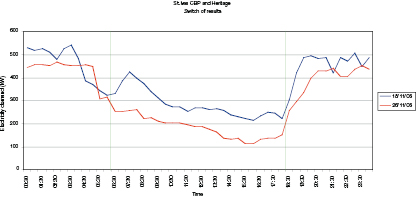
Figure 5: Annualised energy savings (£/p.a.)

Figure 6: Improvements on the KPI of kg CO2/tonne produced

6: Support available to business from government funded organisations
The Carbon Trust
The Government funded Carbon Trust was set up by Government in 2001 to accelerate the move to a low carbon economy. It aims to do this by working with organisations to reduce their carbon emissions and develop commercial low carbon technologies. The Carbon Trust has a Solutions group which offers support in reducing energy and carbon emissions through free surveys, carbon footprinting, interest free loans for qualifying projects, research grants, Small & Medium Business Toolkit etc. More information can be found on their website at http://www.carbontrust.co.uk/solutions/.
The interest free loans are available to SMEs who fall within the following EU definition under the state aid scheme rules: it is available to SMEs in England and Scotland, all businesses in Wales and Northern Ireland that have been trading for at least 12 months and have an acceptable credit rating.
Loans between £5,000 and £100,000 are available in England, Scotland and Wales, and up to £400,000 in Northern Ireland.
There are regional variations and details are available from the Carbon Trust.
The EU State aid definition of an SME is a company with:
- Fewer than 250 employees
- Less than 50m Turnover (approximately £35m) OR
- Less than 43m assets (approximately £30m)
- No controlling interest more than 25% by a non-SME (i.e. part of a larger organisation).
For more information contact the Carbon Trust.
The Carbon Trust also manages the Enhanced Capital Allowance (ECA) scheme on behalf of Defra, which provides businesses with a first year 100% tax allowance on designated energy efficient equipment investments (see Section 2.3 for further information).
The Carbon Trust also runs a consultant accreditation scheme and will help fund the use of consultants for an appropriate approved project.
The other main Government support organisation which supports environmental improvement projects with business is Envirowise, which aims to deliver a Government-funded programme of free, confidential advice to UK businesses. This assistance can enable companies to increase profitability and reduce environmental impact. Envirowise solutions are specific to the needs of individual businesses, to improve their business practices, profitability and competitiveness. Since 1994, Envirowise has helped UK industry save more than £1 billion.
The Envirowise programme is available to any UK business, free of charge. For more information visit their website http://www.envirowise.gov.uk/home.
6.1 Case study – Universities and Colleges Admission Services Offices
The UCAS organisation had an energy bill of around £345,000 and employs around 300 staff. It operates from a modern air-conditioned office facility which is well insulated with few draft issues. It contacted the Carbon Trust for a free survey to identify ways it could reduce its energy use and CO2 emissions. The survey resulted in an action plan with the following recommendations:
- Appoint an Energy Manager from within the existing facilities team
- Install energy sub-metering to enable monitoring and targeting (see Section 5.2)
- Install weather compensation boiler and controls for hot water radiators
- Review air conditioning system and optimise settings and controls
- Install heat recovery on main air handling plant
- Improve lighting by replace halogen lamps with LEDs
- Install variable speed control on chilled water pumps to match supply to demand.
The estimated savings equated to reducing the energy bill by £19,000 and a CO2 emission reduction of 294 tonnes.
6.2 Case study – Exmoor Forest Inn
The Exmoor Forest Hotel and Bar is located in the centre of Exmoor and employs 9 staff. It has 9 letting bedrooms, is open through the year and has an energy bill of around £13,000. There were concerns that the existing inefficient boiler system was reaching the end of its life, being over 30 years old. However, the capital costs of replacement were daunting and the small business did not feel it was affordable.
The company contacted the Carbon Trust who agreed to provide an interest free loan of £6,300 for the purchase of new LPG condensing boilers. The new boilers proved their worth by reducing the business’s energy bill by around £2,700 per year. Based on the energy savings alone the investment payback was just under 3 years.
7: Conclusions
The Government has set out in the 2007 Energy White Paper a route to achieve its commitments to reduce carbon emissions by at least 60% by 2050 based on 1990 emissions. In addition, the government is indicating that the UK will accept the renewables target to source 15% of total energy from renewable sources. To meet the renewables target translates to a requirement to generate around 40% of the electricity supply from renewable sources. Both these targets require massive levels of investment in both energy generation and distribution to ensure improved energy security (less reliance on imported energy sources) and reduced carbon intensity of power generation. Some of the ageing coal and nuclear power stations will be removed from the grid and decommissioned over the next 10 to 15 years. This coupled with the long timescales to provide the low carbon alternatives will necessitate investments in new power stations based on fossil fuels such as coal if the UK is to avoid an energy gap, possibly of around 20% generating capacity, and to ensure an adequate base load electricity supply, which is one of the significant issues with renewable energy sources.
However, there is a way of tackling some of the inherent difficulties of moving to a new lower carbon energy supply and that is through a concerted move to improve energy efficiency across the built environment. It is estimated that 20% of the UK’s greenhouse gas emissions result from businesses and their use of buildings and other facilities. The Carbon Trust has estimated that a 20% improvement in energy efficiency is easily achievable across most business sectors. This not only reduces greenhouse gas emissions but it also reduces business costs, helps reduce the UK dependency on imported fuel and overall improving the competitiveness of UK business.
The UK Government recognises that the commitment of business and public sector organisations to tackling climate change is growing and many have recognised and acted on the cost effective opportunities that are available to reduce energy consumption and greenhouse gas emissions. Some leading firms and authorities have adopted high profile initiatives bringing wide-ranging benefits. They report real cuts in emissions and offer good examples for others to emulate. Another benefit is that with businesses improving their energy performance, a constructive and practical note has been introduced into the climate change debate.
In general, the heating, ventilation and air conditioning (HVAC) and lighting systems used in the majority of existing commercial buildings are inefficient in terms of energy use. New buildings can be designed to operate at excellent levels of efficiency in overall energy terms but most are constructed with significant levels of inefficiency built in and, although they may include very sophisticated controls, their actual operation wastes large amounts of energy resulting in high levels of greenhouse gas emissions. This is despite having improved Building Regulations with energy efficiency standards, the excellent work of the Buildings Research Establishment (BRE) in setting out the BRE Environmental Assessment Method (BREEAM) standard and the work of the Chartered Institute of Building Services Engineers (CIBSE).
One has only to look at the modern office tower blocks of Canary Wharf or a modern commercial site to see that lighting and air conditioning systems are left on when occupancy and process operations should dictate otherwise.
When the whole range of business premises and energy using equipment and systems is considered it is no surprise that implementing cost effective energy efficiency solutions is seen as ‘a no-brainer’. So, why are we not seeing a greater improvement in energy efficiency? What is preventing the wider adoption of good behaviours such as switching off lights and other equipment when not required or installing the existing technologies that offer better control?
Using lighting as a way of answering these questions shows that some organisations take a singular approach focused on people’s behaviours and although people are at the heart of an energy efficiency campaign, it needs to be accepted that only taking a behavioural change approach will be found inconsistent and difficult to sustain. A better approach is to also invest in changing from older fluorescent lighting to a new generation of lighting systems and controls. Although this involves initial investment costs the payback can be very rapid indeed. Again, Philips figures show that upgrade alternatives can have a payback time of less than three years and as some of the case studies have shown, sometimes a payback in a few months can be achieved.
All business premises and facilities offer opportunities to improve their energy efficiency. The good practice and case studies outlined in this report illustrate the wide range of cost effective options available to reduce energy costs today.
Business has shown that it is willing to engage in energy efficiency – in effect to play its part in reducing carbon emissions. However, it is the IoD’s view there still remain impressive opportunities for business to do more. Also, although there is Government support to business in general there are areas in which it could improve:
- It needs better to understand the barriers and constraints to energy efficiency that smaller businesses in particular face in a highly competitive environment
- The Government funded organisations, such as the Carbon Trust, could refocus in order to reach and support more SMEs.
It is the hope of the IoD that this report will ultimately encourage more businesses and other organisations to adopt the cost effective approaches to energy efficiency outlined in this report.
8: References
1 The Carbon Trust press release October 2004 http://www.carbontrust.co.uk/NR/rdonlyres/EE9BAE6DB613-4BF5-9875-F969268CAE23/0/20041028_Clocks_release_FINAL.pdf.
2 Energy Efficient Lighting: A summary of ‘green switch’ facts, Philips Electronics, June 2007.
3 BERR http://stats.berr.gov.uk/energystats/dukes1_4-1_6.xls.
4 World Energy Outlook, IEA 2006. www.worldenergyoutlook.org/.
5 Meeting the Energy Challenge - White Paper on Energy, DTI CM 7124, BERR (DTI), 2007.
6 http://www.forbes.com/markets/feeds/afx/2008/03/20/afx4797074.html.
7 Doing More With Less – Green Paper on Energy Efficiency (COM 265), EC, 2005.
8 Institute of Directors Energy Efficiency Survey March 2008.
9 A Competitive Response to Climate Change, Institute of Directors, 2008.
10 BERR http://stats.berr.gov.uk/energystats/dukes1_1_6.xls.
11 Meeting the Energy Challenge - White Paper on Energy, DTI CM 7124, BERR (DTI), 2007.
12 The Carbon Trust: Accelerating the move to a low carbon economy, National Audit Office, November 2007.
13 Meeting the Energy Challenge - White Paper on Energy, DTI CM 7124, BERR (DTI), 2007.
14 Meeting the Energy Challenge - White Paper on Energy, DTI CM 7124, BERR (DTI), 2007.
15 Institute of Directors Energy Efficiency Survey March 2008.
16 The Carbon Trust: Accelerating the move to a low carbon economy, National Audit Office, November 2007.
17 The Carbon Trust press release October 2004 http://www.carbontrust.co.uk/NR/rdonlyres/EE9BAE6DB613-4BF5-9875-F969268CAE23/0/20041028_Clocks_release_FINAL.pdf.
18 Energy Efficient Lighting: A summary of ‘green switch’ facts, Philips Electronics, June 2007.
19 Doing More With Less – Green Paper on Energy Efficiency (COM 265), EC, 2005.
20 BERR http://stats.berr.gov.uk/energystats/dukes1_1_6.xls.
21 BERR http://stats.berr.gov.uk/energystats/dukes1_1_6.xls.
22 Meeting the Energy Challenge - White Paper on Energy, DTI CM 7124, BERR (DTI), 2007.
23 Doing More With Less – Green Paper on Energy Efficiency (COM 265), EC, 2005.
24 DEFRA UK Energy Efficiency Action Plan 2007.
http://www.defra.gov.uk/environment/climatechange/uk/energy/pdf/action-plan-2007.pdf.
25 Energy Efficient Lighting: A summary of ‘green switch’ facts, Philips Electronics, June 2007.
26 Carbon Trust publication GIL124 at http://www.carbontrust.co.uk/energy/.
27 Carbon Trust publication GIL124 at http://www.carbontrust.co.uk/energy/.
The National Trust submission to
Inquiry into Climate Change
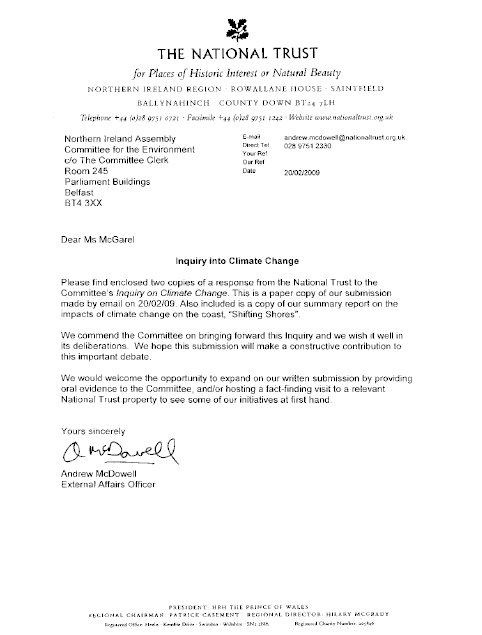
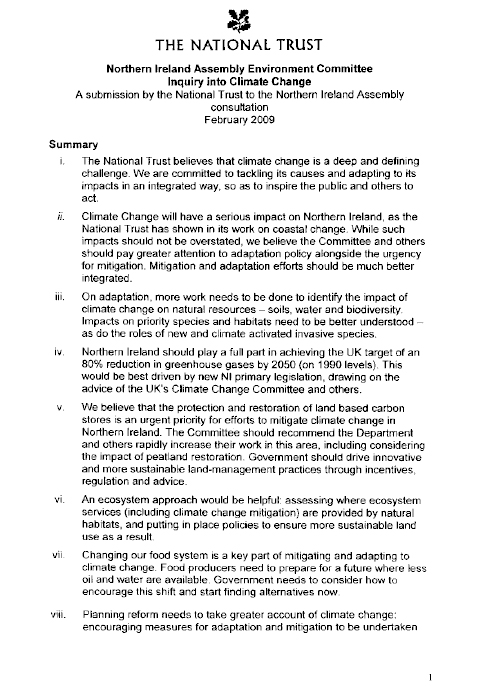

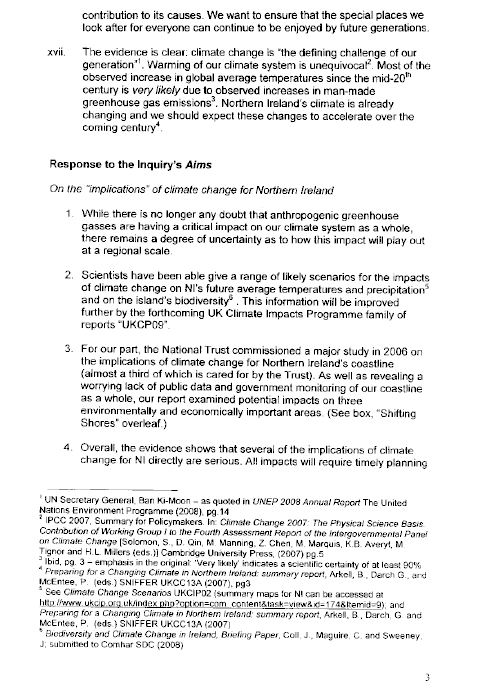


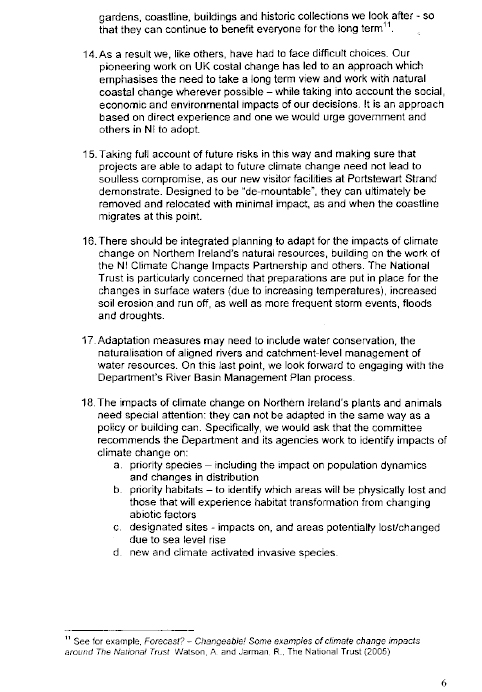
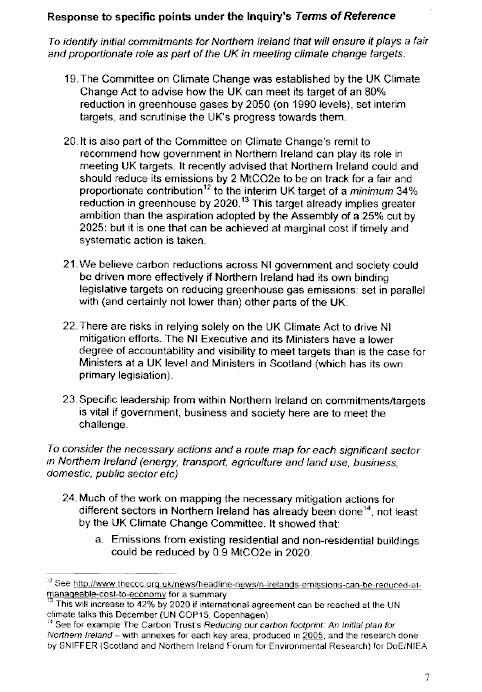
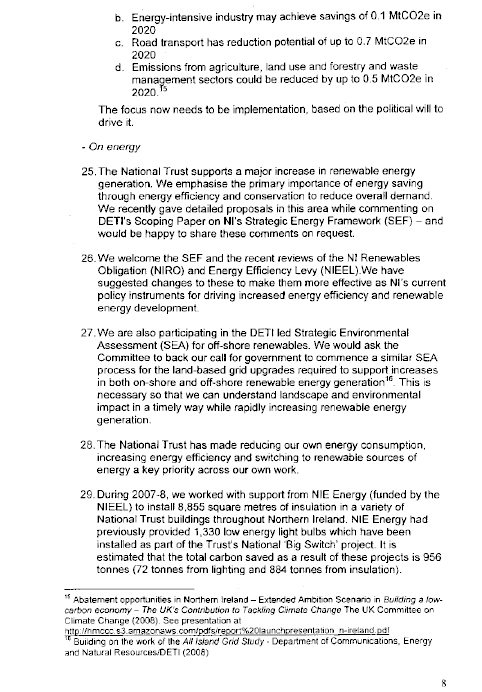
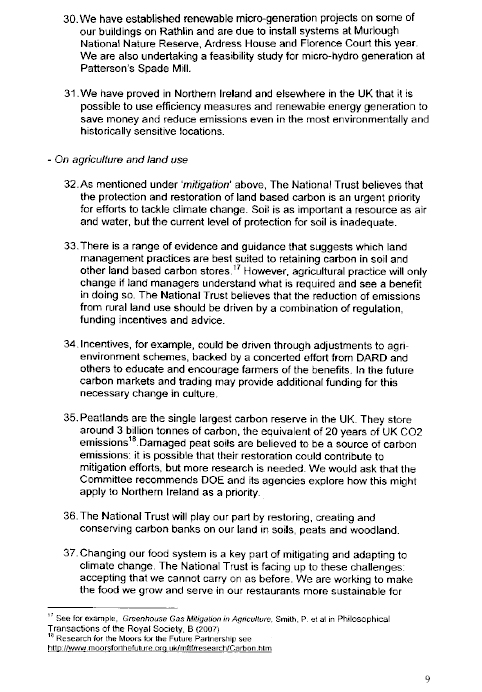
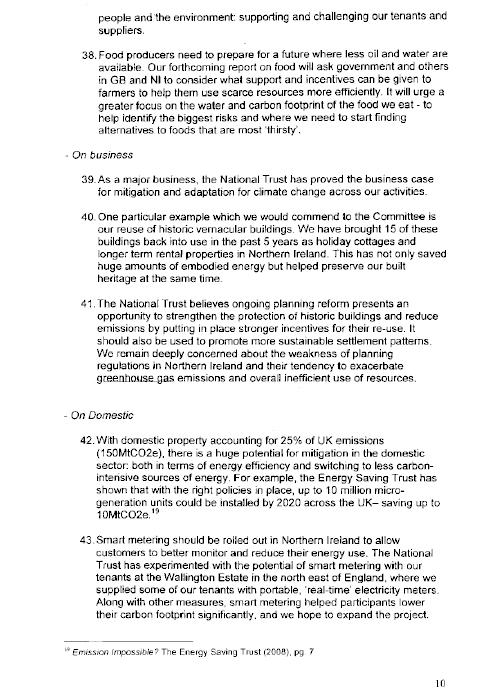


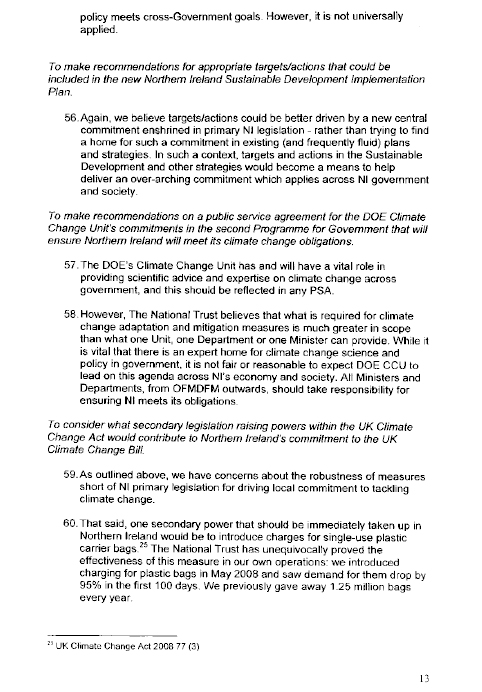
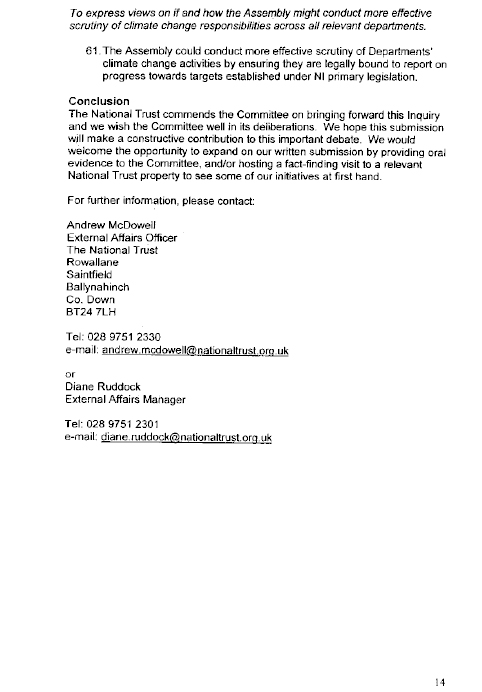
CBI Submission to the
Inquiry into Climate Change
